Vögel in Southern Africa in taxonomischer Hierarchie
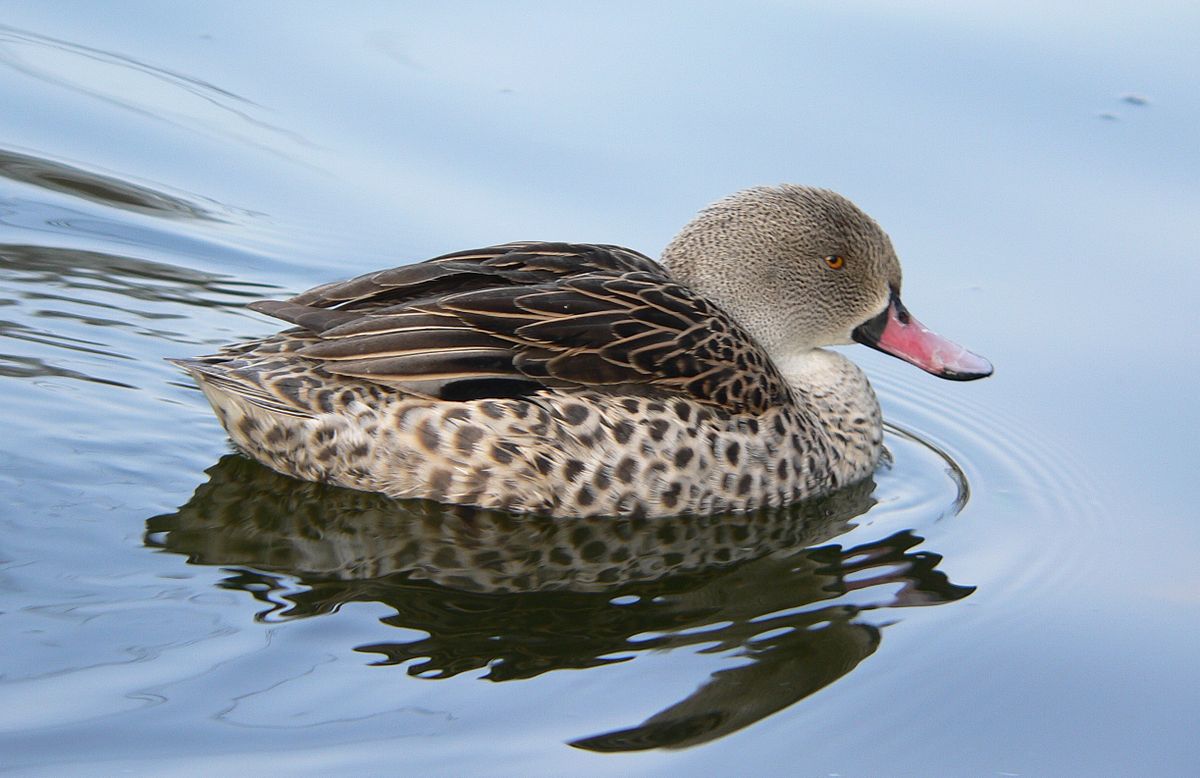
Wikipedia: Cape teal Quelle: OTHER
1200px-Kapente_schwimmend_Ausschnitt.jpg
Allgemein: ![]() Die Kapente (Anas capensis), wegen ihres hellgrauen Erscheinungsbildes auch Fahlente genannt, ist eine Art aus der Gattung der Eigentlichen Schwimmenten. Sie ist in den Feuchtgebieten der Afrotropis beheimatet. Es handelt sich um eine Entenart, die opportunistisch mit dem Regen zieht. Sie unternimmt dabei weite innerafrikanische Wanderungen.
[more]
Die Kapente (Anas capensis), wegen ihres hellgrauen Erscheinungsbildes auch Fahlente genannt, ist eine Art aus der Gattung der Eigentlichen Schwimmenten. Sie ist in den Feuchtgebieten der Afrotropis beheimatet. Es handelt sich um eine Entenart, die opportunistisch mit dem Regen zieht. Sie unternimmt dabei weite innerafrikanische Wanderungen.
[more]
Profil Wikipedia eBird Xeno-Canto

Wikipedia: Red-billed duck Quelle: OTHER
1200px-Red-billed_Pintail_%28Anas_erythrorhyncha%29_RWD1.jpg
![]() The red-billed teal or red-billed duck (Anas erythrorhyncha) is a dabbling duck which is an abundant resident breeder in southern and eastern Africa typically south of 10° S. This duck is not migratory, but will fly great distances to find suitable waters. It is highly gregarious outside the breeding season and forms large flocks.
[more]
The red-billed teal or red-billed duck (Anas erythrorhyncha) is a dabbling duck which is an abundant resident breeder in southern and eastern Africa typically south of 10° S. This duck is not migratory, but will fly great distances to find suitable waters. It is highly gregarious outside the breeding season and forms large flocks.
[more]
Profil Wikipedia eBird Xeno-Canto
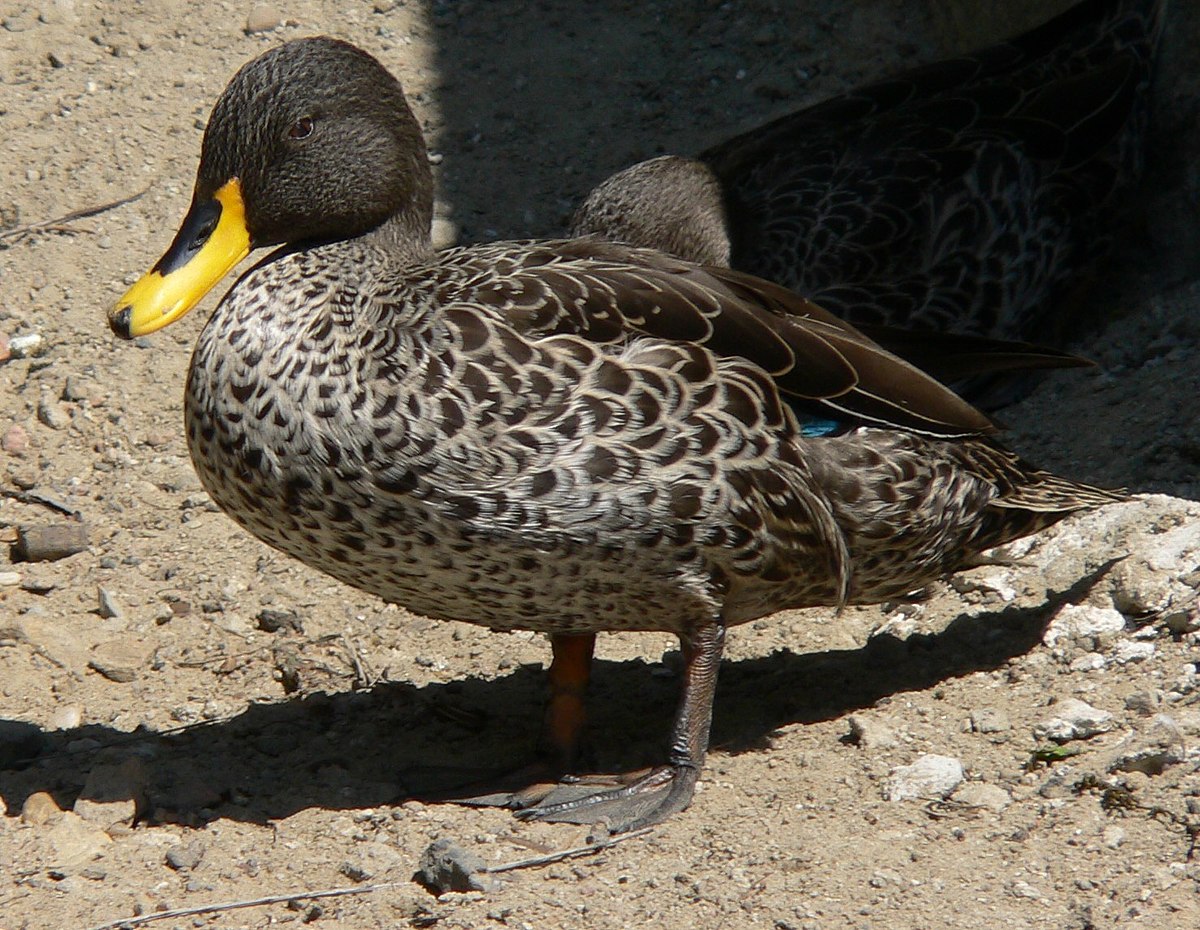
Wikipedia: Yellow-billed duck Quelle: OTHER
1200px-Gelbschnabelente_Anas_undulata_0505273_Wikiausschnitt.jpg
![]() Die Gelbschnabelente (Anas undulata) ist eine Art aus der Familie der Entenvögel. Sie zählt zu den häufigsten Entenvögeln der offenen Savannenlandschaften Afrikas.
[more]
Die Gelbschnabelente (Anas undulata) ist eine Art aus der Familie der Entenvögel. Sie zählt zu den häufigsten Entenvögeln der offenen Savannenlandschaften Afrikas.
[more]
Profil Wikipedia eBird Xeno-Canto

Wikipedia: African black duck Quelle: OTHER
African_Black_Duck.jpg
![]() Die Schwarzente (Anas sparsa) ist ein Entenvogel, der den Schwimmenten zugerechnet wird. Die Art kommt ausschließlich in Afrika vor. Es werden zwei Unterarten unterschieden. Die Nominatform ist die Südafrikanische Schwarzente (Anas sparsa sparsa), die im Süden Afrikas verbreitet ist. Daneben wird die deutlich hellere und kleinere Abessinische Schwarzente (Anas sparsa leucostigma) unterschieden. Die früher als Westafrikanische Schwarzente (Anas sparsa maclatchyi) bezeichnete Form wird heute nicht mehr als Unterart angesehen, sondern gilt als isolierte Regenwaldvariante der Abessinischen Schwarzente.[1]
[more]
Die Schwarzente (Anas sparsa) ist ein Entenvogel, der den Schwimmenten zugerechnet wird. Die Art kommt ausschließlich in Afrika vor. Es werden zwei Unterarten unterschieden. Die Nominatform ist die Südafrikanische Schwarzente (Anas sparsa sparsa), die im Süden Afrikas verbreitet ist. Daneben wird die deutlich hellere und kleinere Abessinische Schwarzente (Anas sparsa leucostigma) unterschieden. Die früher als Westafrikanische Schwarzente (Anas sparsa maclatchyi) bezeichnete Form wird heute nicht mehr als Unterart angesehen, sondern gilt als isolierte Regenwaldvariante der Abessinischen Schwarzente.[1]
[more]
Profil Wikipedia eBird Xeno-Canto

Wikipedia: Southern pochard Quelle: OTHER
1200px-Southern_Pochard_%28Netta_erythrophthalma%29_RWD1.jpg
Dieser Vogel erscheint jenseits grossen Meere in Kontinenten :
Südamerika, Afrika.
![]() The southern pochard (Netta erythrophthalma) is a species of duck, and a member of the genus Netta. There are two subspecies, the South American (southern) pochard N. e. erythrophthalma (Wied-Neuwied, 1833) and the African (southern) pochard N. e. brunnea (Eyton, 1838).
[more]
The southern pochard (Netta erythrophthalma) is a species of duck, and a member of the genus Netta. There are two subspecies, the South American (southern) pochard N. e. erythrophthalma (Wied-Neuwied, 1833) and the African (southern) pochard N. e. brunnea (Eyton, 1838).
[more]
Nilgans am Südende des Greifensee 2021-02-08 15.21.56
Zuerst beobachtet in Botswana an 2016-09-24.
Dieser Vogel erscheint jenseits grossen Meere in Kontinenten :
Europa, Nordamerika, Afrika.
Wintergast am Greifensee. Invasiv. Nach Vogelwarte.ch: 'als Ziervogel im 18. Jahrhundert in Europa eingeführt...
Ausgehend von einer in den 1970er Jahren in den Niederlanden und Belgien gebildeten Population breitete sich die Nilgans rasant dem Rhein und seinen Nebenflüssen entlang aus und hat inzwischen auch die Schweiz erreicht.
Vokalisierung: ![]() Quite vocal when interacting. [Link]
Quite vocal when interacting. [Link]
Rufe: ![]() Female calls may resemble RS, but are coarser, harder and trills are more rolling. Single calls are longer, and falls markedly in pitch. Male calls quite different, with husky, wheezing or hissing "kaahhh", or with the same timbre in series lika a steam engine. [Link]
Female calls may resemble RS, but are coarser, harder and trills are more rolling. Single calls are longer, and falls markedly in pitch. Male calls quite different, with husky, wheezing or hissing "kaahhh", or with the same timbre in series lika a steam engine. [Link]
Körperlich: Länge=63-73 cm,
Flügelspanne=134-154 cm,
Gewicht=1500-2250 g

Wikipedia: Knob-billed duck Quelle: OTHER
1200px-Knob-billed_duck_%28Sarkidiornis_melanotos%29_male.jpg
Allgemein: ![]() Die Höckerglanzgans (Sarkidiornis melanotos), gelegentlich auch als Glanzente bezeichnet, ist die einzige Art in der Gattung der Höckerglanzgänse und gehört zur Familie der Entenvögel.
[more]
Die Höckerglanzgans (Sarkidiornis melanotos), gelegentlich auch als Glanzente bezeichnet, ist die einzige Art in der Gattung der Höckerglanzgänse und gehört zur Familie der Entenvögel.
[more]
Profil Wikipedia eBird Xeno-Canto

Wikipedia: South African shelduck Quelle: OTHER
1200px-Tadorna_cana_-_01.jpg
![]() The South African shelduck or Cape shelduck (Tadorna cana) is a species of shelduck, a group of large goose-like birds which are part of the bird family Anatidae, which also includes the swans, geese and ducks. This is a common species native to southern Africa.[2]
[more]
The South African shelduck or Cape shelduck (Tadorna cana) is a species of shelduck, a group of large goose-like birds which are part of the bird family Anatidae, which also includes the swans, geese and ducks. This is a common species native to southern Africa.[2]
[more]
Profil Wikipedia eBird Xeno-Canto

Wikipedia: Maccoa duck Quelle: OTHER
1200px-Oxyura_maccoa.jpg
![]() Die Afrikanische Ruderente (Oxyura maccoa) ist eine Art aus der Unterfamilie der Ruderenten. Sie weist drei disjunkte Verbreitungsgebiete in Afrika auf: Die Südspitze des Afrikanischen Kontinents, der Norden Kenias und Ugandas und entlang des Flusslaufs des Blauen Nils.[1] Der Verbreitungsschwerpunkt liegt in Südafrika mit etwa 5.000 Individuen.[2]
[more]
Die Afrikanische Ruderente (Oxyura maccoa) ist eine Art aus der Unterfamilie der Ruderenten. Sie weist drei disjunkte Verbreitungsgebiete in Afrika auf: Die Südspitze des Afrikanischen Kontinents, der Norden Kenias und Ugandas und entlang des Flusslaufs des Blauen Nils.[1] Der Verbreitungsschwerpunkt liegt in Südafrika mit etwa 5.000 Individuen.[2]
[more]
Pünktchenente / Hottentot teal (Spatula hottentota)
Profil Wikipedia eBird Xeno-Canto

Wikipedia: Hottentot teal Quelle: OTHER
1200px-Anatra_ottentotta_%28Zurich_zoo%29.jpeg
![]() Die Pünktchenente (Spatula hottentota, Syn.: Anas hottentota, Punanetta hottentota)[1][2][3], früher als Hottentottenente bezeichnet, ist ein afrikanischer Entenvogel, der zu den Schwimmenten gerechnet wird. Die auf Madagaskar vorkommenden Populationen wurden lange Zeit als separate Unterart angesehen, aber diese Unterscheidung ist heute nicht mehr gebräuchlich.
[more]
Die Pünktchenente (Spatula hottentota, Syn.: Anas hottentota, Punanetta hottentota)[1][2][3], früher als Hottentottenente bezeichnet, ist ein afrikanischer Entenvogel, der zu den Schwimmenten gerechnet wird. Die auf Madagaskar vorkommenden Populationen wurden lange Zeit als separate Unterart angesehen, aber diese Unterscheidung ist heute nicht mehr gebräuchlich.
[more]
Kap-Löffelente / Cape shoveler (Spatula smithii)
Profil Wikipedia eBird Xeno-Canto

Wikipedia: Cape shoveler Quelle: OTHER
1200px-Cape_Shoveler_RWD.jpg
![]() Die Kap-Löffelente (Spatula smithii, Syn.: Anas smithii), auch Südafrikanische Löffelente genannt, ist ein südafrikanischer Entenvogel, der zu den Schwimmenten gerechnet wird. Sie ist die größte der Löffelenten.[1]
[more]
Die Kap-Löffelente (Spatula smithii, Syn.: Anas smithii), auch Südafrikanische Löffelente genannt, ist ein südafrikanischer Entenvogel, der zu den Schwimmenten gerechnet wird. Sie ist die größte der Löffelenten.[1]
[more]

Wikipedia: Fulvous whistling-duck Quelle: OTHER
1200px-Dendrocygna_bicolor_wilhelma.jpg
Dieser Vogel erscheint jenseits grossen Meere in Kontinenten :
Nordamerika, Südamerika, Afrika.
![]() Die Gelbe Pfeifgans (Dendrocygna bicolor), auch Gelbbrustpfeifgans genannt, ist eine Art der Familie der Entenvögel. Sie ist in Zentral- und Südamerika, der südlichen Küstenregion Nordamerikas, Kubas, Puerto Ricos, in Subsahara-Afrika, Madagaskar und auf dem Indischen Subkontinent beheimatet.[1] Sie weist damit eine der ungewöhnlichsten Verteilungen von Vögeln weltweit auf: Sie ist nicht nur auf vier Kontinenten beheimatet, sondern auch in vier unterschiedlichen zoogeografischen Zonen.[2] Sie ist besonders häufig in großen Trupps im Nigerdelta und im Delta des Senegal zu beobachten.
[more]
Die Gelbe Pfeifgans (Dendrocygna bicolor), auch Gelbbrustpfeifgans genannt, ist eine Art der Familie der Entenvögel. Sie ist in Zentral- und Südamerika, der südlichen Küstenregion Nordamerikas, Kubas, Puerto Ricos, in Subsahara-Afrika, Madagaskar und auf dem Indischen Subkontinent beheimatet.[1] Sie weist damit eine der ungewöhnlichsten Verteilungen von Vögeln weltweit auf: Sie ist nicht nur auf vier Kontinenten beheimatet, sondern auch in vier unterschiedlichen zoogeografischen Zonen.[2] Sie ist besonders häufig in großen Trupps im Nigerdelta und im Delta des Senegal zu beobachten.
[more]
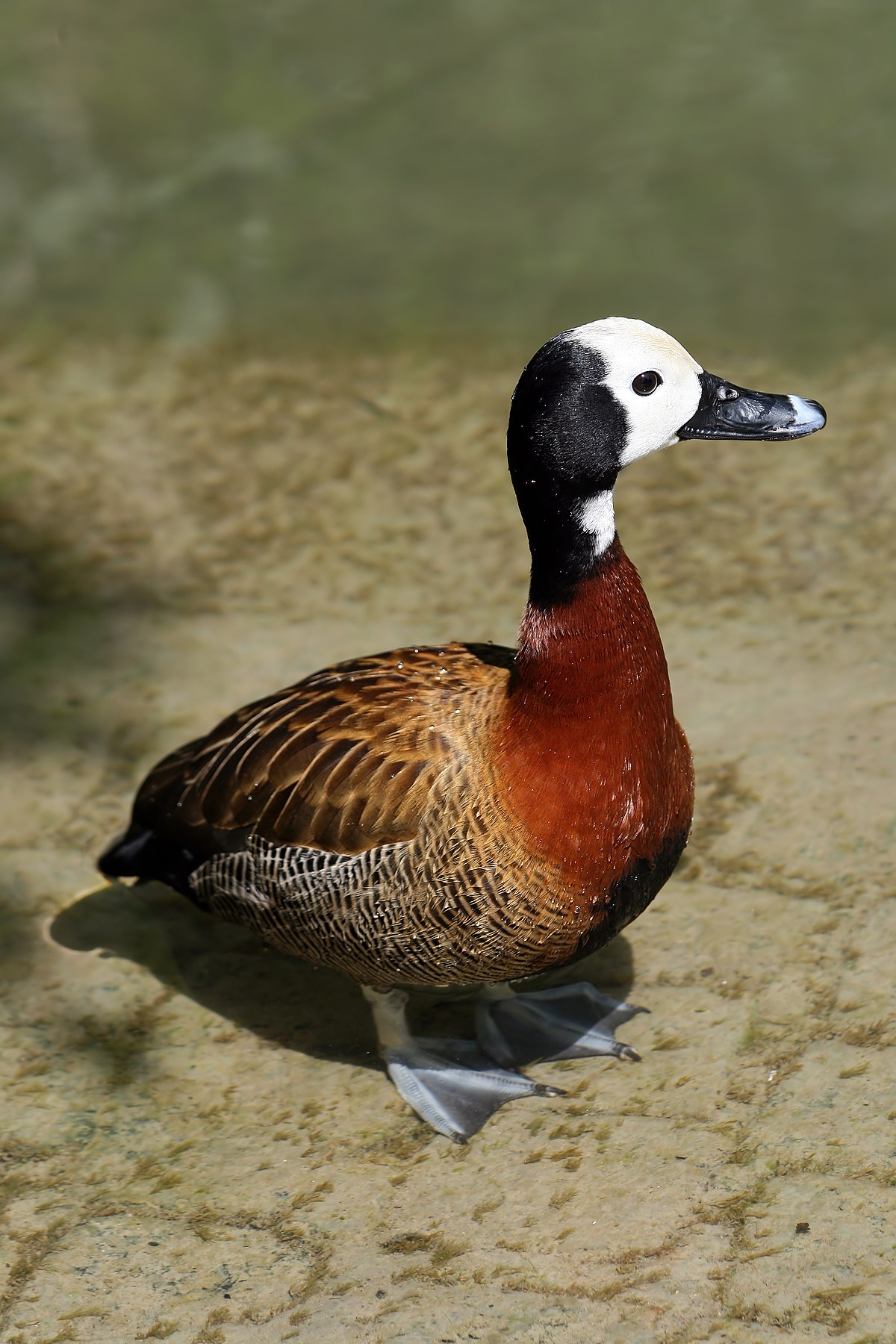
Wikipedia: White-faced whistling-duck Quelle: OTHER
1200px-Dendrocygna_viduata_upright.jpg
Dieser Vogel erscheint jenseits grossen Meere in Kontinenten :
Südamerika, Afrika.
![]() Die Witwenpfeifgans (Dendrocygna viduata) ist eine Vogelart aus der Unterfamilie der Pfeifgänse. Sie ist beheimatet im tropischen Südamerika sowie im südlich der Sahara gelegenen Afrika und kommt auch auf Madagaskar vor. Die in Trupps lebende und vorwiegend nachtaktive Gans bewohnt nahrungsreiche Binnengewässer.
[more]
Die Witwenpfeifgans (Dendrocygna viduata) ist eine Vogelart aus der Unterfamilie der Pfeifgänse. Sie ist beheimatet im tropischen Südamerika sowie im südlich der Sahara gelegenen Afrika und kommt auch auf Madagaskar vor. Die in Trupps lebende und vorwiegend nachtaktive Gans bewohnt nahrungsreiche Binnengewässer.
[more]
Profil Wikipedia eBird Xeno-Canto
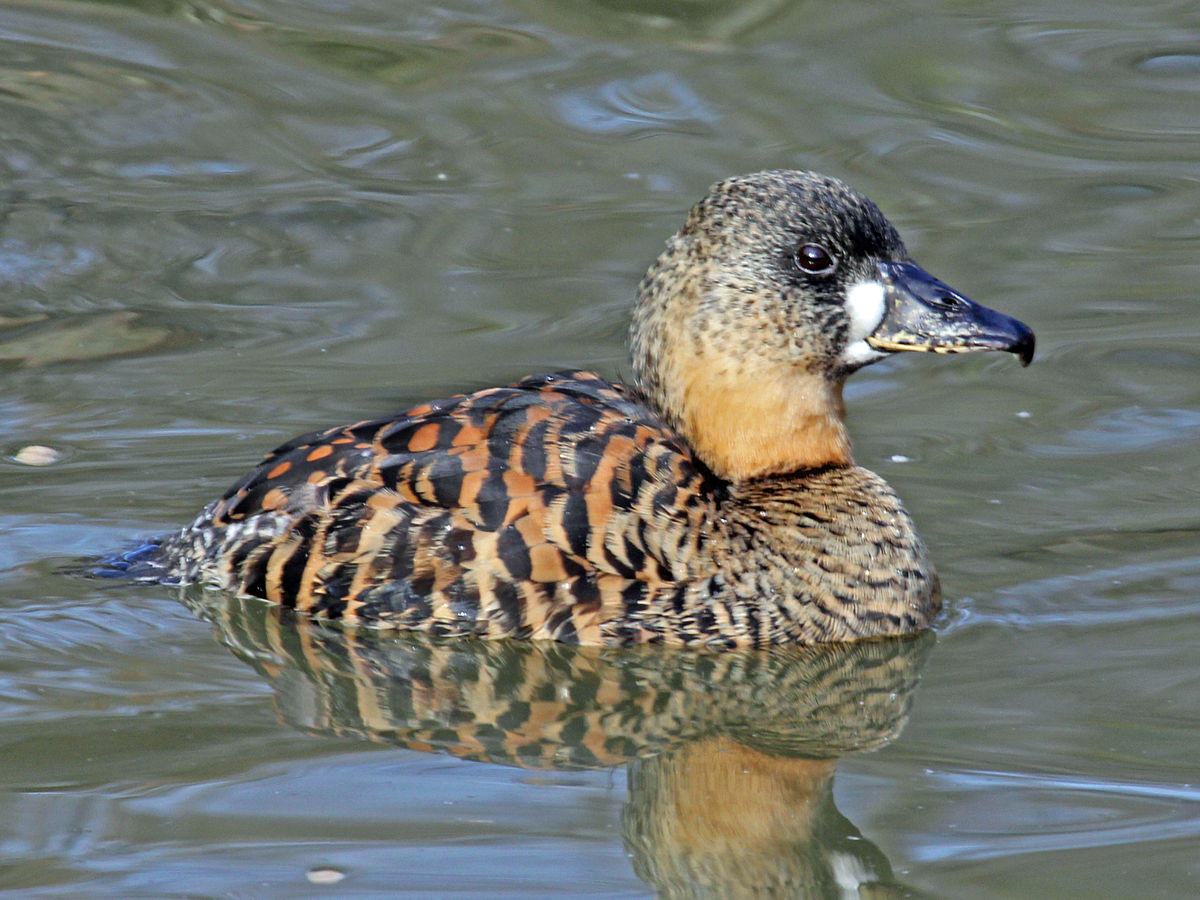
Wikipedia: White-backed duck Quelle: OTHER
1200px-White-backed_Duck_RWD2.jpg
![]() Die Weißrücken-Pfeifgans (Thalassornis leuconotus), auch Weißrückenente[1] genannt, ist eine zur Unterfamilie der Pfeifgänse gehörige Art. Systematisch wird sie somit zu den Entenvögeln (Anatidae) gestellt. Obwohl sie mit den eigentlichen Pfeifgänsen (Dendrocygnini) eng verwandt ist, unterscheidet sie sich von ihnen durch ihre enorm spezialisierte Anpassung an das Tauchen. Deswegen wurde sie in der Vergangenheit häufig zu den Ruderenten (Oxyurini) gestellt; es handelt sich aber um einen Fall konvergenter Evolution. Zuweilen unterscheidet man zwei Unterarten, die Afrikanische Weißrücken-Pfeifgans (Thalassornis leuconotus leuconotus) und die Madagaskar-Weißrücken-Pfeifgans (Thalassornis leuconotus insularis).
[more]
Die Weißrücken-Pfeifgans (Thalassornis leuconotus), auch Weißrückenente[1] genannt, ist eine zur Unterfamilie der Pfeifgänse gehörige Art. Systematisch wird sie somit zu den Entenvögeln (Anatidae) gestellt. Obwohl sie mit den eigentlichen Pfeifgänsen (Dendrocygnini) eng verwandt ist, unterscheidet sie sich von ihnen durch ihre enorm spezialisierte Anpassung an das Tauchen. Deswegen wurde sie in der Vergangenheit häufig zu den Ruderenten (Oxyurini) gestellt; es handelt sich aber um einen Fall konvergenter Evolution. Zuweilen unterscheidet man zwei Unterarten, die Afrikanische Weißrücken-Pfeifgans (Thalassornis leuconotus leuconotus) und die Madagaskar-Weißrücken-Pfeifgans (Thalassornis leuconotus insularis).
[more]
Profil Wikipedia eBird Xeno-Canto

Wikipedia: Spur-winged goose Quelle: OTHER
1200px-Spur-winged_goose_%28Plectropterus_gambensis%29.jpg
![]() Die Sporngans (Plectropterus gambensis), seltener auch als Sporengans bezeichnet, ist eine hochbeinige Glanzente, die über fast ganz Afrika mit Ausnahme Nordafrikas verbreitet ist.
[more]
Die Sporngans (Plectropterus gambensis), seltener auch als Sporengans bezeichnet, ist eine hochbeinige Glanzente, die über fast ganz Afrika mit Ausnahme Nordafrikas verbreitet ist.
[more]
Afrikanische Zwergente / African pygmy-goose (Nettapus auritus)
Profil Wikipedia eBird Xeno-Canto
African pygmy goose. 2016-09-23 09.50.38 Botswana
Zuerst beobachtet in Botswana an 2016-09-23.
![]() Die Afrikanische Zwergente (Nettapus auritus), auch Afrikanische Zwergglanzente genannt, ist ein kleiner tropischer Entenvogel, der den Schwimmenten zugerechnet wird. Das Verbreitungsgebiet dieser Art begrenzt sich auf Afrika und Madagaskar.
[more]
Die Afrikanische Zwergente (Nettapus auritus), auch Afrikanische Zwergglanzente genannt, ist ein kleiner tropischer Entenvogel, der den Schwimmenten zugerechnet wird. Das Verbreitungsgebiet dieser Art begrenzt sich auf Afrika und Madagaskar.
[more]
Küstenscharbe / Bank cormorant (Phalacrocorax neglectus)
Profil Wikipedia eBird Xeno-Canto

Wikipedia: Bank cormorant Quelle: OTHER
Phalacrocoraxneglectus.jpg
![]() Die Küstenscharbe (Phalacrocorax neglectus) ist eine Vogelart aus der Familie Phalacrocorax innerhalb der Familie der Kormorane. Die dunkelbraun bis schwarz gefärbte Art besiedelt die westafrikanische Küste von Namibia bis Südafrika. Sie brütet in Kolonien und ernährt sich vorwiegend von Fischen und Langusten. Die IUCN führt die Art als "stark gefährdet"[1], da ihre Brutplätze zunehmend zerstört werden und ihre Beutetiere überfischt sind.
[more]
Die Küstenscharbe (Phalacrocorax neglectus) ist eine Vogelart aus der Familie Phalacrocorax innerhalb der Familie der Kormorane. Die dunkelbraun bis schwarz gefärbte Art besiedelt die westafrikanische Küste von Namibia bis Südafrika. Sie brütet in Kolonien und ernährt sich vorwiegend von Fischen und Langusten. Die IUCN führt die Art als "stark gefährdet"[1], da ihre Brutplätze zunehmend zerstört werden und ihre Beutetiere überfischt sind.
[more]
Kapscharbe / Cape cormorant (Phalacrocorax capensis)

Wikipedia: Cape cormorant Quelle: OTHER
1200px-Phalacrocorax_capensis_-_Namib_2013.jpg
![]() Die Kapscharbe (Phalacrocorax capensis) ist eine Vogelart aus der Gattung Phalacrocorax innerhalb der Familie der Kormorane. Die schwarz oder dunkelbraun gefärbte Art besiedelt die Küsten Südafrikas und Namibias. Sie brütet in Kolonien und ernährt sich vorwiegend von Schwarmfischen. Die IUCN führt die Art als „stark gefährdet“.
[more]
Die Kapscharbe (Phalacrocorax capensis) ist eine Vogelart aus der Gattung Phalacrocorax innerhalb der Familie der Kormorane. Die schwarz oder dunkelbraun gefärbte Art besiedelt die Küsten Südafrikas und Namibias. Sie brütet in Kolonien und ernährt sich vorwiegend von Schwarmfischen. Die IUCN führt die Art als „stark gefährdet“.
[more]
Riedscharbe / Long-tailed cormorant (Microcarbo africanus)
Profil Wikipedia eBird Xeno-Canto

Wikipedia: Long-tailed cormorant Quelle: OTHER
1200px-Cormor%C3%A1n_africano_%28Microcarbo_africanus%29%2C_parque_nacional_de_Chobe%2C_Botsuana%2C_2018-07-28%2C_DD_48.jpg
![]() Die Riedscharbe (Microcarbo africanus, Syn.: Phalacrocorax africanus) ist ein Meeresvogel aus der Familie der Kormorane.
[more]
Die Riedscharbe (Microcarbo africanus, Syn.: Phalacrocorax africanus) ist ein Meeresvogel aus der Familie der Kormorane.
[more]
Microcarbo coronatus / Crowned cormorant (Microcarbo coronatus)
Profil Wikipedia eBird Xeno-Canto

Wikipedia: Crowned cormorant Quelle: OTHER
1200px-Crowned_Cormorant%2C_Phalacrocorax_coronatus.jpg
![]() The crowned cormorant (Microcarbo coronatus) is a small cormorant that is endemic to the waters of the cold Benguela Current of southern Africa. It is an exclusively coastal species and is not found more than 10 km (6 mi) away from land. This species is related to the reed cormorant, and was formerly considered to the same species.
[more]
The crowned cormorant (Microcarbo coronatus) is a small cormorant that is endemic to the waters of the cold Benguela Current of southern Africa. It is an exclusively coastal species and is not found more than 10 km (6 mi) away from land. This species is related to the reed cormorant, and was formerly considered to the same species.
[more]
Purpurreiher / Purple heron (Ardea purpurea)
Profil Wikipedia eBird Vogelwarte BirdLife ZH ornitho.ch Xeno-Canto BirdID NABU
Purple heron, Phnom Krom. 2024-03-03 06.13.38 Kambodscha
Zuerst beobachtet in Kambodscha an 2024-03-03.
![]() Der Purpurreiher (Ardea purpurea) ist eine Vogelart aus der Familie der Reiher. Zur Zeit wird die Art als nicht gefährdet (least concern) auf der IUCN Roten Liste geführt. Habitatsverluste lassen die Zahlen allerdings langsam zurückgehen.
[more]
Der Purpurreiher (Ardea purpurea) ist eine Vogelart aus der Familie der Reiher. Zur Zeit wird die Art als nicht gefährdet (least concern) auf der IUCN Roten Liste geführt. Habitatsverluste lassen die Zahlen allerdings langsam zurückgehen.
[more]
Vokalisierung: ![]() Quite similar to Grey Heron, but not so vocal. [Link]
Quite similar to Grey Heron, but not so vocal. [Link]
Rufe: ![]() Pitch slightly higher and remains stable throughout the short call. Volume muffled and timbre drier. [Link]
Pitch slightly higher and remains stable throughout the short call. Volume muffled and timbre drier. [Link]
Körperlich: Länge=78-90 cm,
Flügelspanne=120-150 cm,
Gewicht=525-1218 g
Habitate:
Nassgebiet
Ruf:
Automatically generated from Xeno-Canto recording
♫ XC878038 - Purple Heron - Ardea purpurea manilensis - flight call - Nonthaburi, Thailand. Quelle: XENOCANTO
XC878038 - Purple Heron - Ardea purpurea manilensis - flight call - Nonthaburi, Thailand.mp3
Thailand (Flugruf)
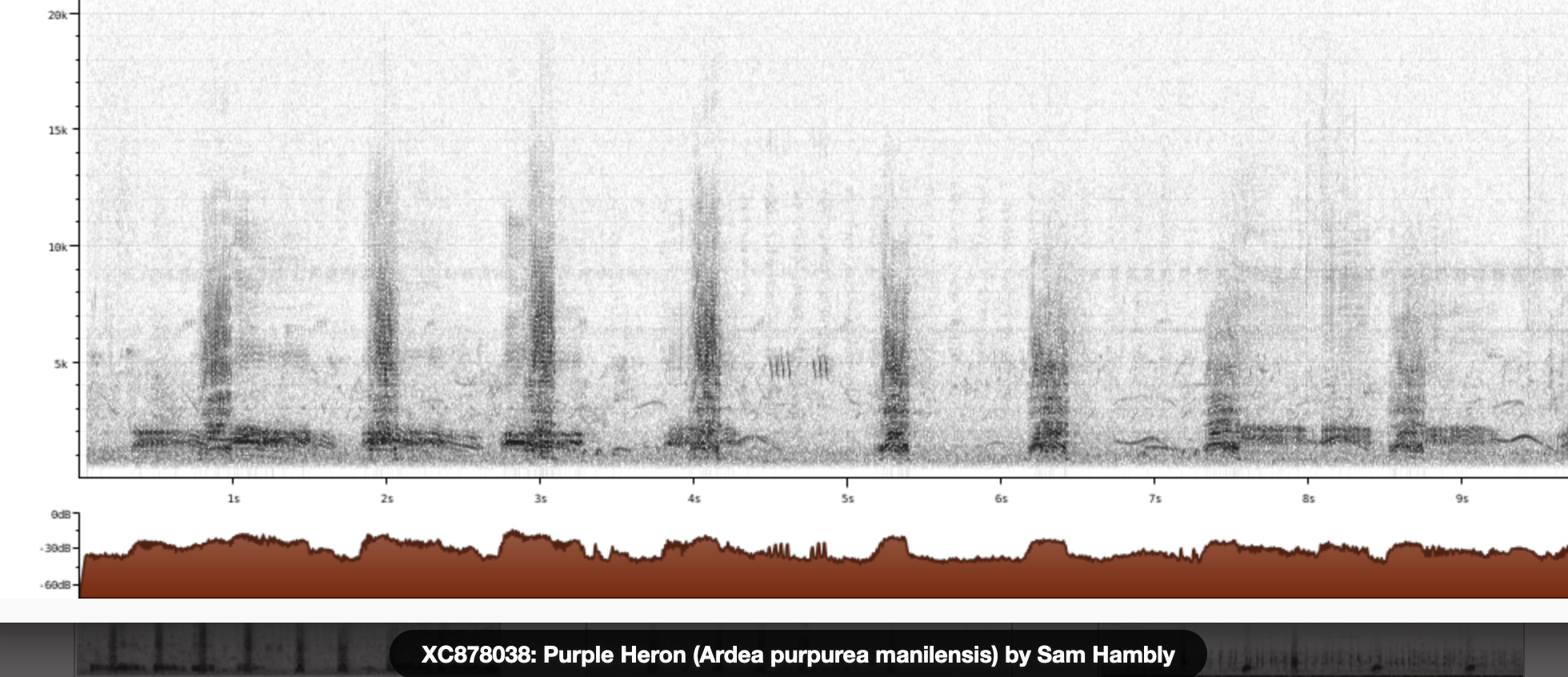
Ruf Eigenschaften:
Flugruf Frequenz: ,
Mittelreiher / Medium egret (Ardea intermedia)
Could be a medium egret aka intermedian egret aka median egret with orange bill but dark legs but could also be a great egret, which we saw a lot. 2024-02-22 11.59.32 Laos
Zuerst beobachtet in Laos an 2024-02-22.
Allgemein: ![]() Der Mittelreiher (Ardea intermedia, Syn.: Mesophoyx intermedia) ist eine Vogelart aus der Familie der Reiher. Es ist eine schlanke, reinweiße Reiherart mit langem Hals und dunklen Beinen. Das Verbreitungsgebiet des Mittelreihers ist Afrika, Südostasien und Australien.
[more]
Der Mittelreiher (Ardea intermedia, Syn.: Mesophoyx intermedia) ist eine Vogelart aus der Familie der Reiher. Es ist eine schlanke, reinweiße Reiherart mit langem Hals und dunklen Beinen. Das Verbreitungsgebiet des Mittelreihers ist Afrika, Südostasien und Australien.
[more]
Gesang:
Automatically generated from Xeno-Canto recording
Gesang Eigenschaften:
Frequency:
♫ XC460203 - Intermediate Egret - Ardea intermedia - call - Bharatpur, Rajasthan, India. Quelle: XENOCANTO
XC460203 - Intermediate Egret - Ardea intermedia - call - Bharatpur, Rajasthan, India.mp3
(Ruf)
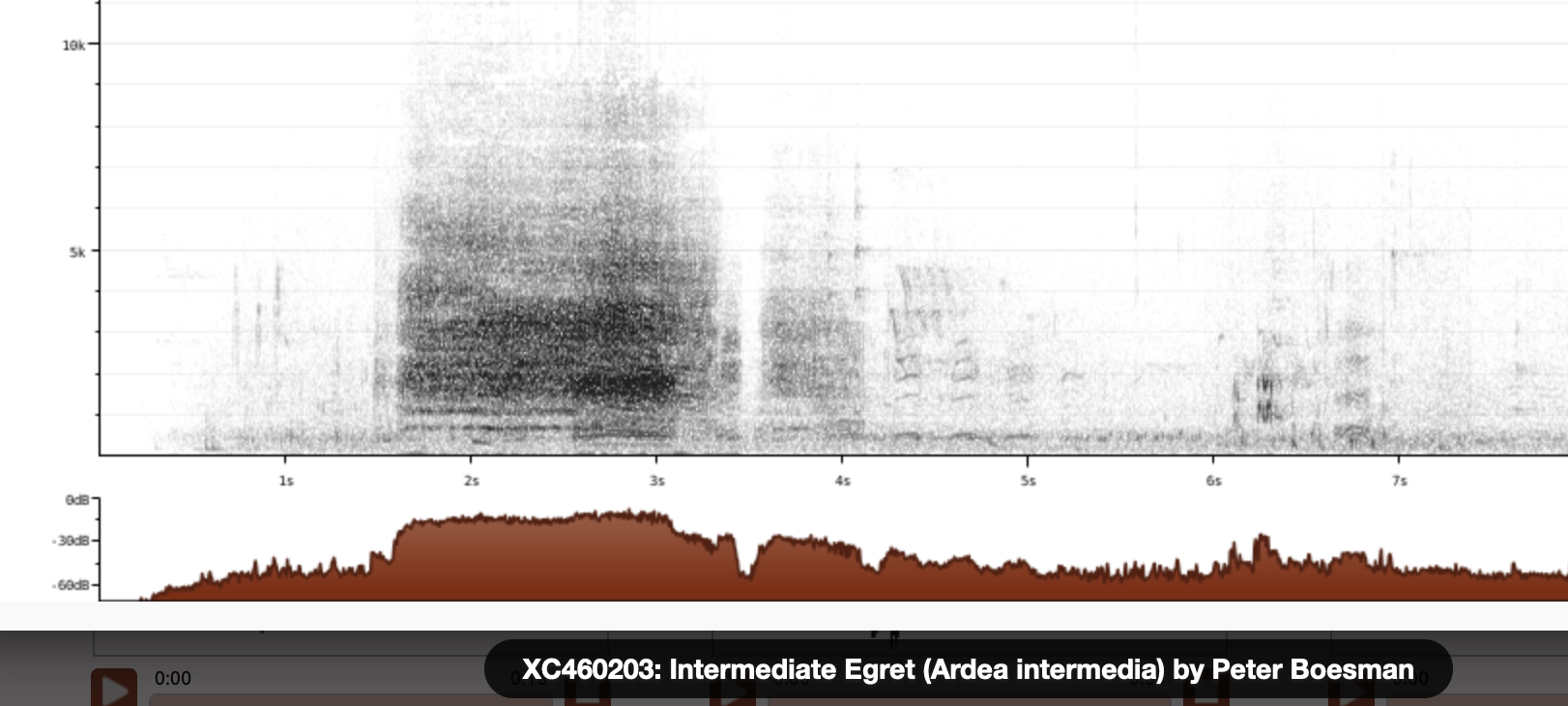
Goliathreiher / Goliath heron (Ardea goliath)
Profil Wikipedia eBird Xeno-Canto

Wikipedia: Goliath heron Quelle: OTHER
Ardea_goliath_-Lake_Baringo%2C_Kenya-8.jpg
![]() Der Goliathreiher (Ardea goliath) ist eine Vogelart aus der Familie der Reiher innerhalb der Ordnung Pelecaniformes. Mit einer Höhe von 135 bis 150 Zentimetern ist er der größte rezente Reiher der Welt. Er jagt daher auch in tieferen Gewässern als die mit ihm verwandten Arten. Sein Verbreitungsgebiet ist heute überwiegend Afrika. Es scheint jedoch noch eine kleine Restpopulation in Südostasien zu bestehen.
[more]
Der Goliathreiher (Ardea goliath) ist eine Vogelart aus der Familie der Reiher innerhalb der Ordnung Pelecaniformes. Mit einer Höhe von 135 bis 150 Zentimetern ist er der größte rezente Reiher der Welt. Er jagt daher auch in tieferen Gewässern als die mit ihm verwandten Arten. Sein Verbreitungsgebiet ist heute überwiegend Afrika. Es scheint jedoch noch eine kleine Restpopulation in Südostasien zu bestehen.
[more]
Schwarzhalsreiher / Black-headed heron (Ardea melanocephala)
Profil Wikipedia eBird Xeno-Canto NABU

Wikipedia: Black-headed heron Quelle: OTHER
1200px-Black-headed_Heron_%28Ardea_melanocephala%29.jpg
![]() Der Schwarzhalsreiher (Ardea melanocephala) ist eine Vogelart aus der Familie der Reiher. Er ist häufig in Afrika südlich der Sahara sowie auf Madagaskar zu sehen. Er ist überwiegend ein Standvogel, einige der westafrikanischen Population ziehen jedoch während der Regenzeit in nördlichere Regionen.
[more]
Der Schwarzhalsreiher (Ardea melanocephala) ist eine Vogelart aus der Familie der Reiher. Er ist häufig in Afrika südlich der Sahara sowie auf Madagaskar zu sehen. Er ist überwiegend ein Standvogel, einige der westafrikanischen Population ziehen jedoch während der Regenzeit in nördlichere Regionen.
[more]
Nachtreiher / Black-crowned night-heron (Nycticorax nycticorax)

Wikipedia: Black-crowned night-heron Quelle: OTHER
1200px-BCNH_CMCNJ_for_Wiki.png
Dieser Vogel erscheint jenseits grossen Meere in Kontinenten :
Europa, Nordamerika, Südamerika, Afrika, Asien.
![]() Der Nachtreiher (Nycticorax nycticorax) ist eine Art aus der Familie der Reiher (Ardeidae) und gehört somit in die Ordnung Pelecaniformes.
[more]
Der Nachtreiher (Nycticorax nycticorax) ist eine Art aus der Familie der Reiher (Ardeidae) und gehört somit in die Ordnung Pelecaniformes.
[more]
Rufe: ![]() Most commonly hear call is a nasal, soft croaking "roack", like cross between Raven and frog. [Link]
Most commonly hear call is a nasal, soft croaking "roack", like cross between Raven and frog. [Link]
Körperlich: Länge=58-65 cm,
Flügelspanne=105-112 cm,
Gewicht=500-800 g
Habitate:
Nassgebiet
Glockenreiher / Black heron (Egretta ardesiaca)
Profil Wikipedia eBird Xeno-Canto
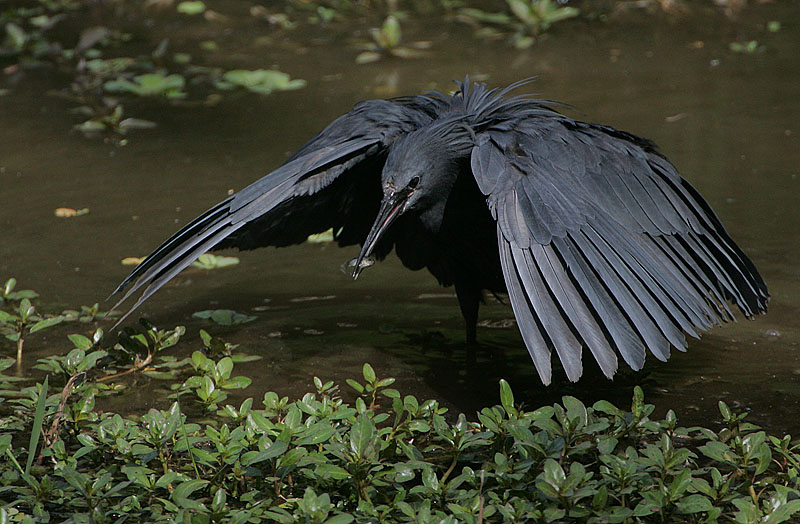
Wikipedia: Black heron Quelle: OTHER
Flickr_-_Rainbirder_-_Black_Egret_%28Egretta_ardesiaca%29.jpg
Allgemein: ![]() Der Glockenreiher (Egretta ardesiaca) ist eine Art aus der Familie der Reiher. Er kommt ausschließlich in Afrika vor. Während der Nahrungssuche breitet er die Schwingen schirmartig aus (Flügelmanteln), was zu dem deutschen Namen Glockenreiher geführt hat.
[more]
Der Glockenreiher (Egretta ardesiaca) ist eine Art aus der Familie der Reiher. Er kommt ausschließlich in Afrika vor. Während der Nahrungssuche breitet er die Schwingen schirmartig aus (Flügelmanteln), was zu dem deutschen Namen Glockenreiher geführt hat.
[more]
Braunkehlreiher / Slaty egret (Egretta vinaceigula)
Profil Wikipedia eBird Xeno-Canto

Wikipedia: Slaty egret Quelle: OTHER
1200px-Slaty_Egret_Egretta_vinaceigula.jpg
![]() Der Braunkehlreiher (Egretta vinaceigula) ist eine Reiherart aus der Gattung Egretta. Er hat ein ungewöhnlich kleines Verbreitungsgebiet und kommt nur im Süden Zentralafrikas vor. Er zählt zu den am wenigsten erforschten Reiherarten. Lange Zeit hielt man ihn für eine Unterart des Glockenreihers. Er unterscheidet sich jedoch in seinen Lebensraumanforderungen, seinem Körperbau und seinen Ernährungsgewohnheiten, so dass es heute weitgehender Konsens ist, ihn als eigenständige Art einzustufen.
[more]
Der Braunkehlreiher (Egretta vinaceigula) ist eine Reiherart aus der Gattung Egretta. Er hat ein ungewöhnlich kleines Verbreitungsgebiet und kommt nur im Süden Zentralafrikas vor. Er zählt zu den am wenigsten erforschten Reiherarten. Lange Zeit hielt man ihn für eine Unterart des Glockenreihers. Er unterscheidet sich jedoch in seinen Lebensraumanforderungen, seinem Körperbau und seinen Ernährungsgewohnheiten, so dass es heute weitgehender Konsens ist, ihn als eigenständige Art einzustufen.
[more]
Schmuckreiher / Snowy egret (Egretta thula)
Profil Wikipedia eBird Audubon AllAboutBirds Xeno-Canto
Snowy egret at John's Pass, Madeira Beach, Florida. 2023-09-27 11.51.14 Florida
Zuerst beobachtet in Yucatan an 2023-04-15.
Dieser Vogel erscheint jenseits grossen Meere in Kontinenten :
Nordamerika, Südamerika, Afrika.
![]() Der Schmuckreiher (Egretta thula) ist eine Vogelart aus der Familie der Reiher (Ardeidae).
[more]
Der Schmuckreiher (Egretta thula) ist eine Vogelart aus der Familie der Reiher (Ardeidae).
[more]
Blaureiher / Little blue heron (Egretta caerulea)
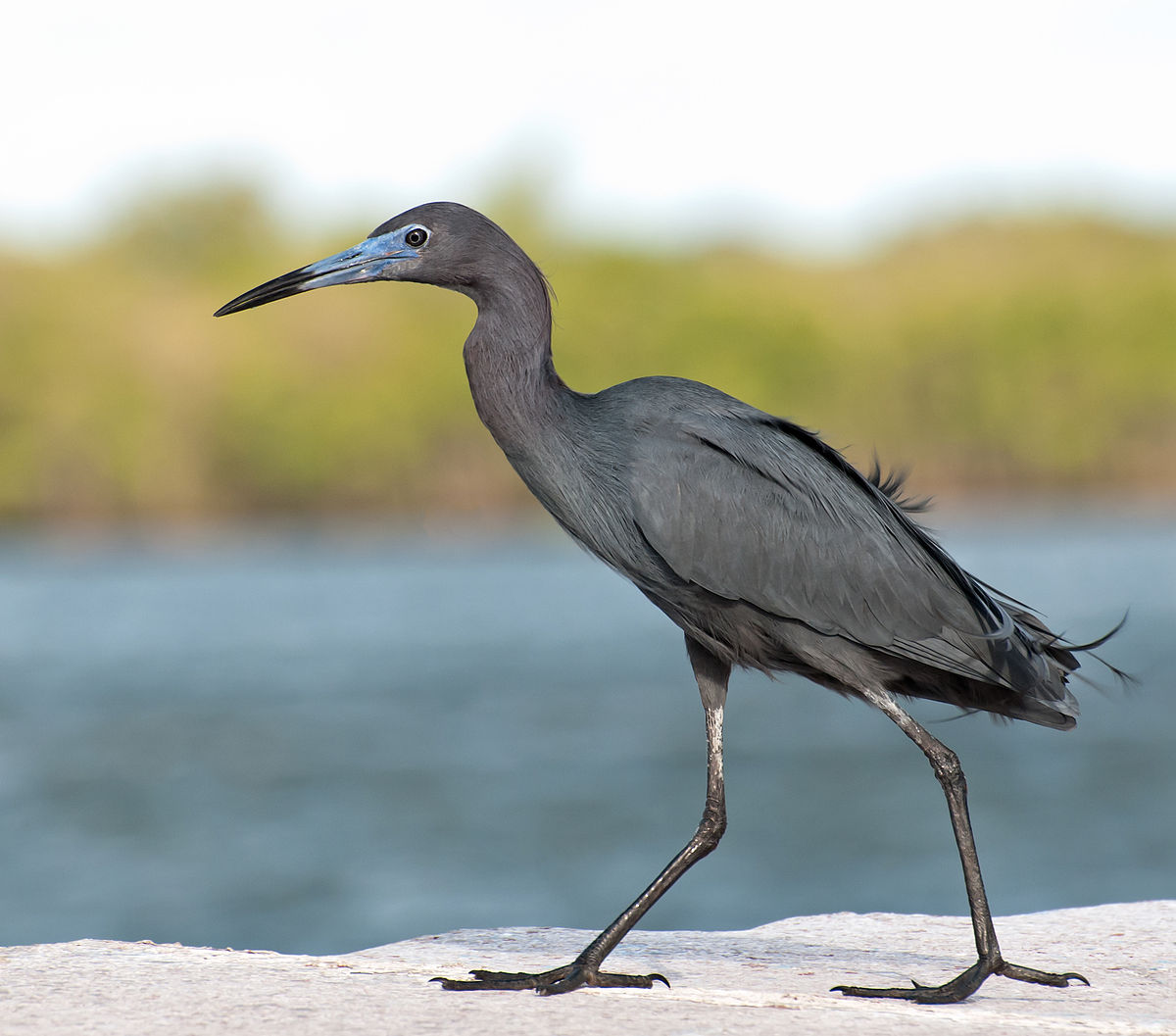
Wikipedia: Little blue heron Quelle: OTHER
1200px-Egretta_caerulea_-Cananeia%2C_Sao_Paulo%2C_Brasil-8.jpg
Dieser Vogel erscheint jenseits grossen Meere in Kontinenten :
Nordamerika, Südamerika, Afrika.
![]() Der Blaureiher (Egretta caerulea) gehört zur Familie der Reiher aus der Ordnung Pelecaniformes.
[more]
Der Blaureiher (Egretta caerulea) gehört zur Familie der Reiher aus der Ordnung Pelecaniformes.
[more]
Kuhreiher / Cattle egret (Bubulcus ibis)
Cow-plus-cattle egret. 2020-03-07 15.17.34 Panama
Zuerst beobachtet in Costa Rica an 2018-02-27.
Dieser Vogel erscheint jenseits grossen Meere in Kontinenten :
Europa, Nordamerika, Südamerika, Afrika, Asien.
![]() Der Kuhreiher (Bubulcus ibis) gehört zur Familie der Reiher aus der Ordnung Pelecaniformes. Er ist weltweit verbreitet und fehlt nur auf der Antarktika, sein Verbreitungsgebiet hat sich insbesondere im Verlauf des 20. Jahrhunderts stark ausgedehnt. Es werden zwei Unterarten unterschieden, die von einigen Autoren auch als eigene Arten aufgefasst werden.[1] In diesem Artikel wird der traditionellen Darstellung gefolgt, nach der der Kuhreiher die einzige Art der Gattung Bubulcus darstellt.
[more]
Der Kuhreiher (Bubulcus ibis) gehört zur Familie der Reiher aus der Ordnung Pelecaniformes. Er ist weltweit verbreitet und fehlt nur auf der Antarktika, sein Verbreitungsgebiet hat sich insbesondere im Verlauf des 20. Jahrhunderts stark ausgedehnt. Es werden zwei Unterarten unterschieden, die von einigen Autoren auch als eigene Arten aufgefasst werden.[1] In diesem Artikel wird der traditionellen Darstellung gefolgt, nach der der Kuhreiher die einzige Art der Gattung Bubulcus darstellt.
[more]
Vokalisierung: ![]() Usually silent away from breeding ground. In the colonies a chorus of various coarse sounds can be heard. Most distinct is a disyllabic "rick-rack". Other sounds includes short, guttural utterings, or drawn, harsh shrieks. [Link]
Usually silent away from breeding ground. In the colonies a chorus of various coarse sounds can be heard. Most distinct is a disyllabic "rick-rack". Other sounds includes short, guttural utterings, or drawn, harsh shrieks. [Link]
Körperlich: Länge=48-53 cm,
Flügelspanne=90-96 cm,
Gewicht=300-400 g
Gesang:
Automatically generated from Xeno-Canto recording
Gesang Eigenschaften:
Frequency:
♫ XC794287 - Eastern Cattle Egret - Bubulcus coromandus - call - Hong Kong, China. Quelle: XENOCANTO
XC794287 - Eastern Cattle Egret - Bubulcus coromandus - call - Hong Kong, China.mp3
(Ruf)
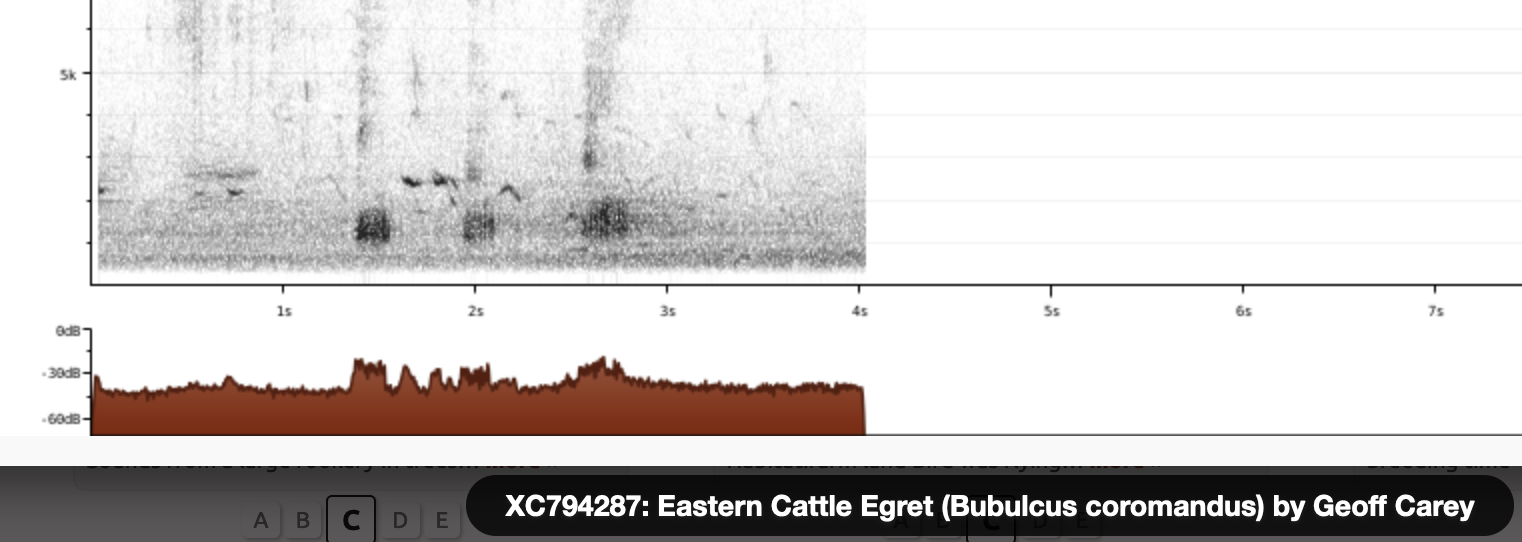
Ruf:
Automatically generated from Xeno-Canto recording
♫ XC353848 - Western Cattle Egret - Bubulcus ibis - flight call - sevilla, andalucía, Spain. Quelle: XENOCANTO
XC353848 - Western Cattle Egret - Bubulcus ibis - flight call - sevilla, andalucía, Spain.mp3
Spanien (Flugruf)
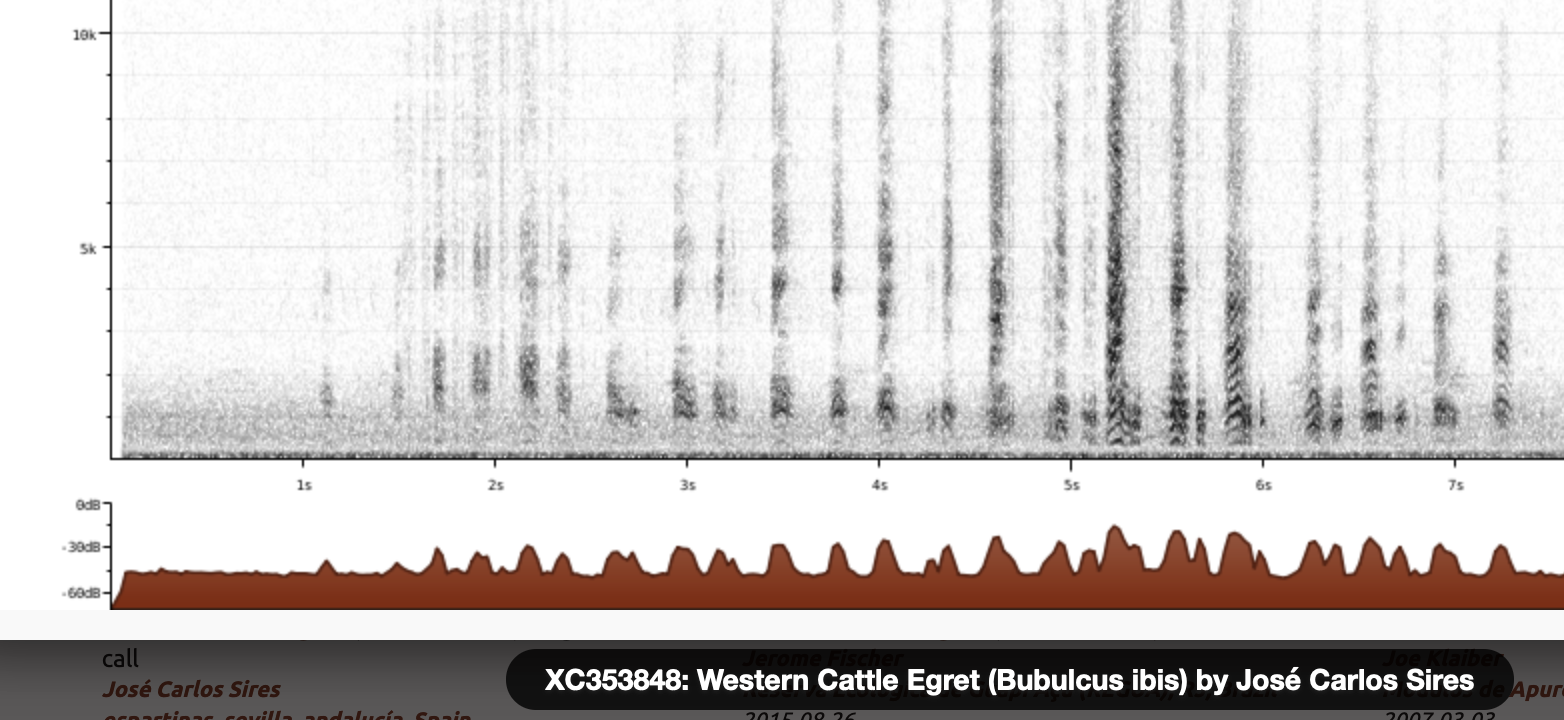
Ruf Eigenschaften:
Flugruf Frequenz: ,
Butorides striata / Green-backed heron (Butorides striata)
Striated heron. 2024-02-22 11.31.30 Laos
Zuerst beobachtet in Laos an 2024-02-22.
Dieser Vogel erscheint jenseits grossen Meere in Kontinenten :
Europa, Südamerika, Afrika, Asien.
Gesang:
Automatically generated from Xeno-Canto recording
Gesang Eigenschaften:
Frequency:
♫ XC791519 - Striated Heron - Butorides striata - song, sounds like Ow plus pi-rol lhl, Copperbelt Province, Zambia. Quelle: XENOCANTO
XC791519 - Striated Heron - Butorides striata - song, sounds like Ow plus pi-rol lhl, Copperbelt Province, Zambia.mp3
(Gesang)

Graurückendommel / Dwarf bittern (Ixobrychus sturmii)
Profil Wikipedia eBird Xeno-Canto

Wikipedia: Dwarf bittern Quelle: OTHER
BitternDwarf.jpg
Allgemein: ![]() Die Graurückendommel oder Schieferdommel (Ixobrychus sturmii) ist eine afrikanische Verwandte der Zwergdommel aus der Familie der Reiher.
[more]
Die Graurückendommel oder Schieferdommel (Ixobrychus sturmii) ist eine afrikanische Verwandte der Zwergdommel aus der Familie der Reiher.
[more]
Dickschnabelreiher / Madagascar pond-heron (Ardeola idae)

Wikipedia: Madagascar pond-heron Quelle: OTHER
Ardeola_idae.jpg
![]() Der Dickschnabelreiher (Ardeola idae) ist eine Art aus der Familie der Reiher, der zur Gattung der Schopfreiher zählt. Er gehört zu den besonders bedrohten Reiherarten. Sein Brutgebiet ist Madagaskar, außerhalb der Brutzeit kommt er auch in Ostafrika vor.
[more]
Der Dickschnabelreiher (Ardeola idae) ist eine Art aus der Familie der Reiher, der zur Gattung der Schopfreiher zählt. Er gehört zu den besonders bedrohten Reiherarten. Sein Brutgebiet ist Madagaskar, außerhalb der Brutzeit kommt er auch in Ostafrika vor.
[more]
Rotbauchreiher / Rufous-bellied heron (Ardeola rufiventris)
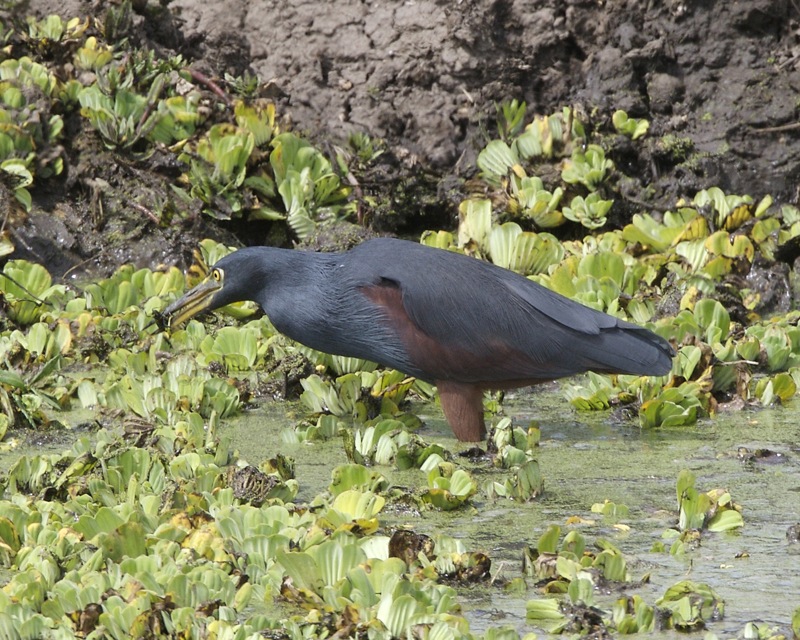
Wikipedia: Rufous-bellied heron Quelle: OTHER
Rufous-bellied_Heron_%28Ardeola_rufiventris%29.jpg
![]() Der Rotbauchreiher (Ardeola rufiventris) ist eine Art aus der Familie der Reiher, der zur Gattung der Schopfreiher gehört. Es handelt sich um einen mittelgrauen Reiher mit einem grauen und kastanienbraunen Gefieder. Er kommt ausschließlich in Afrika vor, wo er weitverbreitet, jedoch nirgendwo häufig ist. Er gilt als eine bislang nur unzureichend erforschte Art, denn sowohl die Lebensraumanforderungen, die spezifischen Ernährungsgewohnheiten und die Brutbiologie sind nur in geringem Umfang dokumentiert.
[more]
Der Rotbauchreiher (Ardeola rufiventris) ist eine Art aus der Familie der Reiher, der zur Gattung der Schopfreiher gehört. Es handelt sich um einen mittelgrauen Reiher mit einem grauen und kastanienbraunen Gefieder. Er kommt ausschließlich in Afrika vor, wo er weitverbreitet, jedoch nirgendwo häufig ist. Er gilt als eine bislang nur unzureichend erforschte Art, denn sowohl die Lebensraumanforderungen, die spezifischen Ernährungsgewohnheiten und die Brutbiologie sind nur in geringem Umfang dokumentiert.
[more]
Rallenreiher / Squacco heron (Ardeola ralloides)
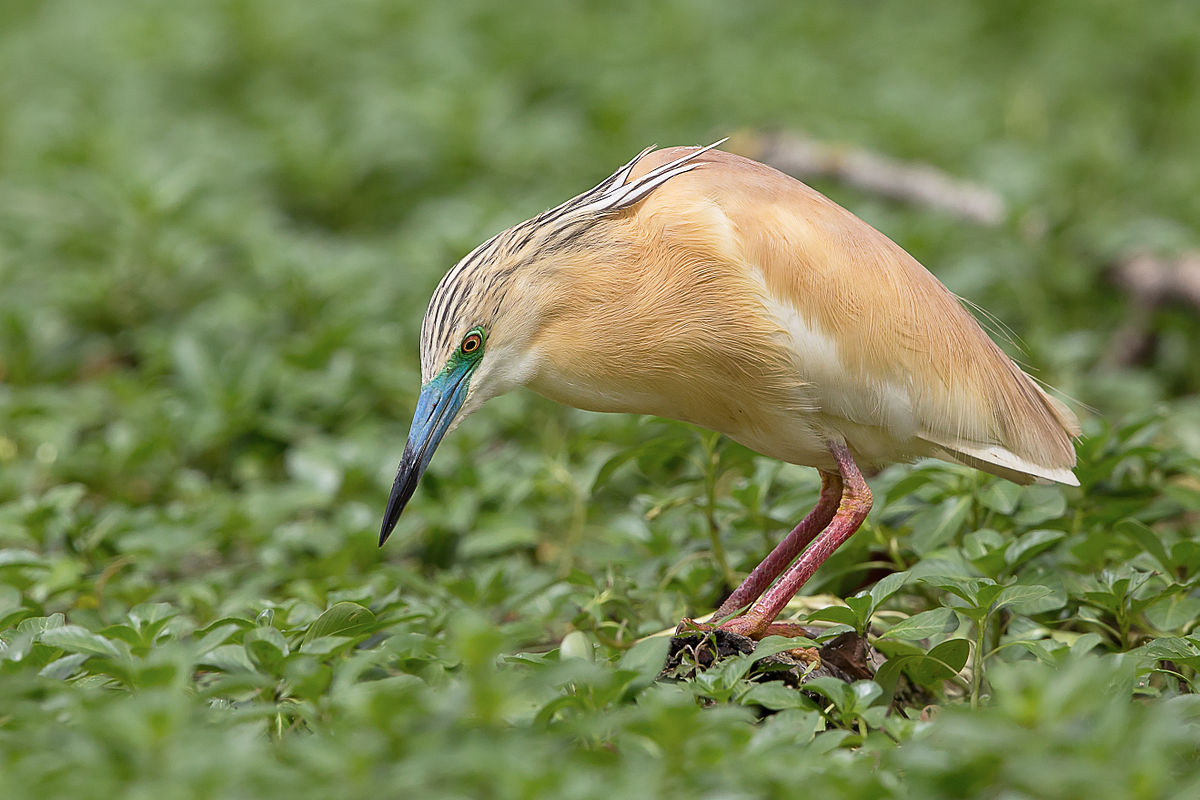
Wikipedia: Squacco heron Quelle: OTHER
1200px-Crabier_chevelu.jpg
![]() Der Rallenreiher (Ardeola ralloides) ist ein altweltlicher Vogel der Gattung Ardeola aus der Familie der Reiher (Ardeidae). In Mitteleuropa ist der Rallenreiher nur noch in Ungarn ein Brutvogel sowie mit stark schwankendem Bestand in der Slowakei. Im nördlichen Teil des Skutari-Sees in Montenegro findet sich im Sommer eine größere Population.
[more]
Der Rallenreiher (Ardeola ralloides) ist ein altweltlicher Vogel der Gattung Ardeola aus der Familie der Reiher (Ardeidae). In Mitteleuropa ist der Rallenreiher nur noch in Ungarn ein Brutvogel sowie mit stark schwankendem Bestand in der Slowakei. Im nördlichen Teil des Skutari-Sees in Montenegro findet sich im Sommer eine größere Population.
[more]
Habitate:
Nassgebiet
Gorsachius leuconotus / White-backed night-heron (Gorsachius leuconotus)
Profil Wikipedia eBird Xeno-Canto

Wikipedia: White-backed night-heron Quelle: OTHER
1200px-White-backed_Night_Heron_%28Gorsachius_leuconotus%29_%286001840951%29.jpg
![]() The white-backed night heron (Gorsachius leuconotus) is a species of medium-sized heron in the family Ardeidae, found in sub-Saharan Africa.
[more]
The white-backed night heron (Gorsachius leuconotus) is a species of medium-sized heron in the family Ardeidae, found in sub-Saharan Africa.
[more]
Anhinga rufa / African darter (Anhinga rufa)
African darter. 2016-09-23 09.06.10 Botswana
Zuerst beobachtet in Botswana an 2016-09-23.
![]() The African darter (Anhinga rufa), sometimes called the snakebird, is a water bird of sub-Saharan Africa and Iraq.[1]
[more]
The African darter (Anhinga rufa), sometimes called the snakebird, is a water bird of sub-Saharan Africa and Iraq.[1]
[more]
Bindenfregattvogel / Great frigatebird (Fregata minor)
Profil Wikipedia eBird Audubon AllAboutBirds Xeno-Canto
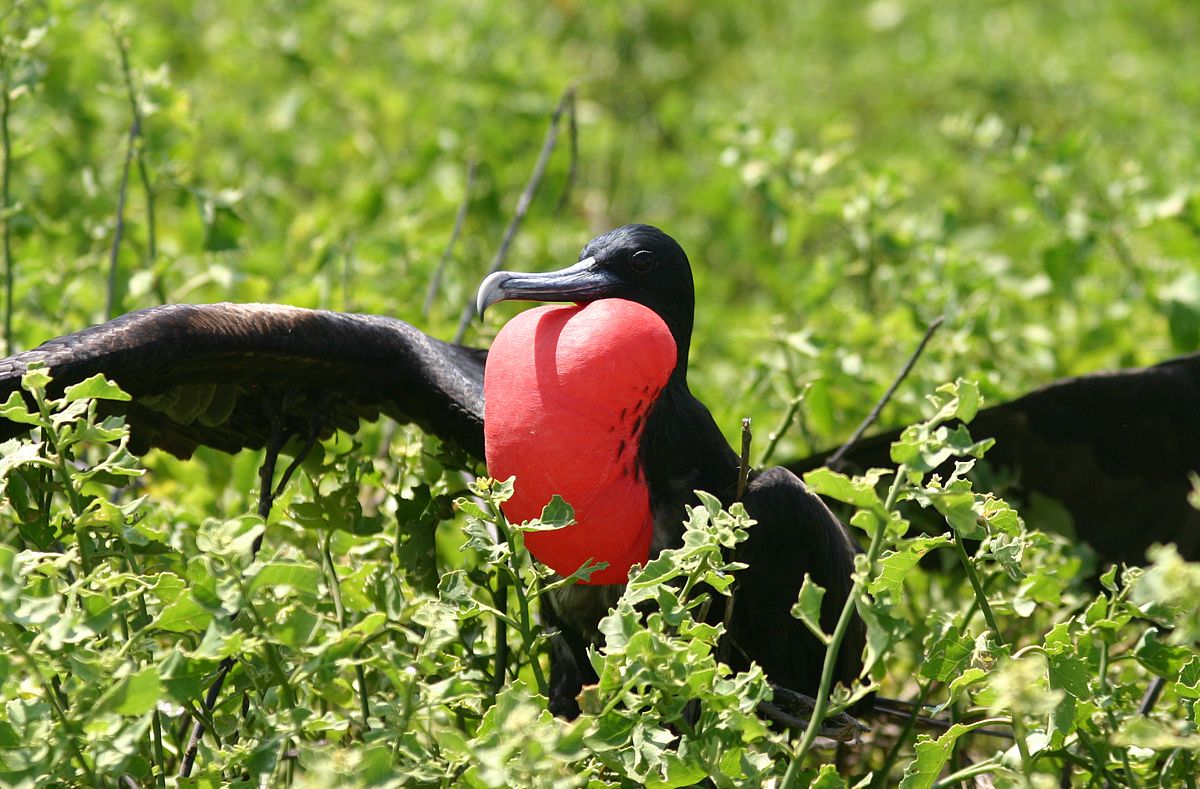
Wikipedia: Great frigatebird Quelle: OTHER
1200px-Male_greater_frigate_bird_displaying.jpg
Dieser Vogel erscheint jenseits grossen Meere in Kontinenten :
Nordamerika, Südamerika, Afrika, Asien.
![]() Der Bindenfregattvogel (Fregata minor) ist ein großer Vogel aus der Familie der Fregattvögel (Fregatidae). Es handelt sich um sehr große, schwarze oder schwarzweiße Seevögel, die in ihrer Körpergröße die meisten anderen Seevögel übertreffen, die in tropischen Gewässern vorkommen. Lediglich der seltene Weißbauch-Fregattvogel ist noch größer.
[more]
Der Bindenfregattvogel (Fregata minor) ist ein großer Vogel aus der Familie der Fregattvögel (Fregatidae). Es handelt sich um sehr große, schwarze oder schwarzweiße Seevögel, die in ihrer Körpergröße die meisten anderen Seevögel übertreffen, die in tropischen Gewässern vorkommen. Lediglich der seltene Weißbauch-Fregattvogel ist noch größer.
[more]
Arielfregattvogel / Lesser frigatebird (Fregata ariel)
Profil Wikipedia eBird Xeno-Canto

Wikipedia: Lesser frigatebird Quelle: OTHER
1200px-Lesser_Frigatebird_from_Indonesia.jpg
![]() Der Arielfregattvogel (Fregata ariel) ist ein Meeresvogel aus der Familie der Fregattvögel (Fregatidae) und die kleinste Art der Familie. Arielfregattvögel sind in den tropischen Gewässern des Pazifiks weit verbreitet. Sie kommen außerdem in einer kleinen Region vor der atlantischen Küste Brasiliens vor.[1]
[more]
Der Arielfregattvogel (Fregata ariel) ist ein Meeresvogel aus der Familie der Fregattvögel (Fregatidae) und die kleinste Art der Familie. Arielfregattvögel sind in den tropischen Gewässern des Pazifiks weit verbreitet. Sie kommen außerdem in einer kleinen Region vor der atlantischen Küste Brasiliens vor.[1]
[more]
Rötelpelikan / Pink-backed pelican (Pelecanus rufescens)
Profil Wikipedia eBird Xeno-Canto

Wikipedia: Pink-backed pelican Quelle: OTHER
1200px-Pink_backed_pelican_side_view.jpg
![]() Der Rötelpelikan (Pelecanus rufescens) ist eine Vogelart aus der Familie der Pelikane und die kleinste Pelikanart der Alten Welt. Seine Verbreitung reicht über das tropische und subtropische Afrika bis ins südliche Ägypten und an den Westrand der Arabischen Halbinsel. Im Unterschied zu den beiden großen Pelikanarten Rosa- und Krauskopfpelikan brütet er nicht am Boden, sondern auf Bäumen. Die Kolonien sind mit 20 bis 500 Paaren meist deutlich kleiner.
[more]
Der Rötelpelikan (Pelecanus rufescens) ist eine Vogelart aus der Familie der Pelikane und die kleinste Pelikanart der Alten Welt. Seine Verbreitung reicht über das tropische und subtropische Afrika bis ins südliche Ägypten und an den Westrand der Arabischen Halbinsel. Im Unterschied zu den beiden großen Pelikanarten Rosa- und Krauskopfpelikan brütet er nicht am Boden, sondern auf Bäumen. Die Kolonien sind mit 20 bis 500 Paaren meist deutlich kleiner.
[more]
Rosapelikan / Great white pelican (Pelecanus onocrotalus)
Profil Wikipedia eBird Xeno-Canto NABU

Wikipedia: Great white pelican Quelle: OTHER
1200px-Great_white_pelican_%28Pelecanus_onocrotalus%29.jpg
![]() Der Rosapelikan (Pelecanus onocrotalus) ist eine Vogelart aus der Familie der Pelikane. Da die Art in großen Kolonien an Seen und Flüssen oder Küsteninseln und Lagunen brütet, liegen die Brutvorkommen sehr zerstreut. Sie reichen von Südosteuropa über Kleinasien bis nach Zentralasien und zum Westrand des Indischen Subkontinents sowie über ganz Subsahara-Afrika. Außerhalb der Brutzeit ist die Art sehr viel großflächiger verbreitet. Die nördlichen Populationen überwintern vorwiegend in Afrika, die asiatischen zum Teil auch in Pakistan. In Afrika ist die Art Stand- oder Strichvogel.
[more]
Der Rosapelikan (Pelecanus onocrotalus) ist eine Vogelart aus der Familie der Pelikane. Da die Art in großen Kolonien an Seen und Flüssen oder Küsteninseln und Lagunen brütet, liegen die Brutvorkommen sehr zerstreut. Sie reichen von Südosteuropa über Kleinasien bis nach Zentralasien und zum Westrand des Indischen Subkontinents sowie über ganz Subsahara-Afrika. Außerhalb der Brutzeit ist die Art sehr viel großflächiger verbreitet. Die nördlichen Populationen überwintern vorwiegend in Afrika, die asiatischen zum Teil auch in Pakistan. In Afrika ist die Art Stand- oder Strichvogel.
[more]
Rotschwanz-Tropikvogel / Red-tailed tropicbird (Phaethon rubricauda)
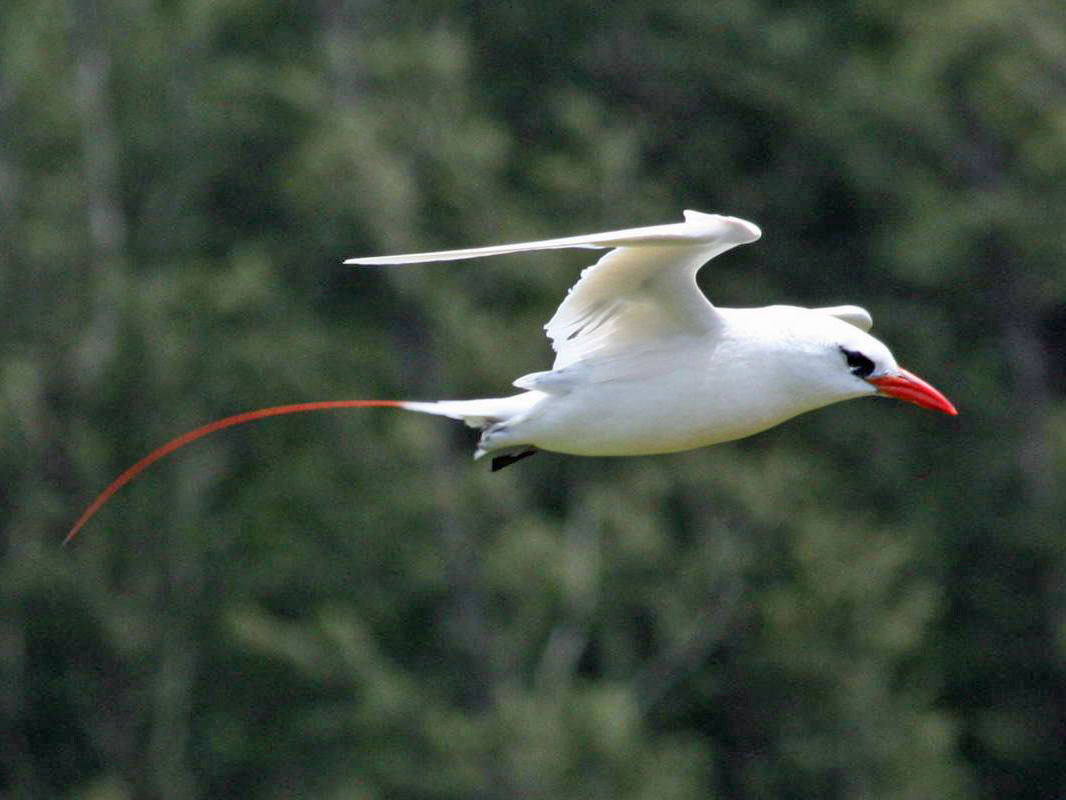
Wikipedia: Red-tailed tropicbird Quelle: OTHER
Red-tailed_Tropicbird_RWD2.jpg
Dieser Vogel erscheint jenseits grossen Meere in Kontinenten :
Nordamerika, Afrika.
![]() Der Rotschwanz-Tropikvogel (Phaethon rubricauda) ist eine Vogelart aus der Ordnung Phaethontiformes und lebt über dem subtropischen und tropischen Indopazifik. Im Unterschied zu den beiden anderen Tropikvogelarten fehlt er über dem Atlantik.
[more]
Der Rotschwanz-Tropikvogel (Phaethon rubricauda) ist eine Vogelart aus der Ordnung Phaethontiformes und lebt über dem subtropischen und tropischen Indopazifik. Im Unterschied zu den beiden anderen Tropikvogelarten fehlt er über dem Atlantik.
[more]
Rotschnabel-Tropikvogel / Red-billed tropicbird (Phaethon aethereus)
Profil Wikipedia eBird Audubon AllAboutBirds Xeno-Canto

Wikipedia: Red-billed tropicbird Quelle: OTHER
1200px-Red-billed_tropicbird.jpg
Dieser Vogel erscheint jenseits grossen Meere in Kontinenten :
Nordamerika, Südamerika, Afrika.
![]() Der Rotschnabel-Tropikvogel (Phaethon aethereus) ist ein Vogel aus der Ordnung der Tropikvögel. Wie alle Tropikvogelarten zeichnet er sich durch extrem verlängerte mittlere Schwanzfedern aus. Seine Schwimmfähigkeit ist recht schlecht, die Flugfähigkeiten sind dagegen ausgezeichnet und die Vögel können häufig hunderte von Kilometern vom Land entfernt über offenem Meer angetroffen werden.
[more]
Der Rotschnabel-Tropikvogel (Phaethon aethereus) ist ein Vogel aus der Ordnung der Tropikvögel. Wie alle Tropikvogelarten zeichnet er sich durch extrem verlängerte mittlere Schwanzfedern aus. Seine Schwimmfähigkeit ist recht schlecht, die Flugfähigkeiten sind dagegen ausgezeichnet und die Vögel können häufig hunderte von Kilometern vom Land entfernt über offenem Meer angetroffen werden.
[more]
Weißschwanz-Tropikvogel / White-tailed tropicbird (Phaethon lepturus)
Profil Wikipedia eBird Audubon AllAboutBirds Xeno-Canto
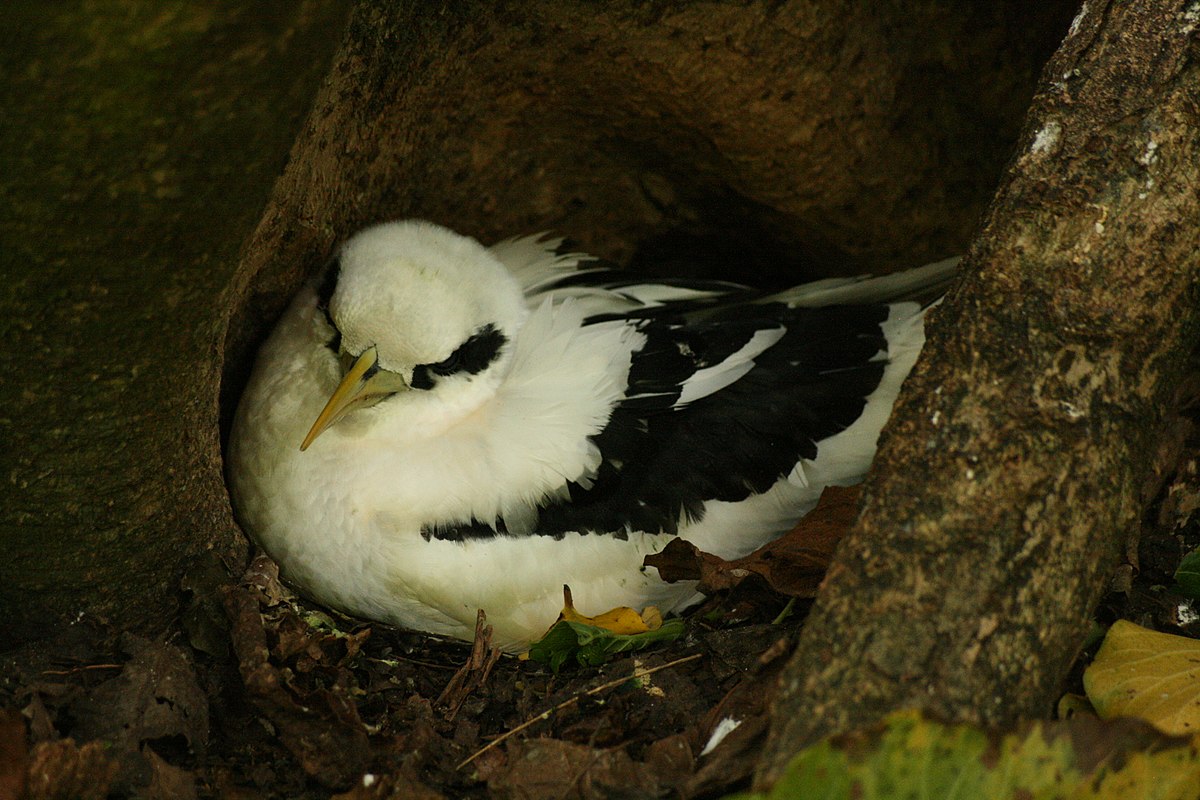
Wikipedia: White-tailed tropicbird Quelle: OTHER
1200px-White-tailed_Tropicbird_-_Phaeton_lepturus.jpg
Dieser Vogel erscheint jenseits grossen Meere in Kontinenten :
Nordamerika, Afrika, Asien.
![]() Der Weißschwanz-Tropikvogel (Phaethon lepturus) ist der kleinste der drei Tropikvogel-Arten. Er verbringt die meiste Zeit auf dem offenen Meer der tropischen Ozeane.
[more]
Der Weißschwanz-Tropikvogel (Phaethon lepturus) ist der kleinste der drei Tropikvogel-Arten. Er verbringt die meiste Zeit auf dem offenen Meer der tropischen Ozeane.
[more]
Weißbauchtölpel / Brown booby (Sula leucogaster)
Profil Wikipedia eBird Audubon AllAboutBirds Xeno-Canto

Wikipedia: Brown booby Quelle: OTHER
1200px-Atob%C3%A1-pardo.jpg
Dieser Vogel erscheint jenseits grossen Meere in Kontinenten :
Nordamerika, Südamerika, Afrika, Asien.
![]() Der Weißbauchtölpel (Sula leucogaster) ist ein gänsegroßer Seevogel aus der Familie der Tölpel (Sulidae) in der Ordnung der Ruderfüßer (Pelecaniformes).
[more]
Der Weißbauchtölpel (Sula leucogaster) ist ein gänsegroßer Seevogel aus der Familie der Tölpel (Sulidae) in der Ordnung der Ruderfüßer (Pelecaniformes).
[more]
Rotfußtölpel / Red-footed booby (Sula sula)
Profil Wikipedia eBird Audubon AllAboutBirds Xeno-Canto
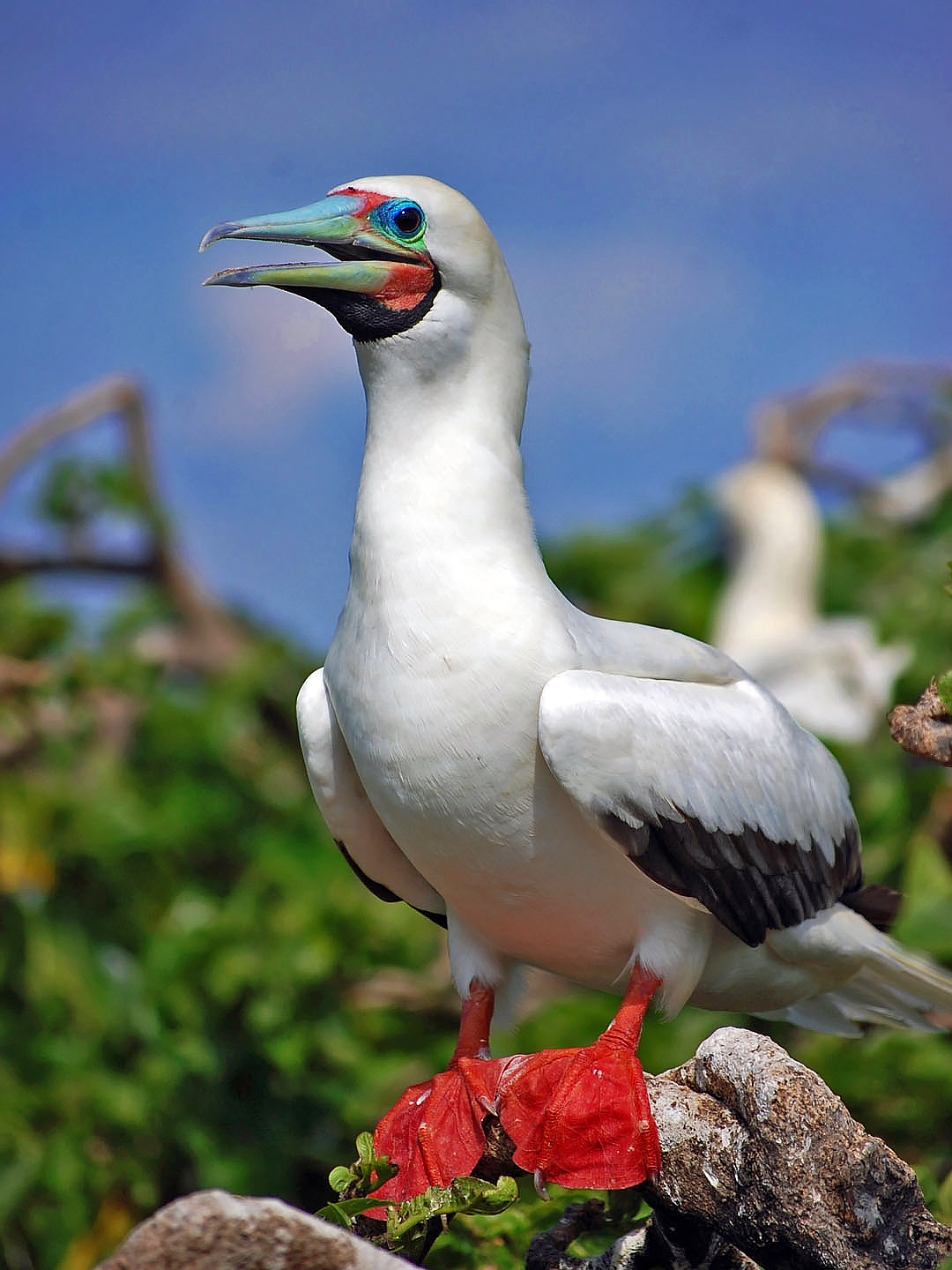
Wikipedia: Red-footed booby Quelle: OTHER
Sula_sula_by_Gregg_Yan_01.jpg
Dieser Vogel erscheint jenseits grossen Meere in Kontinenten :
Nordamerika, Südamerika, Afrika.
![]() Der Rotfußtölpel (Sula sula) ist ein Vogel aus der Familie der Tölpel (Sulidae). Es gibt mehrere Farbmorphen, die meisten Rotfußtölpel weisen jedoch ein überwiegend weißes Gefieder auf. Einige wenige Individuen zeigen ein überwiegend braunes Gefieder und zahlreiche Individuen sind Mischformen der weißen und braunen Morphen.
[more]
Der Rotfußtölpel (Sula sula) ist ein Vogel aus der Familie der Tölpel (Sulidae). Es gibt mehrere Farbmorphen, die meisten Rotfußtölpel weisen jedoch ein überwiegend weißes Gefieder auf. Einige wenige Individuen zeigen ein überwiegend braunes Gefieder und zahlreiche Individuen sind Mischformen der weißen und braunen Morphen.
[more]
Sula dactylatra / Masked booby (Sula dactylatra)

Wikipedia: Masked booby Quelle: OTHER
1200px-Starr_080606-6808_Coronopus_didymus.jpg
Dieser Vogel erscheint jenseits grossen Meere in Kontinenten :
Nordamerika, Südamerika, Afrika, Asien.
![]() The masked booby (Sula dactylatra), also called the masked gannet or the blue-faced booby, is a large seabird of the booby and gannet family, Sulidae. First described by the French naturalist René-Primevère Lesson in 1831, the masked booby is one of six species of booby in the genus Sula. It has a typical sulid body shape, with a long pointed yellowish bill, long neck, aerodynamic body, long slender wings and pointed tail. The adult is bright white with black wings, a black tail and a dark face mask; at 75–85 cm (30–33 in) long, it is the largest species of booby. The sexes have similar plumage. This species ranges across tropical oceans, except in the eastern Atlantic and eastern Pacific. In the latter, it is replaced by the Nazca booby (Sula granti), which was formerly regarded as a subspecies of masked booby.
[more]
The masked booby (Sula dactylatra), also called the masked gannet or the blue-faced booby, is a large seabird of the booby and gannet family, Sulidae. First described by the French naturalist René-Primevère Lesson in 1831, the masked booby is one of six species of booby in the genus Sula. It has a typical sulid body shape, with a long pointed yellowish bill, long neck, aerodynamic body, long slender wings and pointed tail. The adult is bright white with black wings, a black tail and a dark face mask; at 75–85 cm (30–33 in) long, it is the largest species of booby. The sexes have similar plumage. This species ranges across tropical oceans, except in the eastern Atlantic and eastern Pacific. In the latter, it is replaced by the Nazca booby (Sula granti), which was formerly regarded as a subspecies of masked booby.
[more]
Kaptölpel / Cape gannet (Morus capensis)
Profil Wikipedia eBird Xeno-Canto

Wikipedia: Cape gannet Quelle: OTHER
1200px-Cape_Gannet_-_Morus_capensis.JPG
![]() Der Kaptölpel (Morus capensis) ist ein knapp gänsegroßer Meeresvogel aus der Familie der Tölpel. In seinem Erscheinungsbild erinnert er an Bass- und Australtölpel.
[more]
Der Kaptölpel (Morus capensis) ist ein knapp gänsegroßer Meeresvogel aus der Familie der Tölpel. In seinem Erscheinungsbild erinnert er an Bass- und Australtölpel.
[more]
Morus serrator / Australasian gannet (Morus serrator)

Wikipedia: Australasian gannet Quelle: OTHER
1200px-Morus_serrator_-_Dunalley.jpg
![]() The Australasian gannet (Morus serrator), also known as the Australian gannet or tākapu, is a large seabird of the booby and gannet family, Sulidae. Adults are mostly white, with black flight feathers at the wingtips and lining the trailing edge of the wing. The central tail feathers are also black. The head is tinged buff-yellow, with a pale blue-grey bill edged in black, and blue-rimmed eyes. Young birds have mottled plumage in their first year, dark above and light below. The head is an intermediate mottled grey, with a dark bill. The birds gradually acquire more white in subsequent seasons until they reach maturity after five years.
[more]
The Australasian gannet (Morus serrator), also known as the Australian gannet or tākapu, is a large seabird of the booby and gannet family, Sulidae. Adults are mostly white, with black flight feathers at the wingtips and lining the trailing edge of the wing. The central tail feathers are also black. The head is tinged buff-yellow, with a pale blue-grey bill edged in black, and blue-rimmed eyes. Young birds have mottled plumage in their first year, dark above and light below. The head is an intermediate mottled grey, with a dark bill. The birds gradually acquire more white in subsequent seasons until they reach maturity after five years.
[more]
Brauner Sichler / Glossy ibis (Plegadis falcinellus)
Sichler nach ornitho, Brauner Sichler nach Wikipedia oder Plegadis falcinellus, Neeracherried. Quelle: WIKIPEDIA
20220904_071146-DSC_0059 Sichler nach ornitho, Brauner Sichler nach Wikipedia oder Plegadis falcinellus, Neeracherried.JPG
2022-09-04 07.11.46
Zuerst beobachtet in 🇨🇭 an 2022-09-04.
Dieser Vogel erscheint jenseits grossen Meere in Kontinenten :
Europa, Nordamerika, Südamerika, Afrika, Asien.
![]() Der Braune Sichler (Plegadis falcinellus), oft auch Braunsichler oder nur Sichler genannt, ist ein weltweit verbreiteter Ibis.
[more]
Der Braune Sichler (Plegadis falcinellus), oft auch Braunsichler oder nur Sichler genannt, ist ein weltweit verbreiteter Ibis.
[more]
Vokalisierung: ![]() Generally silent away from breeding ground. Dry, crow-like "garr garr", may be heard occasionally in flight. At breeding ground various guttural grunts, and piping, hissing sounds. [Link]
Generally silent away from breeding ground. Dry, crow-like "garr garr", may be heard occasionally in flight. At breeding ground various guttural grunts, and piping, hissing sounds. [Link]
Körperlich: Länge=55-65 cm,
Flügelspanne=80-95 cm,
Gewicht=530-768 g
Rotgesichtlöffler / African spoonbill (Platalea alba)
Profil Wikipedia eBird Xeno-Canto
African spoonbill makes shade with its wing to hunt. 2016-09-29 08.30.10 Botswana
Zuerst beobachtet in Botswana an 2016-09-29.
Allgemein: ![]() Der Rotgesichtlöffler (Platalea alba), auch Afrikanischer Löffler, Rosenfußlöffler oder Schmalschnabellöffler genannt, ist eine Vogelart aus der Familie der Ibisse und Löffler (Threskiornithidae). Sie kommt in Afrika südlich der Sahara vom Senegal im Westen bis Äthiopien und Eritrea im Osten, Südafrika im Süden sowie im Westen von Madagaskar vor. Die Kapregion wurde erst seit Mitte des 20. Jahrhunderts besiedelt. Im Kongobecken und im größten Teil von Angola fehlt die Art. Der Rotgesichtlöffler ist nah mit dem Löffler (Platalea leucorodia), dem Schwarzstirnlöffler (P. minor) und dem Königslöffler (P. regia) verwandt.[1]
[more]
Der Rotgesichtlöffler (Platalea alba), auch Afrikanischer Löffler, Rosenfußlöffler oder Schmalschnabellöffler genannt, ist eine Vogelart aus der Familie der Ibisse und Löffler (Threskiornithidae). Sie kommt in Afrika südlich der Sahara vom Senegal im Westen bis Äthiopien und Eritrea im Osten, Südafrika im Süden sowie im Westen von Madagaskar vor. Die Kapregion wurde erst seit Mitte des 20. Jahrhunderts besiedelt. Im Kongobecken und im größten Teil von Angola fehlt die Art. Der Rotgesichtlöffler ist nah mit dem Löffler (Platalea leucorodia), dem Schwarzstirnlöffler (P. minor) und dem Königslöffler (P. regia) verwandt.[1]
[more]
Glattnackenrapp / Southern bald ibis (Geronticus calvus)
Profil Wikipedia eBird Xeno-Canto

Wikipedia: Southern bald ibis Quelle: OTHER
1200px-Geronticus.calvus.1.jpg
![]() Der Glattnackenrapp oder Glattnackenibis (Geronticus calvus) ist ein seltener Ibis, der im südlichen Afrika lebt. Die Bestandssituation des Glattnackenrapps wird von der IUCN als gefährdet (vulnerable) angegeben.[1]
[more]
Der Glattnackenrapp oder Glattnackenibis (Geronticus calvus) ist ein seltener Ibis, der im südlichen Afrika lebt. Die Bestandssituation des Glattnackenrapps wird von der IUCN als gefährdet (vulnerable) angegeben.[1]
[more]
Threskiornis aethiopicus / Sacred ibis (Threskiornis aethiopicus)

Wikipedia: Sacred ibis Quelle: OTHER
1200px-Sacred_ibis_%28Threskiornis_aethiopicus%29.jpg
![]() The African sacred ibis (Threskiornis aethiopicus) is a species of ibis, a wading bird of the family Threskiornithidae. It is native to Africa and the Middle East. It is especially known for its role in the religion of the Ancient Egyptians, where it was linked to the god Thoth; despite this, the species is currently extirpated from Egypt.
[more]
The African sacred ibis (Threskiornis aethiopicus) is a species of ibis, a wading bird of the family Threskiornithidae. It is native to Africa and the Middle East. It is especially known for its role in the religion of the Ancient Egyptians, where it was linked to the god Thoth; despite this, the species is currently extirpated from Egypt.
[more]
Hagedasch / Hadada ibis (Bostrychia hagedash)

Wikipedia: Hadada ibis Quelle: OTHER
1200px-Hadeda_Ibis_Portrait.jpg
![]() Der Hagedasch (Bostrychia hagedash) ist ein afrikanischer Vogel aus der Familie der Ibisse und Löffler.
[more]
Der Hagedasch (Bostrychia hagedash) ist ein afrikanischer Vogel aus der Familie der Ibisse und Löffler.
[more]

Wikipedia: African reed-warbler Quelle: OTHER
African_Reed_Warbler_%28Acrocephalus_baeticatus%29_%288077249754%29.jpg
![]() The African reed warbler or African marsh warbler (Acrocephalus baeticatus) is an Old World warbler in the genus Acrocephalus. It breeds in much of Africa south of the Sahara. It is migratory within the continent, with southern breeding population moving to the tropics in the southern hemisphere's winter.
[more]
The African reed warbler or African marsh warbler (Acrocephalus baeticatus) is an Old World warbler in the genus Acrocephalus. It breeds in much of Africa south of the Sahara. It is migratory within the continent, with southern breeding population moving to the tropics in the southern hemisphere's winter.
[more]

Wikipedia: Basra reed warbler Quelle: OTHER
1200px-Naturalis_Biodiversity_Center_-_RMNH.AVES.37596_1_-_Acrocephalus_arundinaceus_griseldis_%28Hartlaub%2C_1891%29_-_Sylviidae_-_bird_skin_specimen.jpeg
![]() Der Basrarohrsänger (Acrocephalus griseldis) ist ein Singvogel aus der Gattung der Rohrsänger (Acrocephalus) und der Familie der Rohrsängerartigen (Acrocephalidae).[1]
[more]
Der Basrarohrsänger (Acrocephalus griseldis) ist ein Singvogel aus der Gattung der Rohrsänger (Acrocephalus) und der Familie der Rohrsängerartigen (Acrocephalidae).[1]
[more]

Wikipedia: Lesser swamp-warbler Quelle: OTHER
Lesser_swamp_warbler_%28Acrocephalus_gracilirostris%29%2C_Marievale%2C_3.jpg
![]() The lesser swamp warbler or Cape reed warbler (Acrocephalus gracilirostris) is an Old World warbler in the genus Acrocephalus. It is a resident breeder in Africa from the Democratic Republic of the Congo, the Chad and Ethiopia south to South Africa. This is a common species of reedbeds in standing water.
[more]
The lesser swamp warbler or Cape reed warbler (Acrocephalus gracilirostris) is an Old World warbler in the genus Acrocephalus. It is a resident breeder in Africa from the Democratic Republic of the Congo, the Chad and Ethiopia south to South Africa. This is a common species of reedbeds in standing water.
[more]
Profil Wikipedia eBird Xeno-Canto NABU

Wikipedia: Olive-tree warbler Quelle: OTHER
1200px-Olive-tree_warbler%2C_Hippolais_olivetorum%2C_at_Mkuze_Game_Reserve%2C_%2839230388474%29.jpg
![]() Der Olivenspötter (Hippolais olivetorum) ist ein Singvogel aus der Familie der Rohrsängerartigen (Acrocephalidae). Die Art hat ein relativ kleines Verbreitungsgebiet in Südosteuropa und der Türkei.
[more]
Der Olivenspötter (Hippolais olivetorum) ist ein Singvogel aus der Familie der Rohrsängerartigen (Acrocephalidae). Die Art hat ein relativ kleines Verbreitungsgebiet in Südosteuropa und der Türkei.
[more]
Profil Wikipedia eBird Xeno-Canto

Wikipedia: Upcher's warbler Quelle: OTHER
Upcher%27s_Warbler_%28Hippolais_languida%29_%288079442053%29.jpg
![]() Upcher's warbler (Hippolais languida) is an Old World warbler in the tree warbler genus Hippolais. It breeds in an area from Turkey south and east to Pakistan. It is migratory, wintering in eastern Africa, from Eritrea and Somalia south to Tanzania.
[more]
Upcher's warbler (Hippolais languida) is an Old World warbler in the tree warbler genus Hippolais. It breeds in an area from Turkey south and east to Pakistan. It is migratory, wintering in eastern Africa, from Eritrea and Somalia south to Tanzania.
[more]
Profil Wikipedia eBird Xeno-Canto

Wikipedia: Cape crombec Quelle: OTHER
Crombec_Longbilled_2011_05_16_09_Alan_Manson_Prieska.jpg
![]() The long-billed crombec or Cape crombec (Sylvietta rufescens) is an African warbler.
[more]
The long-billed crombec or Cape crombec (Sylvietta rufescens) is an African warbler.
[more]

Wikipedia: Karoo eremomela Quelle: OTHER
Eremomela_Karoo_2015_01_24_08_15_57_4357s.jpg
![]() The Karoo eremomela (Eremomela gregalis), also known as the yellow-rumped eremomela, is a species of bird formerly placed in the "Old World warbler" assemblage, but now placed in the family Cisticolidae.
It is found in Namibia and South Africa.
Its natural habitat is subtropical or tropical dry shrubland.
[more]
The Karoo eremomela (Eremomela gregalis), also known as the yellow-rumped eremomela, is a species of bird formerly placed in the "Old World warbler" assemblage, but now placed in the family Cisticolidae.
It is found in Namibia and South Africa.
Its natural habitat is subtropical or tropical dry shrubland.
[more]
Profil Wikipedia eBird Xeno-Canto

Wikipedia: Yellow-bellied eremomela Quelle: OTHER
Yellow-bellied_eremomela%2C_Eremomela_icteropygialis%2C_at_Mapungubwe_National_Park%2C_Limpopo%2C_South_Africa_%2817696689908%29%2C_crop.jpg
![]() The yellow-bellied eremomela (Eremomela icteropygialis) is an Old World warbler. However, the taxonomy of the "African warblers", an assemblage of usually species-poor and apparently rather ancient "odd warblers" from Africa is currently in a state of flux. Today, most taxonomists consider members in this genus members of the family Cisticolidae.
[more]
The yellow-bellied eremomela (Eremomela icteropygialis) is an Old World warbler. However, the taxonomy of the "African warblers", an assemblage of usually species-poor and apparently rather ancient "odd warblers" from Africa is currently in a state of flux. Today, most taxonomists consider members in this genus members of the family Cisticolidae.
[more]
Profil Wikipedia eBird Xeno-Canto
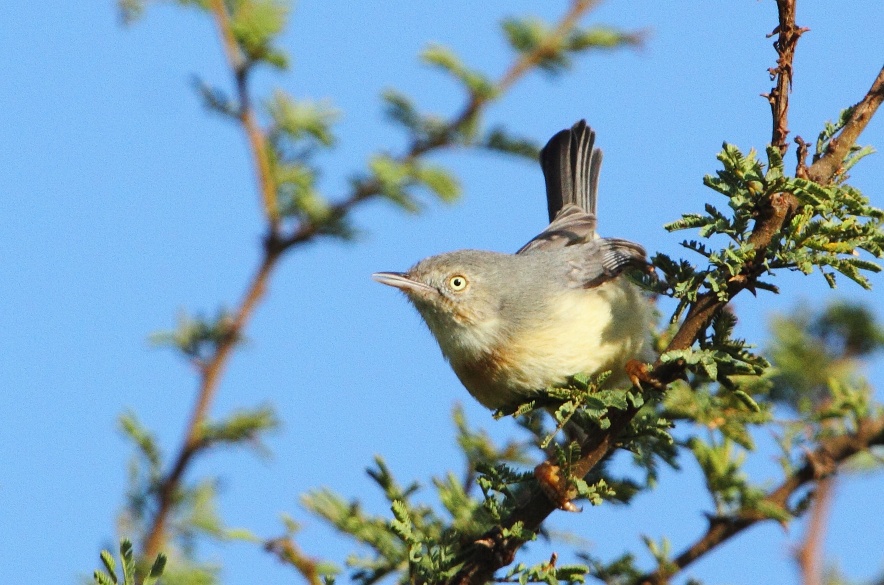
Wikipedia: Burnt-neck eremomela Quelle: OTHER
Eremomela_Burnt-necked_2015_06_02_08_21_35_5728.jpg
![]() The burnt-necked eremomela (Eremomela usticollis) is a species of bird formerly placed in the "Old World warbler" assemblage, but now placed in the family Cisticolidae. It is found in Angola, Botswana, Malawi, Mozambique, Namibia, South Africa, Swaziland, Zambia, and Zimbabwe. Its natural habitats are subtropical or tropical dry forests, dry savannah, and subtropical or tropical dry shrubland.
[more]
The burnt-necked eremomela (Eremomela usticollis) is a species of bird formerly placed in the "Old World warbler" assemblage, but now placed in the family Cisticolidae. It is found in Angola, Botswana, Malawi, Mozambique, Namibia, South Africa, Swaziland, Zambia, and Zimbabwe. Its natural habitats are subtropical or tropical dry forests, dry savannah, and subtropical or tropical dry shrubland.
[more]
Profil Wikipedia eBird Xeno-Canto

Wikipedia: Greencap eremomela Quelle: OTHER
Eremomela_scotops_scotops%2C_Cecil_Kop-natuurreservaat%2C_Birding_Weto%2C_a.jpg
![]() The green-capped eremomela or greencap eremomela (Eremomela scotops) is a species of bird formerly placed in the "Old World warbler" assemblage, but now placed in the family Cisticolidae.
[more]
The green-capped eremomela or greencap eremomela (Eremomela scotops) is a species of bird formerly placed in the "Old World warbler" assemblage, but now placed in the family Cisticolidae.
[more]

Wikipedia: Yellow flycatcher-warbler Quelle: OTHER
African_Yellow_Warbler_-_South_Africa_S4E7584_%2817123176947%29.jpg
![]() The African yellow warbler, Natal yellow warbler, dark-capped yellow warbler, or yellow flycatcher-warbler (Iduna natalensis) is a species of Acrocephalidae warblers; formerly, these were placed in the paraphyletic "Old World warblers".
[more]
The African yellow warbler, Natal yellow warbler, dark-capped yellow warbler, or yellow flycatcher-warbler (Iduna natalensis) is a species of Acrocephalidae warblers; formerly, these were placed in the paraphyletic "Old World warblers".
[more]
Profil Wikipedia eBird Xeno-Canto

Wikipedia: Layard's warbler Quelle: OTHER
Layard%27s_Tit-Babbler_2017_08_12_5272.jpg
![]() Layard's warbler (Curruca layardi) or Layard's tit-babbler, is a species of Old World warbler in the family Sylviidae. It is found in Lesotho, Namibia, and South Africa. Its natural habitat is subtropical or tropical dry shrubland.
[more]
Layard's warbler (Curruca layardi) or Layard's tit-babbler, is a species of Old World warbler in the family Sylviidae. It is found in Lesotho, Namibia, and South Africa. Its natural habitat is subtropical or tropical dry shrubland.
[more]
Profil Wikipedia eBird Xeno-Canto

Wikipedia: Bush blackcap Quelle: OTHER
Bush_Blackcap_2016_12_30_15_33_23_2771_crop.jpg
![]() The bush blackcap (Sylvia nigricapillus) is a species of bird in the family Sylviidae. It is endemic to South Africa and Swaziland. Its natural habitats are subtropical or tropical moist montane forests and subtropical or tropical high-altitude shrubland. It is threatened by habitat loss.[1]
[more]
The bush blackcap (Sylvia nigricapillus) is a species of bird in the family Sylviidae. It is endemic to South Africa and Swaziland. Its natural habitats are subtropical or tropical moist montane forests and subtropical or tropical high-altitude shrubland. It is threatened by habitat loss.[1]
[more]

Wikipedia: Rufous-vented warbler Quelle: OTHER
Titbabbler_Chestnut-vented_2010_07_18_09_Alan_Manson_Weenen.jpg
![]() The chestnut-vented warbler, chestnut-vented tit-babbler or rufous-vented warbler (Curruca subcoerulea) is an Old World warbler.
[more]
The chestnut-vented warbler, chestnut-vented tit-babbler or rufous-vented warbler (Curruca subcoerulea) is an Old World warbler.
[more]

Wikipedia: Sombre greenbul Quelle: OTHER
1200px-Sombre_greenbul%2C_Andropadus_importunus.jpg
![]() The sombre greenbul (Andropadus importunus) is a member of the bulbul family of passerine birds. It is a resident breeder in coastal bush, evergreen forest and dry shrub land in eastern and southern Africa. It is the only member of the genus Andropadus.
[more]
The sombre greenbul (Andropadus importunus) is a member of the bulbul family of passerine birds. It is a resident breeder in coastal bush, evergreen forest and dry shrub land in eastern and southern Africa. It is the only member of the genus Andropadus.
[more]
Profil Wikipedia eBird Xeno-Canto

Wikipedia: Terrestrial brownbul Quelle: OTHER
Brownbul_Terrestrial_2010_10_02_Alan_Manson_Ngwenya.jpg
![]() The terrestrial brownbul (Phyllastrephus terrestris) is a species of songbird in the bulbul family, Pycnonotidae.
It is found in eastern and south-eastern Africa. Its natural habitats are subtropical or tropical dry forest, subtropical or tropical moist lowland forest, and subtropical or tropical moist shrubland.
[more]
The terrestrial brownbul (Phyllastrephus terrestris) is a species of songbird in the bulbul family, Pycnonotidae.
It is found in eastern and south-eastern Africa. Its natural habitats are subtropical or tropical dry forest, subtropical or tropical moist lowland forest, and subtropical or tropical moist shrubland.
[more]

Wikipedia: Yellow-streaked greenbul Quelle: OTHER
1200px-Yellow-streaked_Greenbul_%28or_Yellow-streaked_Bulbul%29%2C_Phyllastrephus_flavostriatus_at_Agatha_Plantation%2C_Tzaneen%2C_South_Africa_%2814514831440%29.jpg
![]() The yellow-streaked greenbul or yellow-streaked bulbul (Phyllastrephus flavostriatus) is a species of songbird in the bulbul family, Pycnonotidae. It is found in eastern and south-eastern Africa. Its natural habitats are subtropical or tropical moist lowland forest and subtropical or tropical moist montane forest.
[more]
The yellow-streaked greenbul or yellow-streaked bulbul (Phyllastrephus flavostriatus) is a species of songbird in the bulbul family, Pycnonotidae. It is found in eastern and south-eastern Africa. Its natural habitats are subtropical or tropical moist lowland forest and subtropical or tropical moist montane forest.
[more]
Profil Wikipedia eBird Xeno-Canto

Wikipedia: Black-fronted bulbul Quelle: OTHER
1200px-African_red-eyed_bulbul_%28Pycnonotus_nigricans%29.jpg
![]() The African red-eyed bulbul or black-fronted bulbul (Pycnonotus nigricans) is a species of songbird in the family Pycnonotidae.
It is found in south-western Africa.
Its natural habitats are dry savanna, subtropical or tropical dry shrubland, and riverine scrub.[2][3][4] It feeds on fruit (including Ficus), flowers, nectar, and insects.[3][4]
[more]
The African red-eyed bulbul or black-fronted bulbul (Pycnonotus nigricans) is a species of songbird in the family Pycnonotidae.
It is found in south-western Africa.
Its natural habitats are dry savanna, subtropical or tropical dry shrubland, and riverine scrub.[2][3][4] It feeds on fruit (including Ficus), flowers, nectar, and insects.[3][4]
[more]
Profil Wikipedia eBird Xeno-Canto

Wikipedia: Cape bulbul Quelle: OTHER
1200px-Pycnonotus_capensis_2.jpg
![]() The Cape bulbul (Pycnonotus capensis) is a member of the bulbul family of passerine birds. It is an endemic resident breeder in coastal bush, open forest, gardens and fynbos in western and southern South Africa. This species nests mainly in the southern spring from September to November. The nest is thick walled cup concealed by foliage in a small tree or shrub.
[more]
The Cape bulbul (Pycnonotus capensis) is a member of the bulbul family of passerine birds. It is an endemic resident breeder in coastal bush, open forest, gardens and fynbos in western and southern South Africa. This species nests mainly in the southern spring from September to November. The nest is thick walled cup concealed by foliage in a small tree or shrub.
[more]

Wikipedia: Garden bulbul Quelle: OTHER
1200px-Common_bulbul_%28Pycnonotus_barbatus_barbatus%29.jpg
![]() Der Graubülbül (Pycnonotus barbatus) ist ein in Afrika häufig vorkommender Sperlingsvogel aus der Familie der Bülbüls (Pycnonotidae).
[more]
Der Graubülbül (Pycnonotus barbatus) ist ein in Afrika häufig vorkommender Sperlingsvogel aus der Familie der Bülbüls (Pycnonotidae).
[more]
Profil Wikipedia eBird Xeno-Canto

Wikipedia: Yellow-bellied greenbul Quelle: OTHER
1200px-Chlorocichla_flaviventris_-_Yellow-bellied_greenbul.jpg
![]() The yellow-bellied greenbul (Chlorocichla flaviventris) is a species of songbird in the bulbul family, Pycnonotidae. It is found in eastern, southern and west-central Africa. Its natural habitats are subtropical or tropical dry forests, subtropical or tropical moist lowland forests, and dry savanna.
[more]
The yellow-bellied greenbul (Chlorocichla flaviventris) is a species of songbird in the bulbul family, Pycnonotidae. It is found in eastern, southern and west-central Africa. Its natural habitats are subtropical or tropical dry forests, subtropical or tropical moist lowland forests, and dry savanna.
[more]
Profil Wikipedia eBird Xeno-Canto

Wikipedia: Eastern nicator Quelle: OTHER
Eastern_Nicator_%28Nicator_gularis%29.jpg
![]() The eastern nicator (Nicator gularis) is a species of songbird in the family Nicatoridae.
It is found in Kenya, Malawi, Mozambique, Somalia, South Africa, Swaziland, Tanzania, Zambia, and Zimbabwe.
Its natural habitats are subtropical or tropical dry forests, dry savanna, and subtropical or tropical moist shrubland. It occurs south to around Mtunzini in northern KwaZulu-Natal, South Africa, and is regularly reported from lowland areas north through to east Africa, including inland areas along the Zambezi River.[2]
[more]
The eastern nicator (Nicator gularis) is a species of songbird in the family Nicatoridae.
It is found in Kenya, Malawi, Mozambique, Somalia, South Africa, Swaziland, Tanzania, Zambia, and Zimbabwe.
Its natural habitats are subtropical or tropical dry forests, dry savanna, and subtropical or tropical moist shrubland. It occurs south to around Mtunzini in northern KwaZulu-Natal, South Africa, and is regularly reported from lowland areas north through to east Africa, including inland areas along the Zambezi River.[2]
[more]
Profil Wikipedia eBird Xeno-Canto

Wikipedia: African yellow white-eye Quelle: OTHER
1200px-Yellow_white-eye_%28Zosterops_senegalensis%29.jpg
![]() The northern yellow white-eye (Zosterops senegalensis), formerly the African yellow white-eye, is a species of bird in the family Zosteropidae. It is found across sub-Saharan Africa, from Senegal in the west across to southern Sudan in the east and south to northern Angola.
[more]
The northern yellow white-eye (Zosterops senegalensis), formerly the African yellow white-eye, is a species of bird in the family Zosteropidae. It is found across sub-Saharan Africa, from Senegal in the west across to southern Sudan in the east and south to northern Angola.
[more]

Wikipedia: Pale white-eye Quelle: OTHER
1200px-Zosterops_abyssinicus_%2817823062125%29.jpg
![]() The pale white-eye also known as Kenya white-eye[2] (Zosterops flavilateralis) is a bird species in the family Zosteropidae. It is found in central and eastern Kenya and in eastern Tanzania.
[more]
The pale white-eye also known as Kenya white-eye[2] (Zosterops flavilateralis) is a bird species in the family Zosteropidae. It is found in central and eastern Kenya and in eastern Tanzania.
[more]
Profil Wikipedia eBird Xeno-Canto

Wikipedia: Pearl-breasted swallow Quelle: OTHER
Pearl-breasted_Swallow_by_CraigAdam.jpg
![]() The pearl-breasted swallow (Hirundo dimidiata) is a small swallow. It breeds in southern Africa from Angola, southern Congo and Tanzania southwards. It is partially migratory with many birds from the south west of South Africa wintering further north.
[more]
The pearl-breasted swallow (Hirundo dimidiata) is a small swallow. It breeds in southern Africa from Angola, southern Congo and Tanzania southwards. It is partially migratory with many birds from the south west of South Africa wintering further north.
[more]
Profil Wikipedia eBird Xeno-Canto

Wikipedia: Wire-tailed swallow Quelle: OTHER
1200px-Wiretailed_swallowed_%2CChandigarh%2C_India.JPG
![]() The wire-tailed swallow (Hirundo smithii) is a small passerine bird in the swallow family. It has two subspecies: H. s. smithii, which occurs throughout Africa, and H. s. filifera, which is found in southern and southeastern Asia. It is mainly resident, but populations in Pakistan and northern India migrate further south in winter. The genus name Hirundo is the Latin word for swallow.[2] The species name smithii commemorates Christen Smith, a Norwegian botanist and geologist.[3]
[more]
The wire-tailed swallow (Hirundo smithii) is a small passerine bird in the swallow family. It has two subspecies: H. s. smithii, which occurs throughout Africa, and H. s. filifera, which is found in southern and southeastern Asia. It is mainly resident, but populations in Pakistan and northern India migrate further south in winter. The genus name Hirundo is the Latin word for swallow.[2] The species name smithii commemorates Christen Smith, a Norwegian botanist and geologist.[3]
[more]
Profil Wikipedia eBird Xeno-Canto

Wikipedia: White-throated swallow Quelle: OTHER
1200px-White-throated_Swallows_%28Hirundo_albigularis%29_%286817418149%29.jpg
![]() The white-throated swallow (Hirundo albigularis) is a small bird in the swallow family. It is a common species, found in southern Africa, which has benefited from the increased nesting opportunities presented by the construction of bridges and dams.
[more]
The white-throated swallow (Hirundo albigularis) is a small bird in the swallow family. It is a common species, found in southern Africa, which has benefited from the increased nesting opportunities presented by the construction of bridges and dams.
[more]
Profil Wikipedia eBird Xeno-Canto

Wikipedia: Montane blue swallow Quelle: OTHER
1200px-Blue_Swallow_-_Hirundo_atrocaerulea.jpg
![]() The blue swallow (Hirundo atrocaerulea) is a small bird within the swallow family which is in the order Passeriformes. Swallows are somewhat similar in habits and appearance to other aerial insectivores, such as the martins (also a passerine) and the swifts (order Apodiformes). It breeds in the Afromontane (from South Africa to Tanzania), wintering north of Lake Victoria.
[more]
The blue swallow (Hirundo atrocaerulea) is a small bird within the swallow family which is in the order Passeriformes. Swallows are somewhat similar in habits and appearance to other aerial insectivores, such as the martins (also a passerine) and the swifts (order Apodiformes). It breeds in the Afromontane (from South Africa to Tanzania), wintering north of Lake Victoria.
[more]

Wikipedia: Greater striped swallow Quelle: OTHER
Cecropis-cucullata-Drakensberg.jpg
![]() The greater striped swallow (Cecropis cucullata) is a large swallow that is native to Africa south of the equator.
[more]
The greater striped swallow (Cecropis cucullata) is a large swallow that is native to Africa south of the equator.
[more]

Wikipedia: Lesser striped swallow Quelle: OTHER
1200px-Hirundo_abyssinica.jpg
![]() The lesser striped swallow (Cecropis abyssinica) is a large swallow. It breeds in Sub-Saharan Africa from Sierra Leone and southern Sudan south into eastern South Africa. It is partially migratory with South African birds wintering further north. West African birds leave the north of the breeding range in the dry season.
[more]
The lesser striped swallow (Cecropis abyssinica) is a large swallow. It breeds in Sub-Saharan Africa from Sierra Leone and southern Sudan south into eastern South Africa. It is partially migratory with South African birds wintering further north. West African birds leave the north of the breeding range in the dry season.
[more]
Profil Wikipedia eBird Xeno-Canto

Wikipedia: Mosque swallow Quelle: OTHER
1200px-Mosque_Swallow.jpg
![]() Die Senegalschwalbe (Cecropis senegalensis, Syn.: Hirundo senegalensis) ist eine 18–23 Zentimeter große Vogelart aus der Familie der Schwalben.
[more]
Die Senegalschwalbe (Cecropis senegalensis, Syn.: Hirundo senegalensis) ist eine 18–23 Zentimeter große Vogelart aus der Familie der Schwalben.
[more]
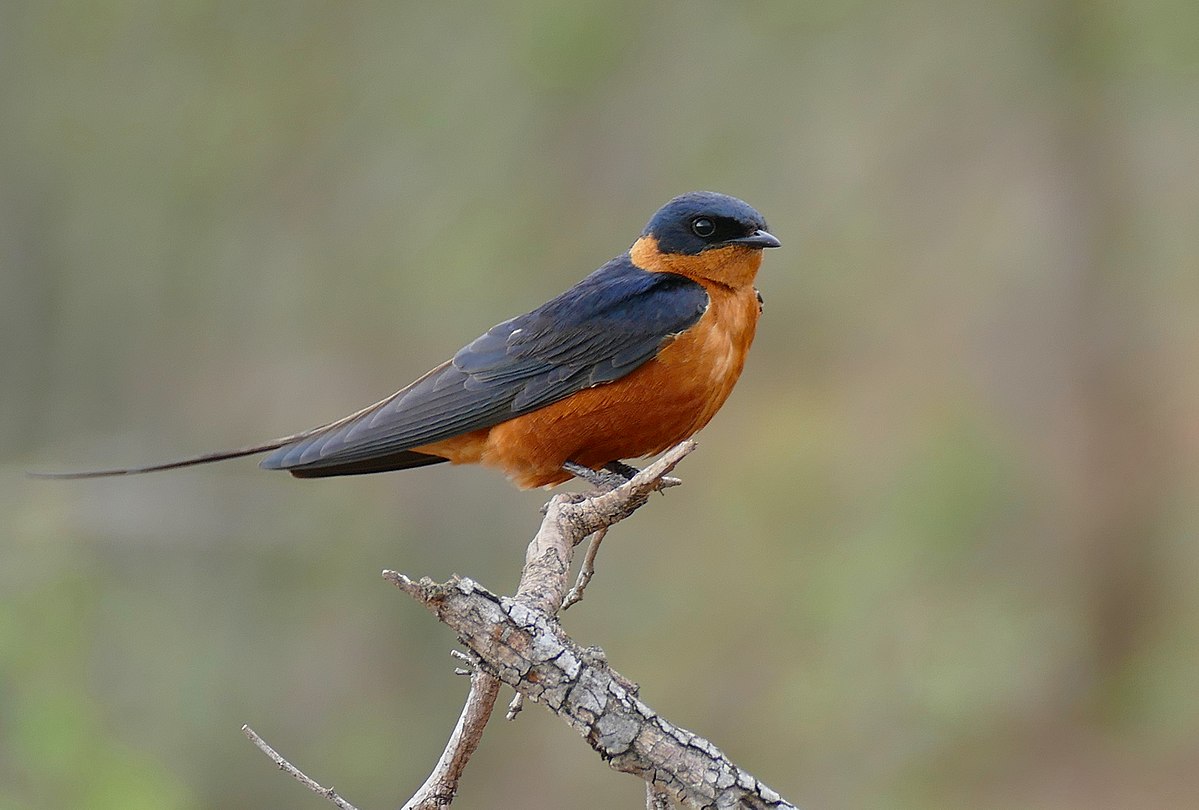
Wikipedia: Rufous-chested swallow Quelle: OTHER
1200px-Red-breasted_Swallow_%28Hirundo_semirufa%29_%2830987147586%29.jpg
![]() The red-breasted swallow (Cecropis semirufa), also known as the rufous-chested swallow, is a member of the family Hirundinidae, found in Sub-Saharan Africa. It is confined to the tropical rainforest during the wet season.
[more]
The red-breasted swallow (Cecropis semirufa), also known as the rufous-chested swallow, is a member of the family Hirundinidae, found in Sub-Saharan Africa. It is confined to the tropical rainforest during the wet season.
[more]
Profil Wikipedia eBird Xeno-Canto
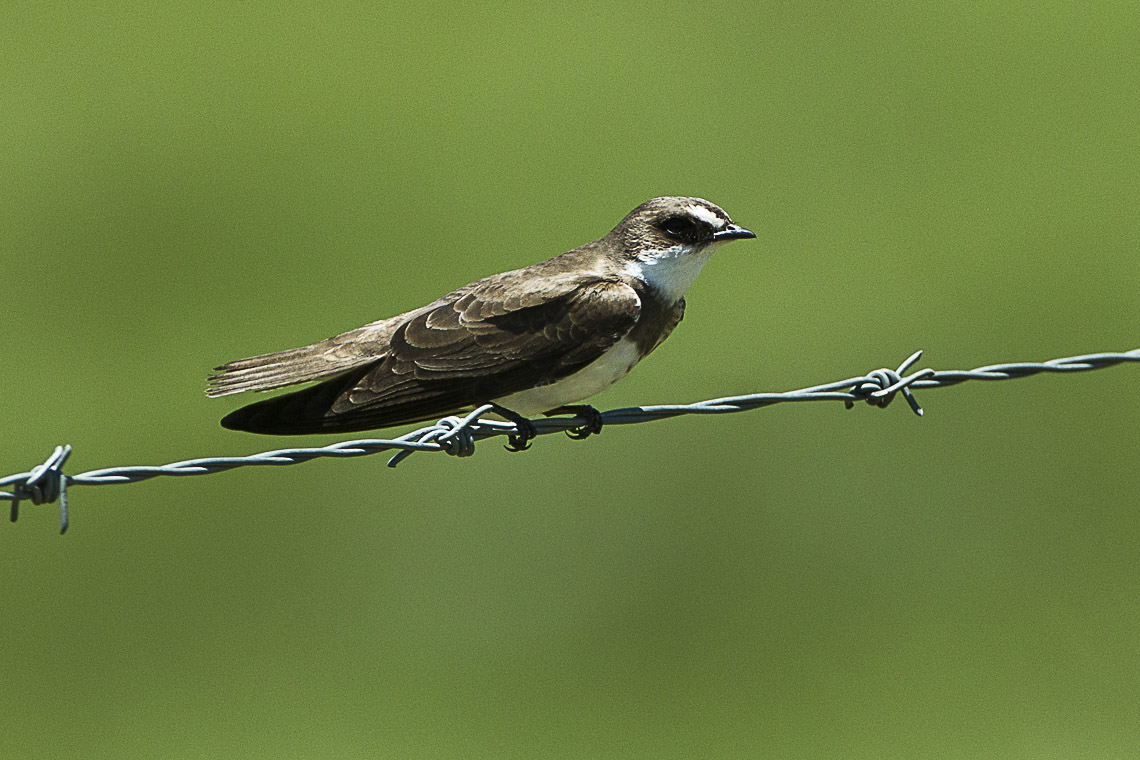
Wikipedia: Banded martin Quelle: OTHER
Banded_Martin_-_Natal_-_South_Africa_S4E6413_%2816792206620%29.jpg
![]() The banded martin or banded sand martin (Riparia cincta) is a small passerine bird in the swallow family Hirundinidae that is endemic to Africa.
[more]
The banded martin or banded sand martin (Riparia cincta) is a small passerine bird in the swallow family Hirundinidae that is endemic to Africa.
[more]
Profil Wikipedia eBird Xeno-Canto

Wikipedia: Black sawwing Quelle: OTHER
Black_Saw-wing.jpg
![]() The black saw-wing (Psalidoprocne pristoptera), also known as the blue saw-wing or black rough-winged swallow, is a small passerine bird in the swallow family.
[more]
The black saw-wing (Psalidoprocne pristoptera), also known as the blue saw-wing or black rough-winged swallow, is a small passerine bird in the swallow family.
[more]

Wikipedia: South African swallow Quelle: OTHER
1200px-South_African_cliff_swallow%2C_Petrochelidon_spilodera%2C_at_Suikerbosrand_Nature_Reserve%2C_Gauteng%2C_South_Africa_%2822747098474%29.jpg
![]() The South African cliff swallow (Petrochelidon spilodera), also known as the South African swallow, is a species of bird in the family Hirundinidae native to central−western and southern Africa.
[more]
The South African cliff swallow (Petrochelidon spilodera), also known as the South African swallow, is a species of bird in the family Hirundinidae native to central−western and southern Africa.
[more]
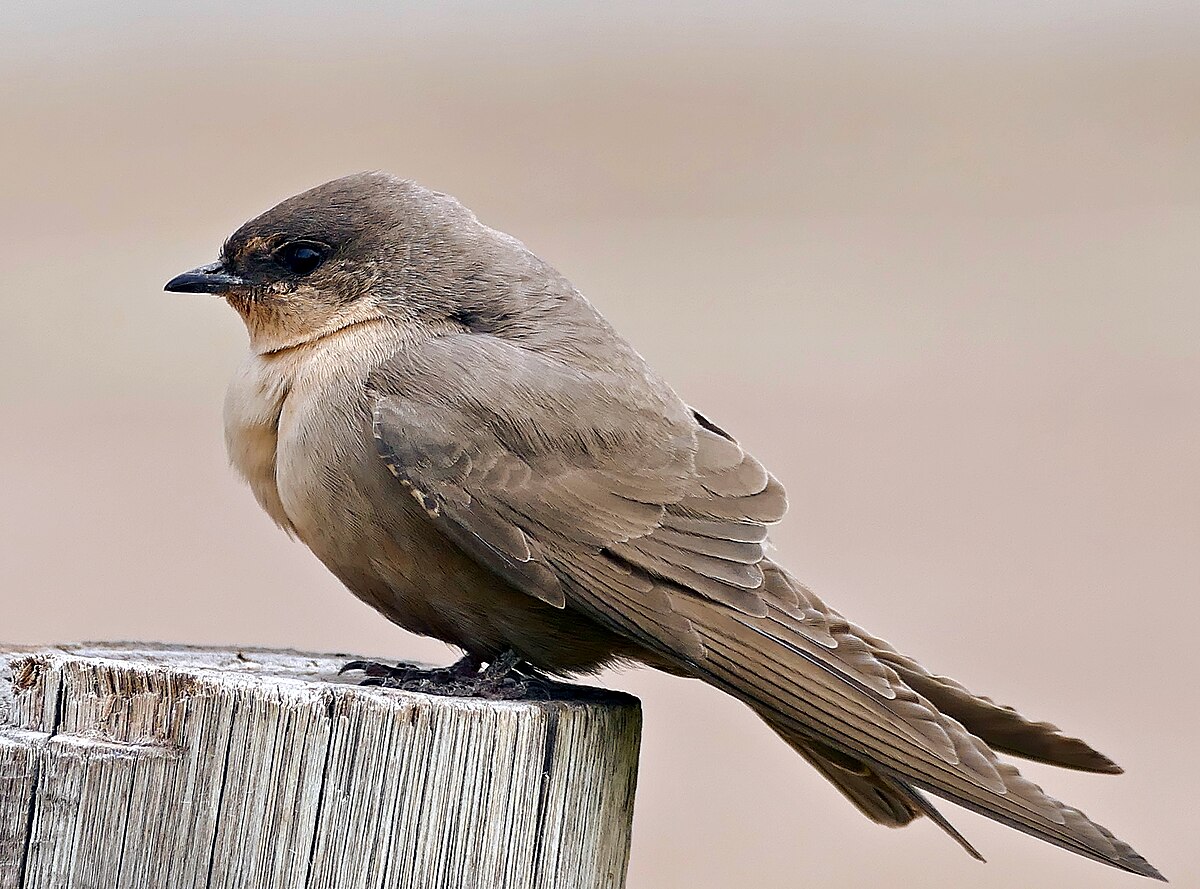
Wikipedia: Rock martin Quelle: OTHER
1200px-Rock_Martin_%28Hirundo_fuligula%29_%2832682255041%29.jpg
![]() The rock martin (Ptyonoprogne fuligula) is a small passerine bird in the swallow family that is resident in central and southern Africa. It breeds mainly in the mountains, but also at lower altitudes, especially in rocky areas and around towns, and, unlike most swallows, it is often found far from water. It is 12–15 cm (4.7–5.9 in) long, with mainly brown plumage, paler-toned on the upper breast and underwing coverts, and with white "windows" on the spread tail in flight. The sexes are similar in appearance, but juveniles have pale fringes to the upperparts and flight feathers. The former northern subspecies are smaller, paler, and whiter-throated than southern African forms, and are now usually split as a separate species, the pale crag martin. The rock martin hunts along cliff faces for flying insects using a slow flight with much gliding. Its call is a soft twitter.
[more]
The rock martin (Ptyonoprogne fuligula) is a small passerine bird in the swallow family that is resident in central and southern Africa. It breeds mainly in the mountains, but also at lower altitudes, especially in rocky areas and around towns, and, unlike most swallows, it is often found far from water. It is 12–15 cm (4.7–5.9 in) long, with mainly brown plumage, paler-toned on the upper breast and underwing coverts, and with white "windows" on the spread tail in flight. The sexes are similar in appearance, but juveniles have pale fringes to the upperparts and flight feathers. The former northern subspecies are smaller, paler, and whiter-throated than southern African forms, and are now usually split as a separate species, the pale crag martin. The rock martin hunts along cliff faces for flying insects using a slow flight with much gliding. Its call is a soft twitter.
[more]

Wikipedia: Grey-rumped swallow Quelle: OTHER
1200px-Pseudhirundo_griseopyga_Sharpe.jpg
![]() The grey-rumped swallow (Pseudhirundo griseopyga) is a species of bird in the monotypic genus, Pseudhirundo, in the family Hirundinidae.
[more]
The grey-rumped swallow (Pseudhirundo griseopyga) is a species of bird in the monotypic genus, Pseudhirundo, in the family Hirundinidae.
[more]
Profil Wikipedia eBird Xeno-Canto

Wikipedia: Short-clawed lark Quelle: OTHER
1200px-Certhilauda_chuana%2C_Pietersburg%2C_Kellermann%2C_a.jpg
![]() The short-clawed lark (Certhilauda chuana) or short-clawed bush-lark, is a species of lark in the family Alaudidae. It is found in Botswana and South Africa. Its natural habitat is dry savannah.
[more]
The short-clawed lark (Certhilauda chuana) or short-clawed bush-lark, is a species of lark in the family Alaudidae. It is found in Botswana and South Africa. Its natural habitat is dry savannah.
[more]
Profil Wikipedia eBird Xeno-Canto

Wikipedia: Cape lark Quelle: OTHER
1200px-Certhilauda_curvirostris_1838.jpg
![]() Die Langschnabellerche (Certhilauda curvirostris), auch Kap-Langschnabellerche genannt, ist eine Art aus der Familie der Lerchen. Sie ist eine im Süden des afrikanischen Kontinents verbreitete Art und dort die größte Lerchenart.[1] Sie ist größer als eine Feldlerche, von drosselähnlicher Gestalt und weist einen langen, gebogenen Schnabel auf.[1] Man unterscheidet mehrere Unterarten.[2]
[more]
Die Langschnabellerche (Certhilauda curvirostris), auch Kap-Langschnabellerche genannt, ist eine Art aus der Familie der Lerchen. Sie ist eine im Süden des afrikanischen Kontinents verbreitete Art und dort die größte Lerchenart.[1] Sie ist größer als eine Feldlerche, von drosselähnlicher Gestalt und weist einen langen, gebogenen Schnabel auf.[1] Man unterscheidet mehrere Unterarten.[2]
[more]
Profil Wikipedia eBird Xeno-Canto

Wikipedia: Agulhas lark Quelle: OTHER
Agulhas_Long-billed_Lark_%28Certhilauda_brevirostris%29_perched.jpg
![]() The Agulhas long-billed lark (Certhilauda brevirostris), also known as the Agulhas lark or Agulhas longbill is a small passerine bird. It is an endemic resident breeder in the Western Cape, South Africa. Its restricted range is centred on the Agulhas arable farmlands, from east of the Hottentots-Holland mountain range to Mossel Bay, and occupies a maximum of 15,000 km².
[more]
The Agulhas long-billed lark (Certhilauda brevirostris), also known as the Agulhas lark or Agulhas longbill is a small passerine bird. It is an endemic resident breeder in the Western Cape, South Africa. Its restricted range is centred on the Agulhas arable farmlands, from east of the Hottentots-Holland mountain range to Mossel Bay, and occupies a maximum of 15,000 km².
[more]
Profil Wikipedia eBird Xeno-Canto

Wikipedia: Eastern long-billed lark Quelle: OTHER
1200px-Eastern_Long-billed_Lark_%28Certhilauda_semitorquata%29_calling.jpg
![]() The eastern long-billed lark (Certhilauda semitorquata), also known as the Kaffrarian long-billed lark or Eastern longbill is a species of lark in the family Alaudidae. It is found in south-eastern Africa. Its natural habitat is subtropical or tropical dry lowland grassland.
[more]
The eastern long-billed lark (Certhilauda semitorquata), also known as the Kaffrarian long-billed lark or Eastern longbill is a species of lark in the family Alaudidae. It is found in south-eastern Africa. Its natural habitat is subtropical or tropical dry lowland grassland.
[more]
Profil Wikipedia eBird Xeno-Canto

Wikipedia: Karoo long-billed lark Quelle: OTHER
1200px-Karoo_Long-billed_Lark_%28Certhilauda_subcoronata%29_%2831737723963%29.jpg
![]() The Karoo long-billed lark (Certhilauda subcoronata) or Karoo longbill is a species of lark in the family Alaudidae. It is found in southern Africa in its natural habitat of subtropical or tropical dry shrubland.
[more]
The Karoo long-billed lark (Certhilauda subcoronata) or Karoo longbill is a species of lark in the family Alaudidae. It is found in southern Africa in its natural habitat of subtropical or tropical dry shrubland.
[more]
Profil Wikipedia eBird Xeno-Canto

Wikipedia: Black-eared sparrow-lark Quelle: OTHER
Eremopterix_australis_-Bushmanland%2C_South_Africa-8.jpg
![]() The black-eared sparrow-lark (Eremopterix australis) or black-eared finch lark is a species of lark in the family Alaudidae. It is found in southern Botswana, Namibia, and South Africa. Its natural habitats are subtropical or tropical dry shrubland and subtropical or tropical dry lowland grassland.
[more]
The black-eared sparrow-lark (Eremopterix australis) or black-eared finch lark is a species of lark in the family Alaudidae. It is found in southern Botswana, Namibia, and South Africa. Its natural habitats are subtropical or tropical dry shrubland and subtropical or tropical dry lowland grassland.
[more]
Profil Wikipedia eBird Xeno-Canto

Wikipedia: Chestnut-backed sparrow-lark Quelle: OTHER
1200px-Chestnut-backed_sparrow-lark_%28Eremopterix_leucotis_melanocephalus%29_male.jpg
![]() Die Weißwangenlerche (Eremopterix leucotis) ist eine Art aus der Familie der Lerchen. Es handelt sich um eine kleine, finkenähnliche Lerche, die einen dicken kurzen Schnabel hat und auf der Körperoberseite überwiegend kastanienbraun ist. Verglichen zur Feldlerche ist sie um etwa 25 bis 30 Zentimeter kleiner. Ihr Verbreitungsgebiet liegt in Afrika.[1] Es werden fünf Unterarten unterschieden.[2]
[more]
Die Weißwangenlerche (Eremopterix leucotis) ist eine Art aus der Familie der Lerchen. Es handelt sich um eine kleine, finkenähnliche Lerche, die einen dicken kurzen Schnabel hat und auf der Körperoberseite überwiegend kastanienbraun ist. Verglichen zur Feldlerche ist sie um etwa 25 bis 30 Zentimeter kleiner. Ihr Verbreitungsgebiet liegt in Afrika.[1] Es werden fünf Unterarten unterschieden.[2]
[more]

Wikipedia: Grey-backed sparrow-lark Quelle: OTHER
Eremopterix_verticalis_-Northern_Cape%2C_South_Africa_-male-8.jpg
![]() Die Nonnenlerche (Eremopterix verticalis), gelegentlich auch Graurückenlerche genannt, ist eine sehr kleine schwarzgraue und finkenähnliche Art aus der Familie der Lerchen. Ihr Verbreitungsgebiet ist der Süden Afrikas. Es werden vier Unterarten unterschieden.[1]
[more]
Die Nonnenlerche (Eremopterix verticalis), gelegentlich auch Graurückenlerche genannt, ist eine sehr kleine schwarzgraue und finkenähnliche Art aus der Familie der Lerchen. Ihr Verbreitungsgebiet ist der Süden Afrikas. Es werden vier Unterarten unterschieden.[1]
[more]
Profil Wikipedia eBird Xeno-Canto

Wikipedia: Large-billed lark Quelle: OTHER
Galerida_magnirostris_magnirostris%2C_De_Hoop-natuurreservaat%2C_Birding_Weto%2C_a.jpg
![]() The large-billed lark or southern thick-billed lark (Galerida magnirostris) is a small passerine bird found in southern Africa. The name "large-billed lark" may also refer to Bradfield's lark. The name "thick-billed lark" more commonly refers to the species of the same name (i.e. Rhamphocoris clotbey).
[more]
The large-billed lark or southern thick-billed lark (Galerida magnirostris) is a small passerine bird found in southern Africa. The name "large-billed lark" may also refer to Bradfield's lark. The name "thick-billed lark" more commonly refers to the species of the same name (i.e. Rhamphocoris clotbey).
[more]

Wikipedia: Red-capped lark Quelle: OTHER
1200px-Red-capped_lark%2C_Calandrella_cinerea%2C_at_Mapungubwe_National_Park%2C_Limpopo%2C_South_Africa_%2823514690044%29.jpg
![]() Die Rotscheitellerche (Calandrella cinerea), auch Rotkappenlerche genannt, ist ein 14 Zentimeter großer Vertreter der Familie der Lerchen.
[more]
Die Rotscheitellerche (Calandrella cinerea), auch Rotkappenlerche genannt, ist ein 14 Zentimeter großer Vertreter der Familie der Lerchen.
[more]
Profil Wikipedia eBird Xeno-Canto

Wikipedia: Cape clapper lark Quelle: OTHER
Mirafra_apiata_-Namaqua_National_Park%2C_South_Africa-8.jpg
![]() Die Grasklapperlerche (Mirafra apiata) ist eine Art aus der Familie der Lerchen. Sie ist eine im Süden des afrikanischen Kontinents verbreitete Art. Sie ist deutlich kleiner als eine Feldlerche, hat aber einen etwas kräftigeren Schnabel. Man unterscheidet mehrere Unterarten.[1] Der Name leitet sich von den rasselnden und klappernden Instrumentallauten ab, die die Lerche mit den Flügeln erzeugt.
[more]
Die Grasklapperlerche (Mirafra apiata) ist eine Art aus der Familie der Lerchen. Sie ist eine im Süden des afrikanischen Kontinents verbreitete Art. Sie ist deutlich kleiner als eine Feldlerche, hat aber einen etwas kräftigeren Schnabel. Man unterscheidet mehrere Unterarten.[1] Der Name leitet sich von den rasselnden und klappernden Instrumentallauten ab, die die Lerche mit den Flügeln erzeugt.
[more]
Profil Wikipedia eBird Xeno-Canto

Wikipedia: Flappet lark Quelle: OTHER
1200px-Flappet_Lark%2C_Sakania%2C_DR_Congo_%2816025285505%29%2C_crop.jpg
![]() Die Baumklapperlerche (Mirafra rufocinnamomea) ist eine Art aus der Familie der Lerchen. Sie ist eine auf dem afrikanischen Kontinent weit verbreitete Art. Sie ist deutlich kleiner als eine Feldlerche, hat aber einen etwas kräftigeren Schnabel. Man unterscheidet 15 verschiedene Unterarten.[1] Der Name leitet sich von den rasselnden und klappernden Instrumentallauten ab, die die Lerche mit den Flügeln erzeugt.
[more]
Die Baumklapperlerche (Mirafra rufocinnamomea) ist eine Art aus der Familie der Lerchen. Sie ist eine auf dem afrikanischen Kontinent weit verbreitete Art. Sie ist deutlich kleiner als eine Feldlerche, hat aber einen etwas kräftigeren Schnabel. Man unterscheidet 15 verschiedene Unterarten.[1] Der Name leitet sich von den rasselnden und klappernden Instrumentallauten ab, die die Lerche mit den Flügeln erzeugt.
[more]
Profil Wikipedia eBird Xeno-Canto

Wikipedia: Eastern clapper lark Quelle: OTHER
Eastern_clapper_lark_%28Mirafra_fasciolata_subsp_fasciolata%29%2C_crop.jpg
![]() Die Ostklapperlerche (Mirafra fasciolata) ist eine Art aus der Familie der Lerchen. Sie ist eine im Süden des afrikanischen Kontinents verbreitete Art. Sie ist deutlich kleiner als eine Feldlerche, hat aber einen etwas kräftigeren Schnabel. Man unterscheidet mehrere Unterarten.[1] Der Name leitet sich von den rasselnden und klappernden Instrumentallauten ab, die die Lerche mit den Flügeln erzeugt.
[more]
Die Ostklapperlerche (Mirafra fasciolata) ist eine Art aus der Familie der Lerchen. Sie ist eine im Süden des afrikanischen Kontinents verbreitete Art. Sie ist deutlich kleiner als eine Feldlerche, hat aber einen etwas kräftigeren Schnabel. Man unterscheidet mehrere Unterarten.[1] Der Name leitet sich von den rasselnden und klappernden Instrumentallauten ab, die die Lerche mit den Flügeln erzeugt.
[more]
Profil Wikipedia eBird Xeno-Canto

Wikipedia: Rufous-naped lark Quelle: OTHER
Mirafra_africana2.jpg
![]() Die Rotnackenlerche (Mirafra africana) ist eine Art aus der Familie der Lerchen. Ihr Verbreitungsgebiet liegt in Afrika, wo sie eine weitverbreitete und häufige Art ist. Sie ist eine kompakt gebaute, hochbeinige Lerche, die in ihrem Habitus an eine Haubenlerche erinnert. Man unterscheidet in dem großen Verbreitungsgebiet mehr als zwanzig verschiedene Unterarten.[1]
[more]
Die Rotnackenlerche (Mirafra africana) ist eine Art aus der Familie der Lerchen. Ihr Verbreitungsgebiet liegt in Afrika, wo sie eine weitverbreitete und häufige Art ist. Sie ist eine kompakt gebaute, hochbeinige Lerche, die in ihrem Habitus an eine Haubenlerche erinnert. Man unterscheidet in dem großen Verbreitungsgebiet mehr als zwanzig verschiedene Unterarten.[1]
[more]
Profil Wikipedia eBird Xeno-Canto

Wikipedia: Monotonous lark Quelle: OTHER
1200px-Mirafra_passerina.jpg
![]() Die Sperlingslerche (Mirafra passerina) ist eine Art aus der Familie der Lerchen. Ihr Verbreitungsgebiet liegt in Afrika. Man unterscheidet keine Unterarten.[1]
[more]
Die Sperlingslerche (Mirafra passerina) ist eine Art aus der Familie der Lerchen. Ihr Verbreitungsgebiet liegt in Afrika. Man unterscheidet keine Unterarten.[1]
[more]
Profil Wikipedia eBird Xeno-Canto

Wikipedia: Latakoo lark Quelle: OTHER
1200px-Mirafra_cheniana_cheniana_1838.jpg
![]() Die Spottlerche (Mirafra cheniana) ist eine Art aus der Familie der Lerchen. Ihr Verbreitungsgebiet liegt im südöstlichen Afrika. Man unterscheidet keine Unterarten.[1] Sie zählt zu den Lerchenarten, die mit ihrem Gesang die Stimmen zahlreicher anderer Vogelarten nachahmen.
[more]
Die Spottlerche (Mirafra cheniana) ist eine Art aus der Familie der Lerchen. Ihr Verbreitungsgebiet liegt im südöstlichen Afrika. Man unterscheidet keine Unterarten.[1] Sie zählt zu den Lerchenarten, die mit ihrem Gesang die Stimmen zahlreicher anderer Vogelarten nachahmen.
[more]
Profil Wikipedia eBird Xeno-Canto

Wikipedia: Pink-billed lark Quelle: OTHER
Pink-billed_Lark_%28Spizocorys_conirostris%29_%288077320401%29.jpg
![]() The pink-billed lark (Spizocorys conirostris) is a species of lark in the family Alaudidae found in southern Africa.
Its natural habitat is subtropical or tropical dry lowland grassland.
[more]
The pink-billed lark (Spizocorys conirostris) is a species of lark in the family Alaudidae found in southern Africa.
Its natural habitat is subtropical or tropical dry lowland grassland.
[more]
Profil Wikipedia eBird Xeno-Canto

Wikipedia: Stark's lark Quelle: OTHER
1200px-Stark%27s_Lark_001.jpg
![]() Die Falblerche (Spizocorys starki) ist eine kleine Art aus der Familie der Lerchen mit einem finkenähnlichen Schnabel und einer kleinen Federhaube. Ihr Verbreitungsgebiet ist der Süden Afrikas. Es werden keine Unterarten unterschieden.[1]
[more]
Die Falblerche (Spizocorys starki) ist eine kleine Art aus der Familie der Lerchen mit einem finkenähnlichen Schnabel und einer kleinen Federhaube. Ihr Verbreitungsgebiet ist der Süden Afrikas. Es werden keine Unterarten unterschieden.[1]
[more]
Profil Wikipedia eBird Xeno-Canto

Wikipedia: Sclater's lark Quelle: OTHER
1200px-Botha_Calandrella_Gronvold.jpg
![]() Die Ammernlerche (Spizocorys sclateri) ist eine kleine Vogelart aus der Familie der Lerchen. Ihr Verbreitungsgebiet ist der Süden Afrikas. Es werden keine Unterarten unterschieden.[1] Das Artepitheton sclateri ehrt den britischen Zoologen William Lutley Sclater.[2][A 1]
[more]
Die Ammernlerche (Spizocorys sclateri) ist eine kleine Vogelart aus der Familie der Lerchen. Ihr Verbreitungsgebiet ist der Süden Afrikas. Es werden keine Unterarten unterschieden.[1] Das Artepitheton sclateri ehrt den britischen Zoologen William Lutley Sclater.[2][A 1]
[more]

Wikipedia: Botha's lark Quelle: OTHER
1200px-Spizocorys_fringillaris_and_Mirafra_fasciolata_damarensis_1875_%28cropped%29.jpg
![]() Die Finkenlerche (Spizocorys fringillaris) ist eine kleine Art aus der Familie der Lerchen mit einem finkenähnlichen Schnabel. Es ist eine kompakt gebaute Lerche mit einer auffälligen Strichelung auf der Körperoberseite.[1] Ihr vergleichsweise kleines Verbreitungsgebiet liegt Süden Afrikas. Es werden keine Unterarten unterschieden.[2]
[more]
Die Finkenlerche (Spizocorys fringillaris) ist eine kleine Art aus der Familie der Lerchen mit einem finkenähnlichen Schnabel. Es ist eine kompakt gebaute Lerche mit einer auffälligen Strichelung auf der Körperoberseite.[1] Ihr vergleichsweise kleines Verbreitungsgebiet liegt Süden Afrikas. Es werden keine Unterarten unterschieden.[2]
[more]

Wikipedia: Spike-heeled lark Quelle: OTHER
1200px-Chersomanes_albofasciata_%28Etosha%29.jpg
![]() Die Zirplerche (Chersomanes albofasciata) ist eine hochbeinige und kurzschwänzige kleine Art aus der Familie der Lerchen, die zwischen 15 und 20 Prozent kleiner als eine Feldlerche ist. Ihr Verbreitungsgebiet ist der Süden Afrikas. Es werden mehrere Unterarten unterschieden.[1]
[more]
Die Zirplerche (Chersomanes albofasciata) ist eine hochbeinige und kurzschwänzige kleine Art aus der Familie der Lerchen, die zwischen 15 und 20 Prozent kleiner als eine Feldlerche ist. Ihr Verbreitungsgebiet ist der Süden Afrikas. Es werden mehrere Unterarten unterschieden.[1]
[more]

Wikipedia: Fawn-colored lark Quelle: OTHER
1200px-Fawn-coloured_lark_%28Calendulauda_africanoides_africanoides%29_2.jpg
![]() Die Steppenlerche (Calendulauda africanoides, Syn.: Mirafra africanoides) ist eine Art aus der Familie der Lerchen. Sie ist eine im Süden und Osten des afrikanischen Kontinents verbreitete Art. Sie ist deutlich kleiner als eine Feldlerche, hat aber einen etwas kräftigeren Schnabel. Man unterscheidet mehrere Unterarten.[1]
[more]
Die Steppenlerche (Calendulauda africanoides, Syn.: Mirafra africanoides) ist eine Art aus der Familie der Lerchen. Sie ist eine im Süden und Osten des afrikanischen Kontinents verbreitete Art. Sie ist deutlich kleiner als eine Feldlerche, hat aber einen etwas kräftigeren Schnabel. Man unterscheidet mehrere Unterarten.[1]
[more]

Wikipedia: Barlow's lark Quelle: OTHER
Calendulauda_barlowi_distribution_map.png
![]() Barlow's lark (Calendulauda barlowi) is a species of lark in the family Alaudidae. It is found in Namibia and South Africa where its natural habitat is subtropical or tropical dry shrubland. It is threatened by habitat loss.
[more]
Barlow's lark (Calendulauda barlowi) is a species of lark in the family Alaudidae. It is found in Namibia and South Africa where its natural habitat is subtropical or tropical dry shrubland. It is threatened by habitat loss.
[more]

Wikipedia: Sabota lark Quelle: OTHER
1200px-Sabota_Lark_%28Calendulauda_sabota%29_%2811421288184%29.jpg
![]() Die Sabotalerche (Calendulauda sabota) ist eine Art aus der Familie der Lerchen. Sie ist eine im Süden des afrikanischen Kontinents verbreitete Art. Sie ist deutlich kleiner als eine Feldlerche und erinnert im Habitus an eine Heidelerche. Man unterscheidet mehrere Unterarten.[1]
[more]
Die Sabotalerche (Calendulauda sabota) ist eine Art aus der Familie der Lerchen. Sie ist eine im Süden des afrikanischen Kontinents verbreitete Art. Sie ist deutlich kleiner als eine Feldlerche und erinnert im Habitus an eine Heidelerche. Man unterscheidet mehrere Unterarten.[1]
[more]

Wikipedia: Karoo lark Quelle: OTHER
Calendulauda_albescens.jpg
![]() Die Karoolerche (Calendulauda albescens), auch Karrulerche genannt, ist eine Art aus der Familie der Lerchen. Sie ist eine im Süden des afrikanischen Kontinents verbreitete Art. Sie ist ungefähr so groß wie eine Feldlerche, hat aber einen deutlich längeren Schnabel. Man unterscheidet mehrere Unterarten.[1] Der Name leitet sich von der Karoo ab, einer Halbwüstenlandschaft in den Hochebenen Südafrikas, nördlich der Großen Randstufe und im südlichen Namibia.
[more]
Die Karoolerche (Calendulauda albescens), auch Karrulerche genannt, ist eine Art aus der Familie der Lerchen. Sie ist eine im Süden des afrikanischen Kontinents verbreitete Art. Sie ist ungefähr so groß wie eine Feldlerche, hat aber einen deutlich längeren Schnabel. Man unterscheidet mehrere Unterarten.[1] Der Name leitet sich von der Karoo ab, einer Halbwüstenlandschaft in den Hochebenen Südafrikas, nördlich der Großen Randstufe und im südlichen Namibia.
[more]

Wikipedia: Red lark Quelle: OTHER
Certhilauda_burra_-near_Springbok%2C_Northern_Cape%2C_South_Africa-6.jpg
![]() Die Oranjelerche (Calendulauda burra) ist eine Vogelart der Gattung Calendulauda in der Familie der Lerchen (Alaudidae) und ist im Süden des afrikanischen Kontinents verbreitete.
[more]
Die Oranjelerche (Calendulauda burra) ist eine Vogelart der Gattung Calendulauda in der Familie der Lerchen (Alaudidae) und ist im Süden des afrikanischen Kontinents verbreitete.
[more]

Wikipedia: Rudd's lark Quelle: OTHER
Heteromirafra_ruddi%2C_Wakkerstroom%2C_Birding_Weto%2C_a.jpg
![]() Die Transvaalspornlerche (Heteromirafra ruddi) ist eine Art aus der Familie der Lerchen. Es ist eine kleine und kurzschwänzige Lerche, die eine auffällig verlängerte Hinterkralle besitzt. Ihr Verbreitungsgebiet ist verglichen mit zahlreichen anderen Arten klein und liegt im südlichen Afrika.
[more]
Die Transvaalspornlerche (Heteromirafra ruddi) ist eine Art aus der Familie der Lerchen. Es ist eine kleine und kurzschwänzige Lerche, die eine auffällig verlängerte Hinterkralle besitzt. Ihr Verbreitungsgebiet ist verglichen mit zahlreichen anderen Arten klein und liegt im südlichen Afrika.
[more]

Wikipedia: Dusky lark Quelle: OTHER
1200px-Dusky_Lark_%28Pinarocorys_nigricans%29_%286029254985%29_%28cropped%29.jpg
![]() Die Drossellerche (Pinarocorys nigricans) ist eine Art aus der Familie der Lerchen. Sie entspricht in ihrer Größe der Feldlerche und erinnert in ihrer Färbung an eine Singdrossel. Das Verbreitungsgebiet der Drossellerche liegt im Süden Afrikas.[1] Es werden zwei Unterarten unterschieden.
[more]
Die Drossellerche (Pinarocorys nigricans) ist eine Art aus der Familie der Lerchen. Sie entspricht in ihrer Größe der Feldlerche und erinnert in ihrer Färbung an eine Singdrossel. Das Verbreitungsgebiet der Drossellerche liegt im Süden Afrikas.[1] Es werden zwei Unterarten unterschieden.
[more]

Wikipedia: Piping cisticola Quelle: OTHER
1200px-Neddicky%2C_or_piping_cisticola%2C_Cisticola_fulvicapilla_at_Pilanesberg_National_Park%2C_Northwest_Province%2C_South_Africa_%2817454443855%29.jpg
![]() The neddicky, or piping cisticola (Cisticola fulvicapilla), is a small passerine bird in the family Cisticolidae, which is native to Africa, southwards of the equator. Its strongholds are the light woodlands and shrublands of the subtropics and temperate regions of southern Africa. The common name, neddicky, is the Afrikaans name for the species.
[more]
The neddicky, or piping cisticola (Cisticola fulvicapilla), is a small passerine bird in the family Cisticolidae, which is native to Africa, southwards of the equator. Its strongholds are the light woodlands and shrublands of the subtropics and temperate regions of southern Africa. The common name, neddicky, is the Afrikaans name for the species.
[more]
Profil Wikipedia eBird Xeno-Canto

Wikipedia: Red-faced cisticola Quelle: OTHER
Red-faced_Cisticola_%28Cisticola_erythrops%29.jpg
![]() The red-faced cisticola (Cisticola erythrops) is a species of bird in the family Cisticolidae. It is widely present across Sub-Saharan Africa (rare in southern Africa). Its natural habitats are subtropical or tropical seasonally wet or flooded lowland grassland and swamps.
[more]
The red-faced cisticola (Cisticola erythrops) is a species of bird in the family Cisticolidae. It is widely present across Sub-Saharan Africa (rare in southern Africa). Its natural habitats are subtropical or tropical seasonally wet or flooded lowland grassland and swamps.
[more]
Profil Wikipedia eBird Xeno-Canto

Wikipedia: Croaking cisticola Quelle: OTHER
1200px-Croaking_cisticola_%28Cisticola_natalensis%29.jpg
![]() The croaking cisticola (Cisticola natalensis) is an Old World warbler in the genus Cisticola. This genus is sometimes split off with various other southern warbler genera and given family status as the Cisticolidae.
[more]
The croaking cisticola (Cisticola natalensis) is an Old World warbler in the genus Cisticola. This genus is sometimes split off with various other southern warbler genera and given family status as the Cisticolidae.
[more]
Profil Wikipedia eBird Xeno-Canto

Wikipedia: Desert cisticola Quelle: OTHER
Desert_Cisticola_%28Cisticola_aridulus%29.jpg
![]() The desert cisticola (Cisticola aridulus) is a species of bird in the family Cisticolidae.
It is present throughout much of Sub-Saharan Africa, although relatively absent from central and coastal western areas of the continent.
[more]
The desert cisticola (Cisticola aridulus) is a species of bird in the family Cisticolidae.
It is present throughout much of Sub-Saharan Africa, although relatively absent from central and coastal western areas of the continent.
[more]

Wikipedia: Levaillant's cisticola Quelle: OTHER
Levaillant%27s_Cisticola_Cisticola_tinniens.jpg
![]() Levaillant's cisticola (Cisticola tinniens), also known as the tinkling cisticola, is a small passerine bird which is native to marshlands in the uplands of Africa, southwards of the equator.
[more]
Levaillant's cisticola (Cisticola tinniens), also known as the tinkling cisticola, is a small passerine bird which is native to marshlands in the uplands of Africa, southwards of the equator.
[more]
Profil Wikipedia eBird Xeno-Canto
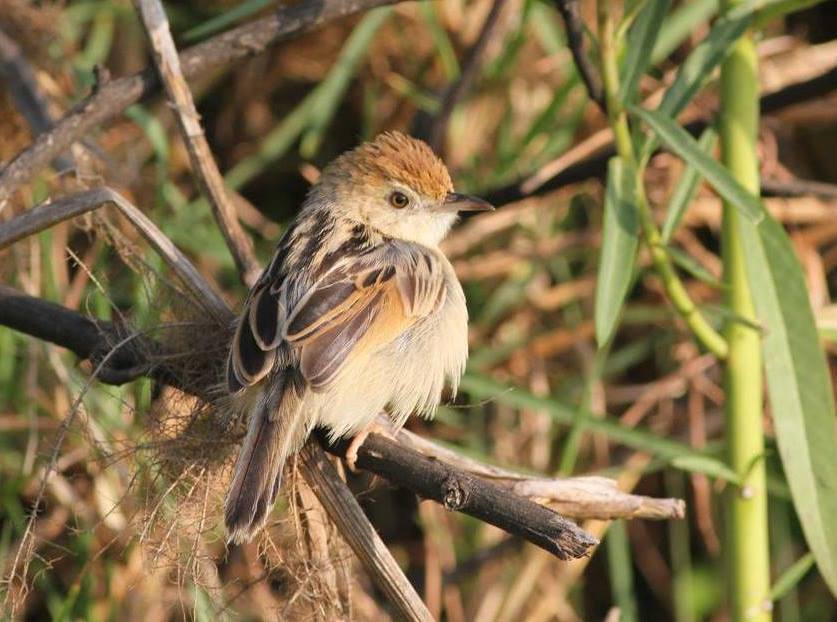
Wikipedia: Rufous-winged cisticola Quelle: OTHER
Cisticola_galactotes_subsp_isodactylus%2C_Pungwe-vloedvlakte%2C_Birding_Weto%2C_a.jpg
![]() The rufous-winged cisticola (Cisticola galactotes) is a species of bird in the family Cisticolidae. It is found on the east coast of southern Africa.[1][2]
[more]
The rufous-winged cisticola (Cisticola galactotes) is a species of bird in the family Cisticolidae. It is found on the east coast of southern Africa.[1][2]
[more]
Profil Wikipedia eBird Xeno-Canto

Wikipedia: Wailing cisticola Quelle: OTHER
Cisticola_lais_-Cedara%2C_KwaZulu-Natal%2C_South_Africa-8.jpg
![]() The wailing cisticola (Cisticola lais) is a species of bird in the family Cisticolidae. It is found in Angola, Lesotho, Malawi, Mozambique, South Africa, Swaziland, Tanzania, Zambia, and Zimbabwe. Its natural habitat is subtropical or tropical high-altitude grassland.
[more]
The wailing cisticola (Cisticola lais) is a species of bird in the family Cisticolidae. It is found in Angola, Lesotho, Malawi, Mozambique, South Africa, Swaziland, Tanzania, Zambia, and Zimbabwe. Its natural habitat is subtropical or tropical high-altitude grassland.
[more]
Profil Wikipedia eBird Xeno-Canto BirdID NABU
Zistensaenger in der Luft in Albufera. 2022-04-12 15.03.34 Mallorca
Zuerst beobachtet in Mallorca an 2022-04-08.
![]() Der Zistensänger (Cisticola juncidis), auch Cistensänger geschrieben, ist eine Singvogelart aus der Familie der Halmsängerartigen. Den mit einer Länge von nur 10 Zentimetern auffallend kleinen Zistensänger erkennt man an dem abgestuften, schwärzlichen und am Ende hell gesäumten Schwanz, der oft breit gefächert wird. In der Brutzeit tragen die Männchen kräftige dunkle Flecken auf ihrem Rücken, während sie sonst, wie die Weibchen, eher undeutlich gestreift erscheinen. Die ledergelbe Unterseite ist beim Weibchen intensiver gefärbt. Stirn und Oberkopf sind auf lehmgelben Grund schwach dunkel gestreift, ein Überaugenstreif ist nur angedeutet. Die Beine sind dunkelbeige bis orangefarben.
[more]
Der Zistensänger (Cisticola juncidis), auch Cistensänger geschrieben, ist eine Singvogelart aus der Familie der Halmsängerartigen. Den mit einer Länge von nur 10 Zentimetern auffallend kleinen Zistensänger erkennt man an dem abgestuften, schwärzlichen und am Ende hell gesäumten Schwanz, der oft breit gefächert wird. In der Brutzeit tragen die Männchen kräftige dunkle Flecken auf ihrem Rücken, während sie sonst, wie die Weibchen, eher undeutlich gestreift erscheinen. Die ledergelbe Unterseite ist beim Weibchen intensiver gefärbt. Stirn und Oberkopf sind auf lehmgelben Grund schwach dunkel gestreift, ein Überaugenstreif ist nur angedeutet. Die Beine sind dunkelbeige bis orangefarben.
[more]
Gesang: ![]() Male song a diagnostic, monosyllabic, high-pitched "cist", repeated in an even rhythm about once every second, while in bounding song-flight or perched. [Link]
Male song a diagnostic, monosyllabic, high-pitched "cist", repeated in an even rhythm about once every second, while in bounding song-flight or perched. [Link]
Rufe: ![]() Alarm call a short, clipping "witt", repeated in series. [Link]
Alarm call a short, clipping "witt", repeated in series. [Link]
Körperlich: Länge=10 cm,
Flügelspanne=12-14 cm,
Gewicht=8-12 g
Gesang:
Automatically generated from Xeno-Canto recording
Gesang Eigenschaften:
Frequency:
♫ Quelle: BirdNet
20220408_144327 birdnet - Zistensänger - Zistensänger.mp3
2022-04-08 14.43.27 Mallorca (Gesang)
Profil Wikipedia eBird Xeno-Canto

Wikipedia: Red-headed cisticola Quelle: OTHER
Cisticola_subruficapillus_-Namaqua_National_Park%2C_Northern_Cape%2C_South_Africa-6.jpg
Allgemein: ![]() The grey-backed cisticola or red-headed cisticola (Cisticola subruficapilla) is a small passerine bird. This cisticola is a resident breeder in southernmost Angola, Namibia and western South Africa.
[more]
The grey-backed cisticola or red-headed cisticola (Cisticola subruficapilla) is a small passerine bird. This cisticola is a resident breeder in southernmost Angola, Namibia and western South Africa.
[more]
Profil Wikipedia eBird Xeno-Canto

Wikipedia: Rock-loving cisticola Quelle: OTHER
Rock-loving_Cisticola_%28Cisticola_aberrans_minor%29.jpg
![]() The lazy cisticola (Cisticola aberrans) is a species of bird in the family Cisticolidae. It can be found mostly in Africa.
[more]
The lazy cisticola (Cisticola aberrans) is a species of bird in the family Cisticolidae. It can be found mostly in Africa.
[more]
Profil Wikipedia eBird Xeno-Canto

Wikipedia: Wing-snapping cisticola Quelle: OTHER
Wing-snapping_Cisticola_-_Kenya_S4E6079_%2817320718675%29.jpg
![]() The wing-snapping cisticola (Cisticola ayresii), also known as Ayres' cisticola, is a species of bird in the family Cisticolidae. Its scientific name honours South African ornithologist Thomas Ayres.
[more]
The wing-snapping cisticola (Cisticola ayresii), also known as Ayres' cisticola, is a species of bird in the family Cisticolidae. Its scientific name honours South African ornithologist Thomas Ayres.
[more]
Profil Wikipedia eBird Xeno-Canto

Wikipedia: Tinkling cisticola Quelle: OTHER
Hunter%27s_Cisticola_-_KenyaNH8O2433_%2816698263634%29.jpg
![]() The tinkling cisticola or grey cisticola (Cisticola rufilatus) is a species of bird in the family Cisticolidae. It is found in Angola, Botswana, Republic of the Congo, Democratic Republic of the Congo, Gabon, Malawi, Namibia, South Africa, Zambia, and Zimbabwe. Its natural habitat is dry savannah.
[more]
The tinkling cisticola or grey cisticola (Cisticola rufilatus) is a species of bird in the family Cisticolidae. It is found in Angola, Botswana, Republic of the Congo, Democratic Republic of the Congo, Gabon, Malawi, Namibia, South Africa, Zambia, and Zimbabwe. Its natural habitat is dry savannah.
[more]
Profil Wikipedia eBird Xeno-Canto

Wikipedia: Rattling cisticola Quelle: OTHER
Rattling_Cisticola_-_Kavango_-_Namibia0002_%2817320723895%29.jpg
![]() The rattling cisticola (Cisticola chiniana) is a species of bird in the family Cisticolidae which is native to Africa south of the equator, and parts of East Africa. It is a common to abundant species in open savanna and scrubland habitats, whether in arid, moist or upland regions. Especially during summer, it is highly conspicuous due to its strident and repetitive call-notes from prominent perches.[2]
[more]
The rattling cisticola (Cisticola chiniana) is a species of bird in the family Cisticolidae which is native to Africa south of the equator, and parts of East Africa. It is a common to abundant species in open savanna and scrubland habitats, whether in arid, moist or upland regions. Especially during summer, it is highly conspicuous due to its strident and repetitive call-notes from prominent perches.[2]
[more]
Profil Wikipedia eBird Xeno-Canto

Wikipedia: Pale-crowned cisticola Quelle: OTHER
Pale-crowned_Cisticola_%28Cisticola_cinnamomeus%29.jpg
![]() The pale-crowned cisticola (Cisticola cinnamomeus) is a species of bird in the family Cisticolidae.
[more]
The pale-crowned cisticola (Cisticola cinnamomeus) is a species of bird in the family Cisticolidae.
[more]
Profil Wikipedia eBird Xeno-Canto

Wikipedia: Cloud cisticola Quelle: OTHER
1200px-Cisticola_textrix_1838.jpg
![]() The cloud cisticola or tink-tink cisticola (Cisticola textrix) is a species of bird in the family Cisticolidae. It is found in Angola, Lesotho, Mozambique, South Africa, Swaziland, and Zambia, and its natural habitat is subtropical or tropical dry lowland grassland.
[more]
The cloud cisticola or tink-tink cisticola (Cisticola textrix) is a species of bird in the family Cisticolidae. It is found in Angola, Lesotho, Mozambique, South Africa, Swaziland, and Zambia, and its natural habitat is subtropical or tropical dry lowland grassland.
[more]
Profil Wikipedia eBird Xeno-Canto

Wikipedia: Drakensberg prinia Quelle: OTHER
Drakensberg_Prinia_-_South_Africa_S4E6311_%2817318861432%29.jpg
![]() The Drakensberg prinia or saffron-breasted prinia (Prinia hypoxantha) is a small passerine bird. It lives in eastern South Africa and Swaziland.
[more]
The Drakensberg prinia or saffron-breasted prinia (Prinia hypoxantha) is a small passerine bird. It lives in eastern South Africa and Swaziland.
[more]
Profil Wikipedia eBird Xeno-Canto
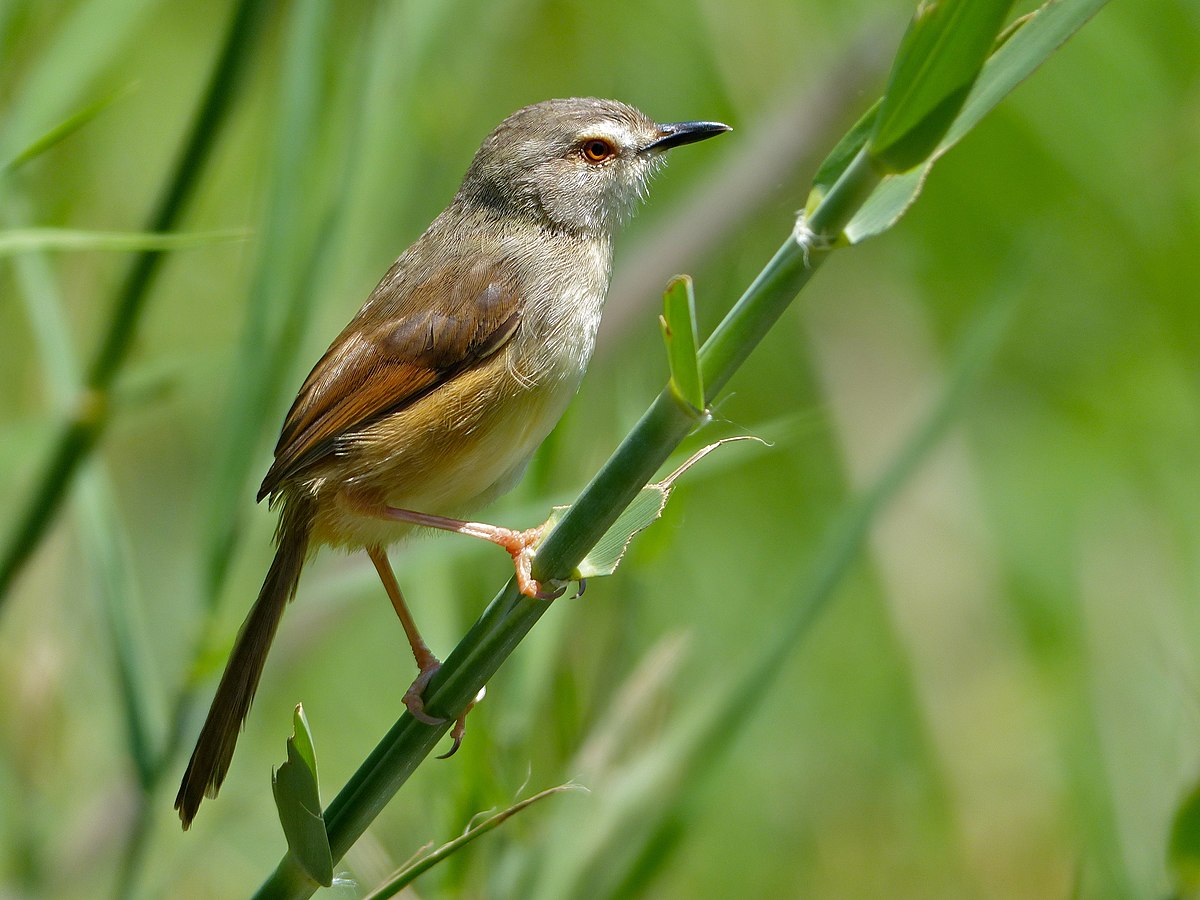
Wikipedia: Tawny-flanked prinia Quelle: OTHER
1200px-Tawny-flanked_Prinia_%28Prinia_subflava%29_%2811465162445%29.jpg
![]() The tawny-flanked prinia (Prinia subflava) is a small passerine bird belonging to the genus Prinia in the family Cisticolidae, a family of Old World warblers. It is widespread and common in most parts of Africa south of the Sahara. The plain prinia (P. inornata) of southern Asia was formerly included in this species but is now usually considered to be a separate species.
[more]
The tawny-flanked prinia (Prinia subflava) is a small passerine bird belonging to the genus Prinia in the family Cisticolidae, a family of Old World warblers. It is widespread and common in most parts of Africa south of the Sahara. The plain prinia (P. inornata) of southern Asia was formerly included in this species but is now usually considered to be a separate species.
[more]
Profil Wikipedia eBird Xeno-Canto

Wikipedia: Black-chested prinia Quelle: OTHER
1200px-Black-chested_prinia_%28Prinia_flavicans%29_breeding_female.jpg
![]() The black-chested prinia (Prinia flavicans) is a species of bird in the family Cisticolidae.
It is found in Angola, Botswana, Lesotho, Namibia, South Africa, Zambia, and Zimbabwe.
Its natural habitat is dry savanna.
[more]
The black-chested prinia (Prinia flavicans) is a species of bird in the family Cisticolidae.
It is found in Angola, Botswana, Lesotho, Namibia, South Africa, Zambia, and Zimbabwe.
Its natural habitat is dry savanna.
[more]
Profil Wikipedia eBird Xeno-Canto

Wikipedia: Karoo prinia Quelle: OTHER
1200px-Karoo_%28Spotted%29_Prinia_%2810537833606%29.jpg
![]() The Karoo prinia or spotted prinia (Prinia maculosa) is a small passerine bird. It is a resident breeder in South Africa, Lesotho and far southern Namibia.
[more]
The Karoo prinia or spotted prinia (Prinia maculosa) is a small passerine bird. It is a resident breeder in South Africa, Lesotho and far southern Namibia.
[more]
Profil Wikipedia eBird Xeno-Canto

Wikipedia: Green-backed camaroptera Quelle: OTHER
Green-backed_Cameroptera_-_Malawi_S4E3341_%2817142013720%29.jpg
![]() The green-backed camaroptera (Camaroptera brachyura), also known as the bleating camaroptera, is a small bird in the family Cisticolidae. This bird is a resident breeder in Africa south of the Sahara Desert. Recent studies suggest this species and the grey-backed camaroptera may be the same species.
[more]
The green-backed camaroptera (Camaroptera brachyura), also known as the bleating camaroptera, is a small bird in the family Cisticolidae. This bird is a resident breeder in Africa south of the Sahara Desert. Recent studies suggest this species and the grey-backed camaroptera may be the same species.
[more]

Wikipedia: Bar-throated apalis Quelle: OTHER
1200px-Bar-throated_Apalis%2C_Apalis_thoracica%2C_at_Marakele_National_Park%2C_Limpopo%2C_South_Africa_%2816216637960%29.jpg
![]() The bar-throated apalis (Apalis thoracica) is a small African passerine bird belonging to the genus Apalis of the family Cisticolidae. It is native to the eastern and southern Afrotropics.
[more]
The bar-throated apalis (Apalis thoracica) is a small African passerine bird belonging to the genus Apalis of the family Cisticolidae. It is native to the eastern and southern Afrotropics.
[more]
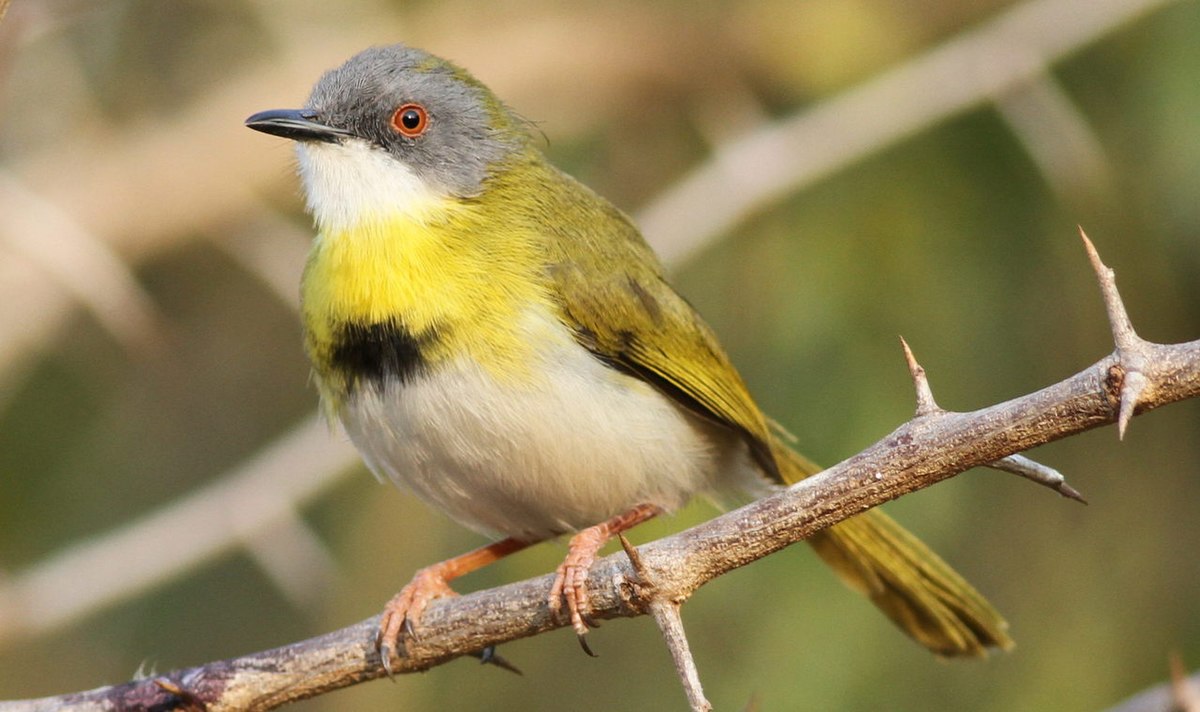
Wikipedia: Yellow-breasted apalis Quelle: OTHER
1200px-Yellow-breasted_apalis%2C_Apalis_flavida.jpg
![]() The yellow-breasted apalis (Apalis flavida) is a species of bird in the family Cisticolidae.
[more]
The yellow-breasted apalis (Apalis flavida) is a species of bird in the family Cisticolidae.
[more]
Profil Wikipedia eBird Xeno-Canto

Wikipedia: Rudd's apalis Quelle: OTHER
1200px-Rudd%27s_apalis%2C_Apalis_ruddi%2C_at_Ndumo_Nature_Reserve%2C_KwaZulu-Natal%2C_South_Africa_%2828319747984%29.jpg
![]() Rudd's apalis (Apalis ruddi) is a species of bird in the family Cisticolidae.
It is found primarily in Mozambique but also in southern Malawi and adjacent areas of South Africa and Swaziland.
Its natural habitats are subtropical or tropical dry forest and subtropical or tropical moist shrubland.
[more]
Rudd's apalis (Apalis ruddi) is a species of bird in the family Cisticolidae.
It is found primarily in Mozambique but also in southern Malawi and adjacent areas of South Africa and Swaziland.
Its natural habitats are subtropical or tropical dry forest and subtropical or tropical moist shrubland.
[more]
Profil Wikipedia eBird Xeno-Canto
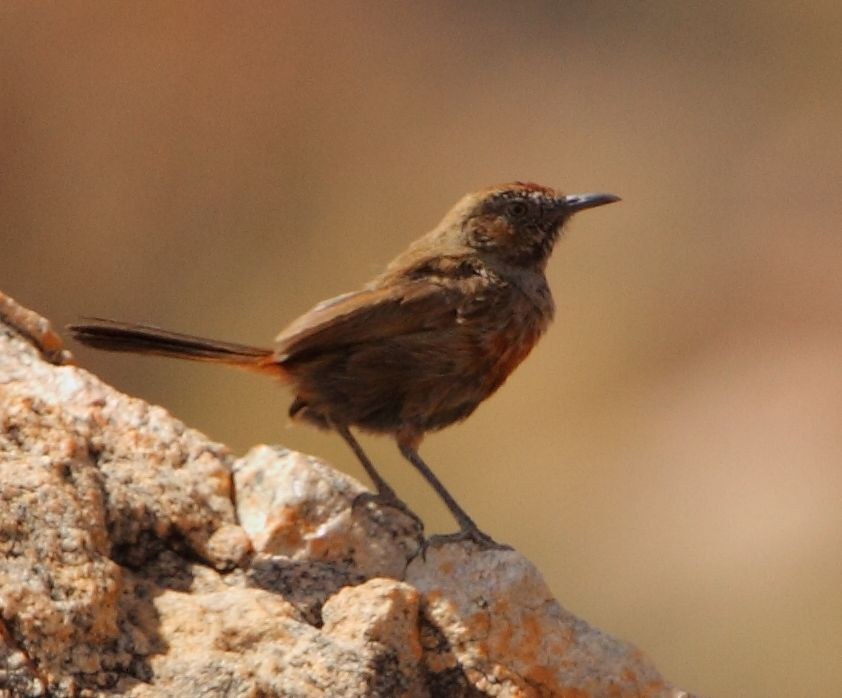
Wikipedia: Kopje warbler Quelle: OTHER
Euryptila_subcinnamomea_-near_Kamassies%2C_Kamiesberg%2C_Northern_Cape%2C_South_Africa-8.jpg
![]() The cinnamon-breasted warbler or kopje warbler (Euryptila subcinnamomea) is a species of bird in the family Cisticolidae. It is monotypic within the genus Euryptila.[2] It is found in Namibia and South Africa. Its natural habitat is subtropical or tropical dry shrubland.
[more]
The cinnamon-breasted warbler or kopje warbler (Euryptila subcinnamomea) is a species of bird in the family Cisticolidae. It is monotypic within the genus Euryptila.[2] It is found in Namibia and South Africa. Its natural habitat is subtropical or tropical dry shrubland.
[more]
Profil Wikipedia eBird Xeno-Canto

Wikipedia: Stierling's wren-warbler Quelle: OTHER
1200px-Naturalis_Biodiversity_Center_-_RMNH.AVES.37604_1_-_Calamonastes_stierlingi_stierlingi_Reichenow%2C_1901_-_Sylviidae_-_bird_skin_specimen.jpeg
![]() Stierling's wren-warbler (Calamonastes stierlingi), is a species of bird in the family Cisticolidae found in southern Africa. It is sometimes considered a subspecies of the miombo wren-warbler.
[more]
Stierling's wren-warbler (Calamonastes stierlingi), is a species of bird in the family Cisticolidae found in southern Africa. It is sometimes considered a subspecies of the miombo wren-warbler.
[more]
Profil Wikipedia eBird Xeno-Canto

Wikipedia: Barred wren-warbler Quelle: OTHER
1200px-Barred_wren-warbler%2C_Calamonastes_fasciolatus%2C_at_Pilanesberg_National_Park%2C_Northwest_Province%2C_South_Africa_%2816369976054%29.jpg
![]() The barred wren-warbler or southern barred warbler (Calamonastes fasciolatus) is a species of bird in the family Cisticolidae.
[more]
The barred wren-warbler or southern barred warbler (Calamonastes fasciolatus) is a species of bird in the family Cisticolidae.
[more]

Wikipedia: Rufous-eared warbler Quelle: OTHER
1200px-Rufous-eared_Warbler.jpg
![]() The rufous-eared warbler (Malcorus pectoralis) is a species of bird in the family Cisticolidae. It is found in Botswana, Namibia, and South Africa. It is the only species in the genus Malcorus.
Its natural habitats are subtropical or tropical dry shrubland and subtropical or tropical dry lowland grassland.
[more]
The rufous-eared warbler (Malcorus pectoralis) is a species of bird in the family Cisticolidae. It is found in Botswana, Namibia, and South Africa. It is the only species in the genus Malcorus.
Its natural habitats are subtropical or tropical dry shrubland and subtropical or tropical dry lowland grassland.
[more]

Wikipedia: Namaqua warbler Quelle: OTHER
Phragmacia_substriata%2C_Brandvlei%2C_Birding_Weto%2C_a.jpg
![]() The Namaqua warbler (Phragmacia substriata), also known as the Namaqua prinia or white-breasted prinia, is a small passerine bird, a cisticolid warbler and the sole member of the genus Phragmacia. It was formerly placed in the genus Prinia, but was found to be sufficiently distinct to warrant a genus of its own.
[more]
The Namaqua warbler (Phragmacia substriata), also known as the Namaqua prinia or white-breasted prinia, is a small passerine bird, a cisticolid warbler and the sole member of the genus Phragmacia. It was formerly placed in the genus Prinia, but was found to be sufficiently distinct to warrant a genus of its own.
[more]
Profil Wikipedia eBird Xeno-Canto

Wikipedia: Yellow-throated woodland-warbler Quelle: OTHER
Yellow-Throated_Woodland-Warbler_%28Phylloscopus_ruficapilla%29.jpg
![]() The yellow-throated woodland warbler (Phylloscopus ruficapilla) is a species of Old World warbler (the family Phylloscopidae). It is found in Kenya, Malawi, Mozambique, South Africa, Swaziland, Tanzania, Zambia, and Zimbabwe. Its natural habitats are subtropical or tropical dry forest and subtropical or tropical moist lowland forest.
[more]
The yellow-throated woodland warbler (Phylloscopus ruficapilla) is a species of Old World warbler (the family Phylloscopidae). It is found in Kenya, Malawi, Mozambique, South Africa, Swaziland, Tanzania, Zambia, and Zimbabwe. Its natural habitats are subtropical or tropical dry forest and subtropical or tropical moist lowland forest.
[more]

Wikipedia: Arrow-marked babbler Quelle: OTHER
1200px-Arrow-marked_Babbler%2CTurdoides_jardineii%2C_at_Hwange_National_Park%2C_Zimbabwe_%2835097040664%29.jpg
![]() Der Weißstrichel-Drosselhäherling (Turdoides jardineii), auch Braundrossling genannt, ist eine Vogelart aus der Familie der Häherlinge (Leiothrichidae).
[more]
Der Weißstrichel-Drosselhäherling (Turdoides jardineii), auch Braundrossling genannt, ist eine Vogelart aus der Familie der Häherlinge (Leiothrichidae).
[more]
Profil Wikipedia eBird Xeno-Canto
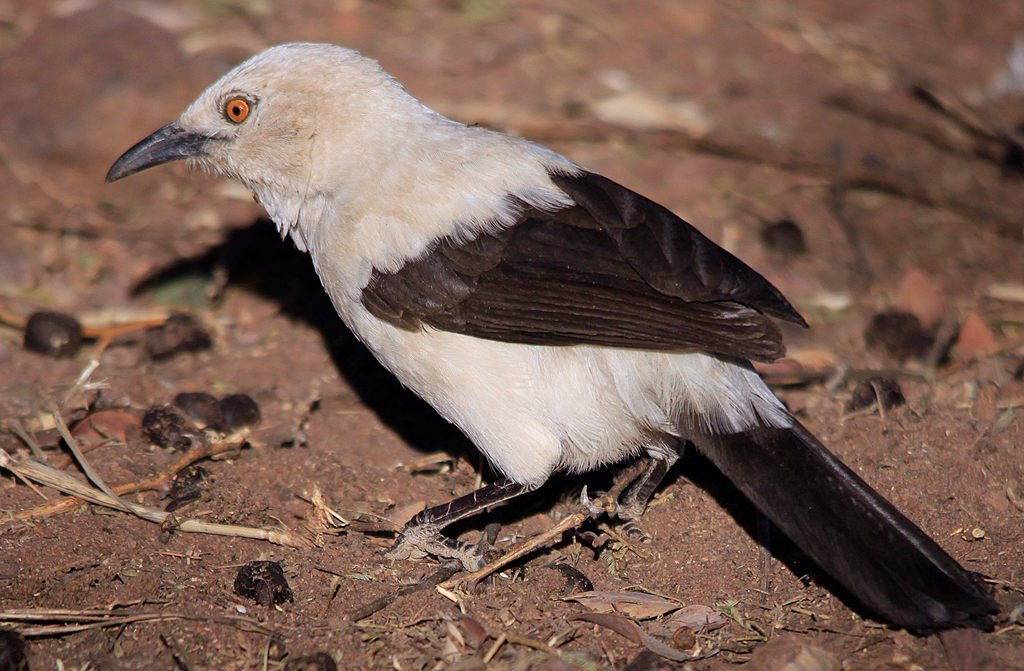
Wikipedia: Southern pied-babbler Quelle: OTHER
Southern_Pied_Babbler.jpg
![]() The southern pied babbler (Turdoides bicolor) is a species of bird in the family Leiothrichidae, found in dry savannah of Botswana, Namibia, South Africa, and Zimbabwe.
[more]
The southern pied babbler (Turdoides bicolor) is a species of bird in the family Leiothrichidae, found in dry savannah of Botswana, Namibia, South Africa, and Zimbabwe.
[more]

Wikipedia: Eurasian river warbler Quelle: OTHER
Flodsangare.jpg
![]() Der Schlagschwirl (Locustella fluviatilis) ist ein Singvogel aus der Gattung der Schwirle (Locustella) und der Familie der Grassänger (Locustellidae). Im Osten Mitteleuropas ist er ein verbreiteter und häufiger Brut- und Sommervogel. Im Westen Mitteleuropas ist er ein sporadischer, jedoch gebietsweise regelmäßiger Durchzügler sowie vereinzelt auch Sommergast. Die westlichsten Brutnachweise in Deutschland stammen aus Hessen. In Bayern besiedelt er zunehmend die Flusstäler von Inn, Isar, Donau und Main.[1]
[more]
Der Schlagschwirl (Locustella fluviatilis) ist ein Singvogel aus der Gattung der Schwirle (Locustella) und der Familie der Grassänger (Locustellidae). Im Osten Mitteleuropas ist er ein verbreiteter und häufiger Brut- und Sommervogel. Im Westen Mitteleuropas ist er ein sporadischer, jedoch gebietsweise regelmäßiger Durchzügler sowie vereinzelt auch Sommergast. Die westlichsten Brutnachweise in Deutschland stammen aus Hessen. In Bayern besiedelt er zunehmend die Flusstäler von Inn, Isar, Donau und Main.[1]
[more]
Gesang: ![]() Song an insectlike, buzzing like Grasshopper and Savi's Warbler, but easily distinguished from those by it's distinct steam locomotive-like rhythm. About 8 accents per second. Perhaps easier to confuse with certain species of ground crickets or cicadas than it's congeners. [Link]
Song an insectlike, buzzing like Grasshopper and Savi's Warbler, but easily distinguished from those by it's distinct steam locomotive-like rhythm. About 8 accents per second. Perhaps easier to confuse with certain species of ground crickets or cicadas than it's congeners. [Link]
Rufe: ![]() Contact call a sharp "tsikk-tsikk", similar to Savi's Warbler. [Link]
Contact call a sharp "tsikk-tsikk", similar to Savi's Warbler. [Link]
Körperlich: Länge=13 cm,
Flügelspanne=19-22 cm,
Gewicht=15-19 g
Profil Wikipedia eBird Xeno-Canto

Wikipedia: Knysna warbler Quelle: OTHER
BradypterusSylvaticusSmit.jpg
Allgemein: ![]() The Knysna warbler or Knysna scrub warbler (Bradypterus sylvaticus) is a very shy and cryptic warbler, endemic to the coastal regions of South Africa.[2] Its population is small and probably declining, due to natural and artificial fragmentation of its habitat, and limited dispersal and reproductive ability.[3]
[more]
The Knysna warbler or Knysna scrub warbler (Bradypterus sylvaticus) is a very shy and cryptic warbler, endemic to the coastal regions of South Africa.[2] Its population is small and probably declining, due to natural and artificial fragmentation of its habitat, and limited dispersal and reproductive ability.[3]
[more]

Wikipedia: African bush-warbler Quelle: OTHER
African_Bush-Warbler_-_South_Africa_S4E7737_%2816708155164%29%2C_crop.jpg
![]() The little rush warbler or African bush warbler (Bradypterus baboecala) is a species of Old World warbler in the family Locustellidae.
[more]
The little rush warbler or African bush warbler (Bradypterus baboecala) is a species of Old World warbler in the family Locustellidae.
[more]
Profil Wikipedia eBird Xeno-Canto

Wikipedia: Fan-tailed grassbird Quelle: OTHER
Schoenicola_brevirostris_2.jpg
![]() The fan-tailed grassbird or broad-tailed warbler (Catriscus brevirostris) is an African species of Old World warbler in the family Locustellidae. The species is closely related to the broad-tailed grassbird of India, and is sometimes treated as the same species,[2] although a 2018 study found that it and broad-tailed grassbird were not closely related with the Indian species being a sister of Chaetornis striata.[3]
[more]
The fan-tailed grassbird or broad-tailed warbler (Catriscus brevirostris) is an African species of Old World warbler in the family Locustellidae. The species is closely related to the broad-tailed grassbird of India, and is sometimes treated as the same species,[2] although a 2018 study found that it and broad-tailed grassbird were not closely related with the Indian species being a sister of Chaetornis striata.[3]
[more]
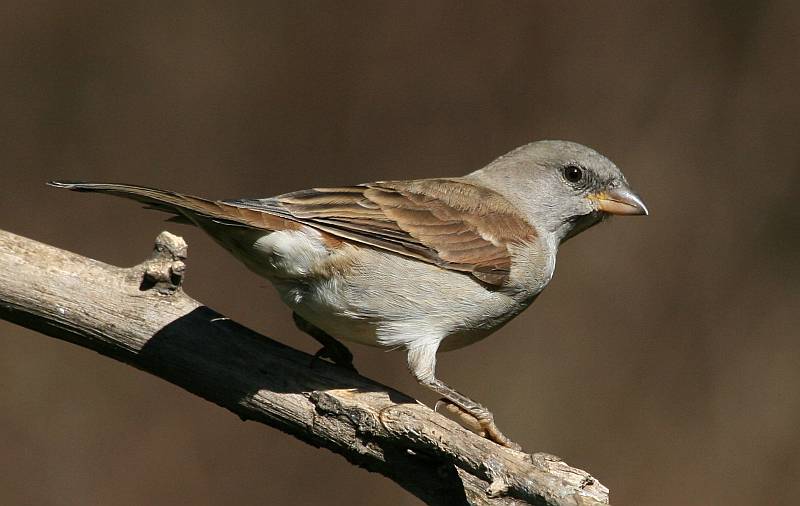
Wikipedia: Southern grey-headed sparrow Quelle: OTHER
Southern_Grey-headed_Sparrow_%28Passer_diffusus%29.jpg
![]() Der Damarasperling (Passer diffusus) ist eine Vogelart der Gattung Passer aus der Familie der Sperlinge (Passeridae). Er kommt ausschließlich im südlichen Afrika vor, wo er ein häufiger und weit verbreiteter Vogel ist. Es werden drei Unterarten unterschieden, die aber nicht von allen Autoren anerkannt werden.[1] Die Art ist nach der Volksgruppe der Damara benannt, die ihr Hauptsiedlungsgebiet in Namibia hat.
[more]
Der Damarasperling (Passer diffusus) ist eine Vogelart der Gattung Passer aus der Familie der Sperlinge (Passeridae). Er kommt ausschließlich im südlichen Afrika vor, wo er ein häufiger und weit verbreiteter Vogel ist. Es werden drei Unterarten unterschieden, die aber nicht von allen Autoren anerkannt werden.[1] Die Art ist nach der Volksgruppe der Damara benannt, die ihr Hauptsiedlungsgebiet in Namibia hat.
[more]
Profil Wikipedia eBird Xeno-Canto

Wikipedia: Great rufous sparrow Quelle: OTHER
Great_Sparrow.jpg
![]() The great sparrow (Passer motitensis), also known as the southern rufous sparrow, is found in southern Africa in dry, wooded savannah and towns.[1][3]
[more]
The great sparrow (Passer motitensis), also known as the southern rufous sparrow, is found in southern Africa in dry, wooded savannah and towns.[1][3]
[more]
Profil Wikipedia eBird Xeno-Canto
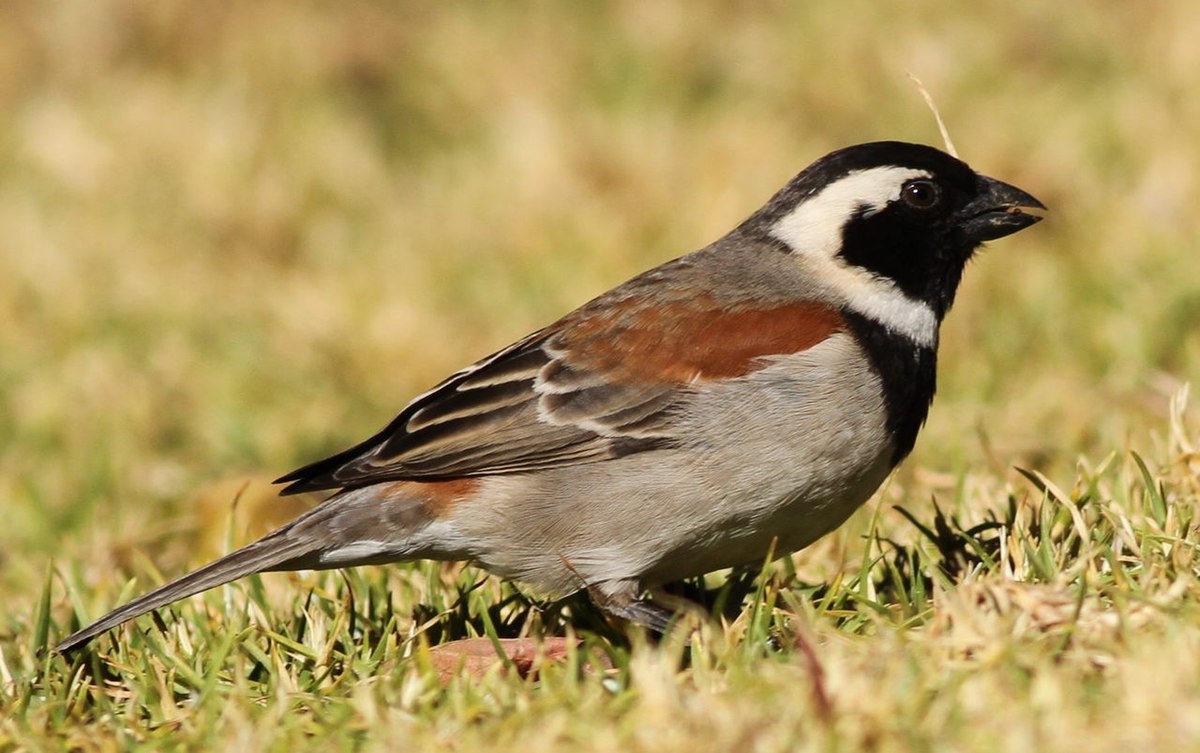
Wikipedia: Cape sparrow Quelle: OTHER
1200px-Cape_Sparrow%2C_Passer_melanurus_at_Walter_Sisulu_National_Botanical_Garden%2C_Johannesburg%2C_South_Africa_%2814727921265%29.jpg
![]() Der Kapsperling (Passer melanurus) ist eine Vogelart aus der Familie der Sperlinge. Die Art kommt ausschließlich im südlichen Afrika vor. In Südafrika hat die Art in den letzten Jahrzehnten ihre Ernährungsgewohnheiten geändert und richtet Schäden auf Weinanbauflächen und in Plantagen an. Es werden drei Unterarten unterschieden.
[more]
Der Kapsperling (Passer melanurus) ist eine Vogelart aus der Familie der Sperlinge. Die Art kommt ausschließlich im südlichen Afrika vor. In Südafrika hat die Art in den letzten Jahrzehnten ihre Ernährungsgewohnheiten geändert und richtet Schäden auf Weinanbauflächen und in Plantagen an. Es werden drei Unterarten unterschieden.
[more]
Profil Wikipedia eBird Xeno-Canto

Wikipedia: White-browed sparrow-weaver Quelle: OTHER
1200px-Plocepasser_mahali_-Baringo_Lake%2C_Kenya_-male-8.jpg
![]() The white-browed sparrow-weaver (Plocepasser mahali) is a predominantly brown, sparrow-sized bird found throughout central and north-central southern Africa.[2] It is found in groups of two to eleven individuals consisting of one breeding pair and other non-reproductive individuals.
[more]
The white-browed sparrow-weaver (Plocepasser mahali) is a predominantly brown, sparrow-sized bird found throughout central and north-central southern Africa.[2] It is found in groups of two to eleven individuals consisting of one breeding pair and other non-reproductive individuals.
[more]

Wikipedia: Parasitic weaver Quelle: OTHER
Parasitic_Weaver_%28Anomalospiza_imberbis%29.jpg
![]() The cuckoo-finch (Anomalospiza imberbis), also known as the parasitic weaver or cuckoo weaver, is a small passerine bird now placed in the family Viduidae with the indigobirds and whydahs. It occurs in grassland in Africa south of the Sahara. The male is mainly yellow and green while the female is buff with dark streaks. The eggs are laid in the nests of other birds.[2]
[more]
The cuckoo-finch (Anomalospiza imberbis), also known as the parasitic weaver or cuckoo weaver, is a small passerine bird now placed in the family Viduidae with the indigobirds and whydahs. It occurs in grassland in Africa south of the Sahara. The male is mainly yellow and green while the female is buff with dark streaks. The eggs are laid in the nests of other birds.[2]
[more]
Profil Wikipedia eBird Xeno-Canto
Sossusvlei - Sociable weaver eating crumbs. 2016-09-06 10.41.12 Namibia
Zuerst beobachtet in Namibia an 2016-09-06.
![]() Der Siedelweber (Philetairus socius), auch Siedelsperling genannt, ist die einzige Art der Gattung Philetairus innerhalb der Familie der Webervögel (Ploceidae).
[more]
Der Siedelweber (Philetairus socius), auch Siedelsperling genannt, ist die einzige Art der Gattung Philetairus innerhalb der Familie der Webervögel (Ploceidae).
[more]

Wikipedia: Yellow-throated bush sparrow Quelle: OTHER
1200px-Petronia_superciliaris.jpg
![]() The yellow-throated bush sparrow (Gymnoris superciliaris), also known as the yellow-throated petronia,[2] is a species of bird in the sparrow family Passeridae. It is found in south-central and southern Africa in its natural habitats of subtropical or tropical dry forests, dry savanna, and subtropical or tropical dry shrubland.
[more]
The yellow-throated bush sparrow (Gymnoris superciliaris), also known as the yellow-throated petronia,[2] is a species of bird in the sparrow family Passeridae. It is found in south-central and southern Africa in its natural habitats of subtropical or tropical dry forests, dry savanna, and subtropical or tropical dry shrubland.
[more]
Profil Wikipedia eBird Xeno-Canto

Wikipedia: Black-headed canary Quelle: OTHER
Serinus_alario_-near_Rooifontein%2C_Northern_Cape%2C_South_Africa_-male-8.jpg
![]() Der Alariogirlitz (Serinus alario) ist ein Fink aus der Gattung der Girlitze. Sein Verbreitungsgebiet umfasst den Süden und den Südwesten Afrikas. In Europa wird er gelegentlich als Ziervogel gehalten.
[more]
Der Alariogirlitz (Serinus alario) ist ein Fink aus der Gattung der Girlitze. Sein Verbreitungsgebiet umfasst den Süden und den Südwesten Afrikas. In Europa wird er gelegentlich als Ziervogel gehalten.
[more]
Profil Wikipedia eBird Xeno-Canto

Wikipedia: Cape canary Quelle: OTHER
Cape_Canary_%28Serinus_canicollis%29_1.jpg
![]() Der Gelbscheitelgirlitz (Serinus canicollis), auch Kapkanarienvogel genannt, ist eine Art aus der Familie der Finken. Die Art wird gelegentlich in Europa als Ziervogel gehalten.
[more]
Der Gelbscheitelgirlitz (Serinus canicollis), auch Kapkanarienvogel genannt, ist eine Art aus der Familie der Finken. Die Art wird gelegentlich in Europa als Ziervogel gehalten.
[more]

Wikipedia: Lark-like bunting Quelle: OTHER
1200px-Lark-like_bunting_%28Emberiza_impetuani_impetuani%29.jpg
![]() The lark-like bunting (Emberiza impetuani) is a species of bird in the family Emberizidae, which is native to south-western Africa.
[more]
The lark-like bunting (Emberiza impetuani) is a species of bird in the family Emberizidae, which is native to south-western Africa.
[more]
Profil Wikipedia eBird Xeno-Canto

Wikipedia: Golden-breasted bunting Quelle: OTHER
Emberiza_flaviventris_-Hluhluwe-Umfolozi_Game_Reserve%2C_South_Africa-8.jpg
![]() The golden-breasted bunting (Emberiza flaviventris) is a passerine bird in the bunting family Emberizidae. It occurs in dry open woodlands and moist savanna in Africa south of the Sahara, but is absent from the equatorial forest belt.
[more]
The golden-breasted bunting (Emberiza flaviventris) is a passerine bird in the bunting family Emberizidae. It occurs in dry open woodlands and moist savanna in Africa south of the Sahara, but is absent from the equatorial forest belt.
[more]
Profil Wikipedia eBird Xeno-Canto

Wikipedia: Cape bunting Quelle: OTHER
Cape_Bunting%2C_Emberiza_capensis_at_Suikerbosrand_Nature_Reserve%2C_Gauteng%2C_South_Africa.jpg
![]() The Cape bunting (Emberiza capensis) is a passerine bird in the bunting family Emberizidae.
[more]
The Cape bunting (Emberiza capensis) is a passerine bird in the bunting family Emberizidae.
[more]

Wikipedia: Brimstone canary Quelle: OTHER
Brimstone_Canary_-_Uganda_H8O4066_%2822647799309%29.jpg
![]() The brimstone canary or bully canary (Crithagra sulphurata) is a small passerine bird in the finch family. It is a resident breeder in central and southern Africa.
[more]
The brimstone canary or bully canary (Crithagra sulphurata) is a small passerine bird in the finch family. It is a resident breeder in central and southern Africa.
[more]
Profil Wikipedia eBird Xeno-Canto

Wikipedia: Protea canary Quelle: OTHER
CrithagraLeucopteraHart.jpg
![]() The protea canary (Crithagra leucoptera), also known as the protea seedeater, white-winged seedeater or Layard's seedeater, is a small passerine bird in the finch family.
[more]
The protea canary (Crithagra leucoptera), also known as the protea seedeater, white-winged seedeater or Layard's seedeater, is a small passerine bird in the finch family.
[more]
Profil Wikipedia eBird Xeno-Canto

Wikipedia: Lemon-breasted seedeater Quelle: OTHER
1200px-Lemon-breasted_canary%2C_Crithagra_citrinipectus%2C_near_Pafuri_in_Kruger_National_Park%2C_South_Africa.jpg
![]() The lemon-breasted canary (Crithagra citrinipectus), also known as the lemon-breasted seedeater, is a species of finch in the family Fringillidae. It is found in Malawi, Mozambique, South Africa, Zambia, and Zimbabwe. Its natural habitats are dry savannah, subtropical or tropical dry shrubland, and rural gardens.
[more]
The lemon-breasted canary (Crithagra citrinipectus), also known as the lemon-breasted seedeater, is a species of finch in the family Fringillidae. It is found in Malawi, Mozambique, South Africa, Zambia, and Zimbabwe. Its natural habitats are dry savannah, subtropical or tropical dry shrubland, and rural gardens.
[more]

Wikipedia: Yellow canary Quelle: OTHER
Serinus_flaviventris_-Great_Karoo%2C_Northern_Cape%2C_South_Africa_-adult_male-8.jpg
![]() Der Gelbbauchgirlitz (Crithagra flaviventris, Syn.: Serinus flaviventris, Serinops flaviventris) ist eine Finkenart aus der Unterfamilie der Stieglitzartigen. Die Art wird gelegentlich in Europa auch als Ziervogel gehalten.
[more]
Der Gelbbauchgirlitz (Crithagra flaviventris, Syn.: Serinus flaviventris, Serinops flaviventris) ist eine Finkenart aus der Unterfamilie der Stieglitzartigen. Die Art wird gelegentlich in Europa auch als Ziervogel gehalten.
[more]
Profil Wikipedia eBird Xeno-Canto

Wikipedia: Streaky-headed seedeater Quelle: OTHER
Streaky-headed_Seedeater_%28Serinus_gularis%29.jpg
![]() Der Brauengirlitz (Crithagra gularis, Syn.: Serinus gularis) ist eine Art aus der Familie der Finken. Die Art wird gelegentlich in Europa auch als Ziervogel gehalten.
[more]
Der Brauengirlitz (Crithagra gularis, Syn.: Serinus gularis) ist eine Art aus der Familie der Finken. Die Art wird gelegentlich in Europa auch als Ziervogel gehalten.
[more]
Profil Wikipedia eBird Xeno-Canto

Wikipedia: Drakensberg siskin Quelle: OTHER
Male_Drakensberg_Siskin_2019_01_27_10_25_20_1129cr.jpg
![]() The Drakensberg siskin (Crithagra symonsi) is a small passerine bird in the finch family. It is an endemic resident breeder in the eastern Cape Province Transkei and western Natal in South Africa, and in Lesotho.
[more]
The Drakensberg siskin (Crithagra symonsi) is a small passerine bird in the finch family. It is an endemic resident breeder in the eastern Cape Province Transkei and western Natal in South Africa, and in Lesotho.
[more]
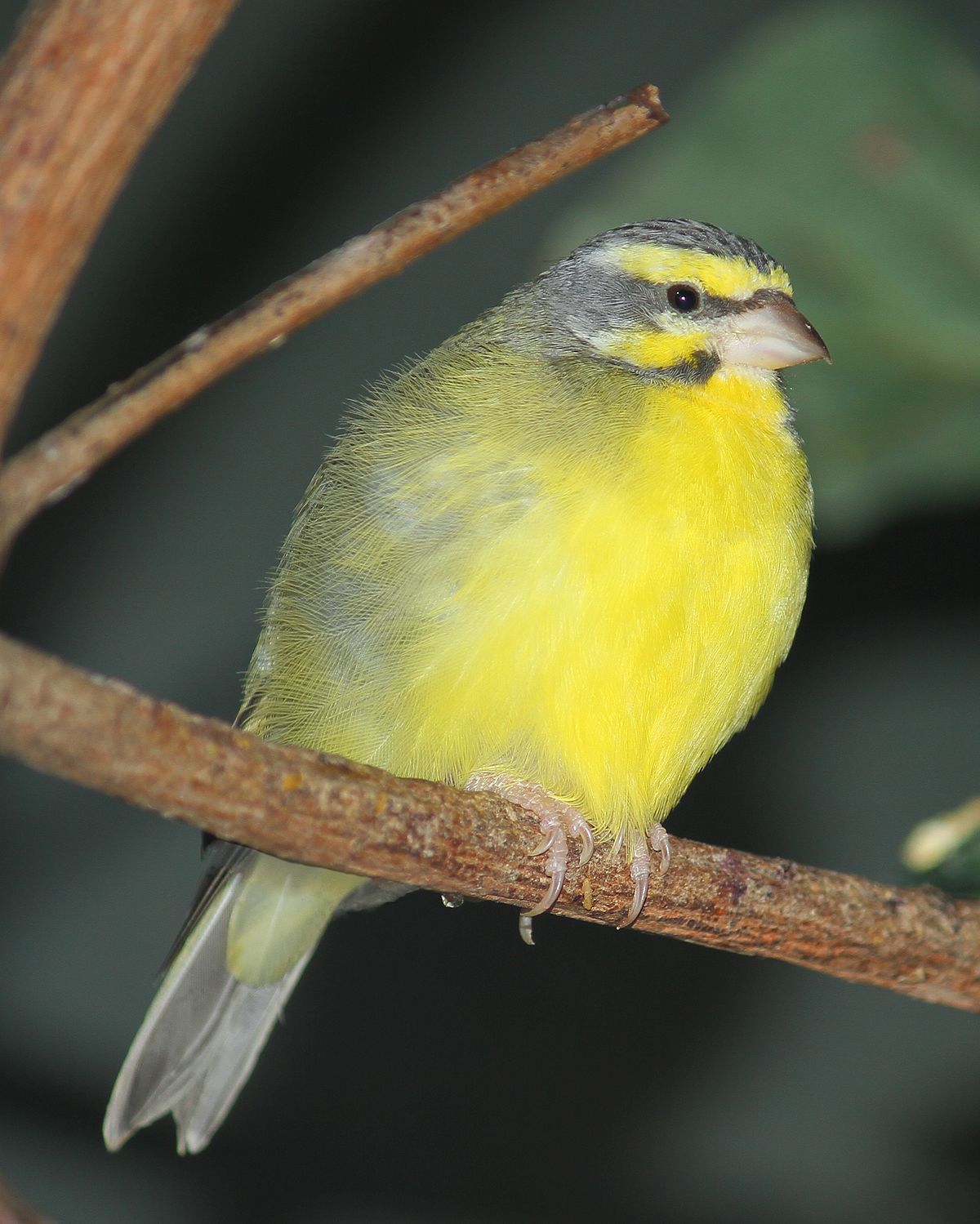
Wikipedia: Yellow-fronted canary Quelle: OTHER
1200px-Serinus_masambicus_25.jpg
Dieser Vogel erscheint jenseits grossen Meere in Kontinenten :
Nordamerika, Afrika.
![]() Der Mosambikgirlitz (Crithagra mozambica, Syn.: Crithagra mozambicus, Serinus mozambicus) ist eine Finkenart aus der Unterfamilie der Stieglitzartigen. Er kam ursprünglich ausschließlich in Afrika südlich der Sahara vor und ist dort eine häufige und weit verbreitete Girlitzart. Er ist mittlerweile auch in Regionen weit abseits seines Verbreitungsgebietes eingeführt.
[more]
Der Mosambikgirlitz (Crithagra mozambica, Syn.: Crithagra mozambicus, Serinus mozambicus) ist eine Finkenart aus der Unterfamilie der Stieglitzartigen. Er kam ursprünglich ausschließlich in Afrika südlich der Sahara vor und ist dort eine häufige und weit verbreitete Girlitzart. Er ist mittlerweile auch in Regionen weit abseits seines Verbreitungsgebietes eingeführt.
[more]
Profil Wikipedia eBird Xeno-Canto

Wikipedia: White-throated canary Quelle: OTHER
1200px-White-throated_canary_%28Crithagra_albogularis_crocopygia%29%2C_crop.jpg
![]() The white-throated canary (Crithagra albogularis) is a species of finch in the family Fringillidae.
[more]
The white-throated canary (Crithagra albogularis) is a species of finch in the family Fringillidae.
[more]
Profil Wikipedia eBird Xeno-Canto

Wikipedia: Black-throated canary Quelle: OTHER
Canary_Black-throated_2012_01_15_08_09_00_4016.jpg
![]() The black-throated canary (Crithagra atrogularis), also known as the black-throated seedeater, is a species of finch in the family Fringillidae.
[more]
The black-throated canary (Crithagra atrogularis), also known as the black-throated seedeater, is a species of finch in the family Fringillidae.
[more]
Profil Wikipedia eBird Xeno-Canto

Wikipedia: Yellow-tufted pipit Quelle: OTHER
1200px-Naturalis_Biodiversity_Center_-_RMNH.AVES.123245_1_-_Anthus_crenatus_Finsch_%26_Hartlaub%2C_1870_-_Motacillidae_-_bird_skin_specimen.jpeg
![]() The African rock pipit (Anthus crenatus), also known as the yellow-tufted pipit, is a species of bird in the family Motacillidae. It is found in the high-altitude, rocky grasslands of South Africa and Lesotho.[2]
[more]
The African rock pipit (Anthus crenatus), also known as the yellow-tufted pipit, is a species of bird in the family Motacillidae. It is found in the high-altitude, rocky grasslands of South Africa and Lesotho.[2]
[more]

Wikipedia: Red-throated pipit Quelle: OTHER
1200px-Red-throated_Pipit.jpg
Dieser Vogel erscheint jenseits grossen Meere in Kontinenten :
Europa, Nordamerika, Afrika, Asien.
![]() Der Rotkehlpieper (Anthus cervinus) ist eine Vogelart aus der Familie der Stelzen und Pieper. Die Art bewohnt die nördliche Taiga und die Strauchtundra in Eurasien und Alaska und überwintert in den Tropen Afrikas und Asiens. In Mitteleuropa ist die Art regelmäßiger Durchzügler in kleiner Zahl.
[more]
Der Rotkehlpieper (Anthus cervinus) ist eine Vogelart aus der Familie der Stelzen und Pieper. Die Art bewohnt die nördliche Taiga und die Strauchtundra in Eurasien und Alaska und überwintert in den Tropen Afrikas und Asiens. In Mitteleuropa ist die Art regelmäßiger Durchzügler in kleiner Zahl.
[more]
Profil Wikipedia eBird Xeno-Canto

Wikipedia: Plain-backed pipit Quelle: OTHER
Plain-backed_Pipit_-_Tanzania_0025_%2816999610272%29.jpg
![]() The plain-backed pipit or plain pipit (Anthus leucophrys) is a medium-sized passerine bird which is a resident breeder in Africa south of the Sahara Desert.
[more]
The plain-backed pipit or plain pipit (Anthus leucophrys) is a medium-sized passerine bird which is a resident breeder in Africa south of the Sahara Desert.
[more]
Profil Wikipedia eBird Xeno-Canto

Wikipedia: Short-tailed pipit Quelle: OTHER
Short-tailed_Pipit_2012_02_08_9427.jpg
![]() The short-tailed pipit (Anthus brachyurus) is a species of bird in the family Motacillidae.
It is found in Angola, Burundi, Republic of the Congo, Democratic Republic of the Congo, Gabon, Mozambique, Rwanda, Somalia, South Africa, Tanzania, Uganda, Zambia, and Zimbabwe.
Its natural habitats are subtropical or tropical dry lowland grassland and subtropical or tropical seasonally wet or flooded lowland grassland.
[more]
The short-tailed pipit (Anthus brachyurus) is a species of bird in the family Motacillidae.
It is found in Angola, Burundi, Republic of the Congo, Democratic Republic of the Congo, Gabon, Mozambique, Rwanda, Somalia, South Africa, Tanzania, Uganda, Zambia, and Zimbabwe.
Its natural habitats are subtropical or tropical dry lowland grassland and subtropical or tropical seasonally wet or flooded lowland grassland.
[more]
Profil Wikipedia eBird Xeno-Canto

Wikipedia: Buffy pipit Quelle: OTHER
Buffy_Pipit_2010_12_07_00469.jpg
![]() The buffy pipit (Anthus vaalensis) is a species of bird in the Motacillidae family. It is found in plains and open countryside in southern and eastern Africa. The IUCN has assessed its conservation status as being of least concern.
[more]
The buffy pipit (Anthus vaalensis) is a species of bird in the Motacillidae family. It is found in plains and open countryside in southern and eastern Africa. The IUCN has assessed its conservation status as being of least concern.
[more]
Profil Wikipedia eBird Xeno-Canto

Wikipedia: Long-billed pipit Quelle: OTHER
Long-billed_pipit.jpg
![]() The long-billed pipit or brown rock pipit (Anthus similis) is a passerine bird which has a wide distribution. A number of subspecies have been created for the populations in Africa, through the Arabian peninsula and South Asia. The systematics of this complex is yet to be clarified. Most birds are residents or short distance migrants.
[more]
The long-billed pipit or brown rock pipit (Anthus similis) is a passerine bird which has a wide distribution. A number of subspecies have been created for the populations in Africa, through the Arabian peninsula and South Asia. The systematics of this complex is yet to be clarified. Most birds are residents or short distance migrants.
[more]
Profil Wikipedia eBird Xeno-Canto

Wikipedia: Striped pipit Quelle: OTHER
Pipit_Striped_Alan_Manson_2011_06_18_ItalaGR.jpg
![]() The striped pipit (Anthus lineiventris) is a species of bird in the family Motacillidae, which is native to Africa southwards of the equator.
[more]
The striped pipit (Anthus lineiventris) is a species of bird in the family Motacillidae, which is native to Africa southwards of the equator.
[more]
Profil Wikipedia eBird Xeno-Canto

Wikipedia: African pipit Quelle: OTHER
African_Pipit%2C_Anthus_cinnamomeus_%28I_presume%29_%2812388148433%29.jpg
![]() The African pipit (Anthus cinnamomeus) is a fairly small passerine bird belonging to the pipit genus Anthus in the family Motacillidae. It is also known as the grassveld pipit or grassland pipit. It was formerly lumped together with the Richard's, Australasian, mountain and paddyfield pipits in a single species, Richard's pipit (Anthus novaeseelandiae), but is now often treated as a species in its own right.
[more]
The African pipit (Anthus cinnamomeus) is a fairly small passerine bird belonging to the pipit genus Anthus in the family Motacillidae. It is also known as the grassveld pipit or grassland pipit. It was formerly lumped together with the Richard's, Australasian, mountain and paddyfield pipits in a single species, Richard's pipit (Anthus novaeseelandiae), but is now often treated as a species in its own right.
[more]
Profil Wikipedia eBird Xeno-Canto

Wikipedia: Mountain pipit Quelle: OTHER
Mountain_Pipit_-_Natal_-_South_Africa_S4E7209_%2816378615434%29.jpg
![]() The mountain pipit (Anthus hoeschi) is a species of bird in the family Motacillidae.
[more]
The mountain pipit (Anthus hoeschi) is a species of bird in the family Motacillidae.
[more]
Profil Wikipedia eBird Xeno-Canto

Wikipedia: Bush pipit Quelle: OTHER
Pipit_Bushveld_2014_10_18_MkhuzeGR_9249.jpg
![]() The bushveld pipit, bush pipit or little pipit (Anthus caffer) is a species of bird in the pipit and wagtail family Motacillidae. It is found in Angola, Botswana, Ethiopia, Kenya, Malawi, Mozambique, South Africa, Swaziland, Tanzania, Zambia, and Zimbabwe. Its natural habitats are subtropical or tropical dry forests and dry savanna.
[more]
The bushveld pipit, bush pipit or little pipit (Anthus caffer) is a species of bird in the pipit and wagtail family Motacillidae. It is found in Angola, Botswana, Ethiopia, Kenya, Malawi, Mozambique, South Africa, Swaziland, Tanzania, Zambia, and Zimbabwe. Its natural habitats are subtropical or tropical dry forests and dry savanna.
[more]

Wikipedia: Cape wagtail Quelle: OTHER
1200px-Cape_wagtail_%28Motacilla_capensis%29.jpg
![]() The Cape wagtail (Motacilla capensis), also known as Wells's wagtail, is a small insectivorous bird which is widespread in southern Africa. It frequents water's edge, lawns and gardens. It is a mostly resident, territorial species, but has been known to undertake limited altitudinal migration or form flocks outside of the breeding season.[3] Like other wagtails they are passerine birds of the family Motacillidae, which also includes the pipits and longclaws.
[more]
The Cape wagtail (Motacilla capensis), also known as Wells's wagtail, is a small insectivorous bird which is widespread in southern Africa. It frequents water's edge, lawns and gardens. It is a mostly resident, territorial species, but has been known to undertake limited altitudinal migration or form flocks outside of the breeding season.[3] Like other wagtails they are passerine birds of the family Motacillidae, which also includes the pipits and longclaws.
[more]
Profil Wikipedia eBird Xeno-Canto BirdID NABU

Wikipedia: Citrine wagtail Quelle: OTHER
Citrine_Wagtail_%28Motacilla_citreola%29-_Breeding_Male_of_calcarata_race_at_Bharatpur_I_IMG_5752.jpg
![]() The citrine wagtail (Motacilla citreola) is a small songbird in the family Motacillidae.
[more]
The citrine wagtail (Motacilla citreola) is a small songbird in the family Motacillidae.
[more]
Gesang: ![]() The song is a loose repetition of phrases, comprised of disyllabic or monosyllabic contact calls. [Link]
The song is a loose repetition of phrases, comprised of disyllabic or monosyllabic contact calls. [Link]
Rufe: ![]() Contact call resembles Yellow Wagtail, but is harsher with a more buzzing quality, and of shorter duration. The pitch is more constant, lacking the rise and fall of Yellow Wagtail. [Link]
Contact call resembles Yellow Wagtail, but is harsher with a more buzzing quality, and of shorter duration. The pitch is more constant, lacking the rise and fall of Yellow Wagtail. [Link]
Körperlich: Länge=17 cm,
Flügelspanne=24-27 cm,
Gewicht=18-25 g
Profil Wikipedia eBird Xeno-Canto

Wikipedia: Mountain wagtail Quelle: OTHER
1200px-Mountain_wagtail%2C_Motacilla_clara.jpg
Allgemein: ![]() The mountain wagtail (Motacilla clara), also known as the long-tailed wagtail or grey-backed wagtail, is a species of wagtail of the family Motacillidae from sub-Saharan Africa.[2]
[more]
The mountain wagtail (Motacilla clara), also known as the long-tailed wagtail or grey-backed wagtail, is a species of wagtail of the family Motacillidae from sub-Saharan Africa.[2]
[more]
Profil Wikipedia eBird Xeno-Canto

Wikipedia: African pied wagtail Quelle: OTHER
1200px-African_pied_wagtail_%28Motacilla_aguimp_vidua%29.jpg
![]() Die Witwenstelze (Motacilla aguimp) ist eine Singvogelart aus der Familie der Stelzen und Pieper. Sie ist in großen Teilen Subsahara-Afrikas, in Südägypten sowie Teilen des Sudans und Äthiopiens verbreitet, wo sie fast überall in offenen Habitaten vorkommt. Häufig ist sie in Siedlungs- und Gewässernähe, in Wüstengebieten sogar ausschließlich dort zu finden. Die Art ist weit verbreitet, häufig und wird von der IUCN als nicht bedroht eingestuft.
[more]
Die Witwenstelze (Motacilla aguimp) ist eine Singvogelart aus der Familie der Stelzen und Pieper. Sie ist in großen Teilen Subsahara-Afrikas, in Südägypten sowie Teilen des Sudans und Äthiopiens verbreitet, wo sie fast überall in offenen Habitaten vorkommt. Häufig ist sie in Siedlungs- und Gewässernähe, in Wüstengebieten sogar ausschließlich dort zu finden. Die Art ist weit verbreitet, häufig und wird von der IUCN als nicht bedroht eingestuft.
[more]
Profil Wikipedia eBird Xeno-Canto

Wikipedia: Orange-throated longclaw Quelle: OTHER
1200px-Cape_Longclaw_%28Macronyx_capensis%29_%2831320650481%29.jpg
![]() The Cape longclaw or orange-throated longclaw (Macronyx capensis) is a passerine bird in the family Motacillidae, which comprises the longclaws, pipits and wagtails.[2] It occurs in Southern Africa in Zimbabwe and southern and eastern South Africa. This species is found in coastal and mountain grassland, often near water.[2]
[more]
The Cape longclaw or orange-throated longclaw (Macronyx capensis) is a passerine bird in the family Motacillidae, which comprises the longclaws, pipits and wagtails.[2] It occurs in Southern Africa in Zimbabwe and southern and eastern South Africa. This species is found in coastal and mountain grassland, often near water.[2]
[more]
Profil Wikipedia eBird Xeno-Canto
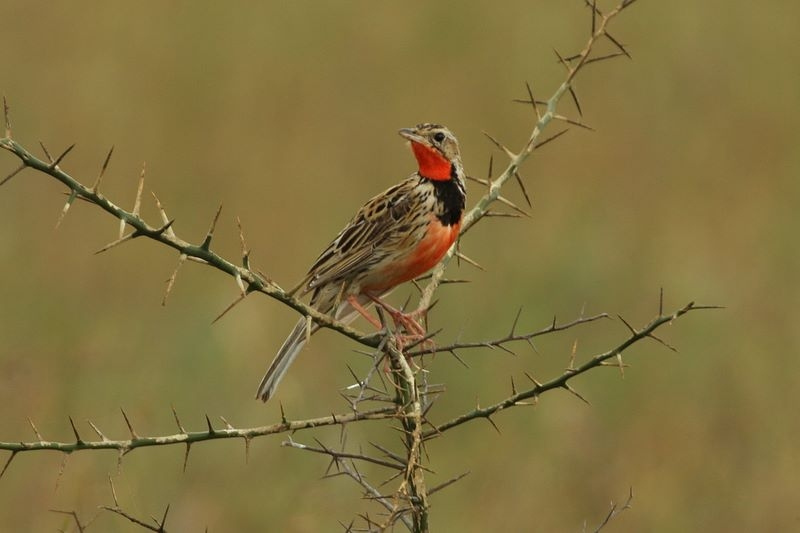
Wikipedia: Rosy-throated longclaw Quelle: OTHER
Macronyx_ameliae_-East_Africa-8.jpg
![]() The rosy-throated longclaw, also known as the rosy-breasted longclaw (Macronyx ameliae) is a species of bird in the family Motacillidae. It is found in Angola, Botswana, Democratic Republic of the Congo, Kenya, Malawi, Mozambique, Namibia, South Africa, Tanzania, Zambia, and Zimbabwe. Its natural habitat is subtropical or tropical seasonally wet or flooded lowland grassland.[1]
[more]
The rosy-throated longclaw, also known as the rosy-breasted longclaw (Macronyx ameliae) is a species of bird in the family Motacillidae. It is found in Angola, Botswana, Democratic Republic of the Congo, Kenya, Malawi, Mozambique, Namibia, South Africa, Tanzania, Zambia, and Zimbabwe. Its natural habitat is subtropical or tropical seasonally wet or flooded lowland grassland.[1]
[more]
Profil Wikipedia eBird Xeno-Canto

Wikipedia: Yellow-throated longclaw Quelle: OTHER
1200px-Serengeti_Gelbkehlpieper1.jpg
![]() The yellow-throated longclaw (Macronyx croceus) is a species of bird in the family Motacillidae. It is found in Angola, Benin, Burkina Faso, Burundi, Cameroon, Central African Republic, Chad, Republic of the Congo, Democratic Republic of the Congo, Ivory Coast, Gabon, Gambia, Ghana, Guinea, Guinea-Bissau, Kenya, Lesotho, Liberia, Malawi, Mali, Mozambique, Niger, Nigeria, Rwanda, Senegal, Sierra Leone, Somalia, South Africa, South Sudan, Swaziland, Tanzania, Togo, Uganda, Zambia, and Zimbabwe. Its natural habitats are dry savanna, subtropical or tropical seasonally wet or flooded lowland grassland, and sandy shores.
[more]
The yellow-throated longclaw (Macronyx croceus) is a species of bird in the family Motacillidae. It is found in Angola, Benin, Burkina Faso, Burundi, Cameroon, Central African Republic, Chad, Republic of the Congo, Democratic Republic of the Congo, Ivory Coast, Gabon, Gambia, Ghana, Guinea, Guinea-Bissau, Kenya, Lesotho, Liberia, Malawi, Mali, Mozambique, Niger, Nigeria, Rwanda, Senegal, Sierra Leone, Somalia, South Africa, South Sudan, Swaziland, Tanzania, Togo, Uganda, Zambia, and Zimbabwe. Its natural habitats are dry savanna, subtropical or tropical seasonally wet or flooded lowland grassland, and sandy shores.
[more]
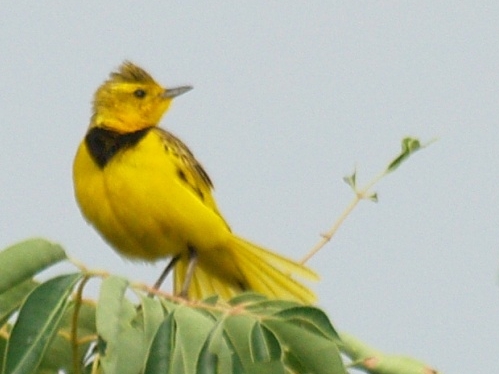
Wikipedia: Golden pipit Quelle: OTHER
Pipit_Golden_by_Mark_Tittley.jpg
![]() The golden pipit (Tmetothylacus tenellus) is a distinctive pipit of dry country grassland, savanna and shrubland in eastern Africa. It is native to Ethiopia, Kenya, Somalia, South Sudan, Tanzania and Uganda, and has occurred as a vagrant to Oman, South Africa and Zimbabwe.[1]
[more]
The golden pipit (Tmetothylacus tenellus) is a distinctive pipit of dry country grassland, savanna and shrubland in eastern Africa. It is native to Ethiopia, Kenya, Somalia, South Sudan, Tanzania and Uganda, and has occurred as a vagrant to Oman, South Africa and Zimbabwe.[1]
[more]

Wikipedia: Queen whydah Quelle: OTHER
Whydah_Shaft-tailed_2007_0107_1225_15AA.jpg
![]() Die Königswitwe (Vidua regia) ist eine afrikanische Vogelart aus der Familie der Witwenvögel (Viduidae). Wie alle Witwenvögel ist sie ein obligater Brutschmarotzer, der seinen Nachwuchs von Wirtseltern groß ziehen lässt. Parasitiert wird fast ausschließlich der Granatastrild, eine Art aus der Familie der Prachtfinken.
[more]
Die Königswitwe (Vidua regia) ist eine afrikanische Vogelart aus der Familie der Witwenvögel (Viduidae). Wie alle Witwenvögel ist sie ein obligater Brutschmarotzer, der seinen Nachwuchs von Wirtseltern groß ziehen lässt. Parasitiert wird fast ausschließlich der Granatastrild, eine Art aus der Familie der Prachtfinken.
[more]
Profil Wikipedia eBird Xeno-Canto

Wikipedia: Broad-tailed paradise-whydah Quelle: OTHER
Vidua_obtusa_male.jpg
![]() The broad-tailed paradise whydah (Vidua obtusa) is a species of bird in the family Viduidae.[2] It is found woodland and acacia savanna habitat in Sub-Saharan Africa from Angola to Uganda, Tanzania and Mozambique. A brood parasite, it has a wide range and the International Union for Conservation of Nature has assessed it as being of least concern.
[more]
The broad-tailed paradise whydah (Vidua obtusa) is a species of bird in the family Viduidae.[2] It is found woodland and acacia savanna habitat in Sub-Saharan Africa from Angola to Uganda, Tanzania and Mozambique. A brood parasite, it has a wide range and the International Union for Conservation of Nature has assessed it as being of least concern.
[more]
Profil Wikipedia eBird Audubon AllAboutBirds Xeno-Canto
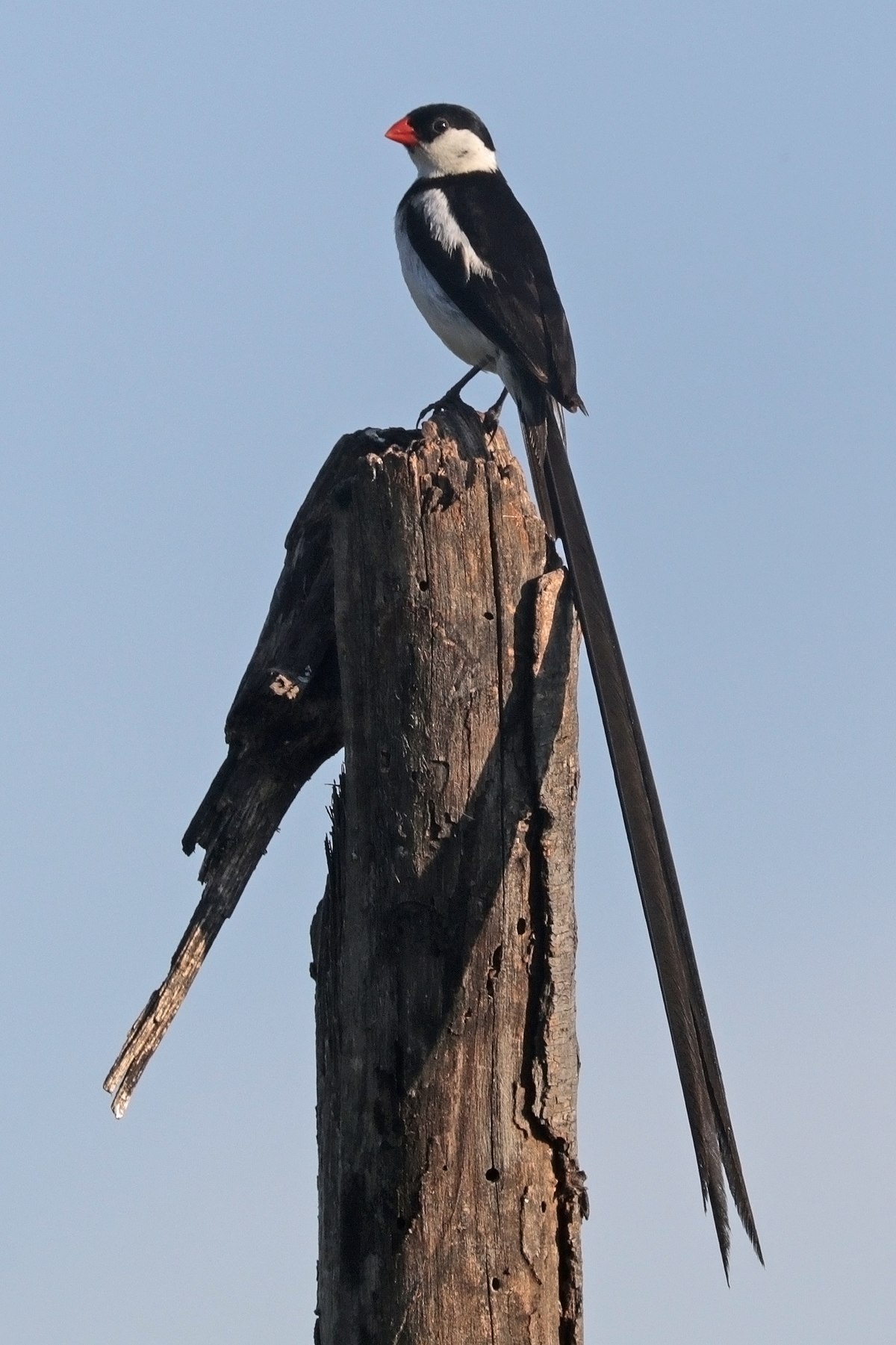
Wikipedia: Pin-tailed whydah Quelle: OTHER
1200px-Pin-tailed_whydah_%28Vidua_macroura%29_breeding_male.jpg
Dieser Vogel erscheint jenseits grossen Meere in Kontinenten :
Nordamerika, Afrika.
![]() Die Dominikanerwitwe (Vidua macroura) ist eine in Afrika beheimatete Vogelart aus der Familie der Witwenvögel (Viduidae), bei denen das Männchen in der Fortpflanzungszeit vier stark verlängerte Steuerfedern hat.
[more]
Die Dominikanerwitwe (Vidua macroura) ist eine in Afrika beheimatete Vogelart aus der Familie der Witwenvögel (Viduidae), bei denen das Männchen in der Fortpflanzungszeit vier stark verlängerte Steuerfedern hat.
[more]
Profil Wikipedia eBird Xeno-Canto

Wikipedia: Village indigobird Quelle: OTHER
1200px-Village_indigobird%2C_Vidua_chalybeata%2C_at_Mapungubwe_National_Park%2C_Limpopo%2C_South_Africa_%28male%29_%2817849716130%29.jpg
![]() Die Rotfuß-Atlaswitwe (Vidua chalybeata) ist ein in Subsahara-Afrika beheimateter Vogel aus der Familie der Witwenvögel. Innerhalb des großen Verbreitungsgebietes kommen mehrere Unterarten vor. Wie alle Witwenvögel ist die Rotfuß-Atlaswitwe ein obligater Brutschmarotzer, der seine Jungvogel vom Senegalamarant als einzige Wirtsvogelart groß ziehen lässt.
[more]
Die Rotfuß-Atlaswitwe (Vidua chalybeata) ist ein in Subsahara-Afrika beheimateter Vogel aus der Familie der Witwenvögel. Innerhalb des großen Verbreitungsgebietes kommen mehrere Unterarten vor. Wie alle Witwenvögel ist die Rotfuß-Atlaswitwe ein obligater Brutschmarotzer, der seine Jungvogel vom Senegalamarant als einzige Wirtsvogelart groß ziehen lässt.
[more]
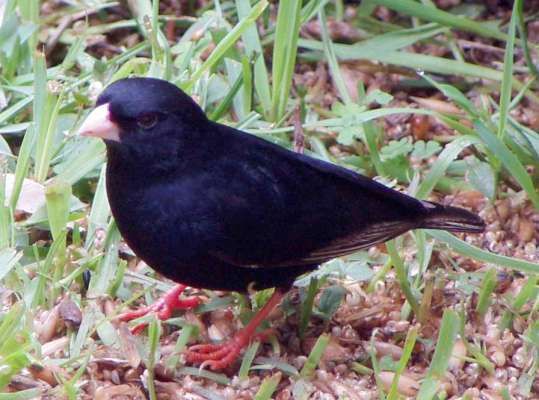
Wikipedia: Dusky indigobird Quelle: OTHER
Male_Variable_Indigobird_%28Vidua_funerea%29.jpg
![]() The dusky indigobird, variable indigobird, or black widowfinch (Vidua funerea) is a species of bird in the family Viduidae. It is found in Angola, Burundi, Cameroon, Republic of the Congo, Democratic Republic of the Congo, Guinea-Bissau, Malawi, Mozambique, Nigeria, Sierra Leone, South Africa, Swaziland, Tanzania, Zambia, and Zimbabwe. Its natural habitat is moist savanna.
[more]
The dusky indigobird, variable indigobird, or black widowfinch (Vidua funerea) is a species of bird in the family Viduidae. It is found in Angola, Burundi, Cameroon, Republic of the Congo, Democratic Republic of the Congo, Guinea-Bissau, Malawi, Mozambique, Nigeria, Sierra Leone, South Africa, Swaziland, Tanzania, Zambia, and Zimbabwe. Its natural habitat is moist savanna.
[more]
Profil Wikipedia eBird Xeno-Canto

Wikipedia: Variable indigobird Quelle: OTHER
Male_Variable_Indigobird_%28Vidua_funerea%29.jpg
![]() The dusky indigobird, variable indigobird, or black widowfinch (Vidua funerea) is a species of bird in the family Viduidae. It is found in Angola, Burundi, Cameroon, Republic of the Congo, Democratic Republic of the Congo, Guinea-Bissau, Malawi, Mozambique, Nigeria, Sierra Leone, South Africa, Swaziland, Tanzania, Zambia, and Zimbabwe. Its natural habitat is moist savanna.
[more]
The dusky indigobird, variable indigobird, or black widowfinch (Vidua funerea) is a species of bird in the family Viduidae. It is found in Angola, Burundi, Cameroon, Republic of the Congo, Democratic Republic of the Congo, Guinea-Bissau, Malawi, Mozambique, Nigeria, Sierra Leone, South Africa, Swaziland, Tanzania, Zambia, and Zimbabwe. Its natural habitat is moist savanna.
[more]
Profil Wikipedia eBird Audubon AllAboutBirds Xeno-Canto

Wikipedia: Bronze mannikin Quelle: OTHER
1200px-Bronze_Mannikin_%288568589949%29%2C_crop.jpg
Dieser Vogel erscheint jenseits grossen Meere in Kontinenten :
Nordamerika, Afrika.
![]() The bronze mannikin or bronze munia (Spermestes cucullata) is a small passerine (i.e. perching) bird of the Afrotropics. This very social estrildid finch is an uncommon to locally abundant bird in much of Africa south of the Sahara Desert, where it is resident, nomadic or irruptive in mesic savanna or forest margin habitats.[5][6] It has an estimated global extent of occurrence of 8,100,000 km2. It is the smallest and most widespread of four munia species on the African mainland, the other being black-and-white, red-backed and magpie mannikin. It co-occurs with the Madagascan mannikin on the Comoro Islands, and was introduced to Puerto Rico. Especially in the West Africa, it is considered a pest in grain and rice fields. It is locally trapped for the pet bird trade.[4]
[more]
The bronze mannikin or bronze munia (Spermestes cucullata) is a small passerine (i.e. perching) bird of the Afrotropics. This very social estrildid finch is an uncommon to locally abundant bird in much of Africa south of the Sahara Desert, where it is resident, nomadic or irruptive in mesic savanna or forest margin habitats.[5][6] It has an estimated global extent of occurrence of 8,100,000 km2. It is the smallest and most widespread of four munia species on the African mainland, the other being black-and-white, red-backed and magpie mannikin. It co-occurs with the Madagascan mannikin on the Comoro Islands, and was introduced to Puerto Rico. Especially in the West Africa, it is considered a pest in grain and rice fields. It is locally trapped for the pet bird trade.[4]
[more]
Wikipedia: Magpie mannikin Quelle: OTHER
Nonnetto.JPG
![]() The magpie mannikin or magpie munia (Spermestes fringilloides) is a species of estrildid finch, sparsely present across Sub-Saharan Africa. It has an estimated global extent of occurrence of 1,400,000 km².
[more]
The magpie mannikin or magpie munia (Spermestes fringilloides) is a species of estrildid finch, sparsely present across Sub-Saharan Africa. It has an estimated global extent of occurrence of 1,400,000 km².
[more]

Wikipedia: Black-and-white munia Quelle: OTHER
Black-and-white_Mannikin_%28Spermestes_bicolor%29_%287699911414%29%2C_crop.jpg
![]() The black-and-white mannikin (Spermestes bicolor) or black-and-white munia, is a species of estrildid finch, widely occurring throughout the African tropical rainforest. It has an estimated global extent of occurrence of 4,200,000 km2.
It is found in moist savanna and subtropical or tropical moist lowland forest habitat. The status of the species is evaluated as least concern. They are seedeaters, but are known to feed on algae.[3]
[more]
The black-and-white mannikin (Spermestes bicolor) or black-and-white munia, is a species of estrildid finch, widely occurring throughout the African tropical rainforest. It has an estimated global extent of occurrence of 4,200,000 km2.
It is found in moist savanna and subtropical or tropical moist lowland forest habitat. The status of the species is evaluated as least concern. They are seedeaters, but are known to feed on algae.[3]
[more]
Profil Wikipedia eBird Audubon AllAboutBirds Xeno-Canto NABU

Wikipedia: Common waxbill Quelle: OTHER
1200px-Estrilda_astrild_-Gran_Canaria%2C_Canary_Islands%2C_Spain-8_%281%29.jpg
Dieser Vogel erscheint jenseits grossen Meere in Kontinenten :
Europa, Nordamerika, Afrika.
![]() The common waxbill (Estrilda astrild), also known as the St Helena waxbill, is a small passerine bird belonging to the estrildid finch family. It is native to sub-Saharan Africa but has been introduced to many other regions of the world and now has an estimated global extent of occurrence of 10,000,000 km2. It is popular and easy to keep in captivity.
[more]
The common waxbill (Estrilda astrild), also known as the St Helena waxbill, is a small passerine bird belonging to the estrildid finch family. It is native to sub-Saharan Africa but has been introduced to many other regions of the world and now has an estimated global extent of occurrence of 10,000,000 km2. It is popular and easy to keep in captivity.
[more]
Profil Wikipedia eBird Xeno-Canto

Wikipedia: Black-tailed waxbill Quelle: OTHER
1200px-Black-tailed_Waxbill%2C_Sakania%2C_DRC_%288085664974%29.jpg
![]() Der Schwarzschwanz-Schönbürzel (Estrilda perreini), auch Pereins Astrild genannt, ist eine afrikanische Art aus der Familie der Prachtfinken. Für die Art werden zwei Unterarten unterschieden.
[more]
Der Schwarzschwanz-Schönbürzel (Estrilda perreini), auch Pereins Astrild genannt, ist eine afrikanische Art aus der Familie der Prachtfinken. Für die Art werden zwei Unterarten unterschieden.
[more]

Wikipedia: Black-cheeked waxbill Quelle: OTHER
Crimson-rumped_Waxbill_specimen_RWD.jpg
![]() The black-cheeked waxbill or red-rumped waxbill (Brunhilda charmosyna) is a common species of estrildid finch found in east Africa. It has an estimated global extent of occurrence of 400,000 km2.
[more]
The black-cheeked waxbill or red-rumped waxbill (Brunhilda charmosyna) is a common species of estrildid finch found in east Africa. It has an estimated global extent of occurrence of 400,000 km2.
[more]
Profil Wikipedia eBird Xeno-Canto

Wikipedia: Swee waxbill Quelle: OTHER
1200px-Swee_Waxbill_-_Natal_-_South_Africa_S4E7543_%2822568979507%29.jpg
![]() The swee waxbill (Coccopygia melanotis), is a common species of estrildid finch native to Southern Africa.
[more]
The swee waxbill (Coccopygia melanotis), is a common species of estrildid finch native to Southern Africa.
[more]
Profil Wikipedia eBird Xeno-Canto

Wikipedia: Peters's twinspot Quelle: OTHER
1200px-Peters%27s_Twinspot%2C_Sakania%2C_DRC_%289999020853%29.jpg
![]() The red-throated twinspot (Hypargos niveoguttatus) or Peters's twinspot is a common species of bird found in sub-saharan Africa. This species has a large range, with an estimated global extent of occurrence of 2,000,000 km2.
[more]
The red-throated twinspot (Hypargos niveoguttatus) or Peters's twinspot is a common species of bird found in sub-saharan Africa. This species has a large range, with an estimated global extent of occurrence of 2,000,000 km2.
[more]
Profil Wikipedia eBird Xeno-Canto

Wikipedia: Pink-throated twinspot Quelle: OTHER
Hypargos_margaritatus_-Mkhuze_Game_Reserve_-South_Africa-8.jpg
![]() The pink-throated twinspot (Hypargos margaritatus) is an estrildid finch. It inhabits dry savanna and moist, subtropical/tropical (lowland) shrubland habitats near the southeast African coast in Mozambique, South Africa and Swaziland. It has a large range, with an estimated global extent of occurrence of 160,000 km².[2]
[more]
The pink-throated twinspot (Hypargos margaritatus) is an estrildid finch. It inhabits dry savanna and moist, subtropical/tropical (lowland) shrubland habitats near the southeast African coast in Mozambique, South Africa and Swaziland. It has a large range, with an estimated global extent of occurrence of 160,000 km².[2]
[more]
Profil Wikipedia eBird Xeno-Canto

Wikipedia: Red-billed firefinch Quelle: OTHER
1200px-Red-billed_firefinch_%28Lagonosticta_senegala_senegala%29_male.jpg
![]() Der Senegalamarant (Lagonosticta senegala) ist eine afrikanische Vogelart aus der Familie der Prachtfinken (Estrildidae), der einen großen Teil der Afrotropis besiedelt. Die Art wird heute in sechs Unterarten unterschieden. In älterer Literatur finden sich auch mehr Unterarten aufgeführt.[1]
[more]
Der Senegalamarant (Lagonosticta senegala) ist eine afrikanische Vogelart aus der Familie der Prachtfinken (Estrildidae), der einen großen Teil der Afrotropis besiedelt. Die Art wird heute in sechs Unterarten unterschieden. In älterer Literatur finden sich auch mehr Unterarten aufgeführt.[1]
[more]
Profil Wikipedia eBird Xeno-Canto
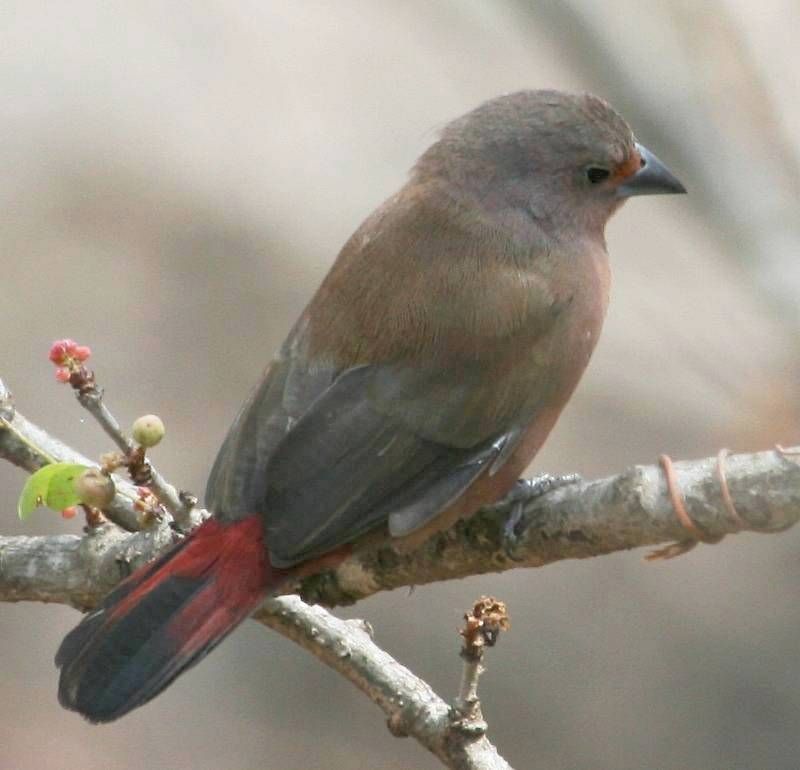
Wikipedia: Jameson's firefinch Quelle: OTHER
Female_Jamesons_Firefinch_%28Lagonosticta_rhodopareia%29.jpg
![]() Der Rosenamarant (Lagonosticta rhodopareia), auch Jamesonamarant oder Jamesons Amarant genannt, ist eine afrikanische Vogelart aus der Familie der Prachtfinken (Estrildidae).
[more]
Der Rosenamarant (Lagonosticta rhodopareia), auch Jamesonamarant oder Jamesons Amarant genannt, ist eine afrikanische Vogelart aus der Familie der Prachtfinken (Estrildidae).
[more]
Profil Wikipedia eBird Xeno-Canto

Wikipedia: African firefinch Quelle: OTHER
1200px-Firefinch_African_2017_07_02_11_45_37_0106c.jpg
![]() Der Dunkelrote Amarant (Lagonosticta rubricata), auch Dunkelamarant, Dunkelroter Astrild oder Hellroter Astrild genannt, ist ein Vogel aus der Familie der Prachtfinken (Estrildidae). Sein Verbreitungsgebiet ist West-, Ost- und Zentralafrika.
[more]
Der Dunkelrote Amarant (Lagonosticta rubricata), auch Dunkelamarant, Dunkelroter Astrild oder Hellroter Astrild genannt, ist ein Vogel aus der Familie der Prachtfinken (Estrildidae). Sein Verbreitungsgebiet ist West-, Ost- und Zentralafrika.
[more]
Profil Wikipedia eBird Xeno-Canto

Wikipedia: Quailfinch Quelle: OTHER
Flickr_-_Rainbirder_-_African_Quailfinch_%28Ortygospiza_atricollis%29_male.jpg
![]() Der Wachtelastrild (Ortygospiza atricollis) ist eine afrikanische Art aus der Familie der Prachtfinken (Erstrildidae). Er ist ein ausgesprochener Bodenvogel, der sich nur selten wie andere Prachtfinken auf Zweige oder Grashalme setzt. Wie sein Name andeutet, bewegt er sich meist wachtelartig laufend, gelegentlich auch hüpfend zwischen Grasbüscheln fort.[1]
[more]
Der Wachtelastrild (Ortygospiza atricollis) ist eine afrikanische Art aus der Familie der Prachtfinken (Erstrildidae). Er ist ein ausgesprochener Bodenvogel, der sich nur selten wie andere Prachtfinken auf Zweige oder Grashalme setzt. Wie sein Name andeutet, bewegt er sich meist wachtelartig laufend, gelegentlich auch hüpfend zwischen Grasbüscheln fort.[1]
[more]
Profil Wikipedia eBird Xeno-Canto
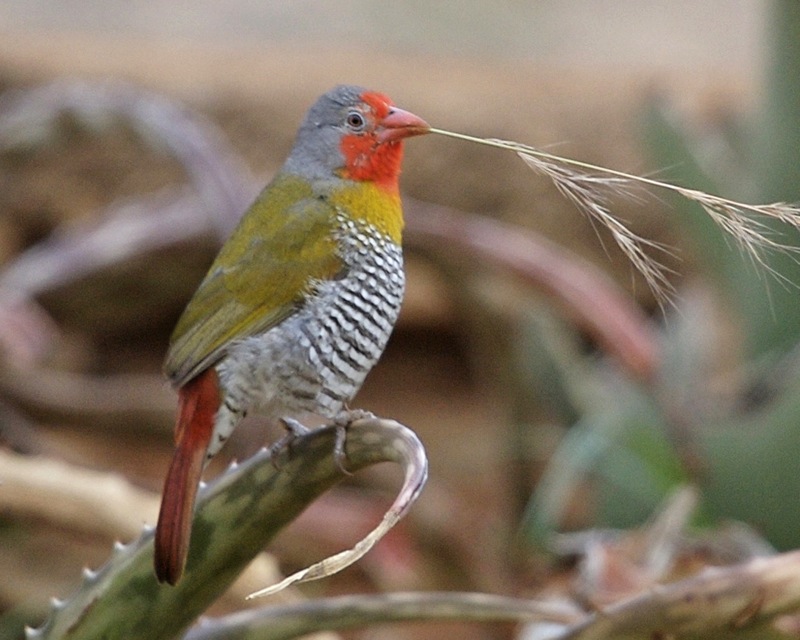
Wikipedia: Green-winged pytilia Quelle: OTHER
Green-winged_Pytilia_%28Pytilia_melba%29.jpg
![]() The green-winged pytilia (Pytilia melba) is a common species of estrildid finch found in Africa. It has an estimated global extent of occurrence of 6,000,000 square kilometres (2,300,000 sq mi).[2]
[more]
The green-winged pytilia (Pytilia melba) is a common species of estrildid finch found in Africa. It has an estimated global extent of occurrence of 6,000,000 square kilometres (2,300,000 sq mi).[2]
[more]
Profil Wikipedia eBird Xeno-Canto

Wikipedia: Orange-winged pytilia Quelle: OTHER
1200px-PytiliaAfraSmit.jpg
![]() Der Wienerastrild (Pytilia afra), auch Wieners Astrild oder Sansibarfink genannt, ist eine afrikanische Art in der Familie der Prachtfinken. Es sind keine Unterarten beschrieben. Wienerastrilde werden in Europa gelegentlich als Ziervogel gehalten.
[more]
Der Wienerastrild (Pytilia afra), auch Wieners Astrild oder Sansibarfink genannt, ist eine afrikanische Art in der Familie der Prachtfinken. Es sind keine Unterarten beschrieben. Wienerastrilde werden in Europa gelegentlich als Ziervogel gehalten.
[more]
Blue waxbill copy. 2016-09-28 06.54.58 Botswana
Zuerst beobachtet in Botswana an 2016-09-28.
![]() Der Angola-Schmetterlingsfink (Uraeginthus angolensis), auch Blauastrild oder Blauohriger Schmetterlingsfink genannt, ist eine afrikanische Art aus der Familie der Prachtfinken.
[more]
Der Angola-Schmetterlingsfink (Uraeginthus angolensis), auch Blauastrild oder Blauohriger Schmetterlingsfink genannt, ist eine afrikanische Art aus der Familie der Prachtfinken.
[more]
Profil Wikipedia eBird Xeno-Canto

Wikipedia: Green-backed twinspot Quelle: OTHER
1200px-PyteliaNitidulaGronvold.jpg
![]() Der Grüne Tropfenastrild (Mandingoa nitidula), auch Tropfengrünastrild, Grüner Tropfenfink oder Schlegels Tropfenfink genannt, ist eine afrikanische Art aus der Familie der Prachtfinken. Er ist der einzige rezente Vertreter der Glockenastrilde und in der Afrotropis ein weit verbreiteter und stellenweise auch häufiger Vogel. Grüne Tropfenastrilde sind kleine, grünlich gefiederte Vögel mit einem kurzen Schwanz und einem rötlichen Gesichtsmaske. Der Sexualdimorphismus ist nur geringfügig ausgeprägt. Sie werden in Europa gelegentlich als Ziervogel gehalten, gelten aber wegen ihrer Nahrungs- und Halteanforderungen als schwierig zu pflegende Vögel.
[more]
Der Grüne Tropfenastrild (Mandingoa nitidula), auch Tropfengrünastrild, Grüner Tropfenfink oder Schlegels Tropfenfink genannt, ist eine afrikanische Art aus der Familie der Prachtfinken. Er ist der einzige rezente Vertreter der Glockenastrilde und in der Afrotropis ein weit verbreiteter und stellenweise auch häufiger Vogel. Grüne Tropfenastrilde sind kleine, grünlich gefiederte Vögel mit einem kurzen Schwanz und einem rötlichen Gesichtsmaske. Der Sexualdimorphismus ist nur geringfügig ausgeprägt. Sie werden in Europa gelegentlich als Ziervogel gehalten, gelten aber wegen ihrer Nahrungs- und Halteanforderungen als schwierig zu pflegende Vögel.
[more]

Wikipedia: Red-headed finch Quelle: OTHER
1200px-Amadina_erythrocephala_%28l%29_edit.jpg
![]() The red-headed finch (Amadina erythrocephala) (also known as the paradise finch or the red-headed weaver) is a common species of estrildid finch found in Africa. It has an estimated global extent of occurrence of 1,600,000 km2. It is found in Angola, Botswana, Lesotho, Namibia, South Africa and Zimbabwe.
[more]
The red-headed finch (Amadina erythrocephala) (also known as the paradise finch or the red-headed weaver) is a common species of estrildid finch found in Africa. It has an estimated global extent of occurrence of 1,600,000 km2. It is found in Angola, Botswana, Lesotho, Namibia, South Africa and Zimbabwe.
[more]

Wikipedia: Malachite sunbird Quelle: OTHER
Nectarinia_famosa_%28Malachite_Sunbird%29.jpg
![]() Der Malachit-Nektarvogel (Nectarinia famosa) ist ein zur Familie der Nektarvögel gehörender Vogel. Er kommt in den zwei Unterarten Nectarinia famosa famosa (Linné, 1766) und Nectarinia famosa cupreonitens (Shelley, 1876) vor.
[more]
Der Malachit-Nektarvogel (Nectarinia famosa) ist ein zur Familie der Nektarvögel gehörender Vogel. Er kommt in den zwei Unterarten Nectarinia famosa famosa (Linné, 1766) und Nectarinia famosa cupreonitens (Shelley, 1876) vor.
[more]
Profil Wikipedia eBird Xeno-Canto

Wikipedia: Plain-backed sunbird Quelle: OTHER
Flickr_-_Rainbirder_-_Plain-backed_Sunbird_male_%28Anthreptes_reichenowi%29.jpg
![]() The plain-backed sunbird, also known as blue-throated sunbird (Anthreptes reichenowi) is a sunbird. The sunbirds are a group of very small Old World passerine birds which feed largely on nectar, although they will also take insects, especially when feeding young. Flight is fast and direct on their short wings. Most species can take nectar by hovering like a hummingbird, but usually perch to feed most of the time.
[more]
The plain-backed sunbird, also known as blue-throated sunbird (Anthreptes reichenowi) is a sunbird. The sunbirds are a group of very small Old World passerine birds which feed largely on nectar, although they will also take insects, especially when feeding young. Flight is fast and direct on their short wings. Most species can take nectar by hovering like a hummingbird, but usually perch to feed most of the time.
[more]
Profil Wikipedia eBird Xeno-Canto

Wikipedia: Cape sugarbird Quelle: OTHER
Cape_Sugarbird_%28Promerops_cafer%29.jpg
![]() The Cape sugarbird (Promerops cafer)[2] is one of the eight bird species endemic to the Fynbos biome of the Western Cape and Eastern Cape provinces of South Africa.[3]
[more]
The Cape sugarbird (Promerops cafer)[2] is one of the eight bird species endemic to the Fynbos biome of the Western Cape and Eastern Cape provinces of South Africa.[3]
[more]
Profil Wikipedia eBird Xeno-Canto

Wikipedia: Gurney's sugarbird Quelle: OTHER
1200px-Gurney%27s_Sugarbird_%28Promerops_gurneyi%29.jpg
![]() Gurney's sugarbird has a long, decurved bill characteristic of nectarivores. It has a chestnut-coloured forehead, along with a faint white eyestripe and white mustachial stripe.[1] A white throat stands out against the russet breast.[1] This species of sugarbird has a dark grey back, and a conspicuous bright yellow rump makes this bird easy to spot.[1] The tail is long and graduated, ranging from 11 to 19.3 cm in length.[1] This species measures between 23 and 29 cm in total, and body mass ranges from 30 to 46.5 g in males and 23 to 43 g in females.[1] Females are smaller than males, with shorter bills and tail feathers.[4] Males also have triangular-shaped bulge on the sixth primary feather, used in mating displays.[5] Immature individuals are duller than adults and have a greenish tinge to both their breast and yellow rump.[1] Further, their secondary feathers are edged with a brownish colour.[1]
[more]
Gurney's sugarbird has a long, decurved bill characteristic of nectarivores. It has a chestnut-coloured forehead, along with a faint white eyestripe and white mustachial stripe.[1] A white throat stands out against the russet breast.[1] This species of sugarbird has a dark grey back, and a conspicuous bright yellow rump makes this bird easy to spot.[1] The tail is long and graduated, ranging from 11 to 19.3 cm in length.[1] This species measures between 23 and 29 cm in total, and body mass ranges from 30 to 46.5 g in males and 23 to 43 g in females.[1] Females are smaller than males, with shorter bills and tail feathers.[4] Males also have triangular-shaped bulge on the sixth primary feather, used in mating displays.[5] Immature individuals are duller than adults and have a greenish tinge to both their breast and yellow rump.[1] Further, their secondary feathers are edged with a brownish colour.[1]
[more]

Wikipedia: Mouse-coloured sunbird Quelle: OTHER
Sunbird_Grey_2010_07_17_09_Alan_Manson_Queen_Elizabeth_Park.jpg
![]() The grey sunbird or mouse-coloured sunbird (Cyanomitra verreauxii) is a species of bird in the family Nectariniidae.
It is found in Kenya, Malawi, Mozambique, Somalia, South Africa, Swaziland, and Tanzania.
[more]
The grey sunbird or mouse-coloured sunbird (Cyanomitra verreauxii) is a species of bird in the family Nectariniidae.
It is found in Kenya, Malawi, Mozambique, Somalia, South Africa, Swaziland, and Tanzania.
[more]

Wikipedia: Olive sunbird Quelle: OTHER
Eastern_Olive_Sunbird_%28Nectarinia_olivacea%29.jpg
![]() The olive sunbird (Cyanomitra olivacea) is a species of sunbird found in a large part of Africa south of the Sahel. It prefers forested regions, and is absent from drier, more open regions such as the Horn of Africa and most of south-central and south-western Africa. It is sometimes placed in the genus Nectarinia.
[more]
The olive sunbird (Cyanomitra olivacea) is a species of sunbird found in a large part of Africa south of the Sahel. It prefers forested regions, and is absent from drier, more open regions such as the Horn of Africa and most of south-central and south-western Africa. It is sometimes placed in the genus Nectarinia.
[more]
Profil Wikipedia eBird Xeno-Canto

Wikipedia: Scarlet-chested sunbird Quelle: OTHER
1200px-Scarlet-chested_sunbird%2C_Chalcomitra_senegalensis%2C_at_Lake_Chivero%2C_Harare%2C_Zimbabwe_-_male_%2821247780653%29.jpg
![]() The scarlet-chested sunbird (Chalcomitra senegalensis) is a species of bird in the family Nectariniidae. It is found in Angola, Benin, Botswana, Burkina Faso, Burundi, Cameroon, Central African Republic, Chad, Democratic Republic of the Congo, Ivory Coast, Eritrea, Ethiopia, Gambia, Ghana, Guinea, Guinea-Bissau, Kenya, Malawi, Mali, Mauritania, Mozambique, Namibia, Niger, Nigeria, Rwanda, Senegal, Sierra Leone, South Africa, Sudan, Swaziland, Tanzania, Togo, Uganda, Zambia, and Zimbabwe.
[more]
The scarlet-chested sunbird (Chalcomitra senegalensis) is a species of bird in the family Nectariniidae. It is found in Angola, Benin, Botswana, Burkina Faso, Burundi, Cameroon, Central African Republic, Chad, Democratic Republic of the Congo, Ivory Coast, Eritrea, Ethiopia, Gambia, Ghana, Guinea, Guinea-Bissau, Kenya, Malawi, Mali, Mauritania, Mozambique, Namibia, Niger, Nigeria, Rwanda, Senegal, Sierra Leone, South Africa, Sudan, Swaziland, Tanzania, Togo, Uganda, Zambia, and Zimbabwe.
[more]
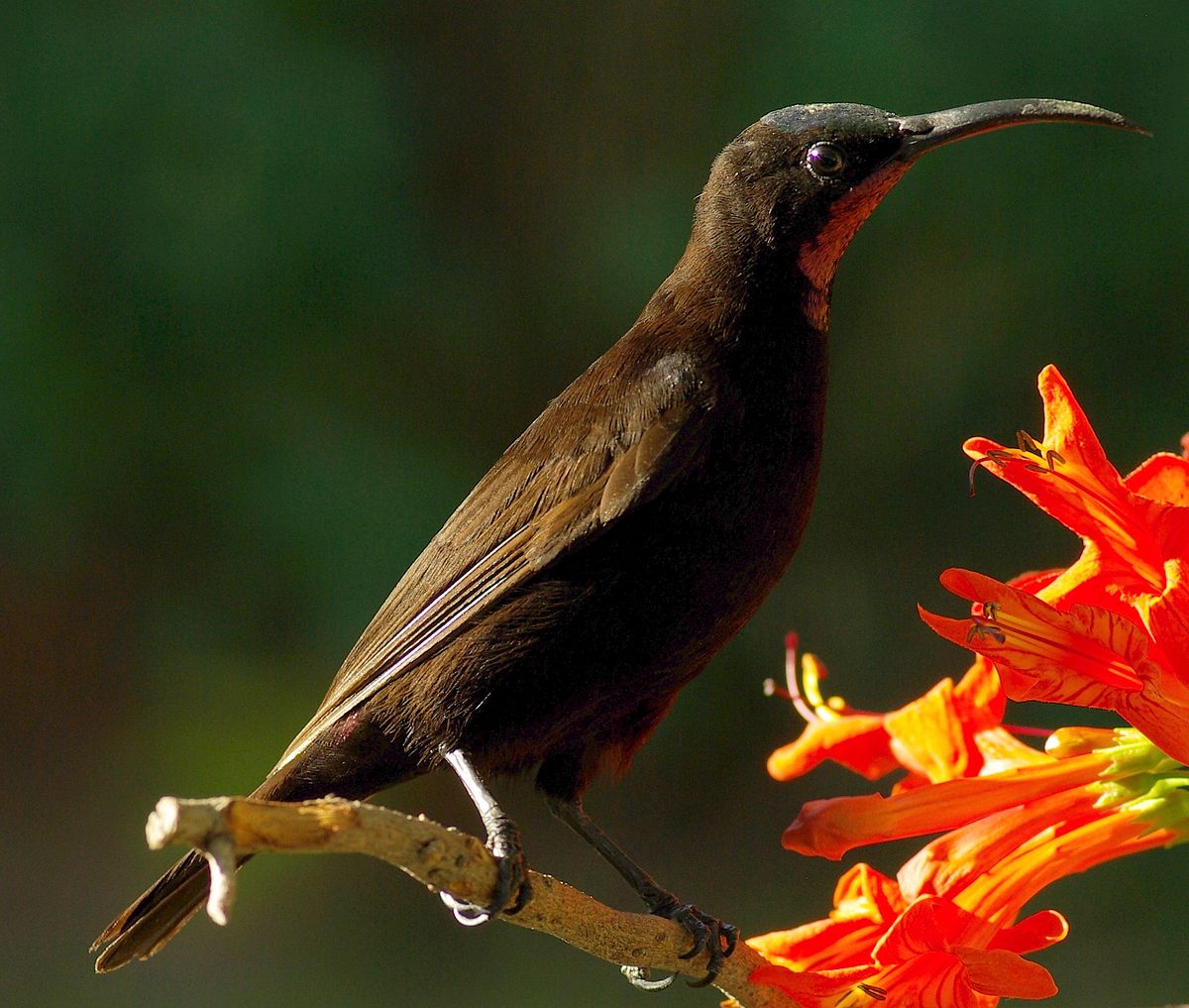
Wikipedia: Amethyst sunbird Quelle: OTHER
1200px-Amethyst_sunbird.jpg
![]() The amethyst sunbird, also called the black sunbird (Chalcomitra amethystina), is a species of passerine bird in the family Nectariniidae. It is native to the Afrotropics, mostly south of the equator.[2] They are commonly found in well-watered habitats, and undertake seasonal movements to visit flowering woodlands. The demise of some woodlands have impacted their numbers locally, but their range has also expanded along with the spread of wooded gardens.
[more]
The amethyst sunbird, also called the black sunbird (Chalcomitra amethystina), is a species of passerine bird in the family Nectariniidae. It is native to the Afrotropics, mostly south of the equator.[2] They are commonly found in well-watered habitats, and undertake seasonal movements to visit flowering woodlands. The demise of some woodlands have impacted their numbers locally, but their range has also expanded along with the spread of wooded gardens.
[more]
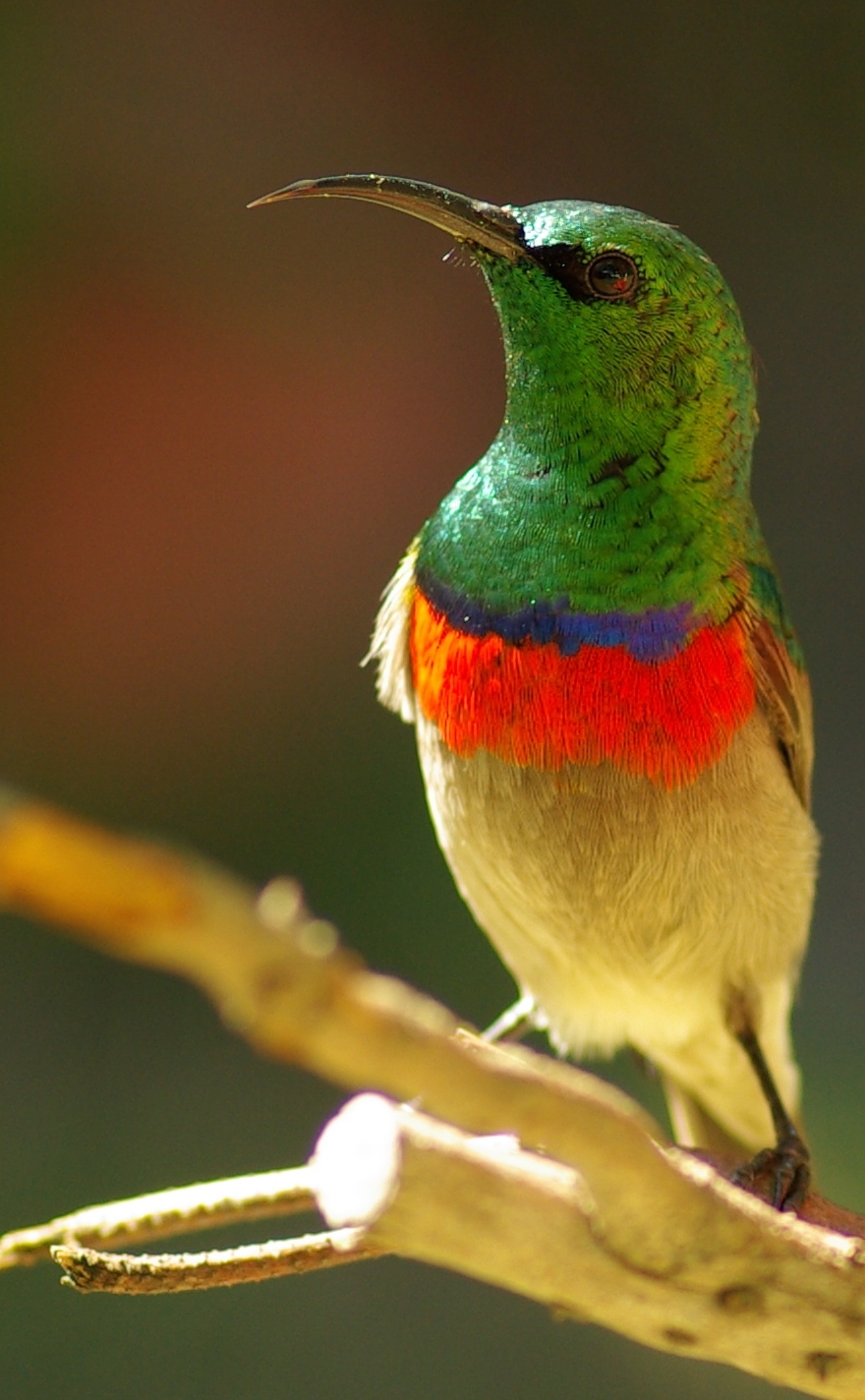
Wikipedia: Southern double-collared sunbird Quelle: OTHER
Lesser_Double-collared_sunbird.jpg
![]() Der Miombonektarvogel (Cinnyris chalybeus, Syn.: Nectarinia chalybea), auch Blaubandnektarvogel[1], gehört der Familie der Nektarvögel (Nectariniidae) an.
[more]
Der Miombonektarvogel (Cinnyris chalybeus, Syn.: Nectarinia chalybea), auch Blaubandnektarvogel[1], gehört der Familie der Nektarvögel (Nectariniidae) an.
[more]

Wikipedia: Greater double-collared sunbird Quelle: OTHER
1200px-Greater_Double-collared_sunbird.jpg
![]() The greater double-collared sunbird (Cinnyris afer) (formerly placed in the genus Nectarinia), is a small bird in the sunbird family.
[more]
The greater double-collared sunbird (Cinnyris afer) (formerly placed in the genus Nectarinia), is a small bird in the sunbird family.
[more]
Profil Wikipedia eBird Xeno-Canto

Wikipedia: Dusky sunbird Quelle: OTHER
Nectarinia_fusca_-Northern_Cape%2C_South_Africa-8.jpg
![]() The dusky sunbird (Cinnyris fuscus) is a species of bird in the family Nectariniidae. This relatively dull sunbird is found in arid savanna, thickets and shrubland (e.g. Karoo) in Angola, Botswana, Namibia, and South Africa.
[more]
The dusky sunbird (Cinnyris fuscus) is a species of bird in the family Nectariniidae. This relatively dull sunbird is found in arid savanna, thickets and shrubland (e.g. Karoo) in Angola, Botswana, Namibia, and South Africa.
[more]
Profil Wikipedia eBird Xeno-Canto

Wikipedia: Neergaard's sunbird Quelle: OTHER
1200px-CinnyrisNeergaardiGronvold.jpg
![]() Neergaard's sunbird (Cinnyris neergaardi) is a species of bird in the family Nectariniidae. It is found in Mozambique and South Africa. Its natural habitat is subtropical or tropical dry forest near the coast, where it is threatened by habitat loss. It is named after Paul Neergaard, a Danish recruiting officer for the Wenela agency, who was stationed in southern Mozambique.[5][6]
[more]
Neergaard's sunbird (Cinnyris neergaardi) is a species of bird in the family Nectariniidae. It is found in Mozambique and South Africa. Its natural habitat is subtropical or tropical dry forest near the coast, where it is threatened by habitat loss. It is named after Paul Neergaard, a Danish recruiting officer for the Wenela agency, who was stationed in southern Mozambique.[5][6]
[more]

Wikipedia: Mariqua sunbird Quelle: OTHER
1200px-Marico_sunbird%2C_Cinnyris_mariquensis_%28male%29_at_Marakele_National_Park%2C_Limpopo%2C_South_Africa_%2816301138095%29.jpg
![]() It is found in Angola, Botswana, Burundi, Eritrea, Ethiopia, Kenya, Mozambique, Namibia, Rwanda, Somalia, South Africa, South Sudan, Swaziland, Tanzania, Uganda, Zambia, and Zimbabwe.[1]
[more]
It is found in Angola, Botswana, Burundi, Eritrea, Ethiopia, Kenya, Mozambique, Namibia, Rwanda, Somalia, South Africa, South Sudan, Swaziland, Tanzania, Uganda, Zambia, and Zimbabwe.[1]
[more]
Profil Wikipedia eBird Xeno-Canto

Wikipedia: Purple-banded sunbird Quelle: OTHER
Purple-banded_Sunbird_%28Cinnyris_bifasciatus%29.jpg
![]() The purple-banded sunbird (Cinnyris bifasciatus) is a species of bird in the family Nectariniidae.
It is found in Angola, Botswana, Republic of the Congo, Democratic Republic of the Congo, Ethiopia, Gabon, Kenya, Malawi, Mozambique, Namibia, Rwanda, Somalia, South Africa, Swaziland, Tanzania, Uganda, Zambia, and Zimbabwe.
[more]
The purple-banded sunbird (Cinnyris bifasciatus) is a species of bird in the family Nectariniidae.
It is found in Angola, Botswana, Republic of the Congo, Democratic Republic of the Congo, Ethiopia, Gabon, Kenya, Malawi, Mozambique, Namibia, Rwanda, Somalia, South Africa, Swaziland, Tanzania, Uganda, Zambia, and Zimbabwe.
[more]

Wikipedia: Variable sunbird
![]() Der Ziernektarvogel oder Gelbbauch-Nektarvogel (Cinnyris venustus (ehem. Nectarinia venusta)) ist ein Singvogel aus der Gattung Cinnyris in der Familie der Nektarvögel (Nectariniidae).
[more]
Der Ziernektarvogel oder Gelbbauch-Nektarvogel (Cinnyris venustus (ehem. Nectarinia venusta)) ist ein Singvogel aus der Gattung Cinnyris in der Familie der Nektarvögel (Nectariniidae).
[more]

Wikipedia: Orange-breasted sunbird Quelle: OTHER
1200px-SunBird_capetown.jpg
![]() The orange-breasted sunbird (Anthobaphes violacea) is the only member of the bird genus Anthobaphes; however, it is sometimes placed in the genus Nectarinia. This sunbird is endemic to the fynbos habitat of southwestern South Africa. They are sexually dimorphic with females being olive green while the males are orange to yellow on the underside with bright green, blue and purple on the head and neck.
[more]
The orange-breasted sunbird (Anthobaphes violacea) is the only member of the bird genus Anthobaphes; however, it is sometimes placed in the genus Nectarinia. This sunbird is endemic to the fynbos habitat of southwestern South Africa. They are sexually dimorphic with females being olive green while the males are orange to yellow on the underside with bright green, blue and purple on the head and neck.
[more]
Profil Wikipedia eBird Xeno-Canto

Wikipedia: Southern brown-throated weaver Quelle: OTHER
Southern_Brown-throated_Weaver_-_Malawi_S4E3666_%2822836900792%29.jpg
![]() Der Braunkehlweber (Ploceus xanthopterus, Syn.: Loxia xanthopterus) zählt innerhalb der Familie der Webervögel (Ploceidae) zur Gattung der Ammerweber (Ploceus).[1]
[more]
Der Braunkehlweber (Ploceus xanthopterus, Syn.: Loxia xanthopterus) zählt innerhalb der Familie der Webervögel (Ploceidae) zur Gattung der Ammerweber (Ploceus).[1]
[more]
Profil Wikipedia eBird Xeno-Canto

Wikipedia: Cape weaver Quelle: OTHER
Ploceus_capensis_-Johannesburg%2C_South_Africa_-male-8.jpg
![]() The Cape weaver (Ploceus capensis) is a species of bird in the weaver family, Ploceidae, found in southern Africa.
[more]
The Cape weaver (Ploceus capensis) is a species of bird in the weaver family, Ploceidae, found in southern Africa.
[more]
Profil Wikipedia eBird Xeno-Canto

Wikipedia: Chestnut weaver Quelle: OTHER
1200px-Chestnut_weaver_%28Ploceus_rubiginosus%29_male.jpg
![]() The chestnut weaver (Ploceus rubiginosus) is a species of bird in the family Ploceidae.
It is found in eastern and south-western Africa.
[more]
The chestnut weaver (Ploceus rubiginosus) is a species of bird in the family Ploceidae.
It is found in eastern and south-western Africa.
[more]
Profil Wikipedia eBird Xeno-Canto

Wikipedia: Holub's golden-weaver Quelle: OTHER
1200px-Holub%27s_golden_weaver_%28Ploceus_xanthops%29_%2822561083782%29.jpg
![]() Der Safranweber (Ploceus xanthops, Syn.: Hyphantornis xanthops) zählt innerhalb der Familie der Webervögel (Ploceidae) zur Gattung der Ammerweber (Ploceus).[1]
[more]
Der Safranweber (Ploceus xanthops, Syn.: Hyphantornis xanthops) zählt innerhalb der Familie der Webervögel (Ploceidae) zur Gattung der Ammerweber (Ploceus).[1]
[more]

Wikipedia: Lesser masked weaver Quelle: OTHER
Lesser_Masked_Weaver_-_Baringo_-_Kenya_NH8O1107_%2822662509730%29.jpg
![]() Der Cabanisweber (Ploceus intermedius, Syn.: Loxia intermedius) zählt innerhalb der Familie der Webervögel (Ploceidae) zur Gattung der Ammerweber (Ploceus).[1]
[more]
Der Cabanisweber (Ploceus intermedius, Syn.: Loxia intermedius) zählt innerhalb der Familie der Webervögel (Ploceidae) zur Gattung der Ammerweber (Ploceus).[1]
[more]
Probably a village weaver near Addo Elephant Park. 2009-10-25 11.59.10 Gqeberha (frueher Port Elisabeth)
Zuerst beobachtet in Gqeberha (frueher Port Elisabeth) an 2009-10-20.
![]() The village weaver (Ploceus cucullatus), also known as the spotted-backed weaver or black-headed weaver (the latter leading to easy confusion with P. melanocephalus), is a species of bird in the family Ploceidae found in much of sub-Saharan Africa. It has also been introduced to Hispaniola, Mauritius and Réunion.[1]
[more]
The village weaver (Ploceus cucullatus), also known as the spotted-backed weaver or black-headed weaver (the latter leading to easy confusion with P. melanocephalus), is a species of bird in the family Ploceidae found in much of sub-Saharan Africa. It has also been introduced to Hispaniola, Mauritius and Réunion.[1]
[more]
Profil Wikipedia eBird Xeno-Canto

Wikipedia: Forest weaver Quelle: OTHER
1200px-Dark-backed_weaver%2C_Ploceus_bicolor%2C_also_known_as_the_forest_weaver_at_Ndumo_Nature_Reserve%2C_KwaZulu-Natal%2C_South_Africa_%2828841131011%29.jpg
![]() The dark-backed weaver (Ploceus bicolor), also known as the forest weaver, is a species of bird in the family Ploceidae.
It is found in Angola, Burundi, Cameroon, Republic of the Congo, Democratic Republic of the Congo, Equatorial Guinea, Eswatini, Gabon, Kenya, Malawi, Mozambique, Nigeria, Rwanda, Somalia, South Africa, South Sudan, Tanzania, Uganda, Zambia, and Zimbabwe.
[more]
The dark-backed weaver (Ploceus bicolor), also known as the forest weaver, is a species of bird in the family Ploceidae.
It is found in Angola, Burundi, Cameroon, Republic of the Congo, Democratic Republic of the Congo, Equatorial Guinea, Eswatini, Gabon, Kenya, Malawi, Mozambique, Nigeria, Rwanda, Somalia, South Africa, South Sudan, Tanzania, Uganda, Zambia, and Zimbabwe.
[more]
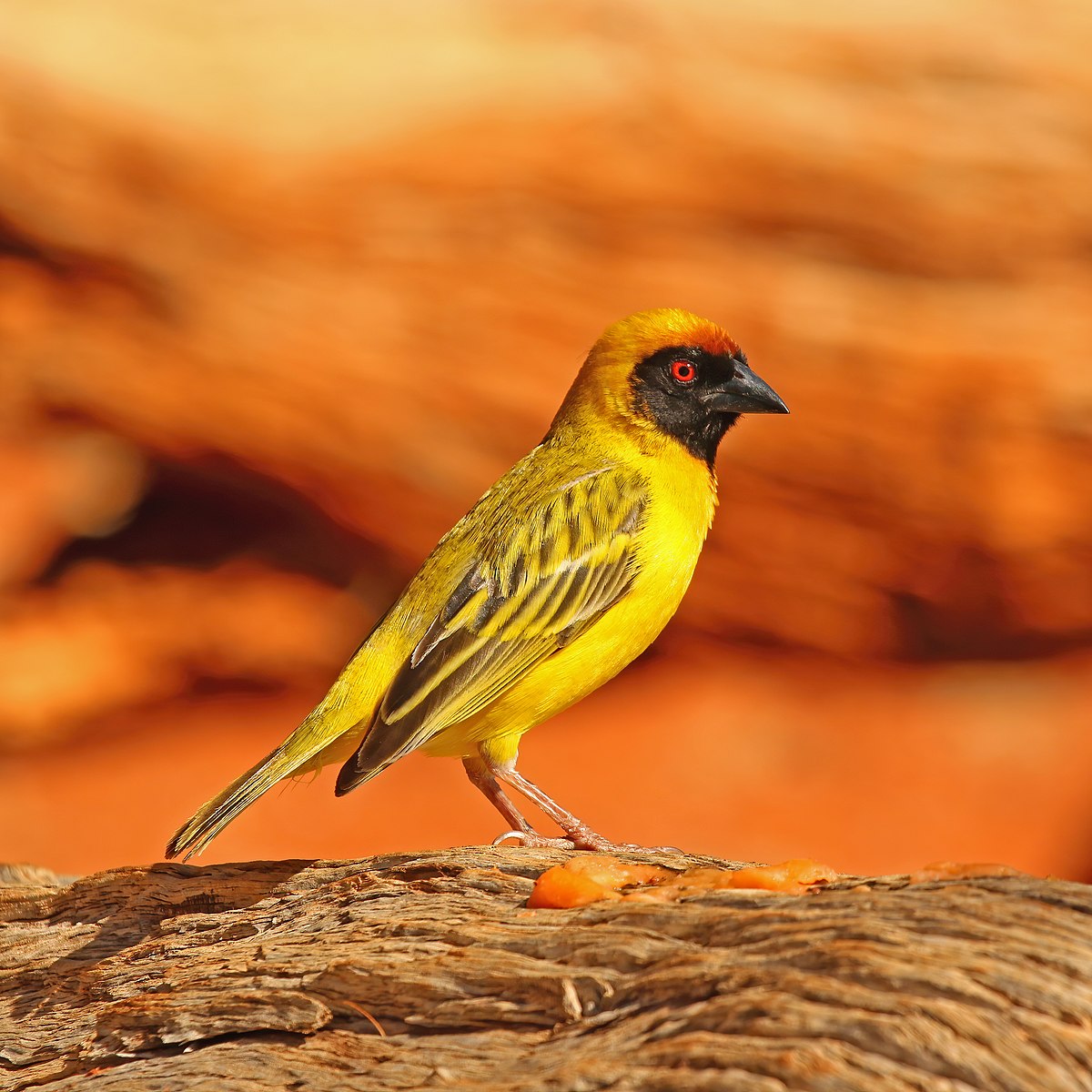
Wikipedia: Southern masked weaver Quelle: OTHER
1200px-Southern_masked_weaver_%28Ploceus_velatus%29_male.jpg
![]() The southern masked weaver (Ploceus velatus), or African masked weaver, is a resident breeding bird species common throughout southern Africa.
[more]
The southern masked weaver (Ploceus velatus), or African masked weaver, is a resident breeding bird species common throughout southern Africa.
[more]
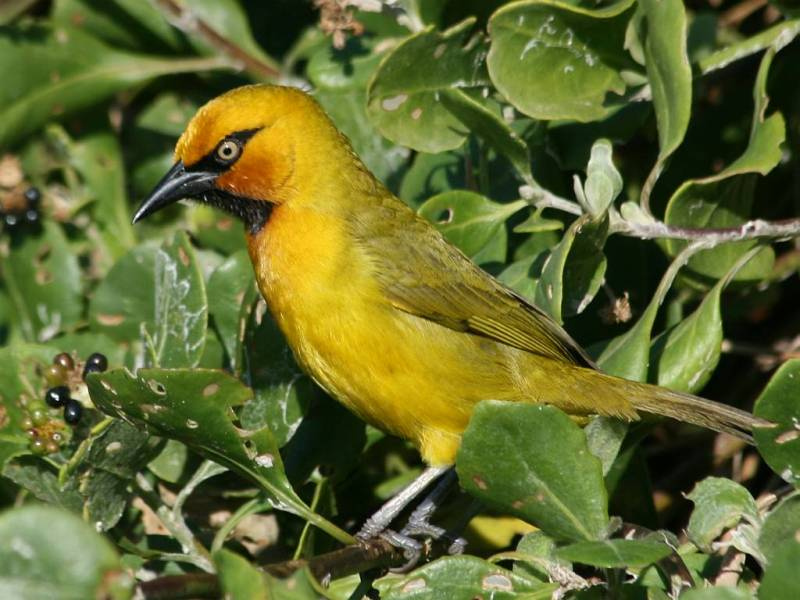
Wikipedia: Spectacled weaver Quelle: OTHER
Ploceus_ocularis_-Umhlanga%2C_KwaZulu-Natal%2C_South_Africa-8.jpg
![]() The spectacled weaver (Ploceus ocularis) is a species of bird in the family Ploceidae. It is found widely in woodland, forest edge and gardens of central, eastern and south-eastern Africa, but is absent from the most arid regions (such as the Karoo) and dense, primary rainforest. This common species breeds in solitary pairs, and both sexes are bright yellow, have an olive-yellow back, black "spectacles" and pale eyes. The male has a black throat.
[more]
The spectacled weaver (Ploceus ocularis) is a species of bird in the family Ploceidae. It is found widely in woodland, forest edge and gardens of central, eastern and south-eastern Africa, but is absent from the most arid regions (such as the Karoo) and dense, primary rainforest. This common species breeds in solitary pairs, and both sexes are bright yellow, have an olive-yellow back, black "spectacles" and pale eyes. The male has a black throat.
[more]
Profil Wikipedia eBird Xeno-Canto

Wikipedia: African golden-weaver Quelle: OTHER
1200px-Ploceus_subaureus_Zanzibar.jpg
![]() Der Goldweber (Ploceus subaureus) zählt innerhalb der Familie der Webervögel (Ploceidae) zur Gattung der Ammerweber (Ploceus).[1]
[more]
Der Goldweber (Ploceus subaureus) zählt innerhalb der Familie der Webervögel (Ploceidae) zur Gattung der Ammerweber (Ploceus).[1]
[more]
Profil Wikipedia eBird Xeno-Canto

Wikipedia: Red-billed quelea Quelle: OTHER
1200px-Red-billed_Quelea_%28Quelea_quelea%29_%286040990915%29.jpg
![]() Der Blutschnabelweber (Quelea quelea) ist eine Singvogelart aus der Familie der Webervögel (Ploceidae). Er besiedelt Afrika südlich der Sahara und gehört zu den häufigsten Vogelarten der Erde. Nach der Brutzeit, wenn die Population mit vielen diesjährigen Vögeln ein jährliches Maximum erreicht, wird der Gesamtbestand teils auf 1,5 Milliarden Exemplare geschätzt,[1]
womit die Art sogar der häufigste wildlebende Vogel überhaupt sein könnte.[Anm. 1] Er tritt regional in riesigen Schwärmen auf, die bedeutende Ernteschäden verursachen können und daher teils vehement bekämpft werden. Die riesigen Brutkolonien können bis zu 110 ha umfassen.
[more]
Der Blutschnabelweber (Quelea quelea) ist eine Singvogelart aus der Familie der Webervögel (Ploceidae). Er besiedelt Afrika südlich der Sahara und gehört zu den häufigsten Vogelarten der Erde. Nach der Brutzeit, wenn die Population mit vielen diesjährigen Vögeln ein jährliches Maximum erreicht, wird der Gesamtbestand teils auf 1,5 Milliarden Exemplare geschätzt,[1]
womit die Art sogar der häufigste wildlebende Vogel überhaupt sein könnte.[Anm. 1] Er tritt regional in riesigen Schwärmen auf, die bedeutende Ernteschäden verursachen können und daher teils vehement bekämpft werden. Die riesigen Brutkolonien können bis zu 110 ha umfassen.
[more]
Profil Wikipedia eBird Xeno-Canto

Wikipedia: Red-headed quelea Quelle: OTHER
Red-headed_Quelea_-_Natal_-_South_Africa_S4E7723_%2822432117487%29.jpg
![]() Der Rotkopfweber (Quelea erythrops) ist eine afrikanische Art aus der Familie der Webervögel (Ploceidae). Er wird in Europa gelegentlich auch als Ziervogel gehalten.
[more]
Der Rotkopfweber (Quelea erythrops) ist eine afrikanische Art aus der Familie der Webervögel (Ploceidae). Er wird in Europa gelegentlich auch als Ziervogel gehalten.
[more]

Wikipedia: Red-headed weaver Quelle: OTHER
1200px-Red-headed_Weaver%2C_Anaplectes_rubriceps_at_Marakele_National_Park%2C_Limpopo_Province%2C_South_Africa_%28male_in_breeding_plumage%29_%2815679994373%29.jpg
![]() The red-headed weaver (Anaplectes rubriceps[2][note 1]) is a species of bird in the family Ploceidae. It is placed in the monotypic genus Anaplectes and is found throughout the Afrotropics.[citation needed]
[more]
The red-headed weaver (Anaplectes rubriceps[2][note 1]) is a species of bird in the family Ploceidae. It is placed in the monotypic genus Anaplectes and is found throughout the Afrotropics.[citation needed]
[more]

Wikipedia: Grosbeak weaver Quelle: OTHER
Amblyospiza_albifrons_-Pretoria%2C_South_Africa_-male-8%2C_crop.jpg
![]() Der Weißstirnweber (Amblyospiza albifrons) ist die einzige Art der Gattung Amblyospiza innerhalb Familie der Webervögel (Ploceidae).
[more]
Der Weißstirnweber (Amblyospiza albifrons) ist die einzige Art der Gattung Amblyospiza innerhalb Familie der Webervögel (Ploceidae).
[more]
Profil Wikipedia eBird Xeno-Canto

Wikipedia: Red-billed buffalo-weaver Quelle: OTHER
1200px-Red-billed_Buffalo_Weaver.jpg
![]() Der Büffelweber (Bubalornis niger) ist eine Vogelart der Gattung Bubalornis aus der Familie der Webervögel (Ploceidae) und ist in den Dornbusch-Steppen Ostafrikas beheimatet.
[more]
Der Büffelweber (Bubalornis niger) ist eine Vogelart der Gattung Bubalornis aus der Familie der Webervögel (Ploceidae) und ist in den Dornbusch-Steppen Ostafrikas beheimatet.
[more]
Profil Wikipedia eBird Xeno-Canto

Wikipedia: Long-tailed widowbird Quelle: OTHER
1200px-Long-tailed_Widowbird_%28Euplectes_progne%29_male_...._%2846718360972%29.jpg
![]() The long-tailed widowbird (Euplectes progne), also known as the "Sakabula", is a species of bird in the family Ploceidae.[2] The species are found in Angola, Botswana, the DRCongo, Kenya, Lesotho, South Africa, Swaziland, and Zambia.[3] The long-tailed widowbird is a medium-sized bird and one of the most common in the territories it inhabits.[4] Adult breeding males are almost entirely black with orange and white shoulders (epaulets), long, wide tails, and a bluish white bill.[2] Females are rather inconspicuous, their feathers streaked tawny and black with pale patches on the chest, breast and back, narrow tail feathers, and horn-colored bills.[2]
[more]
The long-tailed widowbird (Euplectes progne), also known as the "Sakabula", is a species of bird in the family Ploceidae.[2] The species are found in Angola, Botswana, the DRCongo, Kenya, Lesotho, South Africa, Swaziland, and Zambia.[3] The long-tailed widowbird is a medium-sized bird and one of the most common in the territories it inhabits.[4] Adult breeding males are almost entirely black with orange and white shoulders (epaulets), long, wide tails, and a bluish white bill.[2] Females are rather inconspicuous, their feathers streaked tawny and black with pale patches on the chest, breast and back, narrow tail feathers, and horn-colored bills.[2]
[more]
Profil Wikipedia eBird Xeno-Canto

Wikipedia: Red-collared widowbird Quelle: OTHER
1200px-Red-collared_Widowbird%2C_Sakania%2C_DR_Congo_%287147889925%29.jpg
![]() The red-collared widowbird (Euplectes ardens) is a species of bird in the family Ploceidae. Red-collared widowbirds are found in grasslands and bush clearings in Eastern and Southern Africa. They are known for their long tails and brilliant red badges, both which act as sexual ornaments. They are often associated with other widowbird and bishop species. They are polygynous, where males acquisition of territory is an important determinant in their access to mates. Red-collared widowbirds have a wide range and there is little concern in terms of conservation status.
[more]
The red-collared widowbird (Euplectes ardens) is a species of bird in the family Ploceidae. Red-collared widowbirds are found in grasslands and bush clearings in Eastern and Southern Africa. They are known for their long tails and brilliant red badges, both which act as sexual ornaments. They are often associated with other widowbird and bishop species. They are polygynous, where males acquisition of territory is an important determinant in their access to mates. Red-collared widowbirds have a wide range and there is little concern in terms of conservation status.
[more]

Wikipedia: Red bishop Quelle: OTHER
Euplectes_sp_PLW_crop.jpg
![]() Der Oryxweber (Euplectes orix) zählt innerhalb der Familie der Webervögel (Ploceidae) zur Gattung der Feuerweber (Euplectes).
[more]
Der Oryxweber (Euplectes orix) zählt innerhalb der Familie der Webervögel (Ploceidae) zur Gattung der Feuerweber (Euplectes).
[more]
Profil Wikipedia eBird Xeno-Canto

Wikipedia: White-winged widowbird Quelle: OTHER
Spiegelwida.jpg
![]() The white-winged widowbird (Euplectes albonotatus) is a species of passerine bird in the family Ploceidae native to Africa south of the Sahara.[2] It is highly sexually dimorphic in its breeding season, during which the male's yellow plumage turns dark and he gains more white feathers, contrasting with the female's predominantly pale coloration. Three subspecies are recognised.
[more]
The white-winged widowbird (Euplectes albonotatus) is a species of passerine bird in the family Ploceidae native to Africa south of the Sahara.[2] It is highly sexually dimorphic in its breeding season, during which the male's yellow plumage turns dark and he gains more white feathers, contrasting with the female's predominantly pale coloration. Three subspecies are recognised.
[more]
Profil Wikipedia eBird Xeno-Canto
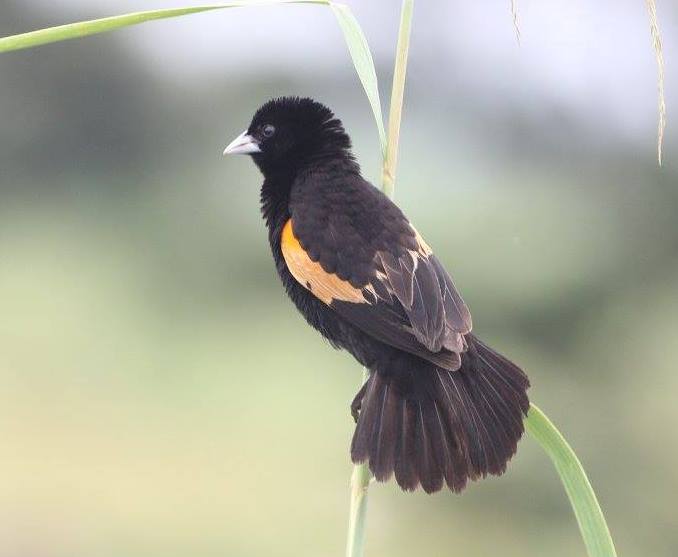
Wikipedia: Fan-tailed widowbird Quelle: OTHER
Euplectes_axillaris%2C_Linunga%2C_Birding_Weto%2C_a.jpg
![]() The fan-tailed widowbird (Euplectes axillaris), also known as the red-shouldered widowbird, is a species of bird in the family Ploceidae, which is native to grassy and swampy areas of the tropical and subtropical Afrotropics.
[more]
The fan-tailed widowbird (Euplectes axillaris), also known as the red-shouldered widowbird, is a species of bird in the family Ploceidae, which is native to grassy and swampy areas of the tropical and subtropical Afrotropics.
[more]
Profil Wikipedia eBird Xeno-Canto

Wikipedia: Yellow bishop Quelle: OTHER
Yellow_Bishop_-_Kenya_S4E8557_%2822662474520%29.jpg
![]() The yellow bishop, Cape bishop, Cape widow[2] or yellow-rumped widow (Euplectes capensis) is a resident breeding bird species in Angola, Botswana, Burundi, Cameroon, Congo, Equatorial Guinea, Eswatini, Ethiopia, Kenya, Lesotho, Malawi, Mozambique, Nigeria, Rwanda, South Africa, South Sudan, Tanzania, Uganda, Zambia and Zimbabwe.[1]
[more]
The yellow bishop, Cape bishop, Cape widow[2] or yellow-rumped widow (Euplectes capensis) is a resident breeding bird species in Angola, Botswana, Burundi, Cameroon, Congo, Equatorial Guinea, Eswatini, Ethiopia, Kenya, Lesotho, Malawi, Mozambique, Nigeria, Rwanda, South Africa, South Sudan, Tanzania, Uganda, Zambia and Zimbabwe.[1]
[more]
Profil Wikipedia eBird Audubon AllAboutBirds Xeno-Canto NABU

Wikipedia: Yellow-crowned bishop Quelle: OTHER
Euplectes_afer_-Lake_Baringo%2C_Kenya_-male-8_CROP.jpg
Dieser Vogel erscheint jenseits grossen Meere in Kontinenten :
Europa, Nordamerika, Afrika.
![]() The yellow-crowned bishop (Euplectes afer) is a species of passerine bird in the family Ploceidae native to Africa south of the Sahara.[2] It is highly sexually dimorphic in its breeding season, during which the male adopts a distinctive yellow and black plumage, contrasting with the female's predominantly brown coloration. Three subspecies are recognised.
[more]
The yellow-crowned bishop (Euplectes afer) is a species of passerine bird in the family Ploceidae native to Africa south of the Sahara.[2] It is highly sexually dimorphic in its breeding season, during which the male adopts a distinctive yellow and black plumage, contrasting with the female's predominantly brown coloration. Three subspecies are recognised.
[more]
Profil Wikipedia eBird Xeno-Canto
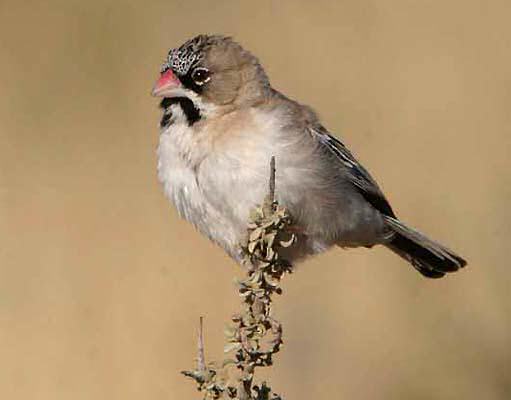
Wikipedia: Scaly weaver Quelle: OTHER
Scaly-feathered_Weaver.jpg
![]() The scaly-feathered weaver (Sporopipes squamifrons), also known as the scaly-feathered finch, is a species of bird in the family Ploceidae.
[more]
The scaly-feathered weaver (Sporopipes squamifrons), also known as the scaly-feathered finch, is a species of bird in the family Ploceidae.
[more]
Anthoscopus caroli / African penduline-tit (Anthoscopus caroli)
Profil Wikipedia eBird Xeno-Canto

Wikipedia: African penduline-tit Quelle: OTHER
African_Penduline-Tit_%28Anthoscopus_caroli%29.jpg
![]() The grey penduline tit (Anthoscopus caroli), also known as the African penduline-tit, is a species of bird in the family Remizidae. It is found in Angola, Botswana, Burundi, Republic of the Congo, Democratic Republic of the Congo, Kenya, Malawi, Mozambique, Namibia, Rwanda, South Africa, Swaziland, Tanzania, Uganda, Zambia, and Zimbabwe. Its natural habitats are subtropical or tropical dry forests, dry savanna, and moist savanna. At 8 to 9 cm (3.1 to 3.5 in) in length and a weight of 6.5 g (0.23 oz), it is one of the smallest species of bird found in Africa, along with its cousin the Cape penduline tit and the perhaps smaller mouse-colored penduline tit and the tit hylia.[2][3]
[more]
The grey penduline tit (Anthoscopus caroli), also known as the African penduline-tit, is a species of bird in the family Remizidae. It is found in Angola, Botswana, Burundi, Republic of the Congo, Democratic Republic of the Congo, Kenya, Malawi, Mozambique, Namibia, Rwanda, South Africa, Swaziland, Tanzania, Uganda, Zambia, and Zimbabwe. Its natural habitats are subtropical or tropical dry forests, dry savanna, and moist savanna. At 8 to 9 cm (3.1 to 3.5 in) in length and a weight of 6.5 g (0.23 oz), it is one of the smallest species of bird found in Africa, along with its cousin the Cape penduline tit and the perhaps smaller mouse-colored penduline tit and the tit hylia.[2][3]
[more]
Anthoscopus minutus / Southern penduline-tit (Anthoscopus minutus)

Wikipedia: Southern penduline-tit Quelle: OTHER
Southern_Penduline-Tit_%28Anthoscopus_minutus%29.jpg
![]() The Cape penduline tit or southern penduline tit (Anthoscopus minutus) is a species of bird in the family Remizidae.
It is found in Angola, Botswana, Namibia, South Africa, and Zimbabwe.
Its natural habitats are dry savannah, subtropical or tropical dry shrubland, and Mediterranean-type shrubby vegetation. At 8 cm (3.1 in) in length, it is one of the smallest species of bird found in Africa, along with its cousins the grey penduline tit and the mouse-coloured penduline tit.[2][3]
[more]
The Cape penduline tit or southern penduline tit (Anthoscopus minutus) is a species of bird in the family Remizidae.
It is found in Angola, Botswana, Namibia, South Africa, and Zimbabwe.
Its natural habitats are dry savannah, subtropical or tropical dry shrubland, and Mediterranean-type shrubby vegetation. At 8 cm (3.1 in) in length, it is one of the smallest species of bird found in Africa, along with its cousins the grey penduline tit and the mouse-coloured penduline tit.[2][3]
[more]
Melaniparus niger / Southern black-tit (Melaniparus niger)
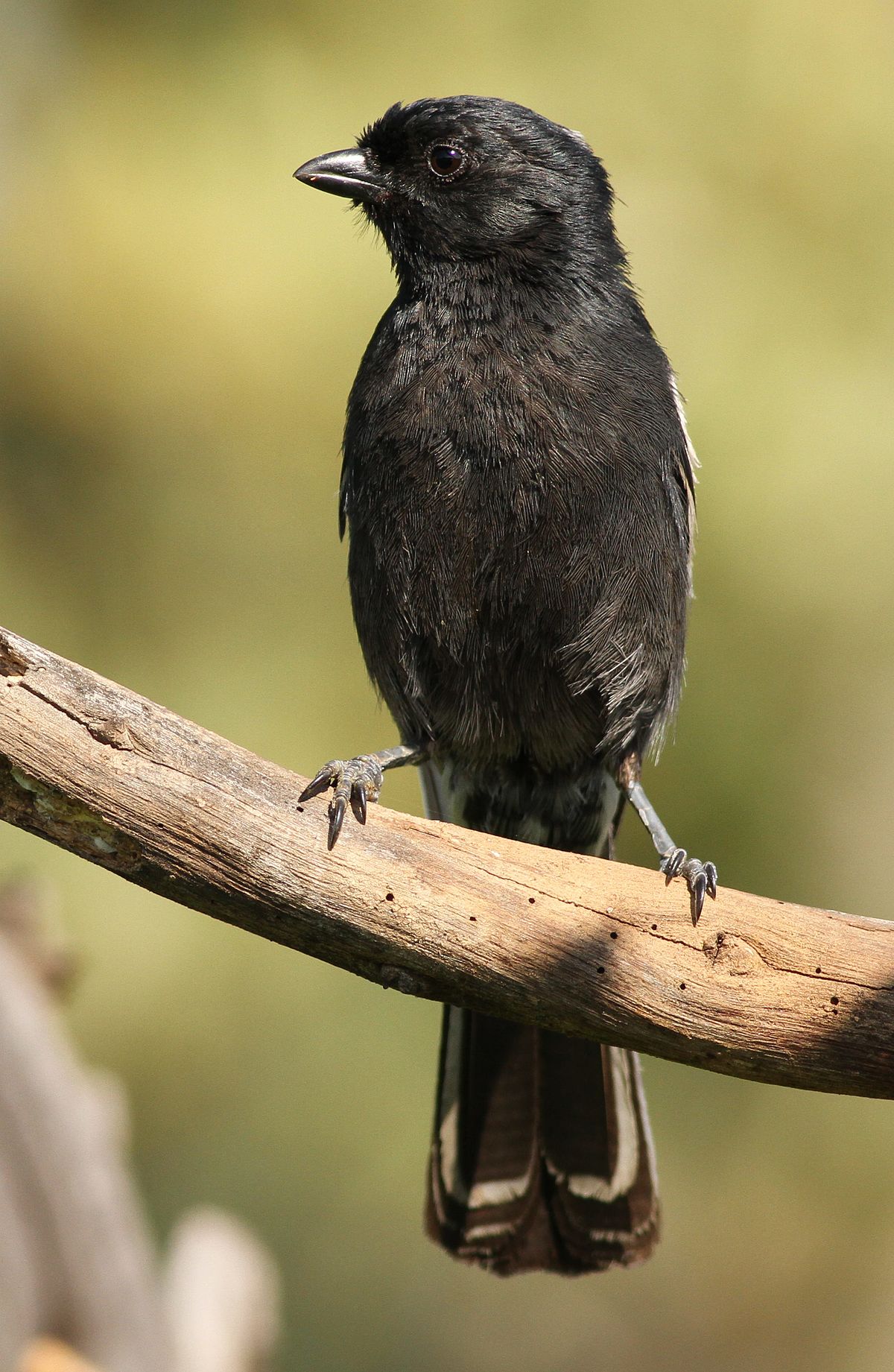
Wikipedia: Southern black-tit Quelle: OTHER
1200px-Southern_Black_Tit%2C_Parus_niger%2C_at_Pilanesberg_National_Park%2C_Northwest_Province%2C_South_Africa_%2816834192359%29.jpg
![]() The southern black tit or simply black tit (Melaniparus niger) is a species of bird in the tit family Paridae, which is native to woodland habitats in southern Africa.
[more]
The southern black tit or simply black tit (Melaniparus niger) is a species of bird in the tit family Paridae, which is native to woodland habitats in southern Africa.
[more]
Melaniparus afer / Grey tit (Melaniparus afer)

Wikipedia: Grey tit Quelle: OTHER
Parus_afer_-Namaqua_National_Park%2C_Northern_Cape%2C_South_Africa_-adult-6.jpg
![]() The grey tit (Melaniparus afer) is a species of bird in the family Paridae.
It is found in Lesotho and South Africa.
Its natural habitats are subtropical or tropical dry shrubland and Mediterranean-type shrubby vegetation.
[more]
The grey tit (Melaniparus afer) is a species of bird in the family Paridae.
It is found in Lesotho and South Africa.
Its natural habitats are subtropical or tropical dry shrubland and Mediterranean-type shrubby vegetation.
[more]
Melaniparus cinerascens / Ashy tit (Melaniparus cinerascens)

Wikipedia: Ashy tit Quelle: OTHER
1200px-Melaniparus_cinerascens_%28cropped%29.jpg
![]() The ashy tit (Melaniparus cinerascens) is a species of bird in the family Paridae. It is found in Angola, Botswana, Namibia, South Africa, and Zimbabwe. Its natural habitats are subtropical or tropical dry forests and dry savanna.
[more]
The ashy tit (Melaniparus cinerascens) is a species of bird in the family Paridae. It is found in Angola, Botswana, Namibia, South Africa, and Zimbabwe. Its natural habitats are subtropical or tropical dry forests and dry savanna.
[more]
Angolapitta / African pitta (Pitta angolensis)
Profil Wikipedia eBird Xeno-Canto

Wikipedia: African pitta Quelle: OTHER
1200px-African_Pitta_%28Pitta_angolensis%29%2C_Hwange_National_Park%2C_Zimbabwe.jpg
![]() Der 20–25 Zentimeter große Angolapitta (Pitta angolensis) ist ein sehr farbenfroher Vertreter aus der Familie der Pittas.
[more]
Der 20–25 Zentimeter große Angolapitta (Pitta angolensis) ist ein sehr farbenfroher Vertreter aus der Familie der Pittas.
[more]
Rosenstar / Rosy starling (Pastor roseus)

Wikipedia: Rosy starling Quelle: OTHER
Rosy_Starling_-_Almaty_-_Kazakstan_S4E1244_%2822382991808%29.jpg
![]() Der Rosenstar (Pastor roseus, Syn.: Sturnus roseus) ist eine Vogelart aus der Familie der Stare. Er tritt häufig invasionsartig auf und ist sehr gesellig.
[more]
Der Rosenstar (Pastor roseus, Syn.: Sturnus roseus) ist eine Vogelart aus der Familie der Stare. Er tritt häufig invasionsartig auf und ist sehr gesellig.
[more]
Messingglanzstar / Lesser blue-eared starling (Lamprotornis chloropterus)
Profil Wikipedia eBird Xeno-Canto

Wikipedia: Lesser blue-eared starling Quelle: OTHER
1200px-Lesser_Blue-eared_Starling_%28Lamprotornis_chloropterus%29%2C_Koubalan%2C_Senegal.jpg
![]() Der Messingglanzstar (Lamprotornis chloropterus) ist eine endemisch in Afrika südlich der Sahara weit verbreitete Vogelart, die aus den zwei Unterarten Lamprotornis chloropterus chloropterus und Lamprotornis chloropterus elisabeth besteht. Der Messingglanzstar lebt in einem breiten Band von Senegal im Westen bis Eritrea im Osten Afrikas und weiter südlich bis Simbabwe. Insgesamt ist die Datenlage selbst für einen Star dünn und undurchsichtig, da es bei dieser Art in freier Wildbahn auch noch zusätzlich leicht zu einer Verwechselung mit dem Grünschwanz-Glanzstar (Lamprotornis chalybaeus) kommen kann.
Der Messingglanzstar ernährt sich von Insekten, Früchten, Samen und Nektar und lebt in offenen Savannen mit Baumbestand, Dornbuschsavannen und Farmland.
[more]
Der Messingglanzstar (Lamprotornis chloropterus) ist eine endemisch in Afrika südlich der Sahara weit verbreitete Vogelart, die aus den zwei Unterarten Lamprotornis chloropterus chloropterus und Lamprotornis chloropterus elisabeth besteht. Der Messingglanzstar lebt in einem breiten Band von Senegal im Westen bis Eritrea im Osten Afrikas und weiter südlich bis Simbabwe. Insgesamt ist die Datenlage selbst für einen Star dünn und undurchsichtig, da es bei dieser Art in freier Wildbahn auch noch zusätzlich leicht zu einer Verwechselung mit dem Grünschwanz-Glanzstar (Lamprotornis chalybaeus) kommen kann.
Der Messingglanzstar ernährt sich von Insekten, Früchten, Samen und Nektar und lebt in offenen Savannen mit Baumbestand, Dornbuschsavannen und Farmland.
[more]
Lamprotornis mevesii / Meves's glossy-starling (Lamprotornis mevesii)

Wikipedia: Meves's glossy-starling Quelle: OTHER
Lamprotornis_mevesii_-Mapungubwe_National_Park%2C_Limpopo%2C_South_Africa-8.jpg
![]() Meves's starling (Lamprotornis mevesii) or Meves's glossy-starling, is a species of starling in the family Sturnidae. It is found in Angola, Botswana, Malawi, Mozambique, Namibia, South Africa, Zambia, and Zimbabwe.
[more]
Meves's starling (Lamprotornis mevesii) or Meves's glossy-starling, is a species of starling in the family Sturnidae. It is found in Angola, Botswana, Malawi, Mozambique, Namibia, South Africa, Zambia, and Zimbabwe.
[more]
Lamprotornis chalybaeus / Greater blue-eared starling (Lamprotornis chalybaeus)
Profil Wikipedia eBird Xeno-Canto
Probably Greater blue-eared starling. 2016-09-28 16.56.56 Botswana
Zuerst beobachtet in Botswana an 2016-09-28.
![]() The greater blue-eared starling or greater blue-eared glossy-starling (Lamprotornis chalybaeus) is a bird that breeds from Senegal east to Ethiopia and south through eastern Africa to northeastern South Africa and Angola. It is a very common species of open woodland bird, and undertakes some seasonal migration.
[more]
The greater blue-eared starling or greater blue-eared glossy-starling (Lamprotornis chalybaeus) is a bird that breeds from Senegal east to Ethiopia and south through eastern Africa to northeastern South Africa and Angola. It is a very common species of open woodland bird, and undertakes some seasonal migration.
[more]
Riesenglanzstar / Burchell's glossy-starling (Lamprotornis australis)

Wikipedia: Burchell's glossy-starling Quelle: OTHER
1200px-Burchell%27s_Starling_%28Lamprotornis_australis%29_%2816394703987%29.jpg
![]() Der Riesenglanzstar (Lamprotornis australis) aus der Gattung der Eigentlichen Glanzstare (Lamprotornis) ist eine Vogelart aus der Familie der Stare (Sturnidae) und gehört zu der Ordnung der Sperlingsvögel (Passeriformes). Er hat ein stark metallisch glänzendes, irisierendes Federkleid in blauen bis violetten Farbtönen und gilt als monogam lebender Vogel. Sein Verbreitungsgebiet liegt in den südlichen afrikanischen Staaten mit offenen leicht bewaldeten Gebieten und Savannen mit Baumbestand und übersichtlichem Boden. Er ernährt sich überwiegend von verschiedenen Insekten und Früchten.
[more]
Der Riesenglanzstar (Lamprotornis australis) aus der Gattung der Eigentlichen Glanzstare (Lamprotornis) ist eine Vogelart aus der Familie der Stare (Sturnidae) und gehört zu der Ordnung der Sperlingsvögel (Passeriformes). Er hat ein stark metallisch glänzendes, irisierendes Federkleid in blauen bis violetten Farbtönen und gilt als monogam lebender Vogel. Sein Verbreitungsgebiet liegt in den südlichen afrikanischen Staaten mit offenen leicht bewaldeten Gebieten und Savannen mit Baumbestand und übersichtlichem Boden. Er ernährt sich überwiegend von verschiedenen Insekten und Früchten.
[more]
Lamprotornis nitens / Red-shouldered glossy-starling (Lamprotornis nitens)
Cape starling or black-bellied or even burchells. 2016-09-24 09.10.06 Botswana
Zuerst beobachtet in Botswana an 2016-09-24.
![]() The Cape starling, red-shouldered glossy-starling or Cape glossy starling (Lamprotornis nitens) is a species of starling in the family Sturnidae. It is found in southern Africa, where it lives in woodlands, bushveld and in suburbs.[4]
[more]
The Cape starling, red-shouldered glossy-starling or Cape glossy starling (Lamprotornis nitens) is a species of starling in the family Sturnidae. It is found in southern Africa, where it lives in woodlands, bushveld and in suburbs.[4]
[more]
Lamprotornis bicolor / African pied starling (Lamprotornis bicolor)
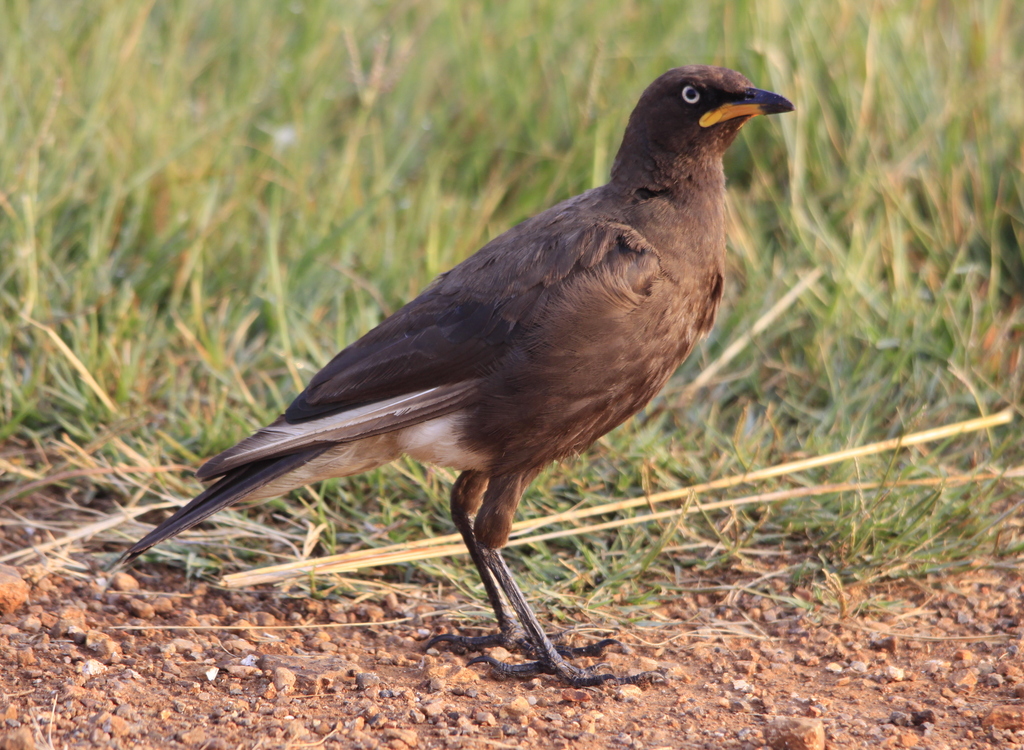
Wikipedia: African pied starling Quelle: OTHER
Lamprotornis_bicolor_-Rietvlei_Nature_Reserve%2C_Pretoria%2C_South_Africa_-adult-8.jpg
![]() The pied starling or African pied starling, (Lamprotornis bicolor) is a bird endemic to South Africa, Lesotho and Swaziland. It is common in most of its range, but largely absent from the arid northwest and the eastern lowlands of South Africa. It is found in open habitats such as grassland, karoo scrub, thornbush and agricultural land, and often associates with farm animals.[2]
[more]
The pied starling or African pied starling, (Lamprotornis bicolor) is a bird endemic to South Africa, Lesotho and Swaziland. It is common in most of its range, but largely absent from the arid northwest and the eastern lowlands of South Africa. It is found in open habitats such as grassland, karoo scrub, thornbush and agricultural land, and often associates with farm animals.[2]
[more]
Lappenstar / Wattled starling (Creatophora cinerea)
Profil Wikipedia eBird Xeno-Canto

Wikipedia: Wattled starling Quelle: OTHER
1200px-Wattled_Starling_%28Creatophora_cinerea%29_%286017306206%29%2C_crop.jpg
![]() Der Lappenstar (Creatophora cinerea) ist eine Art der Stare und der einzige Vertreter der monotypischen Gattung Lappenstare. Er ist ein nomadischer Bewohner im Osten und Süden des afrikanischen Kontinents. Er scheint in den letzten Jahren sein Verbreitungsgebiet nach Westafrika auszudehnen und ist sowohl auf der arabischen Halbinsel als auch Madagaskar und den Seychellen beobachtet worden. Sein Lebensraum sind Grasland, lichte Wälder und Kulturland.
[more]
Der Lappenstar (Creatophora cinerea) ist eine Art der Stare und der einzige Vertreter der monotypischen Gattung Lappenstare. Er ist ein nomadischer Bewohner im Osten und Süden des afrikanischen Kontinents. Er scheint in den letzten Jahren sein Verbreitungsgebiet nach Westafrika auszudehnen und ist sowohl auf der arabischen Halbinsel als auch Madagaskar und den Seychellen beobachtet worden. Sein Lebensraum sind Grasland, lichte Wälder und Kulturland.
[more]
Acridotheres tristis / Common myna (Acridotheres tristis)
First common myna seen on trip to SE Asia, in Wat Pho, Bangkok. 2024-01-19 17.00.32 Thailand
Zuerst beobachtet in Thailand an 2024-01-19.
Dieser Vogel erscheint jenseits grossen Meere in Kontinenten :
Nordamerika, Afrika, Asien.
![]() The common myna or Indian myna (Acridotheres tristis), sometimes spelled mynah,[2] is a member of the family Sturnidae (starlings and mynas) native to Asia. An omnivorous open woodland bird with a strong territorial instinct, the common myna has adapted extremely well to urban environments.
[more]
The common myna or Indian myna (Acridotheres tristis), sometimes spelled mynah,[2] is a member of the family Sturnidae (starlings and mynas) native to Asia. An omnivorous open woodland bird with a strong territorial instinct, the common myna has adapted extremely well to urban environments.
[more]
Gesang:
Automatically generated from Xeno-Canto recording
Gesang Eigenschaften:
Frequency:
♫ XC729094 - Common Myna - Acridotheres tristis tristis. Quelle: XENOCANTO
XC729094 - Common Myna - Acridotheres tristis tristis.mp3
(Gesang)
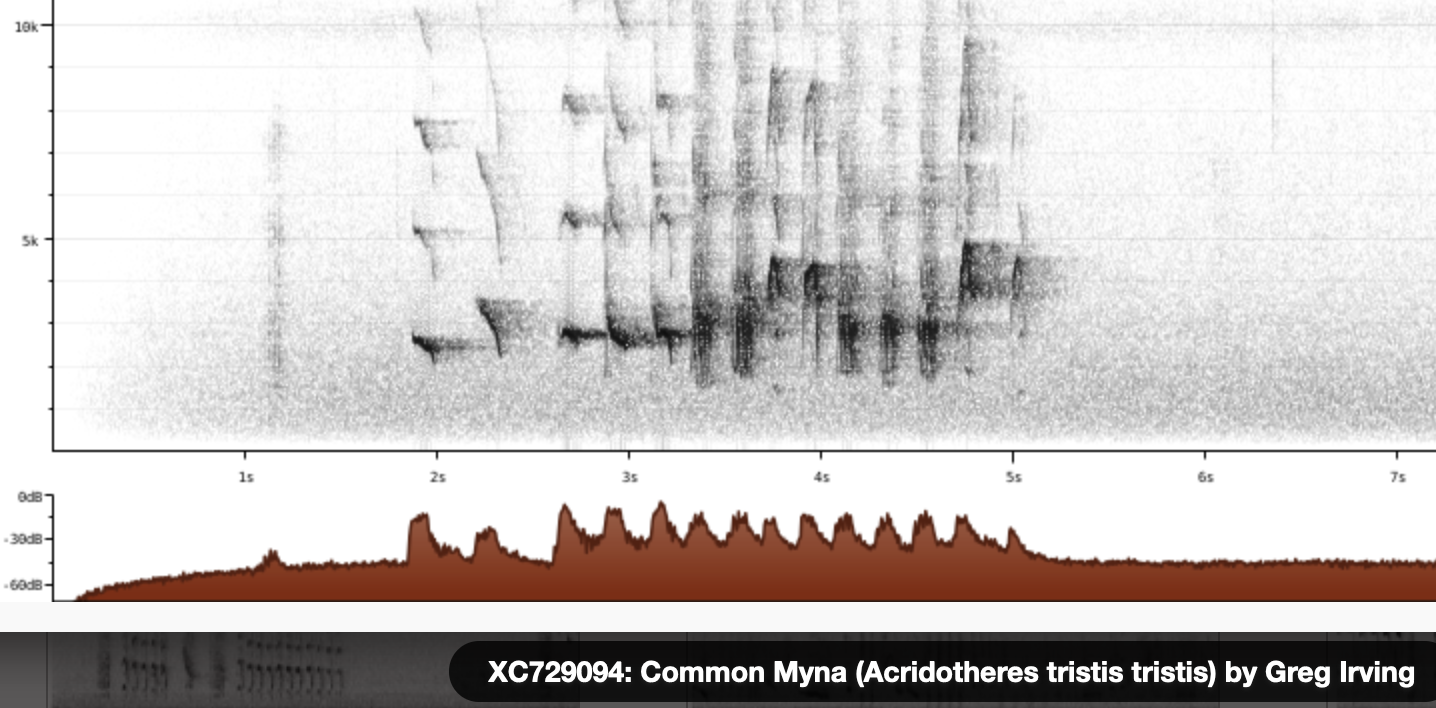
Buphagus africanus / Yellow-billed oxpecker (Buphagus africanus)
Profil Wikipedia eBird Xeno-Canto

Wikipedia: Yellow-billed oxpecker Quelle: OTHER
Flickr_-_Rainbirder_-_Yellow-billed_Oxpecker_%28Buphagus_africanus%29.jpg
![]() The yellow-billed oxpecker (Buphagus africanus) is a passerine bird in the family Buphagidae. It was previously placed in the starling and myna family, Sturnidae.
[more]
The yellow-billed oxpecker (Buphagus africanus) is a passerine bird in the family Buphagidae. It was previously placed in the starling and myna family, Sturnidae.
[more]
Cinnyricinclus leucogaster / Violet-backed starling (Cinnyricinclus leucogaster)
Profil Wikipedia eBird Xeno-Canto

Wikipedia: Violet-backed starling Quelle: OTHER
1200px-Violet-backed_starling_%28Cinnyricinclus_leucogaster_verreauxi%29_male.jpg
![]() The violet-backed starling (Cinnyricinclus leucogaster), also known as the plum-coloured starling or amethyst starling, is a relatively small species (17 cm) of starling in the family Sturnidae. It is the only member of the genus Cinnyricinclus. This strongly sexually dimorphic species is found widely in the woodlands and savannah forest edges of mainland sub-Saharan Africa. It is rarely seen on the ground, but instead found in trees and other locations away from the ground.
[more]
The violet-backed starling (Cinnyricinclus leucogaster), also known as the plum-coloured starling or amethyst starling, is a relatively small species (17 cm) of starling in the family Sturnidae. It is the only member of the genus Cinnyricinclus. This strongly sexually dimorphic species is found widely in the woodlands and savannah forest edges of mainland sub-Saharan Africa. It is rarely seen on the ground, but instead found in trees and other locations away from the ground.
[more]
Onychognathus nabouroup / Pale-winged starling (Onychognathus nabouroup)
Profil Wikipedia eBird Xeno-Canto

Wikipedia: Pale-winged starling Quelle: OTHER
1200px-Pale-winged_starling_%28Onychognathus_nabouroup%29.jpg
![]() The pale-winged starling (Onychognathus nabouroup) is a species of starling in the family Sturnidae. It is found in Angola, Botswana, Namibia, and South Africa.
[more]
The pale-winged starling (Onychognathus nabouroup) is a species of starling in the family Sturnidae. It is found in Angola, Botswana, Namibia, and South Africa.
[more]
Onychognathus morio / Red-winged starling (Onychognathus morio)
Profil Wikipedia eBird Xeno-Canto
Red-winged starlings bickering or merely chattering. 2009-11-04 12.18.10 Gqeberha (frueher Port Elisabeth)
Zuerst beobachtet in Gqeberha (frueher Port Elisabeth) an 2009-11-04.
![]() The red-winged starling (Onychognathus morio) is a bird of the starling family Sturnidae native to eastern Africa from Ethiopia to the Cape in South Africa. An omnivorous, generalist species, it prefers cliffs and mountainous areas for nesting, and has moved into cities and towns due to similarity to its original habitat.
[more]
The red-winged starling (Onychognathus morio) is a bird of the starling family Sturnidae native to eastern Africa from Ethiopia to the Cape in South Africa. An omnivorous, generalist species, it prefers cliffs and mountainous areas for nesting, and has moved into cities and towns due to similarity to its original habitat.
[more]
Notopholia corusca / Black-bellied glossy-starling (Notopholia corusca)

Wikipedia: Black-bellied glossy-starling Quelle: OTHER
Black-bellied_Glossy-Starling_-_Mkuze_-_Natal_S4E8977_%2822775346556%29.jpg
![]() The black-bellied starling (Notopholia corusca) is a species of starling in the family Sturnidae. It is found in Kenya, Mozambique, Somalia, South Africa, Swaziland, Tanzania, and Zimbabwe.
[more]
The black-bellied starling (Notopholia corusca) is a species of starling in the family Sturnidae. It is found in Kenya, Mozambique, Somalia, South Africa, Swaziland, Tanzania, and Zimbabwe.
[more]
Turdus libonyana / Kurrichane thrush (Turdus libonyana)

Wikipedia: Kurrichane thrush Quelle: OTHER
1200px-Kurrichane_Thrush%2C_Sakania%2C_DRC_%287001803096%29.jpg
![]() The Kurrichane thrush (Turdus libonyana) is a species of bird in the thrush family Turdidae. The species is found from central through to southern Africa. Its natural habitat is dry savanna and woodland, predominantly miombo woodland.
[more]
The Kurrichane thrush (Turdus libonyana) is a species of bird in the thrush family Turdidae. The species is found from central through to southern Africa. Its natural habitat is dry savanna and woodland, predominantly miombo woodland.
[more]
Turdus olivaceus / Olive thrush (Turdus olivaceus)
Profil Wikipedia eBird Xeno-Canto

Wikipedia: Olive thrush Quelle: OTHER
1200px-Olive_Thrush_RWD.jpg
![]() The olive thrush (Turdus olivaceus) is, in its range, one of the most common members of the thrush family (Turdidae). It occurs in African highlands from southern Malawi and Mozambique in the north to the Cape of Good Hope in the south.[2] It is a bird of forest and woodland, but has locally adapted to parks and large gardens in suburban areas.
[more]
The olive thrush (Turdus olivaceus) is, in its range, one of the most common members of the thrush family (Turdidae). It occurs in African highlands from southern Malawi and Mozambique in the north to the Cape of Good Hope in the south.[2] It is a bird of forest and woodland, but has locally adapted to parks and large gardens in suburban areas.
[more]
Turdus smithi / Karoo thrush (Turdus smithi)

Wikipedia: Karoo thrush Quelle: OTHER
1200px-Turdus_smithi_%28Karoo_Thrush%29_on_lawn_%28crop%29.jpg
![]() The Karoo thrush (Turdus smithi) also known as Smith's thrush, is a member of the thrush family in Africa. It has traditionally been considered a subspecies of the olive thrush (with which it is known to hybridize), but is increasingly treated as a separate species.
[more]
The Karoo thrush (Turdus smithi) also known as Smith's thrush, is a member of the thrush family in Africa. It has traditionally been considered a subspecies of the olive thrush (with which it is known to hybridize), but is increasingly treated as a separate species.
[more]
Monticola brevipes / Short-toed rock-thrush (Monticola brevipes)
Profil Wikipedia eBird Xeno-Canto

Wikipedia: Short-toed rock-thrush Quelle: OTHER
Monticola_brevipes.jpg
![]() The short-toed rock thrush (Monticola brevipes) is a species of bird in the family Muscicapidae. It is found in Angola, Botswana, Namibia, and South Africa. Its natural habitat is subtropical or tropical dry shrubland.
[more]
The short-toed rock thrush (Monticola brevipes) is a species of bird in the family Muscicapidae. It is found in Angola, Botswana, Namibia, and South Africa. Its natural habitat is subtropical or tropical dry shrubland.
[more]
Monticola explorator / Sentinel rock-thrush (Monticola explorator)
Profil Wikipedia eBird Xeno-Canto

Wikipedia: Sentinel rock-thrush Quelle: OTHER
1200px-Monticola_explorator_-Cape_Town%2C_Western_Cape%2C_South_Africa_-male-8.jpg
![]() The sentinel rock thrush (Monticola explorator) is a species of bird in the family Muscicapidae.[2]
It is found in Lesotho, South Africa, and Swaziland.
Its natural habitat is subtropical or tropical high-altitude grassland.
[more]
The sentinel rock thrush (Monticola explorator) is a species of bird in the family Muscicapidae.[2]
It is found in Lesotho, South Africa, and Swaziland.
Its natural habitat is subtropical or tropical high-altitude grassland.
[more]
Monticola rupestris / Cape rock-thrush (Monticola rupestris)
Profil Wikipedia eBird Xeno-Canto

Wikipedia: Cape rock-thrush Quelle: OTHER
Monticola_rupestris_-Marakele_National_Park%2C_South_Africa_-male-8_%281%29.jpg
![]() The Cape rock thrush (Monticola rupestris) is a member of the bird family Muscicapidae. This rock thrush breeds in eastern and southern South Africa, Lesotho and Swaziland. It is a common endemic resident, non-migratory apart from seasonal altitudinal movements in some areas.
[more]
The Cape rock thrush (Monticola rupestris) is a member of the bird family Muscicapidae. This rock thrush breeds in eastern and southern South Africa, Lesotho and Swaziland. It is a common endemic resident, non-migratory apart from seasonal altitudinal movements in some areas.
[more]
Geokichla gurneyi / Orange ground-thrush (Geokichla gurneyi)
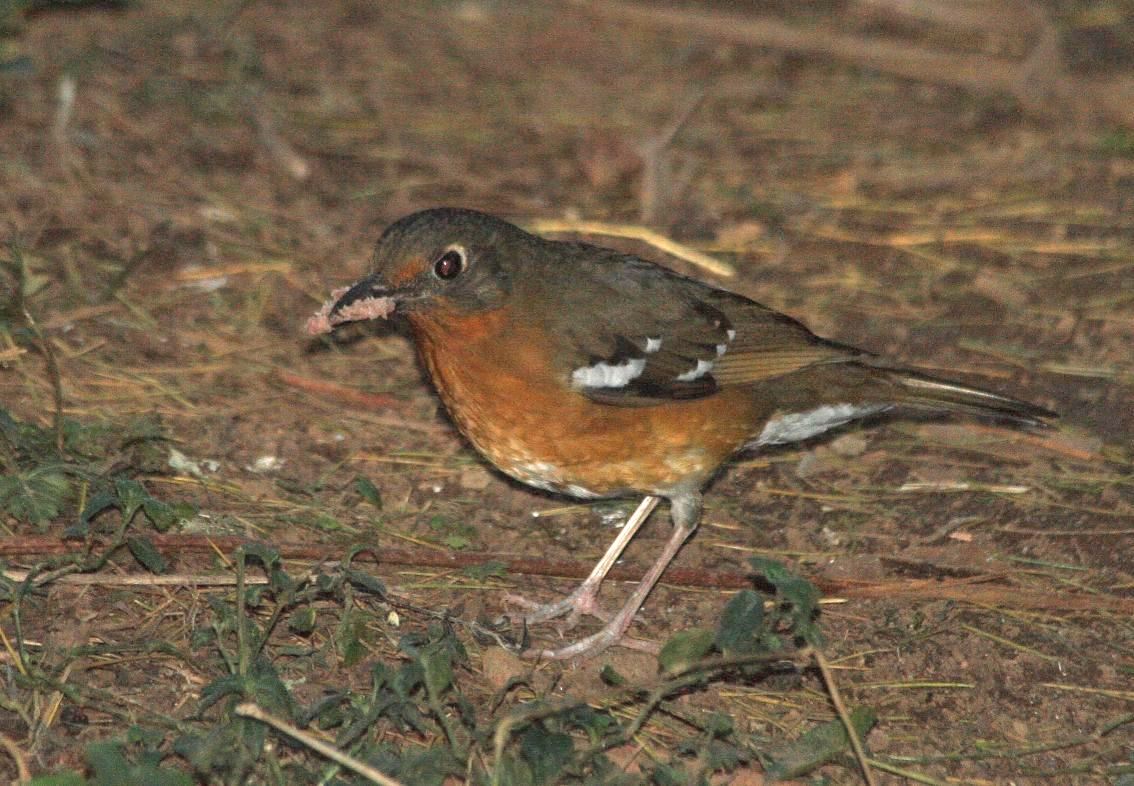
Wikipedia: Orange ground-thrush Quelle: OTHER
Orange_Ground-Thrush_2008_09_14_07_07_15_1026.jpg
![]() The orange ground thrush (Geokichla gurneyi) is a species of bird in the family Turdidae.
[more]
The orange ground thrush (Geokichla gurneyi) is a species of bird in the family Turdidae.
[more]
Geokichla guttata / Spotted ground-thrush (Geokichla guttata)
Profil Wikipedia eBird Xeno-Canto

Wikipedia: Spotted ground-thrush Quelle: OTHER
Spotted_Ground_Thrush.jpg
![]() The spotted ground thrush (Geokichla guttata) is a species of bird in the family Turdidae. It is found in the Democratic Republic of the Congo, Kenya, Malawi, South Africa, Sudan, Tanzania, and possibly Mozambique.
[more]
The spotted ground thrush (Geokichla guttata) is a species of bird in the family Turdidae. It is found in the Democratic Republic of the Congo, Kenya, Malawi, South Africa, Sudan, Tanzania, and possibly Mozambique.
[more]
Muscicapa adusta / Dusky alseonax (Muscicapa adusta)

Wikipedia: Dusky alseonax Quelle: OTHER
1200px-African_Dusky_Flycatcher.jpg
![]() The African dusky flycatcher (Muscicapa adusta), dusky-brown flycatcher or dusky alseonax, is a small passerine bird of the Old World flycatcher family, Muscicapidae. It is a resident breeder in Africa from Nigeria, the Central African Republic, South Sudan and Ethiopia south to South Africa. It is very common in its woodland habitat, which includes riverine forests, evergreen forest edges and clearings, especially near water bodies such as lakes, dams and streams, and well-wooded suburban gardens.
[more]
The African dusky flycatcher (Muscicapa adusta), dusky-brown flycatcher or dusky alseonax, is a small passerine bird of the Old World flycatcher family, Muscicapidae. It is a resident breeder in Africa from Nigeria, the Central African Republic, South Sudan and Ethiopia south to South Africa. It is very common in its woodland habitat, which includes riverine forests, evergreen forest edges and clearings, especially near water bodies such as lakes, dams and streams, and well-wooded suburban gardens.
[more]
Afrikanische Schwarzkehlchen / Common stonechat (Saxicola torquatus)
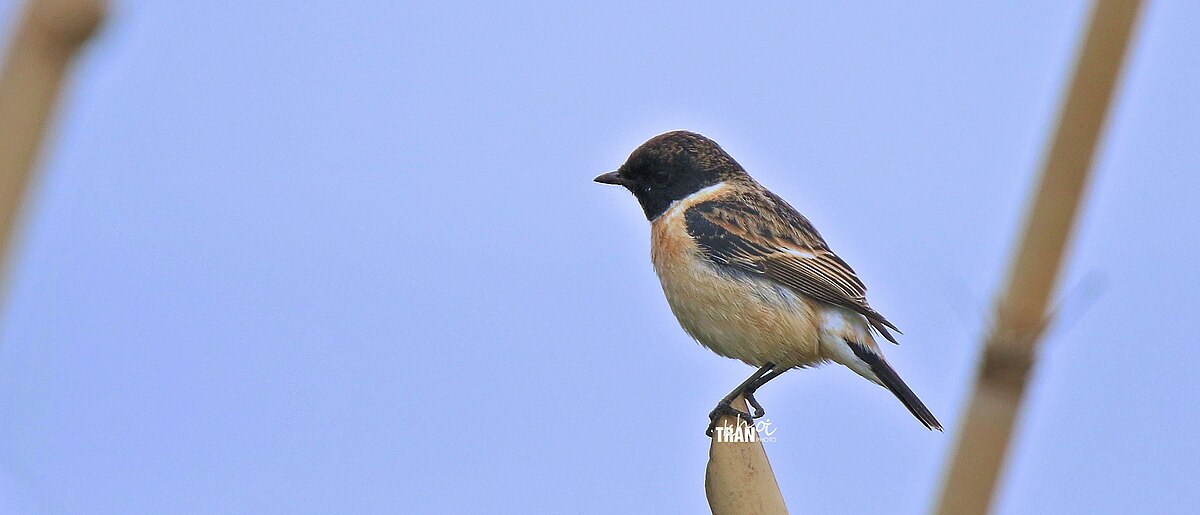
Wikipedia: Common stonechat Quelle: OTHER
1200px-Saxicola_stejnegeri%2C_Hanoi%2C_Vietnam_4G4A3231.jpg
Gesang:
Automatically generated from Xeno-Canto recording
Gesang Eigenschaften:
Frequency:
♫ XC710467 - European Stonechat - Saxicola rubicola rubicola. Quelle: XENOCANTO
XC710467 - European Stonechat - Saxicola rubicola rubicola.mp3
(Gesang)
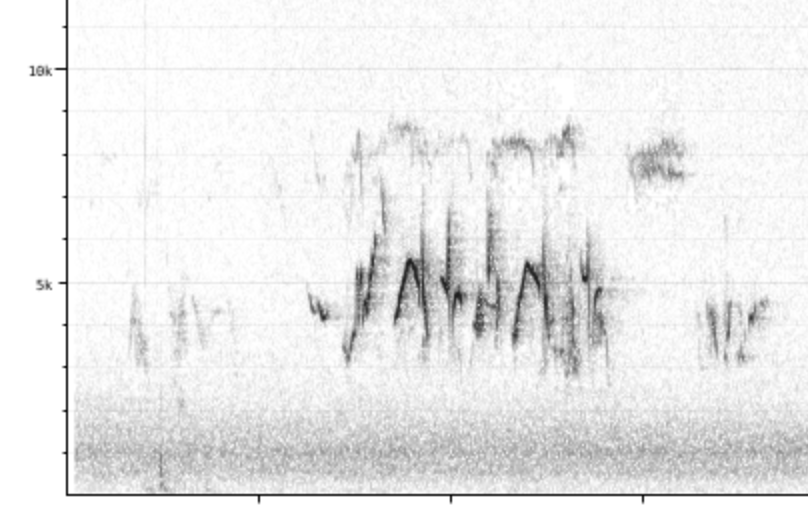
Cercotrichas quadrivirgata / Bearded scrub-robin (Cercotrichas quadrivirgata)

Wikipedia: Bearded scrub-robin Quelle: OTHER
1200px-Bearded_scrub_robin_%28Cercotrichas_quadrivirgata%29.jpg
![]() The bearded scrub robin (Cercotrichas quadrivirgata), also known as the eastern bearded scrub robin,[1][2] is a species of bird in the family Muscicapidae. It is found in eastern and southern Africa.
[more]
The bearded scrub robin (Cercotrichas quadrivirgata), also known as the eastern bearded scrub robin,[1][2] is a species of bird in the family Muscicapidae. It is found in eastern and southern Africa.
[more]
Cercotrichas coryphoeus / Karoo scrub-robin (Cercotrichas coryphoeus)

Wikipedia: Karoo scrub-robin Quelle: OTHER
Cercotrichas_coryphoeus%2C_Namaqua_National_Park%2C_South_Africa.jpg
![]() The Karoo scrub robin (Cercotrichas coryphaeus) or Karoo Robin, is a species of bird in the family Muscicapidae. It is found in Lesotho, Namibia, and South Africa. Its natural habitats are dry shrubland and Mediterranean-type shrubby vegetation.
[more]
The Karoo scrub robin (Cercotrichas coryphaeus) or Karoo Robin, is a species of bird in the family Muscicapidae. It is found in Lesotho, Namibia, and South Africa. Its natural habitats are dry shrubland and Mediterranean-type shrubby vegetation.
[more]
Cercotrichas paena / Kalahari scrub-robin (Cercotrichas paena)
Profil Wikipedia eBird Xeno-Canto

Wikipedia: Kalahari scrub-robin Quelle: OTHER
1200px-Kalahari_scrub_robin%2C_Erythropygia_paena_at_Pilanesberg_National_Park%2C_Northwest_Province%2C_South_Africa_%2817455045501%29.jpg
![]() The Kalahari scrub robin (Cercotricha paena) is a species of bird in the family Muscicapidae. It is sometimes known as the sandy scrub robin.
[more]
The Kalahari scrub robin (Cercotricha paena) is a species of bird in the family Muscicapidae. It is sometimes known as the sandy scrub robin.
[more]
Cercotrichas signata / Brown scrub-robin (Cercotrichas signata)

Wikipedia: Brown scrub-robin Quelle: OTHER
Cercotrichas_signata_tongensis%2C_volwassene%2C_St_Lucia%2C_Birding_Weto%2C_a.jpg
![]() The brown scrub robin (Cercotrichas signata) is a species of bird in the family Muscicapidae. It is found in Mozambique, South Africa, and Swaziland. Its natural habitat is subtropical dry or moist forests.
[more]
The brown scrub robin (Cercotrichas signata) is a species of bird in the family Muscicapidae. It is found in Mozambique, South Africa, and Swaziland. Its natural habitat is subtropical dry or moist forests.
[more]
Cercotrichas galactotes / Rufous-tailed scrub-robin (Cercotrichas galactotes)
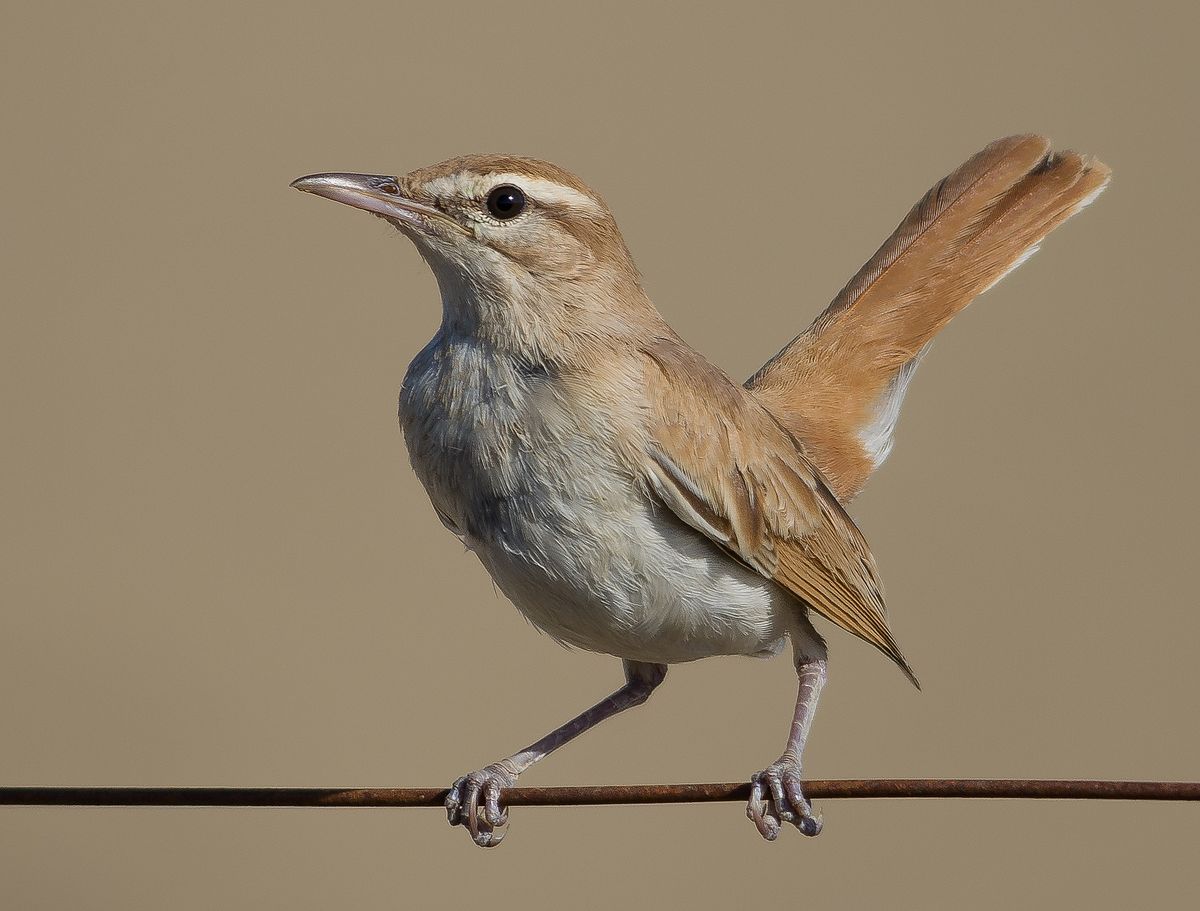
Wikipedia: Rufous-tailed scrub-robin Quelle: OTHER
1200px-Agrobate_roux_au_Parc_National_de_l%27Ichkeul_%28Tunisia%29%2C_crop.jpg
![]() The rufous-tailed scrub robin (Cercotrichas galactotes) is a medium-sized member of the family Muscicapidae. Other common names include the rufous scrub robin, rufous bush chat, rufous bush robin[2] and the rufous warbler.[3] It breeds around the Mediterranean and east to Pakistan. It also breeds south of the Sahara from the Sahel region east to Somalia; these African birds are sometimes considered to be a separate species, the African scrub robin (C. minor). It is partially migratory, wintering in Africa (Kenya, South Sudan, Ethiopia, Somalia) and India. This is a very rare visitor to northern Europe.
[more]
The rufous-tailed scrub robin (Cercotrichas galactotes) is a medium-sized member of the family Muscicapidae. Other common names include the rufous scrub robin, rufous bush chat, rufous bush robin[2] and the rufous warbler.[3] It breeds around the Mediterranean and east to Pakistan. It also breeds south of the Sahara from the Sahel region east to Somalia; these African birds are sometimes considered to be a separate species, the African scrub robin (C. minor). It is partially migratory, wintering in Africa (Kenya, South Sudan, Ethiopia, Somalia) and India. This is a very rare visitor to northern Europe.
[more]
Cossypha heuglini / White-browed robin-chat (Cossypha heuglini)
Profil Wikipedia eBird Xeno-Canto

Wikipedia: White-browed robin-chat Quelle: OTHER
White-browed_Robin-Chat_%28Cossypha_heuglini%29.jpg
![]() The white-browed robin-chat (Cossypha heuglini), also known as Heuglin's robin,[2] is a species of bird in the family Muscicapidae. Found in east, central and southern Africa,[3] its natural habitats include riverine forest and thickets, and it is also found near humans. The IUCN classifies it as a least-concern species.
[more]
The white-browed robin-chat (Cossypha heuglini), also known as Heuglin's robin,[2] is a species of bird in the family Muscicapidae. Found in east, central and southern Africa,[3] its natural habitats include riverine forest and thickets, and it is also found near humans. The IUCN classifies it as a least-concern species.
[more]
Cossypha dichroa / Chorister robin-chat (Cossypha dichroa)
Profil Wikipedia eBird Xeno-Canto

Wikipedia: Chorister robin-chat Quelle: OTHER
1200px-Chorister_Robin-Chat_2016_06_11_6798.jpg
![]() The chorister robin-chat (Cossypha dichroa) (previously known as the chorister robin) is a species of bird in the family Muscicapidae.
It is found in South Africa and Swaziland. Its distribution stretches from the southern Western Cape through the Eastern Cape, KwaZulu-Natal, Swaziland and Mpumalanga to northern Limpopo.
[more]
The chorister robin-chat (Cossypha dichroa) (previously known as the chorister robin) is a species of bird in the family Muscicapidae.
It is found in South Africa and Swaziland. Its distribution stretches from the southern Western Cape through the Eastern Cape, KwaZulu-Natal, Swaziland and Mpumalanga to northern Limpopo.
[more]
Cossypha natalensis / Red-capped robin-chat (Cossypha natalensis)
Profil Wikipedia eBird Xeno-Canto

Wikipedia: Red-capped robin-chat Quelle: OTHER
Red-capped_Robin-Chat_%28Cossypha_natalensis%29.jpg
![]() The red-capped robin-chat or Natal robin (Cossypha natalensis) is a species of bird in the family Muscicapidae.
[more]
The red-capped robin-chat or Natal robin (Cossypha natalensis) is a species of bird in the family Muscicapidae.
[more]
Kaprötel / Cape robin-chat (Cossypha caffra)
Profil Wikipedia eBird Xeno-Canto
Hmm, maybe Cape robin-chat. 2009-10-20 14.48.06 Gqeberha (frueher Port Elisabeth)
Zuerst beobachtet in Gqeberha (frueher Port Elisabeth) an 2009-10-20.
![]() Der Kaprötel (Cossypha caffra) ist eine bis zu 18 Zentimeter große Vogelart aus der Familie der Fliegenschnäpper.
[more]
Der Kaprötel (Cossypha caffra) ist eine bis zu 18 Zentimeter große Vogelart aus der Familie der Fliegenschnäpper.
[more]
Cossypha humeralis / White-throated robin-chat (Cossypha humeralis)
Profil Wikipedia eBird Xeno-Canto
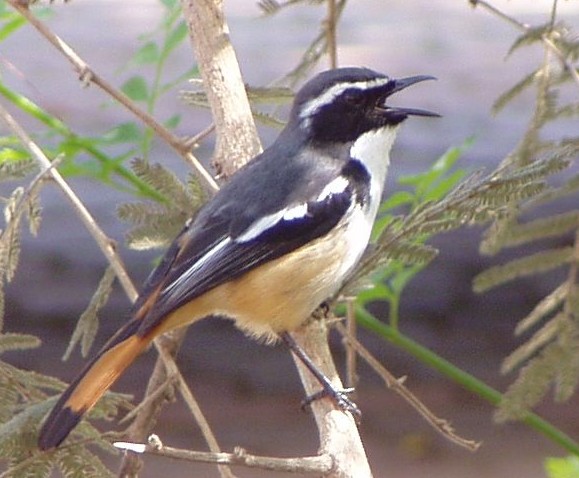
Wikipedia: White-throated robin-chat Quelle: OTHER
White-throated_Robin-Chat_%28Cossypha_humeralis%29.jpg
![]() The white-throated robin-chat or white-throated robin (Cossypha humeralis) is a species of bird in the family Muscicapidae. It is endemic to Botswana, Mozambique, South Africa, Swaziland, and Zimbabwe. Its natural habitats are dry savannah and subtropical or tropical dry shrubland.
[more]
The white-throated robin-chat or white-throated robin (Cossypha humeralis) is a species of bird in the family Muscicapidae. It is endemic to Botswana, Mozambique, South Africa, Swaziland, and Zimbabwe. Its natural habitats are dry savannah and subtropical or tropical dry shrubland.
[more]
Pogonocichla stellata / White-starred robin (Pogonocichla stellata)
Profil Wikipedia eBird Xeno-Canto

Wikipedia: White-starred robin Quelle: OTHER
White-starred_Robin_%28Pogonocichla_stellata%29.jpg
![]() The white-starred robin (Pogonocichla stellata) is a species of bird in the Old World flycatcher and chat family Muscicapidae. It is also sometimes more simply called the starred robin. It is monotypic within the genus Pogonocichla. There are around twelve subspecies. The species is found in East and southern Africa. It is a forest species, occurring in montane forest in the north of its range but closer to sea level further south. This is a brightly coloured robin with a bright yellow breast and belly, a slate coloured head with spots on the eyes and throat and blueish wings.
[more]
The white-starred robin (Pogonocichla stellata) is a species of bird in the Old World flycatcher and chat family Muscicapidae. It is also sometimes more simply called the starred robin. It is monotypic within the genus Pogonocichla. There are around twelve subspecies. The species is found in East and southern Africa. It is a forest species, occurring in montane forest in the north of its range but closer to sea level further south. This is a brightly coloured robin with a bright yellow breast and belly, a slate coloured head with spots on the eyes and throat and blueish wings.
[more]
Melaenornis pammelaina / Southern black-flycatcher (Melaenornis pammelaina)
Profil Wikipedia eBird Xeno-Canto

Wikipedia: Southern black-flycatcher Quelle: OTHER
Southern_Black-Flycatcher_%28Melaenornis_pammelaina%29.jpg
![]() The southern black flycatcher (Melaenornis pammelaina) is a small passerine bird of the genus Melaenornis in the flycatcher family, Muscicapidae, native to open and lightly wooded areas of eastern and southern Africa.[2][3]
[more]
The southern black flycatcher (Melaenornis pammelaina) is a small passerine bird of the genus Melaenornis in the flycatcher family, Muscicapidae, native to open and lightly wooded areas of eastern and southern Africa.[2][3]
[more]
Melaenornis silens / Fiscal flycatcher (Melaenornis silens)

Wikipedia: Fiscal flycatcher Quelle: OTHER
1200px-Fiscal_Flycatcher%2C_Sigelus_silens_-_male%2C_at_Suikerbosrand_Nature_Reserve%2C_Gauteng%2C_South_Africa.jpg
![]() The fiscal flycatcher (Melaenornis silens) is a small passerine bird in the Old World flycatcher family. It is a resident breeder in Botswana, South Africa, Lesotho, Mozambique and Swaziland, and a vagrant to Namibia.
[more]
The fiscal flycatcher (Melaenornis silens) is a small passerine bird in the Old World flycatcher family. It is a resident breeder in Botswana, South Africa, Lesotho, Mozambique and Swaziland, and a vagrant to Namibia.
[more]
Oenanthe pileata / Capped wheatear (Oenanthe pileata)
Profil Wikipedia eBird Xeno-Canto
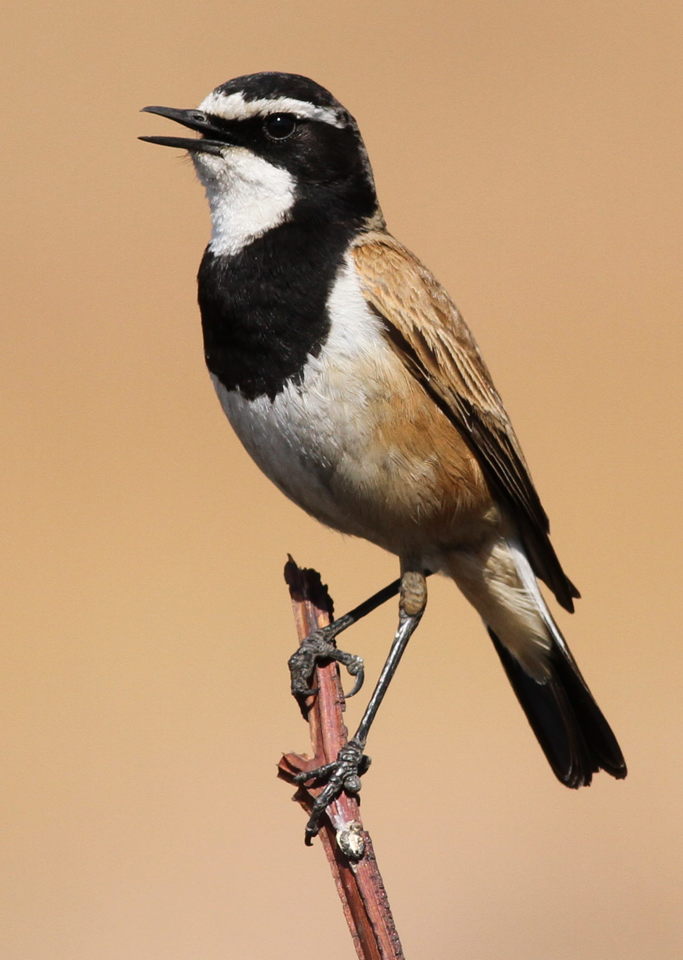
Wikipedia: Capped wheatear Quelle: OTHER
Capped_Wheatear%2C_Oenanthe_pileata_at_Suikerbosrand_Nature_Reserve%2C_Gauteng%2C_South_Africa.jpg
![]() The capped wheatear (Oenanthe pileata) is a small insectivorous passerine bird that was formerly classed as a member of the thrush family Turdidae, but is now more generally considered to be an Old World flycatcher, Muscicapidae.
[more]
The capped wheatear (Oenanthe pileata) is a small insectivorous passerine bird that was formerly classed as a member of the thrush family Turdidae, but is now more generally considered to be an Old World flycatcher, Muscicapidae.
[more]
Oenanthe familiaris / Familiar chat (Oenanthe familiaris)
Profil Wikipedia eBird Xeno-Canto

Wikipedia: Familiar chat Quelle: OTHER
1200px-Familiar_Chat_%28Cercomela_familiaris%29_%2832594787952%29.jpg
![]() The familiar chat (Oenanthe familiaris), is a small passerine bird of the Old World flycatcher family Muscicapidae. It is a common resident breeder in Africa south of the Sahara in rocky and mountainous habitat and around human habitation.
[more]
The familiar chat (Oenanthe familiaris), is a small passerine bird of the Old World flycatcher family Muscicapidae. It is a common resident breeder in Africa south of the Sahara in rocky and mountainous habitat and around human habitation.
[more]
Oenanthe pleschanka / Pied wheatear (Oenanthe pleschanka)
Profil Wikipedia eBird Xeno-Canto NABU

Wikipedia: Pied wheatear Quelle: OTHER
Pied_Wheatear_%28Oenanthe_pleschanka%29_%288079431820%29.jpg
![]() The pied wheatear (Oenanthe pleschanka) is a wheatear, a small insectivorous passerine bird that was formerly classed as a member of the thrush family Turdidae, but is now more generally considered to be an Old World flycatcher (family Muscicapidae). This migratory central Asiatic wheatear occurs from the extreme southeast of Europe to China, and has been found wintering in India and northeastern Africa. It is a very rare vagrant to western Europe.
[more]
The pied wheatear (Oenanthe pleschanka) is a wheatear, a small insectivorous passerine bird that was formerly classed as a member of the thrush family Turdidae, but is now more generally considered to be an Old World flycatcher (family Muscicapidae). This migratory central Asiatic wheatear occurs from the extreme southeast of Europe to China, and has been found wintering in India and northeastern Africa. It is a very rare vagrant to western Europe.
[more]
Psophocichla litsitsirupa / Groundscraper thrush (Psophocichla litsitsirupa)
Profil Wikipedia eBird Xeno-Canto

Wikipedia: Groundscraper thrush Quelle: OTHER
1200px-Psophocichla_litsitsirupa_%28Etosha%29.jpg
![]() The groundscraper thrush (Psophocichla litsitsirupa)[3] is a passerine bird of southern and eastern Africa belonging to the thrush family, Turdidae. It is the only member of the genus Psophocichla.
[more]
The groundscraper thrush (Psophocichla litsitsirupa)[3] is a passerine bird of southern and eastern Africa belonging to the thrush family, Turdidae. It is the only member of the genus Psophocichla.
[more]
Fraseria caerulescens / Ashy flycatcher (Fraseria caerulescens)
Profil Wikipedia eBird Xeno-Canto

Wikipedia: Ashy flycatcher Quelle: OTHER
1200px-Muscicapa_caerulescens.jpg
![]() The ashy flycatcher, blue-grey flycatcher[2] or ashy alseonax (Muscicapa caerulescens) is a species of bird in the family Muscicapidae. It is found throughout sub-Saharan Africa, excluding the drier areas of South Africa, Botswana, and Namibia. It inhabits subtropical or tropical dry forest, subtropical or tropical moist lowland forest, and savanna.[3] The species does not display sexual dimorphism, with both sexes being grey in colour with pale grey or white underparts. Different subspecies show minute differences in appearance.
[more]
The ashy flycatcher, blue-grey flycatcher[2] or ashy alseonax (Muscicapa caerulescens) is a species of bird in the family Muscicapidae. It is found throughout sub-Saharan Africa, excluding the drier areas of South Africa, Botswana, and Namibia. It inhabits subtropical or tropical dry forest, subtropical or tropical moist lowland forest, and savanna.[3] The species does not display sexual dimorphism, with both sexes being grey in colour with pale grey or white underparts. Different subspecies show minute differences in appearance.
[more]
Myrmecocichla formicivora / Southern anteater-chat (Myrmecocichla formicivora)
Profil Wikipedia eBird Xeno-Canto

Wikipedia: Southern anteater-chat Quelle: OTHER
1200px-Southern_Anteater-Chat.jpg
![]() The ant-eating chat or southern anteater-chat (Myrmecocichla formicivora) is a species of bird in the family Muscicapidae.
It is found in Botswana, Eswatini, Lesotho, Namibia, South Africa, and Zimbabwe.
Its natural habitats are subtropical or tropical dry shrubland and subtropical or tropical dry lowland grassland.
[more]
The ant-eating chat or southern anteater-chat (Myrmecocichla formicivora) is a species of bird in the family Muscicapidae.
It is found in Botswana, Eswatini, Lesotho, Namibia, South Africa, and Zimbabwe.
Its natural habitats are subtropical or tropical dry shrubland and subtropical or tropical dry lowland grassland.
[more]
Myrmecocichla arnotti / White-headed black-chat (Myrmecocichla arnotti)

Wikipedia: White-headed black-chat Quelle: OTHER
1200px-Arnot%27s_Chat_%28Myrmecocichla_arnotti%29%2C_Hwange_National_Park%2C_Zimbabwe.jpg
![]() Arnot's chat (Myrmecocichla arnotti), also known as the white-headed black-chat, is a species of bird in the chat and flycatcher family Muscicapidae. The species is found in southern Africa from Rwanda and Angola to South Africa.
[more]
Arnot's chat (Myrmecocichla arnotti), also known as the white-headed black-chat, is a species of bird in the chat and flycatcher family Muscicapidae. The species is found in southern Africa from Rwanda and Angola to South Africa.
[more]
Thamnolaea cinnamomeiventris / Mocking cliff-chat (Thamnolaea cinnamomeiventris)

Wikipedia: Mocking cliff-chat Quelle: OTHER
1200px-Thamnolaea_cinnamomeiventris_2010_10_07_11622.jpg
![]() The mocking cliff chat, mocking chat or cliff chat, (Thamnolaea cinnamomeiventris) is a species of chat in the family Muscicapidae which occurs in rocky habitats in much of eastern Sub-Saharan Africa.
[more]
The mocking cliff chat, mocking chat or cliff chat, (Thamnolaea cinnamomeiventris) is a species of chat in the family Muscicapidae which occurs in rocky habitats in much of eastern Sub-Saharan Africa.
[more]
Campicoloides bifasciatus / Buff-streaked chat (Campicoloides bifasciatus)

Wikipedia: Buff-streaked chat Quelle: OTHER
Campicoloides_bifasciatus.jpg
![]() The buff-streaked chat or buff-streaked bushchat, (Campicoloides bifasciatus) is a species of bird in the family Muscicapidae. It is found in Lesotho, South Africa, and Swaziland.
Its natural habitat is subtropical or tropical dry lowland grassland.
[more]
The buff-streaked chat or buff-streaked bushchat, (Campicoloides bifasciatus) is a species of bird in the family Muscicapidae. It is found in Lesotho, South Africa, and Swaziland.
Its natural habitat is subtropical or tropical dry lowland grassland.
[more]
Cichladusa arquata / Collared palm-thrush (Cichladusa arquata)
Profil Wikipedia eBird Xeno-Canto

Wikipedia: Collared palm-thrush Quelle: OTHER
1200px-Cichladusa_arquata_-near_Jongomero%2C_Ruaha_National_Park%2C_Tanzania_-two-8.jpg
![]() The collared palm thrush (Cichladusa arquata) is a species of bird in the family Muscicapidae.
It is found in Botswana, Burundi, Democratic Republic of the Congo, Kenya, Malawi, Mozambique, Rwanda, Tanzania, Uganda, Zambia, and Zimbabwe.
Its natural habitats are dry savannah and subtropical or tropical moist shrubland.
[more]
The collared palm thrush (Cichladusa arquata) is a species of bird in the family Muscicapidae.
It is found in Botswana, Burundi, Democratic Republic of the Congo, Kenya, Malawi, Mozambique, Rwanda, Tanzania, Uganda, Zambia, and Zimbabwe.
Its natural habitats are dry savannah and subtropical or tropical moist shrubland.
[more]
Irania gutturalis / White-throated robin (Irania gutturalis)

Wikipedia: White-throated robin Quelle: OTHER
BessornisAlbigularisWolf%2C_crop.jpg
![]() The white-throated robin (Irania gutturalis), or irania, is a small, sexually dimorphic, migratory passerine bird.[2] The vernacular and genus name Irania alludes to Iran, its type locality, while the specific name gutturalis is Medieval Latin for "of the throat".[3] It breeds in western Asia and overwinters in East Africa.
[more]
The white-throated robin (Irania gutturalis), or irania, is a small, sexually dimorphic, migratory passerine bird.[2] The vernacular and genus name Irania alludes to Iran, its type locality, while the specific name gutturalis is Medieval Latin for "of the throat".[3] It breeds in western Asia and overwinters in East Africa.
[more]

Wikipedia: African spotted creeper Quelle: OTHER
1200px-SalpornisEminiKeulemans.jpg
![]() The African spotted creeper (Salpornis salvadori) is a small passerine bird, which is a member of the subfamily Salpornithinae of the treecreeper family Certhiidae. It is found in sub-Saharan Africa in open deciduous forest and mango groves. It does not migrate other than local movements.
[more]
The African spotted creeper (Salpornis salvadori) is a small passerine bird, which is a member of the subfamily Salpornithinae of the treecreeper family Certhiidae. It is found in sub-Saharan Africa in open deciduous forest and mango groves. It does not migrate other than local movements.
[more]
Smithornis capensis / African broadbill (Smithornis capensis)
Profil Wikipedia eBird Xeno-Canto

Wikipedia: African broadbill Quelle: OTHER
1200px-African_broadbill%2C_Smithornis_capensis.jpg
![]() The African broadbill, also known as the black-capped broadbill or Delacour's broadbill[4] (Smithornis capensis) is a species of bird in the sub-oscine family Calyptomenidae.
[more]
The African broadbill, also known as the black-capped broadbill or Delacour's broadbill[4] (Smithornis capensis) is a species of bird in the sub-oscine family Calyptomenidae.
[more]
Chaetops aurantius / Drakensberg rockjumper (Chaetops aurantius)
Profil Wikipedia eBird Xeno-Canto

Wikipedia: Drakensberg rockjumper Quelle: OTHER
1200px-Drakensberg_rockjumper_2012_11_11_2064_crop.jpg
![]() The Drakensberg rockjumper or orange-breasted rockjumper (Chaetops aurantius) is a medium-sized insectivorous passerine bird endemic to the alpine grasslands and rock outcrops of the Drakensberg Mountains of southeastern South Africa and Lesotho. This taxon is closely related to the allopatric Cape rockjumper Chaetops frenatus; the two species of Chaetops are the only living members of the Chaetopidae (rockjumper family).
[more]
The Drakensberg rockjumper or orange-breasted rockjumper (Chaetops aurantius) is a medium-sized insectivorous passerine bird endemic to the alpine grasslands and rock outcrops of the Drakensberg Mountains of southeastern South Africa and Lesotho. This taxon is closely related to the allopatric Cape rockjumper Chaetops frenatus; the two species of Chaetops are the only living members of the Chaetopidae (rockjumper family).
[more]
Chaetops frenatus / Rufous rock-jumper (Chaetops frenatus)

Wikipedia: Rufous rock-jumper Quelle: OTHER
Cape_Rock-Jumper.jpg
![]() The Cape Rockjumper or rufous rockjumper (Chaetops frenatus) is a medium-sized insectivorous passerine bird endemic to the mountain Fynbos of southernmost South Africa.
[more]
The Cape Rockjumper or rufous rockjumper (Chaetops frenatus) is a medium-sized insectivorous passerine bird endemic to the mountain Fynbos of southernmost South Africa.
[more]
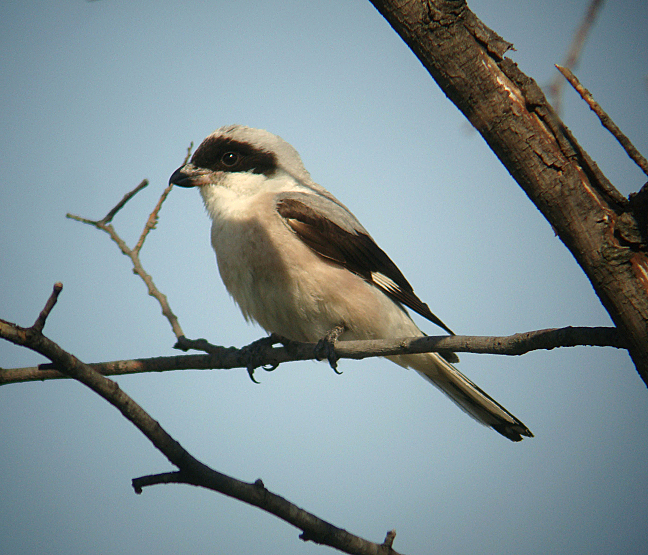
Wikipedia: Lesser grey shrike Quelle: OTHER
Lesser_Grey_Shrike_by_Daniel_Bastaja.jpg
![]() Der Schwarzstirnwürger (Lanius minor) ist ein Vertreter der Gattung Lanius innerhalb der Familie der Würger (Laniidae). Schwarzstirnwürger gleichen stark Arten aus der Gruppe der Raubwürger, sind jedoch etwas kleiner. Der obligate Langstreckenzieher mit Überwinterungsgebieten in den Steppengebieten der Kalahari ist von Ost- und Südosteuropa ostwärts bis Zentralasien verbreitet. Die Art war noch zur Mitte des 20. Jahrhunderts in vielen Gebieten West- und Mitteleuropas Brutvogel. Heute ist er in diesen Bereichen selten geworden und vielerorts ganz verschwunden.
[more]
Der Schwarzstirnwürger (Lanius minor) ist ein Vertreter der Gattung Lanius innerhalb der Familie der Würger (Laniidae). Schwarzstirnwürger gleichen stark Arten aus der Gruppe der Raubwürger, sind jedoch etwas kleiner. Der obligate Langstreckenzieher mit Überwinterungsgebieten in den Steppengebieten der Kalahari ist von Ost- und Südosteuropa ostwärts bis Zentralasien verbreitet. Die Art war noch zur Mitte des 20. Jahrhunderts in vielen Gebieten West- und Mitteleuropas Brutvogel. Heute ist er in diesen Bereichen selten geworden und vielerorts ganz verschwunden.
[more]
Gesang: ![]() Two very different types of territorial song: Most diagnostic is the short song which consists of a single, parakeet-like "irtscha". Like in a sneeze, with rapidly rising and falling pitch. Given monosyllabic, disyllabic or in series. Other song type very varied with lots of mimicry of other birds and mammals. Similar to Woodchat Shrike but usually also includes the call from the short song. The varied song is more subdued in mated males. [Link]
Two very different types of territorial song: Most diagnostic is the short song which consists of a single, parakeet-like "irtscha". Like in a sneeze, with rapidly rising and falling pitch. Given monosyllabic, disyllabic or in series. Other song type very varied with lots of mimicry of other birds and mammals. Similar to Woodchat Shrike but usually also includes the call from the short song. The varied song is more subdued in mated males. [Link]
Rufe: ![]() Contact call a series of Magpie-like "che-che-che". [Link]
Contact call a series of Magpie-like "che-che-che". [Link]
Körperlich: Länge=20 cm,
Flügelspanne=32-34 cm,
Gewicht=41-50 g
Profil Wikipedia eBird Xeno-Canto

Wikipedia: Southern fiscal Quelle: OTHER
1200px-Common_fiscal_%28Lanius_collaris_subcoronatus%29.jpg
Allgemein: ![]() The southern fiscal, common fiscal or fiscal shrike (Lanius collaris) is a member of the shrike family found through most of Sub-Saharan Africa. It is also sometimes named jackie hangman or butcher bird due to its habit of impaling its prey on acacia thorns to store the food for later consumption. It was previously lumped together with the northern fiscal (Lanius humeralis).[2] Together they were known as the common fiscal.
[more]
The southern fiscal, common fiscal or fiscal shrike (Lanius collaris) is a member of the shrike family found through most of Sub-Saharan Africa. It is also sometimes named jackie hangman or butcher bird due to its habit of impaling its prey on acacia thorns to store the food for later consumption. It was previously lumped together with the northern fiscal (Lanius humeralis).[2] Together they were known as the common fiscal.
[more]
Profil Wikipedia eBird Xeno-Canto

Wikipedia: Magpie shrike Quelle: OTHER
1200px-Urolestes_melanoleucus_-Limpopo%2C_South_Africa-8.jpg
![]() The magpie shrike (Urolestes melanoleucus), also known as the African long-tailed shrike, is a species of bird in the family Laniidae. It is monotypic within the genus Urolestes.[2] It is native to the grasslands of eastern and southeastern Africa, where its natural habitats are dry savannah, moist savannah, and subtropical or tropical dry shrubland. It has a very wide range and is common in places, and the International Union for Conservation of Nature has assessed its conservation status as being of "least concern".[1]
[more]
The magpie shrike (Urolestes melanoleucus), also known as the African long-tailed shrike, is a species of bird in the family Laniidae. It is monotypic within the genus Urolestes.[2] It is native to the grasslands of eastern and southeastern Africa, where its natural habitats are dry savannah, moist savannah, and subtropical or tropical dry shrubland. It has a very wide range and is common in places, and the International Union for Conservation of Nature has assessed its conservation status as being of "least concern".[1]
[more]
Profil Wikipedia eBird Xeno-Canto

Wikipedia: White-crowned shrike Quelle: OTHER
1200px-Southern_White-crowned_Shrike%2C_Eurocephalus_anguitimens%2C_gleaning_ants_from_the_early_morning_soil_at_Marakele_National_Park%2C_South_Africa_%2813952312157%29.jpg
![]() The southern white-crowned shrike (Eurocephalus anguitimens) is a species of bird in the family Laniidae. It is found in Angola, Botswana, Mozambique, Namibia, South Africa, and Zimbabwe. Its natural habitats are subtropical or tropical dry forests and dry savannah.[1]
[more]
The southern white-crowned shrike (Eurocephalus anguitimens) is a species of bird in the family Laniidae. It is found in Angola, Botswana, Mozambique, Namibia, South Africa, and Zimbabwe. Its natural habitats are subtropical or tropical dry forests and dry savannah.[1]
[more]
Profil Wikipedia eBird Xeno-Canto
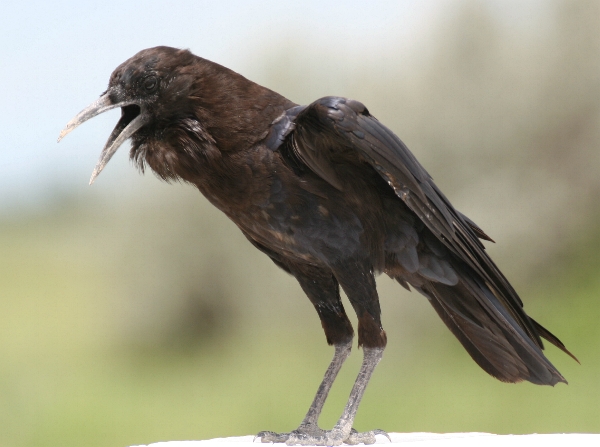
Wikipedia: Cape crow Quelle: OTHER
Cape_crow.jpg
![]() The Cape crow or black crow (Corvus capensis) is slightly larger (48–50 cm in length) than the carrion crow and is completely black with a slight gloss of purple in its feathers. It has proportionately longer legs, wings and tail too and has a much longer, slimmer bill that seems to be adapted for probing into the ground for invertebrates. The head feathers have a coppery-purple gloss and the throat feathers are quite long and fluffed out in some calls and displays.
[more]
The Cape crow or black crow (Corvus capensis) is slightly larger (48–50 cm in length) than the carrion crow and is completely black with a slight gloss of purple in its feathers. It has proportionately longer legs, wings and tail too and has a much longer, slimmer bill that seems to be adapted for probing into the ground for invertebrates. The head feathers have a coppery-purple gloss and the throat feathers are quite long and fluffed out in some calls and displays.
[more]
Profil Wikipedia eBird Xeno-Canto

Wikipedia: House crow Quelle: OTHER
1200px-Crow_eating_and_slobbering_on_dead_fish.jpg
![]() Die Glanzkrähe (Corvus splendens) ist eine Vogelart der Gattung Raben und Krähen (Corvus) aus der Familie der Rabenvögel (Corvidae). Innerhalb der Gattung Corvus stellt sie eine schlanke, mittelgroße Art dar und ist durch ein glänzendes, grau-schwarzes Gefieder und einen langen Schnabel gekennzeichnet. Ihr ursprüngliches Verbreitungsgebiet liegt auf dem Indischen Subkontinent und in Westindochina. Seit dem 19. Jahrhundert wurde sie vom Menschen auf Schiffen nach Afrika, Arabien, Europa, Japan und Australien verschleppt, wo sie sich zeitweise oder dauerhaft etablieren konnte. Die Glanzkrähe ist seit mehreren Jahrtausenden mit dem Menschen vergesellschaftet und kommt heute ausschließlich in seiner Nähe vor. Sie ernährt sich von allen verfügbaren tierischen und pflanzlichen Nahrungsquellen in ihrer Umwelt und tritt selbst größeren Krähen gegenüber dominant und teilweise aggressiv auf.
[more]
Die Glanzkrähe (Corvus splendens) ist eine Vogelart der Gattung Raben und Krähen (Corvus) aus der Familie der Rabenvögel (Corvidae). Innerhalb der Gattung Corvus stellt sie eine schlanke, mittelgroße Art dar und ist durch ein glänzendes, grau-schwarzes Gefieder und einen langen Schnabel gekennzeichnet. Ihr ursprüngliches Verbreitungsgebiet liegt auf dem Indischen Subkontinent und in Westindochina. Seit dem 19. Jahrhundert wurde sie vom Menschen auf Schiffen nach Afrika, Arabien, Europa, Japan und Australien verschleppt, wo sie sich zeitweise oder dauerhaft etablieren konnte. Die Glanzkrähe ist seit mehreren Jahrtausenden mit dem Menschen vergesellschaftet und kommt heute ausschließlich in seiner Nähe vor. Sie ernährt sich von allen verfügbaren tierischen und pflanzlichen Nahrungsquellen in ihrer Umwelt und tritt selbst größeren Krähen gegenüber dominant und teilweise aggressiv auf.
[more]
Profil Wikipedia eBird Xeno-Canto

Wikipedia: Pied crow Quelle: OTHER
1200px-Corvus_albus_-Etosha_National_Park%2C_Namibia-8.jpg
![]() Der Schildrabe (Corvus albus) ist der in Afrika am weitesten verbreitete Rabenvogel. Seinen deutschen sowie seinen wissenschaftlichen Namen verdankt er der Schild-förmigen weißen (lat. albus) Brust- und Halspartie.
[more]
Der Schildrabe (Corvus albus) ist der in Afrika am weitesten verbreitete Rabenvogel. Seinen deutschen sowie seinen wissenschaftlichen Namen verdankt er der Schild-förmigen weißen (lat. albus) Brust- und Halspartie.
[more]

Wikipedia: White-necked raven Quelle: OTHER
1200px-2009-white-necked-raven.jpg
![]() Der Geierrabe (Corvus albicollis) ist eine Singvogelart aus der Familie der Rabenvögel (Corvidae). Der überwiegend schwarze Vogel mit weißem Nacken ist ein großer Vertreter der Raben und Krähen (Corvus) und bewohnt Bergland und Steilküsten im östlichen und südlichen Afrika. Seine Nahrung besteht aus einer Vielzahl verschiedener Insekten und Kleinwirbeltiere sowie aus Aas, menschlichen Abfällen und Früchten. Geierraben leben in der Regel paarweise und bleiben dann das ganze Leben zusammen, können sich aber auch zu größeren Schwärmen mit Artgenossen und anderen Krähen zusammenfinden.
[more]
Der Geierrabe (Corvus albicollis) ist eine Singvogelart aus der Familie der Rabenvögel (Corvidae). Der überwiegend schwarze Vogel mit weißem Nacken ist ein großer Vertreter der Raben und Krähen (Corvus) und bewohnt Bergland und Steilküsten im östlichen und südlichen Afrika. Seine Nahrung besteht aus einer Vielzahl verschiedener Insekten und Kleinwirbeltiere sowie aus Aas, menschlichen Abfällen und Früchten. Geierraben leben in der Regel paarweise und bleiben dann das ganze Leben zusammen, können sich aber auch zu größeren Schwärmen mit Artgenossen und anderen Krähen zusammenfinden.
[more]

Wikipedia: African golden-oriole Quelle: OTHER
1200px-African_golden_oriole_%28Oriolus_auratus_notatus%29.jpg
![]()
The African golden oriole (Oriolus auratus), or African oriole, is a member of the oriole family of passerine birds which is a resident breeder in Africa south of the Sahara desert.
[more]
Profil Wikipedia eBird Xeno-Canto

Wikipedia: African black-headed oriole Quelle: OTHER
1200px-Orop%C3%A9ndola_enmascarada_%28Oriolus_larvatus%29%2C_parque_nacional_Kruger%2C_Sud%C3%A1frica%2C_2018-07-25%2C_DD_44.jpg
![]() Der Maskenpirol (Oriolus larvatus) ist eine Vogelart aus der Familie der Pirole. Er ist in Ostafrika und dem südlichen Afrika verbreitet und lebt bevorzugt in Akazienwäldern und baumbestandenen Savannen von der Küste bis in Höhen von 2300 Metern.
[more]
Der Maskenpirol (Oriolus larvatus) ist eine Vogelart aus der Familie der Pirole. Er ist in Ostafrika und dem südlichen Afrika verbreitet und lebt bevorzugt in Akazienwäldern und baumbestandenen Savannen von der Küste bis in Höhen von 2300 Metern.
[more]

Wikipedia: Tropical boubou Quelle: OTHER
1200px-Tropical_Boubou%2C_Sakania%2C_DRC_%289436772164%29.jpg
![]() The tropical boubou or bell shrike (Laniarius major) is a medium-sized passerine bird of sub-Saharan Africa. This very diverse "species" with its numerous subspecies and morphs has since long posed a taxonomic problem, and recent research suggests it is a cryptic species complex that has now been split into several species.[2]
[more]
The tropical boubou or bell shrike (Laniarius major) is a medium-sized passerine bird of sub-Saharan Africa. This very diverse "species" with its numerous subspecies and morphs has since long posed a taxonomic problem, and recent research suggests it is a cryptic species complex that has now been split into several species.[2]
[more]
Profil Wikipedia eBird Xeno-Canto

Wikipedia: Southern boubou Quelle: OTHER
1200px-Laniarius_ferrugineus00.jpg
![]() The southern boubou (Laniarius ferrugineus) ('ferrugineus' - rust-coloured) is a bushshrike. Though these passerine birds and their relations were once included with true shrikes in the Laniidae, they are not closely related to that family.
[more]
The southern boubou (Laniarius ferrugineus) ('ferrugineus' - rust-coloured) is a bushshrike. Though these passerine birds and their relations were once included with true shrikes in the Laniidae, they are not closely related to that family.
[more]
Profil Wikipedia eBird Xeno-Canto

Wikipedia: Crimson-breasted gonolek Quelle: OTHER
Laniarius_atrococcineus_-Pretoria%2C_South_Africa-8_%282%29.jpg
![]() Der Rotbauchwürger (Laniarius atrococcineus) ist eine Art in der Gattung Lanarius in der Familie der Buschwürger (Malaconotidae). Früher wurden sie der Familie der Würger (Laniidae) zugerechnet, heute bilden sie eine eigene Familie.
[more]
Der Rotbauchwürger (Laniarius atrococcineus) ist eine Art in der Gattung Lanarius in der Familie der Buschwürger (Malaconotidae). Früher wurden sie der Familie der Würger (Laniidae) zugerechnet, heute bilden sie eine eigene Familie.
[more]
Profil Wikipedia eBird Xeno-Canto
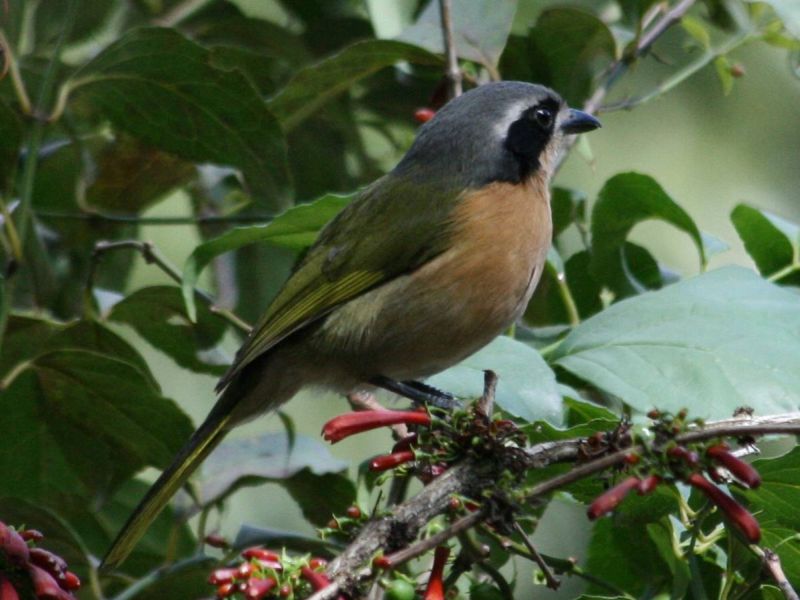
Wikipedia: Olive bushshrike Quelle: OTHER
Olive_Bushshrike_%28Telophorus_olivaceus%29.jpg
![]() The olive bushshrike (Chlorophoneus olivaceus) is a species of bird in the family Malaconotidae.
It is found in Malawi, Mozambique, South Africa, Swaziland, and Zimbabwe.
Its natural habitats are subtropical or tropical dry forest, subtropical or tropical moist lowland forest, subtropical or tropical moist montane forest, and subtropical or tropical dry shrubland.
[more]
The olive bushshrike (Chlorophoneus olivaceus) is a species of bird in the family Malaconotidae.
It is found in Malawi, Mozambique, South Africa, Swaziland, and Zimbabwe.
Its natural habitats are subtropical or tropical dry forest, subtropical or tropical moist lowland forest, subtropical or tropical moist montane forest, and subtropical or tropical dry shrubland.
[more]

Wikipedia: Four-coloured bushshrike Quelle: OTHER
1200px-Telophorus_quadricolor_1884.jpg
![]() The gorgeous bushshrike (Telophorus viridis) is a species of bird in the family Malaconotidae. It is also known as the four-coloured bushshrike. Some use the name gorgeous bushshrike for the subspecies Telophorus viridis viridis only.
[more]
The gorgeous bushshrike (Telophorus viridis) is a species of bird in the family Malaconotidae. It is also known as the four-coloured bushshrike. Some use the name gorgeous bushshrike for the subspecies Telophorus viridis viridis only.
[more]
Profil Wikipedia eBird Xeno-Canto

Wikipedia: Black-backed puffback Quelle: OTHER
690V4679_-_Flickr_-_Lip_Kee%2C_crop.jpg
![]() The black-backed puffback (Dryoscopus cubla) is a species of passerine bird in the family Malaconotidae. They are common to fairly common sedentary bushshrikes in various wooded habitats in Africa south of the equator. They restlessly move about singly, in pairs or family groups, and generally frequent tree canopies. Like others of its genus, the males puff out the loose rump and lower back feathers in display, to assume a remarkable ball-like appearance.[2] They draw attention to themselves by their varied repertoire of whistling, clicking and rasping sounds. Their specific name cubla, originated with Francois Levaillant, who derived it from a native southern African name, where the "c" is an onomatopoeic click sound.[3] None of the other five puffback species occur in southern Africa.
[more]
The black-backed puffback (Dryoscopus cubla) is a species of passerine bird in the family Malaconotidae. They are common to fairly common sedentary bushshrikes in various wooded habitats in Africa south of the equator. They restlessly move about singly, in pairs or family groups, and generally frequent tree canopies. Like others of its genus, the males puff out the loose rump and lower back feathers in display, to assume a remarkable ball-like appearance.[2] They draw attention to themselves by their varied repertoire of whistling, clicking and rasping sounds. Their specific name cubla, originated with Francois Levaillant, who derived it from a native southern African name, where the "c" is an onomatopoeic click sound.[3] None of the other five puffback species occur in southern Africa.
[more]

Wikipedia: Grey-headed bushshrike Quelle: OTHER
1200px-Grey-headed_Bushshrike_%28Malaconotus_blanchoti%29_in_tree.jpg
![]() The grey-headed bushshrike (Malaconotus blanchoti) is a species of bird in the family Malaconotidae.
It is widespread throughout Sub-Saharan Africa, although relatively absent in Central and Southern Africa.
Its natural habitats are dry savannah and moist savannah.
[more]
The grey-headed bushshrike (Malaconotus blanchoti) is a species of bird in the family Malaconotidae.
It is widespread throughout Sub-Saharan Africa, although relatively absent in Central and Southern Africa.
Its natural habitats are dry savannah and moist savannah.
[more]
Profil Wikipedia eBird Xeno-Canto
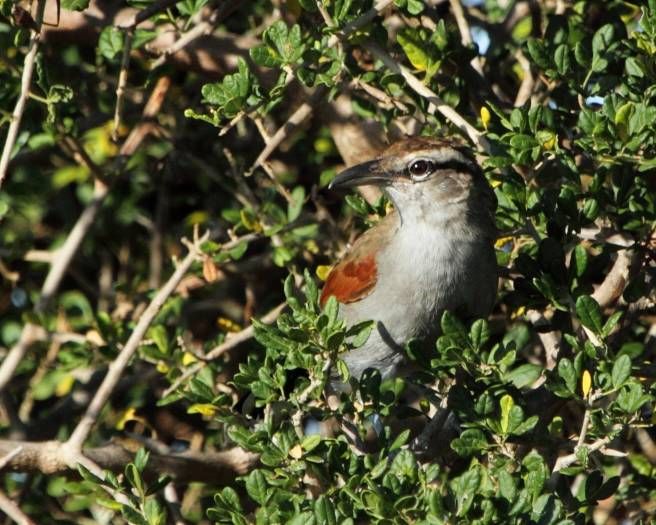
Wikipedia: Southern tchagra Quelle: OTHER
Tchagra_Southern_2013_02_24a.jpg
![]() The southern tchagra (Tchagra tchagra) is a passerine bird found in dense scrub and coastal bush in southern and south-eastern South Africa and Swaziland.
[more]
The southern tchagra (Tchagra tchagra) is a passerine bird found in dense scrub and coastal bush in southern and south-eastern South Africa and Swaziland.
[more]
Profil Wikipedia eBird Xeno-Canto

Wikipedia: Brown-crowned tchagra Quelle: OTHER
Brown-crowned_Tchagra.jpg
![]() The brown-crowned tchagra (Tchagra australis) is a species of bird in the family Malaconotidae.
[more]
The brown-crowned tchagra (Tchagra australis) is a species of bird in the family Malaconotidae.
[more]

Wikipedia: Black-crowned tchagra Quelle: OTHER
1200px-Black-crowned_Tchagra%2C_Tchagra_senegala.jpg
![]() The black-crowned tchagra (Tchagra senegalus) is a bushshrike. This family of passerine birds is closely related to the true shrikes in the family Laniidae, and was once included in that group.
[more]
The black-crowned tchagra (Tchagra senegalus) is a bushshrike. This family of passerine birds is closely related to the true shrikes in the family Laniidae, and was once included in that group.
[more]
Profil Wikipedia eBird Xeno-Canto

Wikipedia: Brubru Quelle: OTHER
1200px-Brubru.jpg
![]() The brubru (Nilaus afer) is a species of bushshrike (family Malconotidae) found in most of Sub-Saharan Africa. It is the only member of the genus Nilaus.
[more]
The brubru (Nilaus afer) is a species of bushshrike (family Malconotidae) found in most of Sub-Saharan Africa. It is the only member of the genus Nilaus.
[more]

Wikipedia: Sulphur-breasted bushshrike Quelle: OTHER
Chlorophoneus_sulfureopectus%2C_Polokwane_Wildtuin.jpg
![]() The orange-breasted bushshrike or sulphur-breasted bushshrike (Chlorophoneus sulfureopectus) is a species of bird in the family Malaconotidae.
It is widespread throughout Sub-Saharan Africa (relatively absent from most of Central, Southern and the Horn of Africa).
Its natural habitats are subtropical or tropical dry forests, dry savanna and moist savanna. Another species, Braun's bushshrike, is sometimes called orange-breasted bushshrike, as well.
[more]
The orange-breasted bushshrike or sulphur-breasted bushshrike (Chlorophoneus sulfureopectus) is a species of bird in the family Malaconotidae.
It is widespread throughout Sub-Saharan Africa (relatively absent from most of Central, Southern and the Horn of Africa).
Its natural habitats are subtropical or tropical dry forests, dry savanna and moist savanna. Another species, Braun's bushshrike, is sometimes called orange-breasted bushshrike, as well.
[more]

Wikipedia: Black-fronted bushshrike Quelle: OTHER
1200px-MalaconotusManningiKeulemans.jpg
![]() The black-fronted bushshrike (Chlorophoneus nigrifrons) is a passerine bird of the bushshrike family, Malaconotidae. It inhabits forests mainly in East Africa. It forms a superspecies with the many-colored bushshrike (C. multicolor) and the two are sometimes considered to be a single species.
[more]
The black-fronted bushshrike (Chlorophoneus nigrifrons) is a passerine bird of the bushshrike family, Malaconotidae. It inhabits forests mainly in East Africa. It forms a superspecies with the many-colored bushshrike (C. multicolor) and the two are sometimes considered to be a single species.
[more]

Wikipedia: Common square-tailed drongo Quelle: OTHER
Square-tailed_Drongo_%28Dicrurus_ludwigii%29.jpg
![]() Der Geradschwanzdrongo (Dicrurus ludwigii) ist eine Vogelart aus der Familie der Drongos.[1]
[more]
Der Geradschwanzdrongo (Dicrurus ludwigii) ist eine Vogelart aus der Familie der Drongos.[1]
[more]
Profil Wikipedia eBird Xeno-Canto

Wikipedia: Fork-tailed drongo Quelle: OTHER
Fork-tailed_Drongo_%28Dicrurus_adsimilis%29_2.jpg
![]() The fork-tailed drongo, also called the common drongo, African drongo, or savanna drongo (Dicrurus adsimilis), is a species of drongo in the family Dicruridae, which are medium-sized[2] passerine birds of the Old World. It is native to the tropics, subtropics and temperate zones of the Afrotropics. Its range was formerly considered to include Asia, but the Asian species is now called the black drongo (Dicrurus macrocercus).
[more]
The fork-tailed drongo, also called the common drongo, African drongo, or savanna drongo (Dicrurus adsimilis), is a species of drongo in the family Dicruridae, which are medium-sized[2] passerine birds of the Old World. It is native to the tropics, subtropics and temperate zones of the Afrotropics. Its range was formerly considered to include Asia, but the Asian species is now called the black drongo (Dicrurus macrocercus).
[more]
Profil Wikipedia eBird Xeno-Canto

Wikipedia: Livingstone's flycatcher Quelle: OTHER
Livingstone%27s_Flycatcher_-_Malawi_S4E3726_%2818824261563%29.jpg
![]() Livingstone's flycatcher (Erythrocercus livingstonei) is a species of bird in the family Erythrocercidae.
It is found in Malawi, Mozambique, Tanzania, Zambia, and Zimbabwe.
Its natural habitats are subtropical or tropical dry forests and subtropical or tropical moist shrubland.
[more]
Livingstone's flycatcher (Erythrocercus livingstonei) is a species of bird in the family Erythrocercidae.
It is found in Malawi, Mozambique, Tanzania, Zambia, and Zimbabwe.
Its natural habitats are subtropical or tropical dry forests and subtropical or tropical moist shrubland.
[more]
Profil Wikipedia eBird Xeno-Canto
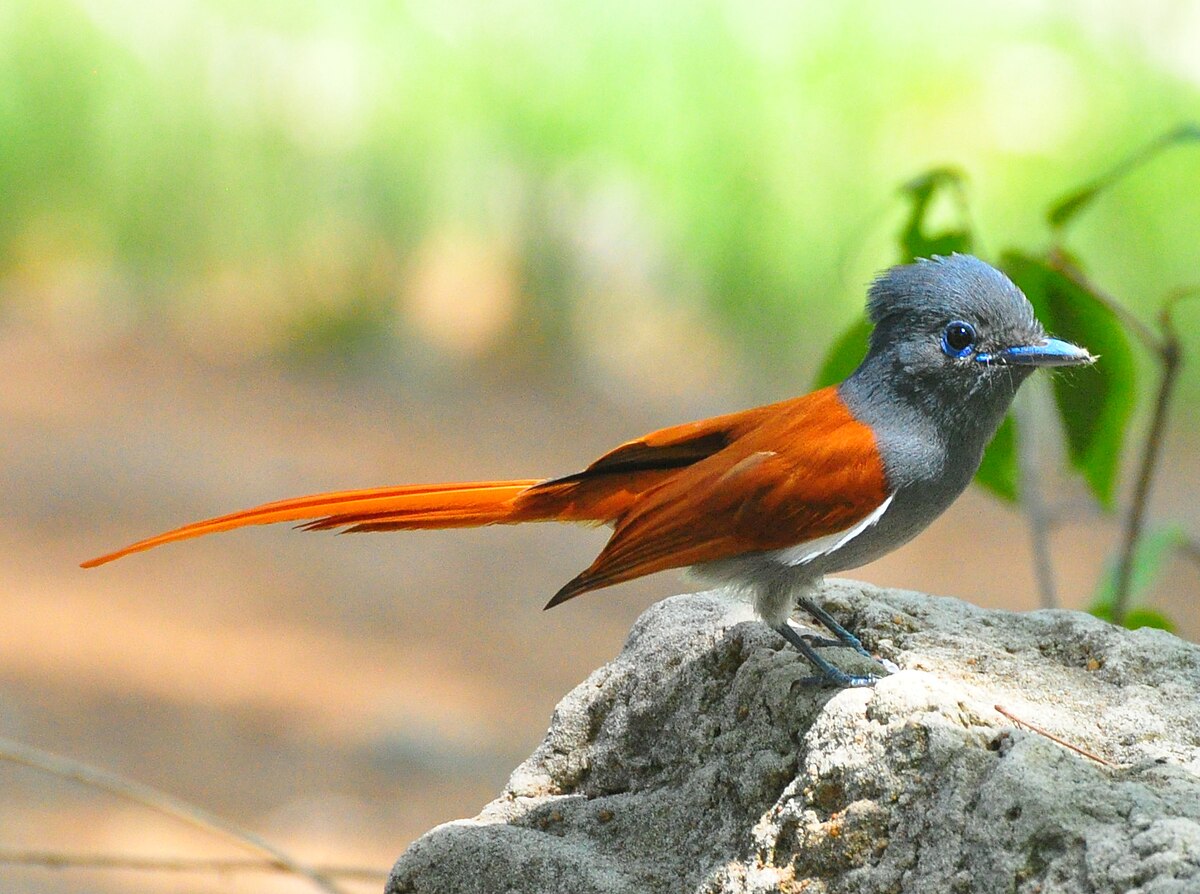
Wikipedia: African paradise-flycatcher Quelle: OTHER
1200px-Terpsiphone_viridis_-_African_Paradise_Flycatcher.jpg
![]() The African paradise flycatcher (Terpsiphone viridis) is a medium-sized passerine bird. The two central tail feathers of the male are extended into streamers that commonly are more than twice as long as the body. The female tail feathers are of moderate length and without streamers. The upper parts of the male body, wings, and tail are boldly coloured in chestnut or rusty shades, but the underparts and the head are variably grey to blue-gray, with the head of the mature male being darker, commonly glossy black with greenish highlights. The beak and other bare areas, including a wattle ring round the eye, match the colour of the surrounding feathers. The female coloration is similar, though not so showy and glossy and with the head paler.
[more]
The African paradise flycatcher (Terpsiphone viridis) is a medium-sized passerine bird. The two central tail feathers of the male are extended into streamers that commonly are more than twice as long as the body. The female tail feathers are of moderate length and without streamers. The upper parts of the male body, wings, and tail are boldly coloured in chestnut or rusty shades, but the underparts and the head are variably grey to blue-gray, with the head of the mature male being darker, commonly glossy black with greenish highlights. The beak and other bare areas, including a wattle ring round the eye, match the colour of the surrounding feathers. The female coloration is similar, though not so showy and glossy and with the head paler.
[more]
Profil Wikipedia eBird Xeno-Canto

Wikipedia: African crested-flycatcher Quelle: OTHER
African_Crested-Flycatcher_%28Trochocercus_cyanomelas%29.jpg
![]() The blue-mantled crested flycatcher or African crested flycatcher (Trochocercus cyanomelas) is a species of bird in the family Monarchidae found in eastern and south-eastern Africa.
[more]
The blue-mantled crested flycatcher or African crested flycatcher (Trochocercus cyanomelas) is a species of bird in the family Monarchidae found in eastern and south-eastern Africa.
[more]

Wikipedia: White helmetshrike Quelle: OTHER
1200px-White_Helmetshrike.jpg
![]() Der Weißschopf-Brillenwürger (Prionops plumatus) ist ein bis zu 25 Zentimeter großer Vertreter der Sperlingsvögel.
[more]
Der Weißschopf-Brillenwürger (Prionops plumatus) ist ein bis zu 25 Zentimeter großer Vertreter der Sperlingsvögel.
[more]
Profil Wikipedia eBird Xeno-Canto

Wikipedia: Black-throated wattle-eye Quelle: OTHER
Female_Black-throated_Wattle-eye_%28Platysteira_peltata%29_front_view.jpg
![]() The black-throated wattle-eye (Platysteira peltata) is a species of bird in the family Platysteiridae.
It is found in Angola, Burundi, Democratic Republic of the Congo, Eswatini, Kenya, Malawi, Mozambique, Somalia, South Africa, Tanzania, Uganda, Zambia, and Zimbabwe.
[more]
The black-throated wattle-eye (Platysteira peltata) is a species of bird in the family Platysteiridae.
It is found in Angola, Burundi, Democratic Republic of the Congo, Eswatini, Kenya, Malawi, Mozambique, Somalia, South Africa, Tanzania, Uganda, Zambia, and Zimbabwe.
[more]
Profil Wikipedia eBird Xeno-Canto
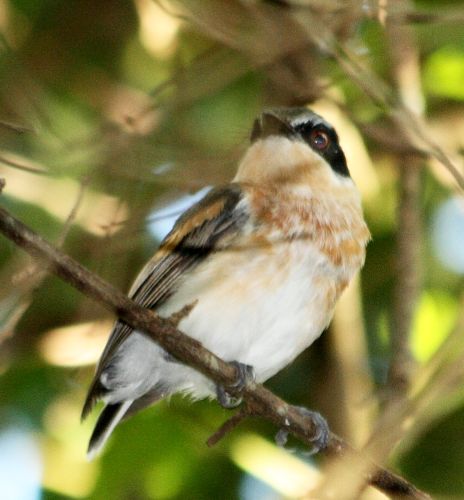
Wikipedia: Woodward's batis Quelle: OTHER
Woodwards_Batis_%28Batis_fratrum%29.jpg
![]() Woodward's batis (Batis fratrum), also known as Woodwards' batis or the Zululand batis, is a species of small bird in the wattle-eyes family, Platysteiridae. It occurs in southeastern Africa where it is found in woodlands and forests.
[more]
Woodward's batis (Batis fratrum), also known as Woodwards' batis or the Zululand batis, is a species of small bird in the wattle-eyes family, Platysteiridae. It occurs in southeastern Africa where it is found in woodlands and forests.
[more]

Wikipedia: Cape batis Quelle: OTHER
Bosbontrokkie_vroulik.png
![]() The Cape batis (Batis capensis) is a small, stout insect-eating passerine bird in the wattle-eye family. It is endemic to the Afromontane forests of southern Africa.
[more]
The Cape batis (Batis capensis) is a small, stout insect-eating passerine bird in the wattle-eye family. It is endemic to the Afromontane forests of southern Africa.
[more]
Profil Wikipedia eBird Xeno-Canto

Wikipedia: Chinspot batis Quelle: OTHER
1200px-Chinspot_batis%2C_Batis_molitor%2C_at_Pilanesberg_National_Park%2C_Northwest_Province%2C_South_Africa_%2828202590270%29%2C_crop.jpg
![]() The chinspot batis (Batis molitor) is a small songbird of the genus Batis in the family Platysteiridae which is a common and widespread species in the woodlands of southern Africa from the Eastern Cape north to 3°N in southern Kenya and Gabon. It forms a superspecies with other rather similar members of the genus Batis.
[more]
The chinspot batis (Batis molitor) is a small songbird of the genus Batis in the family Platysteiridae which is a common and widespread species in the woodlands of southern Africa from the Eastern Cape north to 3°N in southern Kenya and Gabon. It forms a superspecies with other rather similar members of the genus Batis.
[more]

Wikipedia: Pririt batis Quelle: OTHER
1200px-Pririt_batis_%28Batis_pririt_affinis%29_male.jpg
![]() The pririt batis (Batis pririt) also known as the pririt puff-back flycatcher or pririt puffback, is a small passerine bird in the wattle-eye family. It is resident in Southern Africa and southwestern Angola.
[more]
The pririt batis (Batis pririt) also known as the pririt puff-back flycatcher or pririt puffback, is a small passerine bird in the wattle-eye family. It is resident in Southern Africa and southwestern Angola.
[more]
Profil Wikipedia eBird Xeno-Canto

Wikipedia: White-breasted cuckooshrike Quelle: OTHER
1200px-Coracina_pectoralis%2C_Groenkloof_NR.jpg
![]() The white-breasted cuckooshrike (Ceblepyris pectoralis) is a species of bird in the family Campephagidae.
It is found in Angola, Benin, Botswana, Burkina Faso, Burundi, Cameroon, Central African Republic, Democratic Republic of the Congo, Ivory Coast, Ethiopia, Gambia, Ghana, Guinea, Guinea-Bissau, Kenya, Malawi, Mali, Mauritania, Mozambique, Namibia, Nigeria, Rwanda, Senegal, Sierra Leone, South Africa, Sudan, Swaziland, Tanzania, Togo, Uganda, Zambia, and Zimbabwe.
Its natural habitats are subtropical or tropical dry forest and dry savanna.
[more]
The white-breasted cuckooshrike (Ceblepyris pectoralis) is a species of bird in the family Campephagidae.
It is found in Angola, Benin, Botswana, Burkina Faso, Burundi, Cameroon, Central African Republic, Democratic Republic of the Congo, Ivory Coast, Ethiopia, Gambia, Ghana, Guinea, Guinea-Bissau, Kenya, Malawi, Mali, Mauritania, Mozambique, Namibia, Nigeria, Rwanda, Senegal, Sierra Leone, South Africa, Sudan, Swaziland, Tanzania, Togo, Uganda, Zambia, and Zimbabwe.
Its natural habitats are subtropical or tropical dry forest and dry savanna.
[more]

Wikipedia: Grey cuckooshrike Quelle: OTHER
Greycuckooshrike.jpg
![]() The grey cuckooshrike (Ceblepyris caesius) is a species of bird in the cuckooshrike family Campephagidae. It is a medium-sized forest bird, with grey to blue-grey plumage and large black eyes. There are two subspecies that occur in forest patches of southern and central Africa respectively.
[more]
The grey cuckooshrike (Ceblepyris caesius) is a species of bird in the cuckooshrike family Campephagidae. It is a medium-sized forest bird, with grey to blue-grey plumage and large black eyes. There are two subspecies that occur in forest patches of southern and central Africa respectively.
[more]

Wikipedia: Black cuckoo-shrike Quelle: OTHER
Black_Cuckoo-Shrike_fem_-_Kenya_0322_%2816840367358%29.jpg
![]() The black cuckooshrike (Campephaga flava) is a species of bird in the cuckooshrike family Campephagidae. The species is closely related to Petit's cuckooshrike and the red-shouldered cuckooshrike, and forms a superspecies with them. It is also known as the African black cuckooshrike.[2]
[more]
The black cuckooshrike (Campephaga flava) is a species of bird in the cuckooshrike family Campephagidae. The species is closely related to Petit's cuckooshrike and the red-shouldered cuckooshrike, and forms a superspecies with them. It is also known as the African black cuckooshrike.[2]
[more]
Stenostira scita / Fairy flycatcher (Stenostira scita)

Wikipedia: Fairy flycatcher Quelle: OTHER
Fairy_Warbler_-_South_Africa_S4E7312_%2817143048570%29.jpg
![]() The fairy flycatcher or fairy warbler (Stenostira scita) is a small passerine bird. Formerly placed in the Old World flycatcher family, Muscicapidae, it is now separated with some other "odd flycatchers" as the new family Stenostiridae (Beresford et al. 2005, Fuchs et al. 2006). It is the only member of the genus Stenostira.
[more]
The fairy flycatcher or fairy warbler (Stenostira scita) is a small passerine bird. Formerly placed in the Old World flycatcher family, Muscicapidae, it is now separated with some other "odd flycatchers" as the new family Stenostiridae (Beresford et al. 2005, Fuchs et al. 2006). It is the only member of the genus Stenostira.
[more]
Hyliota australis / Southern hyliota (Hyliota australis)
Profil Wikipedia eBird Xeno-Canto

Wikipedia: Southern hyliota Quelle: OTHER
1200px-Southern_Hyliota_specimen_RWD.jpg
![]() The southern hyliota (Hyliota australis) is a species of Hyliota.
It is found in Angola, Cameroon, Democratic Republic of the Congo, Kenya, Malawi, Mozambique, South Africa, Tanzania, Uganda, Zambia, and Zimbabwe.
Its natural habitats are subtropical or tropical dry forests and dry savanna.
[more]
The southern hyliota (Hyliota australis) is a species of Hyliota.
It is found in Angola, Cameroon, Democratic Republic of the Congo, Kenya, Malawi, Mozambique, South Africa, Tanzania, Uganda, Zambia, and Zimbabwe.
Its natural habitats are subtropical or tropical dry forests and dry savanna.
[more]
Profil Wikipedia eBird Xeno-Canto

Wikipedia: Kelp gull Quelle: OTHER
1200px-SouthShetland-2016-Livingston_Island_%28Hannah_Point%29%E2%80%93Kelp_gull_%28Larus_dominicanus%29.jpg
Dieser Vogel erscheint jenseits grossen Meere in Kontinenten :
Südamerika, Afrika.
![]() The kelp gull (Larus dominicanus), also known as the Dominican gull, is a gull that breeds on coasts and islands through much of the Southern Hemisphere. The nominate L. d. dominicanus is the subspecies found around South America, parts of Australia (where it overlaps with the Pacific gull), and New Zealand (where it is known as the black-backed gull, the southern black-backed gull, mollyhawk[2] – particularly the juveniles,[3] or by its Māori name karoro). L. d. vetula (known as the Cape gull) is a subspecies occurring around Southern Africa.
[more]
The kelp gull (Larus dominicanus), also known as the Dominican gull, is a gull that breeds on coasts and islands through much of the Southern Hemisphere. The nominate L. d. dominicanus is the subspecies found around South America, parts of Australia (where it overlaps with the Pacific gull), and New Zealand (where it is known as the black-backed gull, the southern black-backed gull, mollyhawk[2] – particularly the juveniles,[3] or by its Māori name karoro). L. d. vetula (known as the Cape gull) is a subspecies occurring around Southern Africa.
[more]
Profil Wikipedia eBird Vogelwarte BirdLife ZH ornitho.ch Audubon AllAboutBirds Xeno-Canto NABU
Lesser black-backed gull - yellow legs, yellow break with red under tip, black back but white shoulders. 2023-09-27 12.40.12 Florida
Dieser Vogel erscheint jenseits grossen Meere in Kontinenten :
Europa, Nordamerika, Afrika.
![]() Die Heringsmöwe (Larus fuscus) ist eine Vogelart innerhalb der Möwen (Larinae). Ihre Brutverbreitung erstreckt sich von Island ostwärts über große Teile der europäischen Küsten bis zur Taimyrhalbinsel im nordwestlichen Sibirien. Die Art ist oberseits dunkler als die Silbermöwe, der sie verwandtschaftlich nicht so nah steht wie früher einmal angenommen. Näher ist sie mit der Steppenmöwe verwandt. Manche Autoren betrachten die nordöstlichen Populationen als eigene Art – die Tundramöwe (Larus heuglini). Die im nördlichen und östlichen Skandinavien vorkommende Nominatform ist am dunkelsten und möglicherweise im Bestand bedroht.
[more]
Die Heringsmöwe (Larus fuscus) ist eine Vogelart innerhalb der Möwen (Larinae). Ihre Brutverbreitung erstreckt sich von Island ostwärts über große Teile der europäischen Küsten bis zur Taimyrhalbinsel im nordwestlichen Sibirien. Die Art ist oberseits dunkler als die Silbermöwe, der sie verwandtschaftlich nicht so nah steht wie früher einmal angenommen. Näher ist sie mit der Steppenmöwe verwandt. Manche Autoren betrachten die nordöstlichen Populationen als eigene Art – die Tundramöwe (Larus heuglini). Die im nördlichen und östlichen Skandinavien vorkommende Nominatform ist am dunkelsten und möglicherweise im Bestand bedroht.
[more]
Habitate:
Fluss und See

Wikipedia: Slender-billed gull Quelle: OTHER
Larus_genei.jpg
![]() Die Dünnschnabelmöwe (Chroicocephalus genei, Syn.: Larus genei) ist eine kleine Möwenart. Der wissenschaftliche Name gedenkt des italienischen Naturwissenschaftlers Giuseppe Gené. Wie die meisten Möwen ist sie sehr gesellig.
[more]
Die Dünnschnabelmöwe (Chroicocephalus genei, Syn.: Larus genei) ist eine kleine Möwenart. Der wissenschaftliche Name gedenkt des italienischen Naturwissenschaftlers Giuseppe Gené. Wie die meisten Möwen ist sie sehr gesellig.
[more]
Profil Wikipedia eBird Xeno-Canto

Wikipedia: Hartlaub's gull Quelle: OTHER
1200px-Chroicocephalus_hartlaubii.jpg
![]() Die Hartlaubmöwe (Chroicocephalus hartlaubii, Syn.: Larus hartlaubii) ist eine mittelgroße Möwenart, die an der Westküste des südlichen Afrikas vorkommt. Die monotypische Art wurde früher als Unterart der Silberkopfmöwe angesehen. Heute wird angenommen, dass sie mit den beiden Arten Silberkopfmöwe und Rotschnabelmöwe eine Superspecies bildet. Sie wurde zu Ehren des Zoologen Gustav Hartlaub benannt, der selbst mehrere Regenpfeiferartige beschrieb.
[more]
Die Hartlaubmöwe (Chroicocephalus hartlaubii, Syn.: Larus hartlaubii) ist eine mittelgroße Möwenart, die an der Westküste des südlichen Afrikas vorkommt. Die monotypische Art wurde früher als Unterart der Silberkopfmöwe angesehen. Heute wird angenommen, dass sie mit den beiden Arten Silberkopfmöwe und Rotschnabelmöwe eine Superspecies bildet. Sie wurde zu Ehren des Zoologen Gustav Hartlaub benannt, der selbst mehrere Regenpfeiferartige beschrieb.
[more]

Wikipedia: Grey-headed gull Quelle: OTHER
1200px-Graukopf-M%C3%B6we_Larus_cirrocephalus_090501_We_150.JPG
Dieser Vogel erscheint jenseits grossen Meere in Kontinenten :
Südamerika, Afrika.
![]() The grey-headed gull (Chroicocephalus cirrocephalus), also known as the grey-hooded gull, is a small gull which breeds patchily in South America and Africa south of the Sahara. It is not truly migratory, but is more widespread in winter. This species has occurred as a rare vagrant to North America, Italy and Spain. As is the case with many gulls, it has traditionally been placed in the genus Larus.
[more]
The grey-headed gull (Chroicocephalus cirrocephalus), also known as the grey-hooded gull, is a small gull which breeds patchily in South America and Africa south of the Sahara. It is not truly migratory, but is more widespread in winter. This species has occurred as a rare vagrant to North America, Italy and Spain. As is the case with many gulls, it has traditionally been placed in the genus Larus.
[more]
Dreizehenmöwe / Black-legged kittiwake (Rissa tridactyla)
Profil Wikipedia eBird Vogelwarte BirdLife ZH ornitho.ch Audubon AllAboutBirds Xeno-Canto BirdID NABU

Wikipedia: Black-legged kittiwake Quelle: OTHER
1200px-Rissa_tridactyla_%28Vard%C3%B8%2C_2012%29.jpg
Dieser Vogel erscheint jenseits grossen Meere in Kontinenten :
Europa, Nordamerika, Afrika.
![]() Die Dreizehenmöwe (Rissa tridactyla) ist eine Art der Möwen (Larinae). Die Art brütet an den Felsküsten und Klippen der Meere der Holarktis, meist in großer Höhe auf kleinen Simsen und Vorsprüngen und zeigt zahlreiche Anpassungen an diese Brutplätze. In Mitteleuropa brütet die Art nur auf Helgoland und an der Nordspitze Dänemarks. Sie ist von allen westpaläarktischen Möwen die am stärksten ans offene Meer gebundene Art und kommt nur zur Brut an die Küsten. In das mitteleuropäische Binnenland gerät die Art meist nur durch Orkane und ist dort ein seltener Gast vor allem im Winter. Die Nahrung besteht überwiegend aus Meeresfischen, planktonischen Weichtieren und Krustentieren, die in erster Linie stoßtauchend erbeutet werden. In den letzten Jahrzehnten spielt auch der von Fischern über Bord geworfene Beifang eine zunehmend wichtige Rolle bei der Ernährung.
[more]
Die Dreizehenmöwe (Rissa tridactyla) ist eine Art der Möwen (Larinae). Die Art brütet an den Felsküsten und Klippen der Meere der Holarktis, meist in großer Höhe auf kleinen Simsen und Vorsprüngen und zeigt zahlreiche Anpassungen an diese Brutplätze. In Mitteleuropa brütet die Art nur auf Helgoland und an der Nordspitze Dänemarks. Sie ist von allen westpaläarktischen Möwen die am stärksten ans offene Meer gebundene Art und kommt nur zur Brut an die Küsten. In das mitteleuropäische Binnenland gerät die Art meist nur durch Orkane und ist dort ein seltener Gast vor allem im Winter. Die Nahrung besteht überwiegend aus Meeresfischen, planktonischen Weichtieren und Krustentieren, die in erster Linie stoßtauchend erbeutet werden. In den letzten Jahrzehnten spielt auch der von Fischern über Bord geworfene Beifang eine zunehmend wichtige Rolle bei der Ernährung.
[more]
Vokalisierung: ![]() Highly vocal at breeding ground. A mewing "kitti-wake", with the pitch rising on the second drawn out syllable, and then falling. Generally silent elsewhere, except when squabbling over food. [Link]
Highly vocal at breeding ground. A mewing "kitti-wake", with the pitch rising on the second drawn out syllable, and then falling. Generally silent elsewhere, except when squabbling over food. [Link]
Körperlich: Länge=38-40 cm,
Flügelspanne=95-105 cm,
Gewicht=310-500 g
Lachseeschwalbe / Gull-billed tern (Gelochelidon nilotica)
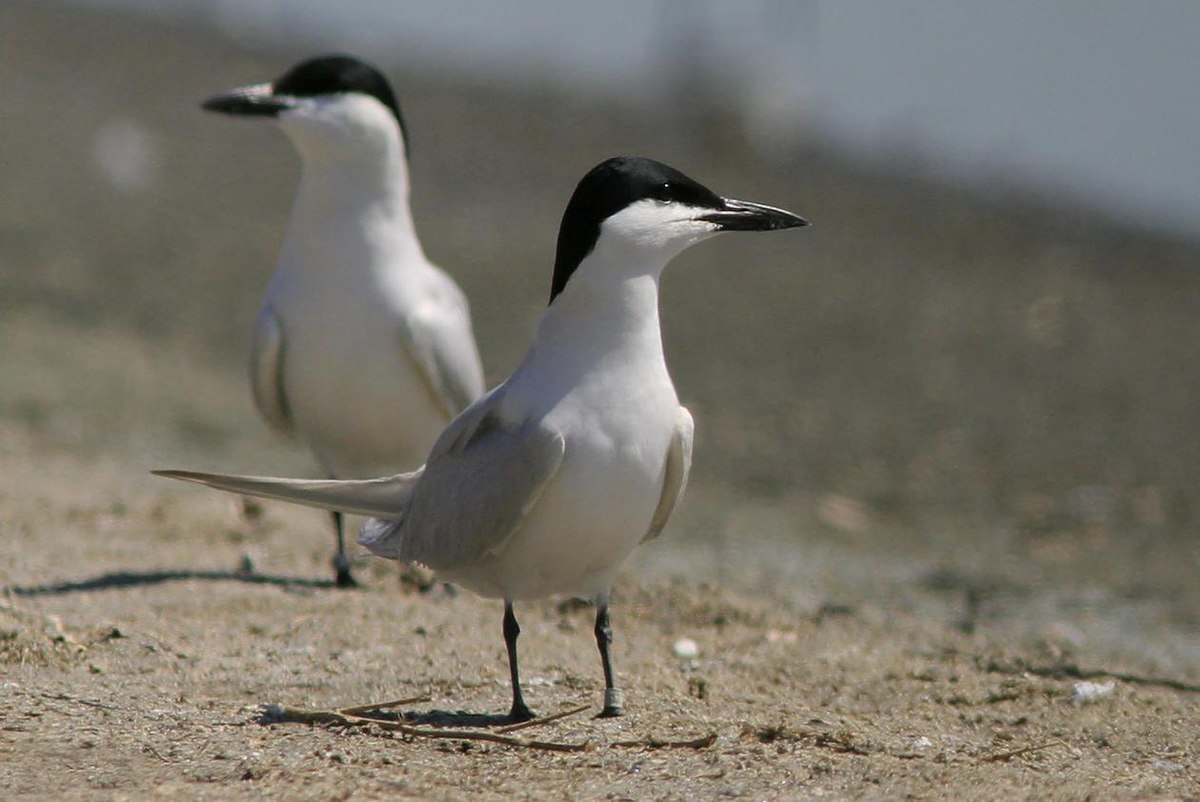
Wikipedia: Gull-billed tern Quelle: OTHER
1200px-Gelochelidon_nilotica_vanrossemi.jpg
Dieser Vogel erscheint jenseits grossen Meere in Kontinenten :
Europa, Nordamerika, Südamerika, Afrika, Asien.
Allgemein: ![]() Die Lachseeschwalbe (Gelochelidon nilotica) ist eine Vogelart aus der Familie der Seeschwalben (Sternidae).
[more]
Die Lachseeschwalbe (Gelochelidon nilotica) ist eine Vogelart aus der Familie der Seeschwalben (Sternidae).
[more]
Schwalbenmöwe / Sabine's gull (Xema sabini)

Wikipedia: Sabine's gull Quelle: OTHER
Xema_sabini_-Iceland_-swimming-8_%281%29.jpg
Dieser Vogel erscheint jenseits grossen Meere in Kontinenten :
Europa, Nordamerika, Südamerika, Afrika.
![]() Die Schwalbenmöwe (Xema sabini) ist eine Art der Möwen (Larinae) und steht in der monotypischen Gattung Xema. Sie ist ein Brutvogel der hochartkischen Tundra, die in Mitteleuropa alljährlich in geringer Zahl als Irrgast beobachtet werden kann. Typisch sind solche Einflüge bei starken Westwindlagen. So wurden in der Deutschen Bucht und im nordfriesischen Wattenmeer im Jahr 1997 insgesamt 71-mal Schwalbenmöwen gesichtet.[1]
[more]
Die Schwalbenmöwe (Xema sabini) ist eine Art der Möwen (Larinae) und steht in der monotypischen Gattung Xema. Sie ist ein Brutvogel der hochartkischen Tundra, die in Mitteleuropa alljährlich in geringer Zahl als Irrgast beobachtet werden kann. Typisch sind solche Einflüge bei starken Westwindlagen. So wurden in der Deutschen Bucht und im nordfriesischen Wattenmeer im Jahr 1997 insgesamt 71-mal Schwalbenmöwen gesichtet.[1]
[more]
Braunmantel-Scherenschnabel / African skimmer (Rynchops flavirostris)
Profil Wikipedia eBird Xeno-Canto
Nesting bird, perhaps african skimmer. 2016-09-29 15.07.02 Botswana
Zuerst beobachtet in Botswana an 2016-09-29.
![]() Der Braunmantel-Scherenschnabel (Rynchops flavirostris), auch Afrikanischer Scherenschnabel genannt, ist ein afrikanischer Vogel aus der Ordnung der Regenpfeiferartigen (Charadriiformes).
[more]
Der Braunmantel-Scherenschnabel (Rynchops flavirostris), auch Afrikanischer Scherenschnabel genannt, ist ein afrikanischer Vogel aus der Ordnung der Regenpfeiferartigen (Charadriiformes).
[more]
Schwarzmantel-Scherenschnabel / Black skimmer (Rynchops niger)
Profil Wikipedia eBird Xeno-Canto
Black skimmers near Las Coloradas. 2023-04-15 10.11.18 Yucatan
Zuerst beobachtet in Yucatan an 2023-04-15.
Dieser Vogel erscheint jenseits grossen Meere in Kontinenten :
Nordamerika, Südamerika, Afrika.
![]() Der Schwarzmantel-Scherenschnabel (Rynchops niger), auch Amerikanischer Scherenschnabel, jetzt Amerikascherenschnabel[1] genannt, ist ein amerikanischer Vogel aus der Ordnung der Regenpfeiferartigen (Charadriiformes).[2]
[more]
Der Schwarzmantel-Scherenschnabel (Rynchops niger), auch Amerikanischer Scherenschnabel, jetzt Amerikascherenschnabel[1] genannt, ist ein amerikanischer Vogel aus der Ordnung der Regenpfeiferartigen (Charadriiformes).[2]
[more]
Weissbart-Seeschwalbe / Whiskered tern (Chlidonias hybrida)
Whiskered tern, Phnom Krom. 2024-03-03 08.33.04 Kambodscha
Zuerst beobachtet in Kambodscha an 2024-03-03.
![]() The whiskered tern (Chlidonias hybrida) is a tern in the family Laridae. The genus name is from Ancient Greek khelidonios, "swallow-like", from khelidon, "swallow". The specific hybridus is Latin for hybrid; Pallas thought it might be a hybrid of white-winged black tern and common tern, writing "Sterna fissipes [Chlidonias leucopterus] et Hirundine [Sterna hirundo] natam”.[2]
[more]
The whiskered tern (Chlidonias hybrida) is a tern in the family Laridae. The genus name is from Ancient Greek khelidonios, "swallow-like", from khelidon, "swallow". The specific hybridus is Latin for hybrid; Pallas thought it might be a hybrid of white-winged black tern and common tern, writing "Sterna fissipes [Chlidonias leucopterus] et Hirundine [Sterna hirundo] natam”.[2]
[more]
Rufe: ![]() Contact call freely used and fairly distinct: An extremely hoarse, and rasping "krreek" in various moods. Timbre comparable to Corncrake. Sometimes uttered in stuttering series "kr-kr-kr-kr-kr". [Link]
Contact call freely used and fairly distinct: An extremely hoarse, and rasping "krreek" in various moods. Timbre comparable to Corncrake. Sometimes uttered in stuttering series "kr-kr-kr-kr-kr". [Link]
Körperlich: Länge=23-25 cm,
Flügelspanne=74-78 cm,
Gewicht=79-94 g
Habitate:
Fluss und See
Ruf:
Automatically generated from Xeno-Canto recording
♫ XC770351 - Whiskered Tern - Chlidonias hybrida - call, flight call - Heves County, Hungary. Quelle: XENOCANTO
XC770351 - Whiskered Tern - Chlidonias hybrida - call, flight call - Heves County, Hungary.mp3
(Flugruf)

Ruf Eigenschaften:
Flugruf Frequenz: ,
Weissflügelseeschwalbe / White-winged tern (Chlidonias leucopterus)

Wikipedia: White-winged tern Quelle: OTHER
Chlidonias_leucopterus_Mai_Po.jpg
Allgemein: ![]() Die Weißflügelseeschwalbe (Chlidonias leucopterus) ist eine in Südosteuropa heimische Vogelart aus der Familie der Seeschwalben (Sternidae).
[more]
Die Weißflügelseeschwalbe (Chlidonias leucopterus) ist eine in Südosteuropa heimische Vogelart aus der Familie der Seeschwalben (Sternidae).
[more]
Habitate:
Fluss und See
Trauerseeschwalbe / Black tern (Chlidonias niger)
Profil Wikipedia eBird Vogelwarte BirdLife ZH ornitho.ch Audubon AllAboutBirds Xeno-Canto BirdID NABU

Wikipedia: Black tern Quelle: OTHER
1200px-%C4%8Cor%C3%ADk_%C4%8Dierny_%28Chlidonias_niger%29_a_%284644831482%29.jpg
Dieser Vogel erscheint jenseits grossen Meere in Kontinenten :
Europa, Nordamerika, Südamerika, Afrika.
![]() Die Trauerseeschwalbe (Chlidonias niger) ist eine Vogelart aus der Familie der Seeschwalben (Sternidae), die in der Holarktis vorkommt.
[more]
Die Trauerseeschwalbe (Chlidonias niger) ist eine Vogelart aus der Familie der Seeschwalben (Sternidae), die in der Holarktis vorkommt.
[more]
Vokalisierung: ![]() Moderately vocal. [Link]
Moderately vocal. [Link]
Rufe: ![]() Flight call a more or less clear "kleck, or a disyllabic "klee-ake" with accented first syllable. Sometimes slightly rolling "klirr-eke", but never as much as in White-winged Tern. Also a slightly harsher "kreek", but not as raspy as in Whiskered Tern. [Link]
Flight call a more or less clear "kleck, or a disyllabic "klee-ake" with accented first syllable. Sometimes slightly rolling "klirr-eke", but never as much as in White-winged Tern. Also a slightly harsher "kreek", but not as raspy as in Whiskered Tern. [Link]
Körperlich: Länge=22-24 cm,
Flügelspanne=64-68 cm,
Gewicht=60-86 g
Habitate:
Fluss und See
Anous tenuirostris / Lesser noddy (Anous tenuirostris)

Wikipedia: Lesser noddy Quelle: OTHER
1200px-Anous_tenuirostris_01.jpg
Allgemein: ![]() The lesser noddy (Anous tenuirostris), also known as the sooty noddy, is a seabird in the family Laridae. It is found near the coastlines of Comoros, Kenya, India, Maldives, Mauritius, Seychelles, Sri Lanka and United Arab Emirates.
[more]
The lesser noddy (Anous tenuirostris), also known as the sooty noddy, is a seabird in the family Laridae. It is found near the coastlines of Comoros, Kenya, India, Maldives, Mauritius, Seychelles, Sri Lanka and United Arab Emirates.
[more]
Noddi / Brown noddy (Anous stolidus)

Wikipedia: Brown noddy Quelle: OTHER
1200px-Common_Noddy_1_-_Michaelmas.jpg
Dieser Vogel erscheint jenseits grossen Meere in Kontinenten :
Nordamerika, Südamerika, Afrika, Asien.
![]() Der Noddi (Anous stolidus; auch Noddiseeschwalbe oder wie im Englischen Noddy) bildet eine Art innerhalb der Unterfamilie der Noddiseeschwalben (Anoinae) innerhalb der Ordnung der Regenpfeiferartigen. Es werden mehrere Unterarten unterschieden.
[more]
Der Noddi (Anous stolidus; auch Noddiseeschwalbe oder wie im Englischen Noddy) bildet eine Art innerhalb der Unterfamilie der Noddiseeschwalben (Anoinae) innerhalb der Ordnung der Regenpfeiferartigen. Es werden mehrere Unterarten unterschieden.
[more]
Feenseeschwalbe / Common white-tern (Gygis alba)
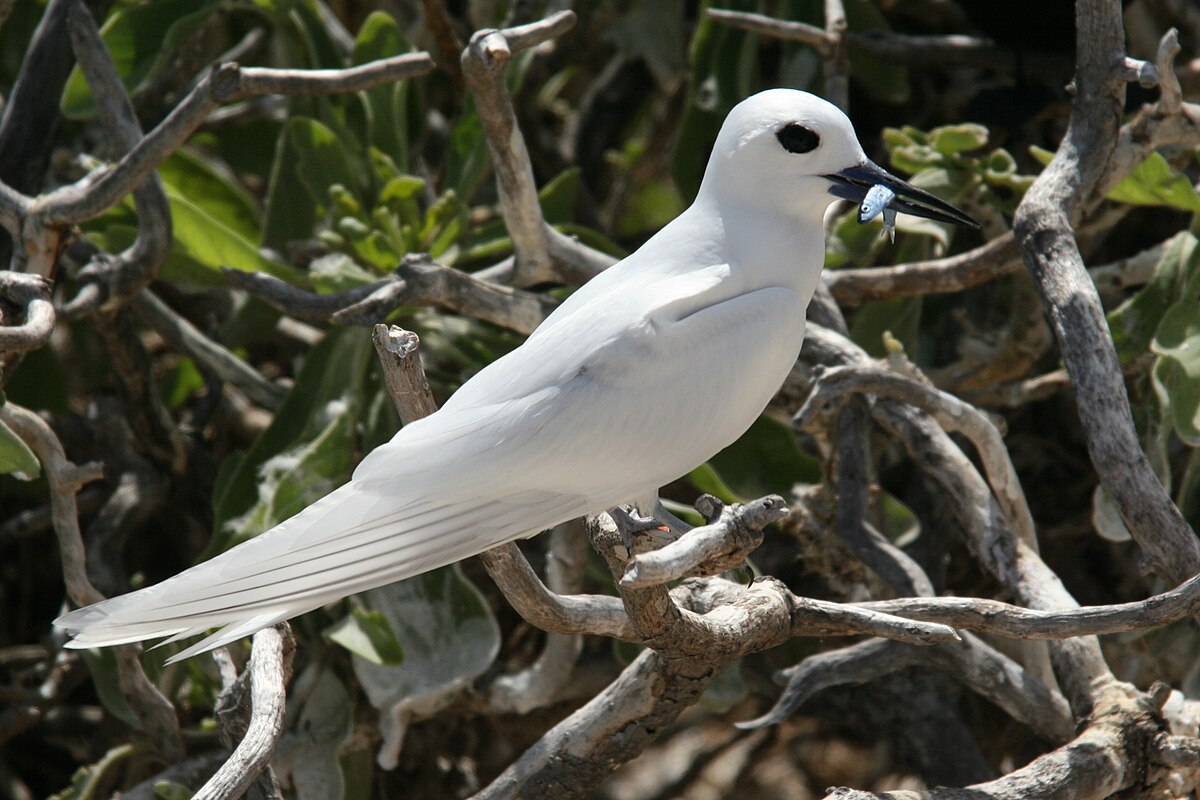
Wikipedia: Common white-tern Quelle: OTHER
1200px-White_tern_with_fish.jpg
Dieser Vogel erscheint jenseits grossen Meere in Kontinenten :
Nordamerika, Afrika.
![]() Die Feenseeschwalbe (Gygis alba) ist eine Vogelart aus der Ordnung der Regenpfeiferartigen (Charadriiformes).
[more]
Die Feenseeschwalbe (Gygis alba) ist eine Vogelart aus der Ordnung der Regenpfeiferartigen (Charadriiformes).
[more]
Präriemöwe / Franklin's gull (Leucophaeus pipixcan)

Wikipedia: Franklin's gull Quelle: OTHER
Franklin%27s_Gull%2C_Calgary.jpg
Dieser Vogel erscheint jenseits grossen Meere in Kontinenten :
Nordamerika, Südamerika, Afrika.
![]() Die Präriemöwe (Leucophaeus pipixcan, Syn.: Larus pipixcan) oder Franklinmöwe ist eine mittelgroße, schwarzköpfige Möwenart, die vorwiegend im Bereich der Prairie Pothole Region in den nördlichen Great Plains Nordamerikas brütet und entlang der südamerikanischen Pazifikküste überwintert.
[more]
Die Präriemöwe (Leucophaeus pipixcan, Syn.: Larus pipixcan) oder Franklinmöwe ist eine mittelgroße, schwarzköpfige Möwenart, die vorwiegend im Bereich der Prairie Pothole Region in den nördlichen Great Plains Nordamerikas brütet und entlang der südamerikanischen Pazifikküste überwintert.
[more]
Raubseeschwalbe / Caspian tern (Hydroprogne caspia)

Wikipedia: Caspian tern Quelle: OTHER
1200px-Sterna-caspia-010.jpg
Dieser Vogel erscheint jenseits grossen Meere in Kontinenten :
Europa, Nordamerika, Südamerika, Afrika, Asien.
![]() Die Raubseeschwalbe (Hydroprogne caspia, Syn.: Sterna caspia) ist eine Vogelart aus der Ordnung der Regenpfeiferartigen.
Sie ist die größte Art der Familie der Seeschwalben.
[more]
Die Raubseeschwalbe (Hydroprogne caspia, Syn.: Sterna caspia) ist eine Vogelart aus der Ordnung der Regenpfeiferartigen.
Sie ist die größte Art der Familie der Seeschwalben.
[more]
Rufe: ![]() Easily recognized by its very harsh calls. Sometimes likened to the sound of a plate of steel being dragged across a concrete floor. Similar in harshness to Grey Heron, but more drawn, with an accented middle; "Kraaeeet", or with a double syllable start "ka-ha-kraaaeet". Immature birds begs with a penetrating, sharp whistle. [Link]
Easily recognized by its very harsh calls. Sometimes likened to the sound of a plate of steel being dragged across a concrete floor. Similar in harshness to Grey Heron, but more drawn, with an accented middle; "Kraaeeet", or with a double syllable start "ka-ha-kraaaeet". Immature birds begs with a penetrating, sharp whistle. [Link]
Körperlich: Länge=47-54 cm,
Flügelspanne=130-145 cm,
Gewicht=500-750 g
Habitate:
Fluss und See
Rußseeschwalbe / Sooty tern (Onychoprion fuscatus)

Wikipedia: Sooty tern Quelle: OTHER
1200px-Sterna_fuscata.JPG
Dieser Vogel erscheint jenseits grossen Meere in Kontinenten :
Nordamerika, Südamerika, Afrika.
Allgemein: ![]() Die Rußseeschwalbe (Onychoprion fuscatus) ist ein Seevogel aus der Familie der Seeschwalben. Früher wurde die Art in die Gattung Sterna gestellt.[1]
[more]
Die Rußseeschwalbe (Onychoprion fuscatus) ist ein Seevogel aus der Familie der Seeschwalben. Früher wurde die Art in die Gattung Sterna gestellt.[1]
[more]
Zügelseeschwalbe / Bridled tern (Onychoprion anaethetus)
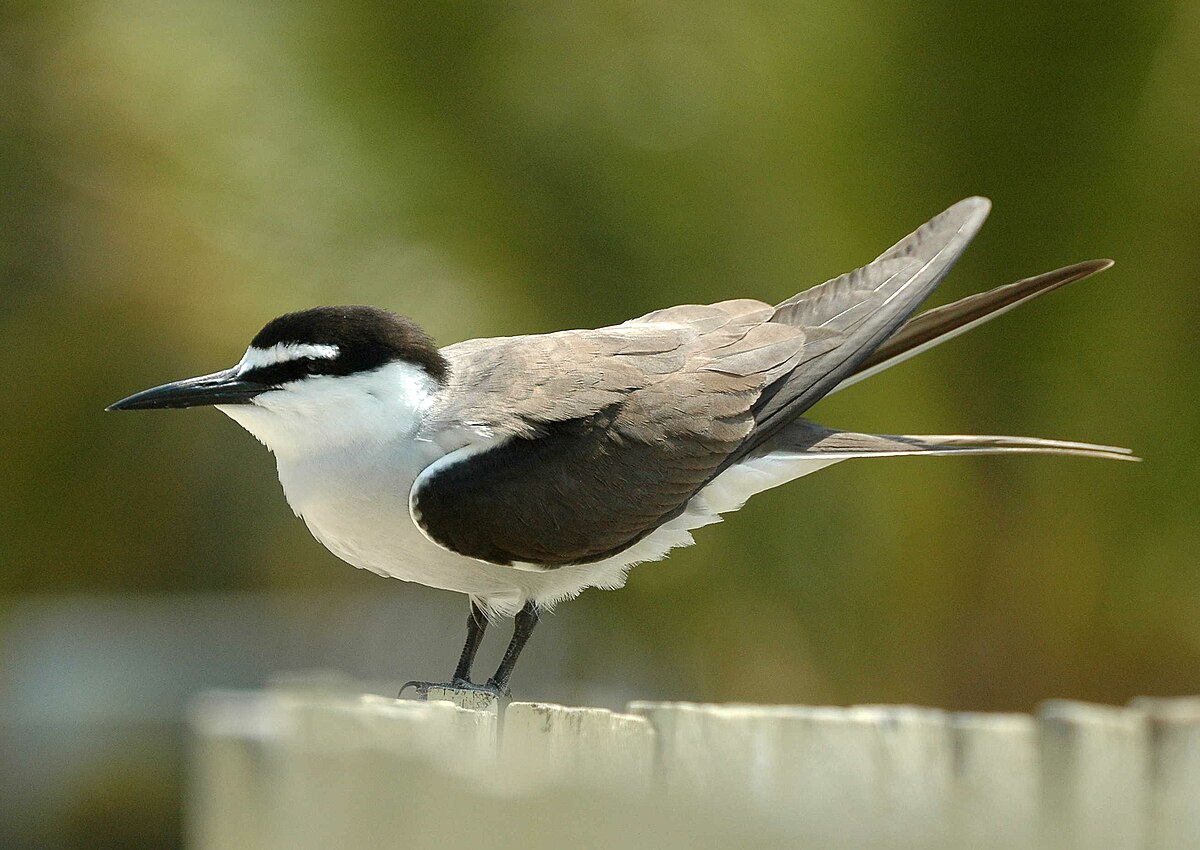
Wikipedia: Bridled tern Quelle: OTHER
1200px-Bridled_Tern_LEI_Nov06.JPG
Dieser Vogel erscheint jenseits grossen Meere in Kontinenten :
Nordamerika, Südamerika, Afrika, Asien.
![]() Die Zügelseeschwalbe (Onychoprion anaethetus, Syn.: Sterna anaethetus) ist ein Seevogel aus der Familie der Seeschwalben. Früher wurde sie in die Gattung Sterna gestellt (Bridge et al., 2005). Sie ist auf allen tropischen und subtropischen Meeren verbreitet.
[more]
Die Zügelseeschwalbe (Onychoprion anaethetus, Syn.: Sterna anaethetus) ist ein Seevogel aus der Familie der Seeschwalben. Früher wurde sie in die Gattung Sterna gestellt (Bridge et al., 2005). Sie ist auf allen tropischen und subtropischen Meeren verbreitet.
[more]
Zwergseeschwalbe / Little tern (Sternula albifrons)
Little Tern, Reykjavik, Iceland. 2015-05-29 11.18.30 Iceland
Zuerst beobachtet in Iceland an 2015-05-29.
![]() Die Zwergseeschwalbe (Sternula albifrons, Syn.: Sterna albifrons) ist mit einem Gewicht von 45 g und einer Länge von 20 cm die kleinste und die in Mitteleuropa seltenste Seeschwalbe.
[more]
Die Zwergseeschwalbe (Sternula albifrons, Syn.: Sterna albifrons) ist mit einem Gewicht von 45 g und einer Länge von 20 cm die kleinste und die in Mitteleuropa seltenste Seeschwalbe.
[more]
Vokalisierung: ![]() Fairly distinct voice. [Link]
Fairly distinct voice. [Link]
Rufe: ![]() Contact call a sharp "kitt", often combined to form undulating, rolling series. Not as sharp and penetrating as Common- and Arctic Tern. [Link]
Contact call a sharp "kitt", often combined to form undulating, rolling series. Not as sharp and penetrating as Common- and Arctic Tern. [Link]
Körperlich: Länge=22-24 cm,
Flügelspanne=48-55 cm,
Gewicht=49-63 g
Habitate:
Fluss und See
Damaraseeschwalbe / Damara tern (Sternula balaenarum)
Profil Wikipedia eBird Xeno-Canto

Wikipedia: Damara tern Quelle: OTHER
Damara_Tern_%288077271589%29.jpg
Allgemein: ![]() Die Damaraseeschwalbe (Sternula balaenarum) ist eine Seevogelart aus der Familie der Seeschwalben (Sternidae). Sie war ursprünglich Teil der Gattung Sterna, nach einer Revision der Seeschwalbenfamilie wurde sie 2005 in die Gattung Sternula transferiert.[1] Das Artepitheton balaenarum (griechisch: φαλαινα (phalaina) für Wal) bezieht sich auf die Walvis Bay in Namibia, ehemals Damaraland.
[more]
Die Damaraseeschwalbe (Sternula balaenarum) ist eine Seevogelart aus der Familie der Seeschwalben (Sternidae). Sie war ursprünglich Teil der Gattung Sterna, nach einer Revision der Seeschwalbenfamilie wurde sie 2005 in die Gattung Sternula transferiert.[1] Das Artepitheton balaenarum (griechisch: φαλαινα (phalaina) für Wal) bezieht sich auf die Walvis Bay in Namibia, ehemals Damaraland.
[more]
Thalasseus elegans / Elegant tern (Thalasseus elegans)

Wikipedia: Elegant tern Quelle: OTHER
1200px-Elegant_Tern_Bolsa_Chica.jpg
Dieser Vogel erscheint jenseits grossen Meere in Kontinenten :
Nordamerika, Südamerika, Afrika.
![]() The elegant tern (Thalasseus elegans) is a tern in the family Laridae. It breeds on the Pacific coasts of the southern United States and Mexico and winters south to Peru, Ecuador and Chile.
[more]
The elegant tern (Thalasseus elegans) is a tern in the family Laridae. It breeds on the Pacific coasts of the southern United States and Mexico and winters south to Peru, Ecuador and Chile.
[more]
Brandseeschwalbe / Sandwich tern (Thalasseus sandvicensis)
Sandwich tern in flight with distinct yellow tipped bill. 2023-09-27 12.28.34 Florida
Zuerst beobachtet in Costa Rica an 2018-03-11.
Dieser Vogel erscheint jenseits grossen Meere in Kontinenten :
Europa, Nordamerika, Südamerika, Afrika.
![]() Die Brandseeschwalbe (Thalasseus sandvicensis, bis 2005 Sterna sandvicensis) ist eine Vogelart der Gattung Thalasseus aus der Familie der Seeschwalben (Sternidae). In der Roten Liste der Brutvögel Deutschlands von 2015 wird die Art in der Kategorie 1 als vom Aussterben bedroht geführt.[1]
[more]
Die Brandseeschwalbe (Thalasseus sandvicensis, bis 2005 Sterna sandvicensis) ist eine Vogelart der Gattung Thalasseus aus der Familie der Seeschwalben (Sternidae). In der Roten Liste der Brutvögel Deutschlands von 2015 wird die Art in der Kategorie 1 als vom Aussterben bedroht geführt.[1]
[more]
Rufe: ![]() Contact call a sharp and grating "keeree-eek". Often compared to the pressing of amalgam into a tooth. [Link]
Contact call a sharp and grating "keeree-eek". Often compared to the pressing of amalgam into a tooth. [Link]
Körperlich: Länge=36-41 cm,
Flügelspanne=95-105 cm,
Gewicht=215-275 g
Habitate:
Fluss und See
Eilseeschwalbe / Great crested-tern (Thalasseus bergii)

Wikipedia: Great crested-tern Quelle: OTHER
1200px-Crested_Tern_Tasmania.jpg
Allgemein: ![]() Die Eilseeschwalbe (Thalasseus bergii) ist eine Vogelart aus der Familie der Seeschwalben (Sternidae).
[more]
Die Eilseeschwalbe (Thalasseus bergii) ist eine Vogelart aus der Familie der Seeschwalben (Sternidae).
[more]
Thalasseus bengalensis / Lesser crested-tern (Thalasseus bengalensis)

Wikipedia: Lesser crested-tern Quelle: OTHER
Lesser_crested_terns_%28Thalasseus_bengalensis%29_by_Shantanu_Kuveskar.jpg
![]() The lesser crested tern (Thalasseus bengalensis)[2] is a tern in the family, Laridae.
[more]
The lesser crested tern (Thalasseus bengalensis)[2] is a tern in the family, Laridae.
[more]
Vanellus melanopterus / Black-winged lapwing (Vanellus melanopterus)
Profil Wikipedia eBird Xeno-Canto

Wikipedia: Black-winged lapwing Quelle: OTHER
Black-winged_Lapwing_-_Mara_-_KenyaIMG_3644.jpg
![]() The black-winged lapwing or greater black-winged lapwing (Vanellus melanopterus) is an east African species that is found from the Ethiopian highlands in the north to central Kenya (race V. m. melanopterus), and again at middle to coastal elevations in eastern South Africa (race V. m. minor). It is a habitat specialist of short grass in well-watered temperate grasslands. They may move about locally to find ideal situations, often at night. In their tightly grouped flying flocks they resemble plovers.
[more]
The black-winged lapwing or greater black-winged lapwing (Vanellus melanopterus) is an east African species that is found from the Ethiopian highlands in the north to central Kenya (race V. m. melanopterus), and again at middle to coastal elevations in eastern South Africa (race V. m. minor). It is a habitat specialist of short grass in well-watered temperate grasslands. They may move about locally to find ideal situations, often at night. In their tightly grouped flying flocks they resemble plovers.
[more]
Vanellus senegallus / Wattled lapwing (Vanellus senegallus)
Profil Wikipedia eBird Xeno-Canto

Wikipedia: Wattled lapwing Quelle: OTHER
1200px-African_wattled_lapwing_%28Vanellus_senegallus_senegallus%29.jpg
![]() The African wattled lapwing (Vanellus senegallus), also known as the Senegal wattled plover or simply wattled lapwing, is a large lapwing, a group of largish waders in the family Charadriidae. It is a resident breeder in most of sub-Saharan Africa outside the rainforests, although it has seasonal movements.
[more]
The African wattled lapwing (Vanellus senegallus), also known as the Senegal wattled plover or simply wattled lapwing, is a large lapwing, a group of largish waders in the family Charadriidae. It is a resident breeder in most of sub-Saharan Africa outside the rainforests, although it has seasonal movements.
[more]
Kronenkiebitz / Crowned lapwing (Vanellus coronatus)
Profil Wikipedia eBird Xeno-Canto

Wikipedia: Crowned lapwing Quelle: OTHER
1200px-Avefr%C3%ADa_coronada_%28Vanellus_coronatus%29%2C_Santuario_de_Rinocerontes_Khama%2C_Botsuana%2C_2018-08-02%2C_DD_22.jpg
![]() Der Kronenkiebitz (Vanellus coronatus) ist eine afrikanische Vogelart aus der Familie der Regenpfeifer (Charadriidae). Es werden zwei Unterarten anerkannt, Vanellus coronatus coronatus, die von Äthiopien über Ostafrika, mit Ausnahme eines großen Teils von Mosambik, bis nach Südafrika und Namibia vorkommt, und V. c. demissus aus Somalia.
[more]
Der Kronenkiebitz (Vanellus coronatus) ist eine afrikanische Vogelart aus der Familie der Regenpfeifer (Charadriidae). Es werden zwei Unterarten anerkannt, Vanellus coronatus coronatus, die von Äthiopien über Ostafrika, mit Ausnahme eines großen Teils von Mosambik, bis nach Südafrika und Namibia vorkommt, und V. c. demissus aus Somalia.
[more]
Vanellus lugubris / Senegal lapwing (Vanellus lugubris)
Profil Wikipedia eBird Xeno-Canto

Wikipedia: Senegal lapwing Quelle: OTHER
1200px-Senegal_Lapwing_-_Vanellus_lugubris.jpg
![]() The Senegal lapwing or lesser black-winged lapwing (Vanellus lugubris) is a species of bird in the family Charadriidae.
It is found in Angola, Burundi, Cameroon, Republic of the Congo, Democratic Republic of the Congo, Ivory Coast, Gabon, Gambia, Ghana, Guinea, Kenya, Liberia, Malawi, Mali, Mozambique, Nigeria, Rwanda, Senegal, Sierra Leone, Somalia, South Africa, Swaziland, Tanzania, Togo, Uganda, Zambia, and Zimbabwe.
[more]
The Senegal lapwing or lesser black-winged lapwing (Vanellus lugubris) is a species of bird in the family Charadriidae.
It is found in Angola, Burundi, Cameroon, Republic of the Congo, Democratic Republic of the Congo, Ivory Coast, Gabon, Gambia, Ghana, Guinea, Kenya, Liberia, Malawi, Mali, Mozambique, Nigeria, Rwanda, Senegal, Sierra Leone, Somalia, South Africa, Swaziland, Tanzania, Togo, Uganda, Zambia, and Zimbabwe.
[more]
Vanellus albiceps / White-headed lapwing (Vanellus albiceps)

Wikipedia: White-headed lapwing Quelle: OTHER
1200px-White-crowned_Lapwing_%287281408152%29%2C_crop.jpg
![]() The white-crowned lapwing, white-headed lapwing, white-headed plover or white-crowned plover (Vanellus albiceps) is a medium-sized wader. It is resident throughout tropical Africa, usually near large rivers.
[more]
The white-crowned lapwing, white-headed lapwing, white-headed plover or white-crowned plover (Vanellus albiceps) is a medium-sized wader. It is resident throughout tropical Africa, usually near large rivers.
[more]
Vanellus crassirostris / Long-toed lapwing (Vanellus crassirostris)
Profil Wikipedia eBird Xeno-Canto

Wikipedia: Long-toed lapwing Quelle: OTHER
Long-toed_Lapwing_-_Mara_-_KenyaIMG_4271.jpg
![]() The long-toed lapwing (Vanellus crassirostris) is a species of bird in the family Charadriidae.
It is found in Angola, Botswana, Burundi, Cameroon, Chad, Democratic Republic of the Congo, Ethiopia, Kenya, Malawi, Mozambique, Namibia, Nigeria, Rwanda, South Africa, Sudan, Tanzania, Uganda, Zambia, and Zimbabwe.
[more]
The long-toed lapwing (Vanellus crassirostris) is a species of bird in the family Charadriidae.
It is found in Angola, Botswana, Burundi, Cameroon, Chad, Democratic Republic of the Congo, Ethiopia, Kenya, Malawi, Mozambique, Namibia, Nigeria, Rwanda, South Africa, Sudan, Tanzania, Uganda, Zambia, and Zimbabwe.
[more]
Vanellus armatus / Blacksmith lapwing (Vanellus armatus)

Wikipedia: Blacksmith lapwing Quelle: OTHER
1200px-Vanellus_armatus_-_Etosha_2014.jpg
![]() The blacksmith lapwing or blacksmith plover (Vanellus armatus) is a lapwing species that occurs commonly from Kenya through central Tanzania to southern and southwestern Africa. The vernacular name derives from the repeated metallic 'tink, tink, tink' alarm call, which suggests a blacksmith's hammer striking an anvil.
[more]
The blacksmith lapwing or blacksmith plover (Vanellus armatus) is a lapwing species that occurs commonly from Kenya through central Tanzania to southern and southwestern Africa. The vernacular name derives from the repeated metallic 'tink, tink, tink' alarm call, which suggests a blacksmith's hammer striking an anvil.
[more]
Charadrius mongolus / Lesser sand-plover (Charadrius mongolus)

Wikipedia: Lesser sand-plover Quelle: OTHER
1200px-Charadrius_mongolus_-_Laem_Phak_Bia.jpg
Dieser Vogel erscheint jenseits grossen Meere in Kontinenten :
Nordamerika, Afrika, Asien.
![]() The lesser sand plover (Charadrius mongolus) is a small wader in the plover family of birds. The spelling is commonly given as lesser sand-plover, but the official British Ornithologists' Union spelling is "lesser sand plover". The genus name Charadrius is a Late Latin word for a yellowish bird mentioned in the fourth-century Vulgate. It derives from Ancient Greek kharadrios a bird found in ravines and river valleys (kharadra, "ravine"). The specific mongolus is Latin and refers to Mongolia which at the time of naming referred to a larger area than the present country.[2]
[more]
The lesser sand plover (Charadrius mongolus) is a small wader in the plover family of birds. The spelling is commonly given as lesser sand-plover, but the official British Ornithologists' Union spelling is "lesser sand plover". The genus name Charadrius is a Late Latin word for a yellowish bird mentioned in the fourth-century Vulgate. It derives from Ancient Greek kharadrios a bird found in ravines and river valleys (kharadra, "ravine"). The specific mongolus is Latin and refers to Mongolia which at the time of naming referred to a larger area than the present country.[2]
[more]
Charadrius asiaticus / Caspian plover (Charadrius asiaticus)

Wikipedia: Caspian plover Quelle: OTHER
Charadrius_asiaticus.jpg
![]() The Caspian plover (Charadrius asiaticus) is a wader in the plover family of birds. The genus name Charadrius is a Late Latin word for a yellowish bird mentioned in the fourth-century Vulgate. It derives from Ancient Greek kharadrios a bird found in ravines and river valleys (kharadra, "ravine"). The specific asiaticus is Latin and means "Asian", although in binomials it usually means the type locality was India.[2]
[more]
The Caspian plover (Charadrius asiaticus) is a wader in the plover family of birds. The genus name Charadrius is a Late Latin word for a yellowish bird mentioned in the fourth-century Vulgate. It derives from Ancient Greek kharadrios a bird found in ravines and river valleys (kharadra, "ravine"). The specific asiaticus is Latin and means "Asian", although in binomials it usually means the type locality was India.[2]
[more]
Charadrius marginatus / White-fronted plover (Charadrius marginatus)
Profil Wikipedia eBird Xeno-Canto

Wikipedia: White-fronted plover Quelle: OTHER
1200px-White-fronted_plover_%28Charadrius_marginatus%29.jpg
![]() The white-fronted plover or white-fronted sandplover (Charadrius marginatus) is a small (45-50 g) shorebird of the family Charadriidae that inhabits sandy beaches, dunes, mudflats and the shores of rivers and lakes in sub-saharan Africa and Madagascar. It nests in small shallow scrapes in the ground and lays clutches of 1-3 eggs. The species is monogamous and long-lived, with a life expectancy of approximately 11 years. The vast majority of pairs that mate together stay together during the following years of breeding and retain the same territory. The white-fronted plover has a similar appearance to the Kentish plover, with a white fore crown and dark bands connecting the eyes to the bill.
[more]
The white-fronted plover or white-fronted sandplover (Charadrius marginatus) is a small (45-50 g) shorebird of the family Charadriidae that inhabits sandy beaches, dunes, mudflats and the shores of rivers and lakes in sub-saharan Africa and Madagascar. It nests in small shallow scrapes in the ground and lays clutches of 1-3 eggs. The species is monogamous and long-lived, with a life expectancy of approximately 11 years. The vast majority of pairs that mate together stay together during the following years of breeding and retain the same territory. The white-fronted plover has a similar appearance to the Kentish plover, with a white fore crown and dark bands connecting the eyes to the bill.
[more]
Flussregenpfeifer / Little ringed plover (Charadrius dubius)
Profil Wikipedia eBird Vogelwarte BirdLife ZH ornitho.ch Xeno-Canto BirdID NABU
Little Ringed Plovers, Phnom Krom. 2024-03-03 09.12.46 Kambodscha
Zuerst beobachtet in Mallorca an 2022-04-10.
![]() Der Flussregenpfeifer (Charadrius dubius) ist eine Vogelart aus der Familie der Regenpfeifer (Charadriidae). In Mitteleuropa ist der Flussregenpfeifer ein verbreiteter, aber wenig häufiger Brut- und Sommervogel. Während der Zugzeiten ist er verhältnismäßig häufig als Durchzügler und Rastvogel zu beobachten.
[more]
Der Flussregenpfeifer (Charadrius dubius) ist eine Vogelart aus der Familie der Regenpfeifer (Charadriidae). In Mitteleuropa ist der Flussregenpfeifer ein verbreiteter, aber wenig häufiger Brut- und Sommervogel. Während der Zugzeiten ist er verhältnismäßig häufig als Durchzügler und Rastvogel zu beobachten.
[more]
Vokalisierung: ![]() Quite different from Ringed Plover. Sharper sounding, lacking Ringed's soft tone. Often starts with a rolling "r". [Link]
Quite different from Ringed Plover. Sharper sounding, lacking Ringed's soft tone. Often starts with a rolling "r". [Link]
Rufe: ![]() Common calls are a two syllable "krrll-uuit" with a rising pitch or just a sharp, rolling "krrri-krrri". Also a longer rolling "krree-looo" with pitch rising in first syllable and falling in the second. [Link]
Common calls are a two syllable "krrll-uuit" with a rising pitch or just a sharp, rolling "krrri-krrri". Also a longer rolling "krree-looo" with pitch rising in first syllable and falling in the second. [Link]
Körperlich: Länge=14-15 cm,
Flügelspanne=42-48 cm,
Gewicht=32-48 g
Habitate:
Nassgebiet
Gesang:
Automatically generated from Xeno-Canto recording
Gesang Eigenschaften:
Frequency:
♫ Quelle: BirdNet
20220410_111023 birdnet - Flussregenpfeifer - Flussregenpfeifer - Felanitx.mp3
2022-04-10 11.10.23 Mallorca (Gesang)
Ruf:
Automatically generated from Xeno-Canto recording
♫ XC835676 - Little Ringed Plover - Charadrius dubius - flight call, song - Dundgovi, Mongolia. Quelle: XENOCANTO
XC835676 - Little Ringed Plover - Charadrius dubius - flight call, song - Dundgovi, Mongolia.mp3
(Flugruf)
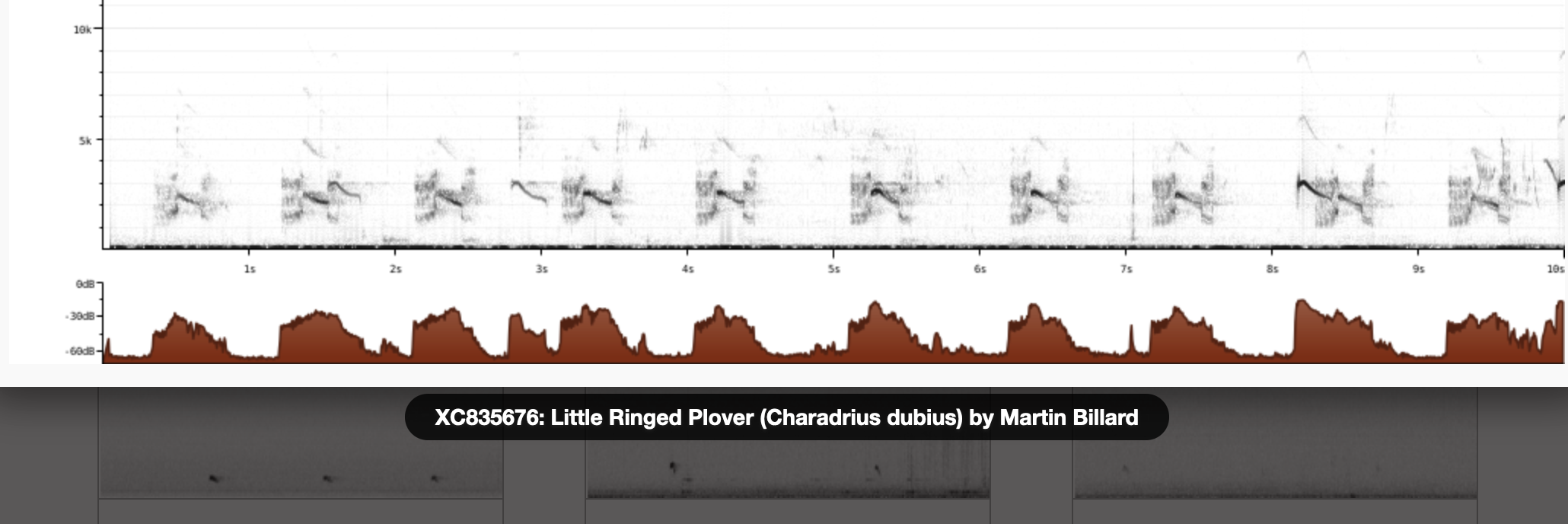
Ruf Eigenschaften:
Flugruf Frequenz: ,
Charadrius pecuarius / Kittlitz's plover (Charadrius pecuarius)
Profil Wikipedia eBird Xeno-Canto

Wikipedia: Kittlitz's plover Quelle: OTHER
1200px-Kittlitz%27s_plover_%28Charadrius_pecuarius%29.jpg
Allgemein: ![]() Kittlitz's plover (Charadrius pecuarius) is a small shorebird (35-40 g) in the family Charadriidae that breeds near coastal and inland saltmarshes, sandy or muddy riverbanks or alkaline grasslands with short vegetation. It is native to much of Sub-Saharan Africa, the Nile Delta and Madagascar. It is thought to be mainly monogamous and has monomorphic plumage.
[more]
Kittlitz's plover (Charadrius pecuarius) is a small shorebird (35-40 g) in the family Charadriidae that breeds near coastal and inland saltmarshes, sandy or muddy riverbanks or alkaline grasslands with short vegetation. It is native to much of Sub-Saharan Africa, the Nile Delta and Madagascar. It is thought to be mainly monogamous and has monomorphic plumage.
[more]
Dreibandregenpfeifer / Three-banded plover (Charadrius tricollaris)
Profil Wikipedia eBird Xeno-Canto

Wikipedia: Three-banded plover Quelle: OTHER
1200px-Three-banded_plover_%28Charadrius_tricollaris%29.jpg
![]() Der Dreibandregenpfeifer (Charadrius tricollarius) ist eine afrikanische Vogelart aus der Familie der Regenpfeifer (Charadriidae). Es werden zwei Unterarten unterschieden.
[more]
Der Dreibandregenpfeifer (Charadrius tricollarius) ist eine afrikanische Vogelart aus der Familie der Regenpfeifer (Charadriidae). Es werden zwei Unterarten unterschieden.
[more]
Sandregenpfeifer / Common ringed plover (Charadrius hiaticula)
Profil Wikipedia eBird Vogelwarte BirdLife ZH ornitho.ch Audubon AllAboutBirds Xeno-Canto BirdID NABU
Sandregenpfeifer im Profil, Neeracherried. 2022-09-04 07.25.18 Neeracherried
Zuerst beobachtet in 🇨🇭 an 2022-09-04.
Dieser Vogel erscheint jenseits grossen Meere in Kontinenten :
Europa, Nordamerika, Afrika.
![]() Der Sandregenpfeifer (Charadrius hiaticula) ist eine Vogelart aus der Familie der Regenpfeifer (Charadriidae). Er ist ein Brutvogel im Norden Europas, Asiens, Süd- und Nordamerikas. In Mitteleuropa brütet er im Küstengebiet der Nord- und Ostsee. Wegen der großen Zahl an Sandregenpfeifern, die sich auf dem Frühjahrszug im Wattenmeer vor der schleswig-holsteinischen Küste versammeln, gilt diese Region als der wichtigste Rastplatz dieser Art.[1] Im Binnenland ist er besonders im April und Mai sowie von August bis Oktober ein Durchzieher.
[more]
Der Sandregenpfeifer (Charadrius hiaticula) ist eine Vogelart aus der Familie der Regenpfeifer (Charadriidae). Er ist ein Brutvogel im Norden Europas, Asiens, Süd- und Nordamerikas. In Mitteleuropa brütet er im Küstengebiet der Nord- und Ostsee. Wegen der großen Zahl an Sandregenpfeifern, die sich auf dem Frühjahrszug im Wattenmeer vor der schleswig-holsteinischen Küste versammeln, gilt diese Region als der wichtigste Rastplatz dieser Art.[1] Im Binnenland ist er besonders im April und Mai sowie von August bis Oktober ein Durchzieher.
[more]
Vokalisierung: ![]() Usually heard before seen. [Link]
Usually heard before seen. [Link]
Gesang: ![]() Song a cyclic repetition of the contact call. Sometimes with a shortened phrases and a more creaking timbre. [Link]
Song a cyclic repetition of the contact call. Sometimes with a shortened phrases and a more creaking timbre. [Link]
Rufe: ![]() Contact call a short, soft "koo-eep", with the emphasised second part higher and rising in pitch. [Link]
Contact call a short, soft "koo-eep", with the emphasised second part higher and rising in pitch. [Link]
Körperlich: Länge=18-20 cm,
Flügelspanne=48-57 cm,
Gewicht=55-73 g
Habitate:
Nassgebiet
Fahlregenpfeifer / Chestnut-banded plover (Charadrius pallidus)
Profil Wikipedia eBird Xeno-Canto

Wikipedia: Chestnut-banded plover Quelle: OTHER
Chestnut-banded_Plover_-_Ndutu_-_Tanzania_0263.jpg
Allgemein: ![]() Der Fahlregenpfeifer (Charadrius pallidus) ist eine kleine Vogelart aus der Familie der Regenpfeifer. Er lebt im südlichen und östlichen Afrika und hat dort ein sehr disjunktes Verbreitungsgebiet.
[more]
Der Fahlregenpfeifer (Charadrius pallidus) ist eine kleine Vogelart aus der Familie der Regenpfeifer. Er lebt im südlichen und östlichen Afrika und hat dort ein sehr disjunktes Verbreitungsgebiet.
[more]
Wüstenregenpfeifer / Greater sand plover (Charadrius leschenaultii)

Wikipedia: Greater sand plover Quelle: OTHER
1200px-Greater_Sand_Plover_1_-_Lee_Point.jpg
![]() Der Wüstenregenpfeifer (Charadrius leschenaultii) ist eine Watvogelart aus der Familie der Regenpfeifer (Charadriidae), die Wüstensteppen und Halbwüsten im Nahen Osten und in Zentralasien bewohnt. Das Verbreitungsgebiet reicht von Anatolien bis in die Mongolei.
[more]
Der Wüstenregenpfeifer (Charadrius leschenaultii) ist eine Watvogelart aus der Familie der Regenpfeifer (Charadriidae), die Wüstensteppen und Halbwüsten im Nahen Osten und in Zentralasien bewohnt. Das Verbreitungsgebiet reicht von Anatolien bis in die Mongolei.
[more]
Pluvialis dominica / American golden-plover (Pluvialis dominica)
Profil Wikipedia eBird Audubon AllAboutBirds Xeno-Canto
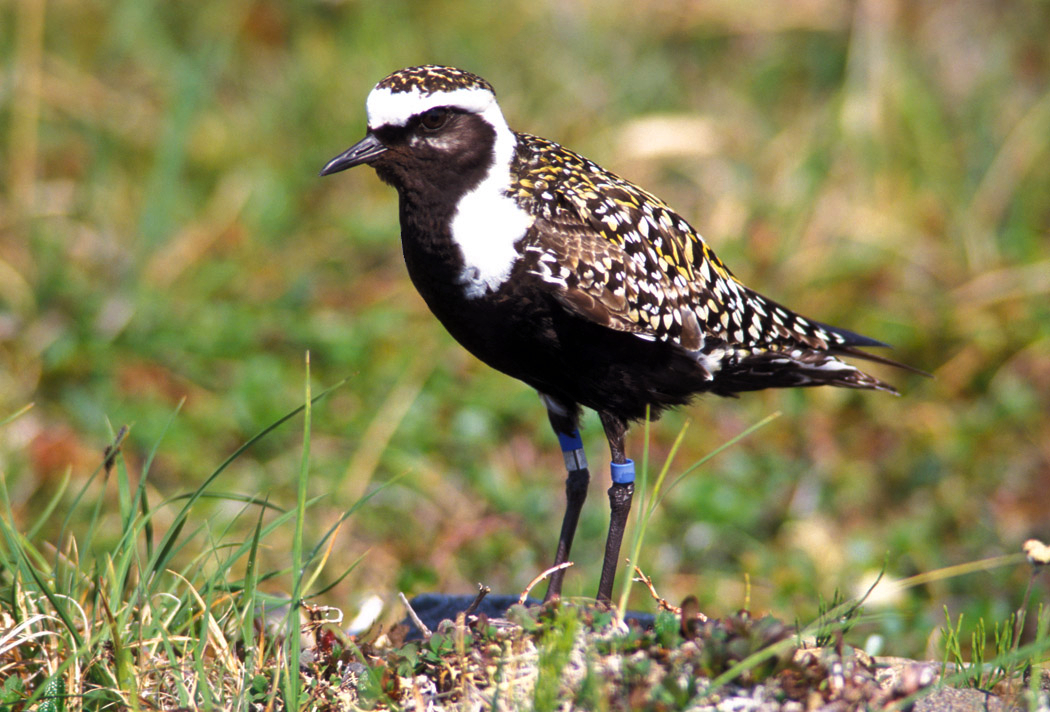
Wikipedia: American golden-plover Quelle: OTHER
Pluvialis_dominica1.jpg
Dieser Vogel erscheint jenseits grossen Meere in Kontinenten :
Nordamerika, Südamerika, Afrika.
![]() The American golden plover (Pluvialis dominica), or American golden-plover is a medium-sized plover. The genus name is Latin and means relating to rain, from pluvia, "rain". It was believed that golden plovers flocked when rain was imminent. The species name dominica refers to Santo Domingo, now Hispaniola, in the West Indies.[2]
[more]
The American golden plover (Pluvialis dominica), or American golden-plover is a medium-sized plover. The genus name is Latin and means relating to rain, from pluvia, "rain". It was believed that golden plovers flocked when rain was imminent. The species name dominica refers to Santo Domingo, now Hispaniola, in the West Indies.[2]
[more]
Kiebitzregenpfeifer / Black-bellied plover (Pluvialis squatarola)
Black-bellied plover eggs. 2016-09-25 16.51.00 Botswana
Zuerst beobachtet in Botswana an 2016-09-25.
Dieser Vogel erscheint jenseits grossen Meere in Kontinenten :
Europa, Nordamerika, Südamerika, Afrika, Asien.
![]()
[more]
Rufe: ![]() Contact call diagnostic. A plaintive, drawn and trisyllabic (but continuous) "kleeooowee". Pitch falls on second syllable and rises on last. [Link]
Contact call diagnostic. A plaintive, drawn and trisyllabic (but continuous) "kleeooowee". Pitch falls on second syllable and rises on last. [Link]
Körperlich: Länge=27-30 cm,
Flügelspanne=71-83 cm,
Gewicht=190-280 g
Habitate:
Nassgebiet
Sibirischer Goldregenpfeifer / Pacific golden plover (Pluvialis fulva)

Wikipedia: Pacific golden plover Quelle: OTHER
Pluvialis_fulva_-Bering_Land_Bridge_National_Preserve%2C_Alaska%2C_USA-8.jpg
Dieser Vogel erscheint jenseits grossen Meere in Kontinenten :
Nordamerika, Afrika, Asien.
Allgemein: ![]() Der Sibirische Goldregenpfeifer (Pluvialis fulva), auch Tundra-Goldregenpfeifer oder Pazifischer Goldregenpfeifer genannt, ist eine monotypische Art aus der Familie der Regenpfeifer. Die im Norden der Paläarktis brütende Art kommt in Europa fast regelmäßig als Durchzügler und Irrgast vor. In den Niederlanden ist sie häufiger zu beobachten als der Prärie-Goldregenpfeifer.[1]
[more]
Der Sibirische Goldregenpfeifer (Pluvialis fulva), auch Tundra-Goldregenpfeifer oder Pazifischer Goldregenpfeifer genannt, ist eine monotypische Art aus der Familie der Regenpfeifer. Die im Norden der Paläarktis brütende Art kommt in Europa fast regelmäßig als Durchzügler und Irrgast vor. In den Niederlanden ist sie häufiger zu beobachten als der Prärie-Goldregenpfeifer.[1]
[more]
Weißbürzelstrandläufer / White-rumped sandpiper (Calidris fuscicollis)
Profil Wikipedia eBird Audubon AllAboutBirds Xeno-Canto

Wikipedia: White-rumped sandpiper Quelle: OTHER
1200px-Calidris_fuscicollis_PLAYERO_RABADILLA_BLANCA.jpg
Dieser Vogel erscheint jenseits grossen Meere in Kontinenten :
Nordamerika, Südamerika, Afrika.
![]() Der Weißbürzelstrandläufer (Calidris fuscicollis) ist eine Vogelart aus der Familie der Schnepfenvögel. Die IUCN stuft den Weißbürzelstrandläufer als nicht gefährdet (least concern) ein und schätzt den Bestand auf 320.000 geschlechtsreife Individuen.[1]
[more]
Der Weißbürzelstrandläufer (Calidris fuscicollis) ist eine Vogelart aus der Familie der Schnepfenvögel. Die IUCN stuft den Weißbürzelstrandläufer als nicht gefährdet (least concern) ein und schätzt den Bestand auf 320.000 geschlechtsreife Individuen.[1]
[more]
Sumpfläufer (alternate) / Broad-billed sandpiper (Calidris falcinellus)
Profil Wikipedia eBird Xeno-Canto NABU

Wikipedia: Broad-billed sandpiper Quelle: OTHER
1200px-Broad_billed_sandpiper_by_Sreedev_Puthur.jpg
![]() Der Sumpfläufer (Calidris falcinellus,[1] Syn.: Limicola falcinellus) ist ein kleiner Watvogel aus der monotypischen Gattung Limicola. Er besiedelt Sumpfgebiete in Fennoskandien und Sibirien und überwintert vorwiegend an den subtropischen und tropischen Küsten der alten Welt. In Mitteleuropa ist er vereinzelt als Durchzügler zu beobachten.
[more]
Der Sumpfläufer (Calidris falcinellus,[1] Syn.: Limicola falcinellus) ist ein kleiner Watvogel aus der monotypischen Gattung Limicola. Er besiedelt Sumpfgebiete in Fennoskandien und Sibirien und überwintert vorwiegend an den subtropischen und tropischen Küsten der alten Welt. In Mitteleuropa ist er vereinzelt als Durchzügler zu beobachten.
[more]
Temminckstrandläufer / Temminck's stint (Calidris temminckii)
Profil Wikipedia eBird Vogelwarte BirdLife ZH ornitho.ch Xeno-Canto NABU

Wikipedia: Temminck's stint Quelle: OTHER
1200px-Temmincks_Stint.jpg
![]() Der Temminckstrandläufer (Calidris temminckii) ist ein monotypischer Schnepfenvogel; er ist nach Coenraad Jacob Temminck benannt. Der in den Tundren Eurasiens brütende Vogel ist in Mitteleuropa ein regelmäßiger Durchzügler zu beiden Zugzeiten.
[more]
Der Temminckstrandläufer (Calidris temminckii) ist ein monotypischer Schnepfenvogel; er ist nach Coenraad Jacob Temminck benannt. Der in den Tundren Eurasiens brütende Vogel ist in Mitteleuropa ein regelmäßiger Durchzügler zu beiden Zugzeiten.
[more]
Habitate:
Nassgebiet
Knutt / Red knot (Calidris canutus)
Profil Wikipedia eBird Vogelwarte BirdLife ZH ornitho.ch Audubon AllAboutBirds Xeno-Canto BirdID NABU
Red knots, according to MerlinBirdID - underway to somewhere better at Las Coloradas. 2023-04-15 09.34.08 Yucatan
Zuerst beobachtet in Yucatan an 2023-04-15.
Dieser Vogel erscheint jenseits grossen Meere in Kontinenten :
Europa, Nordamerika, Südamerika, Afrika, Asien.
![]() Der Knutt (Calidris canutus), auch Knuttstrandläufer genannt, ist ein Vogel aus der Familie der Schnepfenvögel (Scolopacidae). Er wurde möglicherweise nach dem anglo-skandinavischen König Knut dem Großen benannt, aber auch eine lautmalerische Benennung nach dem Klang seiner Rufe ist denkbar.
[more]
Der Knutt (Calidris canutus), auch Knuttstrandläufer genannt, ist ein Vogel aus der Familie der Schnepfenvögel (Scolopacidae). Er wurde möglicherweise nach dem anglo-skandinavischen König Knut dem Großen benannt, aber auch eine lautmalerische Benennung nach dem Klang seiner Rufe ist denkbar.
[more]
Gesang: ![]() Song an undulating, nasal mewing "poooor-mee", or "po-hor-mee". [Link]
Song an undulating, nasal mewing "poooor-mee", or "po-hor-mee". [Link]
Rufe: ![]() Most commonly heard migratory call, a short "kut" or "knot". Sometimes given in stuttering series. [Link]
Most commonly heard migratory call, a short "kut" or "knot". Sometimes given in stuttering series. [Link]
Körperlich: Länge=23-25 cm,
Flügelspanne=57-61 cm,
Gewicht=110-160 g
Habitate:
Nassgebiet
Langzehenstrandläufer / Long-toed stint (Calidris subminuta)
Profil Wikipedia eBird Audubon AllAboutBirds Xeno-Canto

Wikipedia: Long-toed stint Quelle: OTHER
1200px-Calidris_subminuta_-_Pak_Thale.jpg
Dieser Vogel erscheint jenseits grossen Meere in Kontinenten :
Nordamerika, Afrika, Asien.
Allgemein: ![]() Der Langzehenstrandläufer (Calidris subminuta) ist eine Art aus der Familie der Schnepfenvögel. Die IUCN stuft den Langzehenstrandläufer als
Der Langzehenstrandläufer (Calidris subminuta) ist eine Art aus der Familie der Schnepfenvögel. Die IUCN stuft den Langzehenstrandläufer als ![]() (=least concern – nicht gefährdet) ein. Der Bestand wird von der IUCN auf 25.000 geschlechtsreife Individuen geschätzt.[1]
[more]
(=least concern – nicht gefährdet) ein. Der Bestand wird von der IUCN auf 25.000 geschlechtsreife Individuen geschätzt.[1]
[more]
Bairdstrandläufer / Baird's sandpiper (Calidris bairdii)
Profil Wikipedia eBird Audubon AllAboutBirds Xeno-Canto

Wikipedia: Baird's sandpiper Quelle: OTHER
Calidris_bairdii_-Gullbringusysla%2C_Iceland-8.jpg
Dieser Vogel erscheint jenseits grossen Meere in Kontinenten :
Nordamerika, Südamerika, Afrika.
![]() Der Bairdstrandläufer (Calidris bairdii) ist eine Art aus der Familie der Schnepfenvögel. Die IUCN stuft den Bairdstrandläufer als ungefährdet (least concern) ein. Der Bestand wird von der IUCN auf 300.000 geschlechtsreife Individuen geschätzt.[1]
[more]
Der Bairdstrandläufer (Calidris bairdii) ist eine Art aus der Familie der Schnepfenvögel. Die IUCN stuft den Bairdstrandläufer als ungefährdet (least concern) ein. Der Bestand wird von der IUCN auf 300.000 geschlechtsreife Individuen geschätzt.[1]
[more]
Grasläufer / Buff-breasted sandpiper (Calidris subruficollis)

Wikipedia: Buff-breasted sandpiper Quelle: OTHER
1200px-Tryngites_subruficollis_-USA-8.jpg
Dieser Vogel erscheint jenseits grossen Meere in Kontinenten :
Nordamerika, Südamerika, Afrika.
![]() Der Grasläufer (Calidris subruficollis,[1] Syn.: Tryngites subruficollis) ist ein kleiner Watvogel, der in Nordamerika vorkommt und ist ein seltener Irrgast, also eine Ausnahmeerscheinung in Europa. Am häufigsten wird er in Großbritannien beobachtet, wo sich zwischen 1958 und 1982 insgesamt 680 Individuen einfanden. Dabei handelt es sich meist um Jungvögel, die im Frühherbst dorthin verdriftet werden. In Deutschland wurde er zwischen 1977 und 1997 insgesamt achtzehn Mal beobachtet.[2]
[more]
Der Grasläufer (Calidris subruficollis,[1] Syn.: Tryngites subruficollis) ist ein kleiner Watvogel, der in Nordamerika vorkommt und ist ein seltener Irrgast, also eine Ausnahmeerscheinung in Europa. Am häufigsten wird er in Großbritannien beobachtet, wo sich zwischen 1958 und 1982 insgesamt 680 Individuen einfanden. Dabei handelt es sich meist um Jungvögel, die im Frühherbst dorthin verdriftet werden. In Deutschland wurde er zwischen 1977 und 1997 insgesamt achtzehn Mal beobachtet.[2]
[more]
Sanderling / Sanderling (Calidris alba)
Profil Wikipedia eBird Vogelwarte BirdLife ZH ornitho.ch Audubon AllAboutBirds Xeno-Canto BirdID NABU
Sanderling. 2023-09-27 12.12.20 Florida
Zuerst beobachtet in Yucatan an 2023-03-27.
Dieser Vogel erscheint jenseits grossen Meere in Kontinenten :
Europa, Nordamerika, Südamerika, Afrika, Asien.
![]() Der Sanderling (Calidris alba) ist ein kleiner Watvogel aus der Gattung der Strandläufer. Im Wattenmeer der Niederlande und Deutschlands taucht er vor allem im Winterhalbjahr in teils großen Schwärmen an der Nordseeküste auf, weitaus seltener im Binnenland. Er lässt sich außerdem ganzjährig zumindest in kleiner Zahl beobachten. An der Ostsee überwintert dagegen nur ein kleiner Teil der Sanderlinge. Während der Zugzeiten sind dort höchstens einige wenige hundert Vögel zu beobachten.
[more]
Der Sanderling (Calidris alba) ist ein kleiner Watvogel aus der Gattung der Strandläufer. Im Wattenmeer der Niederlande und Deutschlands taucht er vor allem im Winterhalbjahr in teils großen Schwärmen an der Nordseeküste auf, weitaus seltener im Binnenland. Er lässt sich außerdem ganzjährig zumindest in kleiner Zahl beobachten. An der Ostsee überwintert dagegen nur ein kleiner Teil der Sanderlinge. Während der Zugzeiten sind dort höchstens einige wenige hundert Vögel zu beobachten.
[more]
Rufe: ![]() Call not very diagnostic; a short and soft "pleet" or "keek". [Link]
Call not very diagnostic; a short and soft "pleet" or "keek". [Link]
Körperlich: Länge=20-21 cm,
Flügelspanne=40-45 cm,
Gewicht=44-70 g
Habitate:
Nassgebiet
Alpenstrandläufer / Dunlin (Calidris alpina)
Profil Wikipedia eBird Vogelwarte BirdLife ZH ornitho.ch Audubon AllAboutBirds Xeno-Canto BirdID NABU
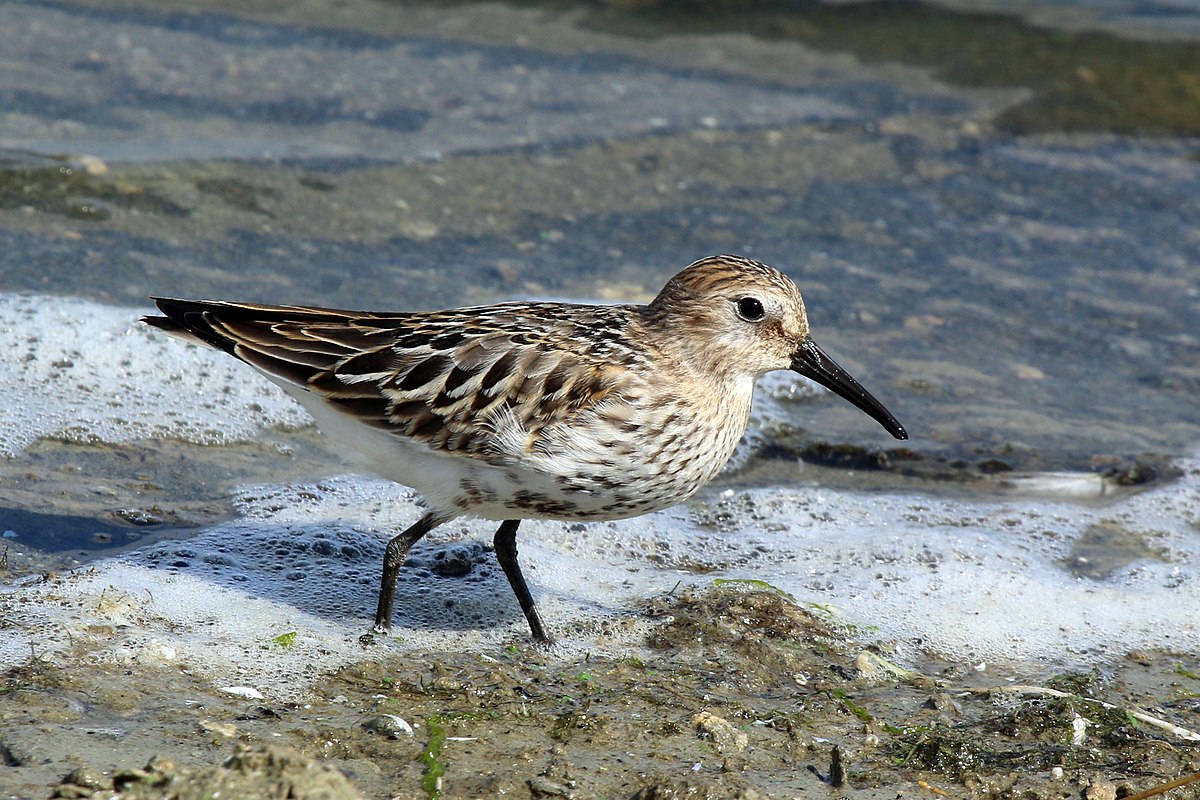
Wikipedia: Dunlin Quelle: OTHER
1200px-Dunlin_%28Calidris_alpina%29_juvenile.jpg
Dieser Vogel erscheint jenseits grossen Meere in Kontinenten :
Europa, Nordamerika, Südamerika, Afrika.
Allgemein: ![]() Der Alpenstrandläufer (Calidris alpina) ist eine zirkumpolar verbreitete Vogelart aus der Familie der Schnepfenvögel (Scolopacidae). Es werden sechs bis zuweilen sogar zehn Unterarten unterschieden, die drei genetisch deutlich differenzierte Unterartengruppen bilden, von denen je eine in Europa, Sibirien und Alaska sowie Kanada verbreitet ist.[1]
[more]
Der Alpenstrandläufer (Calidris alpina) ist eine zirkumpolar verbreitete Vogelart aus der Familie der Schnepfenvögel (Scolopacidae). Es werden sechs bis zuweilen sogar zehn Unterarten unterschieden, die drei genetisch deutlich differenzierte Unterartengruppen bilden, von denen je eine in Europa, Sibirien und Alaska sowie Kanada verbreitet ist.[1]
[more]
Gesang: ![]() Song: A drawn out, nasal "tweeet", and ringing variations on the contact call in decrescendo. Low chattering heard from feeding birds. [Link]
Song: A drawn out, nasal "tweeet", and ringing variations on the contact call in decrescendo. Low chattering heard from feeding birds. [Link]
Rufe: ![]() Contact call a diagnostic, very nasal "trrreeet" . Given throughout the year and in many situations, including when being flushed. [Link]
Contact call a diagnostic, very nasal "trrreeet" . Given throughout the year and in many situations, including when being flushed. [Link]
Körperlich: Länge=16-20 cm,
Flügelspanne=38-43 cm,
Gewicht=35-60 g
Habitate:
Nassgebiet
Calidris tenuirostris / Great knot (Calidris tenuirostris)
Profil Wikipedia eBird Xeno-Canto

Wikipedia: Great knot Quelle: OTHER
1200px-Calidris_tenuirostris_-_Laem_Phak_Bia.jpg
Allgemein: ![]() The great knot (Calidris tenuirostris) is a small wader. It is the largest of the calidrid species. The genus name is from Ancient Greek kalidris or skalidris, a term used by Aristotle for some grey-coloured waterside birds. The specific tenuirostris is from Latin tenuis "slender" and rostrum "bill".[2]
[more]
The great knot (Calidris tenuirostris) is a small wader. It is the largest of the calidrid species. The genus name is from Ancient Greek kalidris or skalidris, a term used by Aristotle for some grey-coloured waterside birds. The specific tenuirostris is from Latin tenuis "slender" and rostrum "bill".[2]
[more]
Rotkehlstrandläufer / Rufous-necked stint (Calidris ruficollis)
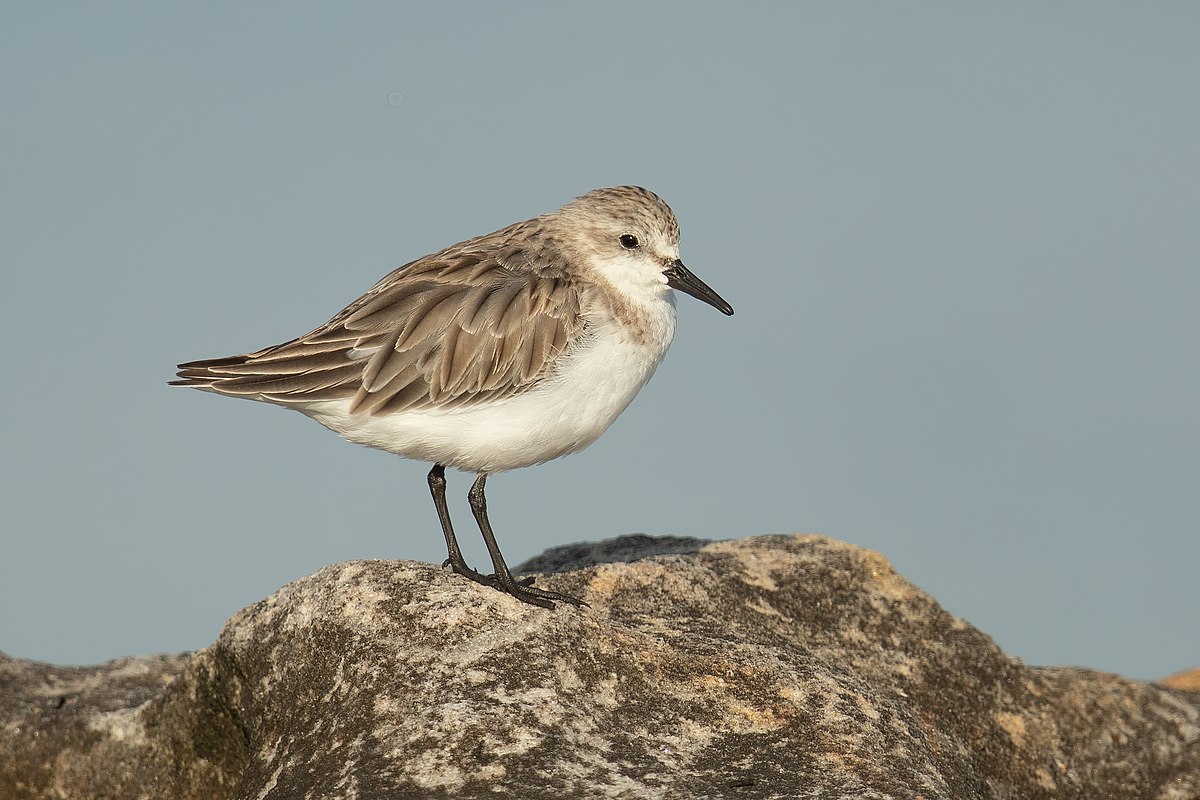
Wikipedia: Rufous-necked stint Quelle: OTHER
1200px-Red-necked_Stint_-_Boat_Harbour.jpg
Dieser Vogel erscheint jenseits grossen Meere in Kontinenten :
Nordamerika, Afrika, Asien.
![]() Der Rotkehlstrandläufer (Calidris ruficollis) ist eine kleine, monotypische Art aus der Familie der Schnepfenvögel. Die IUCN stuft den Rotkehlstrandläufer als
Der Rotkehlstrandläufer (Calidris ruficollis) ist eine kleine, monotypische Art aus der Familie der Schnepfenvögel. Die IUCN stuft den Rotkehlstrandläufer als ![]() (=least concern – nicht gefährdet) ein und schätzt den Bestand auf 320.000 geschlechtsreife Individuen.[1]
[more]
(=least concern – nicht gefährdet) ein und schätzt den Bestand auf 320.000 geschlechtsreife Individuen.[1]
[more]
Zwergstrandläufer / Little stint (Calidris minuta)
Profil Wikipedia eBird Vogelwarte BirdLife ZH ornitho.ch Xeno-Canto BirdID NABU

Wikipedia: Little stint Quelle: OTHER
Little_Stint_%28Calidris_minuta%29_2.jpg
![]() Der sperlingsgroße Zwergstrandläufer (Calidris minuta) ist eine monotypische Art aus der Familie der Schnepfenvögel (Scolopacidae) und gehört zu den weltweit kleinsten Watvögeln. Er brütet im Norden Eurasiens. In Mitteleuropa ist er sowohl an der Nordseeküste als auch im Binnenland während der Zugzeiten regelmäßig zu beobachten.[1]
[more]
Der sperlingsgroße Zwergstrandläufer (Calidris minuta) ist eine monotypische Art aus der Familie der Schnepfenvögel (Scolopacidae) und gehört zu den weltweit kleinsten Watvögeln. Er brütet im Norden Eurasiens. In Mitteleuropa ist er sowohl an der Nordseeküste als auch im Binnenland während der Zugzeiten regelmäßig zu beobachten.[1]
[more]
Gesang: ![]() Song a cyclic series of thin "peee-peee-peee" rising and falling in pitch. [Link]
Song a cyclic series of thin "peee-peee-peee" rising and falling in pitch. [Link]
Rufe: ![]() Contact call a quite soft, short, high pitched "pit". Sometimes uttered in series, or as soft chattering. [Link]
Contact call a quite soft, short, high pitched "pit". Sometimes uttered in series, or as soft chattering. [Link]
Körperlich: Länge=12-14 cm,
Flügelspanne=34-37 cm,
Gewicht=18-30 g
Habitate:
Nassgebiet
Graubrust-Strandläufer / Pectoral sandpiper (Calidris melanotos)
Profil Wikipedia eBird Audubon AllAboutBirds Xeno-Canto

Wikipedia: Pectoral sandpiper Quelle: OTHER
1200px-Pectoral_Sandpiper3.jpg
Dieser Vogel erscheint jenseits grossen Meere in Kontinenten :
Nordamerika, Südamerika, Afrika.
Allgemein: ![]() Der Graubruststrandläufer (Calidris melanotos) ist eine Vogelart aus der Familie der Schnepfenvögel. Die IUCN stuft den Graubruststrandläufer als
Der Graubruststrandläufer (Calidris melanotos) ist eine Vogelart aus der Familie der Schnepfenvögel. Die IUCN stuft den Graubruststrandläufer als ![]() (=least concern – nicht gefährdet) ein. Der Bestand wird von BirdLife International auf 25.000 bis 100.000 geschlechtsreife Individuen geschätzt.[1]
[more]
(=least concern – nicht gefährdet) ein. Der Bestand wird von BirdLife International auf 25.000 bis 100.000 geschlechtsreife Individuen geschätzt.[1]
[more]
Regenbrachvogel / Whimbrel (Numenius phaeopus)
Regenbrachvogel oder Grosser Brachvogel - dunkle Schwanzfedern ein moegliches Zeichen. 2022-06-23 16.53.34 La Sauge
Zuerst beobachtet in Kanarische Inseln an 2022-03-19.
Dieser Vogel erscheint jenseits grossen Meere in Kontinenten :
Europa, Nordamerika, Südamerika, Afrika, Asien.
![]() Der Regenbrachvogel (Numenius phaeopus) ist mit einer Spannweite um die 80 cm viel kleiner als der Große Brachvogel, auch der Schnabel ist kürzer und der Oberkopf ist hell und dunkel gestreift. Der Ruf dieser Vogelart ähnelt einem hellen Trillern.
[more]
Der Regenbrachvogel (Numenius phaeopus) ist mit einer Spannweite um die 80 cm viel kleiner als der Große Brachvogel, auch der Schnabel ist kürzer und der Oberkopf ist hell und dunkel gestreift. Der Ruf dieser Vogelart ähnelt einem hellen Trillern.
[more]
Gesang: ![]() Song starts similar to Curlew with long wailing notes "kluuueee", which then accelerates to a continuous, vibrating single note. Lacks the cyclic phrase ending of Curlew. [Link]
Song starts similar to Curlew with long wailing notes "kluuueee", which then accelerates to a continuous, vibrating single note. Lacks the cyclic phrase ending of Curlew. [Link]
Körperlich: Länge=40-42 cm,
Flügelspanne=76-89 cm,
Gewicht=300-660 g
Habitate:
Nassgebiet
Steinwälzer / Ruddy turnstone (Arenaria interpres)
Ruddy turnstone near Las Coloradas. 2023-04-15 10.06.32 Yucatan
Zuerst beobachtet in Kanarische Inseln an 2022-03-19.
Dieser Vogel erscheint jenseits grossen Meere in Kontinenten :
Europa, Nordamerika, Südamerika, Afrika, Asien.
Allgemein: ![]() Der Steinwälzer (Arenaria interpres) ist eine Vogelart aus der Familie der Schnepfenvögel (Scolopacidae). Der Steinwälzer verdankt seinen Namen seiner speziellen Art der Nahrungssuche, bei der er am Strand Steine und Muscheln umdreht. Er brütet in zwei Unterarten zirkumpolar in Tundren und der borealen sowie zum Teil der gemäßigten Zone. In Mitteleuropa ist er ein lokaler, sehr seltener Brut- und Sommervogel. Während der Zugzeiten sind im Nordwesten Mitteleuropas mehrere tausend Überwinterer sowie Durchzügler und Rastvögel zu beobachten.
[more]
Der Steinwälzer (Arenaria interpres) ist eine Vogelart aus der Familie der Schnepfenvögel (Scolopacidae). Der Steinwälzer verdankt seinen Namen seiner speziellen Art der Nahrungssuche, bei der er am Strand Steine und Muscheln umdreht. Er brütet in zwei Unterarten zirkumpolar in Tundren und der borealen sowie zum Teil der gemäßigten Zone. In Mitteleuropa ist er ein lokaler, sehr seltener Brut- und Sommervogel. Während der Zugzeiten sind im Nordwesten Mitteleuropas mehrere tausend Überwinterer sowie Durchzügler und Rastvögel zu beobachten.
[more]
Gesang: ![]() Alarm call/song more "wader-like", a staccato "kuvi-kuvi-vit-vit-vitua". [Link]
Alarm call/song more "wader-like", a staccato "kuvi-kuvi-vit-vit-vitua". [Link]
Rufe: ![]() Characteristic call: An explosive, hard, resonant and short "koi" or "kott" with a peculiar timbre, usually given in rapid or accelerating series. [Link]
Characteristic call: An explosive, hard, resonant and short "koi" or "kott" with a peculiar timbre, usually given in rapid or accelerating series. [Link]
Körperlich: Länge=22-24 cm,
Flügelspanne=50-57 cm,
Gewicht=85-150 g
Habitate:
Nassgebiet
Doppelschnepfe / Great snipe (Gallinago media)
Profil Wikipedia eBird Vogelwarte BirdLife ZH ornitho.ch Xeno-Canto BirdID NABU

Wikipedia: Great snipe Quelle: OTHER
Greatsnipe_1000.jpg
Allgemein: ![]() Die Doppelschnepfe (Gallinago media) ist eine Vogelart aus der Gattung der Bekassinen (Gallinago) in der Familie der Schnepfenvögel (Scolopacidae). Im Nordosten Mitteleuropas ist die Doppelschnepfe ein Brut- und Sommervogel. Außerhalb der Brutgebiete ist die Doppelschnepfe in Mitteleuropa ein seltener, zum Teil aber regelmäßiger Durchzügler. Während der Zugzeiten kann sie beispielsweise in Brandenburg, Tschechien und der Slowakei beobachtet werden.
[more]
Die Doppelschnepfe (Gallinago media) ist eine Vogelart aus der Gattung der Bekassinen (Gallinago) in der Familie der Schnepfenvögel (Scolopacidae). Im Nordosten Mitteleuropas ist die Doppelschnepfe ein Brut- und Sommervogel. Außerhalb der Brutgebiete ist die Doppelschnepfe in Mitteleuropa ein seltener, zum Teil aber regelmäßiger Durchzügler. Während der Zugzeiten kann sie beispielsweise in Brandenburg, Tschechien und der Slowakei beobachtet werden.
[more]
Vokalisierung: ![]() Sometimes utters a faint grunt when flushed, but is generally silent when not lekking. [Link]
Sometimes utters a faint grunt when flushed, but is generally silent when not lekking. [Link]
Rufe: ![]() Display call unique: A bubbling, clappering and whistling sequence that accelerates into a crescendo followed by a decrescendo. [Link]
Display call unique: A bubbling, clappering and whistling sequence that accelerates into a crescendo followed by a decrescendo. [Link]
Körperlich: Länge=27-29 cm,
Flügelspanne=47-50 cm,
Gewicht=150-225 g
Afrikanische Schnepfe / African snipe (Gallinago nigripennis)
Profil Wikipedia eBird Xeno-Canto

Wikipedia: African snipe Quelle: OTHER
1200px-African_snipe_%28Gallinago_nigripennis_aequatorialis%29.jpg
Allgemein: ![]() Die Afrikanische Schnepfe (Gallinago nigripennis, auch: Äthiopische Schnepfe oder Afrikanische Bekassine, Ethiopian snipe) ist eine Vogelart aus der Familie der Schnepfenvögel (Scolopacidae). Sie brütet in feuchten Bergmooren und Sümpfen in Afrika in 1700–4000 m über dem Meer. Außerhalb der Brutzeit streift sie weit umher und steigt auch bis in die Küstenebenen ab.
[more]
Die Afrikanische Schnepfe (Gallinago nigripennis, auch: Äthiopische Schnepfe oder Afrikanische Bekassine, Ethiopian snipe) ist eine Vogelart aus der Familie der Schnepfenvögel (Scolopacidae). Sie brütet in feuchten Bergmooren und Sümpfen in Afrika in 1700–4000 m über dem Meer. Außerhalb der Brutzeit streift sie weit umher und steigt auch bis in die Küstenebenen ab.
[more]
Limnodromus semipalmatus / Asian dowitcher (Limnodromus semipalmatus)

Wikipedia: Asian dowitcher Quelle: OTHER
Asian_Dowitcher_6436.jpg
![]() The Asian dowitcher (Limnodromus semipalmatus) is a rare medium-large wader.
[more]
The Asian dowitcher (Limnodromus semipalmatus) is a rare medium-large wader.
[more]
Hudsonschnepfe / Hudsonian godwit (Limosa haemastica)
Profil Wikipedia eBird Audubon AllAboutBirds Xeno-Canto

Wikipedia: Hudsonian godwit Quelle: OTHER
1200px-Limosa_haemastica_-_Kogarah_Bay.jpg
Dieser Vogel erscheint jenseits grossen Meere in Kontinenten :
Nordamerika, Südamerika, Afrika.
![]() Die Hudsonschnepfe (Limosa haemastica), auch als Amerikanische Uferschnepfe bezeichnet, ist ein großer Watvogel aus der Gattung der Pfuhlschnepfen (Limosa).
[more]
Die Hudsonschnepfe (Limosa haemastica), auch als Amerikanische Uferschnepfe bezeichnet, ist ein großer Watvogel aus der Gattung der Pfuhlschnepfen (Limosa).
[more]
Uferschnepfe / Black-tailed godwit (Limosa limosa)
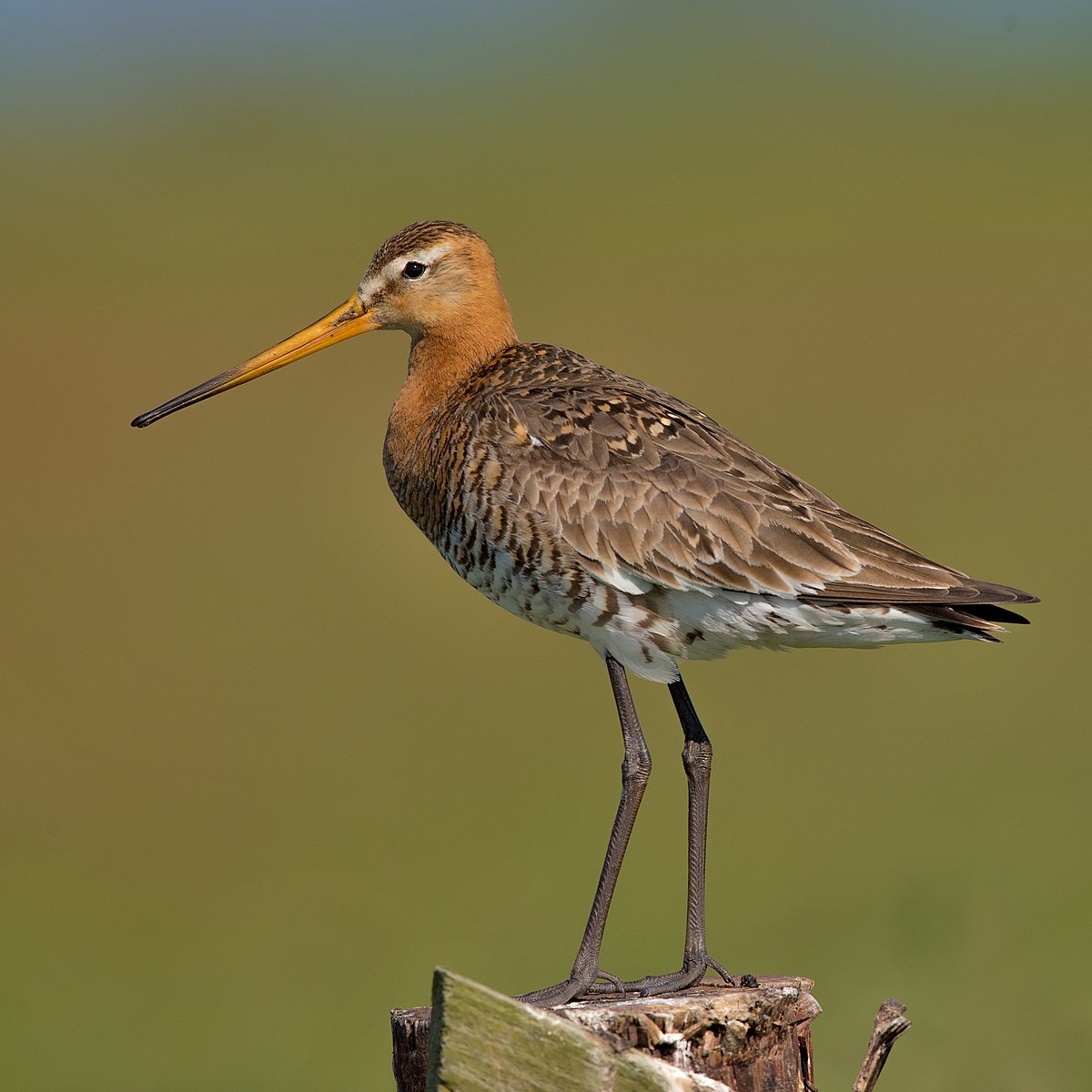
Wikipedia: Black-tailed godwit Quelle: OTHER
1200px-Black-tailed_Godwit_Uferschnepfe.jpg
Dieser Vogel erscheint jenseits grossen Meere in Kontinenten :
Europa, Nordamerika, Afrika, Asien.
![]() Die Uferschnepfe (Limosa limosa), im plattdeutschen auch als Greta bezeichnet,[1] ist eine Vogelart aus der Familie der Schnepfenvögel (Scolopacidae). Uferschnepfen sind Langstreckenzieher und brüten vorwiegend auf Feuchtwiesen. Die Art steht sowohl international auf der Roten Liste gefährdeter Arten als auch auf der Roten Liste der Brutvögel Deutschlands.
[more]
Die Uferschnepfe (Limosa limosa), im plattdeutschen auch als Greta bezeichnet,[1] ist eine Vogelart aus der Familie der Schnepfenvögel (Scolopacidae). Uferschnepfen sind Langstreckenzieher und brüten vorwiegend auf Feuchtwiesen. Die Art steht sowohl international auf der Roten Liste gefährdeter Arten als auch auf der Roten Liste der Brutvögel Deutschlands.
[more]
Habitate:
Nassgebiet
Kleiner Gelbschenkel / Lesser yellowlegs (Tringa flavipes)
Profil Wikipedia eBird Audubon AllAboutBirds Xeno-Canto

Wikipedia: Lesser yellowlegs Quelle: OTHER
1200px-Lesser_Yellowlegs.jpg
Dieser Vogel erscheint jenseits grossen Meere in Kontinenten :
Nordamerika, Südamerika, Afrika.
![]() Der Kleine Gelbschenkel (Tringa flavipes) ist eine monotypische Vogelart aus der Familie der Schnepfenvögel. Er ist ein Brutvogel Nordamerikas und überwintert im Süden Nordamerikas sowie in Südamerika. Die IUCN stuft den Kleinen Gelbschenkel als
Der Kleine Gelbschenkel (Tringa flavipes) ist eine monotypische Vogelart aus der Familie der Schnepfenvögel. Er ist ein Brutvogel Nordamerikas und überwintert im Süden Nordamerikas sowie in Südamerika. Die IUCN stuft den Kleinen Gelbschenkel als ![]() (=least concern – nicht gefährdet) ein.
[more]
(=least concern – nicht gefährdet) ein.
[more]
Rotschenkel / Common redshank (Tringa totanus)
Profil Wikipedia eBird Vogelwarte BirdLife ZH ornitho.ch Xeno-Canto BirdID NABU
Common redshank plus common pochard. 2022-04-12 14.02.38 Mallorca
Zuerst beobachtet in Mallorca an 2022-04-12.
![]() Der Rotschenkel (Tringa totanus) ist eine Vogelart aus der Familie der Schnepfenvögel (Scolopacidae). Er ist ein Brutvogel über weite Bereiche Eurasiens. Zu seinem Lebensraum gehören die mediterrane bis boreale Zone, und er kommt in Asien auch in Steppen- und Wüstengebieten vor. In Mitteleuropa sind Schwerpunkte seiner Verbreitung die Küsten und das küstennahe Tiefland. Im Binnenland kommt er nur inselartig in kleinen Populationen vor, und im Süden Mitteleuropas ist er auf Restvorkommen reduziert.[1]
[more]
Der Rotschenkel (Tringa totanus) ist eine Vogelart aus der Familie der Schnepfenvögel (Scolopacidae). Er ist ein Brutvogel über weite Bereiche Eurasiens. Zu seinem Lebensraum gehören die mediterrane bis boreale Zone, und er kommt in Asien auch in Steppen- und Wüstengebieten vor. In Mitteleuropa sind Schwerpunkte seiner Verbreitung die Küsten und das küstennahe Tiefland. Im Binnenland kommt er nur inselartig in kleinen Populationen vor, und im Süden Mitteleuropas ist er auf Restvorkommen reduziert.[1]
[more]
Vokalisierung: ![]() Generally a noisy and loud bird, especially at breeding ground. Most heard is a characteristic "tew-hoo", or "tew-hoo-hoo" with first syllable accentuated. No gap between the syllables like Greenshank, and usually with a marked falling pitch. [Link]
Generally a noisy and loud bird, especially at breeding ground. Most heard is a characteristic "tew-hoo", or "tew-hoo-hoo" with first syllable accentuated. No gap between the syllables like Greenshank, and usually with a marked falling pitch. [Link]
Gesang: ![]() Song similar to Wood Sandpiper, but with three accented notes in each cycle, not two. [Link]
Song similar to Wood Sandpiper, but with three accented notes in each cycle, not two. [Link]
Körperlich: Länge=27-29 cm,
Flügelspanne=59-66 cm,
Gewicht=85-150 g
Habitate:
Nassgebiet
Bruchwasserläufer / Wood sandpiper (Tringa glareola)
Profil Wikipedia eBird Vogelwarte BirdLife ZH ornitho.ch Audubon AllAboutBirds Xeno-Canto BirdID NABU

Wikipedia: Wood sandpiper Quelle: OTHER
1200px-Wood_Sandpiper_Safari_Park.jpg
Zuerst beobachtet in 🇨🇭 an 2021-08-19.
Dieser Vogel erscheint jenseits grossen Meere in Kontinenten :
Europa, Nordamerika, Afrika, Asien.
Allgemein: ![]() Der Bruchwasserläufer (Tringa glareola) ist ein eurasischer Vogel aus der Familie der Schnepfenvögel (Scolopacidae). Er ist ein Brutvogel der gemäßigten und borealen bis subarktischen Tundrenzone. In Mitteleuropa ist er ein sehr seltener, nur lokal vorkommender Brut- und Sommervogel. Die Rote Liste der Brutvögel Deutschlands von 2015 führt die Art in der Kategorie 1 als vom Aussterben bedroht.[1] Recht häufig und regelmäßig ist er aber während der Zugzeiten als Durchzügler und Rastvogel zu beobachten.
[more]
Der Bruchwasserläufer (Tringa glareola) ist ein eurasischer Vogel aus der Familie der Schnepfenvögel (Scolopacidae). Er ist ein Brutvogel der gemäßigten und borealen bis subarktischen Tundrenzone. In Mitteleuropa ist er ein sehr seltener, nur lokal vorkommender Brut- und Sommervogel. Die Rote Liste der Brutvögel Deutschlands von 2015 führt die Art in der Kategorie 1 als vom Aussterben bedroht.[1] Recht häufig und regelmäßig ist er aber während der Zugzeiten als Durchzügler und Rastvogel zu beobachten.
[more]
Vokalisierung: ![]() Totally different from Green Sandpiper. [Link]
Totally different from Green Sandpiper. [Link]
Rufe: ![]() Flight call a soft, but explosive "whiff whiff" , sometimes with only one syllable. Display call similar to redshank but with only two accented beats; a fast melodious "dee-loo", repeated in cycles. [Link]
Flight call a soft, but explosive "whiff whiff" , sometimes with only one syllable. Display call similar to redshank but with only two accented beats; a fast melodious "dee-loo", repeated in cycles. [Link]
Körperlich: Länge=19-21 cm,
Flügelspanne=56-57 cm,
Gewicht=50-80 g
Habitate:
Nassgebiet
Gesang:
Automatically generated from Xeno-Canto recording
Gesang Eigenschaften:
Frequency:
♫ Quelle: BirdNet
20210819_082604 birdnet 1940 - Wood Sandpiper, saw a bird flying, check reports in Ornitho - Wood Sandpiper - Uznach.mp3
2021-08-19 08.26.04 Uznach (Gesang)
Dunkler Wasserläufer / Spotted redshank (Tringa erythropus)
Profil Wikipedia eBird Vogelwarte BirdLife ZH ornitho.ch Xeno-Canto BirdID NABU
Dunkler Wasserlaeufer. 2021-10-24 10.25.42 Neeracherried
Zuerst beobachtet in 🇨🇭 an 2021-10-24.
Allgemein: ![]() Der Dunkle Wasserläufer (Tringa erythropus) ist ein Vogel aus der Ordnung der Regenpfeiferartigen (Charadriiformes)
und wird auch Dunkelwasserläufer genannt. Er ist ein Brutvogel der Arktis und der nördlichen borealen Nadelwaldzone. In Mitteleuropa ist er während der Zugzeiten ein regelmäßiger Durchzügler sowohl an der Küste als auch im Binnenland. Während des Höhepunktes des Zuges sind in den Niederlanden 5.000 bis 10.000 Individuen zu beobachten. In kleiner Zahl überwintern Dunkle Wasserläufer auch in Belgien, dem niederländischen Rheindelta und im Nordwesten Deutschlands.[1]
[more]
Der Dunkle Wasserläufer (Tringa erythropus) ist ein Vogel aus der Ordnung der Regenpfeiferartigen (Charadriiformes)
und wird auch Dunkelwasserläufer genannt. Er ist ein Brutvogel der Arktis und der nördlichen borealen Nadelwaldzone. In Mitteleuropa ist er während der Zugzeiten ein regelmäßiger Durchzügler sowohl an der Küste als auch im Binnenland. Während des Höhepunktes des Zuges sind in den Niederlanden 5.000 bis 10.000 Individuen zu beobachten. In kleiner Zahl überwintern Dunkle Wasserläufer auch in Belgien, dem niederländischen Rheindelta und im Nordwesten Deutschlands.[1]
[more]
Rufe: ![]() Flight call loud and diagnostic, and is often the first sign of the species' presence; a sharp and short, disyllabic "koo-eett", with the first syllable falling in pitch and the second rising sharply. Display call a squeaky, but melodic "krroo-lee-ooo" repeated in cycles. Alarm call a falcon-like "ke-ke-ke-ke". [Link]
Flight call loud and diagnostic, and is often the first sign of the species' presence; a sharp and short, disyllabic "koo-eett", with the first syllable falling in pitch and the second rising sharply. Display call a squeaky, but melodic "krroo-lee-ooo" repeated in cycles. Alarm call a falcon-like "ke-ke-ke-ke". [Link]
Körperlich: Länge=29-31 cm,
Flügelspanne=61-67 cm,
Gewicht=125-210 g
Habitate:
Nassgebiet
Waldwasserläufer / Green sandpiper (Tringa ochropus)
Profil Wikipedia eBird Vogelwarte BirdLife ZH ornitho.ch Xeno-Canto BirdID NABU
Waldwasserlaeufer. 2023-07-08 19.09.34 Neeracherried
Zuerst beobachtet in 🇨🇭 an 2022-09-04.
Allgemein: ![]() Der Waldwasserläufer (Tringa ochropus) ist eine Art aus der Familie der Schnepfenvögel. Es werden keine Unterarten unterschieden. Der Waldwasserläufer ist ein Brutvogel der borealen Nadelwaldzone Eurasiens, der in Mitteleuropa unter anderem auch in Deutschland und Polen brütet.
[more]
Der Waldwasserläufer (Tringa ochropus) ist eine Art aus der Familie der Schnepfenvögel. Es werden keine Unterarten unterschieden. Der Waldwasserläufer ist ein Brutvogel der borealen Nadelwaldzone Eurasiens, der in Mitteleuropa unter anderem auch in Deutschland und Polen brütet.
[more]
Vokalisierung: ![]() Totally different from Wood Sandpiper. [Link]
Totally different from Wood Sandpiper. [Link]
Rufe: ![]() Sharp, penetrating calls. Display call a high-pitched "kee-kleeoo-eet", continuously repeated with a wave-like motion in pitch. Other common calls have similar timbre and tone with different phrasing like; "klooeett -klee-klee-klee-klee-klee" and a rising pitch. [Link]
Sharp, penetrating calls. Display call a high-pitched "kee-kleeoo-eet", continuously repeated with a wave-like motion in pitch. Other common calls have similar timbre and tone with different phrasing like; "klooeett -klee-klee-klee-klee-klee" and a rising pitch. [Link]
Körperlich: Länge=21-24 cm,
Flügelspanne=57-61 cm,
Gewicht=60-90 g
Habitate:
Nassgebiet
Teichwasserläufer / Marsh sandpiper (Tringa stagnatilis)
Profil Wikipedia eBird Vogelwarte BirdLife ZH ornitho.ch Xeno-Canto BirdID NABU

Wikipedia: Marsh sandpiper Quelle: OTHER
1200px-Tringa_stagnatilis_2_-_Laem_Pak_Bia.jpg
Allgemein: ![]() Der Teichwasserläufer (Tringa stagnatilis) ist eine Art aus der Familie der Schnepfenvögel. Er ist ein Brutvogel in den Waldsteppen- und Steppenzonen sowie den südlichen Waldzonen von Osteuropa und dem Karpatenbecken Ungarns bis nach Zentralsibirien und kommt lokal auch in Ostasien vor. In Mitteleuropa ist er gelegentlich ein Gastvogel. Sehr selten brütet er im Osten Österreichs, Ungarn, der Slowakei und in Polen.[1] Für Deutschland wurde eine erfolgreiche Brut erstmals 2012 nachgewiesen.[2]
[more]
Der Teichwasserläufer (Tringa stagnatilis) ist eine Art aus der Familie der Schnepfenvögel. Er ist ein Brutvogel in den Waldsteppen- und Steppenzonen sowie den südlichen Waldzonen von Osteuropa und dem Karpatenbecken Ungarns bis nach Zentralsibirien und kommt lokal auch in Ostasien vor. In Mitteleuropa ist er gelegentlich ein Gastvogel. Sehr selten brütet er im Osten Österreichs, Ungarn, der Slowakei und in Polen.[1] Für Deutschland wurde eine erfolgreiche Brut erstmals 2012 nachgewiesen.[2]
[more]
Gesang: ![]() Song a slow, melancholic whistle "tu-lee-uu", with the middle part highest in pitch (and with falling glissando). Similar to Spotted Redshank in structure, but with a clear tone (little risk of confusion). [Link]
Song a slow, melancholic whistle "tu-lee-uu", with the middle part highest in pitch (and with falling glissando). Similar to Spotted Redshank in structure, but with a clear tone (little risk of confusion). [Link]
Rufe: ![]() Flight call/contact call similar to singular instances of alarm call of Redshank, consisting of a single note rising abruptly in pitch in a split second and then falling; "kieew". Lingers a bit at the ending of the note, giving it a clearer glissando than in Redshank. [Link]
Flight call/contact call similar to singular instances of alarm call of Redshank, consisting of a single note rising abruptly in pitch in a split second and then falling; "kieew". Lingers a bit at the ending of the note, giving it a clearer glissando than in Redshank. [Link]
Körperlich: Länge=22-24 cm,
Flügelspanne=55-59 cm,
Gewicht=50-85 g
Grünschenkel / Common greenshank (Tringa nebularia)
Profil Wikipedia eBird Vogelwarte BirdLife ZH ornitho.ch Audubon AllAboutBirds Xeno-Canto BirdID NABU
MerlinBirdID says common greenshank, probably non-breeding adult. 2022-04-12 14.52.08 Mallorca
Zuerst beobachtet in Mallorca an 2022-04-12.
Dieser Vogel erscheint jenseits grossen Meere in Kontinenten :
Europa, Nordamerika, Afrika, Asien.
Allgemein: ![]() Der Grünschenkel (Tringa nebularia) ist eine monotypische Vogelart aus der Familie der Schnepfenvögel (Scolopacidae). Der Grünschenkel ist ein Brutvogel der borealen Zone Nordeurasiens. In Mitteleuropa ist er während der Zugzeiten ein regelmäßiger Durchzügler. Im Wattenmeer der Niederlande können im Mai sowie im Juli bis September mehrere tausend Grünschenkel beobachtet werden.[1]
[more]
Der Grünschenkel (Tringa nebularia) ist eine monotypische Vogelart aus der Familie der Schnepfenvögel (Scolopacidae). Der Grünschenkel ist ein Brutvogel der borealen Zone Nordeurasiens. In Mitteleuropa ist er während der Zugzeiten ein regelmäßiger Durchzügler. Im Wattenmeer der Niederlande können im Mai sowie im Juli bis September mehrere tausend Grünschenkel beobachtet werden.[1]
[more]
Vokalisierung: ![]() Most heard is a characteristic, trisyllabic "tew-tew-tew" (sometimes two or four syllables). Can resemble redshank, but pitch more stable, and not falling notably. Each syllable is clearly separated and equally emphasized. [Link]
Most heard is a characteristic, trisyllabic "tew-tew-tew" (sometimes two or four syllables). Can resemble redshank, but pitch more stable, and not falling notably. Each syllable is clearly separated and equally emphasized. [Link]
Gesang: ![]() Song a clear disyllabic "cloo-eeee", repeated in cycles but each phrase clearly separated. At close range a short creaky sound is audible (between each phrase). Redshank may sing in a slightly similar way, but in continuous, linked phrases. [Link]
Song a clear disyllabic "cloo-eeee", repeated in cycles but each phrase clearly separated. At close range a short creaky sound is audible (between each phrase). Redshank may sing in a slightly similar way, but in continuous, linked phrases. [Link]
Körperlich: Länge=30-33 cm,
Flügelspanne=68-70 cm,
Gewicht=130-270 g
Habitate:
Nassgebiet
Terekwasserläufer / Terek sandpiper (Xenus cinereus)
Profil Wikipedia eBird Audubon AllAboutBirds Xeno-Canto NABU

Wikipedia: Terek sandpiper Quelle: OTHER
Xenus_cinereus_%28Alnus%29.jpg
Dieser Vogel erscheint jenseits grossen Meere in Kontinenten :
Europa, Nordamerika, Afrika, Asien.
Allgemein: ![]() Der Terekwasserläufer (Xenus cinereus) ist innerhalb der Schnepfenvögel die einzige Art der Gattung Xenus Kaup, 1829. Er ist Brutvogel der borealen Zone vom Osten des Baltikums bis nach Ostsibirien. Einige isolierte Brutplätze finden sich auch in Westrussland sowie im Norden des Bottnischen Meerbusens. In Mitteleuropa ist er gelegentlich als Irrgast zu beobachten. In Mecklenburg-Vorpommern sowie in Schleswig-Holstein ist er beispielsweise seit Mitte der 1990er Jahre alljährlich zu sehen.[1]
[more]
Der Terekwasserläufer (Xenus cinereus) ist innerhalb der Schnepfenvögel die einzige Art der Gattung Xenus Kaup, 1829. Er ist Brutvogel der borealen Zone vom Osten des Baltikums bis nach Ostsibirien. Einige isolierte Brutplätze finden sich auch in Westrussland sowie im Norden des Bottnischen Meerbusens. In Mitteleuropa ist er gelegentlich als Irrgast zu beobachten. In Mecklenburg-Vorpommern sowie in Schleswig-Holstein ist er beispielsweise seit Mitte der 1990er Jahre alljährlich zu sehen.[1]
[more]
Flussuferläufer / Common sandpiper (Actitis hypoleucos)
MerlinBirdID meint Flussuferläufer. 2022-09-04 07.49.06 Neeracherried
Zuerst beobachtet in 🇨🇭 an 2022-09-04.
Dieser Vogel erscheint jenseits grossen Meere in Kontinenten :
Europa, Nordamerika, Afrika, Asien.
![]() Der Flussuferläufer (Actitis hypoleucos) ist eine monotypische Vogelart aus der Familie der Schnepfenvögel (Scolopacidae), die ausschließlich in der Paläarktis brütet.[1] In Mitteleuropa ist der Flussuferläufer ein verbreiteter, aber wenig häufiger Brut- und Sommervogel.
[more]
Der Flussuferläufer (Actitis hypoleucos) ist eine monotypische Vogelart aus der Familie der Schnepfenvögel (Scolopacidae), die ausschließlich in der Paläarktis brütet.[1] In Mitteleuropa ist der Flussuferläufer ein verbreiteter, aber wenig häufiger Brut- und Sommervogel.
[more]
Rufe: ![]() Very vocal with characteristic repertoire of very high-pitched calls. Often heard is a disyllabic call, drawn out and slightly rising in pitch in the second part. This is often repeated in a series of rising tones in a cyclic manner, with approx 5 tones in each cycle. [Link]
Very vocal with characteristic repertoire of very high-pitched calls. Often heard is a disyllabic call, drawn out and slightly rising in pitch in the second part. This is often repeated in a series of rising tones in a cyclic manner, with approx 5 tones in each cycle. [Link]
Körperlich: Länge=19-21 cm,
Flügelspanne=38-41 cm,
Gewicht=40-60 g
Habitate:
Nassgebiet
Thorshühnchen / Red phalarope (Phalaropus fulicarius)

Wikipedia: Red phalarope Quelle: OTHER
1200px-Phalaropus_fulicarius_10.jpg
Dieser Vogel erscheint jenseits grossen Meere in Kontinenten :
Europa, Nordamerika, Südamerika, Afrika.
Allgemein: ![]() Das Thorshühnchen (Phalaropus fulicaria) ist eine Art aus der Gattung der Wassertreter. Es zählt zu den arktischen Schnepfenvögeln und kann gelegentlich während seiner Zugzeit an der deutschen Nordseeküste beobachtet werden. Während dieser Zeit trägt es jedoch sein Schlicht- oder Ruhekleid, in dem es dem Odinshühnchen sehr ähnelt, das sich sehr viel häufiger als das Thorshühnchen einzeln oder in kleinen Trupps dort einfindet.
[more]
Das Thorshühnchen (Phalaropus fulicaria) ist eine Art aus der Gattung der Wassertreter. Es zählt zu den arktischen Schnepfenvögeln und kann gelegentlich während seiner Zugzeit an der deutschen Nordseeküste beobachtet werden. Während dieser Zeit trägt es jedoch sein Schlicht- oder Ruhekleid, in dem es dem Odinshühnchen sehr ähnelt, das sich sehr viel häufiger als das Thorshühnchen einzeln oder in kleinen Trupps dort einfindet.
[more]
Rufe: ![]() Flight-call a short and sharp, Coot-like "kit". Cleaner and higher pitched than Red-necked Phalarope. Display sound a rolling cooing, at stable pitch. Other calls: a hissing like the squeezing of a rubber duck, rising quickly in pitch and ending abruptly. [Link]
Flight-call a short and sharp, Coot-like "kit". Cleaner and higher pitched than Red-necked Phalarope. Display sound a rolling cooing, at stable pitch. Other calls: a hissing like the squeezing of a rubber duck, rising quickly in pitch and ending abruptly. [Link]
Körperlich: Länge=20-22 cm,
Flügelspanne=40-44 cm,
Gewicht=40-75 g
Wilson-Wassertreter / Wilson's phalarope (Phalaropus tricolor)
Profil Wikipedia eBird Audubon AllAboutBirds Xeno-Canto
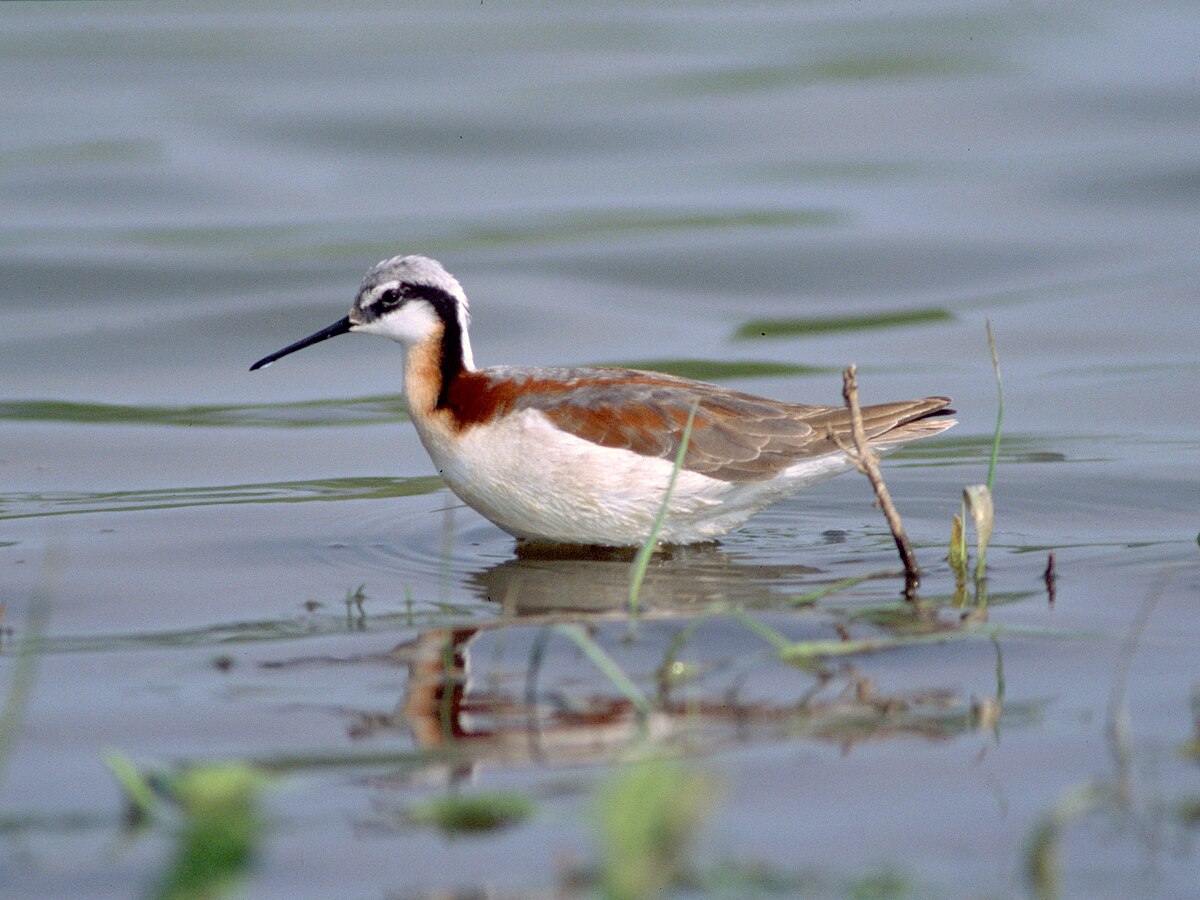
Wikipedia: Wilson's phalarope Quelle: OTHER
1200px-Phalaropus_tricolor_-_breeding_female.jpg
Dieser Vogel erscheint jenseits grossen Meere in Kontinenten :
Nordamerika, Südamerika, Afrika.
Allgemein: ![]() Der Wilson-Wassertreter (Steganopus tricolor, Syn.: Phalaropus tricolor) ist eine Vogelart aus der Familie der Schnepfenvögel. Die Erstbeschreibung stammt von Louis Pierre Vieillot und ist dem amerikanischen Ornithologen Alexander Wilson gewidmet.
[more]
Der Wilson-Wassertreter (Steganopus tricolor, Syn.: Phalaropus tricolor) ist eine Vogelart aus der Familie der Schnepfenvögel. Die Erstbeschreibung stammt von Louis Pierre Vieillot und ist dem amerikanischen Ornithologen Alexander Wilson gewidmet.
[more]
Odinshühnchen / Red-necked phalarope (Phalaropus lobatus)
Profil Wikipedia eBird Audubon AllAboutBirds Xeno-Canto NABU
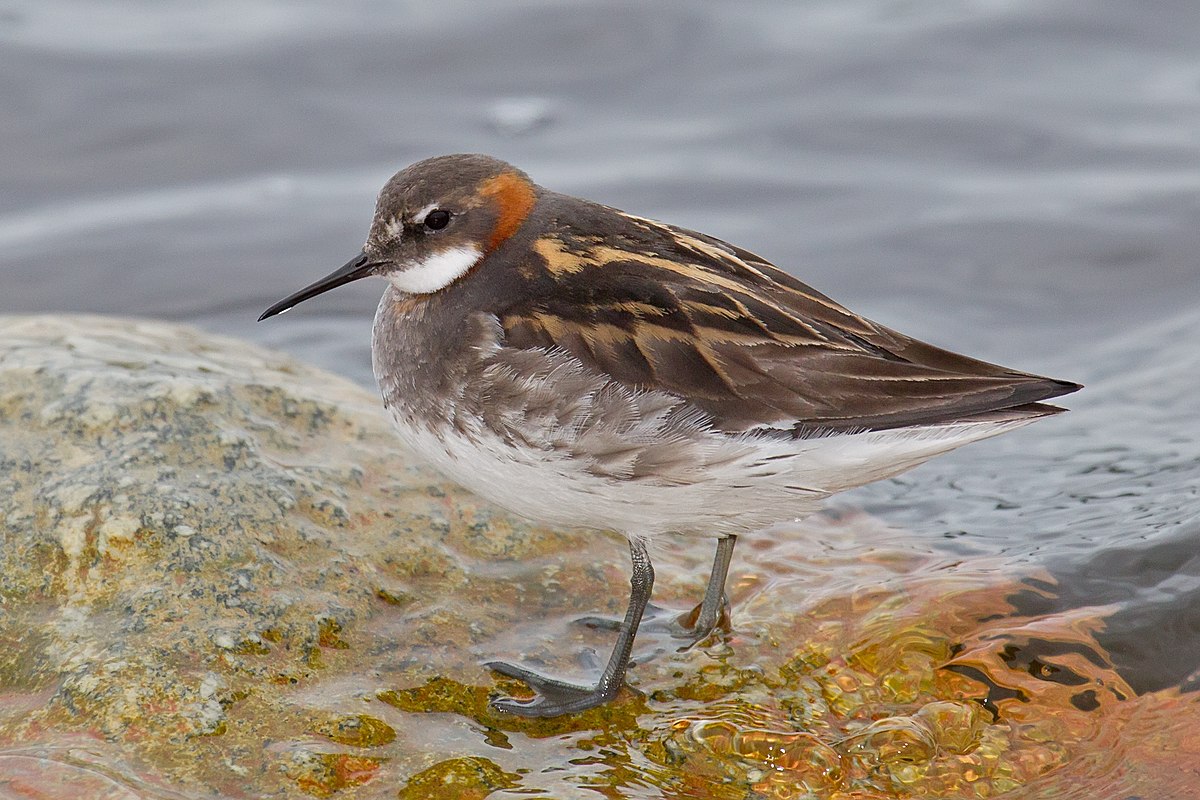
Wikipedia: Red-necked phalarope Quelle: OTHER
1200px-Red-necked_Phalarope.jpg
Dieser Vogel erscheint jenseits grossen Meere in Kontinenten :
Europa, Nordamerika, Südamerika, Afrika, Asien.
![]() Das Odinshühnchen (Phalaropus lobatus) ist eine Art aus der Gattung der Wassertreter. Es zählt zu den arktischen Schnepfenvögeln und kann gelegentlich während seiner Zugzeit in den Monaten August und September sowie April und Mai an der deutschen Nordseeküste beobachtet werden.
[more]
Das Odinshühnchen (Phalaropus lobatus) ist eine Art aus der Gattung der Wassertreter. Es zählt zu den arktischen Schnepfenvögeln und kann gelegentlich während seiner Zugzeit in den Monaten August und September sowie April und Mai an der deutschen Nordseeküste beobachtet werden.
[more]
Schwarznacken-Seeschwalbe / Black-naped tern (Sterna sumatrana)
Profil Wikipedia eBird Xeno-Canto
Wikipedia: Black-naped tern Quelle: OTHER
Black-naped_Tern_LEI.JPG
![]() Die Schwarznacken-Seeschwalbe (Sterna sumatrana) ist eine Seeschwalbenart die im Indischen Ozean, in Südostasien sowie im australo-pazifischen Raum verbreitet ist.
[more]
Die Schwarznacken-Seeschwalbe (Sterna sumatrana) ist eine Seeschwalbenart die im Indischen Ozean, in Südostasien sowie im australo-pazifischen Raum verbreitet ist.
[more]
Weißwangenseeschwalbe / White-cheeked tern (Sterna repressa)
Profil Wikipedia eBird Xeno-Canto

Wikipedia: White-cheeked tern Quelle: OTHER
1200px-White-cheeked_Tern.jpg
![]() Die Weißwangenseeschwalbe ist eine Vogelart aus der Familie der Seeschwalben (Sternidae).[1]
[more]
Die Weißwangenseeschwalbe ist eine Vogelart aus der Familie der Seeschwalben (Sternidae).[1]
[more]
Rosenseeschwalbe / Roseate tern (Sterna dougallii)
Profil Wikipedia eBird Audubon AllAboutBirds Xeno-Canto BirdID NABU

Wikipedia: Roseate tern Quelle: OTHER
1200px-Roseate_terns_Palometas.jpg
Dieser Vogel erscheint jenseits grossen Meere in Kontinenten :
Europa, Nordamerika, Afrika, Asien.
![]() Die Rosenseeschwalbe (Sterna dougallii) ist eine Vogelart aus der Familie der Seeschwalben (Sternidae). Sie ist in Mitteleuropa ein seltener Brut- bzw. Sommervogel.
[more]
Die Rosenseeschwalbe (Sterna dougallii) ist eine Vogelart aus der Familie der Seeschwalben (Sternidae). Sie ist in Mitteleuropa ein seltener Brut- bzw. Sommervogel.
[more]
Rufe: ![]() Extremely harsh calls. Like mix of Caspian and Arctic Tern. Very hard and raspy "kreeeet", harder and higher pitched than Caspian Tern, but equally harsh. Other calls include more Arctic/Common tern-like short "kek", and similar. [Link]
Extremely harsh calls. Like mix of Caspian and Arctic Tern. Very hard and raspy "kreeeet", harder and higher pitched than Caspian Tern, but equally harsh. Other calls include more Arctic/Common tern-like short "kek", and similar. [Link]
Körperlich: Länge=33-38 cm,
Flügelspanne=72-80 cm,
Gewicht=92-133 g
Kü̈stenseeschwalbe / Arctic tern (Sterna paradisaea)
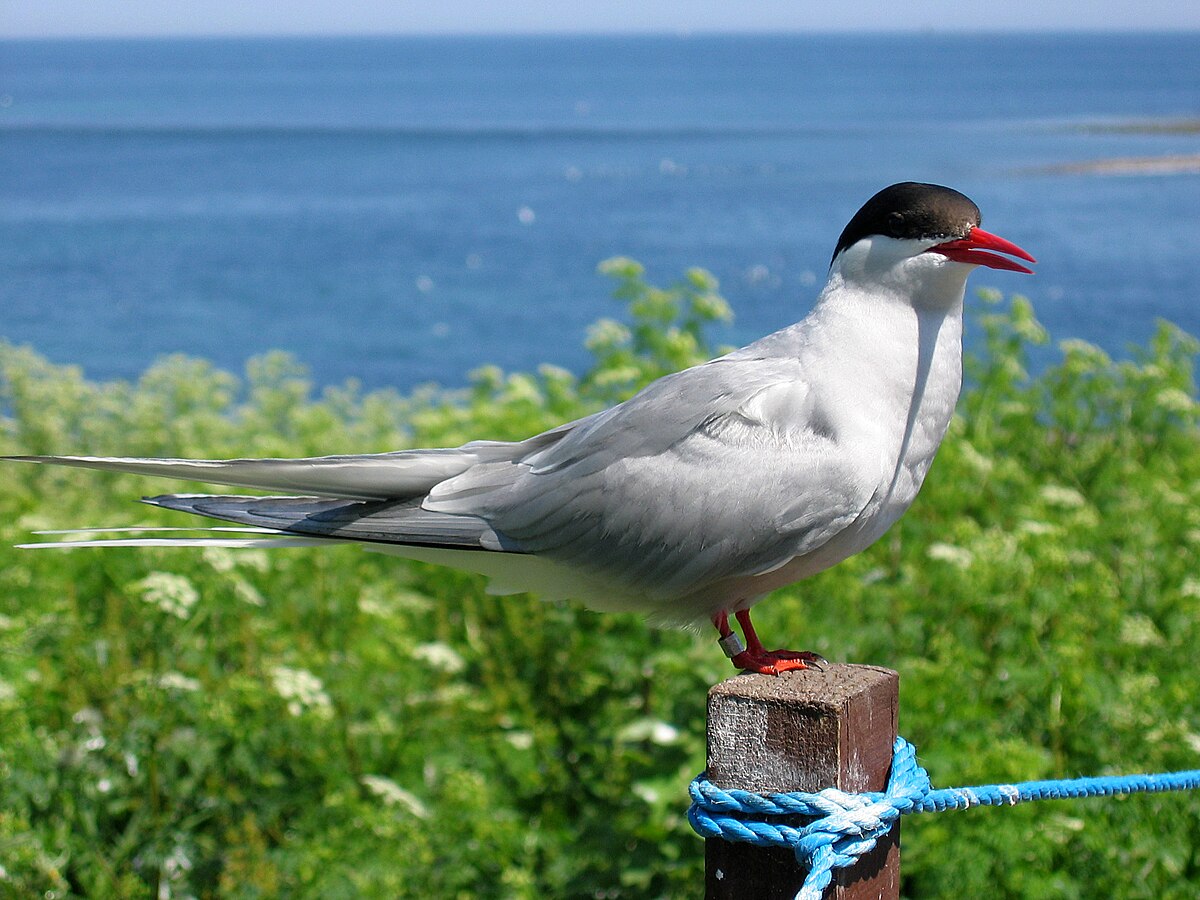
Wikipedia: Arctic tern Quelle: OTHER
1200px-2009_07_02_-_Arctic_tern_on_Farne_Islands_-_The_blue_rope_demarcates_the_visitors%27_path.JPG
Dieser Vogel erscheint jenseits grossen Meere in Kontinenten :
Europa, Nordamerika, Südamerika, Afrika.
Allgemein: ![]() The Arctic tern (Sterna paradisaea) is a tern in the family Laridae. This bird has a circumpolar breeding distribution covering the Arctic and sub-Arctic regions of Europe, Asia, and North America (as far south as Brittany and Massachusetts). The species is strongly migratory, seeing two summers each year as it migrates along a convoluted route from its northern breeding grounds to the Antarctic coast for the southern summer and back again about six months later. Recent studies have shown average annual roundtrip lengths of about 70,900 km (44,100 mi) for birds nesting in Iceland and Greenland[3] and about 90,000 km (56,000 mi) for birds nesting in the Netherlands.[4] These are by far the longest migrations known in the animal kingdom. The Arctic tern flies as well as glides through the air. It nests once every one to three years (depending on its mating cycle); once it has finished nesting it takes to the sky for another long southern migration.
[more]
The Arctic tern (Sterna paradisaea) is a tern in the family Laridae. This bird has a circumpolar breeding distribution covering the Arctic and sub-Arctic regions of Europe, Asia, and North America (as far south as Brittany and Massachusetts). The species is strongly migratory, seeing two summers each year as it migrates along a convoluted route from its northern breeding grounds to the Antarctic coast for the southern summer and back again about six months later. Recent studies have shown average annual roundtrip lengths of about 70,900 km (44,100 mi) for birds nesting in Iceland and Greenland[3] and about 90,000 km (56,000 mi) for birds nesting in the Netherlands.[4] These are by far the longest migrations known in the animal kingdom. The Arctic tern flies as well as glides through the air. It nests once every one to three years (depending on its mating cycle); once it has finished nesting it takes to the sky for another long southern migration.
[more]
Vokalisierung: ![]() Similar to Common Tern but higher pitched. [Link]
Similar to Common Tern but higher pitched. [Link]
Rufe: ![]() Typical call a series of high pitched "tip-tip-tip", and longer, ringing, high-pitched "kriiiiii" calls. The drawn out "kree-aaahh" call falls less distinctly in pitch than Common Tern. [Link]
Typical call a series of high pitched "tip-tip-tip", and longer, ringing, high-pitched "kriiiiii" calls. The drawn out "kree-aaahh" call falls less distinctly in pitch than Common Tern. [Link]
Körperlich: Länge=33-35 cm,
Flügelspanne=75-85 cm,
Gewicht=95-120 g
Sterna vittata / Antarctic tern (Sterna vittata)
Profil Wikipedia eBird Xeno-Canto

Wikipedia: Antarctic tern Quelle: OTHER
1200px-Sterna_vittata_-_Antarctica_I.jpg
Allgemein: ![]() The Antarctic tern (Sterna vittata) is a seabird in the family Laridae. It ranges throughout the southern oceans and is found on small islands around Antarctica as well as on the shores of the mainland. Its diet consists primarily of small fish and crustaceans. It is very similar in appearance to the closely related Arctic tern, but it is stockier, and it is in its breeding plumage in the southern summer, when the Arctic tern has shed old feathers to get its non-breeding plumage. The Antarctic tern does not migrate like the Arctic tern does, but it can still be found on a very large range. This tern species is actually more closely related to the South American tern.[2]
[more]
The Antarctic tern (Sterna vittata) is a seabird in the family Laridae. It ranges throughout the southern oceans and is found on small islands around Antarctica as well as on the shores of the mainland. Its diet consists primarily of small fish and crustaceans. It is very similar in appearance to the closely related Arctic tern, but it is stockier, and it is in its breeding plumage in the southern summer, when the Arctic tern has shed old feathers to get its non-breeding plumage. The Antarctic tern does not migrate like the Arctic tern does, but it can still be found on a very large range. This tern species is actually more closely related to the South American tern.[2]
[more]
Turnix nanus / Black-rumped buttonquail (Turnix nanus)
Profil Wikipedia eBird Xeno-Canto

Wikipedia: Black-rumped buttonquail Quelle: OTHER
1200px-TurnixNanaDavies.jpg
![]() The black-rumped buttonquail (Turnix nanus) is a small species of bird in the buttonquail genus.
[more]
The black-rumped buttonquail (Turnix nanus) is a small species of bird in the buttonquail genus.
[more]
Haematopus moquini / African oystercatcher (Haematopus moquini)
Wikipedia: African oystercatcher Quelle: OTHER
African_Black_Oystercatcher_%282%29.JPG
![]() The African oystercatcher or African black oystercatcher (Haematopus moquini), is a large charismatic wader resident to the mainland coasts and offshore islands of southern Africa. This near-threatened oystercatcher has a population of over 6,000 adults, which breed between November and April.[9] The scientific name moquini commemorates the French naturalist Alfred Moquin-Tandon who discovered and named this species before Bonaparte.[10]
[more]
The African oystercatcher or African black oystercatcher (Haematopus moquini), is a large charismatic wader resident to the mainland coasts and offshore islands of southern Africa. This near-threatened oystercatcher has a population of over 6,000 adults, which breed between November and April.[9] The scientific name moquini commemorates the French naturalist Alfred Moquin-Tandon who discovered and named this species before Bonaparte.[10]
[more]
Rotflügel-Brachschwalbe / Collared pratincole (Glareola pratincola)
Profil Wikipedia eBird Xeno-Canto BirdID NABU

Wikipedia: Collared pratincole Quelle: OTHER
1200px-Collared_pratincole_%28Glareola_pratincola%29.jpg
![]() Die Rotflügel-Brachschwalbe (Glareola pratincola) ist eine Art aus der Familie der Brachschwalbenartigen. Sie ist sehr lückenhaft von Afrika bis Asien verbreitet. In Mitteleuropa ist sie nur in Ungarn ein Brut- und Sommervogel, in anderen mitteleuropäischen Regionen ist sie ein nicht sehr häufiger Irrgast.[1]
[more]
Die Rotflügel-Brachschwalbe (Glareola pratincola) ist eine Art aus der Familie der Brachschwalbenartigen. Sie ist sehr lückenhaft von Afrika bis Asien verbreitet. In Mitteleuropa ist sie nur in Ungarn ein Brut- und Sommervogel, in anderen mitteleuropäischen Regionen ist sie ein nicht sehr häufiger Irrgast.[1]
[more]
Vokalisierung: ![]() Quite vocal. [Link]
Quite vocal. [Link]
Rufe: ![]() Nasal tern-like, far-carrying calls often betrays its presence before it is seen. Short and sharp "kiev" or "kip" frequently used. Most diagnostic call is a two-part, rolling "kivik-kirrrrrrr", with the latter part slightly descending. Easily confused with Black-winged Pratincole, but the hard parts are more resonant, and less clicking and staccato, while the more melodic components are less mewing. Also quite similar to Little Tern in timbre, but the two-part structure in the diagnostic call is different. [Link]
Nasal tern-like, far-carrying calls often betrays its presence before it is seen. Short and sharp "kiev" or "kip" frequently used. Most diagnostic call is a two-part, rolling "kivik-kirrrrrrr", with the latter part slightly descending. Easily confused with Black-winged Pratincole, but the hard parts are more resonant, and less clicking and staccato, while the more melodic components are less mewing. Also quite similar to Little Tern in timbre, but the two-part structure in the diagnostic call is different. [Link]
Körperlich: Länge=25 cm,
Flügelspanne=60-65 cm,
Gewicht=70-95 g
Halsband-Brachschwalbe / Rock pratincole (Glareola nuchalis)
Profil Wikipedia eBird Xeno-Canto

Wikipedia: Rock pratincole Quelle: OTHER
Rock_Pratincole_%28Glareola_nuchalis%29.jpg
Allgemein: ![]() Die Halsband-Brachschwalbe (Glareola nuchalis, Syn.: Galactochrysea liberiae, Galactochrysea emini) ist ein Vogel aus der Unterfamilie der Brachschwalbenartigen (Glareolidae).[1]
[more]
Die Halsband-Brachschwalbe (Glareola nuchalis, Syn.: Galactochrysea liberiae, Galactochrysea emini) ist ein Vogel aus der Unterfamilie der Brachschwalbenartigen (Glareolidae).[1]
[more]
Schwarzflügel-Brachschwalbe / Black-winged pratincole (Glareola nordmanni)
Profil Wikipedia eBird Xeno-Canto

Wikipedia: Black-winged pratincole Quelle: OTHER
Tyrkyshka.jpg
![]() Die Schwarzflügel-Brachschwalbe (Glareola nordmanni) ist eine Art aus der Unterfamilie der Brachschwalbenartigen (Glareolidae). Sie ist ein zentralasiatischer Brutvogel. In Mitteleuropa ist sie nur in Ungarn ein Brut- und Sommervogel, in anderen mitteleuropäischen Regionen ist sie ein nicht sehr häufiger Irrgast.[1]
[more]
Die Schwarzflügel-Brachschwalbe (Glareola nordmanni) ist eine Art aus der Unterfamilie der Brachschwalbenartigen (Glareolidae). Sie ist ein zentralasiatischer Brutvogel. In Mitteleuropa ist sie nur in Ungarn ein Brut- und Sommervogel, in anderen mitteleuropäischen Regionen ist sie ein nicht sehr häufiger Irrgast.[1]
[more]
Cursorius rufus / Burchell's courser (Cursorius rufus)
Profil Wikipedia eBird Xeno-Canto

Wikipedia: Burchell's courser Quelle: OTHER
Cursorius_rufus00a.jpg
![]() Burchell's courser (Cursorius rufus) is a wader in the pratincole and courser family, Glareolidae.[2] The name of this bird commemorates the English naturalist William John Burchell.[3]
[more]
Burchell's courser (Cursorius rufus) is a wader in the pratincole and courser family, Glareolidae.[2] The name of this bird commemorates the English naturalist William John Burchell.[3]
[more]
Cursorius temminckii / Temminck's courser (Cursorius temminckii)
Profil Wikipedia eBird Xeno-Canto

Wikipedia: Temminck's courser Quelle: OTHER
1200px-Temminck%27s_courser_-_Cursorius_temminckii.jpg
![]() Temminck's courser (Cursorius temminckii) is a bird in the pratincole and courser family, Glareolidae. It is a wader which lives in sub-Saharan Africa. It is noted for laying its dark colored ash-black eggs in the burnt bushes and grass of the African savannah.[2][3][4]
[more]
Temminck's courser (Cursorius temminckii) is a bird in the pratincole and courser family, Glareolidae. It is a wader which lives in sub-Saharan Africa. It is noted for laying its dark colored ash-black eggs in the burnt bushes and grass of the African savannah.[2][3][4]
[more]
Rhinoptilus chalcopterus / Bronze-winged courser (Rhinoptilus chalcopterus)
Profil Wikipedia eBird Xeno-Canto

Wikipedia: Bronze-winged courser Quelle: OTHER
1200px-Bronze-winged_Courser_%28Rhinoptilus_chalcopterus%29_%2813950665425%29.jpg
![]() The bronze-winged courser or violet-tipped courser (Rhinoptilus chalcopterus) is a species of bird in the family Glareolidae. It is found throughout Sub-Saharan Africa.
[more]
The bronze-winged courser or violet-tipped courser (Rhinoptilus chalcopterus) is a species of bird in the family Glareolidae. It is found throughout Sub-Saharan Africa.
[more]
Rhinoptilus cinctus / Three-banded courser (Rhinoptilus cinctus)
Profil Wikipedia eBird Xeno-Canto

Wikipedia: Three-banded courser Quelle: OTHER
Three-banded_%28_Heuglin%27s_%29_Courser.jpg
![]() The three-banded courser (Rhinoptilus cinctus) is a species of bird in the family Glareolidae.
It is found in Angola, Botswana, Ethiopia, Kenya, Namibia, Rwanda, Somalia, Somaliland, South Africa, South Sudan, Tanzania, Uganda, Zambia, and Zimbabwe.
[more]
The three-banded courser (Rhinoptilus cinctus) is a species of bird in the family Glareolidae.
It is found in Angola, Botswana, Ethiopia, Kenya, Namibia, Rwanda, Somalia, Somaliland, South Africa, South Sudan, Tanzania, Uganda, Zambia, and Zimbabwe.
[more]
Südpolarskua / South polar skua (Stercorarius maccormicki)

Wikipedia: South polar skua Quelle: OTHER
1200px-South_polar_skua.jpg
Dieser Vogel erscheint jenseits grossen Meere in Kontinenten :
Nordamerika, Afrika.
![]() Die Südpolarskua (Stercorarius maccormicki, Syn.: Catharacta maccormicki), auch Antarktikskua genannt, ist eine Vogelart aus der Familie der Raubmöwen (Stercorariidae).
[more]
Die Südpolarskua (Stercorarius maccormicki, Syn.: Catharacta maccormicki), auch Antarktikskua genannt, ist eine Vogelart aus der Familie der Raubmöwen (Stercorariidae).
[more]
Spatelraubmöwe / Pomarine jaeger (Stercorarius pomarinus)
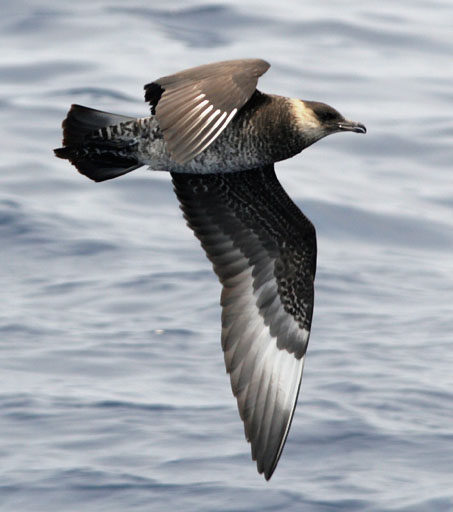
Wikipedia: Pomarine jaeger Quelle: OTHER
Stercorarius_pomarinusPCCA20070623-3985B.jpg
Dieser Vogel erscheint jenseits grossen Meere in Kontinenten :
Europa, Nordamerika, Südamerika, Afrika, Asien.
![]() Die Spatelraubmöwe (Stercorarius pomarinus) ist eine Vogelart aus der Familie der Raubmöwen (Stercorariidae). Sie brütet in der arktischen Tundra rund um den Nordpol und ist dort ein hochspezialisierter Jäger von Lemmingen. Außerhalb der Brutzeit leben Spatelraubmöwen auf hoher See, sie überwintern auf den Meeren der Tropen und Subtropen. Die Art ist regelmäßiger Durchzügler an der Nordseeküste, im Binnenland Europas wird sie nur sehr selten beobachtet.
[more]
Die Spatelraubmöwe (Stercorarius pomarinus) ist eine Vogelart aus der Familie der Raubmöwen (Stercorariidae). Sie brütet in der arktischen Tundra rund um den Nordpol und ist dort ein hochspezialisierter Jäger von Lemmingen. Außerhalb der Brutzeit leben Spatelraubmöwen auf hoher See, sie überwintern auf den Meeren der Tropen und Subtropen. Die Art ist regelmäßiger Durchzügler an der Nordseeküste, im Binnenland Europas wird sie nur sehr selten beobachtet.
[more]
Rufe: ![]() Short "kea" or "ke", and various mewing calls, usually deeper pitched than Arctic Skua. Also a characteristic, laughing and vibrating "kayayayayaya", heard mostly on breeding ground. [Link]
Short "kea" or "ke", and various mewing calls, usually deeper pitched than Arctic Skua. Also a characteristic, laughing and vibrating "kayayayayaya", heard mostly on breeding ground. [Link]
Körperlich: Länge=46-51 cm,
Flügelspanne=125-138 cm,
Gewicht=600-900 g
Falkenraubmöwe / Long-tailed jaeger (Stercorarius longicaudus)

Wikipedia: Long-tailed jaeger Quelle: OTHER
1200px-Long-tailed_Skua_%28js%29_26.jpg
Dieser Vogel erscheint jenseits grossen Meere in Kontinenten :
Europa, Nordamerika, Afrika, Asien.
Allgemein: ![]() Die Falkenraubmöwe (Stercorarius longicaudus) ist eine Art in der Familie der Raubmöwen. Es werden zwei Unterarten unterschieden. In Mitteleuropa findet sie sich seltener als die Schmarotzerraubmöwe und die Spatelraubmöwe ein. In Belgien wurden jedoch allein zwischen 1991 und 1996 432 Individuen dieser Art beobachtet.[1]
[more]
Die Falkenraubmöwe (Stercorarius longicaudus) ist eine Art in der Familie der Raubmöwen. Es werden zwei Unterarten unterschieden. In Mitteleuropa findet sie sich seltener als die Schmarotzerraubmöwe und die Spatelraubmöwe ein. In Belgien wurden jedoch allein zwischen 1991 und 1996 432 Individuen dieser Art beobachtet.[1]
[more]
Stercorarius antarcticus / Southern skua (Stercorarius antarcticus)
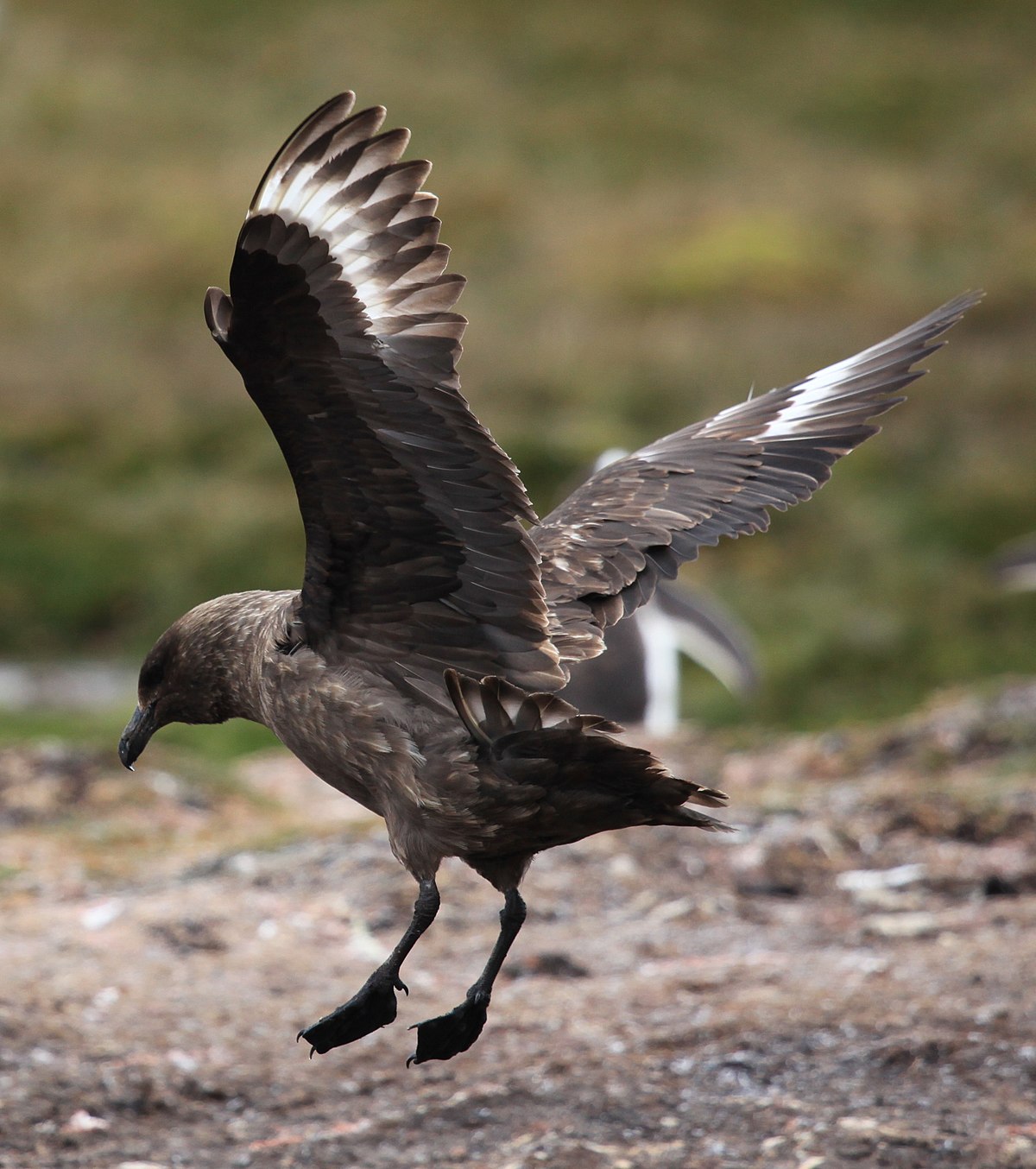
Wikipedia: Southern skua Quelle: OTHER
1200px-Stercorarius_antarcticus_-Godthul%2C_South_Georgia%2C_British_Overseas_Territories%2C_UK_-landing-8.jpg
![]() The brown skua (Stercorarius antarcticus), also known as the Antarctic skua, subantarctic skua, southern great skua, southern skua, or hākoakoa (Māori), is a large seabird that breeds in the subantarctic and Antarctic zones and moves further north when not breeding. Its taxonomy is highly complex and a matter of dispute, with some splitting it into two or three species: Falkland skua (S. antarcticus), Tristan skua (S. hamiltoni), and subantarctic skua (S. lönnbergi). To further confuse, it hybridizes with both the south polar and Chilean skuas, and the entire group has been considered to be a subspecies of the great skua, a species otherwise restricted to the Northern Hemisphere.
[more]
The brown skua (Stercorarius antarcticus), also known as the Antarctic skua, subantarctic skua, southern great skua, southern skua, or hākoakoa (Māori), is a large seabird that breeds in the subantarctic and Antarctic zones and moves further north when not breeding. Its taxonomy is highly complex and a matter of dispute, with some splitting it into two or three species: Falkland skua (S. antarcticus), Tristan skua (S. hamiltoni), and subantarctic skua (S. lönnbergi). To further confuse, it hybridizes with both the south polar and Chilean skuas, and the entire group has been considered to be a subspecies of the great skua, a species otherwise restricted to the Northern Hemisphere.
[more]
Schmarotzerraubmöwe / Parasitic jaeger (Stercorarius parasiticus)
Our guide raises his arm, which results in the Arctic Skua keeping a safe distance. 2015-06-10 15.13.04 Iceland
Zuerst beobachtet in Iceland an 2015-06-10.
Dieser Vogel erscheint jenseits grossen Meere in Kontinenten :
Europa, Nordamerika, Südamerika, Afrika, Asien.
![]() Die Schmarotzerraubmöwe (Stercorarius parasiticus) ist ein Meeresvogel aus der Familie Stercorariidae. Die zirkumpolar in den Tundren und Küstensümpfen Eurasiens und Nordamerikas brütende Art ist unter den Raubmöwen die häufigste Art, die in Mitteleuropa während der Zugzeiten an den Küsten beobachtet werden kann.[1]
[more]
Die Schmarotzerraubmöwe (Stercorarius parasiticus) ist ein Meeresvogel aus der Familie Stercorariidae. Die zirkumpolar in den Tundren und Küstensümpfen Eurasiens und Nordamerikas brütende Art ist unter den Raubmöwen die häufigste Art, die in Mitteleuropa während der Zugzeiten an den Küsten beobachtet werden kann.[1]
[more]
Vokalisierung: ![]() Mostly heard at breeding ground. [Link]
Mostly heard at breeding ground. [Link]
Rufe: ![]() Most characteristic call is a mewing, kittiwake-like "aeeeee-ah". First syllable drawn-out and rising in pitch, and followed by a deeper conclusive second syllable "ah". Lacks the introductory double accent of Kittiwakes ("kitti-wake"). [Link]
Most characteristic call is a mewing, kittiwake-like "aeeeee-ah". First syllable drawn-out and rising in pitch, and followed by a deeper conclusive second syllable "ah". Lacks the introductory double accent of Kittiwakes ("kitti-wake"). [Link]
Körperlich: Länge=41-46 cm,
Flügelspanne=110-125 cm,
Gewicht=330-570 g
Blaustirn-Blatthühnchen / African jacana (Actophilornis africanus)

Wikipedia: African jacana Quelle: OTHER
1200px-African_jacana_%28Actophilornis_africanus%29_Kenya.jpg
Allgemein: ![]() Das Blaustirn-Blatthühnchen (Actophilornis africanus) ist ein afrikanischer Vogel aus der Ordnung der Regenpfeiferartigen (Charadriiformes). Es ist ein Standvogel, das bei ungünstigen Wasserständen aber auch weiträumig nomadisiert.[1]
[more]
Das Blaustirn-Blatthühnchen (Actophilornis africanus) ist ein afrikanischer Vogel aus der Ordnung der Regenpfeiferartigen (Charadriiformes). Es ist ein Standvogel, das bei ungünstigen Wasserständen aber auch weiträumig nomadisiert.[1]
[more]
Microparra capensis / Lesser jacana (Microparra capensis)
Profil Wikipedia eBird Xeno-Canto

Wikipedia: Lesser jacana Quelle: OTHER
1200px-Lesser_Jacana%2C_Microparra_capensis%2C_Chobe_River%2C_Botswana.jpg
![]() The lesser jacana (Microparra capensis) is a species of bird in the family Jacanidae. It is monotypic within the genus Microparra.[2]
[more]
The lesser jacana (Microparra capensis) is a species of bird in the family Jacanidae. It is monotypic within the genus Microparra.[2]
[more]
Familie Burhinidae (Triele, Haematopodidae – Austernfischer und Recurvirostridae – Säbelschnäblerverwandte):
Burhinus capensis / Spotted thick-knee (Burhinus capensis)

Wikipedia: Spotted thick-knee Quelle: OTHER
1200px-Dikkop_-_Burhinus_capensis%2C_crop.jpg
![]() The spotted thick-knee (Burhinus capensis), also known as the spotted dikkop or Cape thick-knee, is a wader in the family Burhinidae. It is native to tropical regions of central and southern Africa.
[more]
The spotted thick-knee (Burhinus capensis), also known as the spotted dikkop or Cape thick-knee, is a wader in the family Burhinidae. It is native to tropical regions of central and southern Africa.
[more]
Burhinus vermiculatus / Water thick-knee (Burhinus vermiculatus)

Wikipedia: Water thick-knee Quelle: OTHER
1200px-Water_Thick-knee_%28Burhinus_vermiculatus%29_close-up_%2816608927739%29.jpg
![]() The water thick-knee (Burhinus vermiculatus), or water dikkop is a species of bird in the thick-knee family Burhinidae. The species is found across sub-Saharan Africa, usually close to water.
[more]
The water thick-knee (Burhinus vermiculatus), or water dikkop is a species of bird in the thick-knee family Burhinidae. The species is found across sub-Saharan Africa, usually close to water.
[more]
Bunt-Goldschnepfe / Greater painted-snipe (Rostratula benghalensis)
Profil Wikipedia eBird Xeno-Canto NABU

Wikipedia: Greater painted-snipe Quelle: OTHER
Greater_Painted-snipe_%28Female%29_I2_IMG_9477.jpg
![]() Die Bunt-Goldschnepfe (Rostratula benghalensis) oder kurz Buntschnepfe ist eine von zwei Arten aus der Familie der Goldschnepfen. Sie ist in Afrika, Asien und Australien verbreitet und gehört zu den wenigen Vögeln, bei denen die Weibchen dominant sind und die Männchen die Aufgaben von Brutgeschäft und Jungenaufzucht übernehmen.
[more]
Die Bunt-Goldschnepfe (Rostratula benghalensis) oder kurz Buntschnepfe ist eine von zwei Arten aus der Familie der Goldschnepfen. Sie ist in Afrika, Asien und Australien verbreitet und gehört zu den wenigen Vögeln, bei denen die Weibchen dominant sind und die Männchen die Aufgaben von Brutgeschäft und Jungenaufzucht übernehmen.
[more]
Chionis albus / Snowy sheathbill (Chionis albus)

Wikipedia: Snowy sheathbill Quelle: OTHER
Chionis_blanc_-_Pale-faced_Sheathbill.jpg
![]() The snowy sheathbill (Chionis albus), also known as the greater sheathbill, pale-faced sheathbill, and paddy, is one of two species of sheathbill. It is usually found on the ground. It is the only land bird native to the Antarctic continent.[3]
[more]
The snowy sheathbill (Chionis albus), also known as the greater sheathbill, pale-faced sheathbill, and paddy, is one of two species of sheathbill. It is usually found on the ground. It is the only land bird native to the Antarctic continent.[3]
[more]
Säbelschnäbler / Pied avocet (Recurvirostra avosetta)
Profil Wikipedia eBird Vogelwarte BirdLife ZH ornitho.ch Xeno-Canto BirdID NABU
Saebelschnaebler bei Ses Salines. 2022-04-08 17.01.38 Mallorca
Zuerst beobachtet in Mallorca an 2022-04-08.
![]() Der Säbelschnäbler (Recurvirostra avosetta) ist eine Vogelart aus der Familie der Säbelschnäbler (Recurvirostridae). Mit seinem schwarzweißen Gefieder zählt er zu den auffallendsten Limikolen. Im Wattenmeer der Nordsee ist er ein häufig zu beobachtender Vogel.
[more]
Der Säbelschnäbler (Recurvirostra avosetta) ist eine Vogelart aus der Familie der Säbelschnäbler (Recurvirostridae). Mit seinem schwarzweißen Gefieder zählt er zu den auffallendsten Limikolen. Im Wattenmeer der Nordsee ist er ein häufig zu beobachtender Vogel.
[more]
Vokalisierung: ![]() Not very vocal away from breeding ground. [Link]
Not very vocal away from breeding ground. [Link]
Rufe: ![]() Most common contact call a soft, short "kluitt" reminiscent of Ringed Plover, but harder and less varied. Also sometimes followed by repeated chattering: "kluitt-trt-trt-trt-trt-trt-trt". [Link]
Most common contact call a soft, short "kluitt" reminiscent of Ringed Plover, but harder and less varied. Also sometimes followed by repeated chattering: "kluitt-trt-trt-trt-trt-trt-trt". [Link]
Körperlich: Länge=42-45 cm,
Flügelspanne=77-80 cm,
Gewicht=260-290 g
Habitate:
Nassgebiet
Gesang:
Automatically generated from Xeno-Canto recording
Gesang Eigenschaften:
Frequency:
♫ Quelle: BirdNet
20220408_171858 birdnet - Säbelschnäbler - Säbelschnäbler - Campos.mp3
2022-04-08 17.18.58 Mallorca (Gesang)
Stelzenläufer / Black-winged stilt (Himantopus himantopus)
Profil Wikipedia eBird Vogelwarte BirdLife ZH ornitho.ch Xeno-Canto NABU
Black winged stilt. 2024-02-24 09.29.24 Laos
Zuerst beobachtet in Mallorca an 2022-04-12.
Allgemein: ![]() Der Stelzenläufer (Himantopus himantopus) ist eine Vogelart aus der Familie der Säbelschnäbler (Recurvirostridae). In Mitteleuropa ist der Stelzenläufer auf Grund großräumiger Ortswechsel ein vereinzelter und unregelmäßiger Sommergast und gelegentlich auch Brutvogel. Den höchsten mitteleuropäischen Brutbestand gibt es in der ungarischen Tiefebene mit bis zu 400 Brutpaaren.[1] Zu Beginn der 1990er Jahre siedelten sich Stelzenläufer auch wieder am Neusiedlersee an, wo der Bestand 1860 erloschen war.[2]
[more]
Der Stelzenläufer (Himantopus himantopus) ist eine Vogelart aus der Familie der Säbelschnäbler (Recurvirostridae). In Mitteleuropa ist der Stelzenläufer auf Grund großräumiger Ortswechsel ein vereinzelter und unregelmäßiger Sommergast und gelegentlich auch Brutvogel. Den höchsten mitteleuropäischen Brutbestand gibt es in der ungarischen Tiefebene mit bis zu 400 Brutpaaren.[1] Zu Beginn der 1990er Jahre siedelten sich Stelzenläufer auch wieder am Neusiedlersee an, wo der Bestand 1860 erloschen war.[2]
[more]
Habitate:
Nassgebiet
Ruf:
Automatically generated from Xeno-Canto recording
♫ XC863470 - Black-winged Stilt - Himantopus himantopus - flight call, a squeaky yapping - Camargue, France. Quelle: XENOCANTO
XC863470 - Black-winged Stilt - Himantopus himantopus - flight call, a squeaky yapping - Camargue, France.mp3
(Flugruf)

Ruf Eigenschaften:
Flugruf Frequenz: ,
Dromas ardeola / Crab-plover (Dromas ardeola)
Profil Wikipedia eBird Xeno-Canto

Wikipedia: Crab-plover Quelle: OTHER
Reiherl%C3%A4ufer.jpg
![]() The crab-plover or crab plover (Dromas ardeola) is a bird related to the waders, but sufficiently distinctive to merit its own family Dromadidae. Its relationship within the Charadriiformes is unclear, some have considered it to be closely related to the thick-knees, or the pratincoles, while others have considered it closer to the auks and gulls. It is the only member of the genus Dromas and is unique among waders in making use of ground warmth to aid incubation of the eggs.
[more]
The crab-plover or crab plover (Dromas ardeola) is a bird related to the waders, but sufficiently distinctive to merit its own family Dromadidae. Its relationship within the Charadriiformes is unclear, some have considered it to be closely related to the thick-knees, or the pratincoles, while others have considered it closer to the auks and gulls. It is the only member of the genus Dromas and is unique among waders in making use of ground warmth to aid incubation of the eggs.
[more]
Fulica cristata / Red-knobbed coot (Fulica cristata)
Profil Wikipedia eBird Xeno-Canto NABU

Wikipedia: Red-knobbed coot Quelle: OTHER
1200px-Fulica_cristata_-Cape_Town%2C_South_Africa_-adult-8.jpg
![]() The red-knobbed coot or crested coot, (Fulica cristata), is a member of the rail and crake bird family, the Rallidae.
[more]
The red-knobbed coot or crested coot, (Fulica cristata), is a member of the rail and crake bird family, the Rallidae.
[more]
Rallus caerulescens / Kaffir rail (Rallus caerulescens)

Wikipedia: Kaffir rail Quelle: OTHER
African_Rail_%28Rallus_caerulescens%29.jpg
![]() The African rail (Rallus caerulescens) is a small wetland bird of the rail family.
[more]
The African rail (Rallus caerulescens) is a small wetland bird of the rail family.
[more]
Porphyrio madagascariensis / African swamphen (Porphyrio madagascariensis)

Wikipedia: African swamphen Quelle: OTHER
1200px-African_Purple_Swamphen.jpg
![]() The African swamphen (Porphyrio madagascariensis) is a species of swamphen occurring in Egypt, Sub-Saharan Africa and Madagascar. It used to be considered a subspecies of the purple swamphen, which it resembles, but with bronze green or green-blue back and scapulars.
[more]
The African swamphen (Porphyrio madagascariensis) is a species of swamphen occurring in Egypt, Sub-Saharan Africa and Madagascar. It used to be considered a subspecies of the purple swamphen, which it resembles, but with bronze green or green-blue back and scapulars.
[more]
Bronzesultanshuhn / Allen's gallinule (Porphyrio alleni)

Wikipedia: Allen's gallinule Quelle: OTHER
Porphyrio_alleni_Martien_Brand.jpg
![]() Das Bronzesultanshuhn (Porphyrio alleni), auch Afrikanisches Sultanshuhn genannt, ist eine afrikanische Vogelart aus der Familie der Rallenvögel. In der Westpaläarktis ist es ein sehr seltener Irrgast.[1]
[more]
Das Bronzesultanshuhn (Porphyrio alleni), auch Afrikanisches Sultanshuhn genannt, ist eine afrikanische Vogelart aus der Familie der Rallenvögel. In der Westpaläarktis ist es ein sehr seltener Irrgast.[1]
[more]
Kleinsumpfhuhn / Little crake (Zapornia parva)
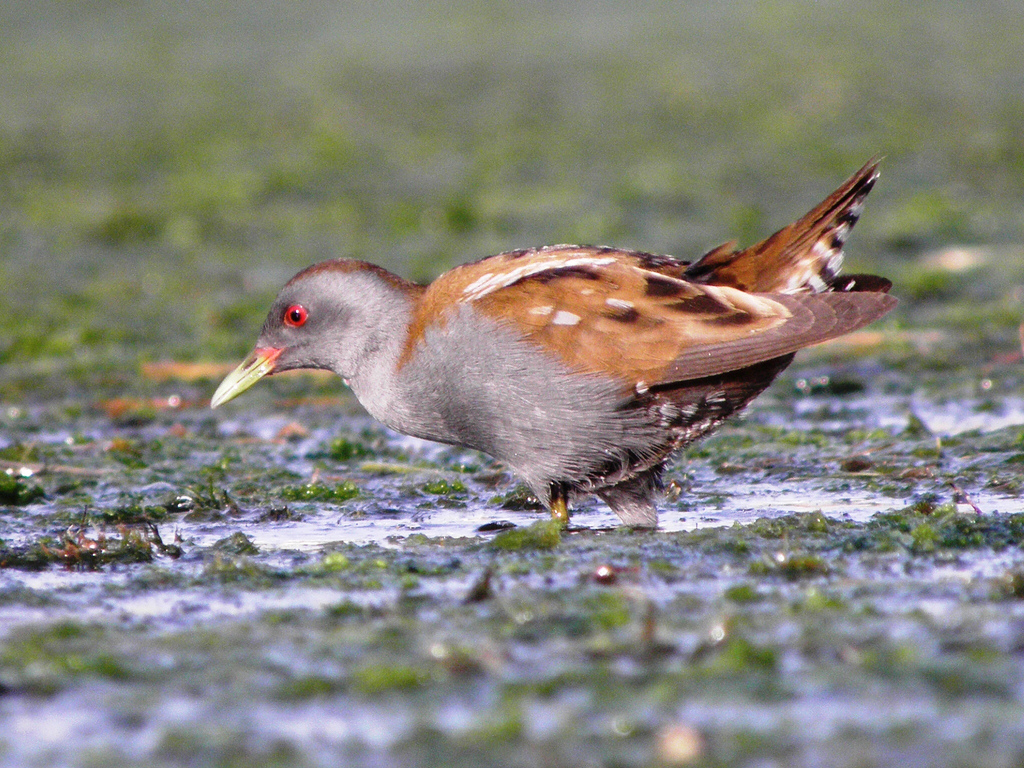
Wikipedia: Little crake Quelle: OTHER
Porzana_parva_%2850%29.jpg
![]() Das Kleinsumpfhuhn (Zapornia parva, Syn.: Porzana parva), auch Kleines Sumpfhuhn oder Kleinralle genannt, ist eine in Eurasien beheimatete Vogelart aus der Gattung Zapornia in der Familie der Rallen (Rallidae). Im Osten Mitteleuropas ist das Kleine Sumpfhuhn ein verbreiteter Brut- und Sommervogel. In Deutschland, den Niederlanden, der Schweiz und Tschechien gibt es dagegen nur lokal vereinzelte Brutvorkommen.
[more]
Das Kleinsumpfhuhn (Zapornia parva, Syn.: Porzana parva), auch Kleines Sumpfhuhn oder Kleinralle genannt, ist eine in Eurasien beheimatete Vogelart aus der Gattung Zapornia in der Familie der Rallen (Rallidae). Im Osten Mitteleuropas ist das Kleine Sumpfhuhn ein verbreiteter Brut- und Sommervogel. In Deutschland, den Niederlanden, der Schweiz und Tschechien gibt es dagegen nur lokal vereinzelte Brutvorkommen.
[more]
Gesang: ![]() Male song diagnostic. A loud series of short, nasal ascending "quek" repeated every one and a half seconds or so, before accelerating and descending at the same time to a more guttural voice. Female song with similar short "quek" but with less pure tone and in shorter series (sometimes just one call), immediately followed by a rolling trill. [Link]
Male song diagnostic. A loud series of short, nasal ascending "quek" repeated every one and a half seconds or so, before accelerating and descending at the same time to a more guttural voice. Female song with similar short "quek" but with less pure tone and in shorter series (sometimes just one call), immediately followed by a rolling trill. [Link]
Rufe: ![]() Rich repertoire of calls used freely in breeding season. [Link]
Rich repertoire of calls used freely in breeding season. [Link]
Körperlich: Länge=18-20 cm,
Flügelspanne=34-39 cm,
Gewicht=40-60 g
Habitate:
Nassgebiet
Tüpfelsumpfhuhn / Spotted crake (Porzana porzana)
Profil Wikipedia eBird Vogelwarte BirdLife ZH ornitho.ch Xeno-Canto BirdID NABU

Wikipedia: Spotted crake Quelle: OTHER
Porzana_porzana_6_%28Marek_Szczepanek%29.jpg
Allgemein: ![]() Das Tüpfelsumpfhuhn (Porzana porzana) ist ein Vogel aus der Familie der Rallenvögel. Es ist kleiner als eine Wasserralle und hat etwa die Größe einer Drossel.
[more]
Das Tüpfelsumpfhuhn (Porzana porzana) ist ein Vogel aus der Familie der Rallenvögel. Es ist kleiner als eine Wasserralle und hat etwa die Größe einer Drossel.
[more]
Gesang: ![]() Loud and far reaching song uttered with relentless stamina for hours on end. A monosyllabic, resonant and drawn-out "huiiit". [Link]
Loud and far reaching song uttered with relentless stamina for hours on end. A monosyllabic, resonant and drawn-out "huiiit". [Link]
Rufe: ![]() The pith rises towards the emphasized end of the call, which is repeated about once a second. Often compared to the dripping of water. Mostly heard at night, and often i duet with mate. The female answers the male with a slightly deeper and softer call, giving the impression of one bird giving a disyllabic call. [Link]
The pith rises towards the emphasized end of the call, which is repeated about once a second. Often compared to the dripping of water. Mostly heard at night, and often i duet with mate. The female answers the male with a slightly deeper and softer call, giving the impression of one bird giving a disyllabic call. [Link]
Körperlich: Länge=22-24 cm,
Flügelspanne=37-42 cm,
Gewicht=70-110 g
Habitate:
Nassgebiet
Amaurornis marginalis / Striped crake (Amaurornis marginalis)
Profil Wikipedia eBird Xeno-Canto

Wikipedia: Striped crake Quelle: OTHER
Aenigmatolimnas_marginalis%2C_Kgomo-kgomo-vleiland%2C_Birding_Weto%2C_a.jpg
Allgemein: ![]() The striped crake (Aenigmatolimnas marginalis) is a species of bird in the family Rallidae. It is the only species in the genus Aenigmatolimnas, having formerly been included in Porzana or in the defunct genus Poliolimnas. Its precise relationships, however, are still enigmatic.
[more]
The striped crake (Aenigmatolimnas marginalis) is a species of bird in the family Rallidae. It is the only species in the genus Aenigmatolimnas, having formerly been included in Porzana or in the defunct genus Poliolimnas. Its precise relationships, however, are still enigmatic.
[more]
Sarothrura affinis / Striped flufftail (Sarothrura affinis)
Profil Wikipedia eBird Xeno-Canto

Wikipedia: Striped flufftail Quelle: OTHER
1200px-Sarothrura_affinis_affinis_1838.jpg
![]() The striped flufftail (Sarothrura affinis) is a species of bird in the flufftail family Sarothruridae. It is also known as the red-tailed flufftail. The species is closely related to the Madagascar flufftail.
The species has a disjunct distribution across the Afromontane of southeastern Africa, with two subspecies. The nominate subspecies S. a. affinis is found in eastern South Africa and Swaziland. S. a. antonii, named for German ornithologist Anton Reichenow, is found in eastern Zimbabwe and Mozambique, Malawi, southern Tanzania, Kenya and the south of South Sudan.[2]
[more]
The striped flufftail (Sarothrura affinis) is a species of bird in the flufftail family Sarothruridae. It is also known as the red-tailed flufftail. The species is closely related to the Madagascar flufftail.
The species has a disjunct distribution across the Afromontane of southeastern Africa, with two subspecies. The nominate subspecies S. a. affinis is found in eastern South Africa and Swaziland. S. a. antonii, named for German ornithologist Anton Reichenow, is found in eastern Zimbabwe and Mozambique, Malawi, southern Tanzania, Kenya and the south of South Sudan.[2]
[more]
Sarothrura rufa / Red-chested flufftail (Sarothrura rufa)
Profil Wikipedia eBird Xeno-Canto

Wikipedia: Red-chested flufftail Quelle: OTHER
1200px-Sarothrura_rufa_rufa_1838.jpg
![]() The red-chested flufftail (Sarothrura rufa) is a species of bird in the family Sarothruridae.
It is found in sub-Saharan Africa from Liberia to Ethiopia and south to South Africa.
[more]
The red-chested flufftail (Sarothrura rufa) is a species of bird in the family Sarothruridae.
It is found in sub-Saharan Africa from Liberia to Ethiopia and south to South Africa.
[more]
Sarothrura ayresi / White-winged flufftail (Sarothrura ayresi)

Wikipedia: White-winged flufftail Quelle: OTHER
White-winged_Flufftail%2C_Middelpunt.jpg
![]() The white-winged flufftail (Sarothrura ayresi) is a very rare African bird in the family Sarothruridae. Its scientific name honours South African ornithologist Thomas Ayres, who discovered it at Potchefstroom.[n 1]
[more]
The white-winged flufftail (Sarothrura ayresi) is a very rare African bird in the family Sarothruridae. Its scientific name honours South African ornithologist Thomas Ayres, who discovered it at Potchefstroom.[n 1]
[more]
Sarothrura elegans / Buff-spotted flufftail (Sarothrura elegans)
Profil Wikipedia eBird Xeno-Canto

Wikipedia: Buff-spotted flufftail Quelle: OTHER
1200px-Male_Buff-spotted_Flufftail_in_Pigeon_Valley%2C_Durban%2C_South_Africa%2C_on_26_Jan_2014.jpg
![]() The buff-spotted flufftail (Sarothrura elegans) is a species of bird in the family Sarothruridae.
It is found in Angola, Botswana, Burundi, Cameroon, Republic of the Congo, Democratic Republic of the Congo, Ivory Coast, Equatorial Guinea, Ethiopia, Gabon, Guinea, Kenya, Liberia, Malawi, Mozambique, Nigeria, Rwanda, Sierra Leone, Somalia, South Africa, South Sudan, Swaziland, Tanzania, Uganda, Zambia, and Zimbabwe.
[more]
The buff-spotted flufftail (Sarothrura elegans) is a species of bird in the family Sarothruridae.
It is found in Angola, Botswana, Burundi, Cameroon, Republic of the Congo, Democratic Republic of the Congo, Ivory Coast, Equatorial Guinea, Ethiopia, Gabon, Guinea, Kenya, Liberia, Malawi, Mozambique, Nigeria, Rwanda, Sierra Leone, Somalia, South Africa, South Sudan, Swaziland, Tanzania, Uganda, Zambia, and Zimbabwe.
[more]
Wachtelkönig / Corn crake (Crex crex)
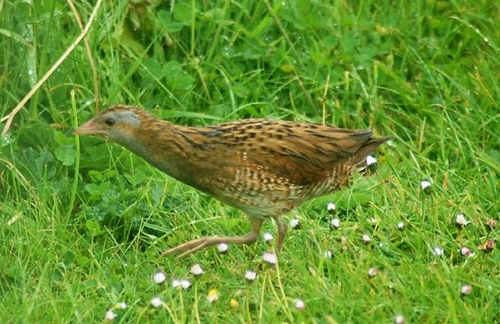
Wikipedia: Corn crake Quelle: OTHER
Corncrake2.jpg
![]() Der Wachtelkönig (Crex crex), auch Wiesenralle oder Wiesenknarrer genannt, ist in Europa die einzige Art der Gattung Crex innerhalb der Rallenvögel (Rallidae). Die Art ist monotypisch. Die Gattung Crex umfasst nur noch eine zweite, ebenfalls monotypische Art, die Savannenralle (Crex egregia), die in Afrika südlich der Sahara vorkommt.
[more]
Der Wachtelkönig (Crex crex), auch Wiesenralle oder Wiesenknarrer genannt, ist in Europa die einzige Art der Gattung Crex innerhalb der Rallenvögel (Rallidae). Die Art ist monotypisch. Die Gattung Crex umfasst nur noch eine zweite, ebenfalls monotypische Art, die Savannenralle (Crex egregia), die in Afrika südlich der Sahara vorkommt.
[more]
Gesang: ![]() Characteristic song can be heard at night. A rasping, hoarse "crex-crex" repeated about every second for long periods of time. [Link]
Characteristic song can be heard at night. A rasping, hoarse "crex-crex" repeated about every second for long periods of time. [Link]
Körperlich: Länge=27-30 cm,
Flügelspanne=46-53 cm,
Gewicht=120-200 g
Habitate:
Landwirtschaft
Savannenralle / African crake (Crex egregia)
Profil Wikipedia eBird Xeno-Canto

Wikipedia: African crake Quelle: OTHER
CrakeAfrican2%28byMarkTittley%29_cropped_and_mirrored.jpg
Allgemein: ![]() Die Savannenralle (Crex egregia, Syn.: Ortygometra egregia, Crecopsis egregia, Porzana egregia), auch Steppenralle oder Steppensumpfhuhn genannt, zählt innerhalb der Familie der Rallen (Rallidae) zur Gattung der Wachtelkönige (Crex).[1]
[more]
Die Savannenralle (Crex egregia, Syn.: Ortygometra egregia, Crecopsis egregia, Porzana egregia), auch Steppenralle oder Steppensumpfhuhn genannt, zählt innerhalb der Familie der Rallen (Rallidae) zur Gattung der Wachtelkönige (Crex).[1]
[more]
Zwergsumpfhuhn (alternate) / Baillon's crake (Zapornia pusilla)
Profil Wikipedia eBird Xeno-Canto NABU

Wikipedia: Baillon's crake Quelle: OTHER
1200px-Porzana_pusilla_-_Mount_Annan_Botanical_Garden.jpg
![]() Das Zwergsumpfhuhn (Porzana pusilla) ist die kleinste in Europa vorkommende Rallenart. Das Verbreitungsgebiet der Art ist sehr groß und reicht weit über Europa hinaus. Es umfasst mehrere disjunkte Gebiete in Afrika (Süden Afrikas, Madagaskar und Nordafrika) und reicht von Europa bis in den Nordosten und Osten Chinas, lKorea und Japan sowie über Indochina bis nach Neuguinea, Australien und Neuseeland.[1] Dem Aussehen nach ähnelt das Zwergsumpfhuhn dem Kleinen Sumpfhuhn. Es hat jedoch fleischfarbige Beine, eine auffallend schwarze Bänderung an den Flanken und keinen roten Fleck an der Schnabelwurzel.
[more]
Das Zwergsumpfhuhn (Porzana pusilla) ist die kleinste in Europa vorkommende Rallenart. Das Verbreitungsgebiet der Art ist sehr groß und reicht weit über Europa hinaus. Es umfasst mehrere disjunkte Gebiete in Afrika (Süden Afrikas, Madagaskar und Nordafrika) und reicht von Europa bis in den Nordosten und Osten Chinas, lKorea und Japan sowie über Indochina bis nach Neuguinea, Australien und Neuseeland.[1] Dem Aussehen nach ähnelt das Zwergsumpfhuhn dem Kleinen Sumpfhuhn. Es hat jedoch fleischfarbige Beine, eine auffallend schwarze Bänderung an den Flanken und keinen roten Fleck an der Schnabelwurzel.
[more]
Grus carunculatus / Wattled crane (Grus carunculatus)

Wikipedia: Wattled crane Quelle: OTHER
Wattled_Crane_1400.jpg
![]() The wattled crane (Grus carunculata) is a large bird found in Africa, south of the Sahara Desert. It is sometimes placed in the monotypic genus Bugeranus.
[more]
The wattled crane (Grus carunculata) is a large bird found in Africa, south of the Sahara Desert. It is sometimes placed in the monotypic genus Bugeranus.
[more]
Südafrika-Kronenkranich / Grey crowned-crane (Balearica regulorum)

Wikipedia: Grey crowned-crane Quelle: OTHER
1200px-Grey_crowned_crane_at_Martin_Mere.JPG
![]() Der Südafrika-Kronenkranich (Balearica regulorum), auch Grauhals-Kronenkranich oder Heller Kronenkranich genannt, ist eine Vogelart aus der Familie der Kraniche (Gruidae), deren Verbreitungsgebiet in Subsahara-Afrika liegt. Es werden zwei Unterarten unterschieden, die sich nur geringfügig durch die Ausbildung der nackten Uhrscheiben unterscheiden.[1]
[more]
Der Südafrika-Kronenkranich (Balearica regulorum), auch Grauhals-Kronenkranich oder Heller Kronenkranich genannt, ist eine Vogelart aus der Familie der Kraniche (Gruidae), deren Verbreitungsgebiet in Subsahara-Afrika liegt. Es werden zwei Unterarten unterschieden, die sich nur geringfügig durch die Ausbildung der nackten Uhrscheiben unterscheiden.[1]
[more]
Afrikanische Binsenralle / African finfoot (Podica senegalensis)
Profil Wikipedia eBird Xeno-Canto

Wikipedia: African finfoot Quelle: OTHER
African_Finfoot_-_Lake_Mburu_-_Uganda.jpg
![]() Die Afrikanische Binsenralle (Podica senegalensis), auch Afrikanisches Binsenhuhn oder Tüpfelbinsenralle genannt, ist der größte Vertreter aus der Familie der Binsenrallen. Sie ist gleichzeitig die einzige Art innerhalb der Gattung Podica. Es werden vier Unterarten unterschieden.
[more]
Die Afrikanische Binsenralle (Podica senegalensis), auch Afrikanisches Binsenhuhn oder Tüpfelbinsenralle genannt, ist der größte Vertreter aus der Familie der Binsenrallen. Sie ist gleichzeitig die einzige Art innerhalb der Gattung Podica. Es werden vier Unterarten unterschieden.
[more]
Riesentrappe / Kori bustard (Ardeotis kori)

Wikipedia: Kori bustard Quelle: OTHER
1200px-Ardeotis_kori_Etosha.JPG
![]() Die Riesentrappe (Ardeotis kori, auch Koritrappe) ist eine große Vogelart, die im östlichen und südlichen Afrika vorkommt.
[more]
Die Riesentrappe (Ardeotis kori, auch Koritrappe) ist eine große Vogelart, die im östlichen und südlichen Afrika vorkommt.
[more]
Eupodotis senegalensis / White-bellied bustard (Eupodotis senegalensis)
Profil Wikipedia eBird Xeno-Canto

Wikipedia: White-bellied bustard Quelle: OTHER
1200px-White_bellied_bustard_calling.jpg
![]() The white-bellied bustard or white-bellied korhaan (Eupodotis senegalensis) is an African species of bustard. It is widespread in sub-Saharan Africa in grassland and open woodland habitats.[2]
[more]
The white-bellied bustard or white-bellied korhaan (Eupodotis senegalensis) is an African species of bustard. It is widespread in sub-Saharan Africa in grassland and open woodland habitats.[2]
[more]
Eupodotis vigorsii / Karoo bustard (Eupodotis vigorsii)

Wikipedia: Karoo bustard Quelle: OTHER
1200px-Karoo_Korhaan_%28Eupodotis_vigorsii%29_%2831800692824%29.jpg
![]() The karoo korhaan (Eupodotis vigorsii), also known as karoo bustard, is a species of bird in the bustard family, Otididae, from Southern Africa. The species is sometimes placed in the genus Heterotetrax. It is the sister-species to Rüppell's korhaan, and the two species are sometimes considered conspecific (the same species). There are two subspecies, the nominate race, from south-eastern South Africa, and E. v. namaqua (Roberts, 1932), from north-eastern South Africa and southern Namibia.[2]
[more]
The karoo korhaan (Eupodotis vigorsii), also known as karoo bustard, is a species of bird in the bustard family, Otididae, from Southern Africa. The species is sometimes placed in the genus Heterotetrax. It is the sister-species to Rüppell's korhaan, and the two species are sometimes considered conspecific (the same species). There are two subspecies, the nominate race, from south-eastern South Africa, and E. v. namaqua (Roberts, 1932), from north-eastern South Africa and southern Namibia.[2]
[more]
Eupodotis caerulescens / Blue bustard (Eupodotis caerulescens)
Profil Wikipedia eBird Xeno-Canto

Wikipedia: Blue bustard Quelle: OTHER
1200px-Blue_Korhaan_%28Eupodotis_caerulescens%29_male.jpg
![]() The blue korhaan or blue bustard (Eupodotis caerulescens) is a species of bird in the family Otididae which is native to South Africa. Its call is a series of frog-like croaks, usually uttered in flight. Its natural habitat is plateau grassland, dry shrubland, arable land and pastureland. Its preferred habitat is one with short grassland and flat topography.[2]
[more]
The blue korhaan or blue bustard (Eupodotis caerulescens) is a species of bird in the family Otididae which is native to South Africa. Its call is a series of frog-like croaks, usually uttered in flight. Its natural habitat is plateau grassland, dry shrubland, arable land and pastureland. Its preferred habitat is one with short grassland and flat topography.[2]
[more]
Neotis denhami / Denham's bustard (Neotis denhami)
Profil Wikipedia eBird Xeno-Canto

Wikipedia: Denham's bustard Quelle: OTHER
1200px-Denham%27s_Bustard_%28Neotis_denhami%29_%287083219537%29.jpg
![]() Denham's bustard, Stanley bustard or Stanley's bustard (Neotis denhami) is a large bird in the bustard family. It breeds in much of Sub-Saharan Africa. It is a species of open ground, including agricultural land, grassland, flood-plains and burnt fynbos. It is resident, but some inland populations move to lower altitudes in winter. The common names for this species refer to the English explorer, Major Dixon Denham, and the English naturalist Edward Smith-Stanley, 13th Earl of Derby.
[more]
Denham's bustard, Stanley bustard or Stanley's bustard (Neotis denhami) is a large bird in the bustard family. It breeds in much of Sub-Saharan Africa. It is a species of open ground, including agricultural land, grassland, flood-plains and burnt fynbos. It is resident, but some inland populations move to lower altitudes in winter. The common names for this species refer to the English explorer, Major Dixon Denham, and the English naturalist Edward Smith-Stanley, 13th Earl of Derby.
[more]
Neotis ludwigii / Ludwig's bustard (Neotis ludwigii)
Profil Wikipedia eBird Xeno-Canto

Wikipedia: Ludwig's bustard Quelle: OTHER
1200px-Neotis_ludwigii.jpg
![]() Ludwig's bustard (Neotis ludwigii) is a species of bird in the bustard family, and named after Baron von Ludwig. It is a medium-to-large sized species. It is found in Angola, Botswana, Lesotho, Namibia, and South Africa. Its habitats include semi-arid grasslands.
[more]
Ludwig's bustard (Neotis ludwigii) is a species of bird in the bustard family, and named after Baron von Ludwig. It is a medium-to-large sized species. It is found in Angola, Botswana, Lesotho, Namibia, and South Africa. Its habitats include semi-arid grasslands.
[more]
Schwarzbauchtrappe / Black-bellied bustard (Lissotis melanogaster)
Profil Wikipedia eBird Xeno-Canto

Wikipedia: Black-bellied bustard Quelle: OTHER
1200px-Black-bellied_bustard.jpg
![]() Die Schwarzbauchtrappe (Lissotis melanogaster) ist eine afrikanische Art aus der Familie der Trappen (Otididae). Sie bewohnt einen Großteil der Savannen Afrikas und ist vielerorts die häufigste Trappenart.
[more]
Die Schwarzbauchtrappe (Lissotis melanogaster) ist eine afrikanische Art aus der Familie der Trappen (Otididae). Sie bewohnt einen Großteil der Savannen Afrikas und ist vielerorts die häufigste Trappenart.
[more]
Lophotis ruficrista / Red-crested bustard (Lophotis ruficrista)

Wikipedia: Red-crested bustard Quelle: OTHER
1200px-Red-crested_Korhaan_%28Lophotis_ruficrista%29_male_%2813799426305%29.jpg
![]() The red-crested korhaan or red-crested bustard (Lophotis ruficrista) is a species of bird in the family Otididae. It is found in Angola, Botswana, Mozambique, Namibia, South Africa, Swaziland, Zambia, and Zimbabwe.[1]
[more]
The red-crested korhaan or red-crested bustard (Lophotis ruficrista) is a species of bird in the family Otididae. It is found in Angola, Botswana, Mozambique, Namibia, South Africa, Swaziland, Zambia, and Zimbabwe.[1]
[more]
Profil Wikipedia eBird Xeno-Canto

Wikipedia: Forest buzzard Quelle: OTHER
1200px-Forest_Buzzard%2C_Buteo_trizonatus%2C_at_Hangklip_Forest%2C_Makhado%2C_Limpopo_Province%2C_South_Africa_%2820761505461%29.jpg
![]() The forest buzzard (Buteo trizonatus), is a species of bird of prey found in Africa, though some authorities have placed it as a subspecies of another species, the mountain buzzard, Buto oreophilus. This is a resident breeding species in woodlands in southern and eastern South Africa.
[more]
The forest buzzard (Buteo trizonatus), is a species of bird of prey found in Africa, though some authorities have placed it as a subspecies of another species, the mountain buzzard, Buto oreophilus. This is a resident breeding species in woodlands in southern and eastern South Africa.
[more]
Profil Wikipedia eBird Xeno-Canto
Possibly Red-necked buzzards in the desert. 2016-09-07 12.02.46 Namibia
Zuerst beobachtet in Namibia an 2016-09-07.
![]() The red-necked buzzard (Buteo auguralis), also known as the African red-tailed buzzard,[2] is a species of buzzard in the family Accipitridae which is found in western and northern central Africa.
[more]
The red-necked buzzard (Buteo auguralis), also known as the African red-tailed buzzard,[2] is a species of buzzard in the family Accipitridae which is found in western and northern central Africa.
[more]

Wikipedia: Jackal buzzard Quelle: OTHER
Buteo_rufofuscus_-Itala_Game_Reserve%2C_KwaZulu-Natal%2C_South_Africa_-flying-6.jpg
![]() Der Schakalbussard (Buteo rufofuscus) ist eine Vogelart aus der Gattung der Bussarde und in Südafrika, im Süden und Südwesten Namibias, sowie im äußersten Südwesten der Kalahari in Botswana (Kgalagadi Transfrontier National Park) anzutreffen, wobei er in den weiter nördlich gelegenen, weniger gebirgigen Regionen seines Verbreitungsgebietes seltener vorkommt.
[more]
Der Schakalbussard (Buteo rufofuscus) ist eine Vogelart aus der Gattung der Bussarde und in Südafrika, im Süden und Südwesten Namibias, sowie im äußersten Südwesten der Kalahari in Botswana (Kgalagadi Transfrontier National Park) anzutreffen, wobei er in den weiter nördlich gelegenen, weniger gebirgigen Regionen seines Verbreitungsgebietes seltener vorkommt.
[more]

Wikipedia: Shikra Quelle: OTHER
1200px-Shikra1.jpg
![]() Der Schikrasperber oder Schikra (Accipiter badius) gehört zur Familie der Habichtartigen (Accipitridae). Die Art gilt als weitgehend unerforscht. Sie kam ursprünglich im westlichen Zentralasien, in Südkasachstan und Südasien vor. Auf dem afrikanischen Kontinent wurden ebenfalls Schikras gemeldet.
[more]
Der Schikrasperber oder Schikra (Accipiter badius) gehört zur Familie der Habichtartigen (Accipitridae). Die Art gilt als weitgehend unerforscht. Sie kam ursprünglich im westlichen Zentralasien, in Südkasachstan und Südasien vor. Auf dem afrikanischen Kontinent wurden ebenfalls Schikras gemeldet.
[more]
Profil Wikipedia eBird Xeno-Canto

Wikipedia: Rufous-breasted sparrowhawk Quelle: OTHER
Rufous-chested_Sparrowhawk_%28Accipiter_rufiventris%29.jpg
![]() The rufous-breasted sparrowhawk (Accipiter rufiventris), also known as the rufous-chested sparrowhawk and as the red-breasted sparrowhawk, is a species of bird of prey in the family Accipitridae. It is found in Angola, Democratic Republic of the Congo, Eritrea, Ethiopia, Kenya, Lesotho, Malawi, Mozambique, Rwanda, South Africa, South Sudan, Swaziland, Tanzania, Uganda, Zambia, and Zimbabwe.
[more]
The rufous-breasted sparrowhawk (Accipiter rufiventris), also known as the rufous-chested sparrowhawk and as the red-breasted sparrowhawk, is a species of bird of prey in the family Accipitridae. It is found in Angola, Democratic Republic of the Congo, Eritrea, Ethiopia, Kenya, Lesotho, Malawi, Mozambique, Rwanda, South Africa, South Sudan, Swaziland, Tanzania, Uganda, Zambia, and Zimbabwe.
[more]
Profil Wikipedia eBird Xeno-Canto
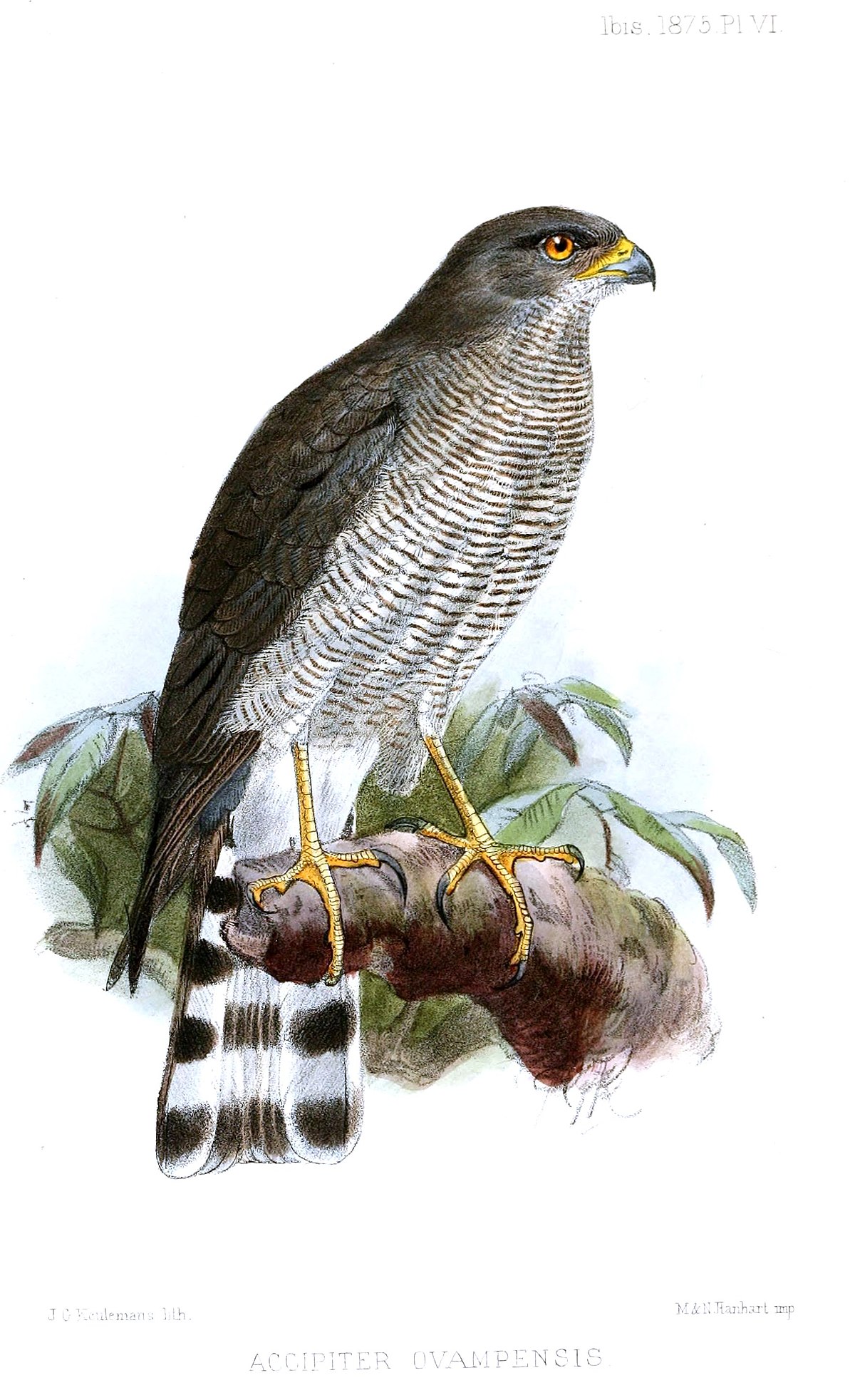
Wikipedia: Ovambo sparrowhawk Quelle: OTHER
1200px-AccipiterOvampensisKeulemans.jpg
![]() The Ovambo or Ovampo sparrowhawk, also known as Hilgert's sparrowhawk, (Accipiter ovampensis) is a species of sub-Saharan African bird of prey in the family Accipitridae. It takes its name from the Ovamboland in northern Namibia.
[more]
The Ovambo or Ovampo sparrowhawk, also known as Hilgert's sparrowhawk, (Accipiter ovampensis) is a species of sub-Saharan African bird of prey in the family Accipitridae. It takes its name from the Ovamboland in northern Namibia.
[more]
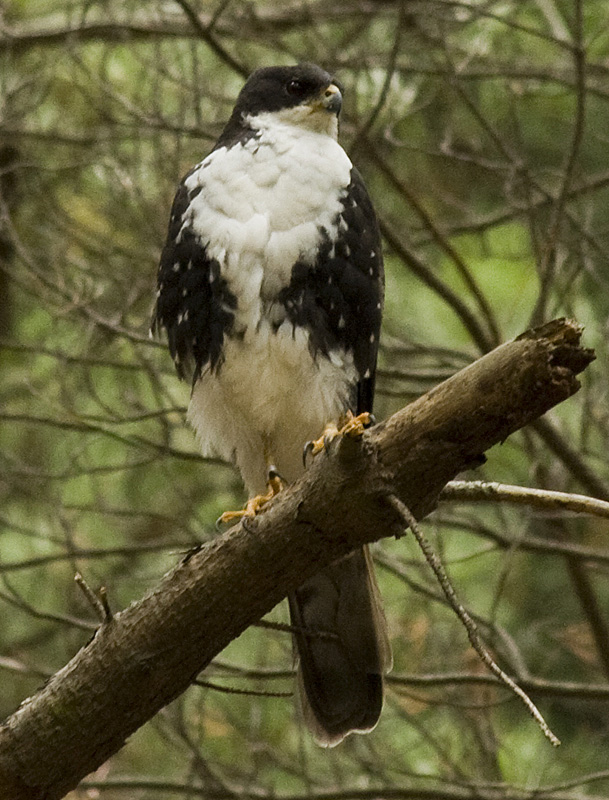
Wikipedia: Black goshawk Quelle: OTHER
Black_Sparrowhawk_white_morph_2_x.jpg
![]() The black sparrowhawk (Accipiter melanoleucus), sometimes known as the black goshawk or great sparrowhawk, is the largest African member of the genus Accipiter.[3] It occurs mainly in forest and non-desert areas south of the Sahara, particularly where there are large trees suitable for nesting; favored habitat includes suburban and human-altered landscapes.[3] It preys predominantly on birds of moderate size, such as pigeons and doves, in suburban areas.[4]
[more]
The black sparrowhawk (Accipiter melanoleucus), sometimes known as the black goshawk or great sparrowhawk, is the largest African member of the genus Accipiter.[3] It occurs mainly in forest and non-desert areas south of the Sahara, particularly where there are large trees suitable for nesting; favored habitat includes suburban and human-altered landscapes.[3] It preys predominantly on birds of moderate size, such as pigeons and doves, in suburban areas.[4]
[more]

Wikipedia: Little sparrowhawk Quelle: OTHER
1200px-Little_sparrowhawk_%28Accipiter_minullus%29_01%2C_crop.jpg
![]() The little sparrowhawk (Accipiter minullus) is a species of Afrotropical bird of prey in the family Accipitridae. It is the smallest member of the genus Accipiter and forms a superspecies with the red-thighed sparrowhawk (Accipiter erythropus).
[more]
The little sparrowhawk (Accipiter minullus) is a species of Afrotropical bird of prey in the family Accipitridae. It is the smallest member of the genus Accipiter and forms a superspecies with the red-thighed sparrowhawk (Accipiter erythropus).
[more]

Wikipedia: African goshawk Quelle: OTHER
1200px-African_Goshawk_RWD2.jpg
![]() The African goshawk (Accipiter tachiro) is a species of African bird of prey in the genus Accipiter which is the type genus of the family Accipitridae.
[more]
The African goshawk (Accipiter tachiro) is a species of African bird of prey in the genus Accipiter which is the type genus of the family Accipitridae.
[more]
Tawny-eagle. 2016-09-14 15.33.02 Namibia
Zuerst beobachtet in Namibia an 2016-09-14.
![]() Der Raubadler oder Savannenadler (Aquila rapax) ist eine Vogelart aus der Familie der Habichtartigen (Accipitridae). Dieser mittelgroße Vertreter der Unterfamilie Aquilinae besiedelt weite Teile Afrikas südlich der Sahara sowie den indischen Subkontinent. Kleinflächig kommt die Art auch im nördlichen Afrika, auf der Arabischen Halbinsel sowie möglicherweise in Myanmar vor. Die Art bewohnt überwiegend trockene Landschaften mit lockerem Baumbestand; das Spektrum der besiedelten Lebensräume reicht von waldreichen Savannen, Trockenwäldern und Dornbuschwäldern bis hin zu Halbwüsten. Der Raubadler ernährt sich von kleinen bis mittelgroßen Wirbeltieren, Insekten und auch regelmäßig von Aas. Er parasitiert häufig auch bei anderen Greifvogelarten, Störchen oder Hornraben.
[more]
Der Raubadler oder Savannenadler (Aquila rapax) ist eine Vogelart aus der Familie der Habichtartigen (Accipitridae). Dieser mittelgroße Vertreter der Unterfamilie Aquilinae besiedelt weite Teile Afrikas südlich der Sahara sowie den indischen Subkontinent. Kleinflächig kommt die Art auch im nördlichen Afrika, auf der Arabischen Halbinsel sowie möglicherweise in Myanmar vor. Die Art bewohnt überwiegend trockene Landschaften mit lockerem Baumbestand; das Spektrum der besiedelten Lebensräume reicht von waldreichen Savannen, Trockenwäldern und Dornbuschwäldern bis hin zu Halbwüsten. Der Raubadler ernährt sich von kleinen bis mittelgroßen Wirbeltieren, Insekten und auch regelmäßig von Aas. Er parasitiert häufig auch bei anderen Greifvogelarten, Störchen oder Hornraben.
[more]
Profil Wikipedia eBird Xeno-Canto
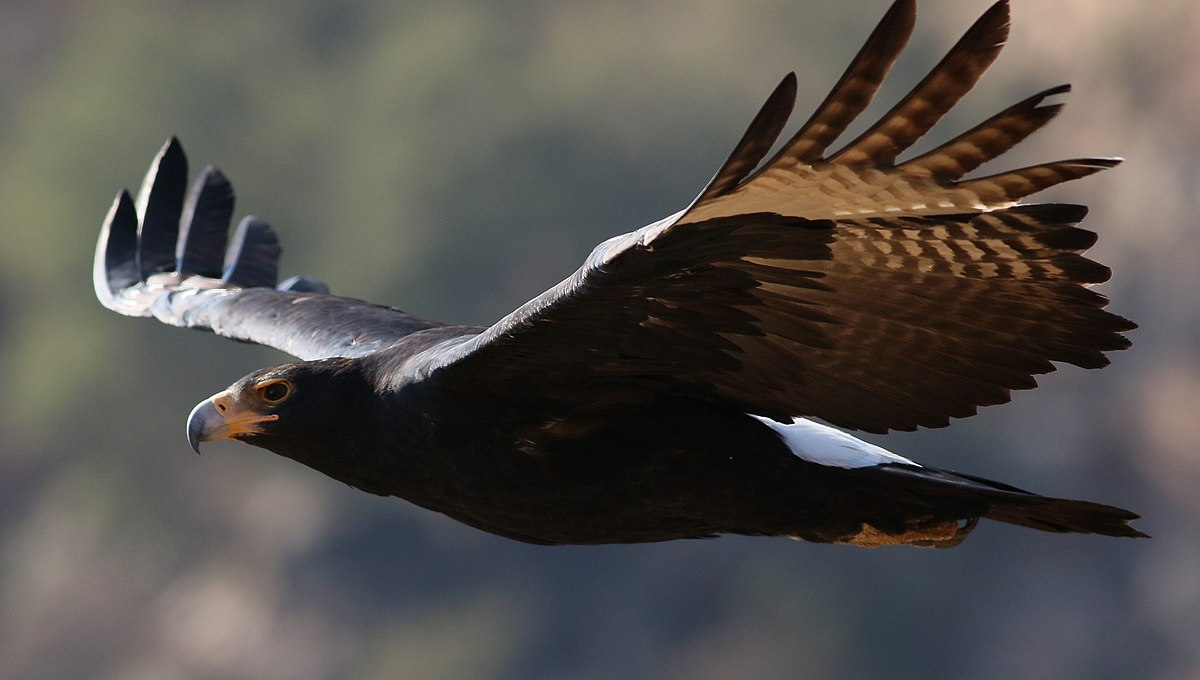
Wikipedia: Verreaux's eagle Quelle: OTHER
1200px-Verreaux%27s_Eagle_%28Black_Eagle%29%2C_Aquila_verreauxii%2C_at_Walter_Sisulu_National_Botanical_Garden%2C_Gauteng%2C_South_Africa_%2828825027073%29.jpg
![]() Der Klippenadler (Aquila verreauxii), früher auch als Kaffernadler bezeichnet, ist ein sehr großer Vertreter der Gattung Echte Adler (Aquila). Das Hauptverbreitungsgebiet der nirgendwo häufigen Art liegt im südlichen Afrika. Der trotz seiner Größe und seines beträchtlichen Gewichtes agile und gewandte Adler ist in seinem Verbreitungsgebiet unverwechselbar. Adulte Vögel wirken fast einheitlich schwarz.
[more]
Der Klippenadler (Aquila verreauxii), früher auch als Kaffernadler bezeichnet, ist ein sehr großer Vertreter der Gattung Echte Adler (Aquila). Das Hauptverbreitungsgebiet der nirgendwo häufigen Art liegt im südlichen Afrika. Der trotz seiner Größe und seines beträchtlichen Gewichtes agile und gewandte Adler ist in seinem Verbreitungsgebiet unverwechselbar. Adulte Vögel wirken fast einheitlich schwarz.
[more]

Wikipedia: African hawk-eagle Quelle: OTHER
1200px-African_hawk_eagle_%28Aquila_spilogaster%29.jpg
![]() The African hawk-eagle (Aquila spilogaster) is a large bird of prey. Like all eagles, it belongs to the family Accipitridae. The African hawk-eagle breeds in tropical Sub-Saharan Africa. It is a bird of wooded hills, building a stick nest about 3 feet (almost 1 metre) in diameter in the fork of a large tree. The clutch is generally one or two eggs. The African hawk-eagle hunts small mammals, reptiles, and birds. The call is a shrill kluu-kluu-kluu.[2]
[more]
The African hawk-eagle (Aquila spilogaster) is a large bird of prey. Like all eagles, it belongs to the family Accipitridae. The African hawk-eagle breeds in tropical Sub-Saharan Africa. It is a bird of wooded hills, building a stick nest about 3 feet (almost 1 metre) in diameter in the fork of a large tree. The clutch is generally one or two eggs. The African hawk-eagle hunts small mammals, reptiles, and birds. The call is a shrill kluu-kluu-kluu.[2]
[more]

Wikipedia: Steppe eagle Quelle: OTHER
1200px-Steppe_Eagle_Portrait.jpg
![]() The steppe eagle (Aquila nipalensis) is a large bird of prey. Like all eagles, it belongs to the family Accipitridae.[3] The steppe eagle's well-feathered legs illustrate it to be a member of the subfamily Aquilinae, also known as the "booted eagles".[4] This species was once considered to be closely related to the non-migratory tawny eagle (Aquila rapax) and the two forms have previously been treated as conspecific. They were split based on pronounced differences in morphology and anatomy;[5][6] two molecular studies, each based on a very small number of genes, indicate that the species are distinct but disagree over how closely related they are.[6][7][8]
[more]
The steppe eagle (Aquila nipalensis) is a large bird of prey. Like all eagles, it belongs to the family Accipitridae.[3] The steppe eagle's well-feathered legs illustrate it to be a member of the subfamily Aquilinae, also known as the "booted eagles".[4] This species was once considered to be closely related to the non-migratory tawny eagle (Aquila rapax) and the two forms have previously been treated as conspecific. They were split based on pronounced differences in morphology and anatomy;[5][6] two molecular studies, each based on a very small number of genes, indicate that the species are distinct but disagree over how closely related they are.[6][7][8]
[more]
Profil Wikipedia eBird Xeno-Canto
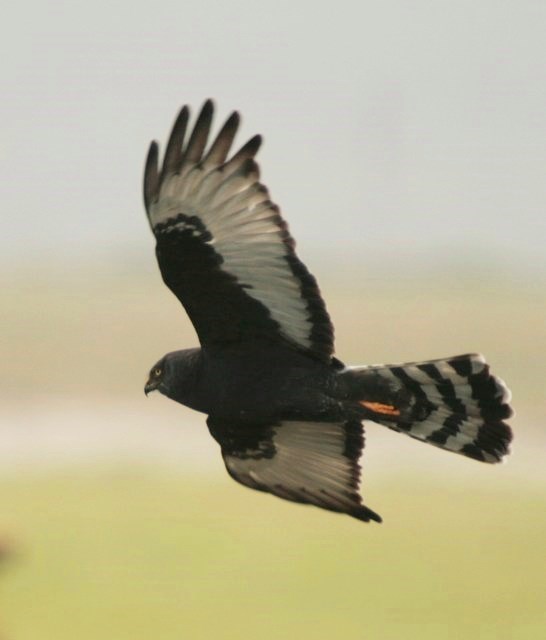
Wikipedia: Black harrier Quelle: OTHER
Circus_maurus.jpg
![]() Die Kapweihe (Circus maurus), früher auch Mohrenweihe genannt, ist ein Greifvogel aus der Familie der Habichtartigen (Accipitridae). Charakteristisch für diese mittelgroße Weihe ist die bei Männchen und Weibchen einheitliche, schwarz-weiße Gefiederzeichnung. Die Brutgebiete der Kapweihe beschränken sich auf die südlichen zwei Drittel Südafrikas, Lesotho, den äußersten Süden Botswanas und Namibias sowie eine kleinere Exklave an der nördlichen namibischen Küste. Sie bewohnt sowohl trockenes, baumarmes Fynbos-Hochland als auch weiträumige Feuchtgebiete. Die Kapweihe macht vor allem auf kleine Mäuseartige und Wachteln Jagd, die sie im weihentypischen Gaukelflug fängt. Sie brütet in der Regel von August bis Dezember in einem Bodennest.
[more]
Die Kapweihe (Circus maurus), früher auch Mohrenweihe genannt, ist ein Greifvogel aus der Familie der Habichtartigen (Accipitridae). Charakteristisch für diese mittelgroße Weihe ist die bei Männchen und Weibchen einheitliche, schwarz-weiße Gefiederzeichnung. Die Brutgebiete der Kapweihe beschränken sich auf die südlichen zwei Drittel Südafrikas, Lesotho, den äußersten Süden Botswanas und Namibias sowie eine kleinere Exklave an der nördlichen namibischen Küste. Sie bewohnt sowohl trockenes, baumarmes Fynbos-Hochland als auch weiträumige Feuchtgebiete. Die Kapweihe macht vor allem auf kleine Mäuseartige und Wachteln Jagd, die sie im weihentypischen Gaukelflug fängt. Sie brütet in der Regel von August bis Dezember in einem Bodennest.
[more]

Wikipedia: African marsh-harrier Quelle: OTHER
1200px-Circus_ranivorus.jpg
![]() The African marsh harrier (Circus ranivorus) is a bird of prey belonging to the harrier genus Circus. It is largely resident in wetland habitats in southern, central and eastern Africa from South Africa north to South Sudan.
[more]
The African marsh harrier (Circus ranivorus) is a bird of prey belonging to the harrier genus Circus. It is largely resident in wetland habitats in southern, central and eastern Africa from South Africa north to South Sudan.
[more]
MerlinBirdID meint Rohrweihe. 2022-05-21 16.00.56 Leuk und Umgebung
Zuerst beobachtet in 🇨🇭 an 2022-05-21.
![]() Die Rohrweihe (Circus aeruginosus) ist eine paläarktische Greifvogelart aus der Familie der Habichtartigen (Accipitridae). Ihre Brutverbreitung reicht von der zentralen Mongolei bis nach Portugal sowie von Skandinavien bis Nordafrika. Die Überwinterungsgebiete liegen in West- und Zentralafrika, Arabien sowie auf dem indischen Subkontinent. Die Art bewohnt Schilfbestände, Moore, Seeufer und andere Feuchtgebiete in offener Landschaft, aber auch Getreide- und Rapsfelder. Die Brutzeit der Rohrweihe liegt, je nach Breitengrad, zwischen April und August, wobei zwei bis sieben Eier in einem Bodennest in hoher Vegetation ausgebrütet werden. Es werden zwei Unterarten unterschieden, wobei die Nominatform den Norden des Verbreitungsgebiets bewohnt und die Unterart Circus aeruginosus harterti in Marokko, Algerien und Tunesien vorkommt.
[more]
Die Rohrweihe (Circus aeruginosus) ist eine paläarktische Greifvogelart aus der Familie der Habichtartigen (Accipitridae). Ihre Brutverbreitung reicht von der zentralen Mongolei bis nach Portugal sowie von Skandinavien bis Nordafrika. Die Überwinterungsgebiete liegen in West- und Zentralafrika, Arabien sowie auf dem indischen Subkontinent. Die Art bewohnt Schilfbestände, Moore, Seeufer und andere Feuchtgebiete in offener Landschaft, aber auch Getreide- und Rapsfelder. Die Brutzeit der Rohrweihe liegt, je nach Breitengrad, zwischen April und August, wobei zwei bis sieben Eier in einem Bodennest in hoher Vegetation ausgebrütet werden. Es werden zwei Unterarten unterschieden, wobei die Nominatform den Norden des Verbreitungsgebiets bewohnt und die Unterart Circus aeruginosus harterti in Marokko, Algerien und Tunesien vorkommt.
[more]
Rufe: ![]() Call: A sharp "kwii-uuu" of about a seconds length, rapidly ascending in pitch, and ending on a falling tone. [Link]
Call: A sharp "kwii-uuu" of about a seconds length, rapidly ascending in pitch, and ending on a falling tone. [Link]
Körperlich: Länge=48-56 cm,
Flügelspanne=115-130 cm,
Gewicht=405-800 g
Habitate:
Landwirtschaft
Profil Wikipedia eBird Vogelwarte BirdLife ZH ornitho.ch Xeno-Canto BirdID NABU

Wikipedia: Pallid harrier Quelle: OTHER
1200px-Pallid_Harrier_Male.jpg
Allgemein: ![]() Die Steppenweihe (Circus macrourus) gehört zur Gattung der Weihen aus der Familie der Habichtartigen. Ihr Verbreitungsgebiet reicht von Osteuropa nach Zentralasien, im Winter zieht sie ins Afrika südlich der Sahara, auf den indischen Subkontinent und nach Myanmar.[1][2] In Deutschland ist sie wie auch im restlichen Mitteleuropa eine Ausnahmeerscheinung, die als Durchzügler oder gelegentlicher Wintergast auftritt.[3][4]
[more]
Die Steppenweihe (Circus macrourus) gehört zur Gattung der Weihen aus der Familie der Habichtartigen. Ihr Verbreitungsgebiet reicht von Osteuropa nach Zentralasien, im Winter zieht sie ins Afrika südlich der Sahara, auf den indischen Subkontinent und nach Myanmar.[1][2] In Deutschland ist sie wie auch im restlichen Mitteleuropa eine Ausnahmeerscheinung, die als Durchzügler oder gelegentlicher Wintergast auftritt.[3][4]
[more]
Rufe: ![]() Some calls similar to Montagu's and Hen Harrier, but display call quite diagnostic. A thin, vibrating trill "peerrrrrrrr". [Link]
Some calls similar to Montagu's and Hen Harrier, but display call quite diagnostic. A thin, vibrating trill "peerrrrrrrr". [Link]
Körperlich: Länge=40-48 cm,
Flügelspanne=95-120 cm,
Gewicht=300-550 g
Profil Wikipedia eBird Vogelwarte BirdLife ZH ornitho.ch Xeno-Canto NABU
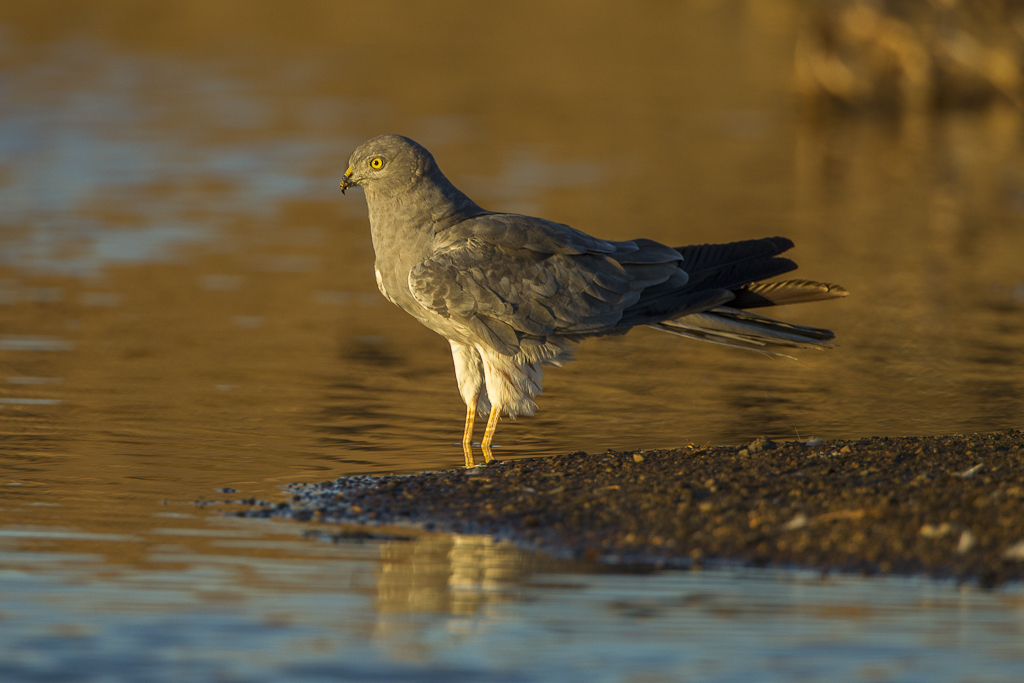
Wikipedia: Montagu's harrier Quelle: OTHER
Montagu%27s_harrier_%28Circus_pygargus%29.jpg
Allgemein: ![]() Die Wiesenweihe (Circus pygargus) ist ein Greifvogel aus der Familie der Habichtartigen (Accipitridae). Wie viele Arten der Gattung Circus zeigt auch die Wiesenweihe einen starken Geschlechtsdimorphismus bezüglich Größe und Färbung. Das Verbreitungsgebiet erstreckt sich über weite Teile der westlichen und mittleren Paläarktis. Die Art bewohnt großflächig offene, feuchte bis trockene Habitate wie Verlandungszonen, Niedermoore und Steppen sowie landwirtschaftliche Flächen mit vergleichbarer Vegetationsstruktur, vor allem Getreideäcker. In Mitteleuropa hat die Besiedlung landwirtschaftlicher Flächen unterstützt durch gezielten Schutz in den letzten Jahrzehnten stark zugenommen. Wiesenweihen sind Langstreckenzieher, sie überwintern in Afrika südlich der Sahara sowie im Süden Asiens. In Teilen Europas gab es im 20. Jahrhundert durch Lebensraumzerstörung drastische Bestandrückgänge, weltweit ist die Art heute jedoch ungefährdet.
[more]
Die Wiesenweihe (Circus pygargus) ist ein Greifvogel aus der Familie der Habichtartigen (Accipitridae). Wie viele Arten der Gattung Circus zeigt auch die Wiesenweihe einen starken Geschlechtsdimorphismus bezüglich Größe und Färbung. Das Verbreitungsgebiet erstreckt sich über weite Teile der westlichen und mittleren Paläarktis. Die Art bewohnt großflächig offene, feuchte bis trockene Habitate wie Verlandungszonen, Niedermoore und Steppen sowie landwirtschaftliche Flächen mit vergleichbarer Vegetationsstruktur, vor allem Getreideäcker. In Mitteleuropa hat die Besiedlung landwirtschaftlicher Flächen unterstützt durch gezielten Schutz in den letzten Jahrzehnten stark zugenommen. Wiesenweihen sind Langstreckenzieher, sie überwintern in Afrika südlich der Sahara sowie im Süden Asiens. In Teilen Europas gab es im 20. Jahrhundert durch Lebensraumzerstörung drastische Bestandrückgänge, weltweit ist die Art heute jedoch ungefährdet.
[more]
Habitate:
Landwirtschaft
Profil Wikipedia eBird Xeno-Canto NABU

Wikipedia: White-backed vulture Quelle: OTHER
1200px-2012-white-backed-vulture.jpg
![]() Der Weißrückengeier (Gyps africanus) ist ein Greifvogel aus der Unterfamilie der Altweltgeier (Aegypiinae). Das Verbreitungsgebiet der Art umfasst große Teile Afrikas südlich der Sahara. Aufgrund starker Bestandsrückgänge in Teilen des Verbreitungsgebietes stuft die IUCN den Weißrückengeier als Art der Roten Liste ("critically endangered") ein.
[more]
Der Weißrückengeier (Gyps africanus) ist ein Greifvogel aus der Unterfamilie der Altweltgeier (Aegypiinae). Das Verbreitungsgebiet der Art umfasst große Teile Afrikas südlich der Sahara. Aufgrund starker Bestandsrückgänge in Teilen des Verbreitungsgebietes stuft die IUCN den Weißrückengeier als Art der Roten Liste ("critically endangered") ein.
[more]

Wikipedia: Rueppell's griffon Quelle: OTHER
1200px-R%C3%BCppell%27s_Vulture_%28Gyps_rueppelli%29_%2821160089681%29.jpg
![]() Der Sperbergeier (Gyps rueppelli, benannt nach Eduard Rüppell) ist ein Greifvogel aus der Unterfamilie der Altweltgeier (Aegypiinae). Die Art hält den Höhenflugrekord unter den Vögeln.
[more]
Der Sperbergeier (Gyps rueppelli, benannt nach Eduard Rüppell) ist ein Greifvogel aus der Unterfamilie der Altweltgeier (Aegypiinae). Die Art hält den Höhenflugrekord unter den Vögeln.
[more]

Wikipedia: Cape vulture Quelle: OTHER
1200px-Cape_Vulture-001.jpg
![]() Der Kapgeier oder Fahlgeier (Gyps coprotheres) ist ein Greifvogel aus der Unterfamilie der Altweltgeier (Aegypiinae). Das Verbreitungsgebiet der Art umfasst Teile des südlichen Afrikas. Die Tiere ernähren sich von Aas größerer Säugetiere. Kapgeier brüten in Kolonien in Felsen. Aufgrund des kleinen Gesamtbestandes und des anhaltenden Bestandsrückganges stuft die IUCN den Kapgeier als „stark gefährdet" (“endangered”) ein.
[more]
Der Kapgeier oder Fahlgeier (Gyps coprotheres) ist ein Greifvogel aus der Unterfamilie der Altweltgeier (Aegypiinae). Das Verbreitungsgebiet der Art umfasst Teile des südlichen Afrikas. Die Tiere ernähren sich von Aas größerer Säugetiere. Kapgeier brüten in Kolonien in Felsen. Aufgrund des kleinen Gesamtbestandes und des anhaltenden Bestandsrückganges stuft die IUCN den Kapgeier als „stark gefährdet" (“endangered”) ein.
[more]
Profil Wikipedia eBird Xeno-Canto
In Moremi, African fish eagles in tree. 2016-09-23 07.02.56 Botswana
Zuerst beobachtet in Botswana an 2016-09-23.
![]() Der Schreiseeadler (Haliaeetus vocifer) ist ein afrikanischer Greifvogel aus der Familie der Habichtartigen (Accipitridae).
[more]
Der Schreiseeadler (Haliaeetus vocifer) ist ein afrikanischer Greifvogel aus der Familie der Habichtartigen (Accipitridae).
[more]
Profil Wikipedia eBird Xeno-Canto

Wikipedia: African harrier-hawk Quelle: OTHER
1200px-Polyboroides_typus_-near_Sand_River_Selous%2C_Selous_Game_Reserve%2C_Tanzania-8%2C_crop.jpg
![]() Die Höhlenweihe (Polyboroides typus) ist eine afrikanische Greifvogelart aus der Familie der Habichtartigen. Sie ist auch unter dem Namen Afrikanischer Schlangensperber bekannt.
[more]
Die Höhlenweihe (Polyboroides typus) ist eine afrikanische Greifvogelart aus der Familie der Habichtartigen. Sie ist auch unter dem Namen Afrikanischer Schlangensperber bekannt.
[more]

Wikipedia: White-headed vulture Quelle: OTHER
1200px-Trigonoceps_occipitalis_-Las_Aguilas_Jungle_Park%2C_Tenerife%2C_Spain-8a_%284%29.jpg
![]() The white-headed vulture (Trigonoceps occipitalis) is an Old World vulture endemic to Africa. Populations have been declining steeply in recent years due to habitat degradation and poisoning of vultures at carcasses. An extinct relative was also present in the Indonesian island of Flores, indicating that the genus was more widespread in the past.[2]
[more]
The white-headed vulture (Trigonoceps occipitalis) is an Old World vulture endemic to Africa. Populations have been declining steeply in recent years due to habitat degradation and poisoning of vultures at carcasses. An extinct relative was also present in the Indonesian island of Flores, indicating that the genus was more widespread in the past.[2]
[more]
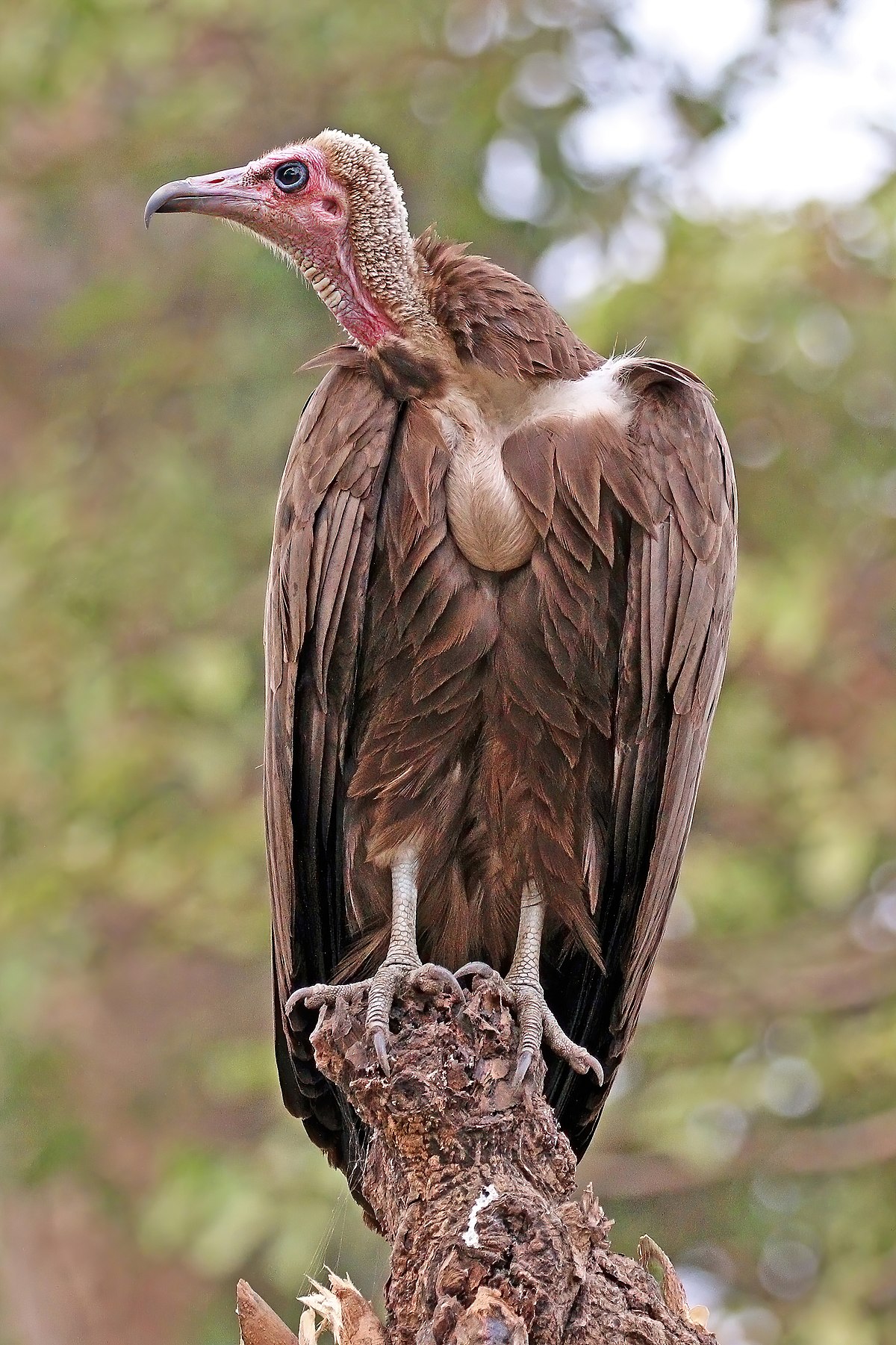
Wikipedia: Hooded vulture Quelle: OTHER
1200px-Hooded_vulture_%28Necrosyrtes_monachus%29.jpg
![]() Der Kappengeier (Necrosyrtes monachus) ist eine Greifvogelart aus der Familie der Habichtartigen und einziger Vertreter seiner Gattung.
[more]
Der Kappengeier (Necrosyrtes monachus) ist eine Greifvogelart aus der Familie der Habichtartigen und einziger Vertreter seiner Gattung.
[more]

Wikipedia: Lappet-faced vulture Quelle: OTHER
1200px-2012-lappet-faced-vulture.jpg
![]() Der Ohrengeier (Torgos tracheliotos, Syn.: Aegypius tracheliotus) ist ein sehr großer Vertreter der Altweltgeier (Aegypiinae). Er bewohnt weite Teile Afrikas sowie Teile der Arabischen Halbinsel. Aufgrund des anhaltenden Bestandsrückganges stuft die IUCN die Art weltweit als gefährdet ("vulnerable") ein.
[more]
Der Ohrengeier (Torgos tracheliotos, Syn.: Aegypius tracheliotus) ist ein sehr großer Vertreter der Altweltgeier (Aegypiinae). Er bewohnt weite Teile Afrikas sowie Teile der Arabischen Halbinsel. Aufgrund des anhaltenden Bestandsrückganges stuft die IUCN die Art weltweit als gefährdet ("vulnerable") ein.
[more]
Profil Wikipedia eBird Xeno-Canto
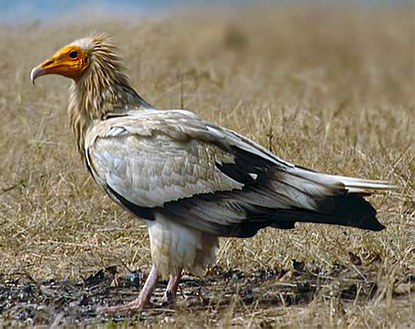
Wikipedia: Egyptian vulture Quelle: OTHER
Egyptian_vulture.jpg
![]() Der Schmutzgeier (Neophron percnopterus) ist ein Greifvogel aus der Familie der Habichtartigen. Er kommt von Südeuropa bis Zentralasien sowie in Afrika und Südasien vor. In Mitteleuropa ist der Schmutzgeier ein gelegentlicher Irrgast, die Zahl der Beobachtungen ist jedoch rückläufig, seit die südeuropäischen Bestände stark zurückgegangen sind.[1]
[more]
Der Schmutzgeier (Neophron percnopterus) ist ein Greifvogel aus der Familie der Habichtartigen. Er kommt von Südeuropa bis Zentralasien sowie in Afrika und Südasien vor. In Mitteleuropa ist der Schmutzgeier ein gelegentlicher Irrgast, die Zahl der Beobachtungen ist jedoch rückläufig, seit die südeuropäischen Bestände stark zurückgegangen sind.[1]
[more]
Vokalisierung: ![]() Almost never heard. May emit different grunting sounds and a slightly mallard-like "ga ga ga ga ga ga ga". [Link]
Almost never heard. May emit different grunting sounds and a slightly mallard-like "ga ga ga ga ga ga ga". [Link]
Körperlich: Länge=60-70 cm,
Flügelspanne=155-180 cm,
Gewicht=1600-2200 g

Wikipedia: Bearded vulture Quelle: OTHER
1200px-Bartgeier_Gypaetus_barbatus_front_Richard_Bartz.jpg
Allgemein: ![]() Der Bartgeier (Gypaetus barbatus) oder Lämmergeier ist ein Greifvogel aus der Familie der Habichtartigen (Accipitridae). Er bildet die einzige Art der gleichnamigen Gattung (Gypaetus). Traditionell zählte er zur Unterfamilie der Altweltgeier (Aegypiinae), ehe er aufgrund molekulargenetischer Untersuchungen mit dem Schmutzgeier und dem Palmgeier in eine eigene Unterfamilie (Gypaetinae) gestellt wurde.
[more]
Der Bartgeier (Gypaetus barbatus) oder Lämmergeier ist ein Greifvogel aus der Familie der Habichtartigen (Accipitridae). Er bildet die einzige Art der gleichnamigen Gattung (Gypaetus). Traditionell zählte er zur Unterfamilie der Altweltgeier (Aegypiinae), ehe er aufgrund molekulargenetischer Untersuchungen mit dem Schmutzgeier und dem Palmgeier in eine eigene Unterfamilie (Gypaetinae) gestellt wurde.
[more]
Rufe: ![]() Display call a thin whistling with several register breaks, reminiscent of Honey Buzzard (Pernis apivorus). A passerine-like trill is also sometimes heard, but generally not a vocal bird. [Link]
Display call a thin whistling with several register breaks, reminiscent of Honey Buzzard (Pernis apivorus). A passerine-like trill is also sometimes heard, but generally not a vocal bird. [Link]
Körperlich: Länge=100-115 cm,
Flügelspanne=266-282 cm,
Gewicht=5000-7000 g
Habitate:
Landwirtschaft
Profil Wikipedia eBird Xeno-Canto
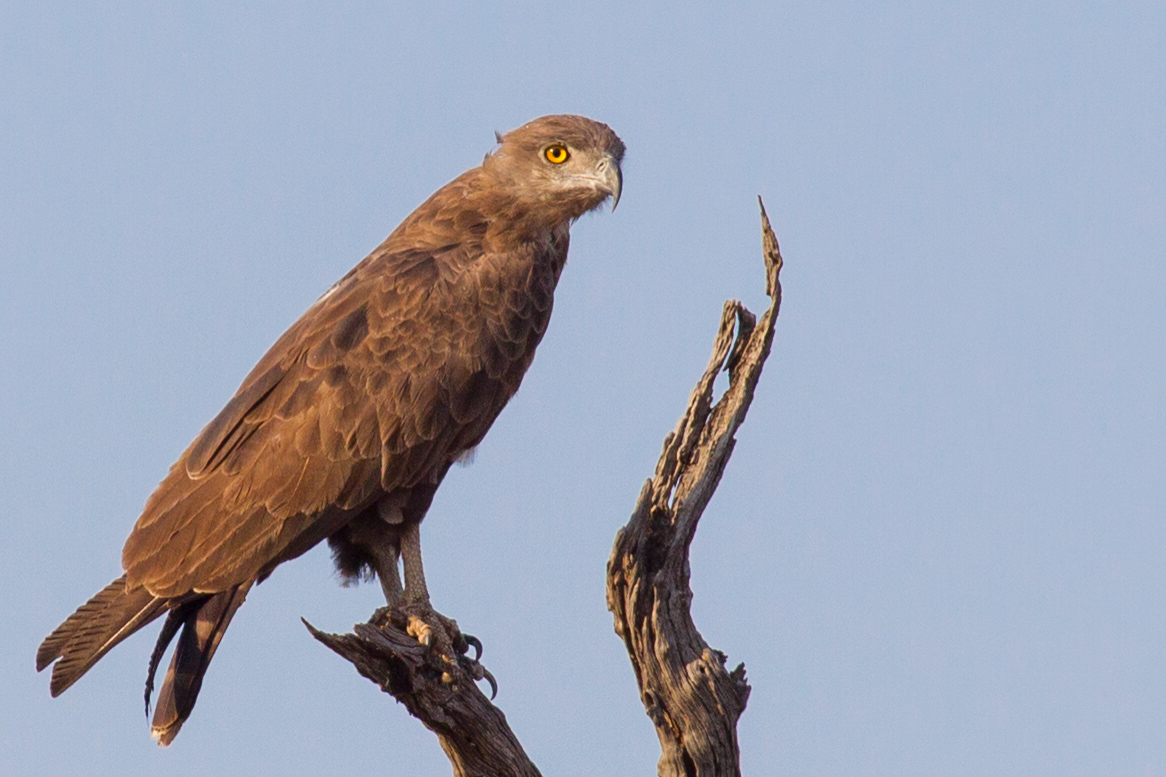
Wikipedia: Brown snake-eagle Quelle: OTHER
Brown_Snake_Eagle_%2811914065625%29.jpg
Allgemein: ![]() The brown snake eagle (Circaetus cinereus) is a fairly large species of bird of prey in the family Accipitridae. It is found in West, East and southern Africa. This species is an almost obligate predator of a variety of snakes. A very solitary bird, the brown snake eagle has a prolonged breeding cycle and raises a single eaglet. Although probably naturally scarce, it is classified as a Least concern species as it continues to occur over a very broad range.[1]
[more]
The brown snake eagle (Circaetus cinereus) is a fairly large species of bird of prey in the family Accipitridae. It is found in West, East and southern Africa. This species is an almost obligate predator of a variety of snakes. A very solitary bird, the brown snake eagle has a prolonged breeding cycle and raises a single eaglet. Although probably naturally scarce, it is classified as a Least concern species as it continues to occur over a very broad range.[1]
[more]

Wikipedia: Black-chested snake-eagle Quelle: OTHER
1200px-Black-chested_snake-eagle_%28Circaetus_pectoralis%29.jpg
![]() Der Schwarzbrust-Schlangenadler (Circaetus pectoralis) ist ein großer, in Afrika verbreiteter Greifvogel aus der Gattung der Schlangenadler (Circaetus) innerhalb der Familie der Habichtartigen (Accipitridae).
[more]
Der Schwarzbrust-Schlangenadler (Circaetus pectoralis) ist ein großer, in Afrika verbreiteter Greifvogel aus der Gattung der Schlangenadler (Circaetus) innerhalb der Familie der Habichtartigen (Accipitridae).
[more]
Profil Wikipedia eBird Xeno-Canto

Wikipedia: Fasciated snake-eagle Quelle: OTHER
Circaetus_fasciolatus%2C_Chiboma%2C_Sofala%2C_Birding_Weto%2C_a.jpg
![]() Der Graubrust-Schlangenadler (Circaetus fasciolatus) ist ein kleiner, im östlichen Subsahara-Afrika verbreiteter Greifvogel aus der Gattung der Schlangenadler (Circaetus) innerhalb der Familie der Habichtartigen (Accipitridae).
[more]
Der Graubrust-Schlangenadler (Circaetus fasciolatus) ist ein kleiner, im östlichen Subsahara-Afrika verbreiteter Greifvogel aus der Gattung der Schlangenadler (Circaetus) innerhalb der Familie der Habichtartigen (Accipitridae).
[more]
Profil Wikipedia eBird Xeno-Canto
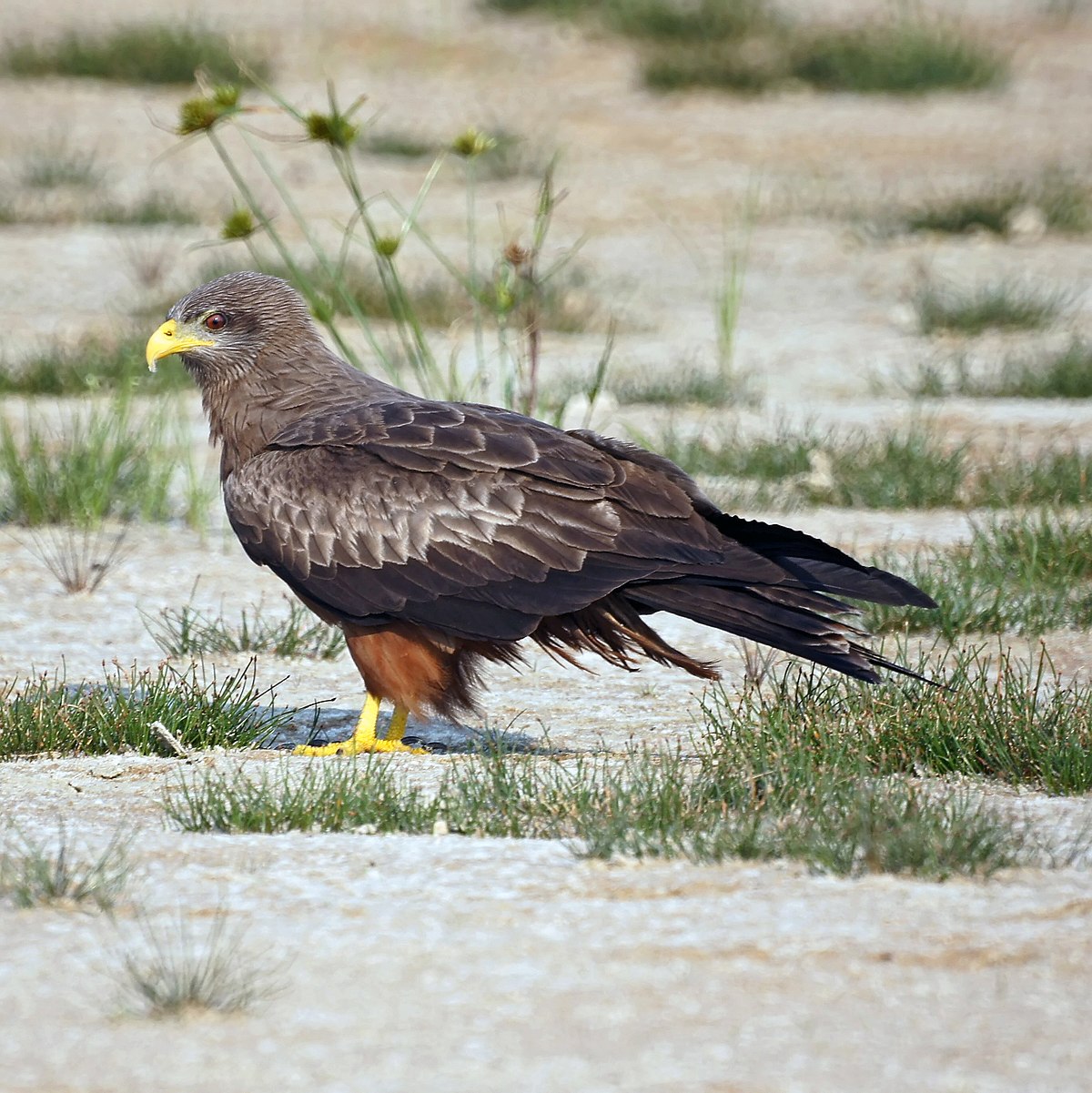
Wikipedia: Yellow-billed kite Quelle: OTHER
1200px-Milvus_aegyptius_-Limpopo%2C_South_Africa-8.jpg
![]() Der Schwarzmilan oder Schwarzer Milan (Milvus migrans) ist ein etwa mäusebussardgroßer Greifvogel aus der Familie der Habichtartigen (Accipitridae). Im Gegensatz zum nahe verwandten Rotmilan (Milvus milvus), dessen Brutgebiet sich im Wesentlichen auf Europa beschränkt, hat der Schwarzmilan ein riesiges Verbreitungsgebiet, das neben großen Teilen der Paläarktis weite Bereiche des indomalaiischen Faunengebietes sowie Australasien einschließt. Entsprechend dieser weiträumigen Verbreitung werden bis zu zwölf Unterarten beschrieben, von denen meist sieben als allgemein anerkannt gelten.
Unklar ist die Stellung der beiden gelbschnabeligen, in Afrika beheimateten Milane Milvus migrans aegyptius und Milvus migrans parasitus; sie werden sowohl als eigenständige Art Milvus aegyptius (mit der Unterart Milvus aegyptius parasitus) als auch weiter als Unterart von Milvus migrans geführt.[1][2]
[more]
Der Schwarzmilan oder Schwarzer Milan (Milvus migrans) ist ein etwa mäusebussardgroßer Greifvogel aus der Familie der Habichtartigen (Accipitridae). Im Gegensatz zum nahe verwandten Rotmilan (Milvus milvus), dessen Brutgebiet sich im Wesentlichen auf Europa beschränkt, hat der Schwarzmilan ein riesiges Verbreitungsgebiet, das neben großen Teilen der Paläarktis weite Bereiche des indomalaiischen Faunengebietes sowie Australasien einschließt. Entsprechend dieser weiträumigen Verbreitung werden bis zu zwölf Unterarten beschrieben, von denen meist sieben als allgemein anerkannt gelten.
Unklar ist die Stellung der beiden gelbschnabeligen, in Afrika beheimateten Milane Milvus migrans aegyptius und Milvus migrans parasitus; sie werden sowohl als eigenständige Art Milvus aegyptius (mit der Unterart Milvus aegyptius parasitus) als auch weiter als Unterart von Milvus migrans geführt.[1][2]
[more]

Wikipedia: European honey-buzzard Quelle: OTHER
1200px-Wespenbussard_European_honey_buzzard_Pernis_apivorus%2C_crop.jpg
![]() Der Wespenbussard (Pernis apivorus) ist eine Vogelart aus der Familie der Habichtartigen (Accipitridae). Er ist etwa so groß wie ein Mäusebussard. Die Art besiedelt den größten Teil Europas und das westliche Asien.
[more]
Der Wespenbussard (Pernis apivorus) ist eine Vogelart aus der Familie der Habichtartigen (Accipitridae). Er ist etwa so groß wie ein Mäusebussard. Die Art besiedelt den größten Teil Europas und das westliche Asien.
[more]
Rufe: ![]() Call an ascending, then descending; "pjuuuuu" much thinner than buzzards, and with a distinct register break when changing pitch. May be confused with newly fledged Buzzard chicks. [Link]
Call an ascending, then descending; "pjuuuuu" much thinner than buzzards, and with a distinct register break when changing pitch. May be confused with newly fledged Buzzard chicks. [Link]
Körperlich: Länge=52-60 cm,
Flügelspanne=135-150 cm,
Gewicht=360-1050 g
Habitate:
Landwirtschaft

Wikipedia: Wahlberg's eagle Quelle: OTHER
Aquila_wahlbergi.jpg
Allgemein: ![]() Wahlberg's eagle (Hieraaetus wahlbergi) is a bird of prey that is native to sub-Saharan Africa, where it is a seasonal migrant in the woodlands and savannas.[1]
It is named after the Swedish naturalist Johan August Wahlberg. Like all eagles, it belongs to the family Accipitridae.
[more]
Wahlberg's eagle (Hieraaetus wahlbergi) is a bird of prey that is native to sub-Saharan Africa, where it is a seasonal migrant in the woodlands and savannas.[1]
It is named after the Swedish naturalist Johan August Wahlberg. Like all eagles, it belongs to the family Accipitridae.
[more]
Profil Wikipedia eBird Xeno-Canto

Wikipedia: Ayres's hawk-eagle Quelle: OTHER
Ayres%27s_Hawk-eagle_flight_mabira_jan06.jpg
![]() Ayres's hawk-eagle (Hieraaetus ayresii), also referred to as Ayres' eagle,[2] is a medium-sized bird of prey in the family Accipitridae. It is native to African woodlands. Its name honors South African ornithologist Thomas Ayres.[3]
[more]
Ayres's hawk-eagle (Hieraaetus ayresii), also referred to as Ayres' eagle,[2] is a medium-sized bird of prey in the family Accipitridae. It is native to African woodlands. Its name honors South African ornithologist Thomas Ayres.[3]
[more]
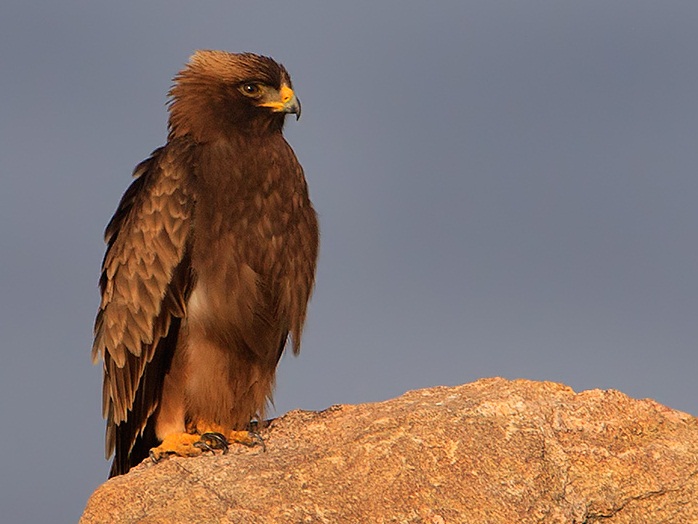
Wikipedia: Booted eagle Quelle: OTHER
MH_Booted.jpg
![]() Der Zwergadler (Hieraaetus pennatus, Syn.: Aquila pennata) ist ein mittelgroßer Greifvogel aus der Familie der Habichtartigen (Accipitridae). Das Artepitheton pennatus ist das lateinische Wort für befiedert und bezieht sich auf die bis zu den Zehen befiederten Beine. Daher rühren auch der englische Name (Booted Eagle), der französische (Aigle botté), die sich mit „gestiefelter Adler“ übersetzen lassen, und der spanische (águila calzada – „behoster Adler“).
[more]
Der Zwergadler (Hieraaetus pennatus, Syn.: Aquila pennata) ist ein mittelgroßer Greifvogel aus der Familie der Habichtartigen (Accipitridae). Das Artepitheton pennatus ist das lateinische Wort für befiedert und bezieht sich auf die bis zu den Zehen befiederten Beine. Daher rühren auch der englische Name (Booted Eagle), der französische (Aigle botté), die sich mit „gestiefelter Adler“ übersetzen lassen, und der spanische (águila calzada – „behoster Adler“).
[more]
Vokalisierung: ![]() Very vocal in breeding season. Most often heard is a quite soft, wader-like series of "kli-kli-kli-kli-kli-kli". [Link]
Very vocal in breeding season. Most often heard is a quite soft, wader-like series of "kli-kli-kli-kli-kli-kli". [Link]
Körperlich: Länge=45-53 cm,
Flügelspanne=100-121 cm,
Gewicht=510-1250 g
Profil Wikipedia eBird Xeno-Canto
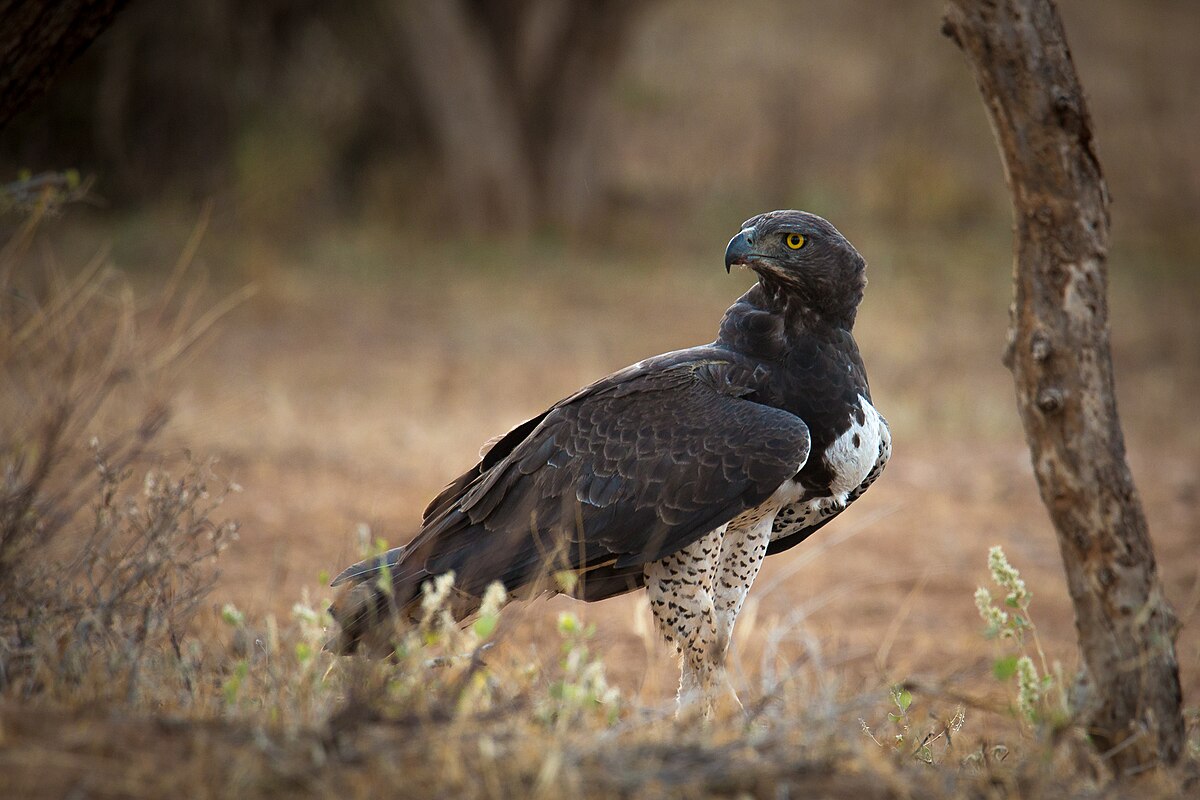
Wikipedia: Martial eagle Quelle: OTHER
1200px-Martial_Eagle_at_Samburu.jpg
Allgemein: ![]() The martial eagle (Polemaetus bellicosus) is a large eagle native to sub-Saharan Africa.[2] It is the only member of the genus Polemaetus. A species of the booted eagle subfamily (Aquilinae), it has feathering over its tarsus. One of the largest and most powerful species of booted eagle, it is a fairly opportunistic predator that varies its prey selection between mammals, birds and reptiles. Its hunting technique is unique as it is one of few eagle species known to hunt primarily from a high soar, by stooping on its quarry.[3] An inhabitant of wooded belts of otherwise open savanna, this species has shown a precipitous decline in the last few centuries due to a variety of factors. The martial eagle is one of the most persecuted bird species in the world. Due to its habit of taking livestock and regionally valuable game, local farmers and game wardens frequently seek to eliminate martial eagles, although the effect of eagles on this prey is almost certainly considerably exaggerated. Currently, the martial eagle is classified with the status of Endangered by the IUCN.[1][4][5]
[more]
The martial eagle (Polemaetus bellicosus) is a large eagle native to sub-Saharan Africa.[2] It is the only member of the genus Polemaetus. A species of the booted eagle subfamily (Aquilinae), it has feathering over its tarsus. One of the largest and most powerful species of booted eagle, it is a fairly opportunistic predator that varies its prey selection between mammals, birds and reptiles. Its hunting technique is unique as it is one of few eagle species known to hunt primarily from a high soar, by stooping on its quarry.[3] An inhabitant of wooded belts of otherwise open savanna, this species has shown a precipitous decline in the last few centuries due to a variety of factors. The martial eagle is one of the most persecuted bird species in the world. Due to its habit of taking livestock and regionally valuable game, local farmers and game wardens frequently seek to eliminate martial eagles, although the effect of eagles on this prey is almost certainly considerably exaggerated. Currently, the martial eagle is classified with the status of Endangered by the IUCN.[1][4][5]
[more]

Wikipedia: Crowned hawk-eagle Quelle: OTHER
1200px-Crowned_Eagle_%28Stephanoaetus_coronatus%29%2C_at_Ndumo_Nature_Reserve%2C_KwaZulu-Natal%2C_South_Africa_%2828842574882%29.jpg
![]() Der Kronenadler (Stephanoaetus coronatus) ist einer der größten Adler Afrikas und der einzige rezente Vertreter der Gattung Stephanoaetus. Er bewohnt die tropischen Wälder und ernährt sich vor allem von mittelgroßen Säugetieren, im tropischen Regenwald vor allem von Affen. Der auffällig gefärbte und sehr kompakt gebaute Adler zählt zu den physisch stärksten Greifvögeln und erbeutet regelmäßig Tiere, die sein Eigengewicht erheblich übertreffen. Die Art gilt als ungefährdet.
[more]
Der Kronenadler (Stephanoaetus coronatus) ist einer der größten Adler Afrikas und der einzige rezente Vertreter der Gattung Stephanoaetus. Er bewohnt die tropischen Wälder und ernährt sich vor allem von mittelgroßen Säugetieren, im tropischen Regenwald vor allem von Affen. Der auffällig gefärbte und sehr kompakt gebaute Adler zählt zu den physisch stärksten Greifvögeln und erbeutet regelmäßig Tiere, die sein Eigengewicht erheblich übertreffen. Die Art gilt als ungefährdet.
[more]

Wikipedia: African baza Quelle: OTHER
Aviceda_cuculoides00.jpg
![]() The African cuckoo-hawk, or African baza, (Aviceda cuculoides) is a medium-sized raptor in the family Accipitridae so named because it resembles the common cuckoo, which is found in sub-Saharan Africa and along the eastern parts of Southern Africa. It prefers dense woodland and forest of either indigenous or exotic trees.
[more]
The African cuckoo-hawk, or African baza, (Aviceda cuculoides) is a medium-sized raptor in the family Accipitridae so named because it resembles the common cuckoo, which is found in sub-Saharan Africa and along the eastern parts of Southern Africa. It prefers dense woodland and forest of either indigenous or exotic trees.
[more]
Profil Wikipedia eBird Xeno-Canto NABU
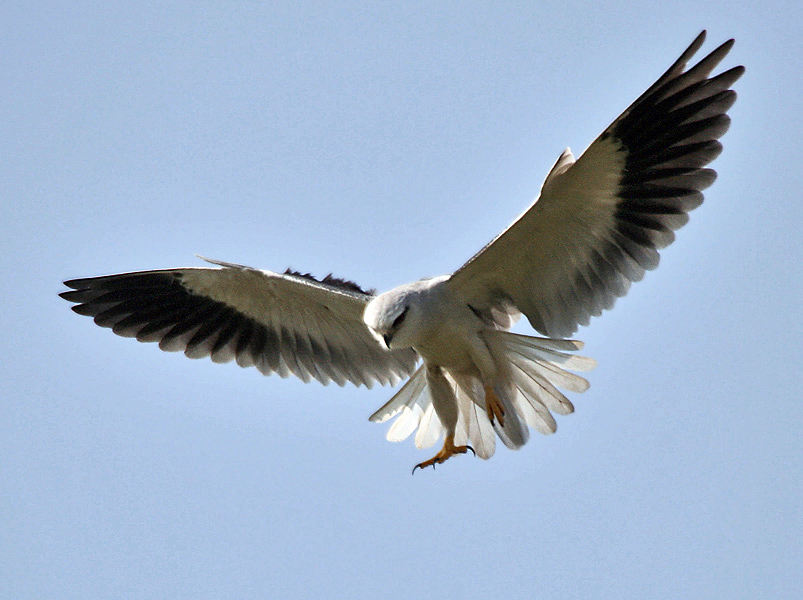
Wikipedia: Black-winged kite Quelle: OTHER
Black-shouldered_Kite_%28Elanus_caeruleus%29_in_Hyderabad_W_IMG_4418.jpg
![]() Der Gleitaar (Elanus caeruleus) ist eine Vogelart aus der Familie der Habichtartigen (Accipitridae). In Mitteleuropa ist er ein sehr seltener Irrgast, der vor allem in West- und Südmitteleuropa beobachtet wird.[1]
[more]
Der Gleitaar (Elanus caeruleus) ist eine Vogelart aus der Familie der Habichtartigen (Accipitridae). In Mitteleuropa ist er ein sehr seltener Irrgast, der vor allem in West- und Südmitteleuropa beobachtet wird.[1]
[more]
Profil Wikipedia eBird Xeno-Canto

Wikipedia: Palm-nut vulture Quelle: OTHER
Flickr_-_Rainbirder_-_Palm-nut_Vulture.jpg
![]() Der Palmgeier (Gypohierax angolensis) ist ein Greifvogel aus der Familie der Habichtartigen (Accipitridae). Die Gattung Gypohierax ist monotypisch mit dem Palmgeier als einziger Art. Das geschlossene Verbreitungsgebiet erstreckt sich über weite Teile der zentralen und westlichen Afrotropis. In der östlichen Afrotropis sind die Vorkommen disjunkt und weitgehend auf die Küsten beschränkt. Die Art bewohnt in erster Linie Wald und Waldland, oder mit Wald durchsetzte landwirtschaftliche Flächen meist in Wassernähe. In den besiedelten Landschaften gibt es fast immer Vorkommen von Palmen der Gattung Raphia oder Ölpalmen, deren Früchte einen erheblichen Teil der Nahrung des Palmgeiers ausmachen. Die Tiere bewohnen daher auch die Randbereiche von Ölpalmenplantagen.
Die Art ist recht häufig und der Bestand offenbar stabil. Die Bestandssituation des Palmgeiers wurde 2016 in der Roten Liste gefährdeter Arten der IUCN als „Least Concern (LC)“ = „nicht gefährdet“ eingestuft.[1]
[more]
Der Palmgeier (Gypohierax angolensis) ist ein Greifvogel aus der Familie der Habichtartigen (Accipitridae). Die Gattung Gypohierax ist monotypisch mit dem Palmgeier als einziger Art. Das geschlossene Verbreitungsgebiet erstreckt sich über weite Teile der zentralen und westlichen Afrotropis. In der östlichen Afrotropis sind die Vorkommen disjunkt und weitgehend auf die Küsten beschränkt. Die Art bewohnt in erster Linie Wald und Waldland, oder mit Wald durchsetzte landwirtschaftliche Flächen meist in Wassernähe. In den besiedelten Landschaften gibt es fast immer Vorkommen von Palmen der Gattung Raphia oder Ölpalmen, deren Früchte einen erheblichen Teil der Nahrung des Palmgeiers ausmachen. Die Tiere bewohnen daher auch die Randbereiche von Ölpalmenplantagen.
Die Art ist recht häufig und der Bestand offenbar stabil. Die Bestandssituation des Palmgeiers wurde 2016 in der Roten Liste gefährdeter Arten der IUCN als „Least Concern (LC)“ = „nicht gefährdet“ eingestuft.[1]
[more]
Profil Wikipedia eBird Xeno-Canto

Wikipedia: Bateleur Quelle: OTHER
Bateleur_Eagle_with_Kill.jpg
![]() Der Gaukler (Terathopius ecaudatus) ist eine Greifvogelart aus der Unterfamilie der Schlangenadler (Circaetinae), die in großen Teilen Subsahara-Afrikas vorkommt und offene oder halboffene Savannenlandschaften bewohnt. Der Gaukler ernährt sich größtenteils von kleineren bis mittelgroßen Vögeln und Säugetieren, die er erjagt, aber auch von Aas. Er fällt durch seine ausgedehnten, relativ niedrigen, „gaukelnden“ Suchflüge auf, bei denen er die Flügel in einem tiefen V hält und seitlich hin- und herschaukelt. Zudem ist die akrobatische Flugbalz recht spektakulär.
[more]
Der Gaukler (Terathopius ecaudatus) ist eine Greifvogelart aus der Unterfamilie der Schlangenadler (Circaetinae), die in großen Teilen Subsahara-Afrikas vorkommt und offene oder halboffene Savannenlandschaften bewohnt. Der Gaukler ernährt sich größtenteils von kleineren bis mittelgroßen Vögeln und Säugetieren, die er erjagt, aber auch von Aas. Er fällt durch seine ausgedehnten, relativ niedrigen, „gaukelnden“ Suchflüge auf, bei denen er die Flügel in einem tiefen V hält und seitlich hin- und herschaukelt. Zudem ist die akrobatische Flugbalz recht spektakulär.
[more]

Wikipedia: Long-crested eagle Quelle: OTHER
1200px-Long-crested_eagle_%28Lophaetus_occipitalis%29_Uganda.jpg
![]() The long-crested eagle (Lophaetus occipitalis) is an African bird of prey. Like all eagles, it is in the family Accipitridae. It is currently placed in a monotypic genus Lophaetus.
[more]
The long-crested eagle (Lophaetus occipitalis) is an African bird of prey. Like all eagles, it is in the family Accipitridae. It is currently placed in a monotypic genus Lophaetus.
[more]

Wikipedia: Dark chanting-goshawk Quelle: OTHER
1200px-Melierax_metabates_-Kapama_Game_Reserve%2C_South_Africa-8-4c.jpg
![]() The dark chanting goshawk (Melierax metabates) is a bird of prey in the family Accipitridae which is found across much of sub-Saharan Africa and southern Arabia, with an isolated and declining population in southern Morocco.
[more]
The dark chanting goshawk (Melierax metabates) is a bird of prey in the family Accipitridae which is found across much of sub-Saharan Africa and southern Arabia, with an isolated and declining population in southern Morocco.
[more]
Profil Wikipedia eBird Xeno-Canto

Wikipedia: Pale chanting-goshawk Quelle: OTHER
1200px-Melierax_canorus-01.jpg
![]() The (southern) pale chanting goshawk (Melierax canorus) is a bird of prey in the family Accipitridae.
This hawk breeds in southern Africa and is a resident species of dry, open semi-desert with 75 cm or less annual rainfall. It is commonly seen perched on roadside telephone poles.
[more]
The (southern) pale chanting goshawk (Melierax canorus) is a bird of prey in the family Accipitridae.
This hawk breeds in southern Africa and is a resident species of dry, open semi-desert with 75 cm or less annual rainfall. It is commonly seen perched on roadside telephone poles.
[more]
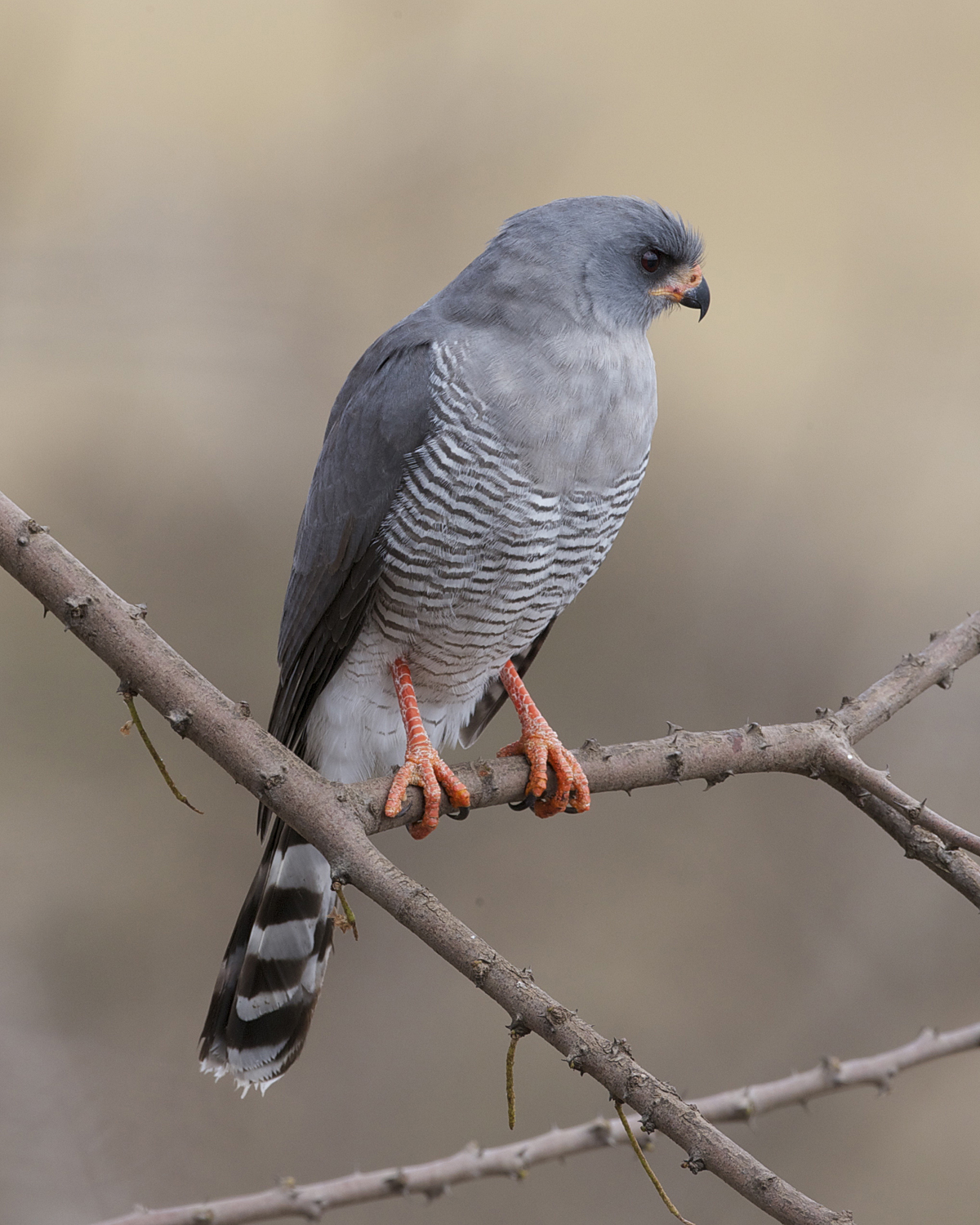
Wikipedia: Gabar goshawk Quelle: OTHER
Gabar_Goshawk_%28Micronisus_gabar%29.jpg
![]() The gabar goshawk (Micronisus gabar) is a small species of African and Arabian bird of prey in the family Accipitridae.
[more]
The gabar goshawk (Micronisus gabar) is a small species of African and Arabian bird of prey in the family Accipitridae.
[more]
Profil Wikipedia eBird Xeno-Canto

Wikipedia: Bat hawk Quelle: OTHER
1200px-MacheiramphusAlcinus.jpg
![]() Der Fledermausaar (Macheiramphus alcinus) ist ein Greifvogel aus der Familie der Habichtartigen. Die räumlich stark voneinander getrennten Verbreitungsgebiete umfassen das zentrale und westliche Afrika südlich der Sahara, kleine Bereiche Madagaskars, die Malaiische Halbinsel und große Teile Indonesiens sowie den Südosten Neuguineas. Die Art bewohnt immergrüne tropische Wälder. Die Tiere ernähren sich vorrangig von Fledermäusen und kleinen Vögeln, als einer von nur wenigen Greifvögeln jagt der Fledermausaar nach Einbruch der Dämmerung. Fledermausaare brüten in großen Teilen des Verbreitungsgebietes nicht zu festen Jahreszeiten, die Brutzeit richtet sich weitgehend nach dem Nahrungsangebot.
[more]
Der Fledermausaar (Macheiramphus alcinus) ist ein Greifvogel aus der Familie der Habichtartigen. Die räumlich stark voneinander getrennten Verbreitungsgebiete umfassen das zentrale und westliche Afrika südlich der Sahara, kleine Bereiche Madagaskars, die Malaiische Halbinsel und große Teile Indonesiens sowie den Südosten Neuguineas. Die Art bewohnt immergrüne tropische Wälder. Die Tiere ernähren sich vorrangig von Fledermäusen und kleinen Vögeln, als einer von nur wenigen Greifvögeln jagt der Fledermausaar nach Einbruch der Dämmerung. Fledermausaare brüten in großen Teilen des Verbreitungsgebietes nicht zu festen Jahreszeiten, die Brutzeit richtet sich weitgehend nach dem Nahrungsangebot.
[more]
Sperberbussard / Lizard buzzard (Kaupifalco monogrammicus)
Profil Wikipedia eBird Xeno-Canto

Wikipedia: Lizard buzzard Quelle: OTHER
Lizard_buzzard_%28Kaupifalco_monogrammicus%29.jpg
![]() Der Sperberbussard (Kaupifalco monogrammicus), auch Kehlstreifbussard genannt, ist ein in Afrika weit verbreiteter Vertreter der Familie der Habichtartigen.
[more]
Der Sperberbussard (Kaupifalco monogrammicus), auch Kehlstreifbussard genannt, ist ein in Afrika weit verbreiteter Vertreter der Familie der Habichtartigen.
[more]
Schreiadler / Lesser spotted eagle (Clanga pomarina)
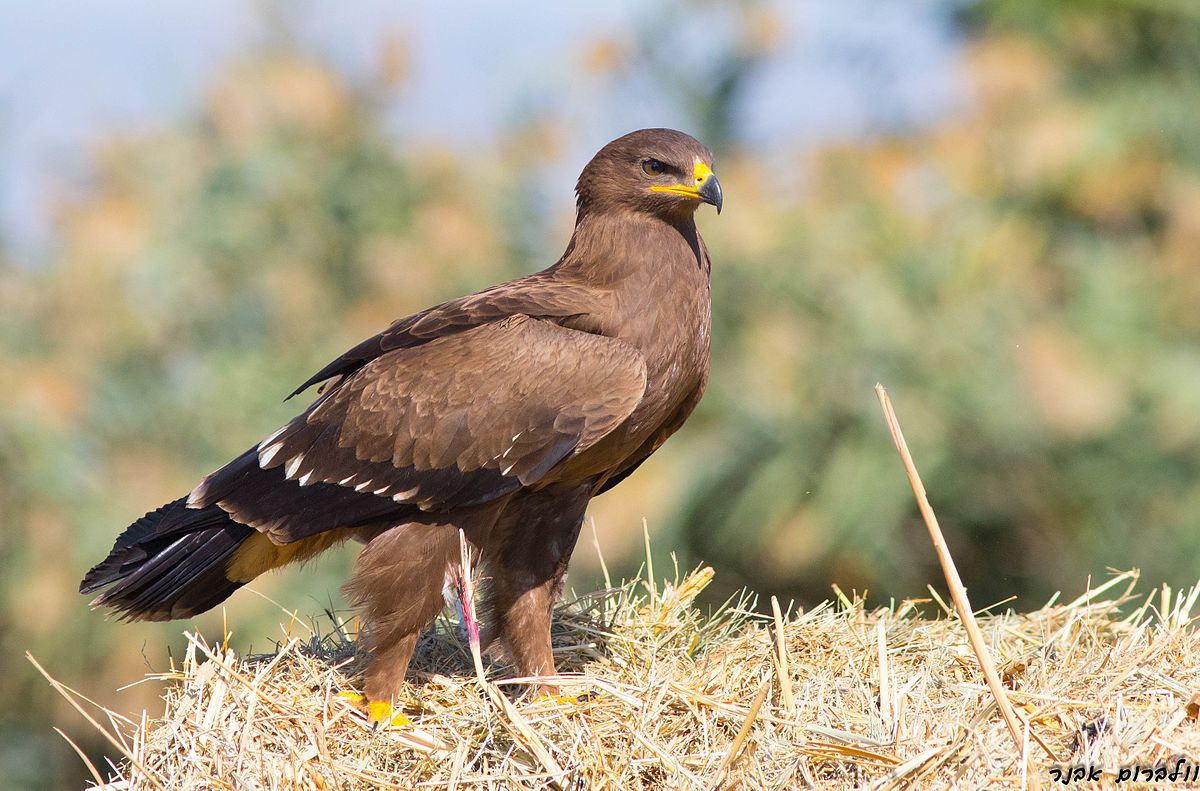
Wikipedia: Lesser spotted eagle Quelle: OTHER
1200px-%D7%A2%D7%99%D7%98_%D7%97%D7%95%D7%A8%D7%A9.jpg
![]() Der Schreiadler (Clanga pomarina, Syn.: Aquila pomarina)[1], veraltet auch Pommernadler genannt, ist eine Vogelart aus der Familie der Habichtartigen (Accipitridae). Dieser vergleichsweise kleine Vertreter der Unterfamilie der Aquilinae hat ein relativ kleines Verbreitungsgebiet im Westen der Paläarktis; die westliche Arealgrenze verläuft durch den Osten Deutschlands. Das Epitheton pomarina bezieht sich auf die Herkunft des Holotypus aus der ehemaligen preußischen Provinz Pommern.[2] Die Art bewohnt naturnahe Wälder mit angrenzenden extensiv genutzten Flächen und ernährt sich vor allem von kleinen Wirbeltieren, aber auch von Insekten und anderen Wirbellosen sowie Aas.
[more]
Der Schreiadler (Clanga pomarina, Syn.: Aquila pomarina)[1], veraltet auch Pommernadler genannt, ist eine Vogelart aus der Familie der Habichtartigen (Accipitridae). Dieser vergleichsweise kleine Vertreter der Unterfamilie der Aquilinae hat ein relativ kleines Verbreitungsgebiet im Westen der Paläarktis; die westliche Arealgrenze verläuft durch den Osten Deutschlands. Das Epitheton pomarina bezieht sich auf die Herkunft des Holotypus aus der ehemaligen preußischen Provinz Pommern.[2] Die Art bewohnt naturnahe Wälder mit angrenzenden extensiv genutzten Flächen und ernährt sich vor allem von kleinen Wirbeltieren, aber auch von Insekten und anderen Wirbellosen sowie Aas.
[more]
Vokalisierung: ![]() Vocal at breeding ground, and when courting. Short, barking, high-pitched whistles, not unlike a small dog. Slightly higher pitched than C. clanga and with a purer tone, but very similar. [Link]
Vocal at breeding ground, and when courting. Short, barking, high-pitched whistles, not unlike a small dog. Slightly higher pitched than C. clanga and with a purer tone, but very similar. [Link]
Körperlich: Länge=60-65 cm,
Flügelspanne=134-159 cm,
Gewicht=1100-2000 g
Gesang:
Automatically generated from Xeno-Canto recording
Gesang Eigenschaften:
Frequency:
♫ Quelle: BirdNet
2020-07-01 08.18.50 four note call - birdnet suggested lesser spotted eagle which doesnt occur here, next song thrush.mp3
2020-07-01 08.18.50 Luppmen (Gesang)
Sekretär (Vogel) / Secretarybird (Sagittarius serpentarius)
Profil Wikipedia eBird Xeno-Canto

Secretarybird 2. 2016-09-13 14.10.50 Namibia
Zuerst beobachtet in Namibia an 2016-09-13.
Allgemein: ![]() Der Sekretär (Sagittarius serpentarius) ist eine große Greifvogelart, die weite Teile des afrikanischen Kontinents südlich der Sahara bewohnt. Er besiedelt offene und halboffene Savannenlandschaften und ernährt sich überwiegend von Großinsekten und kleinen Säugetieren, die er mit Fußtritten der langen Beine tötet. Aber auch andere Kleintiere gehören zu seiner Beute. Unter anderem ist er auch in der Lage, giftige Schlangen zu erjagen. In Gebieten mit günstigen Bedingungen besetzen manche Paare über viele Jahre ein Revier, anderswo lebt die Art stark nomadisch. Bruten finden meist zur Regenzeit statt, wenn die meiste Nahrung verfügbar ist. In den Kronen niedriger Bäume werden dann große Nestplattformen errichtet, die denen von Störchen ähneln. Aufgrund starker Bestandsrückgänge wird die Art von der IUCN als gefährdet (“vulnerable”) angesehen.
[more]
Der Sekretär (Sagittarius serpentarius) ist eine große Greifvogelart, die weite Teile des afrikanischen Kontinents südlich der Sahara bewohnt. Er besiedelt offene und halboffene Savannenlandschaften und ernährt sich überwiegend von Großinsekten und kleinen Säugetieren, die er mit Fußtritten der langen Beine tötet. Aber auch andere Kleintiere gehören zu seiner Beute. Unter anderem ist er auch in der Lage, giftige Schlangen zu erjagen. In Gebieten mit günstigen Bedingungen besetzen manche Paare über viele Jahre ein Revier, anderswo lebt die Art stark nomadisch. Bruten finden meist zur Regenzeit statt, wenn die meiste Nahrung verfügbar ist. In den Kronen niedriger Bäume werden dann große Nestplattformen errichtet, die denen von Störchen ähneln. Aufgrund starker Bestandsrückgänge wird die Art von der IUCN als gefährdet (“vulnerable”) angesehen.
[more]
Fischadler / Osprey (Pandion haliaetus)
Osprey in flight. 2023-09-27 12.22.08 Florida
Zuerst beobachtet in Yucatan an 2023-04-21.
Dieser Vogel erscheint jenseits grossen Meere in Kontinenten :
Europa, Nordamerika, Südamerika, Afrika, Asien.
![]() Der Fischadler (Pandion haliaetus) ist eine Vogelart aus der Ordnung der Greifvögel (Accipitriformes). Aufgrund zahlreicher besonderer Merkmale wird die Art meist in eine eigene Familie Pandionidae gestellt, diese Familie und die Gattung Pandion sind damit monotypisch. Die Art ist fast weltweit verbreitet und kommt auch in Mitteleuropa vor.
[more]
Der Fischadler (Pandion haliaetus) ist eine Vogelart aus der Ordnung der Greifvögel (Accipitriformes). Aufgrund zahlreicher besonderer Merkmale wird die Art meist in eine eigene Familie Pandionidae gestellt, diese Familie und die Gattung Pandion sind damit monotypisch. Die Art ist fast weltweit verbreitet und kommt auch in Mitteleuropa vor.
[more]
Rufe: ![]() Calls with sequences of short, soft and clear whistling notes. Often in series with rising pitch, then ending with a few lower pitched notes. [Link]
Calls with sequences of short, soft and clear whistling notes. Often in series with rising pitch, then ending with a few lower pitched notes. [Link]
Körperlich: Länge=55-58 cm,
Flügelspanne=145-170 cm,
Gewicht=1120-2050 g
Habitate:
Landwirtschaft
Gesang:
Automatically generated from Xeno-Canto recording
Gesang Eigenschaften:
Frequency:
♫ 2023-10-12 15 55 surprising sound of an osprey. 2023-10-12 15.55.00 New England (Gesang)
Ostriches. 2016-09-14 16.29.48 Namibia
Zuerst beobachtet in Gqeberha (frueher Port Elisabeth) an 2009-10-20.
Allgemein: ![]() Der Afrikanische Strauß (Struthio camelus) ist eine Vogelart aus der Familie der Strauße und ist nach dem eng verwandten Somalistrauß der größte lebende Vogel der Erde. Während er heute nur noch in Afrika südlich der Sahara heimisch ist, war er in früheren Zeiten auch in Westasien beheimatet. Für den Menschen war der Strauß wegen seiner Federn, seines Fleisches und seines Leders seit jeher von Interesse, was in vielen Regionen zur Ausrottung des Vogels führte.
[more]
Der Afrikanische Strauß (Struthio camelus) ist eine Vogelart aus der Familie der Strauße und ist nach dem eng verwandten Somalistrauß der größte lebende Vogel der Erde. Während er heute nur noch in Afrika südlich der Sahara heimisch ist, war er in früheren Zeiten auch in Westasien beheimatet. Für den Menschen war der Strauß wegen seiner Federn, seines Fleisches und seines Leders seit jeher von Interesse, was in vielen Regionen zur Ausrottung des Vogels führte.
[more]
Profil Wikipedia eBird Xeno-Canto
![]()
Wikipedia: Abdim's stork Quelle: OTHER
Ciconia_abdimii_-London_Zoo-8a.jpg
![]() Der Abdimstorch, Regenstorch oder Abdim (Ciconia abdimii) ist eine afrikanische Art der Störche. Er ist ein naher Verwandter der europäischen Arten Weißstorch und Schwarzstorch.
[more]
Der Abdimstorch, Regenstorch oder Abdim (Ciconia abdimii) ist eine afrikanische Art der Störche. Er ist ein naher Verwandter der europäischen Arten Weißstorch und Schwarzstorch.
[more]
![]()
Wikipedia: Woolly-necked stork Quelle: OTHER
Woolly-necked_Stork_%28Ciconia_episcopus%29_Photograph_By_Shantanu_Kuveskar.jpg
![]() Der Wollhalsstorch (Ciconia episcopus) ist mit etwa 80 bis 90 Zentimetern ein großer Schreitvogel, der in drei Unterarten vorkommt und zur Familie der Störche (Ciconiidae) gehört.
[more]
Der Wollhalsstorch (Ciconia episcopus) ist mit etwa 80 bis 90 Zentimetern ein großer Schreitvogel, der in drei Unterarten vorkommt und zur Familie der Störche (Ciconiidae) gehört.
[more]
Profil Wikipedia eBird Vogelwarte BirdLife ZH ornitho.ch Xeno-Canto BirdID NABU
Schwarzstorch zum ersten Mal gesehen bei Degersheim! 2024-04-27 10.50.00 Schachen, Tobel Wissbach till Degersheim
Zuerst beobachtet in 🇨🇭 an 2024-04-27.
![]() Der Schwarzstorch (Ciconia nigra) ist neben dem Weißstorch (Ciconia ciconia) die einzige in Europa brütende Art aus der Vogelfamilie der Störche (Ciconiidae).
[more]
Der Schwarzstorch (Ciconia nigra) ist neben dem Weißstorch (Ciconia ciconia) die einzige in Europa brütende Art aus der Vogelfamilie der Störche (Ciconiidae).
[more]
Vokalisierung: ![]() Thin, disyllabic "ahhh-li" heard at nest and when courting. One syllable sounds like gasping intake of air, the other is a thin, piping sound. A bit like a cheap, manual, air-mattress pump. Bill-clattering used by juveniles in alarm. [Link]
Thin, disyllabic "ahhh-li" heard at nest and when courting. One syllable sounds like gasping intake of air, the other is a thin, piping sound. A bit like a cheap, manual, air-mattress pump. Bill-clattering used by juveniles in alarm. [Link]
Körperlich: Länge=95-100 cm,
Flügelspanne=145-155 cm,
Gewicht=3000 g
Habitate:
Nassgebiet
Profil Wikipedia eBird Xeno-Canto NABU

Wikipedia: Yellow-billed stork Quelle: OTHER
1200px-Yellow-billed_Stork_%28Mycteria_ibis%29_%286045310265%29.jpg
Allgemein: ![]() Der Nimmersatt (Mycteria ibis) ist ein Vogel aus der Familie der Störche (Ciconiidae). Die den Ibissen ähnlich sehenden Nimmersattstörche sind in Afrika südlich der Sahara und auf Madagaskar verbreitet.
[more]
Der Nimmersatt (Mycteria ibis) ist ein Vogel aus der Familie der Störche (Ciconiidae). Die den Ibissen ähnlich sehenden Nimmersattstörche sind in Afrika südlich der Sahara und auf Madagaskar verbreitet.
[more]
Marabu stork. 2016-09-23 17.48.46 Botswana
Zuerst beobachtet in Botswana an 2016-09-23.
![]() Der Marabu (Leptoptilos crumeniferus) ist eine in Afrika vorkommende Vogelart aus der Familie der Störche (Ciconiidae). Der Marabu ist im subsaharischen Afrika beheimatet. Auf Grund seiner Anpassungsfähigkeit ist er stellenweise recht häufig und als Abfall- und Unratbeseitiger in menschlichen Siedlungen gern gesehen.
[more]
Der Marabu (Leptoptilos crumeniferus) ist eine in Afrika vorkommende Vogelart aus der Familie der Störche (Ciconiidae). Der Marabu ist im subsaharischen Afrika beheimatet. Auf Grund seiner Anpassungsfähigkeit ist er stellenweise recht häufig und als Abfall- und Unratbeseitiger in menschlichen Siedlungen gern gesehen.
[more]
Profil Wikipedia eBird Xeno-Canto

Wikipedia: Saddle-billed stork Quelle: OTHER
1200px-Ephippiorhynchus_senegalensis_-Kruger_National_Park%2C_Limpopo%2C_South_Africa-8.jpg
![]() Der Sattelstorch (Ephippiorhynchus senegalensis) ist ein in Afrika lebender Schreitvogel.
[more]
Der Sattelstorch (Ephippiorhynchus senegalensis) ist ein in Afrika lebender Schreitvogel.
[more]
Profil Wikipedia eBird Xeno-Canto
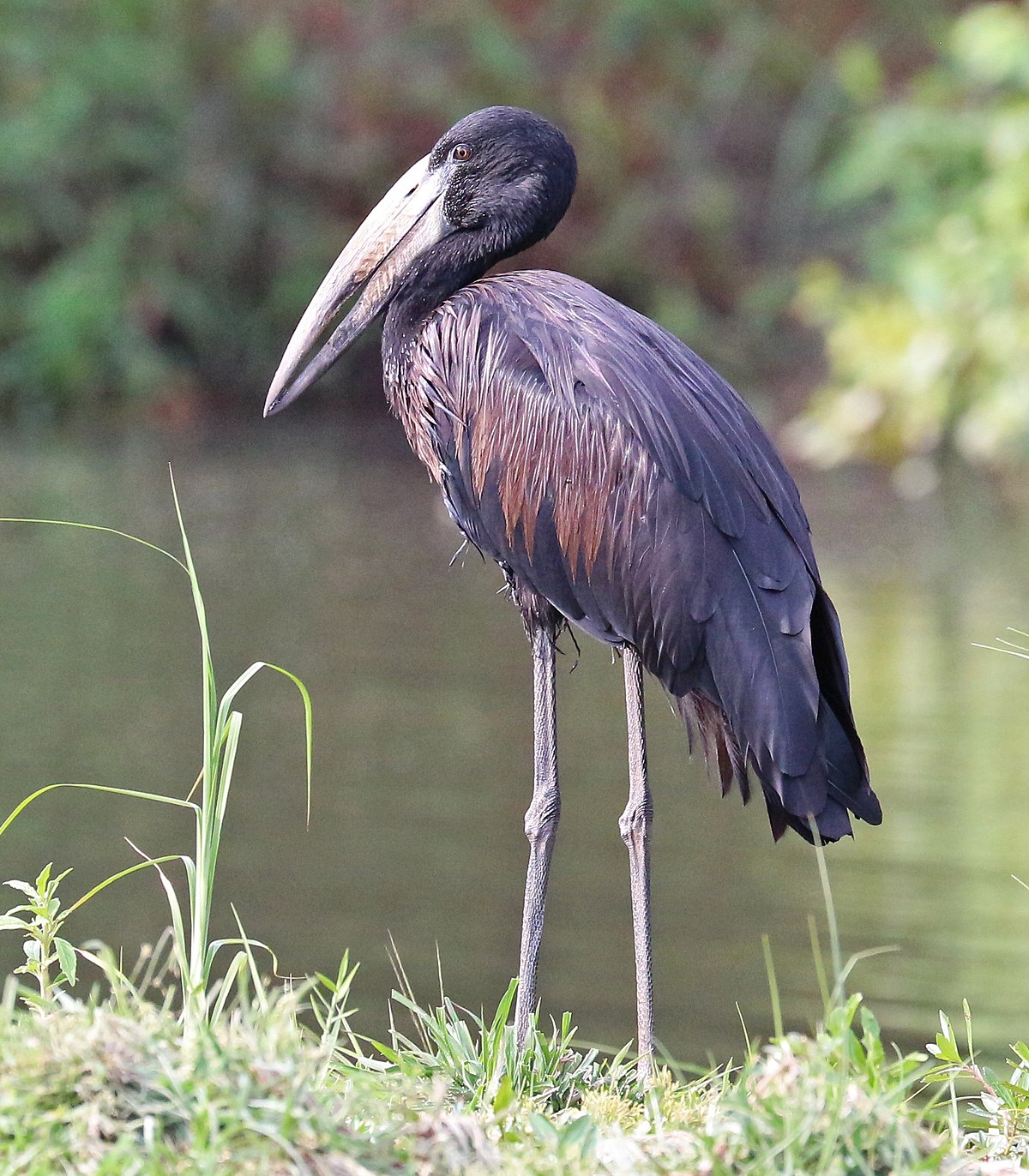
Wikipedia: African openbill Quelle: OTHER
1200px-African_openbill%2C_Zimbabwe%2C_crop.jpg
![]() Der Mohrenklaffschnabel (Anastomus lamelligerus) ist eine Art aus der Familie der Störche (Ciconiidae). Die Nominatform (A. l. lamelligerus) lebt als Brutvogel im tropischen Afrika südlich der Sahara und nördlich des Südlichen Wendekreis, die Unterart (A. l. madagaskarensis) im westlichen Madagaskar. Die Bestände des Vogels sind nach Angaben der IUCN nicht gefährdet.
[more]
Der Mohrenklaffschnabel (Anastomus lamelligerus) ist eine Art aus der Familie der Störche (Ciconiidae). Die Nominatform (A. l. lamelligerus) lebt als Brutvogel im tropischen Afrika südlich der Sahara und nördlich des Südlichen Wendekreis, die Unterart (A. l. madagaskarensis) im westlichen Madagaskar. Die Bestände des Vogels sind nach Angaben der IUCN nicht gefährdet.
[more]
Profil Wikipedia eBird Xeno-Canto
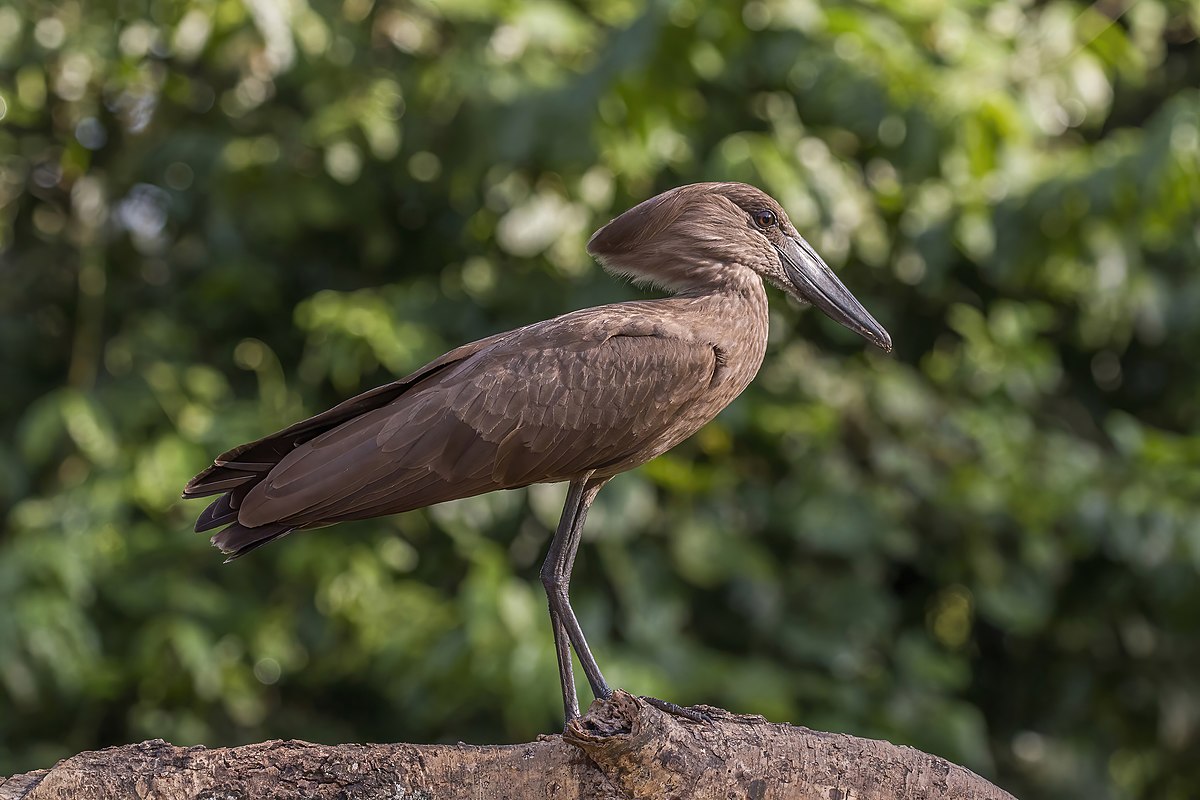
Wikipedia: Hamerkop Quelle: OTHER
1200px-Hamerkop_%28Scopus_umbretta_umbretta%29.jpg
![]() Der Hammerkopf oder Schattenvogel (Scopus umbretta) ist ein bis zu 56 cm großer Wasservogel, der in Afrika südlich der Sahara weit verbreitet ist. Weil seine näheren Verwandtschaftsverhältnisse ungeklärt sind, wird er meistens einer eigenen Familie Scopidae zugeordnet.
[more]
Der Hammerkopf oder Schattenvogel (Scopus umbretta) ist ein bis zu 56 cm großer Wasservogel, der in Afrika südlich der Sahara weit verbreitet ist. Weil seine näheren Verwandtschaftsverhältnisse ungeklärt sind, wird er meistens einer eigenen Familie Scopidae zugeordnet.
[more]
Profil Wikipedia eBird Xeno-Canto

Wikipedia: Namaqua sandgrouse Quelle: OTHER
1200px-2012-namaqua-sandgrouse-male.jpg
![]() The Namaqua sandgrouse (Pterocles namaqua), is a species of ground-dwelling bird in the sandgrouse family. It is found in arid regions of south-western Africa.
[more]
The Namaqua sandgrouse (Pterocles namaqua), is a species of ground-dwelling bird in the sandgrouse family. It is found in arid regions of south-western Africa.
[more]
Profil Wikipedia eBird Xeno-Canto

Wikipedia: Yellow-throated sandgrouse
![]() The yellow-throated sandgrouse (Pterocles gutturalis) is a species of bird in the family Pteroclidae.
[more]
The yellow-throated sandgrouse (Pterocles gutturalis) is a species of bird in the family Pteroclidae.
[more]
Profil Wikipedia eBird Xeno-Canto

Wikipedia: Burchell's sandgrouse Quelle: OTHER
Burchell%27s_Sandgrouse_-_Etosha_0010.jpg
![]() Burchell's sandgrouse (Pterocles burchelli) is a species of bird in the family Pteroclidae. It is found in arid and semi-arid regions of southern Africa. The name of this bird commemorates the English naturalist William John Burchell.[2]
[more]
Burchell's sandgrouse (Pterocles burchelli) is a species of bird in the family Pteroclidae. It is found in arid and semi-arid regions of southern Africa. The name of this bird commemorates the English naturalist William John Burchell.[2]
[more]
Profil Wikipedia eBird Xeno-Canto

Wikipedia: Double-banded sandgrouse Quelle: OTHER
1200px-Pterocles_bicinctus_-Kruger_National_Park%2C_South_Africa_-two-8.jpg
![]() Das Nachtflughuhn (Pterocles bicinctus) ist ein im südlichen Afrika beheimatetes Flughuhn und gehört zu den Eigentlichen Flughühnern (Pterocles).[1][2]
[more]
Das Nachtflughuhn (Pterocles bicinctus) ist ein im südlichen Afrika beheimatetes Flughuhn und gehört zu den Eigentlichen Flughühnern (Pterocles).[1][2]
[more]
Profil Wikipedia eBird Xeno-Canto
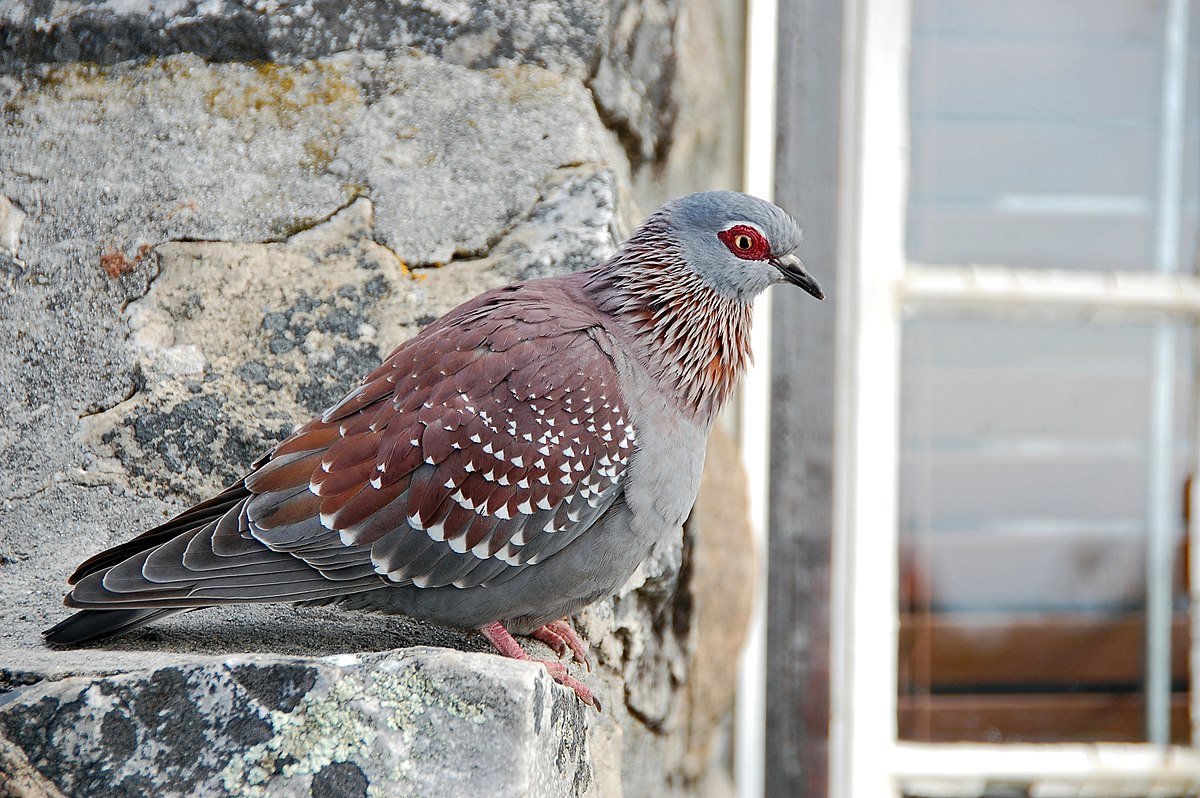
Wikipedia: Speckled pigeon Quelle: OTHER
1200px-Speckledpigeon.JPG
![]() The speckled pigeon (Columba guinea), or (African) rock pigeon, is a pigeon that is a resident breeding bird in much of Africa south of the Sahara. It is a common and widespread species in open habitats over much of its range, although there are sizable gaps in its distribution. It is sometimes referred to as the Guinea pigeon due to its similar coloring to some species of guineafowl.
[more]
The speckled pigeon (Columba guinea), or (African) rock pigeon, is a pigeon that is a resident breeding bird in much of Africa south of the Sahara. It is a common and widespread species in open habitats over much of its range, although there are sizable gaps in its distribution. It is sometimes referred to as the Guinea pigeon due to its similar coloring to some species of guineafowl.
[more]
Profil Wikipedia eBird Xeno-Canto

Wikipedia: Rameron pigeon Quelle: OTHER
Pigeon_African_Olive_2011_09_19_07_51_51_6049_crop.jpg
![]() Die Oliventaube (Columba arquatrix), auch Fleckentaube, Gefleckte Waldtaube, Gelbaugentaube oder Purpurtaube genannt, ist eine Art der Taubenvögel, die der Unterfamilie Columbinae zugerechnet wird. Die Art kommt ausschließlich in Afrika vor.
[more]
Die Oliventaube (Columba arquatrix), auch Fleckentaube, Gefleckte Waldtaube, Gelbaugentaube oder Purpurtaube genannt, ist eine Art der Taubenvögel, die der Unterfamilie Columbinae zugerechnet wird. Die Art kommt ausschließlich in Afrika vor.
[more]
Profil Wikipedia eBird Xeno-Canto
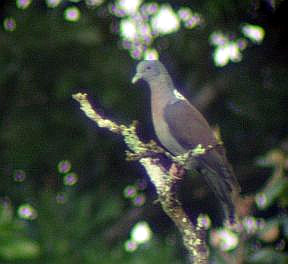
Wikipedia: Delegorgue's pigeon Quelle: OTHER
Delegorgues_Pigeon_%28Columba_delegorguei%29_in_tree.jpg
![]() Die Bronzehalstaube (Columba delegorguei), auch Weinrote Glanznackentaube, ist eine Art der Taubenvögel. Sie kommt ausschließlich im östlichen und südlichen Afrika vor. Es werden zwei Unterarten unterschieden, C. d. delegorguei und C. d. sharpei.
[more]
Die Bronzehalstaube (Columba delegorguei), auch Weinrote Glanznackentaube, ist eine Art der Taubenvögel. Sie kommt ausschließlich im östlichen und südlichen Afrika vor. Es werden zwei Unterarten unterschieden, C. d. delegorguei und C. d. sharpei.
[more]
Rock pigeons at bay in St Petersburg. 2023-09-23 19.15.24 Florida
Zuerst beobachtet in 🇨🇭 an 2021-04-18.
Dieser Vogel erscheint jenseits grossen Meere in Kontinenten :
Europa, Nordamerika, Südamerika, Afrika, Asien.
![]() Die Felsentaube (Columba livia) ist eine Vogelart aus der Familie der Tauben (Columbidae). Sie ist die alleinige Stammform der Haustaube und damit auch der Stadttaube.[1] Diese domestizierte und verwilderte Form zählt zu den erfolgreichsten Vögeln der Erde und ist mittlerweile, von der Arktis und Antarktis abgesehen, weltweit verbreitet. Die Wildform ist dagegen auf Eurasien und Afrika beschränkt.
[more]
Die Felsentaube (Columba livia) ist eine Vogelart aus der Familie der Tauben (Columbidae). Sie ist die alleinige Stammform der Haustaube und damit auch der Stadttaube.[1] Diese domestizierte und verwilderte Form zählt zu den erfolgreichsten Vögeln der Erde und ist mittlerweile, von der Arktis und Antarktis abgesehen, weltweit verbreitet. Die Wildform ist dagegen auf Eurasien und Afrika beschränkt.
[more]
Vokalisierung: ![]() Not loud. [Link]
Not loud. [Link]
Gesang: ![]() Song a two-syllable, but continuous cooing. First a rolling ascending "orrrrrr" immediately followed by a short descending "oohh". Wings produce a quite audible whistling sound. [Link]
Song a two-syllable, but continuous cooing. First a rolling ascending "orrrrrr" immediately followed by a short descending "oohh". Wings produce a quite audible whistling sound. [Link]
Körperlich: Länge=31-34 cm,
Flügelspanne=63-70 cm,
Gewicht=230-370 g
Habitate:
Siedlung
Gesang:
Automatically generated from Xeno-Canto recording
Gesang Eigenschaften:
Frequency:
♫ Quelle: BirdNet
20210418_155851 birdnet 1445 - Rock Pigeon and Mistle Thrush clatter - Rock Pigeon - Fehraltorf.mp3
2021-04-18 15.58.51 Fehraltorf (Gesang)

Wikipedia: Laughing dove Quelle: OTHER
1200px-Laughing_dove_%28Spilopelia_senegalensis_cambayensis%29.jpg
Allgemein: ![]() Die Palmtaube (Spilopelia senegalensis, Syn.: Streptopelia senegalensis), manchmal auch Senegaltaube genannt, ist eine relativ kleine, in Afrika, dem Nahen Osten und Südasien lebende Taubenart. In Westaustralien ist sie eingebürgert und in Deutschland kommen gelegentlich Gefangenschaftsflüchtlinge vor. Als kälteempfindliche Art etablieren sich Palmtauben jedoch nicht in gemäßigten europäischen Klimazonen.
[more]
Die Palmtaube (Spilopelia senegalensis, Syn.: Streptopelia senegalensis), manchmal auch Senegaltaube genannt, ist eine relativ kleine, in Afrika, dem Nahen Osten und Südasien lebende Taubenart. In Westaustralien ist sie eingebürgert und in Deutschland kommen gelegentlich Gefangenschaftsflüchtlinge vor. Als kälteempfindliche Art etablieren sich Palmtauben jedoch nicht in gemäßigten europäischen Klimazonen.
[more]
Profil Wikipedia eBird Xeno-Canto
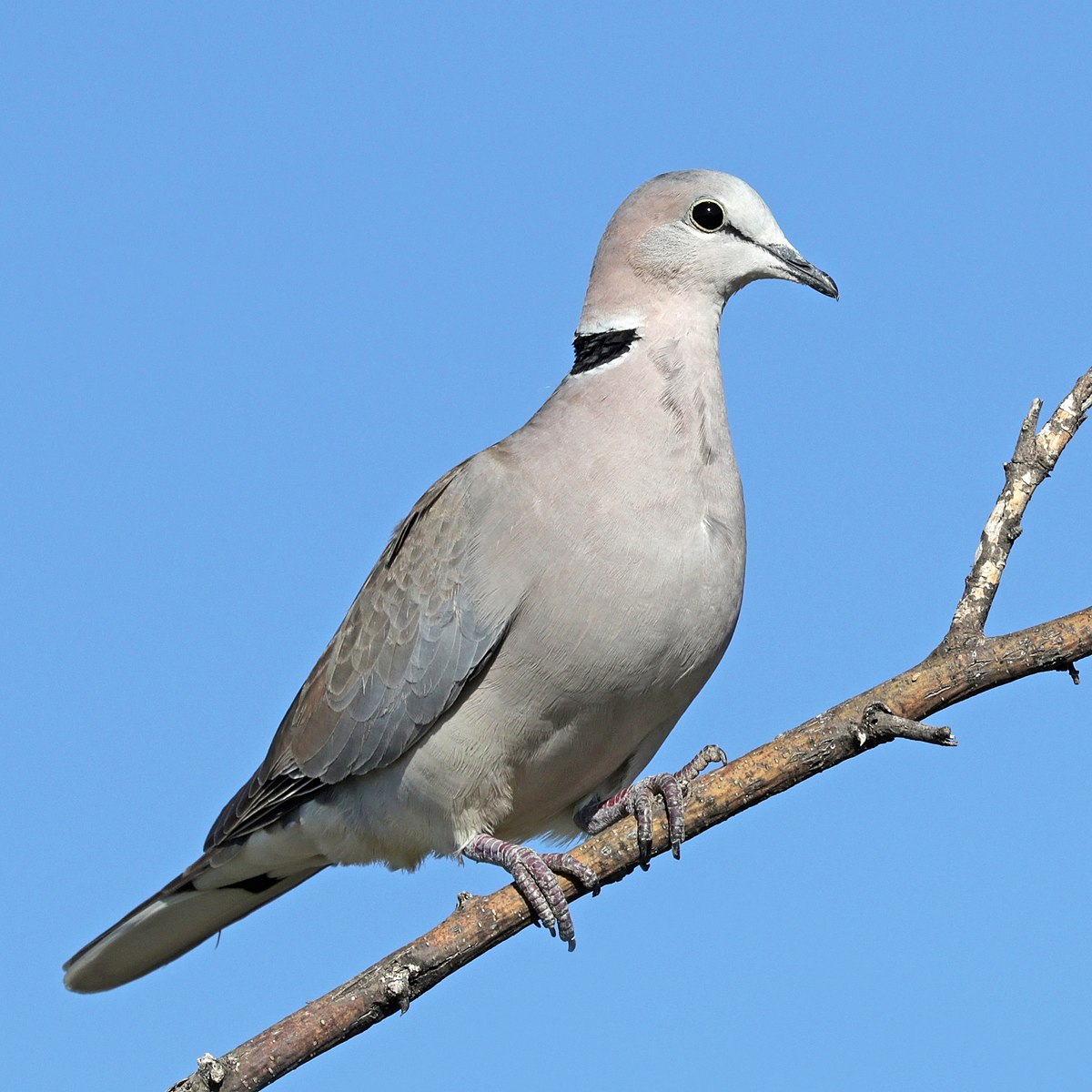
Wikipedia: Ring-necked dove Quelle: OTHER
1200px-Ring-necked_dove_%28Streptopelia_capicola_damarensis%29.jpg
![]() Die Kapturteltaube (Streptopelia capicola), auch Gurrtaube, Kaplachtaube oder Damara-Taube genannt[1], ist eine im südlichen und östlichen Afrika beheimatete Taubenart. Sie kommt dort in neun Unterarten vor. Die Art ist häufig und wird von der IUCN als nicht gefährdet eingestuft. Die Kapturteltaube ist eine sehr ruffreudige Art, die nicht nur den ganzen Tag über, sondern auch in mondhellen Nächten zu hören ist. Ihre Rufe sind für die Geräuschkulisse des ostafrikanischen Trockenbusches charakteristisch.[2]
[more]
Die Kapturteltaube (Streptopelia capicola), auch Gurrtaube, Kaplachtaube oder Damara-Taube genannt[1], ist eine im südlichen und östlichen Afrika beheimatete Taubenart. Sie kommt dort in neun Unterarten vor. Die Art ist häufig und wird von der IUCN als nicht gefährdet eingestuft. Die Kapturteltaube ist eine sehr ruffreudige Art, die nicht nur den ganzen Tag über, sondern auch in mondhellen Nächten zu hören ist. Ihre Rufe sind für die Geräuschkulisse des ostafrikanischen Trockenbusches charakteristisch.[2]
[more]
Profil Wikipedia eBird Xeno-Canto

Wikipedia: Mourning collared-dove Quelle: OTHER
1200px-African_mourning_dove_%28Streptopelia_decipiens_perspicillata%29.jpg
![]() The mourning collared dove or African mourning dove (Streptopelia decipiens) is a dove which is a widespread resident breeding bird in Africa south of the Sahara. Despite its name, it is not related to the North American mourning dove (Zenaida macroura). This species is common or abundant near water. They often mingle peacefully with other doves.
[more]
The mourning collared dove or African mourning dove (Streptopelia decipiens) is a dove which is a widespread resident breeding bird in Africa south of the Sahara. Despite its name, it is not related to the North American mourning dove (Zenaida macroura). This species is common or abundant near water. They often mingle peacefully with other doves.
[more]
Profil Wikipedia eBird Xeno-Canto

Wikipedia: Red-eyed dove Quelle: OTHER
1200px-Red-eyed_Dove_RWD.jpg
![]() The red-eyed dove (Streptopelia semitorquata) is a dove that is a widespread and common in Sub-Saharan Africa. It has been listed as Least Concern on the IUCN Red List since 2004.[1]
[more]
The red-eyed dove (Streptopelia semitorquata) is a dove that is a widespread and common in Sub-Saharan Africa. It has been listed as Least Concern on the IUCN Red List since 2004.[1]
[more]
Profil Wikipedia eBird Xeno-Canto

Wikipedia: Namaqua dove Quelle: OTHER
1200px-Oena_capensis_-near_Kambi_ya_Tembo%2C_Arusha%2C_Tanzania-8%2C_crop.jpg
![]() The Namaqua dove (Oena capensis) is a small pigeon. It is the only species in the genus Oena. It is found over much of Sub-Saharan Africa as well as Arabia and Madagascar.
[more]
The Namaqua dove (Oena capensis) is a small pigeon. It is the only species in the genus Oena. It is found over much of Sub-Saharan Africa as well as Arabia and Madagascar.
[more]

Wikipedia: African green-pigeon Quelle: OTHER
African_Green-Pigeon_%28Treron_calvus%29.jpg
![]() Die Rotnasen-Grüntaube oder Nacktgesicht-Grüntaube (Treron calvus) ist eine Art der Grüntauben aus der Familie der Taubenvögel. Sie kommt in zahlreichen Unterarten im subsaharischen Afrika vor. Anders als die meisten der Wildtauben ist sie eine baumbewohnende Art, die nur sehr selten auf den Boden kommt.
[more]
Die Rotnasen-Grüntaube oder Nacktgesicht-Grüntaube (Treron calvus) ist eine Art der Grüntauben aus der Familie der Taubenvögel. Sie kommt in zahlreichen Unterarten im subsaharischen Afrika vor. Anders als die meisten der Wildtauben ist sie eine baumbewohnende Art, die nur sehr selten auf den Boden kommt.
[more]
Profil Wikipedia eBird Xeno-Canto

Wikipedia: Emerald-spotted wood-dove Quelle: OTHER
1200px-Emerald-spotted_Wood_Dove_%28Turtur_chalcospilos%29_%2831377518065%29%2C_crop.jpg
![]() The emerald-spotted wood dove (Turtur chalcospilos) is a bird of the family Columbidae, resident across eastern and southern Africa. It is a species of open drier deciduous woodland and second growth. It is absent from evergreen rainforests and semidesert areas.
[more]
The emerald-spotted wood dove (Turtur chalcospilos) is a bird of the family Columbidae, resident across eastern and southern Africa. It is a species of open drier deciduous woodland and second growth. It is absent from evergreen rainforests and semidesert areas.
[more]
Profil Wikipedia eBird Xeno-Canto

Wikipedia: Tambourine dove
![]() Das Tamburintäubchen (Turtur tympanistria), auch Tamburintaube oder Tambourintäubchen genannt, ist eine kleine Art der Taubenvögel. Sie kommt ausschließlich in Afrika vor. Bei einigen Autoren findet man die Art nicht den Afrikanischen Buschtauben zugeordnet, sondern in eine eigene Gattung Tympanistria gestellt.[1]
[more]
Das Tamburintäubchen (Turtur tympanistria), auch Tamburintaube oder Tambourintäubchen genannt, ist eine kleine Art der Taubenvögel. Sie kommt ausschließlich in Afrika vor. Bei einigen Autoren findet man die Art nicht den Afrikanischen Buschtauben zugeordnet, sondern in eine eigene Gattung Tympanistria gestellt.[1]
[more]
Profil Wikipedia eBird Xeno-Canto

Wikipedia: Blue-spotted wood-dove Quelle: OTHER
Turtur_afer_-Gambia-8.jpg
![]() The blue-spotted wood dove (Turtur afer) is a species of bird in the family Columbidae.
It is abundantly present throughout Africa south of the Sahel; it is partially present in East Africa and absent in southern Africa.
[more]
The blue-spotted wood dove (Turtur afer) is a species of bird in the family Columbidae.
It is abundantly present throughout Africa south of the Sahel; it is partially present in East Africa and absent in southern Africa.
[more]
Profil Wikipedia eBird Xeno-Canto

Wikipedia: Half-collared kingfisher Quelle: OTHER
Half-collared_Kingfisher_-_Malawi_S4E4593.jpg
![]() The half-collared kingfisher (Alcedo semitorquata) is a kingfisher in the subfamily Alcedininae that is found in southern and eastern Africa. It feeds almost exclusively on fish and frequents streams, rivers and larger bodies of water.
[more]
The half-collared kingfisher (Alcedo semitorquata) is a kingfisher in the subfamily Alcedininae that is found in southern and eastern Africa. It feeds almost exclusively on fish and frequents streams, rivers and larger bodies of water.
[more]
Profil Wikipedia eBird Xeno-Canto
Our bed and breakfast host hand-feeding a striped kingfisher with mealworms. 2009-10-23 19.04.54 Gqeberha (frueher Port Elisabeth)
Zuerst beobachtet in Gqeberha (frueher Port Elisabeth) an 2009-10-23.
![]() Der Streifenliest (Halcyon chelicuti) ist ein Vogel aus der Familie der Eisvögel (Alcedinidae).
Die Art wurde zuerst von Edward Lord Stanley im Buch Salt's Voyage to Abyssinia[1] im Jahre 1814 als "Chelicut Kingfisher" Alaudo Chelicuti beschrieben.[2]
[more]
Der Streifenliest (Halcyon chelicuti) ist ein Vogel aus der Familie der Eisvögel (Alcedinidae).
Die Art wurde zuerst von Edward Lord Stanley im Buch Salt's Voyage to Abyssinia[1] im Jahre 1814 als "Chelicut Kingfisher" Alaudo Chelicuti beschrieben.[2]
[more]
Profil Wikipedia eBird Xeno-Canto

Wikipedia: Mangrove kingfisher Quelle: OTHER
1200px-Halcyon_senegaloides_Saadani_NP%2C_Tanzania_1.jpg
![]() Der Mangrovenliest (Halcyon senegaloides) ist ein an den Küstengebieten im Osten Afrikas lebender Eisvogel.
[more]
Der Mangrovenliest (Halcyon senegaloides) ist ein an den Küstengebieten im Osten Afrikas lebender Eisvogel.
[more]

Wikipedia: Brown-hooded kingfisher Quelle: OTHER
Male_Brown-hooded_Kingfisher%2C_Halcyon_albiventris_caught_a_wasp%2C_Tzaneen_area%2C_Limpopo%2C_South_Africa_%2814710550180%29.jpg
![]() Der Braunkopfliest (Halcyon albiventris) ist ein Vogel aus der Familie der Eisvögel (Alcedinidae).
[more]
Der Braunkopfliest (Halcyon albiventris) ist ein Vogel aus der Familie der Eisvögel (Alcedinidae).
[more]
Profil Wikipedia eBird Xeno-Canto

Wikipedia: Woodland kingfisher Quelle: OTHER
1200px-Woodland_Kingfisher_%28Halcyon_senegalensis%29_South_Africa.jpg
![]() Der Senegalliest (Halcyon senegalensis) ist ein im tropischen Afrika lebender Eisvogel.
[more]
Der Senegalliest (Halcyon senegalensis) ist ein im tropischen Afrika lebender Eisvogel.
[more]

Wikipedia: Grey-headed kingfisher Quelle: OTHER
Flickr_-_Rainbirder_-_Grey-headed_Kingfisher_%28Halcyon_leucocephala%29%2C_crop.jpg
![]() The grey-headed kingfisher (Halcyon leucocephala) has a wide distribution from the Cape Verde Islands off the north-west coast of Africa to Mauritania, Senegal and Gambia, east to Ethiopia, Somalia and southern Arabia and south to South Africa.
[more]
The grey-headed kingfisher (Halcyon leucocephala) has a wide distribution from the Cape Verde Islands off the north-west coast of Africa to Mauritania, Senegal and Gambia, east to Ethiopia, Somalia and southern Arabia and south to South Africa.
[more]

Wikipedia: Malachite kingfisher Quelle: OTHER
1200px-Malachite_kingfisher_%28Corythornis_cristatus_cristatus%29.jpg
![]() Der Haubenzwergfischer (Corythornis cristatus, Syn.: Alcedo cristata), auch Malachiteisvogel genannt, ist eine Vogelart, die zu den Eisvögeln (Alcedinidae) gehört.
[more]
Der Haubenzwergfischer (Corythornis cristatus, Syn.: Alcedo cristata), auch Malachiteisvogel genannt, ist eine Vogelart, die zu den Eisvögeln (Alcedinidae) gehört.
[more]

Wikipedia: African pygmy-kingfisher Quelle: OTHER
Flickr_-_Rainbirder_-_African_pygmy-kingfisher_%28Ceyx_pictus%29.jpg
![]() Der Zwergkönigsfischer (Ispidina picta, Syn.: Ceyx pictus) ist ein Vogel aus der Familie der Eisvögel.
[more]
Der Zwergkönigsfischer (Ispidina picta, Syn.: Ceyx pictus) ist ein Vogel aus der Familie der Eisvögel.
[more]

Wikipedia: European roller Quelle: OTHER
1200px-Arrival_%2847961559816%29.jpg
![]() Die Blauracke (Coracias garrulus) ist ein etwa hähergroßer Vertreter der Racken. Im deutschen Sprachraum wird die Art auch Mandelkrähe genannt. Der mit türkisfarbenen und azurblauen Gefiederbereichen sehr auffallend gefärbte Vogel ist in Europa der einzige Vertreter dieser Familie. Blauracken sind Weitstreckenzieher, das heißt alle verlassen im Spätsommer und Frühherbst ihre Brutgebiete in der westlichen, südlichen und zentralen Paläarktis, um vor allem im südlichen Afrika zu überwintern.
[more]
Die Blauracke (Coracias garrulus) ist ein etwa hähergroßer Vertreter der Racken. Im deutschen Sprachraum wird die Art auch Mandelkrähe genannt. Der mit türkisfarbenen und azurblauen Gefiederbereichen sehr auffallend gefärbte Vogel ist in Europa der einzige Vertreter dieser Familie. Blauracken sind Weitstreckenzieher, das heißt alle verlassen im Spätsommer und Frühherbst ihre Brutgebiete in der westlichen, südlichen und zentralen Paläarktis, um vor allem im südlichen Afrika zu überwintern.
[more]
Vokalisierung: ![]() Various dry rasping, sometimes mewing, sounds and short clicks: "ahrahrahrahrahrahrahr" or pulse of clicks: "trrrtrrrrtrr". Also a clearer raptor- or jay-like descending "piiuu". [Link]
Various dry rasping, sometimes mewing, sounds and short clicks: "ahrahrahrahrahrahrahr" or pulse of clicks: "trrrtrrrrtrr". Also a clearer raptor- or jay-like descending "piiuu". [Link]
Körperlich: Länge=30-32 cm,
Flügelspanne=66-73 cm,
Gewicht=120-160 g
Lilac-breasted roller on milestone. 2016-09-27 16.35.18 Botswana
Zuerst beobachtet in Botswana an 2016-09-23.
Allgemein: ![]() The lilac-breasted roller (Coracias caudatus) is an African bird of the roller family, Coraciidae. It is widely distributed in sub-Saharan Africa, and is a vagrant to the southern Arabian Peninsula.[1] It prefers open woodland and savanna, and it is for the most part absent from treeless places. Usually found alone or in pairs, it perches conspicuously at the tops of trees, poles or other high vantage points from where it can spot insects, lizards, scorpions, snails, small birds and rodents moving about on the ground.[2] Nesting takes place in a natural hole in a tree where a clutch of 2–4 eggs are laid, and incubated by both parents, who are extremely aggressive in defence of their nest, taking on raptors and other birds. During the breeding season the male will rise to a fair height (69 to 144 metres), descending in swoops and dives,[3] while uttering harsh, discordant cries. The sexes are different in coloration, and juveniles lack the long tail streamers of adults. This species is officially considered the national bird of Kenya. Alternate names for the lilac-breasted roller include the fork-tailed roller, lilac-throated roller (also used for a subspecies of purple roller) and Mosilikatze's roller.
[more]
The lilac-breasted roller (Coracias caudatus) is an African bird of the roller family, Coraciidae. It is widely distributed in sub-Saharan Africa, and is a vagrant to the southern Arabian Peninsula.[1] It prefers open woodland and savanna, and it is for the most part absent from treeless places. Usually found alone or in pairs, it perches conspicuously at the tops of trees, poles or other high vantage points from where it can spot insects, lizards, scorpions, snails, small birds and rodents moving about on the ground.[2] Nesting takes place in a natural hole in a tree where a clutch of 2–4 eggs are laid, and incubated by both parents, who are extremely aggressive in defence of their nest, taking on raptors and other birds. During the breeding season the male will rise to a fair height (69 to 144 metres), descending in swoops and dives,[3] while uttering harsh, discordant cries. The sexes are different in coloration, and juveniles lack the long tail streamers of adults. This species is officially considered the national bird of Kenya. Alternate names for the lilac-breasted roller include the fork-tailed roller, lilac-throated roller (also used for a subspecies of purple roller) and Mosilikatze's roller.
[more]

Wikipedia: Racket-tailed roller Quelle: OTHER
Coracias_spatulatusPCCA20071227-8449B.jpg
![]() The racket-tailed roller (Coracias spatulatus) is a species of bird in the family Coraciidae. It is found in southern Africa from Angola, south-eastern Democratic Republic of Congo and southern Tanzania to northern Botswana, Zimbabwe, Malawi and Mozambique.
[more]
The racket-tailed roller (Coracias spatulatus) is a species of bird in the family Coraciidae. It is found in southern Africa from Angola, south-eastern Democratic Republic of Congo and southern Tanzania to northern Botswana, Zimbabwe, Malawi and Mozambique.
[more]
Profil Wikipedia eBird Xeno-Canto
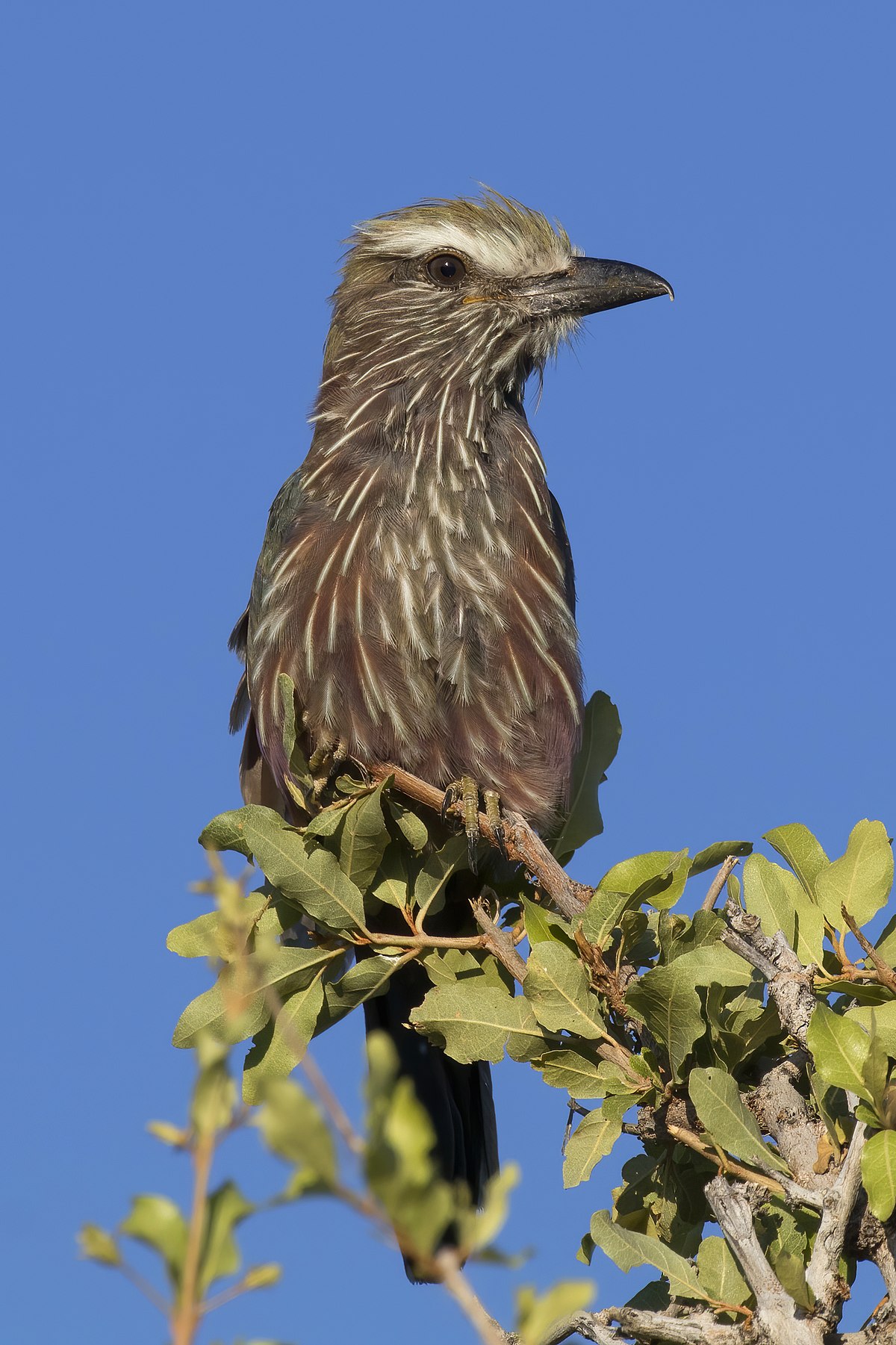
Wikipedia: Rufous-crowned roller Quelle: OTHER
1200px-Purple_roller_%28Coracias_naevius_mosambicus%29.jpg
![]() The purple roller (Coracias naevius), or rufous-crowned roller, is a medium-sized bird widespread in sub-Saharan Africa. Compared with other rollers its colours are rather dull and its voice rather harsh and grating.
[more]
The purple roller (Coracias naevius), or rufous-crowned roller, is a medium-sized bird widespread in sub-Saharan Africa. Compared with other rollers its colours are rather dull and its voice rather harsh and grating.
[more]
Profil Wikipedia eBird Xeno-Canto

Wikipedia: Broad-billed roller Quelle: OTHER
1200px-Broad-billed_Roller%2C_Ankarafantsika%2C_Madagascar%2C_crop.jpg
![]() Der Zimtroller (Eurystomus glaucurus) ist ein in der Afrotropis lebender Vogel aus der Familie der Racken.
[more]
Der Zimtroller (Eurystomus glaucurus) ist ein in der Afrotropis lebender Vogel aus der Familie der Racken.
[more]
Profil Wikipedia eBird Xeno-Canto
Pied kingfisher, most likely. 2016-09-23 09.15.24 Botswana
Zuerst beobachtet in Botswana an 2016-09-21.
![]() Der Graufischer (Ceryle rudis) ist ein Eisvogel, der in Afrika entlang des Nils, südlich der Sahara und im südlichen Asien von der Türkei bis zur Volksrepublik China vorkommt. Er ist ein Standvogel, zieht also im Winter nicht weg.
[more]
Der Graufischer (Ceryle rudis) ist ein Eisvogel, der in Afrika entlang des Nils, südlich der Sahara und im südlichen Asien von der Türkei bis zur Volksrepublik China vorkommt. Er ist ein Standvogel, zieht also im Winter nicht weg.
[more]

Wikipedia: Giant kingfisher Quelle: OTHER
1200px-Giant_kingfisher_%28Megaceryle_maxima%29_male.jpg
![]() The giant kingfisher (Megaceryle maxima) is the largest kingfisher in Africa, where it is a resident breeding bird over most of the continent south of the Sahara Desert, other than the arid southwest.
[more]
The giant kingfisher (Megaceryle maxima) is the largest kingfisher in Africa, where it is a resident breeding bird over most of the continent south of the Sahara Desert, other than the arid southwest.
[more]
Profil Wikipedia eBird Xeno-Canto

Wikipedia: White-fronted bee-eater Quelle: OTHER
1200px-White-fronted_bee-eater_%28Merops_bullockoides%29_Namibia.jpg
![]() The white-fronted bee-eater (Merops bullockoides) is a species of bee-eater widely distributed in sub-equatorial Africa.
[more]
The white-fronted bee-eater (Merops bullockoides) is a species of bee-eater widely distributed in sub-equatorial Africa.
[more]
Profil Wikipedia eBird Xeno-Canto
Southern carmine bee-eaters. 2016-09-28 16.57.56 Botswana
Zuerst beobachtet in Botswana an 2016-09-28.
![]() The southern carmine bee-eater (Merops nubicoides) (formerly carmine bee-eater) occurs across sub-equatorial Africa.
[more]
The southern carmine bee-eater (Merops nubicoides) (formerly carmine bee-eater) occurs across sub-equatorial Africa.
[more]
Profil Wikipedia eBird Xeno-Canto

Wikipedia: White-throated bee-eater Quelle: OTHER
White-throated_Bee-eater_-_Kenya_S4E4811_%2822024142954%29.jpg
![]() The white-throated bee-eater (Merops albicollis) is a near passerine bird in the bee-eater family, Meropidae. It breeds in semi-desert along the southern edge of the Sahara, Africa. The white-throated bee-eater is migratory, wintering in a completely different habitat in the equatorial rain forests of Africa from southern Senegal to Uganda.
[more]
The white-throated bee-eater (Merops albicollis) is a near passerine bird in the bee-eater family, Meropidae. It breeds in semi-desert along the southern edge of the Sahara, Africa. The white-throated bee-eater is migratory, wintering in a completely different habitat in the equatorial rain forests of Africa from southern Senegal to Uganda.
[more]
Profil Wikipedia eBird Xeno-Canto

Wikipedia: Madagascar bee-eater Quelle: OTHER
Madagascar_bee_eater.jpg
![]() The olive bee-eater or Madagascar bee-eater (Merops superciliosus) is a near passerine bee-eater species in the genus Merops. It is native to the southern half of Africa where it is present in Angola; Botswana; Burundi; Comoros; Democratic Republic of the Congo; Djibouti; Eritrea; Ethiopia; Kenya; Madagascar; Malawi; Mayotte; Mozambique; Namibia; Rwanda; Somalia; South Sudan; Sudan; Tanzania; Uganda; Zambia; Zimbabwe. It is a common species with a wide range so the International Union for Conservation of Nature has rated their conservation status as "least concern".[1]
[more]
The olive bee-eater or Madagascar bee-eater (Merops superciliosus) is a near passerine bee-eater species in the genus Merops. It is native to the southern half of Africa where it is present in Angola; Botswana; Burundi; Comoros; Democratic Republic of the Congo; Djibouti; Eritrea; Ethiopia; Kenya; Madagascar; Malawi; Mayotte; Mozambique; Namibia; Rwanda; Somalia; South Sudan; Sudan; Tanzania; Uganda; Zambia; Zimbabwe. It is a common species with a wide range so the International Union for Conservation of Nature has rated their conservation status as "least concern".[1]
[more]
Profil Wikipedia eBird Xeno-Canto

Wikipedia: Little bee-eater Quelle: OTHER
1200px-Little_bee-eater_%28Merops_pusillus_argutus%29_Namibia.jpg
![]() The little bee-eater (Merops pusillus) is a near passerine bird species in the bee-eater family, Meropidae. They are residents in much of Sub-Saharan Africa. They should not be confused with the little green bee-eater, Merops orientalis. Migration is limited to seasonal movements depending on rainfall patterns.
[more]
The little bee-eater (Merops pusillus) is a near passerine bird species in the bee-eater family, Meropidae. They are residents in much of Sub-Saharan Africa. They should not be confused with the little green bee-eater, Merops orientalis. Migration is limited to seasonal movements depending on rainfall patterns.
[more]
Profil Wikipedia eBird Xeno-Canto

Wikipedia: Blue-cheeked bee-eater Quelle: OTHER
1200px-Blue-cheeked_bee-eater_%28Merops_persicus_persicus%29_Namibia.jpg
![]() Der Blauwangenspint (Merops persicus) ist ein Vogel aus der Gattung (Merops) und Familie der Bienenfresser (Meropidae). Er kommt in Nordafrika und in Süd- und Vorderasien vor.
[more]
Der Blauwangenspint (Merops persicus) ist ein Vogel aus der Gattung (Merops) und Familie der Bienenfresser (Meropidae). Er kommt in Nordafrika und in Süd- und Vorderasien vor.
[more]
Profil Wikipedia eBird Xeno-Canto
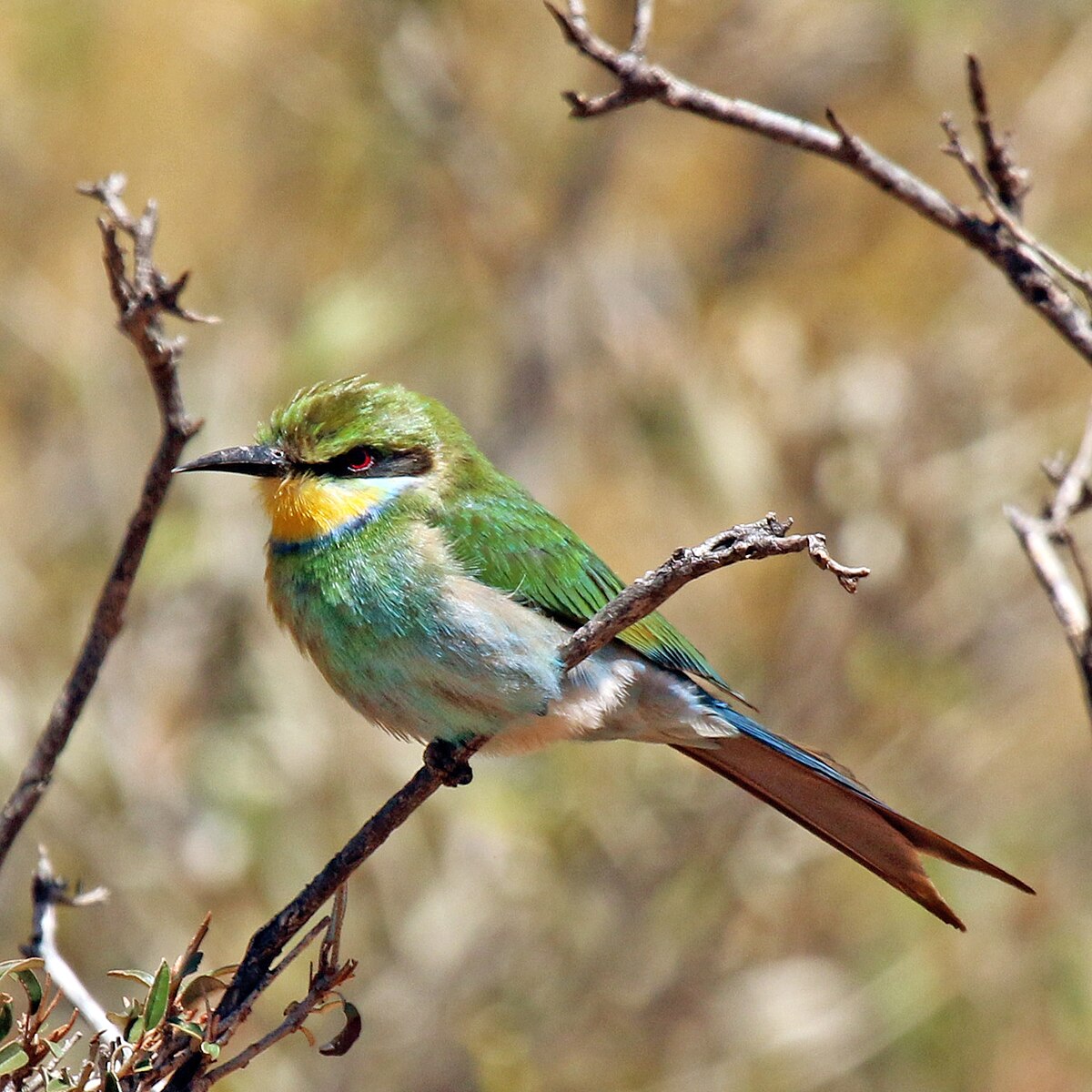
Wikipedia: Swallow-tailed bee-eater Quelle: OTHER
1200px-Swallow-tailed_bee-eater_%28Merops_hirundineus_hirundineus%29.jpg
![]() The swallow-tailed bee-eater (Merops hirundineus) is a near passerine bird in the bee-eater family, Meropidae. It breeds in savannah woodlands of sub-Saharan Africa. It is partially migratory, moving in response to rainfall patterns.
[more]
The swallow-tailed bee-eater (Merops hirundineus) is a near passerine bird in the bee-eater family, Meropidae. It breeds in savannah woodlands of sub-Saharan Africa. It is partially migratory, moving in response to rainfall patterns.
[more]
Profil Wikipedia eBird Xeno-Canto
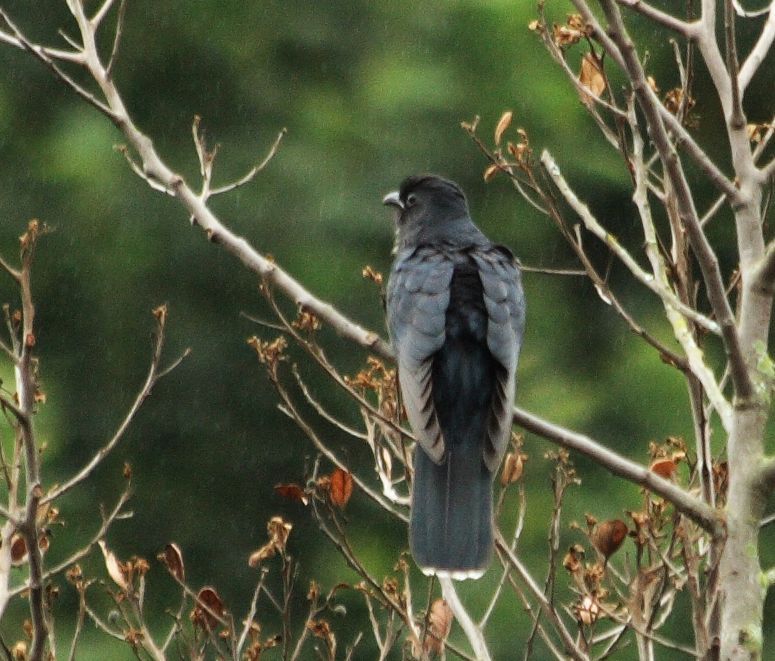
Wikipedia: Black cuckoo Quelle: OTHER
Black_Cuckoo_%28Cuculus_clamosus%29.jpg
![]() Der Schwarzkuckuck (Cuculus clamosus) gehört zur Ordnung der Kuckucksvögel (Cuculiformes) und zur Familie der Kuckucke (Cuculidae). Wie zahlreiche Arten der Kuckucksvögel ist der Schwarzkuckuck ein Brutschmarotzer. Von anderen Arten aus der Gattung Cuculus unterscheidet sich der Schwarzkuckuck mit seinem dunklen Körpergefieder deutlich. Erhitzøe hält es für möglich, dass diese Gefiederfärbung eine Form von Mimikry ist, die es dem Schwarzkuckuck erleichtert, Eier in die Nester seiner Wirtsvögel zu legen.[1]
[more]
Der Schwarzkuckuck (Cuculus clamosus) gehört zur Ordnung der Kuckucksvögel (Cuculiformes) und zur Familie der Kuckucke (Cuculidae). Wie zahlreiche Arten der Kuckucksvögel ist der Schwarzkuckuck ein Brutschmarotzer. Von anderen Arten aus der Gattung Cuculus unterscheidet sich der Schwarzkuckuck mit seinem dunklen Körpergefieder deutlich. Erhitzøe hält es für möglich, dass diese Gefiederfärbung eine Form von Mimikry ist, die es dem Schwarzkuckuck erleichtert, Eier in die Nester seiner Wirtsvögel zu legen.[1]
[more]
Profil Wikipedia eBird Xeno-Canto

Wikipedia: Madagascar cuckoo Quelle: OTHER
1200px-Cuculus_rochii.JPG
![]() The Madagascan cuckoo (Cuculus rochii), also known as the Madagascar lesser cuckoo, is a species of cuckoo in the family Cuculidae. Though it breeds only in Madagascar, it spends the non-breeding season in a number of countries in the African Great Lakes region and the Indian Ocean islands: Burundi, Democratic Republic of the Congo, Madagascar, Malawi, Rwanda, South Africa, Uganda and Zambia.
[more]
The Madagascan cuckoo (Cuculus rochii), also known as the Madagascar lesser cuckoo, is a species of cuckoo in the family Cuculidae. Though it breeds only in Madagascar, it spends the non-breeding season in a number of countries in the African Great Lakes region and the Indian Ocean islands: Burundi, Democratic Republic of the Congo, Madagascar, Malawi, Rwanda, South Africa, Uganda and Zambia.
[more]
Profil Wikipedia eBird Xeno-Canto

Wikipedia: Red-chested cuckoo Quelle: OTHER
Red-chested_Cuckoo_%28Cuculus_solitarius%29_in_tree_crop.jpg
![]() The red-chested cuckoo (Cuculus solitarius) is a species of cuckoo in the family Cuculidae. It is a medium-sized bird found in Africa south of the Sahara. In Afrikaans, it is known as "Piet-my-vrou", after its call.[2]
[more]
The red-chested cuckoo (Cuculus solitarius) is a species of cuckoo in the family Cuculidae. It is a medium-sized bird found in Africa south of the Sahara. In Afrikaans, it is known as "Piet-my-vrou", after its call.[2]
[more]
Profil Wikipedia eBird Xeno-Canto
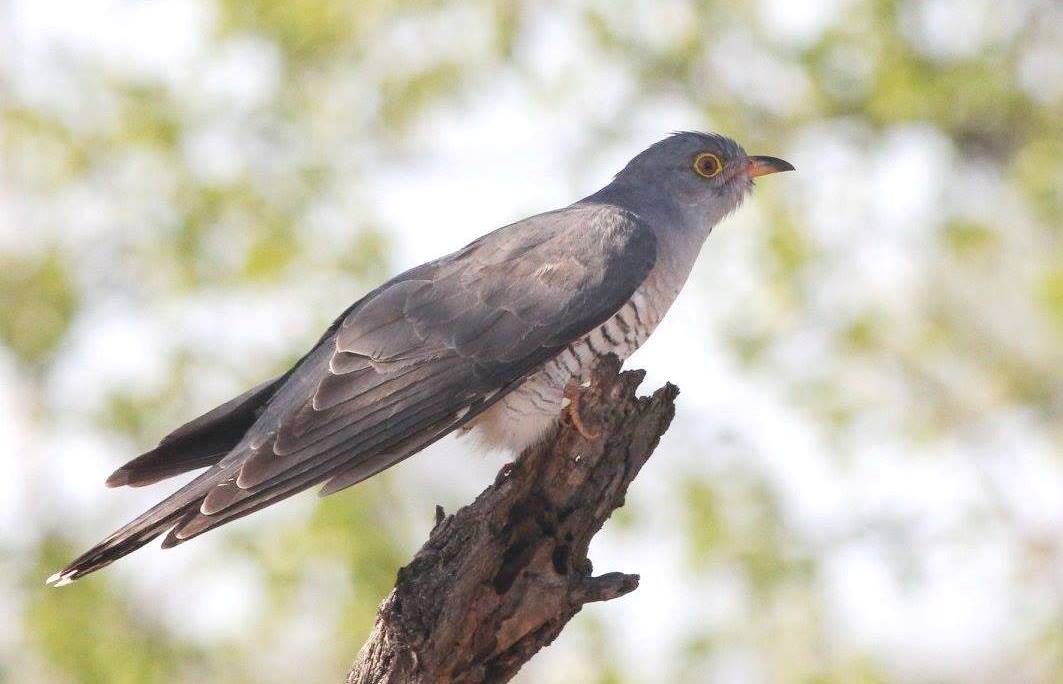
Wikipedia: African cuckoo Quelle: OTHER
Cuculus_gularis%2C_mannetjie%2C_Pretoriuskop%2C_Birding_Weto%2C_a.jpg
![]() The African cuckoo (Cuculus gularis) is a species of cuckoo in the family Cuculidae. It is found in Sub-Saharan Africa where it migrates within the continent, generally arriving and breeding in any one locality during the rainy season. A fairly common bird, the International Union for Conservation of Nature has rated its conservation status as being of "least concern".
[more]
The African cuckoo (Cuculus gularis) is a species of cuckoo in the family Cuculidae. It is found in Sub-Saharan Africa where it migrates within the continent, generally arriving and breeding in any one locality during the rainy season. A fairly common bird, the International Union for Conservation of Nature has rated its conservation status as being of "least concern".
[more]
Profil Wikipedia eBird Xeno-Canto

Wikipedia: African emerald cuckoo Quelle: OTHER
African_emerald_cuckoo_%28Chrysococcyx_cupreus%29_in_tree.jpg
![]() The African emerald cuckoo (Chrysococcyx cupreus) is a species of cuckoo that is native to Africa.
[more]
The African emerald cuckoo (Chrysococcyx cupreus) is a species of cuckoo that is native to Africa.
[more]
Profil Wikipedia eBird Xeno-Canto
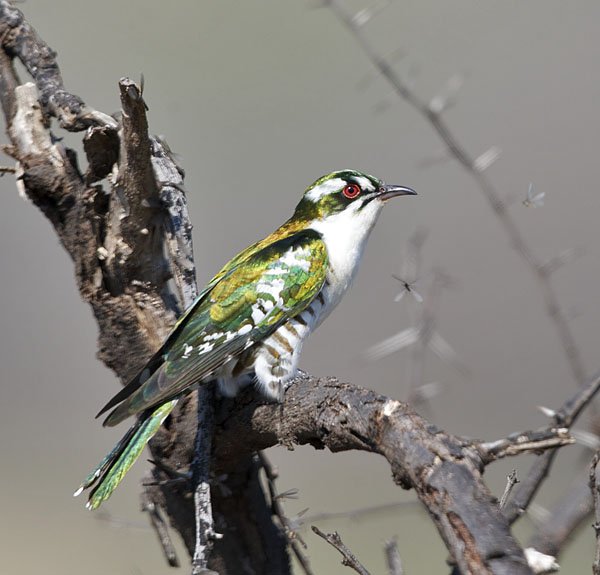
Wikipedia: Dideric cuckoo Quelle: OTHER
Chrysococcyx_caprius%2C_a%2C_Johann_Grobbelaar.jpg
![]() Der Goldkuckuck (Chrysococcyx caprius), auch Diderik- oder Diederik-Kuckuck, ist eine afrikanische Kuckucksart. Der Name „Diderik-Kuckuck“ verweist auf den Gesang des Männchens („dee-dee-dee-dee-derik“).[1] Der Ruf ist einer der charakteristischen Laute des afrikanischen Buschs, da der Goldkuckuck die häufigste Kuckucksart Afrikas ist.[2]
[more]
Der Goldkuckuck (Chrysococcyx caprius), auch Diderik- oder Diederik-Kuckuck, ist eine afrikanische Kuckucksart. Der Name „Diderik-Kuckuck“ verweist auf den Gesang des Männchens („dee-dee-dee-dee-derik“).[1] Der Ruf ist einer der charakteristischen Laute des afrikanischen Buschs, da der Goldkuckuck die häufigste Kuckucksart Afrikas ist.[2]
[more]
Profil Wikipedia eBird Xeno-Canto
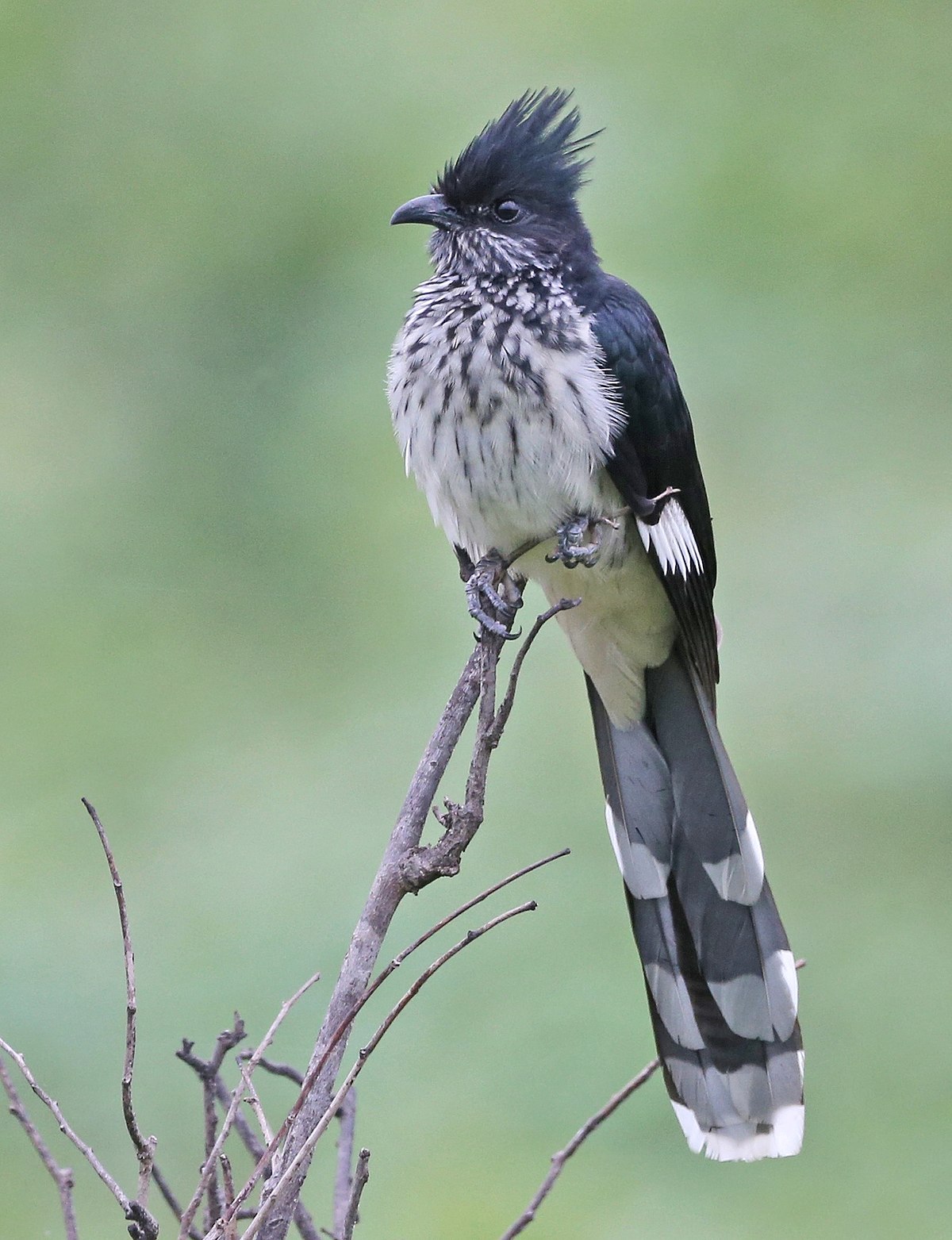
Wikipedia: Levaillant's cuckoo Quelle: OTHER
1200px-Clamator_levaillantii_%28Levaillant%27s_Cuckoo%29%2C_crop.jpg
![]() Levaillant's cuckoo (Clamator levaillantii) is a cuckoo which is a resident breeding species in Africa south of the Sahara. It is found in bushy habitats. It is a brood parasite, using the nests of bulbuls and babblers. It was named in honour of the French explorer, collector and ornithologist, François Le Vaillant.[2]
[more]
Levaillant's cuckoo (Clamator levaillantii) is a cuckoo which is a resident breeding species in Africa south of the Sahara. It is found in bushy habitats. It is a brood parasite, using the nests of bulbuls and babblers. It was named in honour of the French explorer, collector and ornithologist, François Le Vaillant.[2]
[more]
Profil Wikipedia eBird Xeno-Canto

Wikipedia: Pied cuckoo Quelle: OTHER
Jacobin_Cuckoo_%28Clamator_jacobinus%29_Photograph_By_Shantanu_Kuveskar.jpg
![]() Der Jakobinerkuckuck (Clamator jacobinus) ist eine Art aus der Familie der Kuckucksvögel, die zur Gattung der Schopfkuckucke (Clamator) gehört. Er ist ein mittelgroßer, schlanker Kuckuck, der in Afrika und Asien brütet und im Nahen Osten ein Durchzieher ist. In Teilen seines indischen Verbreitungsgebietes gilt er als Ankündigen des Monsuns, weil seine Rückkehr mit dem Einsetzen des Regens zusammenfällt.[1] In weiten Teilen seines Verbreitungsgebietes ist der Jakobinerkuckuck jedoch ein Standvogel. Es werden drei Unterarten unterschieden.[2]
[more]
Der Jakobinerkuckuck (Clamator jacobinus) ist eine Art aus der Familie der Kuckucksvögel, die zur Gattung der Schopfkuckucke (Clamator) gehört. Er ist ein mittelgroßer, schlanker Kuckuck, der in Afrika und Asien brütet und im Nahen Osten ein Durchzieher ist. In Teilen seines indischen Verbreitungsgebietes gilt er als Ankündigen des Monsuns, weil seine Rückkehr mit dem Einsetzen des Regens zusammenfällt.[1] In weiten Teilen seines Verbreitungsgebietes ist der Jakobinerkuckuck jedoch ein Standvogel. Es werden drei Unterarten unterschieden.[2]
[more]
Profil Wikipedia eBird Xeno-Canto NABU

Wikipedia: Great spotted cuckoo Quelle: OTHER
Clamator_glandarius_%28cropped_2%29.jpg
![]() The great spotted cuckoo (Clamator glandarius) is a member of the cuckoo order of birds, the Cuculiformes, which also includes the roadrunners, the anis and the coucals. The genus name clamator is Latin for "shouter" from clamare, "to shout". The specific glandarius is derived from Latin glans, glandis, "acorn".[2]
[more]
The great spotted cuckoo (Clamator glandarius) is a member of the cuckoo order of birds, the Cuculiformes, which also includes the roadrunners, the anis and the coucals. The genus name clamator is Latin for "shouter" from clamare, "to shout". The specific glandarius is derived from Latin glans, glandis, "acorn".[2]
[more]
Profil Wikipedia eBird Xeno-Canto
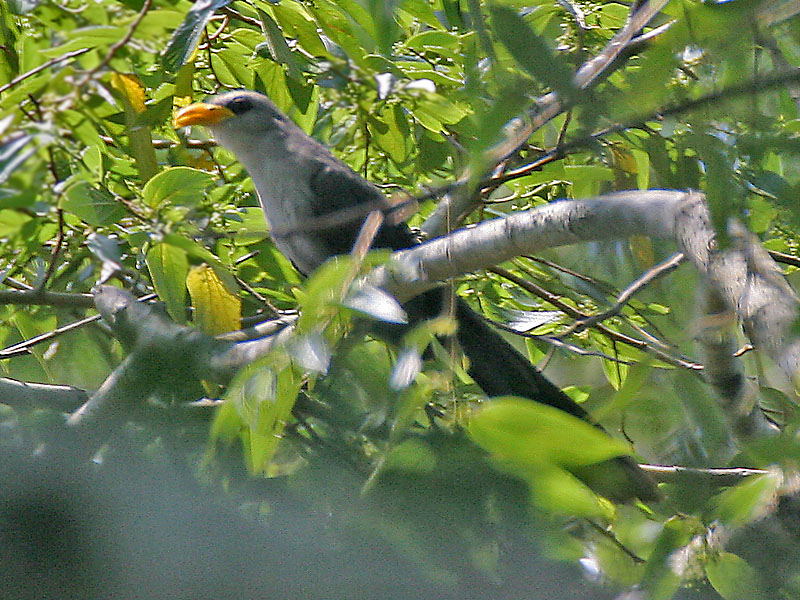
Wikipedia: Green malkoha Quelle: OTHER
Yellowbill.jpg
![]() The green malkoha or whistling yellowbill (Ceuthmochares australis) is a species of cuckoo in the family Cuculidae. This species and the blue malkoha were previously considered conspecific and together known as the yellowbill.
[more]
The green malkoha or whistling yellowbill (Ceuthmochares australis) is a species of cuckoo in the family Cuculidae. This species and the blue malkoha were previously considered conspecific and together known as the yellowbill.
[more]
Profil Wikipedia eBird Xeno-Canto
Coppery tailed coucal. 2016-09-23 08.14.20 Botswana
Zuerst beobachtet in Botswana an 2016-09-23.
![]() The coppery-tailed coucal (Centropus cupreicaudus) is a species of cuckoo in the family Cuculidae. It is found in Angola, Botswana, the Democratic Republic of the Congo, Malawi, Namibia, Tanzania, Zambia, and Zimbabwe. It was first described by the German ornithologist Anton Reichenow in 1896.
[more]
The coppery-tailed coucal (Centropus cupreicaudus) is a species of cuckoo in the family Cuculidae. It is found in Angola, Botswana, the Democratic Republic of the Congo, Malawi, Namibia, Tanzania, Zambia, and Zimbabwe. It was first described by the German ornithologist Anton Reichenow in 1896.
[more]
Profil Wikipedia eBird Xeno-Canto

Wikipedia: Black coucal Quelle: OTHER
Centropus_grillii%2C_subvolwassene%2C_Menongue%2C_Birding_Weto%2C_a.jpg
![]() The black coucal (Centropus grillii) is a species of cuckoo in the family Cuculidae. It has a wide distribution in Africa south of the Sahara.
[more]
The black coucal (Centropus grillii) is a species of cuckoo in the family Cuculidae. It has a wide distribution in Africa south of the Sahara.
[more]
Profil Wikipedia eBird Xeno-Canto

Wikipedia: Senegal coucal Quelle: OTHER
1200px-Senegal_coucal_%28Centropus_senegalensis_senegalensis%29.jpg
![]() Der Spornkuckuck (Centropus senegalensis) ist ein mit 38–41 Zentimeter Körperlänge mittelgroßer Vertreter der Familie der Kuckucke, der in weiten Bereichen des zentralen und südlichen Afrikas verbreitet ist.
[more]
Der Spornkuckuck (Centropus senegalensis) ist ein mit 38–41 Zentimeter Körperlänge mittelgroßer Vertreter der Familie der Kuckucke, der in weiten Bereichen des zentralen und südlichen Afrikas verbreitet ist.
[more]
Profil Wikipedia eBird Xeno-Canto

Wikipedia: White-browed coucal Quelle: OTHER
1200px-Centropus_superciliosus_-Tanzania-8.jpg
![]() The white-browed coucal or lark-heeled cuckoo (Centropus superciliosus), is a species of cuckoo in the family Cuculidae. It is found in sub-Saharan Africa. It inhabits areas with thick cover afforded by rank undergrowth and scrub, including in suitable coastal regions. Burchell's coucal is sometimes considered a subspecies.
[more]
The white-browed coucal or lark-heeled cuckoo (Centropus superciliosus), is a species of cuckoo in the family Cuculidae. It is found in sub-Saharan Africa. It inhabits areas with thick cover afforded by rank undergrowth and scrub, including in suitable coastal regions. Burchell's coucal is sometimes considered a subspecies.
[more]
Profil Wikipedia eBird Vogelwarte BirdLife ZH ornitho.ch Xeno-Canto NABU

Wikipedia: Red-footed falcon Quelle: OTHER
Falco_vespertinus_3_%28Martin_Mecnarowski%29.jpg
![]() The red-footed falcon (Falco vespertinus), formerly the western red-footed falcon, is a bird of prey. It belongs to the family Falconidae, the falcons. This bird is found in eastern Europe and Asia although its numbers are dwindling rapidly due to habitat loss and hunting. It is migratory, wintering in Africa. It is a regular wanderer to western Europe, and in August 2004 a red-footed falcon was found in North America for the first time on the island of Martha's Vineyard, Massachusetts.[2]
[more]
The red-footed falcon (Falco vespertinus), formerly the western red-footed falcon, is a bird of prey. It belongs to the family Falconidae, the falcons. This bird is found in eastern Europe and Asia although its numbers are dwindling rapidly due to habitat loss and hunting. It is migratory, wintering in Africa. It is a regular wanderer to western Europe, and in August 2004 a red-footed falcon was found in North America for the first time on the island of Martha's Vineyard, Massachusetts.[2]
[more]
Habitate:
Landwirtschaft
Profil Wikipedia eBird Xeno-Canto

Wikipedia: Amur falcon Quelle: OTHER
1200px-Amur_Falcon_%28male%29_%28vagrant%29.jpg
![]() Der Amurfalke (Falco amurensis) ist ein kleiner Falke aus der Unterfamilie der Eigentlichen Falken. Er ist nahe mit dem Rotfußfalken (Falco vespertinus) verwandt. Die ostasiatische Art mit dem Kernverbreitungsgebiet am Mittellauf des Amur ist ein extremer Fernzieher, der auf seinem Zug weite Strecken über offenes Meer zurücklegt. Das Winterhalbjahr verbringt die Art im südöstlichen Afrika. Amurfalken brüten vor allem in verlassenen Krähennestern und ernähren sich vornehmlich von Insekten, kleinen Wirbeltieren und Vögeln. Die Art, von der keine Unterarten beschrieben werden, wird von der IUCN als ungefährdet eingestuft.[1]
[more]
Der Amurfalke (Falco amurensis) ist ein kleiner Falke aus der Unterfamilie der Eigentlichen Falken. Er ist nahe mit dem Rotfußfalken (Falco vespertinus) verwandt. Die ostasiatische Art mit dem Kernverbreitungsgebiet am Mittellauf des Amur ist ein extremer Fernzieher, der auf seinem Zug weite Strecken über offenes Meer zurücklegt. Das Winterhalbjahr verbringt die Art im südöstlichen Afrika. Amurfalken brüten vor allem in verlassenen Krähennestern und ernähren sich vornehmlich von Insekten, kleinen Wirbeltieren und Vögeln. Die Art, von der keine Unterarten beschrieben werden, wird von der IUCN als ungefährdet eingestuft.[1]
[more]
Profil Wikipedia eBird Xeno-Canto
Wikipedia: Red-necked falcon Quelle: OTHER
Red-Necked_Falcon.JPG
![]() Der Rothalsfalke (Falco chicquera) ist eine mittelgroße Art aus der Gattung der Falken. Rothalsfalken erreichen eine Körperlänge von 30 bis 36 Zentimeter. Ihre Flügelspannweite beträgt 85 Zentimeter.
[more]
Der Rothalsfalke (Falco chicquera) ist eine mittelgroße Art aus der Gattung der Falken. Rothalsfalken erreichen eine Körperlänge von 30 bis 36 Zentimeter. Ihre Flügelspannweite beträgt 85 Zentimeter.
[more]

Wikipedia: African hobby Quelle: OTHER
African_Hobby_bwindi_jan06.jpg
![]() The African hobby (Falco cuvierii) is a small species of bird of prey in the family Falconidae.
[more]
The African hobby (Falco cuvierii) is a small species of bird of prey in the family Falconidae.
[more]
Profil Wikipedia eBird Xeno-Canto

Wikipedia: Taita falcon Quelle: OTHER
Taita_Falcon_at_the_World_Center_for_Birds_of_Prey%2C_Boise%2C_Idaho%2C_USA.jpg
![]() The Taita falcon (Falco fasciinucha) is a small falcon found in central and eastern Africa. It was first described from the Taita Hills of Kenya from which it derives its name.
[more]
The Taita falcon (Falco fasciinucha) is a small falcon found in central and eastern Africa. It was first described from the Taita Hills of Kenya from which it derives its name.
[more]
Profil Wikipedia eBird Xeno-Canto

Wikipedia: Dickinson's kestrel Quelle: OTHER
Dickinson%27s_Kestrel_%28Falco_dickinsoni%29_%2823164736424%29.jpg
![]() Dickinson's kestrel (Falco dickinsoni) is a bird of prey of southern and eastern Africa belonging to the falcon family Falconidae. It is named after John Dickinson, an English physician and missionary who collected the type specimen. It is also known as the white-rumped kestrel. Its closest relatives are the grey kestrel and banded kestrel and the three are sometimes placed in the subgenus Dissodectes.
[more]
Dickinson's kestrel (Falco dickinsoni) is a bird of prey of southern and eastern Africa belonging to the falcon family Falconidae. It is named after John Dickinson, an English physician and missionary who collected the type specimen. It is also known as the white-rumped kestrel. Its closest relatives are the grey kestrel and banded kestrel and the three are sometimes placed in the subgenus Dissodectes.
[more]
Profil Wikipedia eBird Xeno-Canto NABU

Wikipedia: Lanner falcon Quelle: OTHER
Lanner_Falcon_800.jpg
![]() Der Lanner oder Lannerfalke (Falco biarmicus) lebt in Afrika, auf der Arabischen Halbinsel, in Kleinasien sowie in Italien und auf dem Balkan. Er ist in Mitteleuropa nur als sehr seltener Gastvogel anzutreffen. Die in Belgien, der Schweiz, Deutschland und Polen beobachteten Individuen gelten alle als Gefangenschaftsflüchtlinge. Anerkannte Nachweise von Wildvögeln gibt es lediglich für Tschechien und die Slowakei. Ein früherer deutscher Name war auch Feldeggsfalke.[1]
[more]
Der Lanner oder Lannerfalke (Falco biarmicus) lebt in Afrika, auf der Arabischen Halbinsel, in Kleinasien sowie in Italien und auf dem Balkan. Er ist in Mitteleuropa nur als sehr seltener Gastvogel anzutreffen. Die in Belgien, der Schweiz, Deutschland und Polen beobachteten Individuen gelten alle als Gefangenschaftsflüchtlinge. Anerkannte Nachweise von Wildvögeln gibt es lediglich für Tschechien und die Slowakei. Ein früherer deutscher Name war auch Feldeggsfalke.[1]
[more]
Profil Wikipedia eBird Vogelwarte BirdLife ZH ornitho.ch Xeno-Canto BirdID NABU
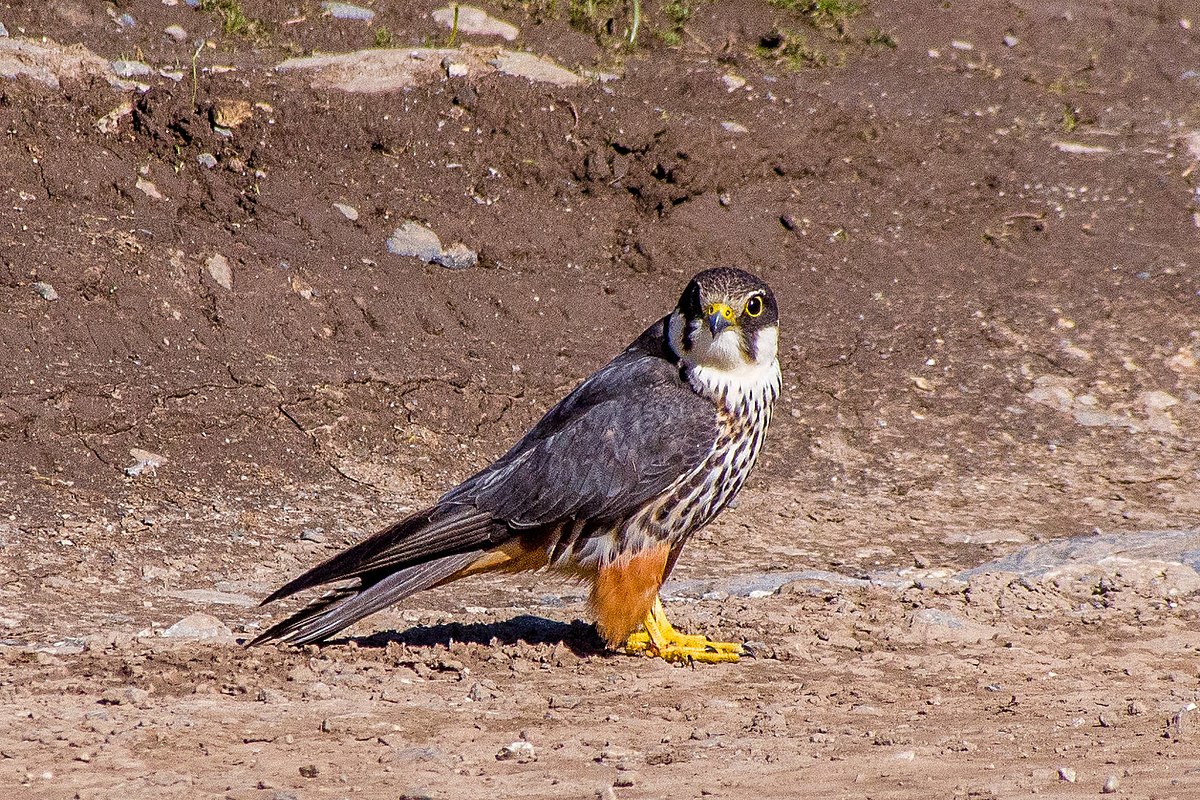
Wikipedia: Eurasian hobby Quelle: OTHER
1200px-Eurasian_Hobby_%2814574008925%29_%28cropped%29.jpg
![]() Der Baumfalke (Falco subbuteo) ist ein kleiner Falke, dessen auffälligstes Merkmal seine rostroten „Hosen“ (Beingefieder und Unterschwanzdecken) sind. Er ist in Deutschland die zweithäufigste Falkenart, nach dem Turmfalken und vor dem Wanderfalken. Der Bestandstrend ist rückläufig.
[more]
Der Baumfalke (Falco subbuteo) ist ein kleiner Falke, dessen auffälligstes Merkmal seine rostroten „Hosen“ (Beingefieder und Unterschwanzdecken) sind. Er ist in Deutschland die zweithäufigste Falkenart, nach dem Turmfalken und vor dem Wanderfalken. Der Bestandstrend ist rückläufig.
[more]
Vokalisierung: ![]() Varied, but not very vocal. [Link]
Varied, but not very vocal. [Link]
Rufe: ![]() Calls when courting and at breeding ground. Most common sound a high-pitched "tew-tew-tew". Similar to Wryneck, but less pleading. Also a sneezing "ktcho". [Link]
Calls when courting and at breeding ground. Most common sound a high-pitched "tew-tew-tew". Similar to Wryneck, but less pleading. Also a sneezing "ktcho". [Link]
Körperlich: Länge=30-36 cm,
Flügelspanne=82-92 cm,
Gewicht=131-340 g
Habitate:
Landwirtschaft
Gesang:
Automatically generated from Xeno-Canto recording
Gesang Eigenschaften:
Frequency:
♫ Quelle: BirdNet
20200507_131403 birdnet 488 BirdNet guesses eurasian hobby or eurasian jay - No confident detection.mp3
2020-05-07 13.14.03 Hungerseeli (Gesang)
Profil Wikipedia eBird Xeno-Canto NABU
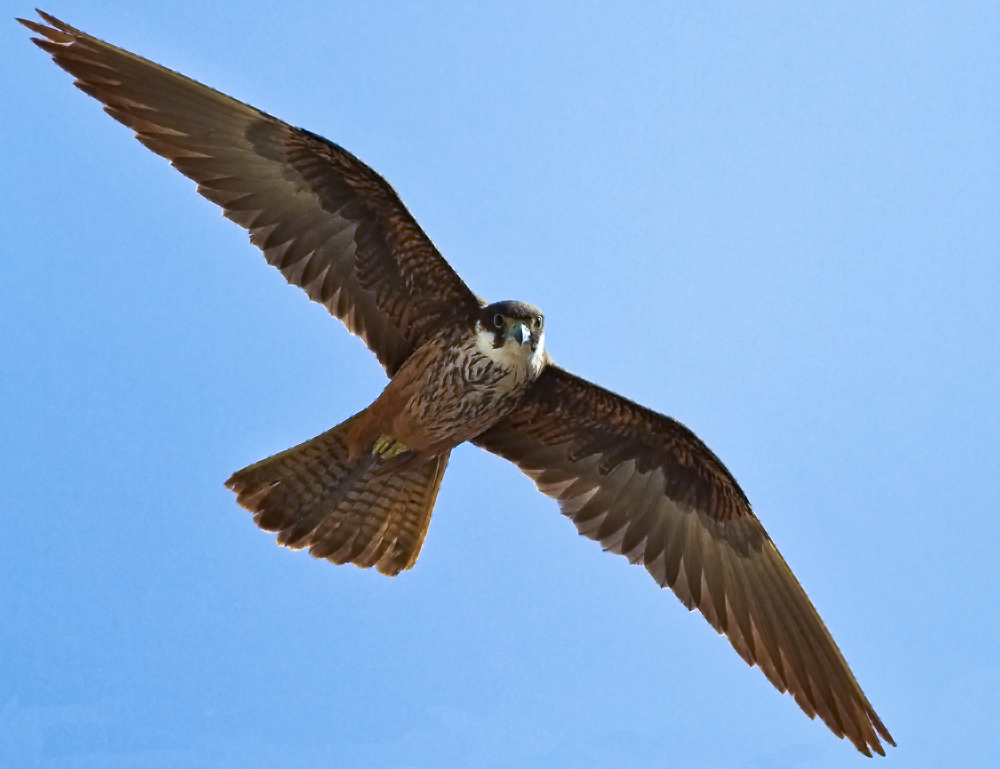
Wikipedia: Eleonora's falcon Quelle: OTHER
Eleonorenfalke1.jpg
Allgemein: ![]() Der Eleonorenfalke (Falco eleonorae) ist ein mittelgroßer Vertreter der Falken (Falco) innerhalb der Unterfamilie der Eigentlichen Falken (Falconinae). Die in einer hellen und einer dunklen Morphe vorkommenden Vögel brüten in zum Teil mehrere hundert Brutpaare umfassenden Kolonien vor allem auf griechischen Inseln und Felseilanden sowie verstreut im weiteren Mittelmeerraum und an der marokkanischen Atlantikküste.
[more]
Der Eleonorenfalke (Falco eleonorae) ist ein mittelgroßer Vertreter der Falken (Falco) innerhalb der Unterfamilie der Eigentlichen Falken (Falconinae). Die in einer hellen und einer dunklen Morphe vorkommenden Vögel brüten in zum Teil mehrere hundert Brutpaare umfassenden Kolonien vor allem auf griechischen Inseln und Felseilanden sowie verstreut im weiteren Mittelmeerraum und an der marokkanischen Atlantikküste.
[more]

Wikipedia: Peregrine falcon Quelle: OTHER
Falco_peregrinus_good_-_Christopher_Watson.jpg
Dieser Vogel erscheint jenseits grossen Meere in Kontinenten :
Europa, Nordamerika, Südamerika, Afrika, Asien.
![]() Der Wanderfalke (Falco peregrinus) gehört zur Familie der Falkenartigen. Er zählt zu den größten Vertretern der Familie und ist mit einer Spitzengeschwindigkeit von mehr als 320[1] km/h das schnellste Tier des Planeten. Der Wanderfalke ist ein Kosmopolit und die am weitesten verbreitete Vogelart der Welt; er besiedelt bis auf Antarktika alle Kontinente. Wanderfalken sind primär Felsbrüter und bewohnen in erster Linie gebirgige Landschaften aller Art sowie Steilküsten. In den letzten Jahrzehnten hat die Art in vielen Teilen des Verbreitungsgebietes auch Städte und Industrieanlagen mit ihren zahlreichen „Kunstfelsen“ besiedelt.
[more]
Der Wanderfalke (Falco peregrinus) gehört zur Familie der Falkenartigen. Er zählt zu den größten Vertretern der Familie und ist mit einer Spitzengeschwindigkeit von mehr als 320[1] km/h das schnellste Tier des Planeten. Der Wanderfalke ist ein Kosmopolit und die am weitesten verbreitete Vogelart der Welt; er besiedelt bis auf Antarktika alle Kontinente. Wanderfalken sind primär Felsbrüter und bewohnen in erster Linie gebirgige Landschaften aller Art sowie Steilküsten. In den letzten Jahrzehnten hat die Art in vielen Teilen des Verbreitungsgebietes auch Städte und Industrieanlagen mit ihren zahlreichen „Kunstfelsen“ besiedelt.
[more]
Vokalisierung: ![]() A harsh, drawn out "kiaaaa" with emphasised endings repeated in series. Much slower than Merlin, but higher pitched than Gyrfalcon. [Link]
A harsh, drawn out "kiaaaa" with emphasised endings repeated in series. Much slower than Merlin, but higher pitched than Gyrfalcon. [Link]
Rufe: ![]() Also shorter, coarse warning-calls. [Link]
Also shorter, coarse warning-calls. [Link]
Körperlich: Länge=36-48 cm,
Flügelspanne=95-110 cm,
Gewicht=582-1300 g
Habitate:
Landwirtschaft
Profil Wikipedia eBird Xeno-Canto

Wikipedia: Greater kestrel Quelle: OTHER
Greater_Kestrel_Namibia.jpg
Allgemein: ![]() The greater kestrel (Falco rupicoloides) or white-eyed kestrel, is a bird of prey belonging to the falcon family Falconidae. It is one of the largest kestrels and is found in open country in southern and eastern Africa.
[more]
The greater kestrel (Falco rupicoloides) or white-eyed kestrel, is a bird of prey belonging to the falcon family Falconidae. It is one of the largest kestrels and is found in open country in southern and eastern Africa.
[more]
Profil Wikipedia eBird Xeno-Canto
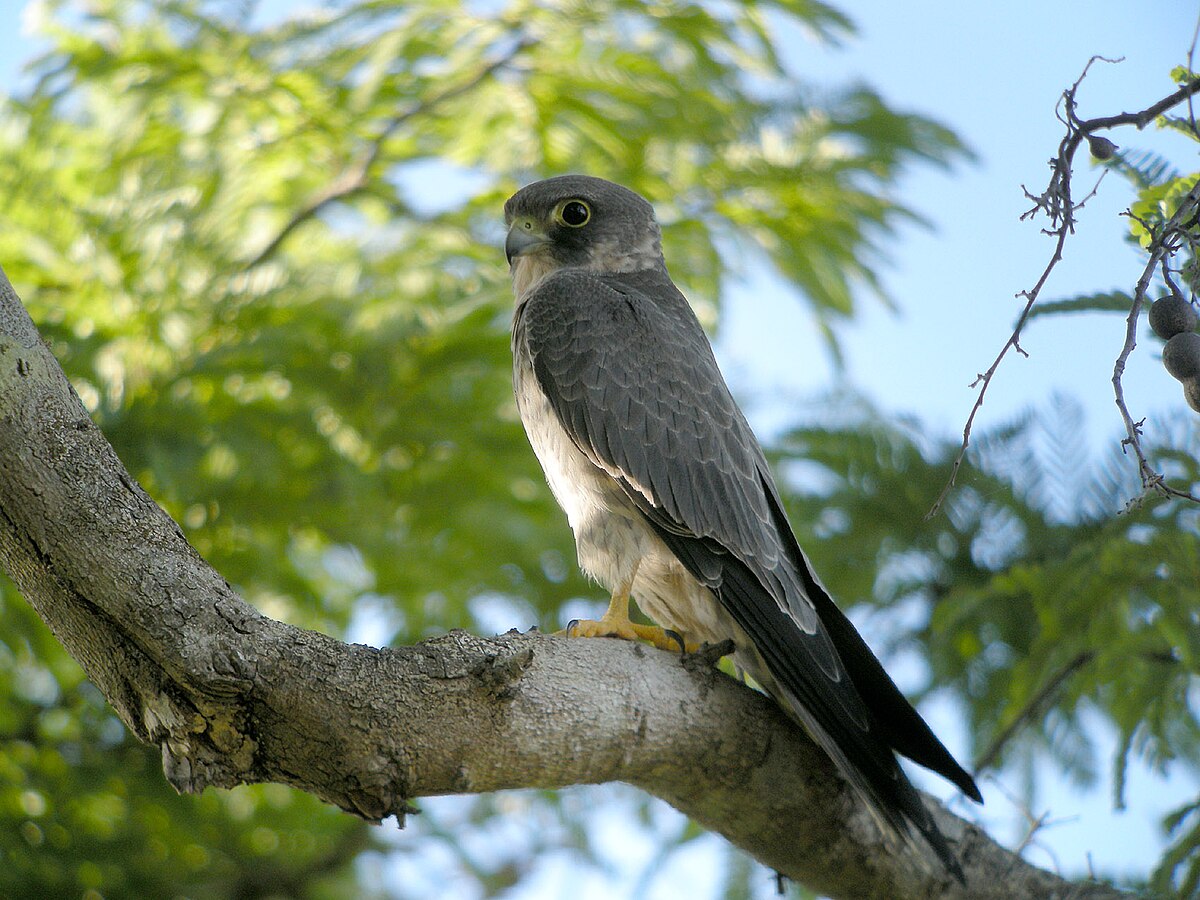
Wikipedia: Sooty falcon Quelle: OTHER
1200px-Sooty_Falcon%2C_All%C3%A9e_des_Baobabs_near_Morondava%2C_Madagascar.jpg
![]() The sooty falcon (Falco concolor) is a medium-sized falcon breeding from northeastern Africa to the southern Persian Gulf region.
[more]
The sooty falcon (Falco concolor) is a medium-sized falcon breeding from northeastern Africa to the southern Persian Gulf region.
[more]
Profil Wikipedia eBird Xeno-Canto BirdID NABU

Wikipedia: Lesser kestrel Quelle: OTHER
1200px-Lesser_Kestrel_%28Male%29.jpg
![]() The lesser kestrel (Falco naumanni) is a small falcon. This species breeds from the Mediterranean across Afghanistan and Central Asia, to China and Mongolia. It is a summer migrant, wintering in Africa and Pakistan and sometimes even to India and Iraq. It is rare north of its breeding range, and declining in its European range. The genus name derives from Late Latin falx, falcis, a sickle, referencing the claws of the bird,[2] and the species name commemorates the German naturalist Johann Friedrich Naumann.[3]
[more]
The lesser kestrel (Falco naumanni) is a small falcon. This species breeds from the Mediterranean across Afghanistan and Central Asia, to China and Mongolia. It is a summer migrant, wintering in Africa and Pakistan and sometimes even to India and Iraq. It is rare north of its breeding range, and declining in its European range. The genus name derives from Late Latin falx, falcis, a sickle, referencing the claws of the bird,[2] and the species name commemorates the German naturalist Johann Friedrich Naumann.[3]
[more]
Rufe: ![]() Contact call diagnostic, and quite different from Kestrel. A di- or trisyllabic "che che che", resembling Partridge in timbre, with two first syllables accentuated. Frequently used in colonies an din flocks. Also a Kestrel-like, plaintive trill "vriiiiii". [Link]
Contact call diagnostic, and quite different from Kestrel. A di- or trisyllabic "che che che", resembling Partridge in timbre, with two first syllables accentuated. Frequently used in colonies an din flocks. Also a Kestrel-like, plaintive trill "vriiiiii". [Link]
Körperlich: Länge=29-32 cm,
Flügelspanne=58-72 cm,
Gewicht=90-208 g
Profil Wikipedia eBird Xeno-Canto
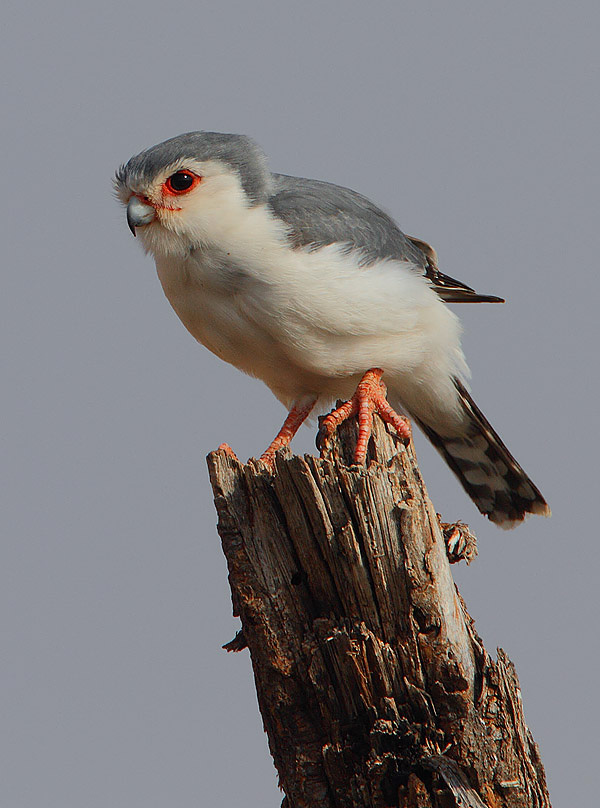
Wikipedia: Pygmy falcon Quelle: OTHER
Polihierax_semitorquatus_-Buffalo_Springs_National_Park%2C_Kenya-8.jpg
Allgemein: ![]() The pygmy falcon (Polihierax semitorquatus) or African pygmy falcon, is a bird species native to eastern and southern Africa. It is the smallest raptor on the continent. As a small falcon, only 19 to 20 cm long, it preys on insects, small reptiles, and small mammals.
[more]
The pygmy falcon (Polihierax semitorquatus) or African pygmy falcon, is a bird species native to eastern and southern Africa. It is the smallest raptor on the continent. As a small falcon, only 19 to 20 cm long, it preys on insects, small reptiles, and small mammals.
[more]

Bushman flamingo carving. 2016-09-09 17.16.22 Namibia
Zuerst beobachtet in Namibia an 2016-09-09.
![]() Der Rosaflamingo (Phoenicopterus roseus) ist eine Art aus der Familie der Flamingos (Phoenicopteridae). Er kommt in Teilen von Afrika, Asien und Süd-Europa vor.
[more]
Der Rosaflamingo (Phoenicopterus roseus) ist eine Art aus der Familie der Flamingos (Phoenicopteridae). Er kommt in Teilen von Afrika, Asien und Süd-Europa vor.
[more]
Vokalisierung: ![]() Nasal, di-syllabic, gooselike honking. Sometimes pure and high-pitched, other times deep and with peculiar, raspy, frog-like quality. [Link]
Nasal, di-syllabic, gooselike honking. Sometimes pure and high-pitched, other times deep and with peculiar, raspy, frog-like quality. [Link]
Körperlich: Länge=125-145 cm,
Flügelspanne=105-155 cm,
Gewicht=3000-4100 g
Lesser flamingos. 2016-09-07 14.44.58 Namibia
Zuerst beobachtet in Namibia an 2016-09-07.
Allgemein: ![]() Der Zwergflamingo (Phoeniconaias minor, Syn.: Phoenicopterus minor) ist ein an Salzseen lebender Vogel aus der Ordnung der Flamingos (Phoenicopteriformes) und deren kleinster Vertreter. Er lebt vorrangig in Afrika, ernährt sich hauptsächlich von Cyanobakterien und Kieselalgen, in geringerem Ausmaß auch von kleinen, aquatischen Wirbellosen wie Rädertierchen.[1] Er kann 50 Jahre alt werden.[2]
[more]
Der Zwergflamingo (Phoeniconaias minor, Syn.: Phoenicopterus minor) ist ein an Salzseen lebender Vogel aus der Ordnung der Flamingos (Phoenicopteriformes) und deren kleinster Vertreter. Er lebt vorrangig in Afrika, ernährt sich hauptsächlich von Cyanobakterien und Kieselalgen, in geringerem Ausmaß auch von kleinen, aquatischen Wirbellosen wie Rädertierchen.[1] Er kann 50 Jahre alt werden.[2]
[more]
Profil Wikipedia eBird Xeno-Canto

Wikipedia: Rufous-necked wryneck Quelle: OTHER
Red-throated_Wryneck%2C_Jynx_ruficollis.jpg
![]() The red-throated wryneck (Jynx ruficollis) is a species of wryneck in the woodpecker family. It is also known as the rufous-necked wryneck, red-breasted wryneck, African wryneck or rufous-throated wryneck.
[more]
The red-throated wryneck (Jynx ruficollis) is a species of wryneck in the woodpecker family. It is also known as the rufous-necked wryneck, red-breasted wryneck, African wryneck or rufous-throated wryneck.
[more]
Profil Wikipedia eBird Xeno-Canto

Wikipedia: Golden-tailed woodpecker Quelle: OTHER
Golden-tailed_Woodpecker_-_MALE%2C_Campethera_abingoni%2C_at_Borakalalo_National_Park%2C_Northwest_Province%2C_South_Africa%2C_crop.jpg
![]() Der Goldschwanzspecht (Campethera abingoni) ist eine Spechtart aus der Gattung der Fleckenspechte (Campethera). Der knapp buntspechtgroße Vogel kommt in einem großen Gebiet des zentralen und südlichen Afrikas vor, wo er regional zu den häufigen Spechtarten zählt, auf Grund seiner eher verborgenen Lebensweise aber oft unentdeckt bleibt. Zurzeit werden 6 Unterarten anerkannt. Mit den sehr nahe verwandten Arten Knysnaspecht und Mombasaspecht, die von einigen Autoren auch als Unterarten des Goldschwanzspechts aufgefasst werden, bildet er eine Superspezies. Nach Einschätzung der IUCN ist die Art zurzeit nicht gefährdet.
[more]
Der Goldschwanzspecht (Campethera abingoni) ist eine Spechtart aus der Gattung der Fleckenspechte (Campethera). Der knapp buntspechtgroße Vogel kommt in einem großen Gebiet des zentralen und südlichen Afrikas vor, wo er regional zu den häufigen Spechtarten zählt, auf Grund seiner eher verborgenen Lebensweise aber oft unentdeckt bleibt. Zurzeit werden 6 Unterarten anerkannt. Mit den sehr nahe verwandten Arten Knysnaspecht und Mombasaspecht, die von einigen Autoren auch als Unterarten des Goldschwanzspechts aufgefasst werden, bildet er eine Superspezies. Nach Einschätzung der IUCN ist die Art zurzeit nicht gefährdet.
[more]
Profil Wikipedia eBird Xeno-Canto

Wikipedia: Bennett's woodpecker Quelle: OTHER
Bennett%27s_Woodpecker%2C_Campethera_bennettii_at_Marakele_National_Park%2C_Limpopo%2C_South_Africa_%28male%29_%2816094899547%29.jpg
![]() Der Bennettspecht (Campethera bennettii) ist eine Vogelart aus der Familie der Spechte (Picidae). Diese recht kleine Spechtart besiedelt gut entwickeltes Wald- und Buschland mit älterem Baumbestand in großen Teilen des südlichen Afrikas. Die überwiegend auf dem Boden gesuchte Nahrung besteht vorwiegend aus Ameisen und Termiten. Die Art ist zumindest in Teilen ihres großen Verbreitungsgebietes häufig und wird von der IUCN als ungefährdet ("least concern") eingestuft.
[more]
Der Bennettspecht (Campethera bennettii) ist eine Vogelart aus der Familie der Spechte (Picidae). Diese recht kleine Spechtart besiedelt gut entwickeltes Wald- und Buschland mit älterem Baumbestand in großen Teilen des südlichen Afrikas. Die überwiegend auf dem Boden gesuchte Nahrung besteht vorwiegend aus Ameisen und Termiten. Die Art ist zumindest in Teilen ihres großen Verbreitungsgebietes häufig und wird von der IUCN als ungefährdet ("least concern") eingestuft.
[more]
Profil Wikipedia eBird Xeno-Canto

Wikipedia: Knysna woodpecker Quelle: OTHER
1200px-Naturalis_Biodiversity_Center_-_ZMA.AVES.3046_-_Campethera_notata_Lichtenstein%2C_M.H.K.%2C_1823_-_Picidae_-_skin_specimen.jpeg
![]() The Knysna woodpecker (Campethera notata) is a species of bird in the family Picidae. It is endemic to South Africa, where its natural habitats are subtropical or tropical moist lowland forests, moist savanna, and subtropical or tropical moist shrubland. It is threatened by habitat loss. It belongs to a species complex that includes the golden-tailed and Mombasa woodpeckers.[3]
[more]
The Knysna woodpecker (Campethera notata) is a species of bird in the family Picidae. It is endemic to South Africa, where its natural habitats are subtropical or tropical moist lowland forests, moist savanna, and subtropical or tropical moist shrubland. It is threatened by habitat loss. It belongs to a species complex that includes the golden-tailed and Mombasa woodpeckers.[3]
[more]
Profil Wikipedia eBird Xeno-Canto

Wikipedia: Ground woodpecker Quelle: OTHER
Geocolaptes_olivaceus_-South_Africa-8.jpg
![]() The ground woodpecker (Geocolaptes olivaceus) is one of only three ground-dwelling woodpeckers in the world (the others are the Andean and campo flickers). It inhabits rather barren, steep, boulder-strewn slopes in relatively cool hilly and mountainous areas of South Africa, Lesotho and Swaziland and has yet to be recorded outside of Southern Africa. It is found in a broad swath running from southwest to northeast, from the Cape Peninsula and Namaqualand to Mpumalanga.[1] It is closely related to the woodpeckers of the genus Campethera, some of which also employ terrestrial foraging strategies.[2]
[more]
The ground woodpecker (Geocolaptes olivaceus) is one of only three ground-dwelling woodpeckers in the world (the others are the Andean and campo flickers). It inhabits rather barren, steep, boulder-strewn slopes in relatively cool hilly and mountainous areas of South Africa, Lesotho and Swaziland and has yet to be recorded outside of Southern Africa. It is found in a broad swath running from southwest to northeast, from the Cape Peninsula and Namaqualand to Mpumalanga.[1] It is closely related to the woodpeckers of the genus Campethera, some of which also employ terrestrial foraging strategies.[2]
[more]
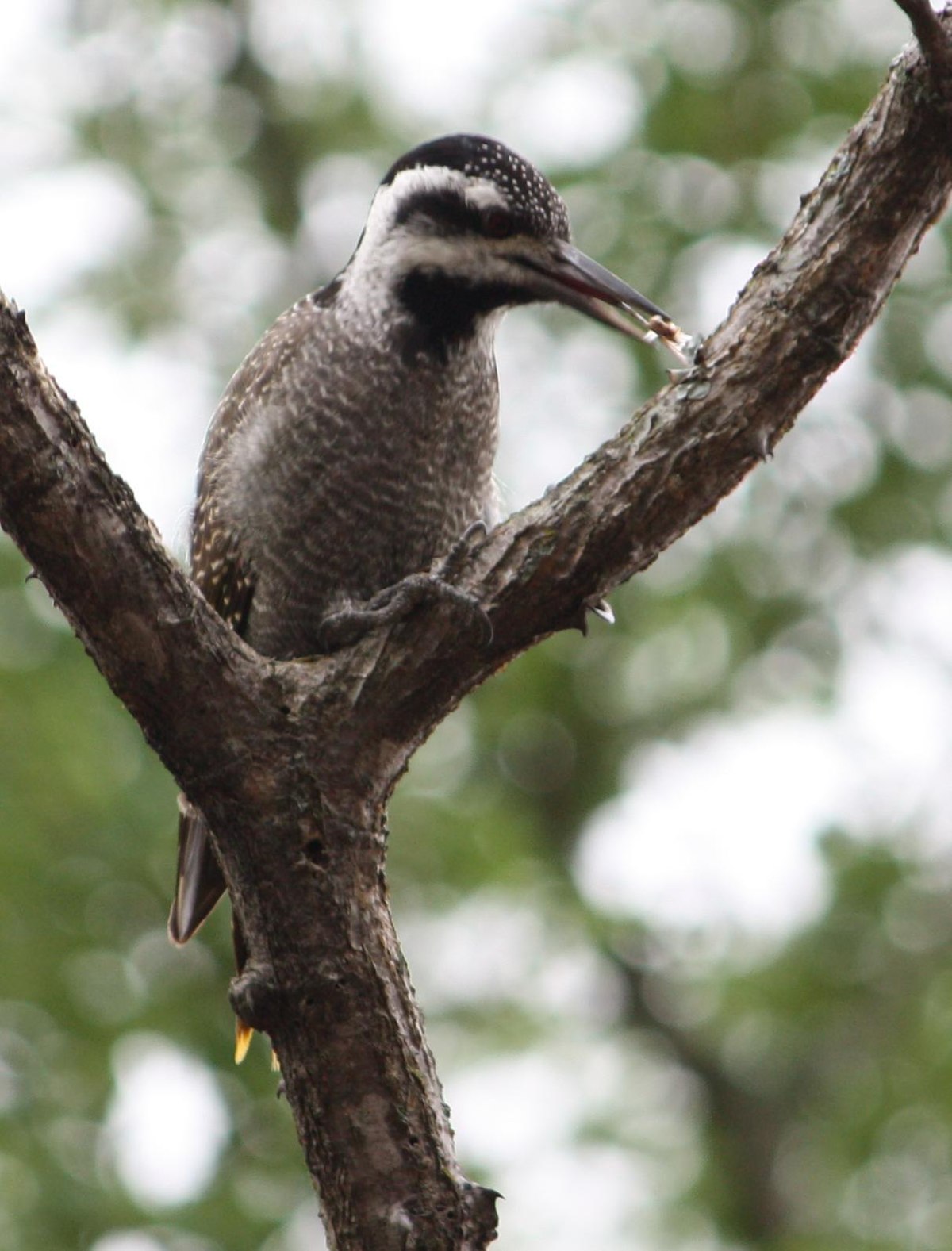
Wikipedia: Bearded woodpecker Quelle: OTHER
1200px-Thripias_namaquus_-Hlane_Royal_National_Park%2C_Swaziland-8.jpg
![]() The bearded woodpecker (Chloropicus namaquus) is a species of bird in the family Picidae. It has a distinctive black and white head and brownish barred body. It is native to tropical central Africa. It has an extremely wide range and is a fairly common species, and the International Union for Conservation of Nature has rated its conservation status as being of "least concern".[1] Some taxonomic authorities place this species in Dendropicos.
[more]
The bearded woodpecker (Chloropicus namaquus) is a species of bird in the family Picidae. It has a distinctive black and white head and brownish barred body. It is native to tropical central Africa. It has an extremely wide range and is a fairly common species, and the International Union for Conservation of Nature has rated its conservation status as being of "least concern".[1] Some taxonomic authorities place this species in Dendropicos.
[more]
Profil Wikipedia eBird Xeno-Canto

Wikipedia: Olive woodpecker Quelle: OTHER
1200px-Olive_Woodpecker%2C_Sakania%2C_DRC_%2812404103034%29%2C_crop.jpg
![]() The olive woodpecker (Dendropicos griseocephalus) is a species of bird in the woodpecker family Picidae.[2]
[more]
The olive woodpecker (Dendropicos griseocephalus) is a species of bird in the woodpecker family Picidae.[2]
[more]
Profil Wikipedia eBird Xeno-Canto

Wikipedia: Cardinal woodpecker Quelle: OTHER
Cardinal_Woodpecker_-_MALE%2C_Dendropicos_fuscescens_at_Pilanesberg_National_Park%2C_Northwest_Province%2C_South_Africa_%2814905279159%29.jpg
![]() The cardinal woodpecker (Dendropicos fuscescens) is a widespread and common resident breeder in much of Sub-Saharan Africa. It occurs in a wide range of habitats, ranging from dense forest to thorn bush. They are fairly vocal and are easily identified by their call notes. The sexes are distinguishable by their head patterns.
[more]
The cardinal woodpecker (Dendropicos fuscescens) is a widespread and common resident breeder in much of Sub-Saharan Africa. It occurs in a wide range of habitats, ranging from dense forest to thorn bush. They are fairly vocal and are easily identified by their call notes. The sexes are distinguishable by their head patterns.
[more]
Profil Wikipedia eBird Xeno-Canto
Black collared barbet. 2016-09-23 08.24.08 Botswana
Zuerst beobachtet in Botswana an 2016-09-23.
![]() The black-collared barbet (Lybius torquatus) is a species of bird in the family Lybiidae which is native to sub-Saharan Africa. Indigenous names include isiKhulukhulu and isiQonQotho in isiZulu, and Isinagogo in isiXhosa.[2]
[more]
The black-collared barbet (Lybius torquatus) is a species of bird in the family Lybiidae which is native to sub-Saharan Africa. Indigenous names include isiKhulukhulu and isiQonQotho in isiZulu, and Isinagogo in isiXhosa.[2]
[more]
Profil Wikipedia eBird Xeno-Canto

Wikipedia: Yellow-fronted tinkerbird Quelle: OTHER
Yellow-fronted_tinkerbird%2C_Pogoniulus_chrysoconus%2C_at_Walter_Sisulu_National_Botanical_Garden%2C_South_Africa_%2815819114098%29%2C_crop.jpg
![]() The yellow-fronted tinkerbird (Pogoniulus chrysoconus) is a small African barbet formerly known as yellow-fronted tinker barbet. It is sometimes considered conspecific with its southern counterpart, the red-fronted tinkerbird, Pogoniulus pusillus. Barbets are near passerine birds with bristles around the base of the bill and a world-wide tropical distribution.
[more]
The yellow-fronted tinkerbird (Pogoniulus chrysoconus) is a small African barbet formerly known as yellow-fronted tinker barbet. It is sometimes considered conspecific with its southern counterpart, the red-fronted tinkerbird, Pogoniulus pusillus. Barbets are near passerine birds with bristles around the base of the bill and a world-wide tropical distribution.
[more]
Profil Wikipedia eBird Xeno-Canto
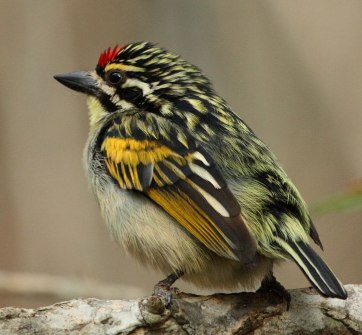
Wikipedia: Red-fronted tinkerbird Quelle: OTHER
Tinkerbird_Red-fronted_2010_10_08_16_Alan_Manson_Ithala_GR.jpg
![]() The red-fronted tinkerbird, (Pogoniulus pusillus) is a small African barbet. Barbets are near-passerine birds with bristles around the base of the bill. They have a world-wide tropical distribution.
[more]
The red-fronted tinkerbird, (Pogoniulus pusillus) is a small African barbet. Barbets are near-passerine birds with bristles around the base of the bill. They have a world-wide tropical distribution.
[more]
Profil Wikipedia eBird Xeno-Canto

Wikipedia: Yellow-rumped tinkerbird Quelle: OTHER
1200px-Yellow-rumped_Tinkerbird.jpg
![]() Der Gelbbüschel-Zwergbärtling (Pogoniulus bilineatus), auch Binden-Zwergbärtling genannt, ist eine Art aus der Familie der Afrikanischen Bartvögel (Lybiidae). Die Art kommt in Afrika beiderseits des Äquators vor und hat das größte Verbreitungsgebiet aller Zwergbärtlinge. Gemeinsam mit dem Rotbürzel-Bartvogel ist er die häufigste Art dieser Gattung. Es werden für den Gelbbüschel-Zwergbärtling mehrere Unterarten unterschieden. Die IUCN stuft den Gelbbüschel-Zwergbärtling als nicht gefährdet (least concern) ein.
[more]
Der Gelbbüschel-Zwergbärtling (Pogoniulus bilineatus), auch Binden-Zwergbärtling genannt, ist eine Art aus der Familie der Afrikanischen Bartvögel (Lybiidae). Die Art kommt in Afrika beiderseits des Äquators vor und hat das größte Verbreitungsgebiet aller Zwergbärtlinge. Gemeinsam mit dem Rotbürzel-Bartvogel ist er die häufigste Art dieser Gattung. Es werden für den Gelbbüschel-Zwergbärtling mehrere Unterarten unterschieden. Die IUCN stuft den Gelbbüschel-Zwergbärtling als nicht gefährdet (least concern) ein.
[more]
Profil Wikipedia eBird Xeno-Canto

Wikipedia: Crested barbet Quelle: OTHER
1200px-Trachyphonus_vaillantii_-near_Sand_River_Selous%2C_Selous_Game_Reserve%2C_Tanzania-8.jpg
![]() Der Hauben-Bartvogel (Trachyphonus vaillantii), auch Schwarzrücken-Bartvogel genannt, ist eine Vogelart aus der Familie der Afrikanischen Bartvögel. Die Art kommt nur im Süden Afrikas vor. Es werden mehrere Unterarten unterschieden. Die IUCN stuft den Hauben-Bartvogel als nicht gefährdet (least concern) ein.
[more]
Der Hauben-Bartvogel (Trachyphonus vaillantii), auch Schwarzrücken-Bartvogel genannt, ist eine Vogelart aus der Familie der Afrikanischen Bartvögel. Die Art kommt nur im Süden Afrikas vor. Es werden mehrere Unterarten unterschieden. Die IUCN stuft den Hauben-Bartvogel als nicht gefährdet (least concern) ein.
[more]
Profil Wikipedia eBird Xeno-Canto
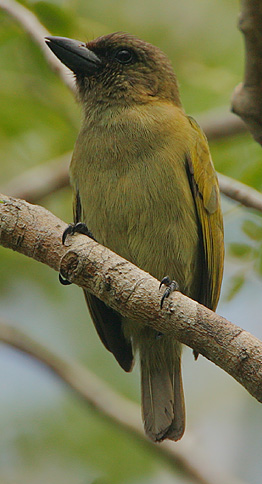
Wikipedia: Green barbet Quelle: OTHER
Flickr_-_Rainbirder_-_Green_Barbet_%28Stactolaema_olivacea%29_%28cropped%29.jpg
![]() Der Olivbartvogel (Stactolaema olivacea) ist eine Vogelart aus der Familie der Afrikanischen Bartvögel. Die Art kommt in Ostafrika südlich des Äquators vor. Es werden mehrere Unterarten unterschieden. Die IUCN stuft den Olivbartvogel als nicht gefährdet (least concern) ein.
[more]
Der Olivbartvogel (Stactolaema olivacea) ist eine Vogelart aus der Familie der Afrikanischen Bartvögel. Die Art kommt in Ostafrika südlich des Äquators vor. Es werden mehrere Unterarten unterschieden. Die IUCN stuft den Olivbartvogel als nicht gefährdet (least concern) ein.
[more]
Profil Wikipedia eBird Xeno-Canto

Wikipedia: White-eared barbet Quelle: OTHER
1200px-White-eared_Barbet_RWD.jpg
![]() Der Weißohr-Bartvogel (Stactolaema leucotis) ist eine Vogelart aus der Familie der Afrikanischen Bartvögel. Die Art kommt in Ostafrika vor. Es werden mehrere Unterarten unterschieden. Die IUCN stuft den Weißohr-Bartvogel als nicht gefährdet ein.
[more]
Der Weißohr-Bartvogel (Stactolaema leucotis) ist eine Vogelart aus der Familie der Afrikanischen Bartvögel. Die Art kommt in Ostafrika vor. Es werden mehrere Unterarten unterschieden. Die IUCN stuft den Weißohr-Bartvogel als nicht gefährdet ein.
[more]
Profil Wikipedia eBird Xeno-Canto

Wikipedia: Pied barbet Quelle: OTHER
1200px-Acacia_pied_barbet_%28Tricholaema_leucomelas_centralis%29.jpg
![]() The acacia pied barbet or pied barbet (Tricholaema leucomelas) is a species of bird in the family Lybiidae.
[more]
The acacia pied barbet or pied barbet (Tricholaema leucomelas) is a species of bird in the family Lybiidae.
[more]
Profil Wikipedia eBird Xeno-Canto
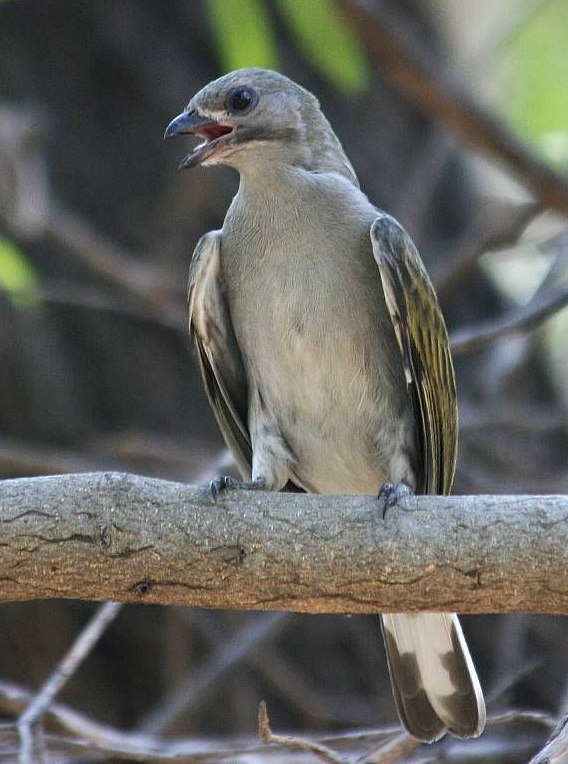
Wikipedia: Lesser honeyguide
![]() Der Kleine Honiganzeiger (Indicator minor), auch Nasenstreif-Honiganzeiger genannt, ist mit einer Körperlänge von 15 Zentimetern und einem Gewicht von bis zu 36 Gramm ein mittelgroßer Vertreter der Familie der Spechtvögel, der in Subsahara-Afrika verbreitet ist. Sie fressen überwiegend Insekten, sind jedoch in der Lage, auch Bienenwachs zu verdauen. Honig fressen sie dagegen nicht.[1] Sie sind obligatorische Brutschmarotzer, die ihren Nachwuchs von anderen Vogelarten groß ziehen lassen.
[more]
Der Kleine Honiganzeiger (Indicator minor), auch Nasenstreif-Honiganzeiger genannt, ist mit einer Körperlänge von 15 Zentimetern und einem Gewicht von bis zu 36 Gramm ein mittelgroßer Vertreter der Familie der Spechtvögel, der in Subsahara-Afrika verbreitet ist. Sie fressen überwiegend Insekten, sind jedoch in der Lage, auch Bienenwachs zu verdauen. Honig fressen sie dagegen nicht.[1] Sie sind obligatorische Brutschmarotzer, die ihren Nachwuchs von anderen Vogelarten groß ziehen lassen.
[more]
Profil Wikipedia eBird Xeno-Canto

Wikipedia: Greater honeyguide Quelle: OTHER
1200px-Greater_Honeyguide%2C_Gambia.jpg
![]() Der Große Honiganzeiger (Indicator indicator), auch Schwarzkehl-Honiganzeiger genannt, ist mit einer Körperlänge von 18 bis 20 Zentimetern und einem Gewicht von bis zu 55 Gramm ein mittelgroßer Vertreter der Familie der Spechtvögel. Innerhalb der Gattung der Eigentlichen Honiganzeiger sind sie die größte Art.[1] Sie fressen überwiegend Insekten, sind jedoch in der Lage, auch Bienenwachs zu verdauen. Honig fressen sie dagegen nicht.[2]
[more]
Der Große Honiganzeiger (Indicator indicator), auch Schwarzkehl-Honiganzeiger genannt, ist mit einer Körperlänge von 18 bis 20 Zentimetern und einem Gewicht von bis zu 55 Gramm ein mittelgroßer Vertreter der Familie der Spechtvögel. Innerhalb der Gattung der Eigentlichen Honiganzeiger sind sie die größte Art.[1] Sie fressen überwiegend Insekten, sind jedoch in der Lage, auch Bienenwachs zu verdauen. Honig fressen sie dagegen nicht.[2]
[more]
Profil Wikipedia eBird Xeno-Canto

Wikipedia: Scaly-throated honeyguide Quelle: OTHER
Flickr_-_Rainbirder_-_Scaly-throated_Honeyguide_%28Indicator_variegatus%29.jpg
![]() The scaly-throated honeyguide (Indicator variegatus) is a species of bird in the family Indicatoridae.
[more]
The scaly-throated honeyguide (Indicator variegatus) is a species of bird in the family Indicatoridae.
[more]
Profil Wikipedia eBird Xeno-Canto

Wikipedia: Wahlberg's honeyguide Quelle: OTHER
Wahlberg%27s_Honeyguide_%28Prodotiscus_regulus%29.jpg
![]() The brown-backed honeybird (Prodotiscus regulus), also known as Wahlberg's honeybird, Wahlberg's honeyguide and sharp-billed honeyguide, is a species of bird in the family Indicatoridae. This bird is named after the Swedish naturalist Johan August Wahlberg.
[more]
The brown-backed honeybird (Prodotiscus regulus), also known as Wahlberg's honeybird, Wahlberg's honeyguide and sharp-billed honeyguide, is a species of bird in the family Indicatoridae. This bird is named after the Swedish naturalist Johan August Wahlberg.
[more]

Wikipedia: Rose-ringed parakeet Quelle: OTHER
1200px-Rose-ringed_parakeet_%28Psittacula_krameri_borealis%29_male_Jaipur_2.jpg
Dieser Vogel erscheint jenseits grossen Meere in Kontinenten :
Europa, Nordamerika, Afrika.
![]() Der Halsbandsittich (Psittacula krameri), auch Kleiner Alexandersittich genannt, ist die am weitesten verbreitete Papageienart. Er kommt sowohl in Afrika südlich der Sahara als auch in Asien, beginnend mit Pakistan und Indien, vor. Als Neozoon lebt er unter anderem in Europa und Nordamerika.
[more]
Der Halsbandsittich (Psittacula krameri), auch Kleiner Alexandersittich genannt, ist die am weitesten verbreitete Papageienart. Er kommt sowohl in Afrika südlich der Sahara als auch in Asien, beginnend mit Pakistan und Indien, vor. Als Neozoon lebt er unter anderem in Europa und Nordamerika.
[more]

Wikipedia: Peach-faced lovebird Quelle: OTHER
1200px-Rosy-faced_lovebird_%28Agapornis_roseicollis_roseicollis%29.jpg
Dieser Vogel erscheint jenseits grossen Meere in Kontinenten :
Nordamerika, Afrika.
![]() Das Rosenköpfchen (Agapornis roseicollis) ist eine Art aus der Gattung der Unzertrennlichen. Gemeinsam mit den anderen Arten dieser Gattung sowie dem Graupapagei, den Langflügelpapageien, dem Halsbandsittich und den auf Madagaskar endemischen Vasapapageien zählt diese Art zu den typischen Papageienarten der Afrotropis.
[more]
Das Rosenköpfchen (Agapornis roseicollis) ist eine Art aus der Gattung der Unzertrennlichen. Gemeinsam mit den anderen Arten dieser Gattung sowie dem Graupapagei, den Langflügelpapageien, dem Halsbandsittich und den auf Madagaskar endemischen Vasapapageien zählt diese Art zu den typischen Papageienarten der Afrotropis.
[more]

Wikipedia: Brown-necked parrot Quelle: OTHER
Kapsky.jpg
![]() The brown-necked parrot (Poicephalus fuscicollis), sometimes known in aviculture as the uncape parrot,[2] is a large Poicephalus parrot species endemic to Africa consisting of the savanna-dwelling brown-necked parrot (P. fuscicollis fuscicollis) and grey-headed parrot (P. f. suahelicus) subspecies. It formerly included the Cape parrot (now Poicephalus robustus) as a subspecies before the Cape parrot was re-classified as a distinct species.[3]
[more]
The brown-necked parrot (Poicephalus fuscicollis), sometimes known in aviculture as the uncape parrot,[2] is a large Poicephalus parrot species endemic to Africa consisting of the savanna-dwelling brown-necked parrot (P. fuscicollis fuscicollis) and grey-headed parrot (P. f. suahelicus) subspecies. It formerly included the Cape parrot (now Poicephalus robustus) as a subspecies before the Cape parrot was re-classified as a distinct species.[3]
[more]
Profil Wikipedia eBird Xeno-Canto

Wikipedia: Brown-headed parrot Quelle: OTHER
1200px-Brown-headed_Parrot_%28Poicephalus_cryptoxanthus%29_%2811688869593%29.jpg
![]() Der Braunkopfpapagei (Poicephalus cryptoxanthus) ist eine Vogelart aus der Gattung der Langflügelpapageien. Gemeinsam mit den anderen Arten dieser Gattung sowie dem Graupapagei, den Unzertrennlichen, dem Halsbandsittich und den auf Madagaskar endemischen Vasapapageien zählt diese Art zu den typischen Papageienarten der Afrotropis. Er bewohnt das südöstliche Afrika einschließlich des östlichen Transvaal, Mosambik, Simbabwe, Malawi, Tansania und Kenia[1]. In einigen Regionen sind Braunkopfpapageien nach wie vor häufig.
[more]
Der Braunkopfpapagei (Poicephalus cryptoxanthus) ist eine Vogelart aus der Gattung der Langflügelpapageien. Gemeinsam mit den anderen Arten dieser Gattung sowie dem Graupapagei, den Unzertrennlichen, dem Halsbandsittich und den auf Madagaskar endemischen Vasapapageien zählt diese Art zu den typischen Papageienarten der Afrotropis. Er bewohnt das südöstliche Afrika einschließlich des östlichen Transvaal, Mosambik, Simbabwe, Malawi, Tansania und Kenia[1]. In einigen Regionen sind Braunkopfpapageien nach wie vor häufig.
[more]
Profil Wikipedia eBird Xeno-Canto

Wikipedia: Cape parrot Quelle: OTHER
Poicephalus_robustus_-South_Africa-6a.jpg
![]() Der Kappapagei (Poicephalus robustus), gelegentlich auch Kap-Papagei geschrieben, ist eine Vogelart aus der Gattung der Langflügelpapageien. Er wird als die am stärksten bedrohte Art afrikanischer Großpapageien angesehen. Er kommt heute nur noch in einem stark fragmentierten Verbreitungsgebiet im Südosten Afrikas vor. Im Jahre 2004 wurden nur noch 1024 Individuen dieser Art gezählt[1].
[more]
Der Kappapagei (Poicephalus robustus), gelegentlich auch Kap-Papagei geschrieben, ist eine Vogelart aus der Gattung der Langflügelpapageien. Er wird als die am stärksten bedrohte Art afrikanischer Großpapageien angesehen. Er kommt heute nur noch in einem stark fragmentierten Verbreitungsgebiet im Südosten Afrikas vor. Im Jahre 2004 wurden nur noch 1024 Individuen dieser Art gezählt[1].
[more]
Profil Wikipedia eBird Xeno-Canto
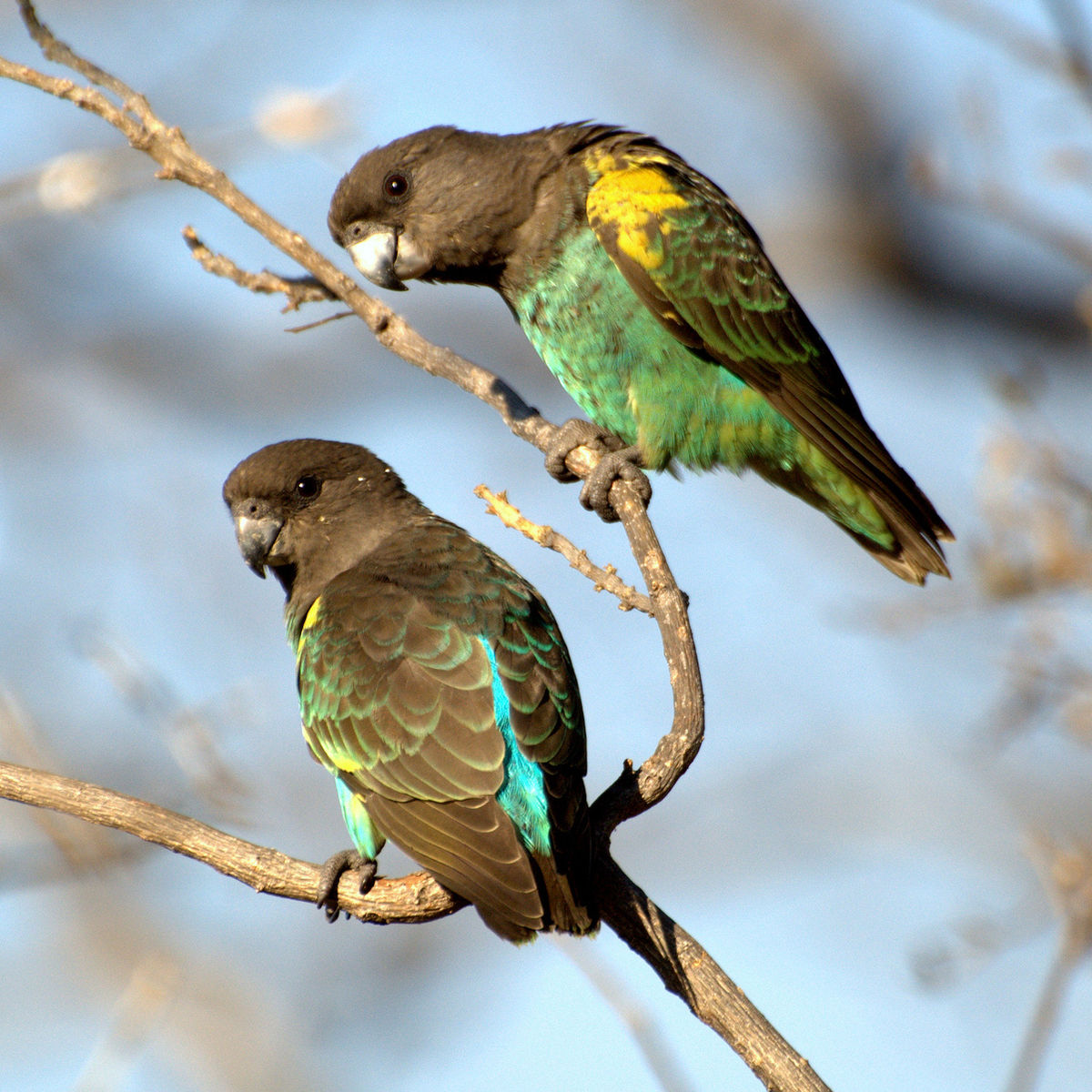
Wikipedia: Meyer's parrot Quelle: OTHER
1200px-Poicephalus_meyeri_-Zimbabwe_-two-8-3c.jpg
![]() Der Goldbugpapagei (Poicephalus meyeri) ist eine Vogelart aus der Familie der Eigentlichen Papageien (Psittacidae). Er gehört zur Gattung der Langflügelpapageien (Poicephalus) und wird manchmal auch Meyerspapagei genannt.
[more]
Der Goldbugpapagei (Poicephalus meyeri) ist eine Vogelart aus der Familie der Eigentlichen Papageien (Psittacidae). Er gehört zur Gattung der Langflügelpapageien (Poicephalus) und wird manchmal auch Meyerspapagei genannt.
[more]
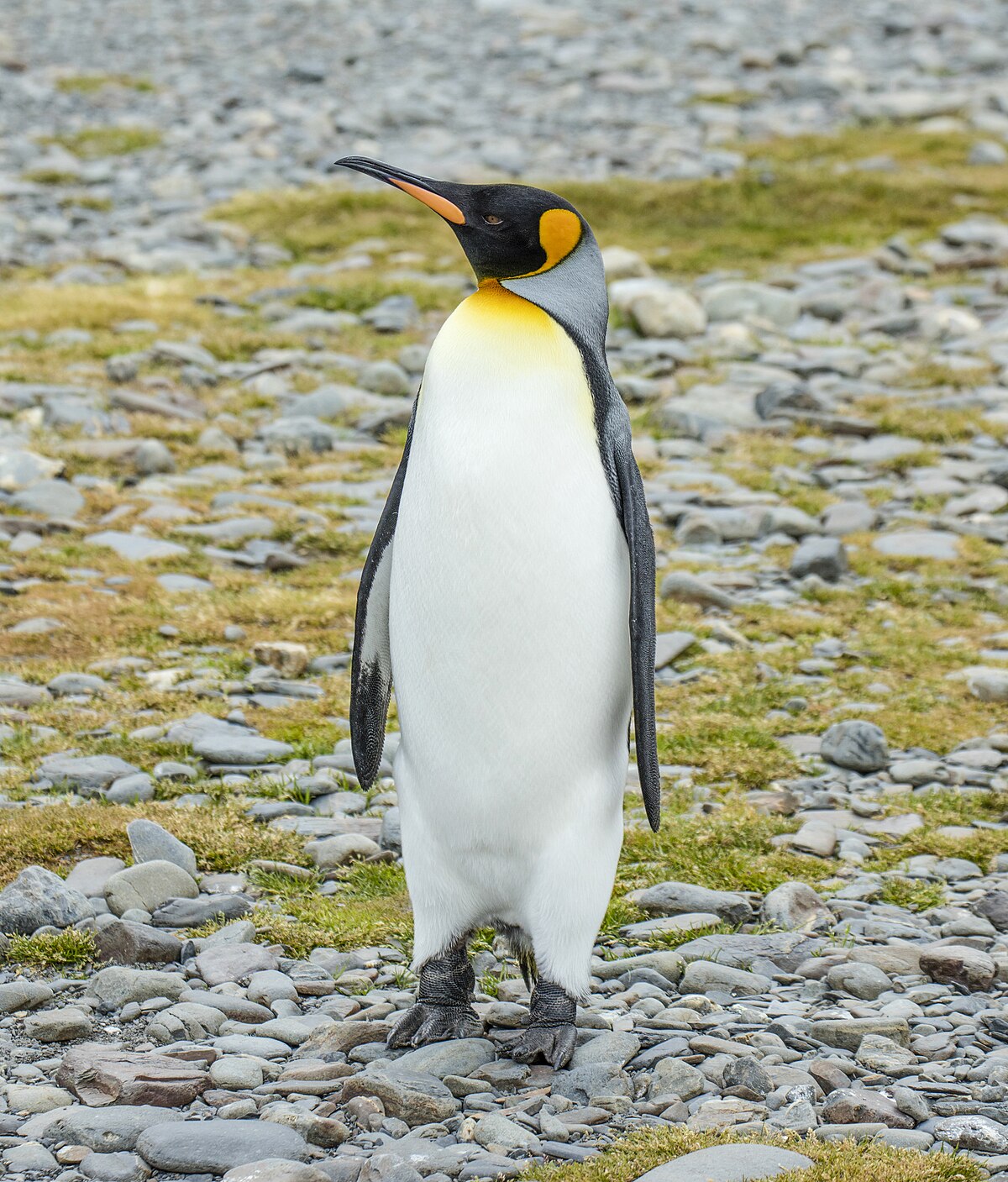
Wikipedia: King penguin Quelle: OTHER
1200px-SGI-2016-South_Georgia_%28Fortuna_Bay%29%E2%80%93King_penguin_%28Aptenodytes_patagonicus%29_04.jpg
![]() Der Königspinguin (Aptenodytes patagonicus) ist nach dem Kaiserpinguin (Aptenodytes forsteri) die zweitgrößte Art der Pinguine (Spheniscidae) und wird zusammen mit dem Kaiserpinguin zu der Gattung der Großpinguine (Aptenodytes) gezählt. Es werden derzeit für den Königspinguin zwei Unterarten unterschieden.
[more]
Der Königspinguin (Aptenodytes patagonicus) ist nach dem Kaiserpinguin (Aptenodytes forsteri) die zweitgrößte Art der Pinguine (Spheniscidae) und wird zusammen mit dem Kaiserpinguin zu der Gattung der Großpinguine (Aptenodytes) gezählt. Es werden derzeit für den Königspinguin zwei Unterarten unterschieden.
[more]

Wikipedia: Northern rockhopper penguin Quelle: OTHER
1200px-Eudyptes_moseleyi_-Zoologischer_Garten_Berlin%2C_Germany-8a.jpg
![]() The northern rockhopper penguin, Moseley's rockhopper penguin, or Moseley's penguin (Eudyptes moseleyi) is a penguin species native to the southern Indian and Atlantic Oceans. It was described as distinct from the southern rockhopper penguin.
[more]
The northern rockhopper penguin, Moseley's rockhopper penguin, or Moseley's penguin (Eudyptes moseleyi) is a penguin species native to the southern Indian and Atlantic Oceans. It was described as distinct from the southern rockhopper penguin.
[more]
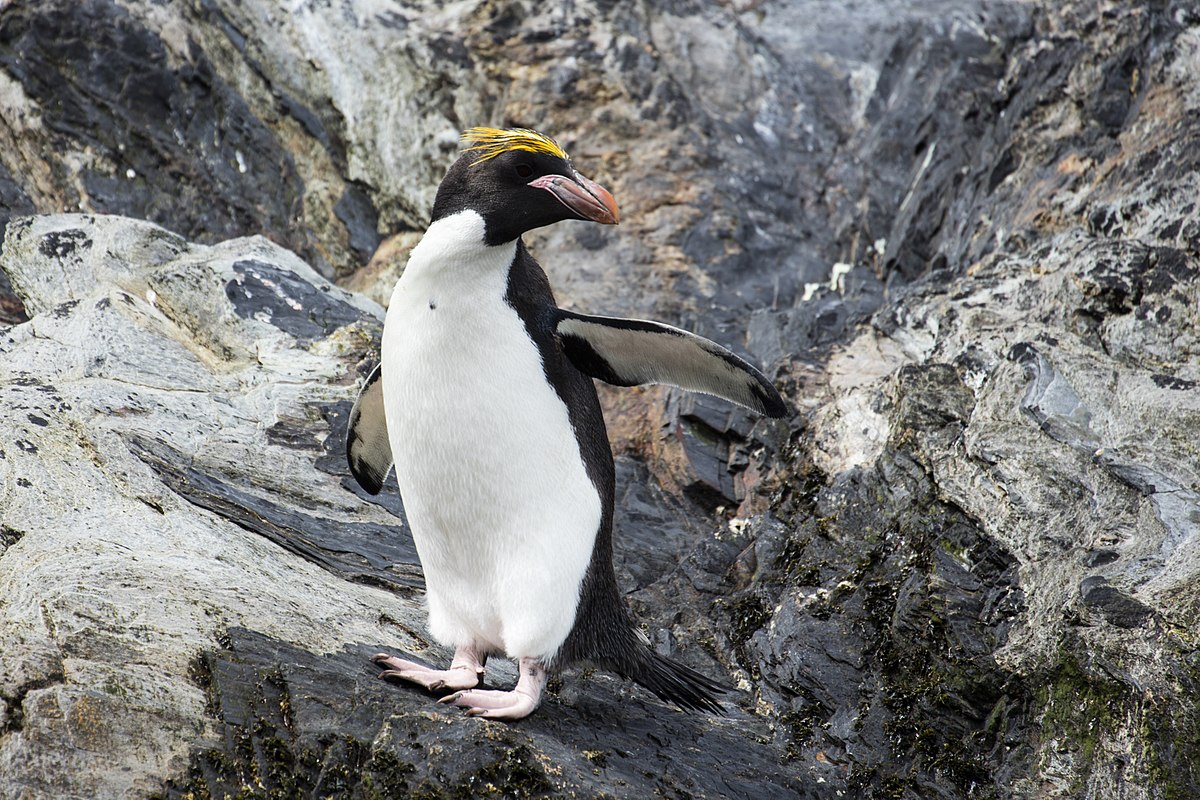
Wikipedia: Macaroni penguin Quelle: OTHER
1200px-SGI-2016-South_Georgia_%28Cooper_Bay%29%E2%80%93Macaroni_penguin_%28Eudyptes_chrysolophus%29_01.jpg
![]() Der Goldschopfpinguin (Eudyptes chrysolophus) ist eine Pinguinart aus der Gattung der Schopfpinguine. Er ist weltweit die häufigste Pinguinart und kommt auf vielen subantarktischen Inseln sowie im äußersten Süden Südamerikas vor. Trotz der großen Population schätzt die IUCN den Goldschopfpinguin als gefährdet (vulnerable) ein, weil seit mindestens drei Generationen die Populationszahlen stark zurückgehen.[1] Es werden keine Unterarten unterschieden.
[more]
Der Goldschopfpinguin (Eudyptes chrysolophus) ist eine Pinguinart aus der Gattung der Schopfpinguine. Er ist weltweit die häufigste Pinguinart und kommt auf vielen subantarktischen Inseln sowie im äußersten Süden Südamerikas vor. Trotz der großen Population schätzt die IUCN den Goldschopfpinguin als gefährdet (vulnerable) ein, weil seit mindestens drei Generationen die Populationszahlen stark zurückgehen.[1] Es werden keine Unterarten unterschieden.
[more]
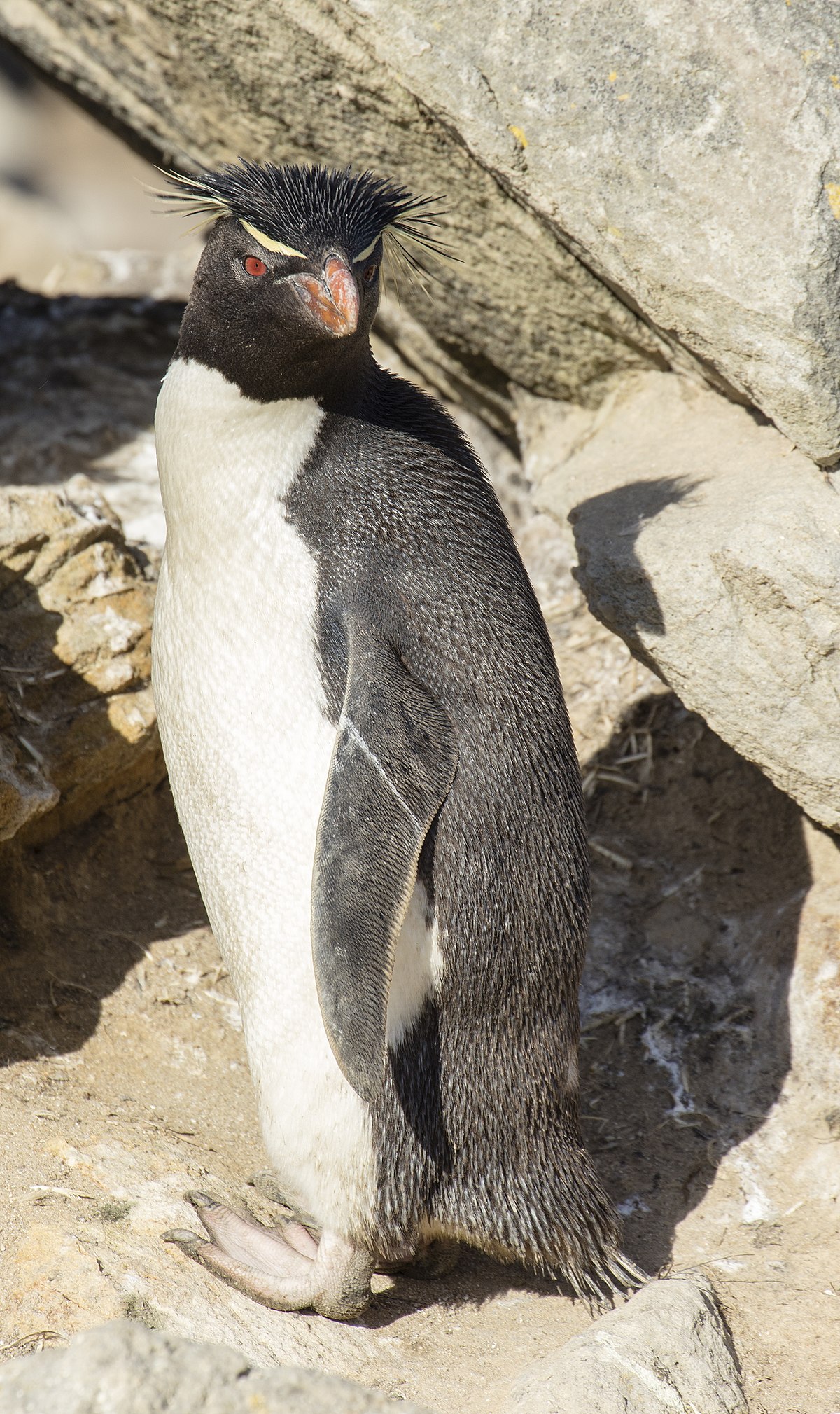
Wikipedia: Rockhopper penguin Quelle: OTHER
1200px-FAL-2016-New_Island%2C_Falkland_Islands-Rockhopper_penguin_%28Eudyptes_chrysocome%29_05.jpg
African penguin. 2009-11-03 11.56.42 Gqeberha (frueher Port Elisabeth)
Zuerst beobachtet in Gqeberha (frueher Port Elisabeth) an 2009-11-03.
![]() Der Brillenpinguin (Spheniscus demersus) gehört zur gleichnamigen Gattung innerhalb der Familie der Pinguine (Spheniscidae). Sie sind die einzigen heute noch in freier Wildbahn lebenden Pinguine Afrikas.
[more]
Der Brillenpinguin (Spheniscus demersus) gehört zur gleichnamigen Gattung innerhalb der Familie der Pinguine (Spheniscidae). Sie sind die einzigen heute noch in freier Wildbahn lebenden Pinguine Afrikas.
[more]
Profil Wikipedia eBird Vogelwarte BirdLife ZH ornitho.ch bird-song.ch Xeno-Canto BirdID NABU
Zwergtaucher. 2022-06-25 12.07.24 La Sauge
Zuerst beobachtet in Gqeberha (frueher Port Elisabeth) an 2009-10-22.
![]() Der Zwergtaucher (Tachybaptus ruficollis) ist eine Art aus der Familie der Lappentaucher. In Europa ist diese in Eurasien und Afrika verbreitete Art der kleinste Vertreter dieser Familie. Zwergtaucher sind in Europa durchaus häufig. Sie werden jedoch wegen ihres unauffälligen Gefieders und ihrer insbesondere während der Brutzeit sehr versteckten Lebensweise meist übersehen.
[more]
Der Zwergtaucher (Tachybaptus ruficollis) ist eine Art aus der Familie der Lappentaucher. In Europa ist diese in Eurasien und Afrika verbreitete Art der kleinste Vertreter dieser Familie. Zwergtaucher sind in Europa durchaus häufig. Sie werden jedoch wegen ihres unauffälligen Gefieders und ihrer insbesondere während der Brutzeit sehr versteckten Lebensweise meist übersehen.
[more]
Vokalisierung: ![]() Relatively vocal compared to many other grebes. [Link]
Relatively vocal compared to many other grebes. [Link]
Rufe: ![]() Call; sometimes a single quite clear high pitched "dydlylyyt". More often combined into longer phrases with harsher quality, oscillating like laughter and travelling up and down in pitch in agitated motion. Reminiscent of female Cuckoo. [Link]
Call; sometimes a single quite clear high pitched "dydlylyyt". More often combined into longer phrases with harsher quality, oscillating like laughter and travelling up and down in pitch in agitated motion. Reminiscent of female Cuckoo. [Link]
Körperlich: Länge=25-29 cm,
Flügelspanne=40-45 cm,
Gewicht=140-193 g
Habitate:
Fluss und See
Profil Wikipedia eBird Audubon AllAboutBirds Xeno-Canto BirdID NABU
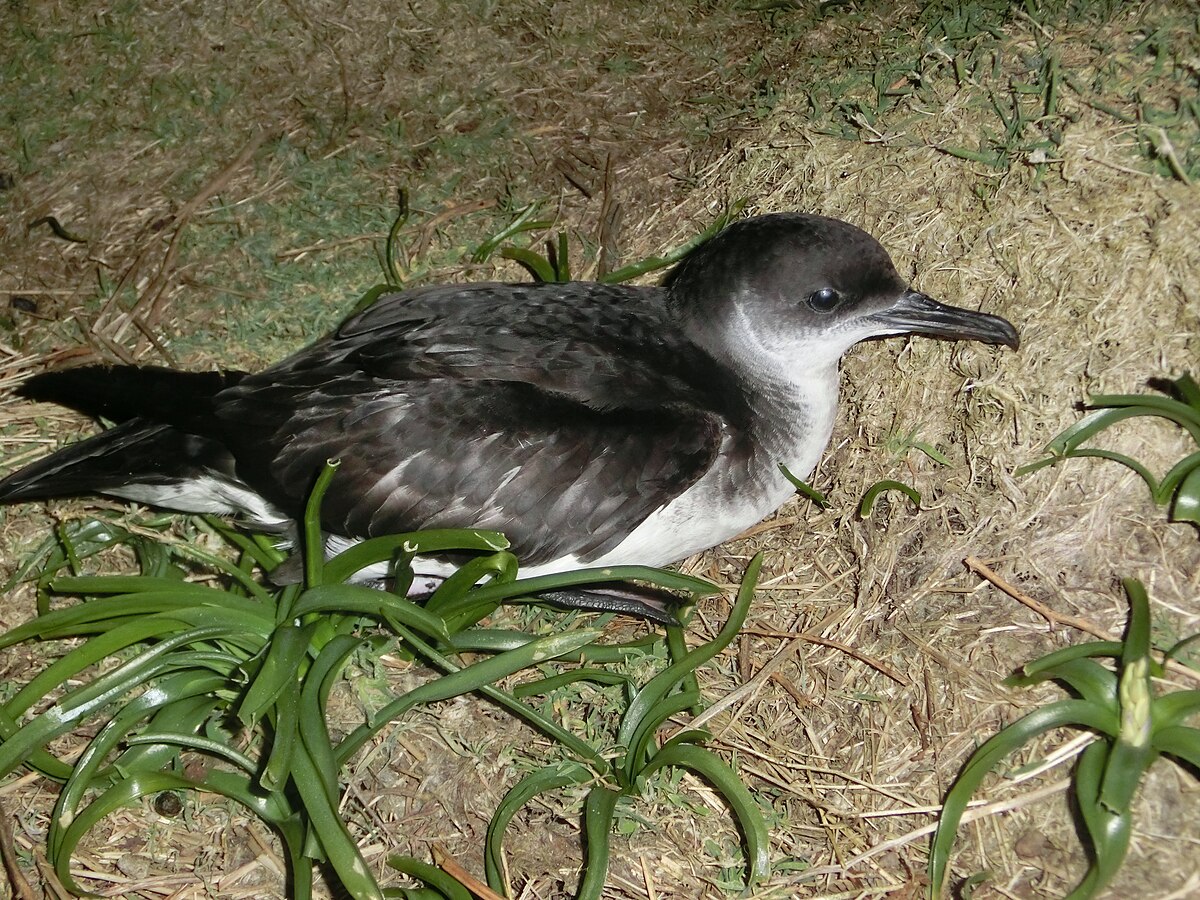
Wikipedia: Manx shearwater Quelle: OTHER
1200px-Manx_Shearwater.JPG
Dieser Vogel erscheint jenseits grossen Meere in Kontinenten :
Europa, Nordamerika, Afrika.
Allgemein: ![]() Der Atlantiksturmtaucher (Puffinus puffinus) ist eine Vogelart aus der Familie der Sturmvögel (Procellariidae), deren Brutplätze an Inseln und Küsten des nördlichen Atlantiks liegen. Nach der Brutzeit ziehen die Vögel in den südlichen Atlantik und überwintern auf dem offenen Meer vor der Küste Brasiliens und Argentiniens. Die Art nistet in Erdhöhlen, ist an den Nistplätzen nachtaktiv und fällt durch ihre unheimlich wirkenden, heiser krähenden und gackernden Laute auf. Während der eine Partner brütet, unternimmt der andere Partner hunderte Kilometer weite, oft bis zu zwei Tage dauernde Nahrungsflüge. Die Nahrung besteht vorwiegend aus kleinen Schwarmfischen, gelegentlich aber auch kleinen Tintenfischen oder Krebsen.
[more]
Der Atlantiksturmtaucher (Puffinus puffinus) ist eine Vogelart aus der Familie der Sturmvögel (Procellariidae), deren Brutplätze an Inseln und Küsten des nördlichen Atlantiks liegen. Nach der Brutzeit ziehen die Vögel in den südlichen Atlantik und überwintern auf dem offenen Meer vor der Küste Brasiliens und Argentiniens. Die Art nistet in Erdhöhlen, ist an den Nistplätzen nachtaktiv und fällt durch ihre unheimlich wirkenden, heiser krähenden und gackernden Laute auf. Während der eine Partner brütet, unternimmt der andere Partner hunderte Kilometer weite, oft bis zu zwei Tage dauernde Nahrungsflüge. Die Nahrung besteht vorwiegend aus kleinen Schwarmfischen, gelegentlich aber auch kleinen Tintenfischen oder Krebsen.
[more]
Vokalisierung: ![]() Vocal at breeding ground. [Link]
Vocal at breeding ground. [Link]
Rufe: ![]() The call is sharp and wailing, and consist of two parts. A drawn, "inhalation", is immediately followed by a trisyllabic "ka-ya-ya". [Link]
The call is sharp and wailing, and consist of two parts. A drawn, "inhalation", is immediately followed by a trisyllabic "ka-ya-ya". [Link]
Körperlich: Länge=31-36 cm,
Flügelspanne=76-88 cm,
Gewicht=375-459 g

Wikipedia: Subantarctic shearwater Quelle: OTHER
PuffinusElegansKeulemans.jpg
Allgemein: ![]() The subantarctic shearwater (Puffinus elegans) is a small bird species which breeds in Tristan da Cunha, islands of the southern Indian Ocean and New Zealand Subantarctic Islands.
[more]
The subantarctic shearwater (Puffinus elegans) is a small bird species which breeds in Tristan da Cunha, islands of the southern Indian Ocean and New Zealand Subantarctic Islands.
[more]

Wikipedia: Tropical shearwater Quelle: OTHER
P%C3%A9trel_de_Barau_.jpg
Dieser Vogel erscheint jenseits grossen Meere in Kontinenten :
Nordamerika, Afrika.
![]() The tropical shearwater (Puffinus bailloni) is a seabird in the family Procellariidae formerly considered conspecific with Audubon's shearwater (Puffinus lherminieri).[2]
[more]
The tropical shearwater (Puffinus bailloni) is a seabird in the family Procellariidae formerly considered conspecific with Audubon's shearwater (Puffinus lherminieri).[2]
[more]
Profil Wikipedia eBird Xeno-Canto

Wikipedia: Southern fulmar Quelle: OTHER
1200px-Fulmarus_glacialoides_-_SE_Tasmania.jpg
![]() The southern fulmar (Fulmarus glacialoides) is a seabird of the Southern Hemisphere. Along with the northern fulmar, F. glacialis, it belongs to the fulmar genus Fulmarus in the family Procellariidae, the true petrels. It is also known as the Antarctic fulmar[1] or silver-grey fulmar.[2]
[more]
The southern fulmar (Fulmarus glacialoides) is a seabird of the Southern Hemisphere. Along with the northern fulmar, F. glacialis, it belongs to the fulmar genus Fulmarus in the family Procellariidae, the true petrels. It is also known as the Antarctic fulmar[1] or silver-grey fulmar.[2]
[more]
Profil Wikipedia eBird Xeno-Canto

Wikipedia: Cape petrel Quelle: OTHER
1200px-Daption_capense_in_flight_2_-_SE_Tasmania.jpg
![]() Der Kapsturmvogel (Daption capense) ist ein relativ bekannter Vogel aus der Familie der Sturmvögel.
[more]
Der Kapsturmvogel (Daption capense) ist ein relativ bekannter Vogel aus der Familie der Sturmvögel.
[more]
Profil Wikipedia eBird Xeno-Canto
In flight is perhaps a southern giant petrel. 2019-02-07 09.34.10 Patagonien
Zuerst beobachtet in Patagonien an 2019-02-07.
![]() Der Riesensturmvogel (Macronectes giganteus) ist ein Brutvogel des antarktischen Festlands sowie vieler subantarktischer Inseln aus der Familie der Sturmvögel (Procellariidae). Er verbringt sein Leben überwiegend auf hoher See und ist dann bis zum südlichen Wendekreis anzutreffen.
[more]
Der Riesensturmvogel (Macronectes giganteus) ist ein Brutvogel des antarktischen Festlands sowie vieler subantarktischer Inseln aus der Familie der Sturmvögel (Procellariidae). Er verbringt sein Leben überwiegend auf hoher See und ist dann bis zum südlichen Wendekreis anzutreffen.
[more]
Profil Wikipedia eBird Xeno-Canto

Wikipedia: Northern giant-petrel Quelle: OTHER
1200px-Macronectes_halli_-Godthul%2C_South_Georgia%2C_British_Overseas_Territories%2C_UK_-flying-8.jpg
![]() Der Hall-Sturmvogel (Macronectes halli), auch Nördlicher Riesensturmvogel genannt, ist ein überwiegend dunkel gefärbter Brutvogel der subantarktischen Zone.
[more]
Der Hall-Sturmvogel (Macronectes halli), auch Nördlicher Riesensturmvogel genannt, ist ein überwiegend dunkel gefärbter Brutvogel der subantarktischen Zone.
[more]
Profil Wikipedia eBird Xeno-Canto

Wikipedia: Antarctic prion Quelle: OTHER
Pachyptila_desolata_-South_Atlantic_-flying-8.jpg
![]() Der Taubensturmvogel (Pachyptila desolata), auch als Antarktis-Walvogel bezeichnet, ist eine Vogelart aus der Gattung der Walvögel (Pachyptila) innerhalb der Familie der Sturmvögel (Procellariidae). Es werden bis zu drei Unterarten unterschieden.[1]
[more]
Der Taubensturmvogel (Pachyptila desolata), auch als Antarktis-Walvogel bezeichnet, ist eine Vogelart aus der Gattung der Walvögel (Pachyptila) innerhalb der Familie der Sturmvögel (Procellariidae). Es werden bis zu drei Unterarten unterschieden.[1]
[more]
Profil Wikipedia eBird Xeno-Canto

Wikipedia: Salvin's prion Quelle: OTHER
Medium-billed_Prion.jpg
![]() Salvin's prion (Pachyptila salvini), also known as the medium-billed prion, is a species of seabird in the petrel family Procellariidae.
[more]
Salvin's prion (Pachyptila salvini), also known as the medium-billed prion, is a species of seabird in the petrel family Procellariidae.
[more]
Profil Wikipedia eBird Xeno-Canto

Wikipedia: Slender-billed prion Quelle: OTHER
1200px-Slender-billed_Prion_Close.jpg
![]() Der Belcher-Sturmvogel (Pachyptila belcheri), auch Dünnschnabel-Sturmvogel genannt, ist eine monotypische Art aus der Familie der Sturmvögel. Die IUCN stuft die Art als ungefährdet (least concern) ein, da das Verbreitungsgebiet sehr groß ist und der Bestand stabil erscheint. Der Weltbestand wird auf mindestens 7 Mio. geschlechtsreife Individuen geschätzt.[1]
[more]
Der Belcher-Sturmvogel (Pachyptila belcheri), auch Dünnschnabel-Sturmvogel genannt, ist eine monotypische Art aus der Familie der Sturmvögel. Die IUCN stuft die Art als ungefährdet (least concern) ein, da das Verbreitungsgebiet sehr groß ist und der Bestand stabil erscheint. Der Weltbestand wird auf mindestens 7 Mio. geschlechtsreife Individuen geschätzt.[1]
[more]
Profil Wikipedia eBird Xeno-Canto
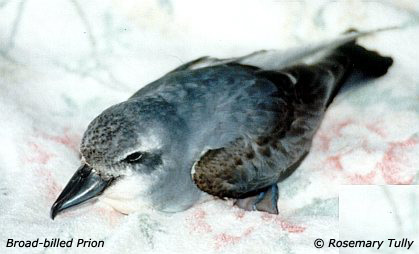
Wikipedia: Broad-billed prion Quelle: OTHER
Broad_billed_prion.jpg
![]() The broad-billed prion (Pachyptila vittata) is a small seabird, but the largest prion, with grey upperparts plumage, and white underparts. It has many other names that have been used such as blue-billed dove-petrel, broad-billed dove-petrel, long-billed prion, common prion, icebird, and whalebird.[2]
[more]
The broad-billed prion (Pachyptila vittata) is a small seabird, but the largest prion, with grey upperparts plumage, and white underparts. It has many other names that have been used such as blue-billed dove-petrel, broad-billed dove-petrel, long-billed prion, common prion, icebird, and whalebird.[2]
[more]
Profil Wikipedia eBird Xeno-Canto

Wikipedia: Fairy prion Quelle: OTHER
1200px-Fairy_Prion_with_egg.jpg
![]() Der Feensturmvogel (Pachyptila turtur) ist ein Hochseevogel aus der Familie der Sturmvögel.
[more]
Der Feensturmvogel (Pachyptila turtur) ist ein Hochseevogel aus der Familie der Sturmvögel.
[more]
Profil Wikipedia eBird Xeno-Canto

Wikipedia: White-chinned petrel Quelle: OTHER
1200px-Procellaria_aequinoctialis_1_-_SE_Tasmania.jpg
![]() Der Weißkinn-Sturmvogel (Procellaria aequinoctialis) ist eine monotypische Art aus der Familie der Sturmvögel. Es handelt sich um einen großen, kräftig gebauten Sturmvogel, der im Süden der Südhalbkugel vorkommt. Zu den bestandsbedrohenden Faktoren für diese Art gehört vor allem die Langleinenfischerei.
[more]
Der Weißkinn-Sturmvogel (Procellaria aequinoctialis) ist eine monotypische Art aus der Familie der Sturmvögel. Es handelt sich um einen großen, kräftig gebauten Sturmvogel, der im Süden der Südhalbkugel vorkommt. Zu den bestandsbedrohenden Faktoren für diese Art gehört vor allem die Langleinenfischerei.
[more]
Profil Wikipedia eBird Xeno-Canto

Wikipedia: Spectacled petrel Quelle: OTHER
Spectacled_Petrel%2C_Procellaria_conspicillata_Cropped.jpg
![]() The spectacled petrel (Procellaria conspicillata) is a rare seabird that nests only on the high western plateau of Inaccessible Island in the South Atlantic Tristan da Cunha group. It is one of the largest petrels that nests in burrows.
[more]
The spectacled petrel (Procellaria conspicillata) is a rare seabird that nests only on the high western plateau of Inaccessible Island in the South Atlantic Tristan da Cunha group. It is one of the largest petrels that nests in burrows.
[more]

Wikipedia: Grey petrel Quelle: OTHER
1200px-Procellaria_cinerea_-_SE_Tasmania.jpg
![]() The grey petrel (Procellaria cinerea), also called the brown petrel, pediunker or grey shearwater is a species of seabird in the Procellariidae, or petrel family. It occurs in the open seas of the Southern Hemisphere, mainly between 58°S and 32°S.[2]
[more]
The grey petrel (Procellaria cinerea), also called the brown petrel, pediunker or grey shearwater is a species of seabird in the Procellariidae, or petrel family. It occurs in the open seas of the Southern Hemisphere, mainly between 58°S and 32°S.[2]
[more]
Profil Wikipedia eBird Xeno-Canto

Wikipedia: Soft-plumaged petrel Quelle: OTHER
1200px-Pterodroma_mollis_light_morph_-_SE_Tasmania_2019.jpg
![]() The soft-plumaged petrel (Pterodroma mollis) is a species of seabird in the family Procellariidae.
[more]
The soft-plumaged petrel (Pterodroma mollis) is a species of seabird in the family Procellariidae.
[more]

Wikipedia: Barau's petrel Quelle: OTHER
Pterodroma_baraui%2C_Durban%2C_Birding_Weto%2C_b.jpg
![]() Barau's petrel (Pterodroma baraui) is a medium-sized gadfly petrel from the family Procellariidae. Its main breeding site is the island of Réunion in the Indian Ocean.
[more]
Barau's petrel (Pterodroma baraui) is a medium-sized gadfly petrel from the family Procellariidae. Its main breeding site is the island of Réunion in the Indian Ocean.
[more]

Wikipedia: White-headed petrel Quelle: OTHER
1200px-File-Pterodroma_lessonii_in_flight_1_-_SE_Tasmania_2019.jpg
![]() The white-headed petrel (Pterodroma lessonii), also known as the white-headed fulmar is a species of seabird in the petrel family, or Procellariidae. Its length is about 400 mm.[2]
[more]
The white-headed petrel (Pterodroma lessonii), also known as the white-headed fulmar is a species of seabird in the petrel family, or Procellariidae. Its length is about 400 mm.[2]
[more]
Profil Wikipedia eBird Xeno-Canto

Wikipedia: Atlantic petrel Quelle: OTHER
PterodromaIncerta.jpg
![]() The Atlantic petrel (Pterodroma incerta) is a gadfly petrel endemic to the South Atlantic Ocean. It breeds in enormous colonies on Tristan da Cunha and Gough Island, and ranges at sea from Brazil to Namibia, with most records at sea being to the west of the breeding islands, and along the subtropical convergence.
[more]
The Atlantic petrel (Pterodroma incerta) is a gadfly petrel endemic to the South Atlantic Ocean. It breeds in enormous colonies on Tristan da Cunha and Gough Island, and ranges at sea from Brazil to Namibia, with most records at sea being to the west of the breeding islands, and along the subtropical convergence.
[more]
Profil Wikipedia eBird Xeno-Canto

Wikipedia: Great-winged petrel Quelle: OTHER
1200px-Pterodroma_macroptera_in_flight_3_-_SE_Tasmania.jpg
![]() The great-winged petrel (Pterodroma macroptera) is a petrel.
[more]
The great-winged petrel (Pterodroma macroptera) is a petrel.
[more]

Wikipedia: Streaked shearwater Quelle: OTHER
1200px-Streaked_shearwater_sitting.jpg
![]() The streaked shearwater (Calonectris leucomelas) is a species of seabird. The adult bird averages 48 cm (19 in) in length, with a 122 cm (48 in) wingspan.
[more]
The streaked shearwater (Calonectris leucomelas) is a species of seabird. The adult bird averages 48 cm (19 in) in length, with a 122 cm (48 in) wingspan.
[more]

Wikipedia: Tahiti petrel Quelle: OTHER
Tahitipetrel1.jpg
Dieser Vogel erscheint jenseits grossen Meere in Kontinenten :
Südamerika, Afrika.
![]() Der Tahiti-Sturmvogel (Pseudobulweria rostrata) ist eine Vogelart aus der Familie der Sturmvögel. Die Art kommt überwiegend auf der südlichen Halbkugel über dem tropischen und subtropischen Pazifik vor. Die IUCN führt den Tahiti-Sturmvogel auf ihrer Vorwarnliste near threatened und schätzt den Bestand auf 20.000 geschlechtsreife Individuen.[1]
[more]
Der Tahiti-Sturmvogel (Pseudobulweria rostrata) ist eine Vogelart aus der Familie der Sturmvögel. Die Art kommt überwiegend auf der südlichen Halbkugel über dem tropischen und subtropischen Pazifik vor. Die IUCN führt den Tahiti-Sturmvogel auf ihrer Vorwarnliste near threatened und schätzt den Bestand auf 20.000 geschlechtsreife Individuen.[1]
[more]

Wikipedia: Kerguelen petrel Quelle: OTHER
LugensaBrevirostris.jpg
![]() The Kerguelen petrel (Aphrodroma brevirostris) is a small (36 cm long) slate-grey seabird in the family Procellariidae. The species has been described as a "taxonomic oddball", being placed for a long time in Pterodroma (the gadfly petrels) before being split out in 1942 into its own genus Aphrodroma. The position within the procellariids is still a matter of debate; when it was split away from the Pterodroma petrels it was suggested that it may be a fulmarine petrel, whereas a 1998 study placed the species close to the shearwaters and the genus Bulweria.[2]
[more]
The Kerguelen petrel (Aphrodroma brevirostris) is a small (36 cm long) slate-grey seabird in the family Procellariidae. The species has been described as a "taxonomic oddball", being placed for a long time in Pterodroma (the gadfly petrels) before being split out in 1942 into its own genus Aphrodroma. The position within the procellariids is still a matter of debate; when it was split away from the Pterodroma petrels it was suggested that it may be a fulmarine petrel, whereas a 1998 study placed the species close to the shearwaters and the genus Bulweria.[2]
[more]
Profil Wikipedia eBird Xeno-Canto
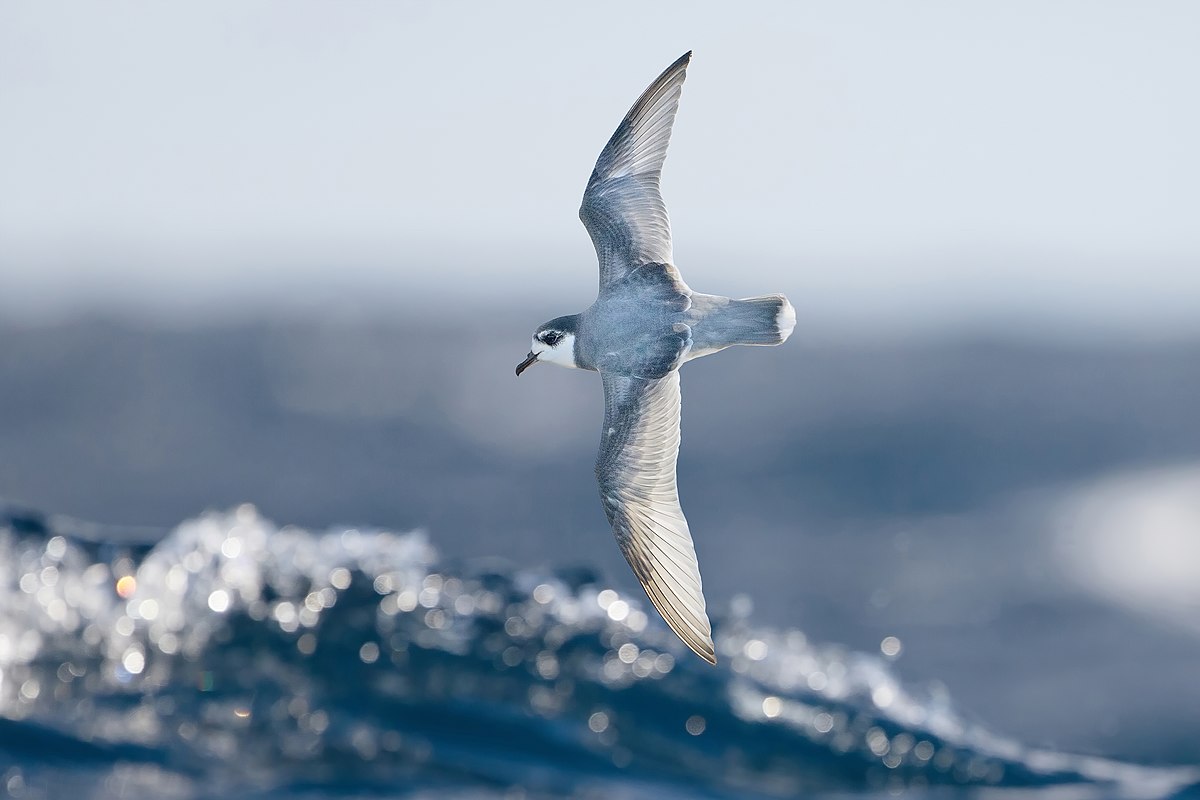
Wikipedia: Blue petrel Quelle: OTHER
1200px-Halobaena_caerulea_in_flight_-_SE_Tasmania.jpg
![]() Der Blausturmvogel (Halobaena caerulea) ist eine monotypische Vogelart aus der Familie der Sturmvögel (Procellariidae). Es handelt sich um einen sehr kleinen Sturmvogel, der große Ähnlichkeit mit den Walvögeln aufweist. Wesentliches Unterscheidungsmerkmal ist die dunkle Kopfkappe, die bei Walvögeln nicht vorkommt.
[more]
Der Blausturmvogel (Halobaena caerulea) ist eine monotypische Vogelart aus der Familie der Sturmvögel (Procellariidae). Es handelt sich um einen sehr kleinen Sturmvogel, der große Ähnlichkeit mit den Walvögeln aufweist. Wesentliches Unterscheidungsmerkmal ist die dunkle Kopfkappe, die bei Walvögeln nicht vorkommt.
[more]
Profil Wikipedia eBird Xeno-Canto

Wikipedia: Antarctic petrel Quelle: OTHER
1200px-Antarctic_Petrel%2C_Antarctic_Peninsula_%285940362516%29.jpg
![]() Der Antarktiksturmvogel (Thalassoica antarctica auch Antarktissturmvogel[1][2], Weißflügel-Sturmvogel[3][4] oder Weißflügelsturmvogel[5]) ist ein typischer Brutvogel der Antarktis.
[more]
Der Antarktiksturmvogel (Thalassoica antarctica auch Antarktissturmvogel[1][2], Weißflügel-Sturmvogel[3][4] oder Weißflügelsturmvogel[5]) ist ein typischer Brutvogel der Antarktis.
[more]
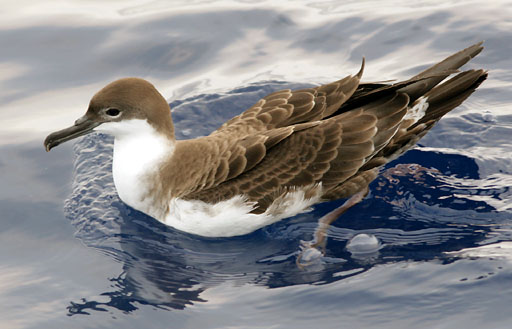
Wikipedia: Great shearwater Quelle: OTHER
Puffinus_gravisPCCA20070623-3641B.jpg
Dieser Vogel erscheint jenseits grossen Meere in Kontinenten :
Europa, Nordamerika, Afrika.
![]() Der Große Sturmtaucher (Ardenna gravis, Synonym: Puffinus gravis), gelegentlich auch als Kappensturmtaucher bezeichnet, ist ein großer Seevogel aus der Ordnung der Röhrennasen.
[more]
Der Große Sturmtaucher (Ardenna gravis, Synonym: Puffinus gravis), gelegentlich auch als Kappensturmtaucher bezeichnet, ist ein großer Seevogel aus der Ordnung der Röhrennasen.
[more]
Rufe: ![]() Calls at breeding ground a deep, soft, moaning "oooh-aahh" ("surprised or shocked old lady"). Tone fairly clear, and pitch rising and falling. [Link]
Calls at breeding ground a deep, soft, moaning "oooh-aahh" ("surprised or shocked old lady"). Tone fairly clear, and pitch rising and falling. [Link]
Körperlich: Länge=43-51 cm,
Flügelspanne=100-118 cm,
Gewicht=715-950 g

Wikipedia: Sooty shearwater Quelle: OTHER
1200px-Puffinus_griseus_in_flight_-_SE_Tasmania.jpg
Dieser Vogel erscheint jenseits grossen Meere in Kontinenten :
Europa, Südamerika, Afrika.
Allgemein: ![]() The sooty shearwater (Ardenna grisea) is a medium-large shearwater in the seabird family Procellariidae. Ardenna was first used to refer to a seabird by Italian naturalist Ulisse Aldrovandi in 1603, and grisea is medieval Latin for "grey".[2]
[more]
The sooty shearwater (Ardenna grisea) is a medium-large shearwater in the seabird family Procellariidae. Ardenna was first used to refer to a seabird by Italian naturalist Ulisse Aldrovandi in 1603, and grisea is medieval Latin for "grey".[2]
[more]
Vokalisierung: ![]() Mostly heard at breeding ground. A peculiar, rhythmic, coarse moaning, with a disyllabic attack, followed by a deeper, cooing "in-breath". [Link]
Mostly heard at breeding ground. A peculiar, rhythmic, coarse moaning, with a disyllabic attack, followed by a deeper, cooing "in-breath". [Link]
Körperlich: Länge=40-51 cm,
Flügelspanne=94-109 cm,
Gewicht=666-978 g
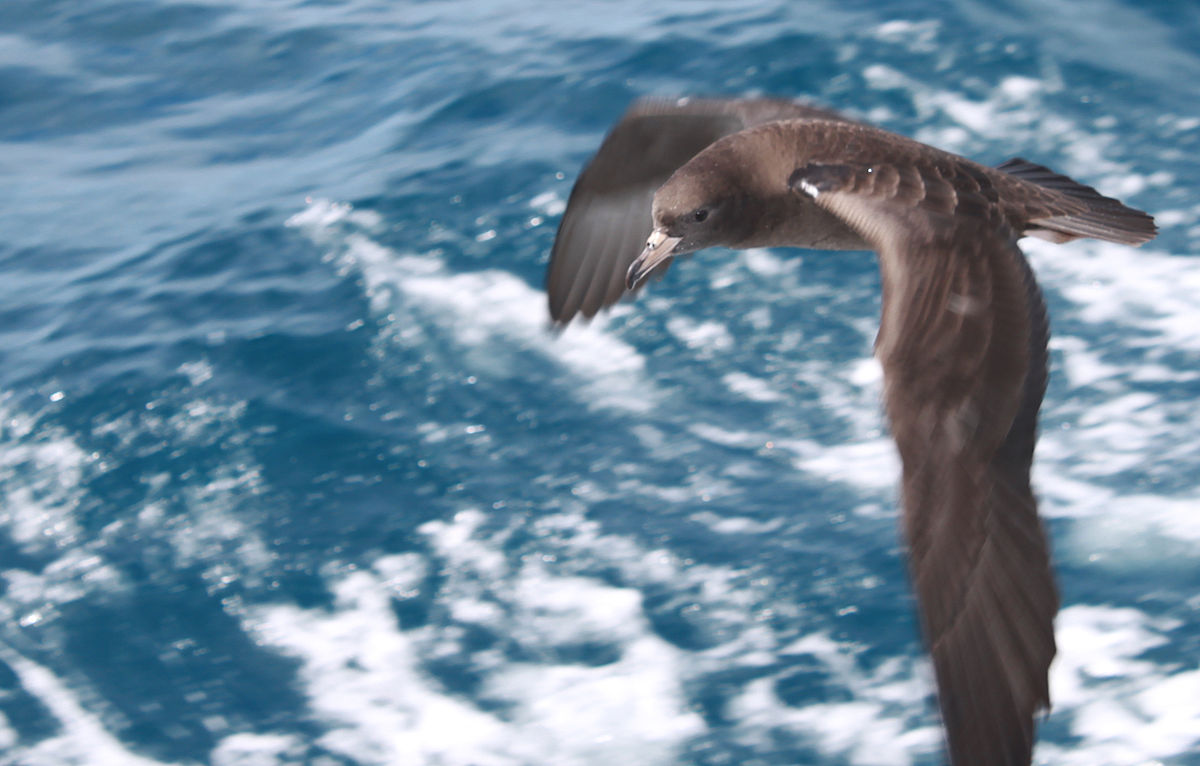
Wikipedia: Flesh-footed shearwater Quelle: OTHER
1200px-Puffinus_carneipes_-New_Zealand_-flying-8b.jpg
Dieser Vogel erscheint jenseits grossen Meere in Kontinenten :
Nordamerika, Afrika.
Allgemein: ![]() The flesh-footed shearwater (Ardenna carneipes; formerly Puffinus carneipes) is a medium-sized shearwater. Its plumage is black. It has pale pinkish feet, and a pale bill with a distinct black tip. Together with the equally light-billed pink-footed shearwater, it forms the Hemipuffinus group, a superspecies which may or may not have an Atlantic relative in the great shearwater.[2][3] These large shearwaters are among those that have been separated into the genus Ardenna.[4] Recent genetic analysis indicates evidence of strong divergence between Pacific colonies relative to those in South and Western Australia, thought to be explained by philopatry and differences in foraging strategies during the breeding season.[5]
[more]
The flesh-footed shearwater (Ardenna carneipes; formerly Puffinus carneipes) is a medium-sized shearwater. Its plumage is black. It has pale pinkish feet, and a pale bill with a distinct black tip. Together with the equally light-billed pink-footed shearwater, it forms the Hemipuffinus group, a superspecies which may or may not have an Atlantic relative in the great shearwater.[2][3] These large shearwaters are among those that have been separated into the genus Ardenna.[4] Recent genetic analysis indicates evidence of strong divergence between Pacific colonies relative to those in South and Western Australia, thought to be explained by philopatry and differences in foraging strategies during the breeding season.[5]
[more]

Wikipedia: Wedge-tailed shearwater Quelle: OTHER
Wedge_tailed_shearwater2.jpg
Dieser Vogel erscheint jenseits grossen Meere in Kontinenten :
Südamerika, Afrika, Asien.
![]() The wedge-tailed shearwater (Ardenna pacifica) is a medium-large shearwater in the seabird family Procellariidae. It is one of the shearwater species that is sometimes referred to as a muttonbird, like the sooty shearwater of New Zealand and the short-tailed shearwater of Australia. It ranges throughout the tropical Pacific and Indian Oceans, roughly between latitudes 35°N and 35°S. It breeds on islands off Japan, on the Islas Revillagigedo, the Hawaiian Islands, the Seychelles, the Northern Mariana Islands, and off Eastern and Western Australia.
[more]
The wedge-tailed shearwater (Ardenna pacifica) is a medium-large shearwater in the seabird family Procellariidae. It is one of the shearwater species that is sometimes referred to as a muttonbird, like the sooty shearwater of New Zealand and the short-tailed shearwater of Australia. It ranges throughout the tropical Pacific and Indian Oceans, roughly between latitudes 35°N and 35°S. It breeds on islands off Japan, on the Islas Revillagigedo, the Hawaiian Islands, the Seychelles, the Northern Mariana Islands, and off Eastern and Western Australia.
[more]
Profil Wikipedia eBird Xeno-Canto

Wikipedia: Wandering albatross Quelle: OTHER
1200px-Diomedea_exulans_-_SE_Tasmania.jpg
![]() The wandering albatross, snowy albatross, white-winged albatross or goonie[3] (Diomedea exulans) is a large seabird from the family Diomedeidae, which has a circumpolar range in the Southern Ocean. It was the last species of albatross to be described, and was long considered the same species as the Tristan albatross and the Antipodean albatross. A few authors still consider them all subspecies of the same species.[4] The SACC has a proposal on the table to split this species,[5] and BirdLife International has already split it. Together with the Amsterdam albatross, it forms the wandering albatross species complex. The wandering albatross is one of the two largest members of the genus Diomedea (the great albatrosses), being similar in size to the southern royal albatross. It is one of the largest, best known, and most studied species of bird in the world. It has the greatest known wingspan of any living bird, and is also one of the most far-ranging birds. Some individual wandering albatrosses are known to circumnavigate the Southern Ocean three times, covering more than 120,000 km (75,000 mi), in one year.[6]
[more]
The wandering albatross, snowy albatross, white-winged albatross or goonie[3] (Diomedea exulans) is a large seabird from the family Diomedeidae, which has a circumpolar range in the Southern Ocean. It was the last species of albatross to be described, and was long considered the same species as the Tristan albatross and the Antipodean albatross. A few authors still consider them all subspecies of the same species.[4] The SACC has a proposal on the table to split this species,[5] and BirdLife International has already split it. Together with the Amsterdam albatross, it forms the wandering albatross species complex. The wandering albatross is one of the two largest members of the genus Diomedea (the great albatrosses), being similar in size to the southern royal albatross. It is one of the largest, best known, and most studied species of bird in the world. It has the greatest known wingspan of any living bird, and is also one of the most far-ranging birds. Some individual wandering albatrosses are known to circumnavigate the Southern Ocean three times, covering more than 120,000 km (75,000 mi), in one year.[6]
[more]
Profil Wikipedia eBird Xeno-Canto

Wikipedia: Sooty albatross Quelle: OTHER
Sooty_Albatross_CW.jpg
![]() Der Dunkelalbatros (Phoebetria fusca) ist eine Vogelart aus der Familie der Albatrosse. Es handelt sich um einen mittelgroßen, rußschwarzen Albatros mit charakteristisch langen, schmalen Flügeln und einem schmal auslaufenden Schwanz.
[more]
Der Dunkelalbatros (Phoebetria fusca) ist eine Vogelart aus der Familie der Albatrosse. Es handelt sich um einen mittelgroßen, rußschwarzen Albatros mit charakteristisch langen, schmalen Flügeln und einem schmal auslaufenden Schwanz.
[more]
Profil Wikipedia eBird Xeno-Canto

Wikipedia: Light-mantled albatross Quelle: OTHER
Light_sooty_albatross_flying.jpg
![]() The light-mantled albatross (Phoebetria palpebrata) also known as the grey-mantled albatross or the light-mantled sooty albatross, is a small albatross in the genus Phoebetria, which it shares with the sooty albatross. The light-mantled albatross was first described as Phoebetria palpebrata by Johann Reinhold Forster, in 1785, based on a specimen from south of the Cape of Good Hope.[4]
[more]
The light-mantled albatross (Phoebetria palpebrata) also known as the grey-mantled albatross or the light-mantled sooty albatross, is a small albatross in the genus Phoebetria, which it shares with the sooty albatross. The light-mantled albatross was first described as Phoebetria palpebrata by Johann Reinhold Forster, in 1785, based on a specimen from south of the Cape of Good Hope.[4]
[more]

Wikipedia: Buller's albatross Quelle: OTHER
1200px-Thalassarche_bulleri_in_flight_6_-_SE_Tasmania.jpg
![]() Der Buller-Albatros (Thalassarche bulleri, Syn.: Diomedea bulleri) ist eine Vogelart aus der Familie der Albatrosse (Diomedeidae). Buller-Albatrosse sind kleine, leicht gebaute, und überwiegend schwarzweiße Albatrosse. Die Art ist nach dem neuseeländischen Ornithologen Walter Lawry Buller (1838–1906) benannt.
[more]
Der Buller-Albatros (Thalassarche bulleri, Syn.: Diomedea bulleri) ist eine Vogelart aus der Familie der Albatrosse (Diomedeidae). Buller-Albatrosse sind kleine, leicht gebaute, und überwiegend schwarzweiße Albatrosse. Die Art ist nach dem neuseeländischen Ornithologen Walter Lawry Buller (1838–1906) benannt.
[more]

Wikipedia: Grey-headed albatross Quelle: OTHER
1200px-Thalassarche_chrysostoma_-_SE_Tasmania.jpg
![]() The grey-headed albatross (Thalassarche chrysostoma) also known as the grey-headed mollymawk, is a large seabird from the albatross family. It has a circumpolar distribution, nesting on isolated islands in the Southern Ocean and feeding at high latitudes, further south than any of the other mollymawks. Its name derives from its ashy-grey head, throat and upper neck.
[more]
The grey-headed albatross (Thalassarche chrysostoma) also known as the grey-headed mollymawk, is a large seabird from the albatross family. It has a circumpolar distribution, nesting on isolated islands in the Southern Ocean and feeding at high latitudes, further south than any of the other mollymawks. Its name derives from its ashy-grey head, throat and upper neck.
[more]

Wikipedia: Atlantic yellow-nosed albatross Quelle: OTHER
Thalassarche_chlororhynchos.png
![]() The Atlantic yellow-nosed albatross (Thalassarche chlororhynchos) is a large seabird in the albatross family. The scientific name is from Ancient Greek. Thalassarche is from thalassa, "sea" and arkhe, "command", and chlororhynchos is from khloros, "yellow", and rhunkhos, "bill".[3]
[more]
The Atlantic yellow-nosed albatross (Thalassarche chlororhynchos) is a large seabird in the albatross family. The scientific name is from Ancient Greek. Thalassarche is from thalassa, "sea" and arkhe, "command", and chlororhynchos is from khloros, "yellow", and rhunkhos, "bill".[3]
[more]

Wikipedia: White-capped albatross Quelle: OTHER
White-capped_Albatross_%288076884678%29.jpg
![]() The white-capped albatross (Thalassarche cauta steadi) is a mollymawk that breeds on the islands off of New Zealand. Not all experts agree that this form should be recognized as a separate species from the shy albatross, Thalassarche cauta. It is a medium-sized black, slate gray, and white albatross and is the largest of the mollymawks.[citation needed]
[more]
The white-capped albatross (Thalassarche cauta steadi) is a mollymawk that breeds on the islands off of New Zealand. Not all experts agree that this form should be recognized as a separate species from the shy albatross, Thalassarche cauta. It is a medium-sized black, slate gray, and white albatross and is the largest of the mollymawks.[citation needed]
[more]
Profil Wikipedia eBird Xeno-Canto

Wikipedia: Chatham albatross Quelle: OTHER
Chatham_albatross_%28Thalassarche_eremita%29.jpg
![]() Der Chatham-Albatros (Thalassarche eremita) ist eine Vogelart aus der Familie der Albatrosse. Er wurde lange Zeit als Unterart des Weißkappenalbatros eingeordnet, wird aber seit 1998 als eigenständige Art betrachtet. Die Art wird von der IUCN als gefährdet (vulnerable) eingestuft. Grund für die Einordnung ist der Bestand von lediglich 11.000 geschlechtsreifen Individuen und das sehr kleine Brutgebiet.[1] Außergewöhnliche Ereignisse wirken sich sehr schnell stark auf den Bestand aus. Mehrere starke Stürme im Jahr 1985 haben auf der einzigen Insel, auf der Chatham-Albatrosse brüten, die Zahl der möglichen Brutplätze deutlich reduziert. Die Langleinenfischerei ist ein weiterer bestandsgefährdender Faktor für diese Art.[2]
[more]
Der Chatham-Albatros (Thalassarche eremita) ist eine Vogelart aus der Familie der Albatrosse. Er wurde lange Zeit als Unterart des Weißkappenalbatros eingeordnet, wird aber seit 1998 als eigenständige Art betrachtet. Die Art wird von der IUCN als gefährdet (vulnerable) eingestuft. Grund für die Einordnung ist der Bestand von lediglich 11.000 geschlechtsreifen Individuen und das sehr kleine Brutgebiet.[1] Außergewöhnliche Ereignisse wirken sich sehr schnell stark auf den Bestand aus. Mehrere starke Stürme im Jahr 1985 haben auf der einzigen Insel, auf der Chatham-Albatrosse brüten, die Zahl der möglichen Brutplätze deutlich reduziert. Die Langleinenfischerei ist ein weiterer bestandsgefährdender Faktor für diese Art.[2]
[more]
Profil Wikipedia eBird Xeno-Canto

Wikipedia: Salvin's albatross Quelle: OTHER
1200px-Thalassarche_salvini_-_SE_Tasmania.jpg
![]() Der Salvin-Albatros (Thalassarche salvini), auch Graurückenalbatros genannt, ist eine Art aus der Familie der Albatrosse. Er galt lange als Unterart des Weißkappenalbatros, wird aber seit einigen Jahren als eigenständige Art eingeordnet.
[more]
Der Salvin-Albatros (Thalassarche salvini), auch Graurückenalbatros genannt, ist eine Art aus der Familie der Albatrosse. Er galt lange als Unterart des Weißkappenalbatros, wird aber seit einigen Jahren als eigenständige Art eingeordnet.
[more]
Profil Wikipedia eBird Xeno-Canto

Wikipedia: Indian yellow-nosed albatross Quelle: OTHER
1200px-Thalassarche_carteri_-_SE_Tasmania.jpg
![]() The Indian yellow-nosed albatross (Thalassarche carteri) is a member of the albatross family, and is the smallest of the mollymawks. In 2004, BirdLife International[2] split this species from the Atlantic yellow-nosed albatross; however Clements[3] has not split it yet, and the SACC has not either, but recognises the need for a proposal.[4]
[more]
The Indian yellow-nosed albatross (Thalassarche carteri) is a member of the albatross family, and is the smallest of the mollymawks. In 2004, BirdLife International[2] split this species from the Atlantic yellow-nosed albatross; however Clements[3] has not split it yet, and the SACC has not either, but recognises the need for a proposal.[4]
[more]

Wikipedia: Black-browed albatross Quelle: OTHER
1200px-Thalassarche_melanophrys_-_SE_Tasmania.jpg
![]() The black-browed albatross (Thalassarche melanophris), also known as the black-browed mollymawk,[3] is a large seabird of the albatross family Diomedeidae; it is the most widespread and common member of its family.
[more]
The black-browed albatross (Thalassarche melanophris), also known as the black-browed mollymawk,[3] is a large seabird of the albatross family Diomedeidae; it is the most widespread and common member of its family.
[more]
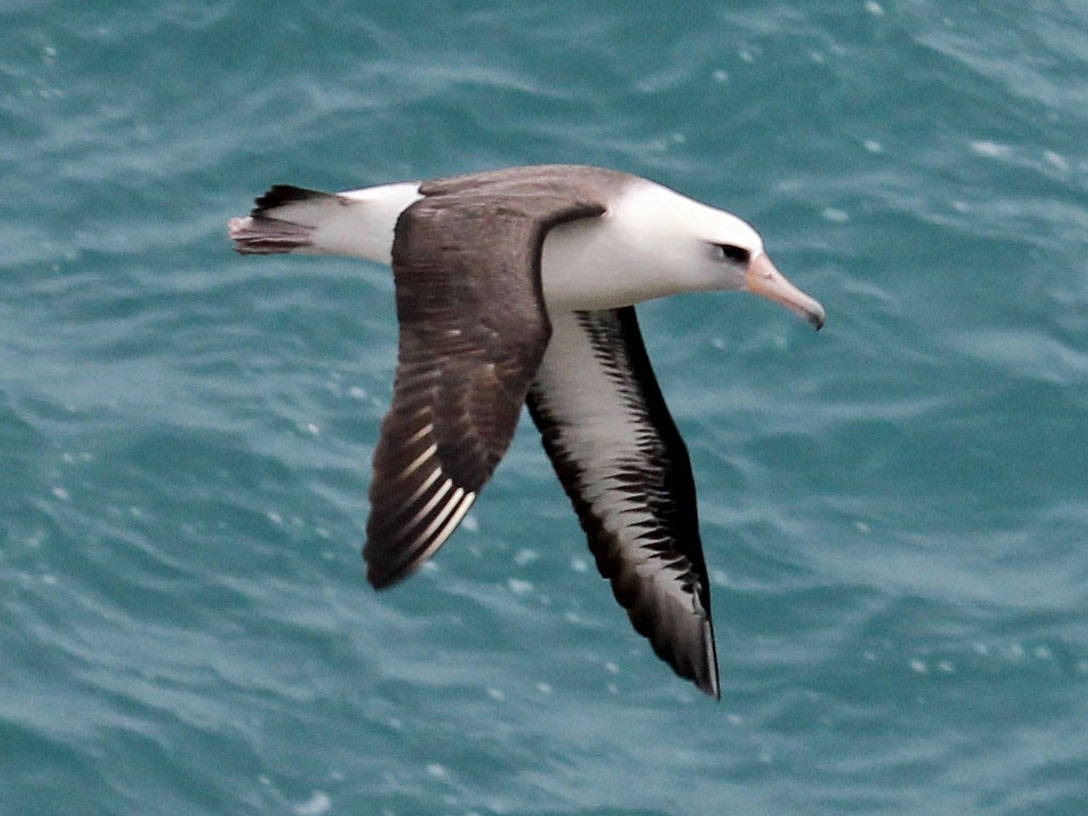
Wikipedia: Laysan albatross Quelle: OTHER
Laysan_Albatross_RWD2.jpg
Dieser Vogel erscheint jenseits grossen Meere in Kontinenten :
Nordamerika, Afrika.
![]() Der Laysanalbatros (Phoebastria immutabilis) ist eine Art der Albatrosse. Trotz seiner Flügelspannweite von etwa zwei Metern ist er die kleinste nordpazifische Albatrosart. Auf Grund seiner dunkelbraunen Körperoberseite, die sich deutlich von der hellen Körperunterseite abhebt, ist er auch bei Feldbeobachtungen leicht zu unterscheiden. Wie alle Albatrosse ist er ein ausgezeichneter Gleitflieger. Bei Windstille fliegt er dicht über dem Wasser, bei windigem Wetter ist für ihn ein zickzackförmiger Flug charakteristisch, bei der er abwechselnd aufsteigt und schräg abwärts gleitet. Sie sind Tag und Nacht aktiv. Während des Tages ruht der Albatros gelegentlich auf der Wasseroberfläche. Dieses Verhalten ist vor allem während Windstillen zu beobachten. Er brütet in großen Brutkolonien, über die Meere streift er meist einzeln.
[more]
Der Laysanalbatros (Phoebastria immutabilis) ist eine Art der Albatrosse. Trotz seiner Flügelspannweite von etwa zwei Metern ist er die kleinste nordpazifische Albatrosart. Auf Grund seiner dunkelbraunen Körperoberseite, die sich deutlich von der hellen Körperunterseite abhebt, ist er auch bei Feldbeobachtungen leicht zu unterscheiden. Wie alle Albatrosse ist er ein ausgezeichneter Gleitflieger. Bei Windstille fliegt er dicht über dem Wasser, bei windigem Wetter ist für ihn ein zickzackförmiger Flug charakteristisch, bei der er abwechselnd aufsteigt und schräg abwärts gleitet. Sie sind Tag und Nacht aktiv. Während des Tages ruht der Albatros gelegentlich auf der Wasseroberfläche. Dieses Verhalten ist vor allem während Windstillen zu beobachten. Er brütet in großen Brutkolonien, über die Meere streift er meist einzeln.
[more]

Wikipedia: Black-bellied storm-petrel Quelle: OTHER
Fregetta_tropica%2C_Kaapse_waters%2C_Birding_Weto%2C_a.jpg
![]() Der Schwarzbauch-Meerläufer (Fregetta tropica) ist eine Art aus der Familie der Südlichen Sturmschwalben. Die Art kommt nur im Süden der Südhalbkugel vor und ist zirkumpolar verbreitet.
[more]
Der Schwarzbauch-Meerläufer (Fregetta tropica) ist eine Art aus der Familie der Südlichen Sturmschwalben. Die Art kommt nur im Süden der Südhalbkugel vor und ist zirkumpolar verbreitet.
[more]

Wikipedia: White-bellied storm-petrel Quelle: OTHER
1200px-White-bellied_Storm-Petrel-Lord_Howe_Island-26March2013.jpg
![]() The white-bellied storm petrel (Fregetta grallaria) is a species of seabird in the family Oceanitidae. It is found in Angola, Argentina, Australia, Brazil, Chile, Ecuador, French Polynesia, French Southern Territories, Maldives, Namibia, New Zealand, Perú, Saint Helena, and South Africa. Its natural habitat is open seas.
[more]
The white-bellied storm petrel (Fregetta grallaria) is a species of seabird in the family Oceanitidae. It is found in Angola, Argentina, Australia, Brazil, Chile, Ecuador, French Polynesia, French Southern Territories, Maldives, Namibia, New Zealand, Perú, Saint Helena, and South Africa. Its natural habitat is open seas.
[more]
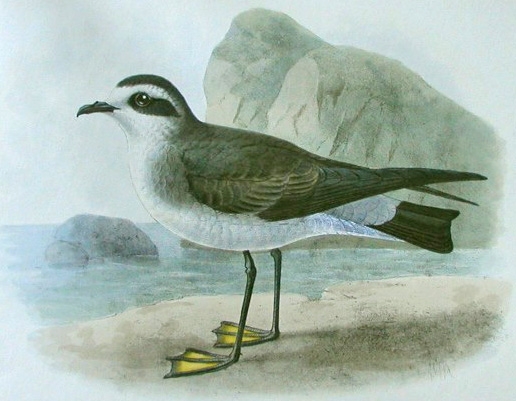
Wikipedia: White-faced storm-petrel Quelle: OTHER
Godmanstormlg.jpg
Dieser Vogel erscheint jenseits grossen Meere in Kontinenten :
Europa, Nordamerika, Südamerika, Afrika.
![]() Die Fregattensturmschwalbe (Pelagodroma marina), auch Weißgesicht-Sturmschwalbe genannt, ist eine Art aus der Familie der Südlichen Sturmschwalben. Sie kommt in sechs Unterarten vor, davon sind zwei in der West-Paläarktis vertreten. Im Gegensatz zu dem, was der Name impliziert, ist diese Art kein Schiffsfolger.[1]
[more]
Die Fregattensturmschwalbe (Pelagodroma marina), auch Weißgesicht-Sturmschwalbe genannt, ist eine Art aus der Familie der Südlichen Sturmschwalben. Sie kommt in sechs Unterarten vor, davon sind zwei in der West-Paläarktis vertreten. Im Gegensatz zu dem, was der Name impliziert, ist diese Art kein Schiffsfolger.[1]
[more]

Wikipedia: Leach's storm-petrel Quelle: OTHER
1200px-Lesp1.jpg
![]() Der Wellenläufer (Oceanodroma leucorhoa) ist eine von weltweit 13 Vogelarten der Gattung der Wellenläufer. Ihren Namen verdanken die Wellenläufer der Verhaltensweise, oft mit herunterhängenden Beinen dicht über dem Wasser zu gleiten. Dabei tauchen sie mit den Füßen ins Wasser ein.
[more]
Der Wellenläufer (Oceanodroma leucorhoa) ist eine von weltweit 13 Vogelarten der Gattung der Wellenläufer. Ihren Namen verdanken die Wellenläufer der Verhaltensweise, oft mit herunterhängenden Beinen dicht über dem Wasser zu gleiten. Dabei tauchen sie mit den Füßen ins Wasser ein.
[more]
Profil Wikipedia eBird Audubon AllAboutBirds Xeno-Canto

Wikipedia: Matsudaira's storm-petrel Quelle: OTHER
012016-IMG_5713_Matsudaira%27s_Storm-Petrel_%28Oceanodroma_matsudairae%29_%288005427860%29.jpg
Dieser Vogel erscheint jenseits grossen Meere in Kontinenten :
Nordamerika, Afrika.
![]() Matsudaira's storm petrel (Oceanodroma matsudairae) is a species of seabird in the family Hydrobatidae.
[more]
Matsudaira's storm petrel (Oceanodroma matsudairae) is a species of seabird in the family Hydrobatidae.
[more]
Profil Wikipedia eBird Xeno-Canto

Wikipedia: Grey-backed storm-petrel Quelle: OTHER
1200px-Garrodia_nereis_1_-_SE_Tasmania.jpg
![]() Die Graurücken-Sturmschwalbe (Garrodia nereis) ist eine Art aus der Familie der Südlichen Sturmschwalben und die einzige rezente Art ihrer Gattung Garrodia.
[more]
Die Graurücken-Sturmschwalbe (Garrodia nereis) ist eine Art aus der Familie der Südlichen Sturmschwalben und die einzige rezente Art ihrer Gattung Garrodia.
[more]

Wikipedia: European storm-petrel Quelle: OTHER
1200px-European_Storm_Petrel_From_The_Crossley_ID_Guide_Eastern_Birds.jpg
![]() The European storm petrel, British storm petrel, or just storm petrel (Hydrobates pelagicus) is a seabird in the northern storm petrel family, Hydrobatidae. It is the only member of the genus Hydrobates. The small, square-tailed bird is entirely black except for a broad, white rump and a white band on the under wings, and it has a fluttering, bat-like flight. The large majority of the population breeds on islands off the coasts of Europe, with the greatest numbers in the Faroe Islands, United Kingdom, Ireland, and Iceland. The Mediterranean population is a separate subspecies, but is inseparable at sea from its Atlantic relatives; its strongholds are Filfla Island (Malta), Sicily, and the Balearic Islands.
[more]
The European storm petrel, British storm petrel, or just storm petrel (Hydrobates pelagicus) is a seabird in the northern storm petrel family, Hydrobatidae. It is the only member of the genus Hydrobates. The small, square-tailed bird is entirely black except for a broad, white rump and a white band on the under wings, and it has a fluttering, bat-like flight. The large majority of the population breeds on islands off the coasts of Europe, with the greatest numbers in the Faroe Islands, United Kingdom, Ireland, and Iceland. The Mediterranean population is a separate subspecies, but is inseparable at sea from its Atlantic relatives; its strongholds are Filfla Island (Malta), Sicily, and the Balearic Islands.
[more]
Vokalisierung: ![]() Heard at breeding ground. Dry, cyclic, rattling and cooing, interrupted by deeper nasal moaning or a higher pitched "kee-ee-kee", with emphasis on second syllable. [Link]
Heard at breeding ground. Dry, cyclic, rattling and cooing, interrupted by deeper nasal moaning or a higher pitched "kee-ee-kee", with emphasis on second syllable. [Link]
Körperlich: Länge=14-18 cm,
Flügelspanne=36-39 cm,
Gewicht=23-30 g

Wikipedia: Wilson's storm-petrel Quelle: OTHER
1200px-Oceanites_oceanicus_-_SE_Tasmania.jpg
Dieser Vogel erscheint jenseits grossen Meere in Kontinenten :
Europa, Nordamerika, Südamerika, Afrika, Asien.
Allgemein: ![]() Die Buntfuß-Sturmschwalbe (Oceanites oceanicus) ist eine sehr kleine Art der Familie der Südlichen Sturmschwalben. Sie gilt als eine der häufigsten Seevögel, deren Bestand in die Millionen geht. Die Erstbeschreibung der Art erfolgte 1820 von Heinrich Kuhl unter dem Namen Procellaria oceanicus, irrtümlich erneut als neue Art wurde sie 1824 von Charles Lucien Jules Laurent Bonaparte unter dem Namen Procellaria wilsonii beschrieben.[1] Sie ist in Europa ein sehr seltener Irrgast, der im Südwesten und Westen der Küstengebiete Irlands und Großbritanniens seit den 1970er Jahren fast jährlich beobachtet wird.[2]
[more]
Die Buntfuß-Sturmschwalbe (Oceanites oceanicus) ist eine sehr kleine Art der Familie der Südlichen Sturmschwalben. Sie gilt als eine der häufigsten Seevögel, deren Bestand in die Millionen geht. Die Erstbeschreibung der Art erfolgte 1820 von Heinrich Kuhl unter dem Namen Procellaria oceanicus, irrtümlich erneut als neue Art wurde sie 1824 von Charles Lucien Jules Laurent Bonaparte unter dem Namen Procellaria wilsonii beschrieben.[1] Sie ist in Europa ein sehr seltener Irrgast, der im Südwesten und Westen der Küstengebiete Irlands und Großbritanniens seit den 1970er Jahren fast jährlich beobachtet wird.[2]
[more]
Profil Wikipedia eBird Xeno-Canto

Wikipedia: Cape eagle-owl Quelle: OTHER
1200px-Bubo_capensis%2C_Sossusvlei_1.jpg
![]() Der Kapuhu (Bubo capensis), gelegentlich auch Kap-Uhu geschrieben, ist eine Art aus der Familie der Eigentlichen Eulen. Er weist ein disjunktes Verbreitungsgebiet in Afrika auf.
[more]
Der Kapuhu (Bubo capensis), gelegentlich auch Kap-Uhu geschrieben, ist eine Art aus der Familie der Eigentlichen Eulen. Er weist ein disjunktes Verbreitungsgebiet in Afrika auf.
[more]
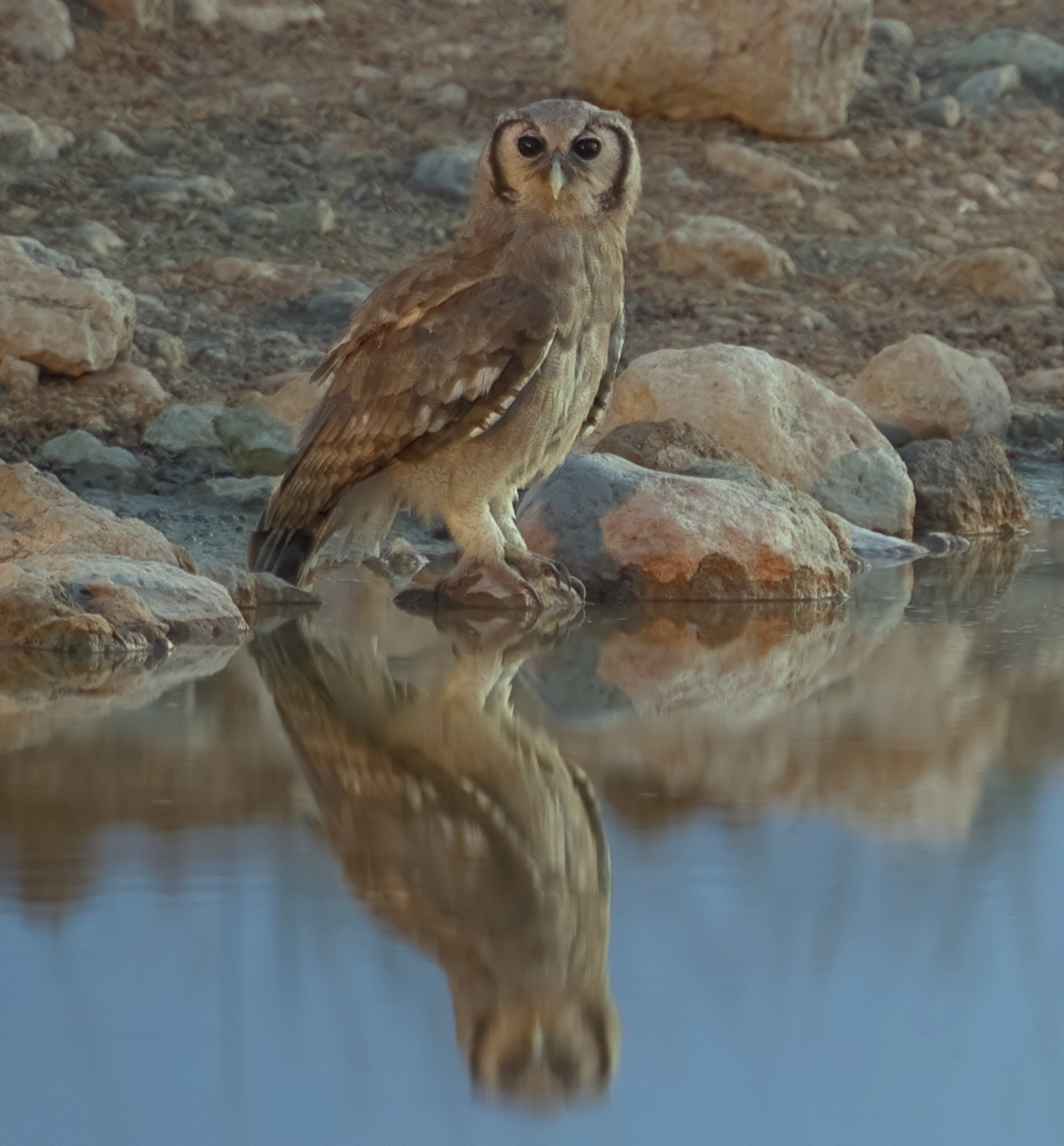
Wikipedia: Verreaux's eagle-owl
![]() Der Milchuhu (Bubo lacteus), auch Blassuhu genannt, ist eine in Afrika weit verbreitete Uhu-Art. Er kommt in sogenannten Galeriewäldern, Waldgebieten mit Lichtungen sowie dünn bewaldeten Savannen vor.
[more]
Der Milchuhu (Bubo lacteus), auch Blassuhu genannt, ist eine in Afrika weit verbreitete Uhu-Art. Er kommt in sogenannten Galeriewäldern, Waldgebieten mit Lichtungen sowie dünn bewaldeten Savannen vor.
[more]

Wikipedia: Spotted eagle-owl Quelle: OTHER
1200px-Spotted_eagle_owl_bubo_africanus.jpg
![]() The spotted eagle-owl (Bubo africanus; also known as the African spotted eagle-owl and the African eagle-owl) is a medium-sized species of owl, one of the smallest of the eagle owls. Its length is 45 centimetres (18 in) and its weight is from 454 to 907 grams (1.0 to 2.0 lb). It has a 100 to 140 centimetres (39 to 55 in) wingspan.[2] The facial disk is off white to pale ochre and the eyes are yellow. It has prominent ear tufts, and the upper body is dusky brown, the lower parts off-white with brown bars. Prior to 1999 the spotted eagle-owl was considered conspecific with the greyish eagle-owl, but now it is classed as a separate species.
[more]
The spotted eagle-owl (Bubo africanus; also known as the African spotted eagle-owl and the African eagle-owl) is a medium-sized species of owl, one of the smallest of the eagle owls. Its length is 45 centimetres (18 in) and its weight is from 454 to 907 grams (1.0 to 2.0 lb). It has a 100 to 140 centimetres (39 to 55 in) wingspan.[2] The facial disk is off white to pale ochre and the eyes are yellow. It has prominent ear tufts, and the upper body is dusky brown, the lower parts off-white with brown bars. Prior to 1999 the spotted eagle-owl was considered conspecific with the greyish eagle-owl, but now it is classed as a separate species.
[more]
Profil Wikipedia eBird Xeno-Canto

Wikipedia: African wood-owl Quelle: OTHER
1200px-African_Wood_Owl.jpg
![]() The African wood owl (Strix woodfordii) or Woodford's owl, is a typical owl from the genus Strix in the family Strigidae which is widespread in sub-Saharan Africa.
[more]
The African wood owl (Strix woodfordii) or Woodford's owl, is a typical owl from the genus Strix in the family Strigidae which is widespread in sub-Saharan Africa.
[more]

Wikipedia: Marsh owl Quelle: OTHER
1200px-Asio_capensis%2C_Tweeling%2C_a.jpg
![]() Die Kap-Ohreule (Asio capensis) ist eine Art aus der Familie der Eigentlichen Eulen. Sie kommt ausschließlich auf dem afrikanischen Kontinent sowie Madagaskar vor. Sie galt lange Zeit als eng verwandt mit der Sumpfohreule. Die Ornithologen Claus König und Friedhelm Weick bestreiten dies und führen die Ähnlichkeiten in Lebensweise und äußerem Erscheinungsbild auf eine konvergente Entwicklung zurück.[1]
[more]
Die Kap-Ohreule (Asio capensis) ist eine Art aus der Familie der Eigentlichen Eulen. Sie kommt ausschließlich auf dem afrikanischen Kontinent sowie Madagaskar vor. Sie galt lange Zeit als eng verwandt mit der Sumpfohreule. Die Ornithologen Claus König und Friedhelm Weick bestreiten dies und führen die Ähnlichkeiten in Lebensweise und äußerem Erscheinungsbild auf eine konvergente Entwicklung zurück.[1]
[more]
Profil Wikipedia eBird Xeno-Canto

Wikipedia: African scops-owl Quelle: OTHER
1200px-African-scops_owl_%28Otus_senegalensis%29_male.jpg
![]() Die Afrika-Zwergohreule (Otus senegalensis) ist ein Vogel aus der artenreichen, altweltlichen Gattung der Zwergohreulen. Sie ist eine der kleinsten in Afrika vorkommenden Eulen. Früher wurde sie der nördlich der Sahara vorkommenden Zwergohreule als Unterart zugeordnet.
[more]
Die Afrika-Zwergohreule (Otus senegalensis) ist ein Vogel aus der artenreichen, altweltlichen Gattung der Zwergohreulen. Sie ist eine der kleinsten in Afrika vorkommenden Eulen. Früher wurde sie der nördlich der Sahara vorkommenden Zwergohreule als Unterart zugeordnet.
[more]
Profil Wikipedia eBird Xeno-Canto

Wikipedia: Pearl-spotted owlet Quelle: OTHER
1200px-Pearl-spotted_owlet_%28Glaucidium_perlatum_diurnum%29.jpg
![]() The pearl-spotted owlet (Glaucidium perlatum) is an owl that breeds in Sub-Saharan Africa. This species is a part of the larger grouping of owls known as typical owls, Strigidae, which contains most species of owl. The other grouping is the barn owls, Tytonidae.
[more]
The pearl-spotted owlet (Glaucidium perlatum) is an owl that breeds in Sub-Saharan Africa. This species is a part of the larger grouping of owls known as typical owls, Strigidae, which contains most species of owl. The other grouping is the barn owls, Tytonidae.
[more]
Profil Wikipedia eBird Xeno-Canto

Wikipedia: African barred owlet Quelle: OTHER
1200px-Glaucidium_capense_-Kruger_National_Park%2C_South_Africa-8.jpg
![]() Der Kap-Sperlingskauz (Glaucidium capense, Syn.: Taenioglaux capense) ist eine in Afrika heimische Eule aus der Familie der eigentlichen Eulen.
[more]
Der Kap-Sperlingskauz (Glaucidium capense, Syn.: Taenioglaux capense) ist eine in Afrika heimische Eule aus der Familie der eigentlichen Eulen.
[more]
Profil Wikipedia eBird Xeno-Canto
Owl, perhaps southern white-faced owl. 2016-09-24 18.37.18 Botswana
Zuerst beobachtet in Botswana an 2016-09-24.
![]() Die Südbüscheleule oder Südliche Weißgesichtseule (Ptilopsis granti) ist eine kleinwüchsige Art aus der Familie der Eigentlichen Eulen (Strigidae).
[more]
Die Südbüscheleule oder Südliche Weißgesichtseule (Ptilopsis granti) ist eine kleinwüchsige Art aus der Familie der Eigentlichen Eulen (Strigidae).
[more]

Wikipedia: Pel's fishing-owl Quelle: OTHER
Pel%27s_fishing_owl%2C_Scotopelia_pel.jpg
![]() Die Bindenfischeule (Scotopelia peli, Syn.: Bubo peli), auch Pel-Fischeule genannt, ist eine Art aus der Familie der Eigentlichen Eulen. Sie kommt ausschließlich in Afrika vor.
[more]
Die Bindenfischeule (Scotopelia peli, Syn.: Bubo peli), auch Pel-Fischeule genannt, ist eine Art aus der Familie der Eigentlichen Eulen. Sie kommt ausschließlich in Afrika vor.
[more]
Profil Wikipedia eBird Xeno-Canto

Wikipedia: African grass-owl Quelle: OTHER
Grass_Owl_adult.jpg
![]() Die Afrika-Graseule (Tyto capensis), auch Kap-Graseule, einfach Graseule[1] oder Kap-Schleiereule[2] genannt, ist eine Art aus der Familie der Schleiereulen. Ihr Verbreitungsgebiet ist auf Afrika beschränkt. Es werden vier Unterarten für diese Art unterschieden.
[more]
Die Afrika-Graseule (Tyto capensis), auch Kap-Graseule, einfach Graseule[1] oder Kap-Schleiereule[2] genannt, ist eine Art aus der Familie der Schleiereulen. Ihr Verbreitungsgebiet ist auf Afrika beschränkt. Es werden vier Unterarten für diese Art unterschieden.
[more]

Wikipedia: Barn owl Quelle: OTHER
1200px-Tyto_alba_-British_Wildlife_Centre%2C_Surrey%2C_England-8a_%281%29.jpg
Dieser Vogel erscheint jenseits grossen Meere in Kontinenten :
Europa, Nordamerika, Südamerika, Afrika, Asien.
![]() Die Schleiereule (Tyto alba) ist eine Vogelart aus der Ordnung der Eulen (Strigiformes) und der Familie der Schleiereulen (Tytonidae). Die Schleiereule ist eine sehr helle, langbeinige Eule, die keine Federohren aufweist. Zu ihren auffälligsten Erkennungsmerkmalen gehören das herzförmige Gesicht sowie die verhältnismäßig kleinen, schwarzen Augen. Sie ist nachtaktiv und am Tage nur an ihren Ruheplätzen sowie am Brutplatz zu beobachten.
[more]
Die Schleiereule (Tyto alba) ist eine Vogelart aus der Ordnung der Eulen (Strigiformes) und der Familie der Schleiereulen (Tytonidae). Die Schleiereule ist eine sehr helle, langbeinige Eule, die keine Federohren aufweist. Zu ihren auffälligsten Erkennungsmerkmalen gehören das herzförmige Gesicht sowie die verhältnismäßig kleinen, schwarzen Augen. Sie ist nachtaktiv und am Tage nur an ihren Ruheplätzen sowie am Brutplatz zu beobachten.
[more]
Vokalisierung: ![]() Large repertoire of mainly hissing and screeching sounds. [Link]
Large repertoire of mainly hissing and screeching sounds. [Link]
Gesang: ![]() Song consists of a single, drawn screech, lasting about a second and is often performed in flight. Starting in a very hoarse tone, then progressing with a rising pitch into a more burbling sound, before suddenly ending. [Link]
Song consists of a single, drawn screech, lasting about a second and is often performed in flight. Starting in a very hoarse tone, then progressing with a rising pitch into a more burbling sound, before suddenly ending. [Link]
Körperlich: Länge=33-35 cm,
Flügelspanne=80-95 cm,
Gewicht=240-350 g
Habitate:
Landwirtschaft

Wikipedia: Knysna turaco Quelle: OTHER
1200px-Knysna_Turacos.JPG
Allgemein: ![]() The Knysna turaco (Tauraco corythaix), or, in South Africa, Knysna loerie, is a large turaco, one of a group of African musophagidae birds. It is a resident breeder in the mature evergreen forests of southern and eastern South Africa, and Swaziland. It was formerly sometimes considered to be a subspecies of the green turaco of West Africa. The Livingstone's and Schalow's turacos were once considered subspecies.[2]
[more]
The Knysna turaco (Tauraco corythaix), or, in South Africa, Knysna loerie, is a large turaco, one of a group of African musophagidae birds. It is a resident breeder in the mature evergreen forests of southern and eastern South Africa, and Swaziland. It was formerly sometimes considered to be a subspecies of the green turaco of West Africa. The Livingstone's and Schalow's turacos were once considered subspecies.[2]
[more]
Gray loris, nicknamed the Go away bird for its call. 2016-09-23 17.46.16 Botswana
Zuerst beobachtet in Botswana an 2016-09-23.
![]() The grey go-away-bird (Crinifer concolor), also known as grey lourie, grey loerie, or kwêvoël, is a bold and common bird of the southern Afrotropics. They are present in arid to moist, open woodlands and thorn savanna, especially near surface water.[2] They regularly form groups and parties that forage in tree tops, or dust bathe on the ground. Especially when disturbed, they make their presence known by their characteristically loud and nasal "kweh" or "go-way" calls,[3] with the last syllable typically a descending drawl.[4] Within range, their unique combination of appearance and habits precludes confusion with other bird species.
[more]
The grey go-away-bird (Crinifer concolor), also known as grey lourie, grey loerie, or kwêvoël, is a bold and common bird of the southern Afrotropics. They are present in arid to moist, open woodlands and thorn savanna, especially near surface water.[2] They regularly form groups and parties that forage in tree tops, or dust bathe on the ground. Especially when disturbed, they make their presence known by their characteristically loud and nasal "kweh" or "go-way" calls,[3] with the last syllable typically a descending drawl.[4] Within range, their unique combination of appearance and habits precludes confusion with other bird species.
[more]

Wikipedia: Purple-crested turaco Quelle: OTHER
1200px-Purple-crested_Turaco_%28Gallirex_porphyreolophus%29_%2832424422866%29.jpg
![]() The purple-crested turaco (Gallirex porphyreolophus) is a species of bird in the family Musophagidae. It is the National Bird of the Kingdom of Swaziland, and the crimson flight feathers of this and related turaco species are important in the ceremonial regalia of the Swazi royal family.
[more]
The purple-crested turaco (Gallirex porphyreolophus) is a species of bird in the family Musophagidae. It is the National Bird of the Kingdom of Swaziland, and the crimson flight feathers of this and related turaco species are important in the ceremonial regalia of the Swazi royal family.
[more]

Wikipedia: Narina trogon Quelle: OTHER
Narina_Trogon%2C_Apaloderma_narina_MALE_at_Lekgalameetse_Provincial_Reserve%2C_Limpopo%2C_South_Africa_%2814654439002%29.jpg
![]() The Narina trogon (Apaloderma narina) is a largely green and red, medium-sized (32–34 cm long), bird of the family Trogonidae. It is native to forests and woodlands of the Afrotropics. Though it is the most widespread and catholic in habitat choice of the three Apaloderma species, their numbers are locally depleted due to deforestation.[2] Some populations are sedentary while others undertake regular movements. The species name commemorates Narina, mistress of French ornithologist François Levaillant, whose name he derived from a Khoikhoi word for "flower",[3] as her given name was difficult to pronounce.
[more]
The Narina trogon (Apaloderma narina) is a largely green and red, medium-sized (32–34 cm long), bird of the family Trogonidae. It is native to forests and woodlands of the Afrotropics. Though it is the most widespread and catholic in habitat choice of the three Apaloderma species, their numbers are locally depleted due to deforestation.[2] Some populations are sedentary while others undertake regular movements. The species name commemorates Narina, mistress of French ornithologist François Levaillant, whose name he derived from a Khoikhoi word for "flower",[3] as her given name was difficult to pronounce.
[more]
Profil Wikipedia eBird Xeno-Canto
Southern yellow-billed hornbill. 2016-09-25 09.17.32 Botswana
Zuerst beobachtet in Botswana an 2016-09-25.
![]() The southern yellow-billed hornbill (Tockus leucomelas) is a hornbill found in southern Africa. Yellow-billed hornbills feed mainly on the ground, where they forage for seeds, small insects, spiders and scorpions. This hornbill species is a common and widespread resident of dry thornveldt and broad-leafed woodlands. They can often be seen along roads and water courses.
[more]
The southern yellow-billed hornbill (Tockus leucomelas) is a hornbill found in southern Africa. Yellow-billed hornbills feed mainly on the ground, where they forage for seeds, small insects, spiders and scorpions. This hornbill species is a common and widespread resident of dry thornveldt and broad-leafed woodlands. They can often be seen along roads and water courses.
[more]

Wikipedia: Southern red-billed hornbill Quelle: OTHER
1200px-Southern_red-billed_hornbill_%28Tockus_rufirostris%29_male.jpg
![]() The southern red-billed hornbill (Tockus rufirostris) is a species of hornbill in the family Bucerotidae, which is native to the savannas and dryer bushlands of southern Africa. It is replaced by a near-relative, the Damara red-billed hornbill, in the arid woodlands of western Namibia. All five red-billed hornbills were formerly considered conspecific.
[more]
The southern red-billed hornbill (Tockus rufirostris) is a species of hornbill in the family Bucerotidae, which is native to the savannas and dryer bushlands of southern Africa. It is replaced by a near-relative, the Damara red-billed hornbill, in the arid woodlands of western Namibia. All five red-billed hornbills were formerly considered conspecific.
[more]

Wikipedia: Trumpeter hornbill Quelle: OTHER
1200px-Bycanistes_bucinator_-Lowry_Park_Zoo%2C_Tampa%2C_Florida%2C_USA-8a.jpg
![]() The trumpeter hornbill (Bycanistes bucinator) is a medium-sized hornbill, with length between 58 and 65 cm (23 and 26 in), characterized by a large grey casque on the bill, smaller in females. The eyes are brown or red, with pink surrounding skin. Body mass is between 0.45 and 1 kg (0.99 and 2.20 lb).[2] It is similar to silvery-cheeked hornbill. Distinguishing features include an all-black back, white belly and white underwing coverts (in flight, wings present white tips), and red facial skin.
[more]
The trumpeter hornbill (Bycanistes bucinator) is a medium-sized hornbill, with length between 58 and 65 cm (23 and 26 in), characterized by a large grey casque on the bill, smaller in females. The eyes are brown or red, with pink surrounding skin. Body mass is between 0.45 and 1 kg (0.99 and 2.20 lb).[2] It is similar to silvery-cheeked hornbill. Distinguishing features include an all-black back, white belly and white underwing coverts (in flight, wings present white tips), and red facial skin.
[more]
Southern ground hornbill. 2016-09-26 07.39.52 Botswana
Zuerst beobachtet in Botswana an 2016-09-26.
![]() Der Südliche Hornrabe (Bucorvus leadbeateri, Syn.: Bucorvus cafer), manchmal auch als Rotwangenhornrabe, Südhornrabe oder Kaffernhornrabe bezeichnet, ist eine Vogelart aus der Familie der Hornraben (Bucorvidae) und ein Charaktervogel der afrikanischen Savannen südlich des Äquators. Der Südliche Hornrabe und seine Schwesterart, der Nördliche Hornrabe (Bucorvus abyssinicus) oder Sudanhornrabe, sind die einzigen Vertreter der Familie Hornraben. Mit seinem großen Schnabel, dem schwarzen Gefieder und der rötlichen Färbung der unbefiederten Gesichts- und Halspartien ist dieser Vogel eindeutig zu identifizieren.
[more]
Der Südliche Hornrabe (Bucorvus leadbeateri, Syn.: Bucorvus cafer), manchmal auch als Rotwangenhornrabe, Südhornrabe oder Kaffernhornrabe bezeichnet, ist eine Vogelart aus der Familie der Hornraben (Bucorvidae) und ein Charaktervogel der afrikanischen Savannen südlich des Äquators. Der Südliche Hornrabe und seine Schwesterart, der Nördliche Hornrabe (Bucorvus abyssinicus) oder Sudanhornrabe, sind die einzigen Vertreter der Familie Hornraben. Mit seinem großen Schnabel, dem schwarzen Gefieder und der rötlichen Färbung der unbefiederten Gesichts- und Halspartien ist dieser Vogel eindeutig zu identifizieren.
[more]
Profil Wikipedia eBird Xeno-Canto

Wikipedia: Speckled mousebird Quelle: OTHER
1200px-Colius_striatus_-_W%C3%BCstenhaus.jpg
![]() Der Braunflügel-Mausvogel (Colius striatus), manchmal auch Gestreifter Mausvogel, ist eine afrikanische Vogelart aus der Familie der Mausvögel.
[more]
Der Braunflügel-Mausvogel (Colius striatus), manchmal auch Gestreifter Mausvogel, ist eine afrikanische Vogelart aus der Familie der Mausvögel.
[more]
Profil Wikipedia eBird Xeno-Canto

Wikipedia: White-backed mousebird Quelle: OTHER
Colius_White-backed_mousebird_feeding_on_Duranta_berries_9860s.jpg
![]() The white-backed mousebird (Colius colius) is a large species of mousebird. It is distributed in western and central regions of southern Africa from Namibia and southern Botswana eastwards to Central Transvaal and the eastern Cape.
[more]
The white-backed mousebird (Colius colius) is a large species of mousebird. It is distributed in western and central regions of southern Africa from Namibia and southern Botswana eastwards to Central Transvaal and the eastern Cape.
[more]

Wikipedia: Red-faced mousebird Quelle: OTHER
1200px-Red-faced_Mousebird_%28Urocolius_indicus%29_hanging_in_tree%2C_front_view.jpg
![]() Der Rotzügel-Mausvogel (Urocolius indicus), auch Brillenmausvogel genannt, ist mit einer Körperlänge von 33 Zentimetern und einer Schwanzlänge von bis zu 25 Zentimetern und einem Gewicht von bis zu 70 Gramm ein mittelgroßer Vertreter aus der Familie der Mausvögel.
[more]
Der Rotzügel-Mausvogel (Urocolius indicus), auch Brillenmausvogel genannt, ist mit einer Körperlänge von 33 Zentimetern und einer Schwanzlänge von bis zu 25 Zentimetern und einem Gewicht von bis zu 70 Gramm ein mittelgroßer Vertreter aus der Familie der Mausvögel.
[more]
Profil Wikipedia eBird Xeno-Canto

Wikipedia: Green woodhoopoe Quelle: OTHER
1200px-Green_wood_hoopoe_%28Phoeniculus_purpureus_angolensis%29.jpg
![]() The green wood hoopoe (Phoeniculus purpureus) is a large, up to 44 cm (17 in) long, near-passerine tropical bird native to Africa. It is a member of the family Phoeniculidae, the wood hoopoes, and was formerly known as the red-billed wood hoopoe.
[more]
The green wood hoopoe (Phoeniculus purpureus) is a large, up to 44 cm (17 in) long, near-passerine tropical bird native to Africa. It is a member of the family Phoeniculidae, the wood hoopoes, and was formerly known as the red-billed wood hoopoe.
[more]
Probably a cormorant, as these have a light belly when immature and have no yellow on the bill like the shag. 2022-04-12 14.28.50 Mallorca
Zuerst beobachtet in Mallorca an 2022-04-12.
![]() Der Sichelhopf (Rhinopomastus cyanomelas) ist ein afrikanischer Vogel aus der Familie der Baumhopfe.
[more]
Der Sichelhopf (Rhinopomastus cyanomelas) ist ein afrikanischer Vogel aus der Familie der Baumhopfe.
[more]
Gesang:
Automatically generated from Xeno-Canto recording
Gesang Eigenschaften:
Frequency:
♫ Bill laeuft Richtung Singdrossel bei der Waldhuette in Fehraltorf. ![]() Quelle: Zoom H6 2023-02-22 17.02.58 Forsthaus (Gesang)
Quelle: Zoom H6 2023-02-22 17.02.58 Forsthaus (Gesang)
Profil Wikipedia eBird Xeno-Canto NABU

Wikipedia: Helmeted guineafowl Quelle: OTHER
1200px-Numida_meleagris_-Serengeti_National_Park%2C_Tanzania-8_%281%29.jpg
![]() Das Helmperlhuhn (Numida meleagris) ist der bekannteste Vertreter der Perlhuhnfamilie, und die einzige Art der Gattung Numida. Das Verbreitungsgebiet ist Afrika südlich der Sahara mit Ausnahme der Regenwaldgebiete. Eingeführt wurde es unter anderem auf die Kapverden und die Karibischen Inseln, Südwest-Arabien, und Madagaskar.
[more]
Das Helmperlhuhn (Numida meleagris) ist der bekannteste Vertreter der Perlhuhnfamilie, und die einzige Art der Gattung Numida. Das Verbreitungsgebiet ist Afrika südlich der Sahara mit Ausnahme der Regenwaldgebiete. Eingeführt wurde es unter anderem auf die Kapverden und die Karibischen Inseln, Südwest-Arabien, und Madagaskar.
[more]
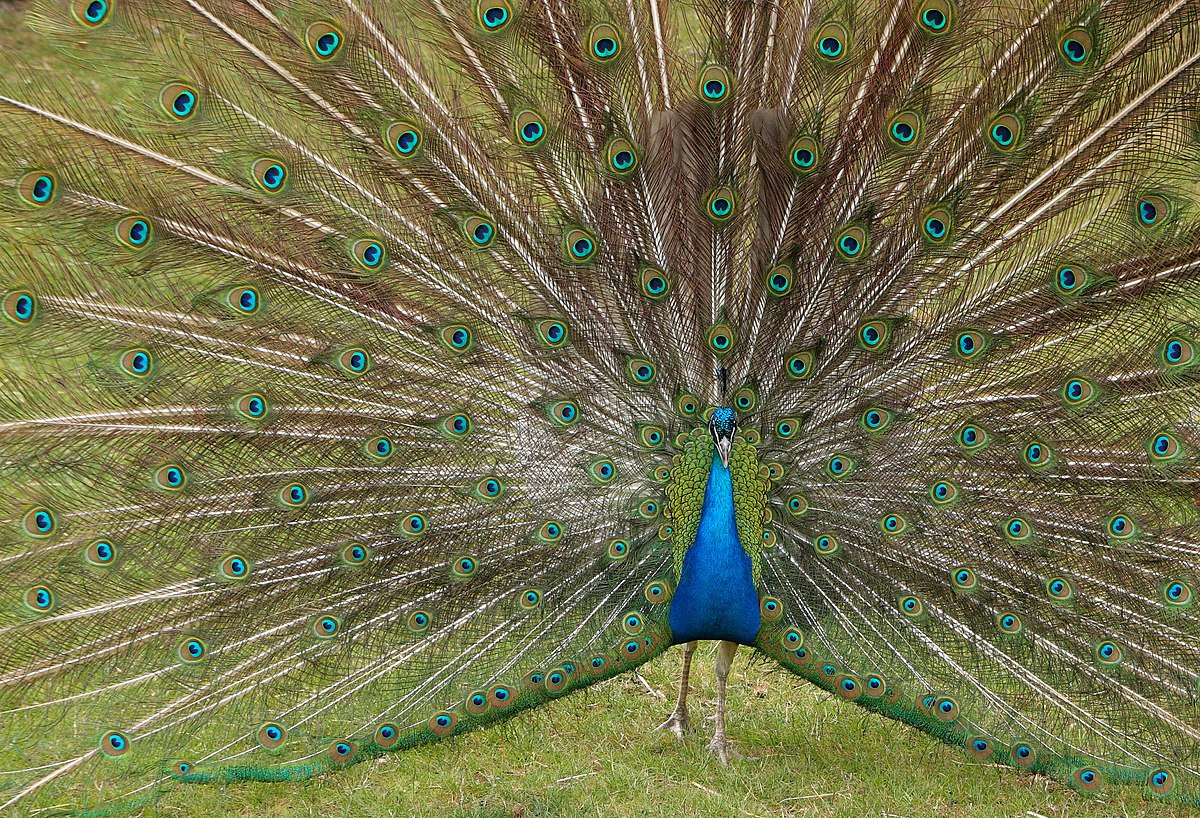
Wikipedia: Indian peafowl Quelle: OTHER
1200px-Peacock%2C_East_Park%2C_Hull_-_panoramio.jpg
Dieser Vogel erscheint jenseits grossen Meere in Kontinenten :
Nordamerika, Afrika.
![]() The Indian peafowl (Pavo cristatus), also known as the common peafowl, and blue peafowl, is a peafowl species native to the Indian subcontinent. It has been introduced to many other countries.
[more]
The Indian peafowl (Pavo cristatus), also known as the common peafowl, and blue peafowl, is a peafowl species native to the Indian subcontinent. It has been introduced to many other countries.
[more]

Wikipedia: Chukar partridge Quelle: OTHER
Alectoris-chukar-001.jpg
Dieser Vogel erscheint jenseits grossen Meere in Kontinenten :
Europa, Nordamerika, Afrika.
![]() The chukar partridge (Alectoris chukar), or simply chukar, is a Palearctic upland gamebird in the pheasant family Phasianidae. It has been considered to form a superspecies complex along with the rock partridge, Philby's partridge and Przevalski's partridge and treated in the past as conspecific particularly with the first. This partridge has well marked black and white bars on the flanks and a black band running from the forehead across the eye and running down the head to form a necklace that encloses a white throat. Native to Asia, the species has been introduced into many other places and feral populations have established themselves in parts of North America and New Zealand. This bird can be found in parts of the Middle East and temperate Asia.
[more]
The chukar partridge (Alectoris chukar), or simply chukar, is a Palearctic upland gamebird in the pheasant family Phasianidae. It has been considered to form a superspecies complex along with the rock partridge, Philby's partridge and Przevalski's partridge and treated in the past as conspecific particularly with the first. This partridge has well marked black and white bars on the flanks and a black band running from the forehead across the eye and running down the head to form a necklace that encloses a white throat. Native to Asia, the species has been introduced into many other places and feral populations have established themselves in parts of North America and New Zealand. This bird can be found in parts of the Middle East and temperate Asia.
[more]
Profil Wikipedia eBird Xeno-Canto

Wikipedia: Harlequin quail Quelle: OTHER
1200px-Harlequin_Quail_%28Coturnix_delegorguei%29_%286035291347%29.jpg
![]() The harlequin quail (Coturnix delegorguei) is a species of bird in the family Phasianidae. It occurs in Africa and in the Arabian Peninsula.[4] The species is named after the collector, Adulphe Delegorgue.
[more]
The harlequin quail (Coturnix delegorguei) is a species of bird in the family Phasianidae. It occurs in Africa and in the Arabian Peninsula.[4] The species is named after the collector, Adulphe Delegorgue.
[more]
Profil Wikipedia eBird Vogelwarte BirdLife ZH ornitho.ch bird-song.ch Xeno-Canto BirdID NABU

Wikipedia: Common quail Quelle: OTHER
1200px-A_common_quail_in_Lebanon.jpg
![]() Die Wachtel (Coturnix coturnix) ist ein ungefähr starengroßer, im Verborgenen lebender Vogel, der in fast ganz Europa, dem westlichen Teil Asiens und einem großen Teil Afrikas vorkommt. In Europa ist sie der kleinste Hühnervogel. Der weit vernehmbare sogenannte Wachtelschlag ist gelegentlich zu hören, die unauffälligen Vögel sind jedoch nur selten zu sehen. Sie sind während der Fortpflanzungszeit vor allem in der Morgen- und Abenddämmerung aktiv. Während des Höhepunkts der Balz sind sie auch gelegentlich während des Tages zu vernehmen. Wachteln sind Bodenvögel und brüten in trockenen Wiesen, auf Ackerland, in Steppen und locker bestandenem Buschland.
[more]
Die Wachtel (Coturnix coturnix) ist ein ungefähr starengroßer, im Verborgenen lebender Vogel, der in fast ganz Europa, dem westlichen Teil Asiens und einem großen Teil Afrikas vorkommt. In Europa ist sie der kleinste Hühnervogel. Der weit vernehmbare sogenannte Wachtelschlag ist gelegentlich zu hören, die unauffälligen Vögel sind jedoch nur selten zu sehen. Sie sind während der Fortpflanzungszeit vor allem in der Morgen- und Abenddämmerung aktiv. Während des Höhepunkts der Balz sind sie auch gelegentlich während des Tages zu vernehmen. Wachteln sind Bodenvögel und brüten in trockenen Wiesen, auf Ackerland, in Steppen und locker bestandenem Buschland.
[more]
Vokalisierung: ![]() Other sounds: A nasal disyllabic mewing "mau-au", and a wader-like rolling "wreee". [Link]
Other sounds: A nasal disyllabic mewing "mau-au", and a wader-like rolling "wreee". [Link]
Gesang: ![]() Song a very characteristic, short, tri-syllabic whistling, with each syllable ending with a sharp rise in pitch "weet weet-weet". The two last syllable linked together. [Link]
Song a very characteristic, short, tri-syllabic whistling, with each syllable ending with a sharp rise in pitch "weet weet-weet". The two last syllable linked together. [Link]
Körperlich: Länge=16-18 cm,
Flügelspanne=32-35 cm,
Gewicht=75-135 g
Habitate:
Landwirtschaft

Wikipedia: Crested francolin Quelle: OTHER
1200px-Crested_Francolin_RWD.jpg
Allgemein: ![]() Der Schopffrankolin (Dendroperdix sephaena, Syn.: Francolinus sephaena, Peliperdix sephaena) ist eine Art der Gattung der Frankoline aus der Familie der Fasanenartigen (Phasianidae).
[more]
Der Schopffrankolin (Dendroperdix sephaena, Syn.: Francolinus sephaena, Peliperdix sephaena) ist eine Art der Gattung der Frankoline aus der Familie der Fasanenartigen (Phasianidae).
[more]

Wikipedia: Coqui francolin Quelle: OTHER
1200px-CoquiFrancolin_MasaiMara.jpg
![]() Der Schopffrankolin (Dendroperdix sephaena, Syn.: Francolinus sephaena, Peliperdix sephaena) ist eine Art der Gattung der Frankoline aus der Familie der Fasanenartigen (Phasianidae).
[more]
Der Schopffrankolin (Dendroperdix sephaena, Syn.: Francolinus sephaena, Peliperdix sephaena) ist eine Art der Gattung der Frankoline aus der Familie der Fasanenartigen (Phasianidae).
[more]

Wikipedia: Shelley's francolin Quelle: OTHER
FrancolinusShelleyiKeulemans.jpg
![]() Shelley's francolin (Scleroptila shelleyi) is a species of bird in the family Phasianidae. The species is named after Sir Edward Shelley, cousin of George Ernest Shelley.
[more]
Shelley's francolin (Scleroptila shelleyi) is a species of bird in the family Phasianidae. The species is named after Sir Edward Shelley, cousin of George Ernest Shelley.
[more]

Wikipedia: Grey-winged francolin Quelle: OTHER
Bergpatrys_%28Scleroptila_afra%29_in_KwaZulu-Natal%2C_Francesco_Veronesi.jpg
![]() The grey-winged francolin (Scleroptila afra) is a species of bird in the family Phasianidae.
It is found in Lesotho and South Africa.
[more]
The grey-winged francolin (Scleroptila afra) is a species of bird in the family Phasianidae.
It is found in Lesotho and South Africa.
[more]

Wikipedia: Red-winged francolin Quelle: OTHER
Red-winged_Francolin_%28Francolinus_levaillantii%29_from_side%2C_b.jpg
![]() Der Rotflügelfrankolin (Scleroptila levaillantii, Syn.: Francolinus levaillantii), auch Bergfrankolin genannt, ist ein 33 Zentimeter großer Vertreter aus der Familie der Fasanartigen.
[more]
Der Rotflügelfrankolin (Scleroptila levaillantii, Syn.: Francolinus levaillantii), auch Bergfrankolin genannt, ist ein 33 Zentimeter großer Vertreter aus der Familie der Fasanartigen.
[more]

Wikipedia: Red-necked spurfowl Quelle: OTHER
1200px-Red-necked_spurfowl_%28Pternistis_afer_cranchii%29%2C_crop.jpg
![]() Der Rotkehlfrankolin (Pternistis afer, Syn.: Francolinus afer) ist eine Vogelart aus der Familie der Fasanenartigen (Phasianidae). Es gibt sieben Unterarten.
[more]
Der Rotkehlfrankolin (Pternistis afer, Syn.: Francolinus afer) ist eine Vogelart aus der Familie der Fasanenartigen (Phasianidae). Es gibt sieben Unterarten.
[more]

Wikipedia: Red-billed francolin
![]() The red-billed spurfowl (Pternistis adspersus), also known as the red-billed francolin, is a species of bird in the family Phasianidae. It is found in Southern Africa, including Angola, Botswana, Namibia, South Africa, Zambia, and Zimbabwe.
[more]
The red-billed spurfowl (Pternistis adspersus), also known as the red-billed francolin, is a species of bird in the family Phasianidae. It is found in Southern Africa, including Angola, Botswana, Namibia, South Africa, Zambia, and Zimbabwe.
[more]

Wikipedia: Natal francolin Quelle: OTHER
1200px-Natal_Spurfowl_%28Pternistes_natalensis%29_%286041759562%29.jpg
![]() The Natal spurfowl or Natal francolin (Pternistis natalensis) is a species of bird in the family Phasianidae.
It is found in Botswana, Eswatini, Mozambique, South Africa, Zambia, and Zimbabwe.
[more]
The Natal spurfowl or Natal francolin (Pternistis natalensis) is a species of bird in the family Phasianidae.
It is found in Botswana, Eswatini, Mozambique, South Africa, Zambia, and Zimbabwe.
[more]

Wikipedia: Cape francolin Quelle: OTHER
Francolinus_capensis_-Kirstenbosch_National_Botanical_Garden%2C_South_Africa-8%2C_crop.jpg
![]() Der Kapfrankolin (Pternistis capensis, Syn.: Francolinus capensis) ist eine Vogelart aus der Familie der Fasanenartigen (Phasianidae). Er ist in den Cape-Provinzen Südafrikas und in Namibia heimisch.
[more]
Der Kapfrankolin (Pternistis capensis, Syn.: Francolinus capensis) ist eine Vogelart aus der Familie der Fasanenartigen (Phasianidae). Er ist in den Cape-Provinzen Südafrikas und in Namibia heimisch.
[more]

Wikipedia: Swainson's spurfowl Quelle: OTHER
1200px-Swainson%27s_Spurfowl_%28Pternistes_swainsonii%29_%286041396322%29.jpg
![]() Swainson's spurfowl or Swainson's francolin (Pternistis swainsonii) is a species of bird in the family Phasianidae.
It is found in Angola, Botswana, Lesotho, Malawi, Mozambique, Namibia, South Africa, Swaziland, Zambia, and Zimbabwe. In the Shona language in Zimbabwe, this bird is called the chikwari and is considered a delicacy by outdoor and hunting enthusiasts.
[more]
Swainson's spurfowl or Swainson's francolin (Pternistis swainsonii) is a species of bird in the family Phasianidae.
It is found in Angola, Botswana, Lesotho, Malawi, Mozambique, Namibia, South Africa, Swaziland, Zambia, and Zimbabwe. In the Shona language in Zimbabwe, this bird is called the chikwari and is considered a delicacy by outdoor and hunting enthusiasts.
[more]

Wikipedia: Little swift Quelle: OTHER
House_swift_I_IMG_3260.jpg
![]() The little swift (Apus affinis), is a small species of swift found in Africa and southwestern Asia, and are vagrants and local breeders in southern Europe. They are found both in urban areas and at rocky cliffs where they build nests in a way typical of all members of the order Apodiformes. The genus name Apus is Latin for a swift, thought by the ancients to be a type of swallow without feet (from Ancient Greek α, a, "without", and πούς, pous, "foot"). The Latin specific affinis means similar to or related to, but in this case the species that the little swift supposedly resembles is not clear from the description.[3] A population formerly considered to be an eastern subspecies of little swift is now separated as a distinct species, the house swift (Apus nipalensis).
[more]
The little swift (Apus affinis), is a small species of swift found in Africa and southwestern Asia, and are vagrants and local breeders in southern Europe. They are found both in urban areas and at rocky cliffs where they build nests in a way typical of all members of the order Apodiformes. The genus name Apus is Latin for a swift, thought by the ancients to be a type of swallow without feet (from Ancient Greek α, a, "without", and πούς, pous, "foot"). The Latin specific affinis means similar to or related to, but in this case the species that the little swift supposedly resembles is not clear from the description.[3] A population formerly considered to be an eastern subspecies of little swift is now separated as a distinct species, the house swift (Apus nipalensis).
[more]

Wikipedia: African swift Quelle: OTHER
ApusBarbatus_TrevorHardaker1.jpg
![]() Der Kapsegler (Apus barbatus) ist eine Vogelart aus der Familie der Segler (Apodidae). Die Art ist typisch für die großen Apus-Arten und ähnelt in der Gestalt stark dem Fahlsegler und dessen nahe verwandten Arten. Innerhalb dieser Verwandtschaft besitzt der Kapsegler die dunkelste Gefiederfärbung. Das fragmentierte Verbreitungsgebiet liegt in Afrika südlich der Sahara, hauptsächlich in Ost- und Südafrika, zudem auf Madagaskar.[1] Er ist zumindest in Teilen seines Verbreitungsgebiets sehr häufig und wird deshalb als ungefährdet eingestuft.[2]
[more]
Der Kapsegler (Apus barbatus) ist eine Vogelart aus der Familie der Segler (Apodidae). Die Art ist typisch für die großen Apus-Arten und ähnelt in der Gestalt stark dem Fahlsegler und dessen nahe verwandten Arten. Innerhalb dieser Verwandtschaft besitzt der Kapsegler die dunkelste Gefiederfärbung. Das fragmentierte Verbreitungsgebiet liegt in Afrika südlich der Sahara, hauptsächlich in Ost- und Südafrika, zudem auf Madagaskar.[1] Er ist zumindest in Teilen seines Verbreitungsgebiets sehr häufig und wird deshalb als ungefährdet eingestuft.[2]
[more]
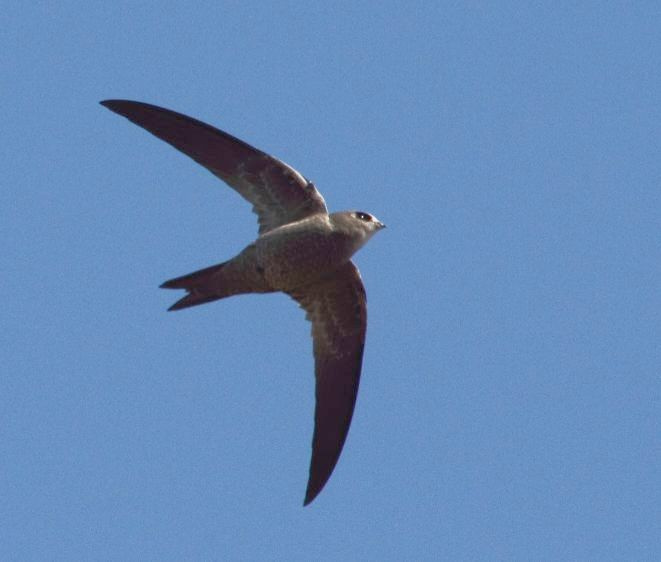
Wikipedia: Bradfield's swift Quelle: OTHER
Apus_bradfieldi_-Pofadder%2C_Northern_Cape%2C_South_Africa_-flying-8.jpg
![]() Bradfield's swift (Apus bradfieldi) is a species of swift in the family Apodidae.
[more]
Bradfield's swift (Apus bradfieldi) is a species of swift in the family Apodidae.
[more]

Wikipedia: White-rumped swift Quelle: OTHER
Swift_White-rumped_2015_12_18_07_36_42_1782.jpg
![]() The white-rumped swift (Apus caffer) is a species of swift. Although this small bird is superficially similar to a house martin, it is not closely related to that passerine species. The resemblances between the swallows and swifts are due to convergent evolution reflecting similar life styles.
[more]
The white-rumped swift (Apus caffer) is a species of swift. Although this small bird is superficially similar to a house martin, it is not closely related to that passerine species. The resemblances between the swallows and swifts are due to convergent evolution reflecting similar life styles.
[more]

Wikipedia: Horus swift Quelle: OTHER
ApusHorus_RobertWienand.jpg
![]() The Horus swift (Apus horus) is a small bird in the swift family. It breeds in sub-Saharan Africa. It has an extensive continuous distribution from eastern and southern South Africa north to southern Zambia and central Mozambique, and has recently colonised the De Hoop Nature Reserve area of the Western Cape.
[more]
The Horus swift (Apus horus) is a small bird in the swift family. It breeds in sub-Saharan Africa. It has an extensive continuous distribution from eastern and southern South Africa north to southern Zambia and central Mozambique, and has recently colonised the De Hoop Nature Reserve area of the Western Cape.
[more]
Profil Wikipedia eBird Xeno-Canto

Wikipedia: African palm-swift Quelle: OTHER
African_Palm_Swift_in_flight.jpg
![]() Der Palmensegler (Cypsiurus parvus) ist eine Vogelart aus der Familie der Segler (Apodidae). Es handelt sich um einen recht kleinen Segler, der in Afrika südlich der Sahara weit verbreitet ist, außerdem kommt er auf Madagaskar und im Südwesten der Arabischen Halbinsel vor. Die Art ist sehr häufig in der Nähe von Palmen anzutreffen, wo auch die Nistplätze liegen. Das vorwiegend an nahezu senkrechten Blattabschnitten der Palmwedel gebaute Nest ist für Nesträuber im Vergleich zu den Nestern anderer Segler recht gut zugänglich. Die Eier werden mit Speichel mit dem Nest verklebt, um sie bei Windstößen vor dem Herausfallen zu bewahren.[1]
[more]
Der Palmensegler (Cypsiurus parvus) ist eine Vogelart aus der Familie der Segler (Apodidae). Es handelt sich um einen recht kleinen Segler, der in Afrika südlich der Sahara weit verbreitet ist, außerdem kommt er auf Madagaskar und im Südwesten der Arabischen Halbinsel vor. Die Art ist sehr häufig in der Nähe von Palmen anzutreffen, wo auch die Nistplätze liegen. Das vorwiegend an nahezu senkrechten Blattabschnitten der Palmwedel gebaute Nest ist für Nesträuber im Vergleich zu den Nestern anderer Segler recht gut zugänglich. Die Eier werden mit Speichel mit dem Nest verklebt, um sie bei Windstößen vor dem Herausfallen zu bewahren.[1]
[more]
Profil Wikipedia eBird Xeno-Canto
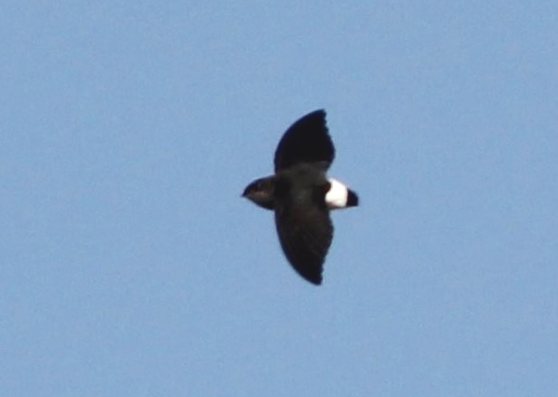
Wikipedia: Bat-like spinetail Quelle: OTHER
Neafrapus_boehmi_subsp_sheppardi%2C_Panda%2C_Birding_Weto%2C_a.jpg
![]() Böhm's spinetail (Neafrapus boehmi), also known as the bat-like spinetail, is a species of swift in the family Apodidae.
[more]
Böhm's spinetail (Neafrapus boehmi), also known as the bat-like spinetail, is a species of swift in the family Apodidae.
[more]

Wikipedia: Alpine swift Quelle: OTHER
1200px-%CE%92%CE%BF%CF%85%CE%BD%CE%BF%CF%83%CF%84%CE%B1%CF%87%CF%84%CE%AC%CF%81%CE%B1_Alpine_Swift_Tachymarptis_melba.jpg
Zuerst beobachtet in 🇨🇭 an 2020-06-20.
![]() Der Alpensegler (Tachymarptis melba, Syn.: Apus melba) ist eine Vogelart aus der Familie der Segler (Apodidae). Die Art besiedelt unter anderem weite Teile des südlichen Europas, die nördliche Verbreitungsgrenze verläuft durch den Südwesten Deutschlands.
[more]
Der Alpensegler (Tachymarptis melba, Syn.: Apus melba) ist eine Vogelart aus der Familie der Segler (Apodidae). Die Art besiedelt unter anderem weite Teile des südlichen Europas, die nördliche Verbreitungsgrenze verläuft durch den Südwesten Deutschlands.
[more]
Habitate:
Siedlung
Gesang:
Automatically generated from Xeno-Canto recording
Gesang Eigenschaften:
Frequency:
♫ Quelle: BirdNet
20200620_121816 birdnet 688 - Alpine swift.mp3
2020-06-20 12.18.16 Luppmen (Gesang)
Profil Wikipedia eBird Xeno-Canto

Wikipedia: Pennant-winged nightjar Quelle: OTHER
1200px-The_American_Museum_journal_%28c1900-%281918%29%29_%2817974546639%29.jpg
![]() The pennant-winged nightjar (Caprimulgus vexillarius) is a species of nightjar that occurs from Nigeria to northern South Africa. It is an intra-African migrant and displays remarkable sexual dimorphism in the breeding season.
[more]
The pennant-winged nightjar (Caprimulgus vexillarius) is a species of nightjar that occurs from Nigeria to northern South Africa. It is an intra-African migrant and displays remarkable sexual dimorphism in the breeding season.
[more]
Profil Wikipedia eBird Xeno-Canto

Wikipedia: Fiery-necked nightjar Quelle: OTHER
Caprimulgus_pectoralis%2C_Limpopo_Prov%2C_Maguire.jpg
![]() Die Pfeifnachtschwalbe (Caprimulgus pectoralis) ist eine Vogelart aus der Familie der Nachtschwalben (Caprimulgidae).[1]
[more]
Die Pfeifnachtschwalbe (Caprimulgus pectoralis) ist eine Vogelart aus der Familie der Nachtschwalben (Caprimulgidae).[1]
[more]
Profil Wikipedia eBird Xeno-Canto
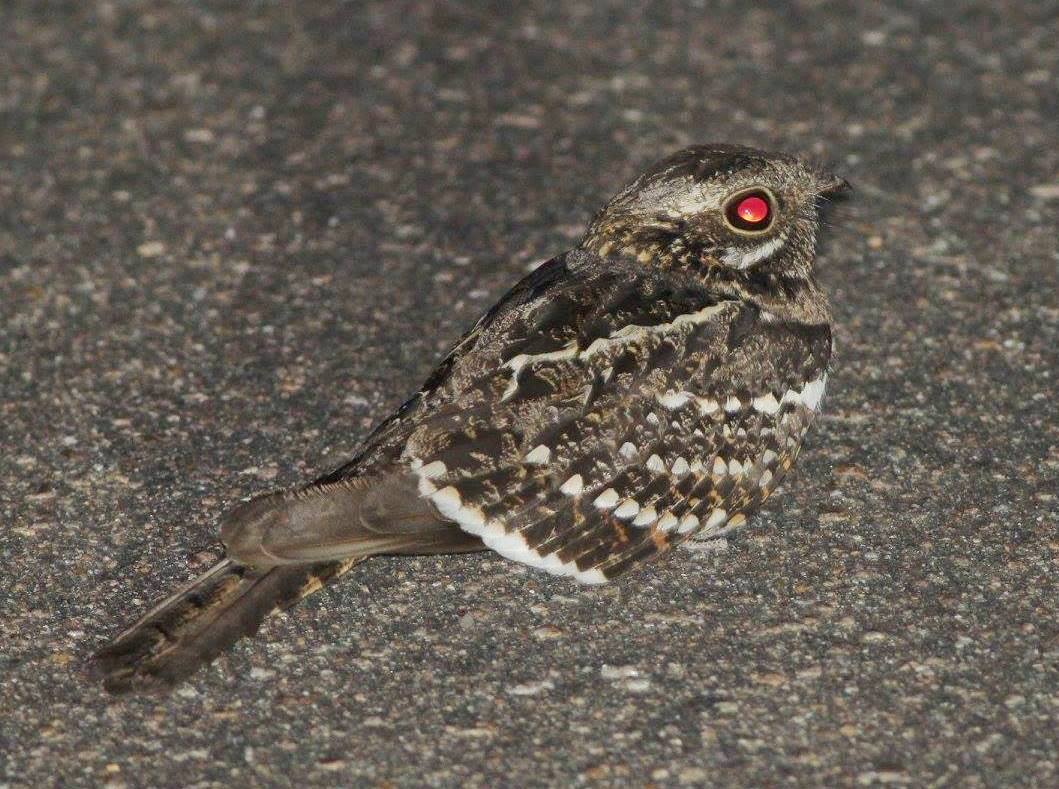
Wikipedia: Square-tailed nightjar Quelle: OTHER
Caprimulgus_fossii_subsp_mossambicus%2C_Pretoriuskop%2C_Birding_Weto%2C_a.jpg
![]() Die Welwitschnachtschwalbe (Caprimulgus fossii) ist eine Vogelart aus der Familie der Nachtschwalben (Caprimulgidae).[1]
[more]
Die Welwitschnachtschwalbe (Caprimulgus fossii) ist eine Vogelart aus der Familie der Nachtschwalben (Caprimulgidae).[1]
[more]
Profil Wikipedia eBird Xeno-Canto

Wikipedia: Rufous-cheeked nightjar Quelle: OTHER
1200px-Caprimulgus_rufigena_1838.jpg
![]() Die Rostwangen-Nachtschwalbe (Caprimulgus rufigena) ist eine Vogelart aus der Familie der Nachtschwalben (Caprimulgidae).[1]
[more]
Die Rostwangen-Nachtschwalbe (Caprimulgus rufigena) ist eine Vogelart aus der Familie der Nachtschwalben (Caprimulgidae).[1]
[more]
Profil Wikipedia eBird Xeno-Canto

Wikipedia: Freckled nightjar Quelle: OTHER
1200px-Freckled_nightjar_%28Caprimulgus_tristigma%29_male.jpg
![]() Die Fleckennachtschwalbe (Caprimulgus tristigma) ist eine Vogelart aus der Familie der Nachtschwalben (Caprimulgidae).[1]
[more]
Die Fleckennachtschwalbe (Caprimulgus tristigma) ist eine Vogelart aus der Familie der Nachtschwalben (Caprimulgidae).[1]
[more]
Profil Wikipedia eBird Xeno-Canto

Wikipedia: Swamp nightjar Quelle: OTHER
1200px-CaprimulgusAccraeGronvold.jpg
![]() The swamp nightjar (Caprimulgus natalensis) is a crepuscular and nocturnal bird in the nightjar family found in Africa.
[more]
The swamp nightjar (Caprimulgus natalensis) is a crepuscular and nocturnal bird in the nightjar family found in Africa.
[more]
Klassifikation nicht gefunden:
Paradieskranich / Blue crane (Anthropoides paradiseus)
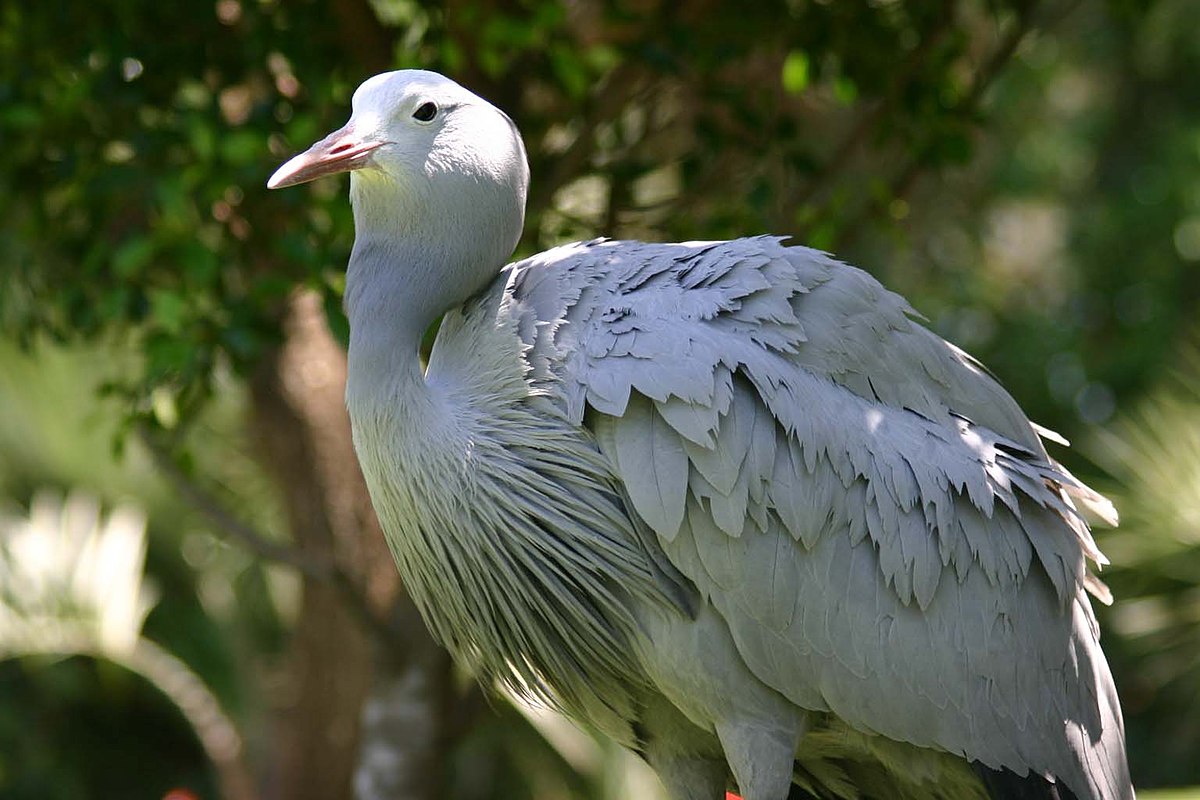
Wikipedia: Blue crane Quelle: OTHER
1200px-Blue_Crane_South_Africa.jpg
![]() Der Paradieskranich (Anthropoides paradisea, Syn.: Grus paradisea) ist eine Vogelart aus Familie der Kraniche. Er gilt als Nationalvogel Südafrikas.
[more]
Der Paradieskranich (Anthropoides paradisea, Syn.: Grus paradisea) ist eine Vogelart aus Familie der Kraniche. Er gilt als Nationalvogel Südafrikas.
[more]